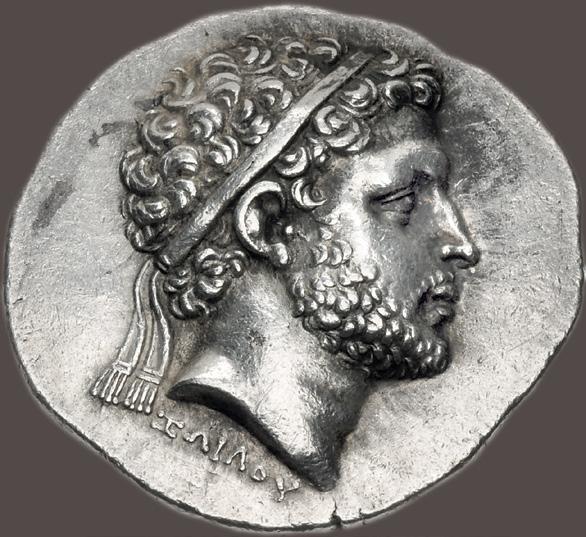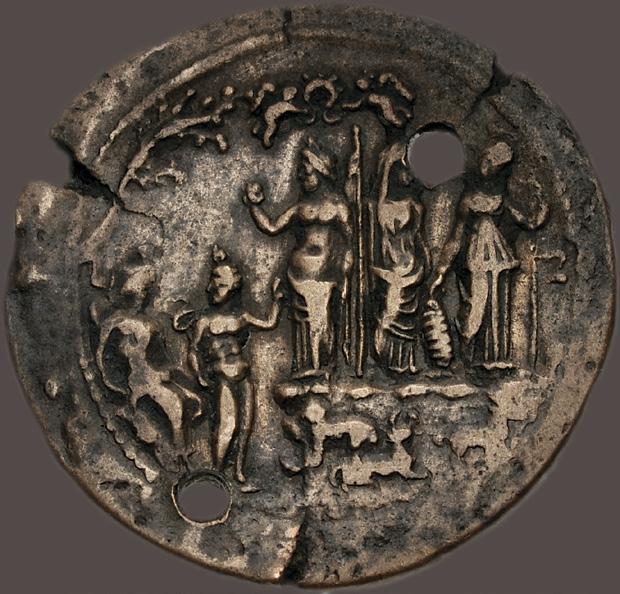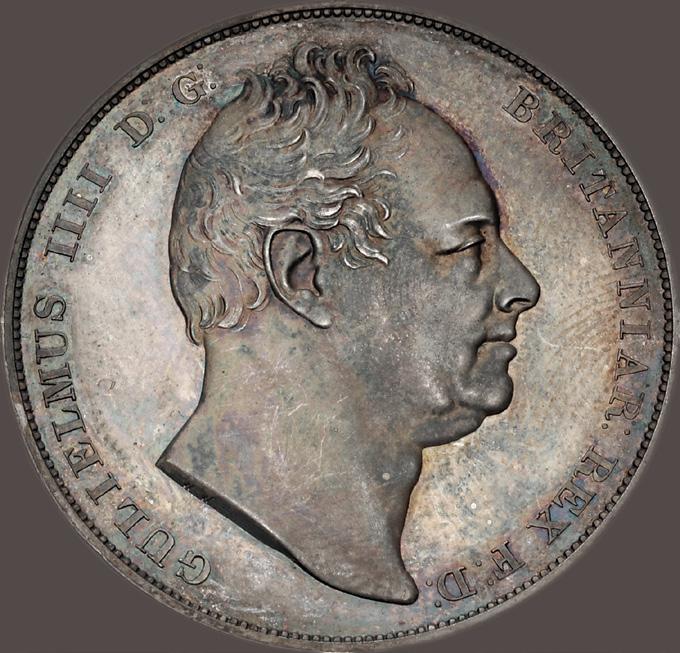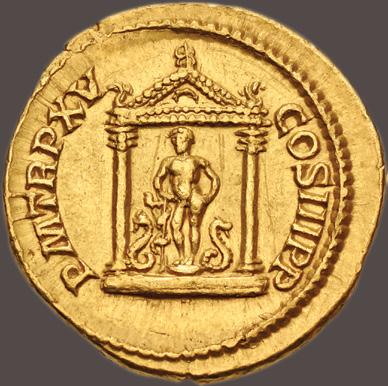TRITON XXVI

In Conjunction with the 51st Annual New York International January 10-11, 2023

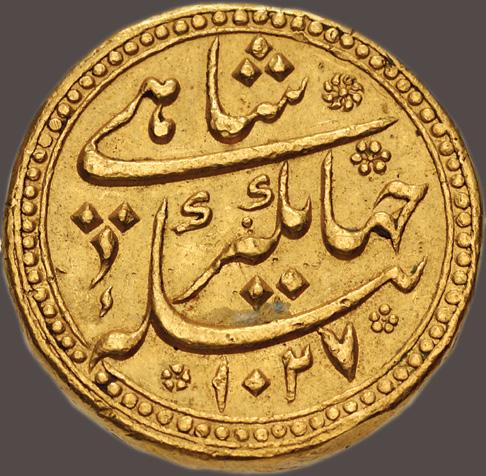










In Conjunction with the 51st Annual New York International Numismatic Convention

Barclay Salon, Lobby Level
InterContinental New York Barclay, 111 East 48th Street, New York
Featuring:
Ancient Coins from the Pythagoras and S & S Collections
Greek Coins from the North River Collection
Greek and Roman Coins from the DMS Collection
Published Akragas Tetradrachm from the Bibliothèque Nationale de France
An Exceptional Zoilos I Dikaios Tetradrachm
Extremely Rare Lucius Munatius Plancus Aureus of Mark Antony
Third Known Uranius Antoninus Denarius
Impressive Diocletian Gold Medallion of Ten Aurei
Gold Franc à pied of Guillaume de la Garde, Archbishop of Arles
Exceptional Mughal Rarities, including Jahangir’s Spectacular “Cambay Tanka”
A Collection of British Celtic Coins
1893 Proof Five Pounds of Queen Victoria in PF 66 Ultra Cameo
Impressive Henry VIII Sovereign Mint State Elizabethan Ship Ryal
PO Box 479, Lancaster, PA 17608-0479 Phone (717) 390.9194 Fax (717) 390.9978
20 Bloomsbury Street, London WC1B 3QA, UK Phone +44.20.7495.1888 Fax +44.20.7499.5916
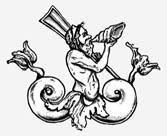
Proof Polierte Platte
Flan Bruni Fondo Specchio Mint State/Uncirculated Stempelglanz Fleur de Coin Fior di Conio Extremely Fine (EF) Vorzüglich Superbe Splendido Very Fine (VF) Sehr Schön Très Beau Bellissimo Fine Schön Beau Molto Bello Good/Fair Gut Bien Bello
AD Anno Domini BE Bithynio-Pontic Era IY Indictional Year
Æ Bronze BI Billon MBS Mail Bid Sale
AE Actian Era CE Common Era mm Mintmark
AH Anno Hegirae Cf. Confer (compare) PB Lead
AR Silver c/m Countermark p. Page
AV Gold CY Civic Year (Era) pl. Plate
BBS Buy or Bid Sale EL Electrum RPE Roman Provincial Era
BC Before Christ FPL Fixed Price List RY Regnal Year
BCE Before the Common Era g Gram SE Seleukid Era
See Bibliography on our website, www.cngcoins.com, for a complete list of reference abbreviations.
Beneficiary: Classical Numismatic Group, LLC
US$ Account: € Account: £ Account: PNC Bank, N.A. HSBC Bank plc HSBC Bank plc 249 Fifth Ave., Pittsburgh PA 15222 60 Queen Victoria Street, London EC4N 4TR 60 Queen Victoria Street, London EC4N 4TR Account Number: 5005069595 Account Number: 84309198
Account Number: 71170910 ABA Number: 031000053 Sort code: 40 12 76 Sort code: 40 11 60
BIC or SWIFT: PNCCUS33 IBAN: GB82HBUK40127684309198 IBAN: GB45HBUK40116071170910 BIC or SWIFT: HBUKGB4B BIC or SWIFT: HBUKGB4B
Classical Numismatic Group, LLC is a United States limited company. Auction license number AY002406. United Kingdom Registration No. FC035702, Branch No. BR020787.
All lots in this auction were in the possession of CNG in CNG’s Lancaster, Pennsylvania office no later than 5 August 2022. This information is provided for the protection of buyers in the event that US import restrictions are introduced subsequent to that date on any of the types of coins that are included in this auction.
Coins that have been encapsulated (“slabbed”) by a grading and/or authentication service may not be returned for any reason, in cluding authenticity, if they have been removed from the encapsulation (“slab”).
CNG would like to thank Jan Moens (jan.moens@bvdmc.com) for creating and providing the Numismatica Medievalis font used in this sale.
This is a public and Internet auction conducted by Classical Numismatic Group, LLC (CNG). Bidding in the auction constitutes acceptance of the following terms:
1. The property listed in this catalogue is offered for sale by CNG for itself and as agent for various owners and other consignors. We reserve the right to reject any bid, to determine the opening price, to set bidding increments, to vary the order of the auction, to reopen bidding in the case of a dispute, to withdraw any lot, to bid on behalf of CNG, to bid on behalf of the consignor, to permit the auctioneer to bid on his own behalf, and to permit the consignor, where reserves have been agreed, to bid on his own lots. CNG may loan or advance money to consignors or prospec tive bidders, and may have an interest other than commission charges in any lot. CNG may bid on its own account as an “insider” with information not available to the public.
2. A buyer’s fee will be charged to all successful bidders as follows on the hammer price:
A. 25% for written, fax, email, and telephone bids.
B. 22.5% for floor bids placed in person at the auction and electronic bids placed directly on www.cngcoins.com. All written bids, email bids, nonlive telephone bids, live internet bid registrations, and live telephone bid registrations must be received before 5PM Eastern time on the day before the auction begins. CNG reserves the right to change the format of www. cngcoins.com at any time.
3. All coins are guaranteed genuine. Attribution, date, condition, and other descriptions are the opinion of the cataloguer, and no warranty is expressed or implied. Please note that an auction sale is not an approval sale. Lots examined prior to the sale and lots purchased by floor bidders (including bidders executing commission bids on behalf of other parties) may not be returned for any reason except lack of authentic ity. All claims of misdescription and all claims of return, except claims regarding authenticity, must be made within 5 days of receipt of material. No refund will be provided due to grade or “adjectival” comments by a third party grading service if a coin is submitted for grading after the sale. Any claim of lack of authenticity must be made in writing by the origi nal purchaser immediately after discovery that an item is not authentic, and upon making such a claim the original purchaser must immediately return the lot to CNG in the same condition as at the time of the auction. Any coin returned as “not authentic” which CNG feels is genuine will be submitted to the International Association of Professional Numismatists Authentication Bureau (IBSCC) for final decision of authenticity. No refund shall be made on such coins until the IBSCC makes their deter mination. This includes coins that have been submitted to a third-party grading service after the auction. Coins that have been previously encap sulated (“slabbed”) by a grading and/or authentication service may not be returned for any reason, including authenticity, if they have been removed from the encapsulation (“slab”). If payment is made by credit card, rights of return are governed by these Auction Terms which supersede any rights of return promulgated by the card issuer. Estimates are intended as a guide only and not as a statement of opinion of value.
4. Invoices are due and payable immediately upon receipt. Interest and late fees of 2.0% per month, or at the highest rate permitted by law, whichever is less, from the date of the auction, shall be payable on invoic es not settled within 30 days of the auction date. Payment may be made by check or bank wire. Credit cards (Visa or MasterCard) will be accepted; credit card payments will not be accepted more than 14 days after the sale date. Payment by credit card for printed sale auctions will be charged a 2.5% handling fee. Payment by check must be made in either US dollars ($) drawn on a US bank or British sterling (£) drawn on a British bank. All successful bidders outside North America and the United Kingdom will be charged an additional $20 fee for bank charges that are the result of international wire transfer fees; this fee will be deducted for credit card or check payment as described above. CNG may reduce or compromise any charge or fee at its discretion.
5. Bidders not known to us must provide us with satisfactory credit references or pay a deposit as determined at CNG’s discretion before bid ding. Minors are not permitted to bid without written consent of a parent guaranteeing payment. CNG may require payment in full from any bidder prior to delivery of lots. Title does not pass until lots are paid in full. Upon receipt of lots, the buyer assumes full responsibility for loss or damage. Delivery to the buyer’s address of record shall constitute receipt by the buyer regardless of the identity of the person accepting delivery.
6. Estimates are in U.S. dollars ($US) and bids must be in even dollar ($) amounts. CNG will execute mail bids on behalf of mail bidders. Subject to reserves and opening prices, mail bids will be executed at one bidding increment (approximately 10%) over the next highest bid. In the case of identical bids, the earliest bid wins. A mail bid has priority over an identical floor bid. Bid by lot number. No lots will be broken. Bidders are responsible for errors in bidding. Check your bid sheet carefully.
7. All lots are subject to reserve unless otherwise indicated.
8. Bidders personally guarantee payment for their successful bids, includ ing bidders executing commission bids from other parties and bidders representing corporations or other entities. Buyers accepting commission bids from other parties do so at their own risk and remain responsible for payment under these Auction Terms.
9. At the conclusion of bidding for each lot, the sale contract is concluded and the successful bidder becomes liable for immediate payment under these Auction Terms. In the event a successful bidder fails to make full payment within 30 days of the auction date, CNG reserves the right either: (a) to require payment as provided under these Auction Terms; or (b) to deem the sale incomplete and to re-auction the material, in which case the successful bidder agrees to pay for the reasonable cost of such a sale and also to pay any shortfall between the re-auction price and the successful bidder’s purchase price. CNG reserves all rights that it is entitled to under the Pennsylvania Uniform Commercial Code, including the right to offset any sums due from a successful bidder against any future consignment or purchase or monies or goods in possession of CNG.
10. Sales tax, postage, handling and insurance are the responsibility of the buyer and are added to all invoices where appropriate. For buyers in the United Kingdom or the European Union, CNG may import lots into the United Kingdom or the Netherlands prior to shipment and charge buyers the import Value Added Tax. On any tax not paid by the purchaser which should have been paid, even if not invoiced by CNG, the purchaser agrees to pay the same on demand together with any interest or penalty that may be assessed. It is the responsibility of the buyer to comply with foreign customs and other regulations.
11. Prices realized are published after the sale and are mailed with CNG’s next publication. Prices realized are also posted after the sale on CNG’s web site: www.cngcoins.com
12. Bidders hereby waive any claim for incidental, consequential or exemplary damages arising from this auction. The sole remedy that any participant in the auction shall have for any claim or controversy arising out of the auction shall be a refund, without interest, of all or part of the purchase price paid by the participant.
13. All rights granted by CNG or otherwise available to bidders and pur chasers, under these Auction Terms or otherwise, are personal and may not be assigned or transferred to any other person or entity, whether by opera tion of law or otherwise. No third party may rely on any benefit or right conferred by these Auction Terms. Bidders acting as agents must disclose the agency in writing to CNG prior to the auction; otherwise rights are limited to the agent and are not transferable to the undisclosed principal.
14. Any dispute regarding this auction shall be governed by the laws of Pennsylvania and shall be adjudicated only by the Lancaster County Court of Common Pleas or the U.S. District Court for the Eastern District of Pennsylvania; all bidders submit themselves to the personal jurisdiction of these courts for this purpose, consent to service of process by registered or certified mail, and waive any contrary provisions of Articles 14 or 15 of the French Civil Code and any similar provisions in any jurisdiction. All bidders consent to the confidentiality of consignors’ identities and waive any right to require disclosure of the name of the consignor or owner of any auction lot, whether such right is based on New York GOL §5-701(a) or any other provision in any jurisdiction. In any dispute regarding this auction, the prevailing party shall be entitled to recover its reasonable costs and attorney fees.

























 Mike Gasvoda Managing Director Lancaster Office
Steve Pruzinsky Chief Financial Officer Lancaster Office
Victor England Consulting Director Lancaster Office
Eric McFadden Consulting Director London Office
Dave Michaels Director Shows & Consignments Lancaster Office
Caroline Holmes Numismatist London Office
Daniel Burch Numismatic Intern Lancaster Office
Kate Rill Customer Relations Manager Lancaster Office
Ken McDevitt Managing Numismatist Sale Development Lancaster Office
Lance Hickman Numismatist Lancaster Office
Dylan Ossman Office Manager Lancaster Office
Steve Lloyd Numismatist Islamic Specialist London Office
Julian Okun-Dubitsky Numismatist Lancaster Office
Julia Motter Shipping Lancaster Office
Jennifer Ventura Shipping Lancaster Office
Jeffrey B. Rill Numismatist Lancaster Office
Bill Dalzell Managing Numismatist Cataloging Staff Lancaster Office
Christian Ventura Photographer Lancaster Office
Mike Gasvoda Managing Director Lancaster Office
Steve Pruzinsky Chief Financial Officer Lancaster Office
Victor England Consulting Director Lancaster Office
Eric McFadden Consulting Director London Office
Dave Michaels Director Shows & Consignments Lancaster Office
Caroline Holmes Numismatist London Office
Daniel Burch Numismatic Intern Lancaster Office
Kate Rill Customer Relations Manager Lancaster Office
Ken McDevitt Managing Numismatist Sale Development Lancaster Office
Lance Hickman Numismatist Lancaster Office
Dylan Ossman Office Manager Lancaster Office
Steve Lloyd Numismatist Islamic Specialist London Office
Julian Okun-Dubitsky Numismatist Lancaster Office
Julia Motter Shipping Lancaster Office
Jennifer Ventura Shipping Lancaster Office
Jeffrey B. Rill Numismatist Lancaster Office
Bill Dalzell Managing Numismatist Cataloging Staff Lancaster Office
Christian Ventura Photographer Lancaster Office
With the CNG Bidding Portal, you can:
• Log on and bid at any time at auctions.cngcoins.com
• View the lots, follow the bidding, and see hammer prices as they are sold
• Hear and see the auctioneer live
• Enjoy all the advantages of an auction room bidder to win your favorite lots
To bid live in this Feature auction:
• Visit our new Bidding Portal before the auction at auctions.cngcoins.com

• Register online with your email address and a password
• Once approved, you may place pre-bids up until the moment the lot opens in the auction room
• On the auction day, login to join the auction and participate live
• If you have not already registered for our bidding platform, you must create a new registration at auctions.cngcoins.com/register. Your old cngcoins.com handle and password will not allow you to log on or bid.
• You must register to bid before 5PM EST on Monday, January 9, 2023

• All lots won through the CNG Bidding Portal will be subject to a 22.5% buyer’s fee

Lancaster, PA
Auction lots may be viewed at our Lancaster Office from December 1, 2022 until January 5, 2023, by appointment only, unless the lots are on exhibition at the showings below. Lancaster Office Hours: 10 AM - 5 PM (Monday - Friday). Please note that our hours will be limited during the holiday season.
InterContinental New York Barclay Morgan Suite, Mezzanine Level Sunday, January 8, 2023 - 1 PM until 7 PM Monday, January 9, 2023 - 9 AM until 7 PM Tuesday, January 10, 2023 - 8 AM until 6 PM Wednesday, January 11, 2023 - 8 AM until Noon

Enlargements of all single lots and selected multiple lots may be viewed on the internet at
NumisBids.com CNGCOINS.COM SIXBID.COM
We are sorry, but photographs of individual coins in multiple lots cannot be provided
New York City - InterContinental New York Barclay Barclay Salon (Lobby Level)
New York City - InterContinental New York Barclay
The Gallery (Mezzanine Level)
Friday, January 13, 2023 - 10 AM until 6 PM Saturday, January 14, 2023 - 10 AM until 6 PM
Session One – Tuesday Morning – January 10 – 9:00 AM
Celtic Coinage ............................................................. 1–10
Greek Coinage (part 1) .................................................... 11–334
Session Two – Tuesday Afternoon – January 10 – 2:00 PM
Greek Coinage (part 2) 335–449
Oriental Greek Coinage 450–499
Central Asian Coinage 500–531
Roman Provincial Coinage 532–596
Roman Republican & Imperatorial Coinage 597–673
Session Three – Wednesday Morning – January 11 – 9:00 AM
Roman Imperial Coinage ................................................. 674–897
Byzantine Coinage ...................................................... 898–979
Early Medieval Coinage .................................................. 980–990
Session Four – Wednesday Afternoon – January 11 – 2:00 PM
World Coinage ........................................................ 991–1157
World Medals ........................................................ 1158–1183
British Coinage
British Medals ........................................................ 1296–1299
Large Lots ........................................................... 1300–1315

Dr. Michael Slavin is a retired Family Physician who resides in Saginaw, Michigan. He and his eight siblings grew up in Bad Axe, Michigan, a small farming community. Though he faced hardship early in life, losing both parents at a young age, Michael persevered and would not allow that adversity to limit what he could achieve. Instead, he focused on helping to care for his siblings and creating a future that would have made his parents proud.
His life has been one of service, always seeking where he could do the most good. When he sought to serve God, he attended the Seminary, intending to become a priest. When he sought to serve his country, he joined the United States Air Force. When he sought to serve his community, he built a medical practice and for nearly forty years provided compassionate medical care.
When reflecting upon his various interests, it becomes apparent that he is curious not just about the many facets of the human experience, but also about the world and the universe in which it exists. He is fascinated with paleontology, geology, archaeology, literature, Greek and Roman cultures, Native American cultures, astronomy… truly all aspects of existence are interesting to him.
Michael realized that numismatics are an important aspect of ancient cultures and offer a specific and unique window into when, where, and how those cultures arose, flourished, and crumbled. It is within the context of ancient history that he became interested in collecting the coins that he has. Though that collection might have been more extensive had his interests not been so abundant, his wife, Mary, and his four children hope that whoever purchases pieces of his collection will treasure them as much as Michael has.
The location of rivers has historically guided the founding sites of important cities that for millennia have relied on the lifegiving water that they provide. As with many other natural phenomena and geographic features in antiquity, rivers were personified by various cultures and were often assigned a god to represent the river and its attributes. From the Kydnus and Pyramos in Anatolia, to the Orontes in Syria and the Tiber in Rome, these famous rivers all received patron gods from the local cultures that relied upon their waters for their existence.
These gods were venerated for their integral role in ancient societies in bringing fresh water to locales that often inhabited otherwise barren landscapes. This veneration eventually extended to coinage, and in Dr. Slavin’s collection, one can find a number of fascinating depictions of various river gods.
The S & S Collection is an extensive holding formed between 1983 and 2002 by a husband-and-wife team of collectors residing in California. Both spouses are passionate about history and art, and they developed a fascination with historical coins during their extensive travels together. They formed close connections with many prominent dealers and auction houses, including Numismatic Fine Arts, Joel Malter, Edward Waddell, Frank Kovacs, and Classical Numismatic Group, and obtained coins via private treaty and auction. Although important Greek coins were included, the main focus of the collection was obtaining a coin of each Roman and Byzantine ruler, a goal toward which they had great success, including coins of the last rulers of each empire, Romulus Augustus and Constantine XI. They have greatly enjoyed assembling this collection and hope successful bidders derive as much pleasure and edification as they have in owning them.
1 – Tuesday, January 10, 2023 — 9 AM
1. EASTERN EUROPE, Imitations of Philip II of Macedon. 3rd century BC. AR Tetradrachm (21mm, 15.12 g, 11h). Dachreiter type. Struck by the Skordoski in Syrmia. Beardless head right, wearing pearl diadem / Horseman riding left; wheels with four spokes above and before. OTA 186A/1 var. (placement of wheels); Flesche –; Lanz 456; CCCBM I –; KMW –. Lightly toned. EF. Rare. ($2000)
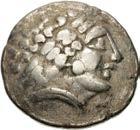




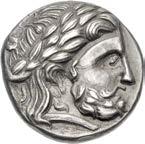

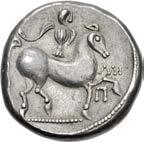
Ex Numismatica Ars Classica 126 (17 November 2021), lot 288; Classical Numismatic Group 87 (18 May 2011), lot 723.


2. EASTERN EUROPE, Imitations of Philip II of
BC. AR Tetradrachm (23.5mm, 12.34 g, 7h). Puppenreiter Type. Mint in the Carpathian region. Laureate head of Zeus right / Horseman riding right, cloak flowing behind; to right, 222 above raised foreleg, ∏ below. OTA 417/3; Flesche 560; Lanz 720; CCCBM I 129; KMW –; Pink 417. Toned. EF. Attractive early Celtic imitation, high relief portrait. ($2000)


Ex Mark and Lottie Salton Collection.
Rare Imitation of Caesar Portrait Issue
3. EASTERN EUROPE, Imitations of Roman Republican. Geto-Dacians. After 44 BC. AR Denarius (16mm, 3.68 g, 7h). Imitating Julius Caesar with the moneyer P. Sepullius Macer. Wreathed and veiled head right; CAeÍAr DiCT perpeTuO around / Venus standing left, holding Victory and scepter, to right at feet, shield set on ground; ÂACer down left; [p • Í]epuLLiuÍ down right. Davis –. For prototype: cf. Crawford 480/13. Lightly toned, a few light scratches and deposits. VF. Very rare. Crude yet artistically rendered designs. ($500)


4. CENTRAL EUROPE, Helvetii. 2nd century BC. Pale AV Stater (22mm, 7.14 g, 1h). Imitating Philip II of Macedon type. Celticized head of Apollo right, wearing laurel wreath / Charioteer driving devolved biga left; two parallel lines below. D.F. Allen, “The Philippus in Switzerland and the Rhineland” in SNR 53 (1974), 4d, pl. 11, 67–8; Basel –; Flesche –; KMH –; HMZ 1-8; Muret & Chabouillet 8912; Zürich –. Typical weak strike, minor edge splits. VF. Very rare. ($2000)
Ex Sincona 70 (19 May 2021), lot 3001.
5. CENTRAL EUROPE, Vindelici. Early 1st century BC. AV 1/4 Stater (11mm, 1.86 g, 11h). ‘Vogelkopf’ type. Head of eagle(?) left; pellet above and below beak; all within wreath-like torc / Five pellets within torc. Kellner Type II C, 527; Allen & Nash 155 var. (six pellets, stater); Flesche 302 (this coin); KMW 449 var. (stater). Good VF. ($3000)
Ex Christian Flesche Collection; Hauck & Aufhäuser 20 (16 October 2007), lot 9.
6. GAUL, Northwest. Aulerci Eburovices. Late 3rd-early 2nd century BC. AV Hemistater (16mm, 3.68 g, 11h). Celticized head of Apollo left; below, boar standing inverted right on jaw of Apollo / Celticized biga right, with devoloved charioteer above, pellets to right; below, wolf standing right. Scheers, Eburovices Series Ia, 19; D&T 2387; Depeyrot, NC V, 133; Sills 196-198; Scheers, SM 281; de la Tour 7170; Allen & Nash –. Lustrous. In NGC encapsulation 6290543-012, graded XF, Strike: 5/5, Surface: 5/5. Rare. ($3000)
7. GAUL, Northwest. Aulerci Eburovices. Late 3rd-early 2nd century BC. AV Hemistater (15.5mm, 3.45 g, 7h). Celticized head of Apollo left; below, boar standing inverted right on jaw of Apollo / Celticized biga right, with devolved charioteer above, pellets to right; below, wolf standing right. Scheers, Eburovices Series Ia, 19; D&T 2387; Depeyrot, NC V, 133; Sills 196-198; Scheers, SM 281; de la Tour 7170; Allen & Nash –. Lightly toned. Good VF. Rare. ($2000)
8. GAUL, Northwest. Veneti. Circa 100-50 BC. AR Stater (20.5mm, 7.05 g, 6h). Celticized head right, hair flowing in tufts around; strings of pearls to right / Celticized biga right, charioteer devolved into creature above, holding rosette on wavy line, horse with human head; triangle to right; below, hippocamp right. Cf. Depeyrot, NC VIII, 216; cf. D&T 2306–7; cf. de la Tour 6811; Flesche –; cf. Gruel & Morin 546–81. Lightly toned, minor porosity, a few encrustations. VF. Very rare, the hippocamp with triangle is seemingly unpublished. ($2000)




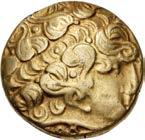



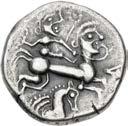

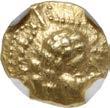

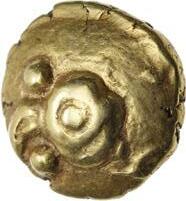



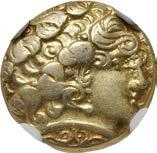
Ex Elsen 149 (10 December 2021), lot 162.
9. GAUL, Northwest. Veneti. 3rd century BC. AV Quarter Stater (11mm, 1.75 g, 7h). Celticized head right, ornamented with pearl strings flowing around / Devolved charioteer driving biga led by androcephalic horse right, holding reins and long branch connected to vexillum-like device to right; below, four-spoked wheel. Depeyrot, NC VIII, 197 var. (wheel type); D&T 2135-6 var. (same); Brenot & Sheers 947 var. (same); de la Tour 6903 (same). In NGC encapsulation 6290544-002, graded AU, Strike: 3/5, Surface: 5/5. Very rare variety, seemingly unpublished wheel type. ($2000)
10. GAUL, Northeast. Remi. Late 2nd-mid 1st century BC. AV Stater (17mm, 5.93 g, 7h). Celticized eye in profile; pellet-in-annulet within circle to right, pellets around / Celticized horse prancing left; circle-in-annulet below, pellet-in-annulet to left, pellets around. Depeyrot, NC VII, 75 (Treveri); D&T 177; Scheers 30 (Treveri); Flesche 246 (this coin); de la Tour 8815 (Treveri). Small edge split. Good VF. ($2000)
Ex Christian Flesche Collection; Lanz 117 (24 November 2003), lot 37.
See the British section below for a collection of British Celtic coinage.




11. ETRURIA, Populonia. 3rd century BC. AR 20 Asses (20.5mm, 8.18 g). Diademed facing head of Metus; c / ≈ (mark of value) below / Blank. EC Group XII, Series 52 corr. (O20; mark of value); Vecchi II, 13, 56; HN Italy 142; SNG ANS 77; SNG BN 5; SNG Copenhagen 1 (all from the same die). Toned, minor metal flaws, deposits on obverse, scratches on reverse. Good VF. ($1500)
From the D.K. Collection. Ex Numismatica Ars Classica 120 (6 October 2020), lot 201.
12. ETRURIA, Uncertain inland mint. Circa 300-250 BC. Æ (20mm, 6.63 g, 7h). Head of African right / Elephant standing right, bell hanging from neck; µ (Etruscan M) below. Vicari 236; Baglione 1c; HN Italy 69; SNG BN 136–7. Green patina, a couple of flan flaws on reverse. VF. Well centered and struck for issue. Rare with this letter on reverse. ($1000)

Ex Classical Numismatic Group Electronic Auction 477 (23 September 2020), lot 9; Nomos 13 (7 October 2016), lot 109; Künker 273 (14 March 2016), lot 68.
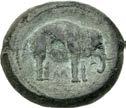
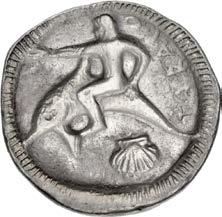

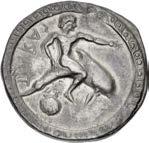


13. CALABRIA, Tarentum. Circa 510-500 BC. AR Nomos (25mm, 7.88 g, 12h). Taras, nude, riding dolphin right, extending left hand, right hand resting on dolphin’s back; ßʼnÅt to left, scallop shell below, dot-and-cable border around / Incuse of obverse type; tÅrÅß in relief to right, radiate border around. Fischer-Bossert Group 1, 5 (V6/R5); Vlasto 66 = Kunstfreund 50 = Rosen 9 (same dies); HN Italy 826; SNG Ashmolean 197 = Hermitage Sale II 42 (same dies); Gulbenkian 16 = Jameson 80 (same dies); Kraay & Hirmer 294. Lightly toned, a few scratches, slight doubling on obverse. Good VF. The rarest city producing incuse types in Magna Graecia. ($20,000)
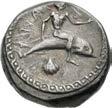
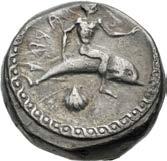
Ex Numismatica Ars Classica 120 (6 October 2020), lot 206.
The city of Tarentum was founded in the late 8th century BC by Spartan colonists on the north coast of the gulf of the same name, on a rocky islet at the entrance to the only secure harbor. It was Sparta’s only colony and maintained close relations with the mother city. The official founder of the city was believed to be the Spartan leader Phalanthos. Ancient tradition, however, tells how Taras, the son of Poseidon and a local nymph, Satyra, was miraculously saved from a shipwreck by his father, who sent a dolphin on whose back he was carried to shore, at which spot he founded a city.
Blessed with fertile land, Tarentum became famous for olives and sheep. It possessed a fine harbor, great fisheries, and profitable exports of wool, purple dye, and pottery. It adopted a democratic form of government circa 475 BC, and thereafter became the leading Greek city in southern Italy. Its success led to continual difficulties with its neighbor cities, though, and on four occasions Tarentum required expeditions from Greece to help overcome its aggressors. The last of these expeditions was led by the famed Epeirote, Pyrrhos. Following his withdrawal from the city, Tarentum was occupied by the Romans.
It was not until late in the 6th century that Tarentum felt the need to produce coinage. It did so by copying the broad, thin fabric with incuse reverse type already in use by Metapontum, Sybaris, Poseidonia, Kaulonia, and Kroton. Tarentum quickly grew in power and wealth. As with many cities that began coinage at the time, the types depicted relate to the city’s foundation, both in its historical and mythological forms. Taras’ prosperity is exemplified by its vast coinage, which was continuous from circa 510 BC until the end of the Second Punic War.
14. CALABRIA, Tarentum. Circa 480-470 BC. AR Nomos (18mm, 7.82 g). Taras, nude, raising left hand and supporting himself with his right, riding dolphin right; [ß]ʼnÅt to left, scallop shell below / Wheel of four spokes. FischerBossert Group 4, 72 (V33/R55); Vlasto 80–1 (same dies); HN Italy 833; SNG ANS 828 (same dies); SNG Ashmolean 205 (same dies); SNG Copenhagen 768 (same dies); Weber 513 (same dies). Toned, struck with worn dies. VF. ($1000)

15. CALABRIA, Tarentum. Circa 480-470 BC. AR Nomos (19mm, 7.46 g). Taras, nude, raising left hand and supporting himself with his right, riding dolphin right; ßʼnÅt to left, scallop shell below / Wheel of four spokes. FischerBossert Group 4, 80 (V40/R– [unlisted rev. die]); Vlasto 80–1; HN Italy 833; SNG Fitzwilliam 225 (same obv. die); de Luynes 261 (same obv. die). Toned, some die wear on obverse. VF. ($1000)
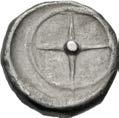
16. CALABRIA, Tarentum. Circa 272-240 BC. AR Nomos (20.5mm, 6.42 g, 6h). Reduced standard. Youth, nude, placing right hand on mane, and holding rein in left, on horseback right; to left, Nike flying right, crowning him; ΦI to right, APIΣTEI[Δ-AΣ] below / Phalanthos, nude, holding grain ear in right hand and cradling ornate trident in left arm, riding dolphin left; ™ to right, tÅrÅs below. Vlasto 910 (this coin); HN Italy 1042; SNG ANS 1230. Toned, a little off center on obverse. EF. ($1000)
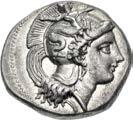






From the GTP Collection. Ex Nomos FPL (Winter/Spring 2015), no. 5; Michel Pandely Vlasto (†1936) Collection.
17. LUCANIA, Herakleia. Circa 390-340 BC. AR Nomos (21mm, 7.83 g, 11h). Head of Athena right, wearing singlependant earring, necklace, and crested Attic helmet decorated with Skylla throwing stone held in right hand; [EU to right] / Herakles standing facing, torso right, strangling the Nemean Lion to right; [^˙rÅk¬-E5W@ above], [Åπo¬] and club to left, oinochoe below. Work 47 (same dies); Van Keuren 51 (same obv. die as illustration); HN Italy 1378; SNG ANS 66; Bement 138 (same obv. die); Hunterian 7 (same dies); McClean 825 (same obv. die); Weber 706 (same dies). Lightly toned, underlying luster, a few hairlines, light scuff on obverse. EF. ($1000)
18. LUCANIA, Metapontion. Circa 540-510 BC. AR Nomos (28.5mm, 6.89 g, 12h). Ear of barley with seven grains; 7eTå down left field, grasshopper upward to right / Incuse ear of barley with seven grains; outline of dolphin upward to left. Noe Class V, 100 (same dies); HN Italy 1472; SNG ANS 206 (same dies); Basel 130 (same dies); Gillet 132 (this coin); Kraay & Hirmer 229 (same dies). Toned, die breaks on reverse (diagnostic for die). Near EF. ($20,000)



Ex Antiquarium Group (CNG inventory 494707, August 2020); Gasvoda Collection (Triton XXII, 9 September 2019) lot 18; Numismatica Ars Classica 92 (23 May 2016), lot 88; A. D. Moretti Collection; Numismatica Ars Classica 18 (29 March 2000), lot 22; Numismatica Ars Classica 9 (16 April 1996), lot 57; Leu 42 (12 May 1987), lot 46; Charles Gillet Collection.
One of the most interesting varieties of Metapontion’s incuse coinage is the issue that includes the locust (or grasshopper) design detail, as here. There are a number of variations. Here the insect paired with a dolphin in outline on the reverse. The locust would have been a serious threat to the agricultural bounty of Metapontion, and it has been speculated its appearance here marks an outbreak of locusts that was ended by the intervention of Apollo, who is represented by the dolphin.
19. LUCANIA, Metapontion. Circa 430-400 BC. AR Nomos (20mm, 7.60 g, 7h). Veiled head of female right, hair in band, wearing single-pendant earring; [cross-headed torch to right] / Barley ear with six grains in middle and left rows, seven grains in right; ÂEt-Åπo around. Noe 322 (same rev. die); HN Italy 1511; SNG ANS 280 (same rev. die); SNG Lloyd 327 = Bement 171 (same rev. die); SNG München 950 (same rev. die). Old collection tone, minor roughness, a number of light scratches in fields. Good VF. Rare, only three in CoinArchives. ($7500)
20. LUCANIA, Metapontion. Circa 340-330 BC. AR Nomos (20.5mm, 7.63 g, 12h). Head of Demeter right, wearing grain ear wreath, veil, triple-pendant earring, and pearl necklace; { below chin / Grain ear with leaf to left; to left, mouse above leaf, f below; ÂEtÅ downward to right, f to right of stem. Johnston Class A, 8.20 corr. (details of rev.; same dies); HN Italy 1570; SNG ANS 819 var. (orientation of legend; same obv. die); SNG Copenhagen 1218 (same dies); SNG Lloyd 386 var. (same; same obv. die); McClean 956 var. (same; same obv. die). Toned, slightly compact flan. VF. ($750)

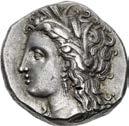




21. LUCANIA, Metapontion. Circa 340-330 BC. AR Nomos (20mm, 7.76 g, 6h). Bearded head of Leukippos right, wearing Corinthian helmet; ÅÂ5 to left / Barley ear with leaf to right; [ÂEtÅ upward to left], vertical thunderbolt above leaf. Johnston Class B, 4.3 (same dies); HN Italy 1574; SNG ANS –; SNG Copenhagen 1214. Deep old cabinet tone, hairline flan crack, a little off center on reverse. Superb EF. An excellent example of this type. ($3000)




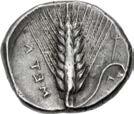

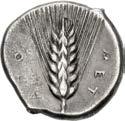
Ex Roma II (2 October 2011), lot 22.
22.
23. LUCANIA, Thourioi. Circa 400-350 BC. AR Dinomos – Distater (27mm, 15.74 g, 4h). Head of Athena left, wearing crested Attic helmet decorated on its bowl with Skylla scanning; d behind neck guard / Bull butting right; QoUr5W@ above; in exergue, fish right. Noe, Thurian D4 (same dies); HN Italy 1804; SNG ANS 960 (same dies); SNG Lockett 489 (same dies); Nanteuil 182 (same dies). Toned, some old scratches under tone on obverse, minor flan flaw on reverse. Near EF. ($5000)
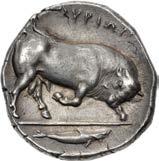
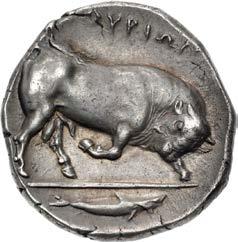
Ex Leu 38 (13 May 1986), lot 10.
24. LUCANIA, Thourioi. Circa 350-300 BC. AR Dinomos – Distater (26.5mm, 15.58 g, 9h). Head of Athena right, wearing crested Attic helmet, decorated with Skylla holding a stone and scanning, and triple-pendant earring / Bull butting right; above, QoUr5W@ above EUfÅ; in exergue, two fish right. Noe, Thurian J2–4 (same obv. die); HN Italy 1823; BMC 39 (same obv. die). Deep iridescent tone, a few minor flan flaws, double struck on reverse. Good VF. Very rare with Skylla holding stone while scanning. ($5000)
Ex Mark and Lottie Salton Collection; Salton-Schlessinger FPL 33 (Winter 1961/2) no. 6.
25.
LUCANIA, Velia. Circa 465-440 BC. AR Drachm (15mm, 4.00 g, 4h). Head of nymph right / Owl standing right, head facing, on olive branch; ¨E¬˙ to left, d to upper right. Williams Period II, 87 (O63/R61); HN Italy 1265; SNG Delepierre 401 (same dies); BMC 9 (same rev. die). Toned, porous, a few minor marks. VF. ($500)
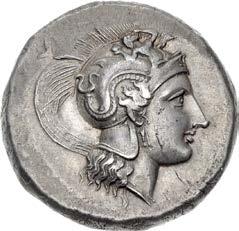

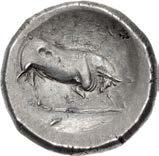



From the Pythagoras Collection.

26. BRUTTIUM, Kaulonia. Circa 525-500 BC. AR Nomos (20mm, 8.38 g, 12h). Apollo advancing right, holding branch aloft in right hand, left arm extended, upon which a small daimon, holding branch in each hand, runs right, head reverted; ˚å¨Ò to left; to right, stag standing right, head reverted; dot-and-cable border / Incuse of obverse, but daimon, branch, and stag’s antlers in outline and no ethnic; radiate border. Noe, Caulonia, Group A, 5h (this coin); Gorini 3; HN Italy 2035; SNG ANS 142 (same dies); SNG München 1396 (same dies); Gulbenkian 119 (same dies); Hermitage Sale II 163 (same obv. die); Hunterian 2 (same obv. die). Lovely old collection toning. In NGC encapsulation 4284630-001, graded Ch AU★, Strike: 5/5 - Surface: 5/5, Fine Style. ($25,000)


Ex Gasvoda Collection (Triton XXII, 8 January 2019), lot 76; Numismatica Genevensis SA 7 (27 November 2012), lot 133; Peter Guber Collection (Manhattan Sale II, 4 January 2011), lot 5; Freeman & Sear FPL 11 (Spring/Summer 2006), no. 11; Münzen und Medaillen AG 52 (19 June, 1975), lot 51; Frank Sherman Benson Collection (Sotheby, Wilkinson & Hodge, 3 February 1909), lot 99 (lot won by Rollin & Feuardent).
27. BRUTTIUM, Kaulonia. Circa 400-389/8 BC. AR Nomos (22mm, 6.55 g, 9h). Apollo advancing right, holding branch in raised right hand, fillet hanging over extended left arm; bird trap to left / Stag standing right; ˚ÅU¬W@-5ÅtÅs around. Noe, Caulonia, Group J, 176–81; HN Italy 2062; Hermitage Sale II 169 (this coin). Old collection tone, deposits, scratches under tone, minor lamination on obverse. VF. ($4000)


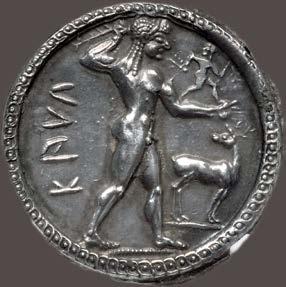

Ex Mark and Lottie Salton Collection; Hermitage Museum Collection (Schlessinger 13, 4 February 1935), lot 169.
28. BRUTTIUM, Kroton. Circa 530-500 BC. AR Nomos (29mm, 8.21 g, 12h). Spread incuse type. Tripod, legs surmounted by wreaths and terminating in lion’s feet, two serpents rising inward from feet, set on basis of three lines, the center dotted; J®o to left / Incuse tripod as obverse, but no serpents. Gorini 1; Attianese 4; HN Italy 2075; SNG ANS 238–41; Boston MFA 176; Jameson 417; Kraay & Hirmer 264. Deep iridescent tone. Superb EF. ($7500)
Ex Gasvoda Collection (Triton XXII, 9 September 2019) lot 80; Nomos FPL (Winter-Spring 2013), no. 2; Numismatica Genevensis SA VI (30 November 2010), lot 19.

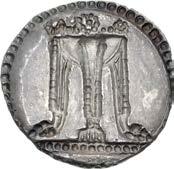
29. BRUTTIUM, Kroton. Circa 530-500 BC. AR Nomos (28.5mm, 7.75 g, 12h). Spread incuse type. Tripod, legs surmounted by wreaths and terminating in lion’s feet, two serpents rising inward from feet, set on basis of three lines, the center dotted; J®o to left / Incuse tripod as obverse, but serpents in relief. Gorini 3 and p. 152–3 = Basel 194; Attianese 5; HN Italy 2075; SNG ANS 229; SNG Lewis 246; de Luynes 701. Lightly toned. EF. Excellent metal for issue. ($10,000) Ex Gorny & Mosch 273 (19 November 2020), lot 42.
30. BRUTTIUM, Kroton. Circa 500-480 BC. AR Nomos (23.5mm, 7.38 g, 9h). Medium incuse type. Tripod, legs surmounted by wreaths and terminating in lion’s feet; orJ to right / Incuse eagle flying right, leg in relief. Gorini 6 var. (position of ethnic); Attianese 54; HN Italy 2095; SNG ANS 287. Toned, edge splits, light deposits. Near EF. ($1500)



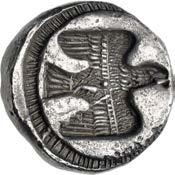
31. BRUTTIUM, Kroton. Circa 500-480 BC. AR Nomos (23.5mm, 7.70 g, 9h). Medium incuse type. Tripod, legs surmounted by wreaths and terminating in lion’s feet, set on basis of two lines, the upper dotted; Jro-to at sides / Incuse eagle flying right, leg in relief. Gorini 8 var. (ethnic); Attianese 9 (same obv. die as illustration); HN Italy 2095; SNG ANS 284 (same dies); SNG Ashmolean 1469 (same obv. die). Old collection tone, some marks, light scrape and small delamination on obverse, some die wear on reverse. Good VF. ($1000)
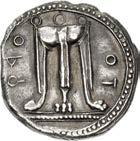




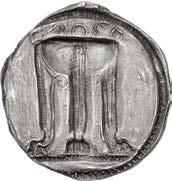
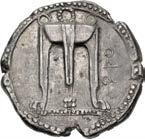

32. BRUTTIUM, Kroton. Circa 480-430 BC. AR Nomos (19mm, 8.11 g, 6h). Tripod, legs terminating in lion’s feet; orJ to right / Incuse eagle flying right, leg in relief. Gorini 27; Attianese 54; HN Italy 2108; Jameson 419a (this coin). Old cabinet tone, a hint of porosity on obverse. Good VF. Attractive specimen with an illustrious pedigree. ($5000)
Ex Peus 428 (28 April 2021), lot 42; Walter Niggeler Collection (Part I, Leu/Munzen und Medallien, 3 December 1965), lot 73; Robert Jameson Collection (publ. 1913); Duruflé Collection (not in Rollin & Feuardent 1910 sale).

33. BRUTTIUM, Lokroi Epizephyrioi. Circa 344-318 BC. AR Nomos (22.5mm, 8.69 g, 2h). Time of Timoleon. Pegasos flying left; thunderbolt below / Head of Athena left, wearing Corinthian helmet with neck guard; ¬o˚rW@ to left. Spinelli Group I, 1b; Pegasi 13; HN Italy 2342; SNG ANS 513 (same dies); SNG Ashmolean 1549 (same rev. die); SNG Lloyd 648; Pozzi 1731. Lustrous. Choice EF. Well centered. ($1500)
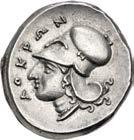


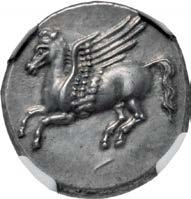
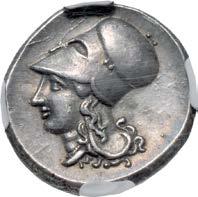





34. BRUTTIUM, Medma. 330-317 BC. AR Stater (19.5mm, 8.61 g, 10h). Pegasos flying left / Head of Athena left, wearing Corinthian helmet with neck guard; tiny  below neck truncation. Gorini, Die, Group II, 38–40 corr. (O4/R8A [these three coins in Gorini are from a different rev. die]); Pegasi 1/2 (same dies); HN Italy 2425; SNG ANS 590 = SNG Berry 783 (same obv. die). In NGC encapsulation 6290617-007, graded AU★, Strike: 5/5, Surface: 5/5. ($3000)
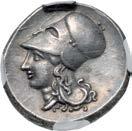
Ex Mark & Lottie Salton Collection.
35. BRUTTIUM, Medma. 330-317 BC. AR Stater (21.5mm, 8.55 g, 3h). Pegasos flying left; / below / Head of Athena left, wearing Corinthian helmet with neck guard. Gorini, Die, Group III, dies O7/R10; Pegasi 5 = SNG Copenhagen 1899 (same dies); HN Italy 2424; SNG Ashmolean 1574 (same obv. die); SNG Fitzwilliam 1838 (same obv. die). Old collection tone, double struck on obverse. EF. Well centered. ($3000)
Ex Mark & Lottie Salton Collection.
36. BRUTTIUM, Terina. Circa 400-356 BC. AR Nomos (20mm, 7.71 g, 12h). Head of the nymph Terina right, wearing triple-pendant earring and pearl necklace; tEr5@Å5W@ to right / Nike seated left on plinth, holding out right hand upon which a small bird alights, left hand resting on plinth. Regling, Terina 81e (dies MM/σσσ) = Jameson 493 (this coin); Holloway & Jenkins 84 (same dies as illustration); HN Italy 2629; SNG Fitzwilliam 869 (same dies); Dewing 541 (same obv. die). Old cabinet tone. Good VF. Well centered. ($20,000)


Ex Numismatica Ars Classica 120 (6 October 2020), lot 244; Numismatica Genevensis SA VII (27 November 2012), lot 139; Nomos 6 (8 May 2012), lot 11; LHS 95 (25 October 2005), lot 488; Robert Jameson Collection (publ. 1913); Gustav Philipsen Collection (Part I, J. Hirsch XV, 28 May 1906), lot 887; Late Collector’ [Rothschild Collection] (Sotheby, Wilkinson and Hodge, 28 May 1900), lot 80; Hyman Montagu Collection (Part I, Sotheby, Wilkinson & Hodge, 23 March 1896), lot 84.
The high artistry evident on Terina’s coinage seems out of all proportion to any historical accounts for this city atop the “toe” of Italy, which so thoroughly disappeared from record that no systematic excavations were undertaken on its site until 1997. Its coinage has been known and collected since the Renaissance, where the delicate beauty of its female heads and the graceful seated Nikes were greatly admired. As author R. Holloway noted, “the nymphs of Terina recalled the maidens of the Parthenon frieze and the Victories of the reverses were the numismatic counterparts of the Victories of the Nike Temple balustrade.” Kurt Regling’s 1906 seminal die study on the city features this lovely specimen, which is pedigreed to 1896 and reposed in several of the most famous European collections of the 20th century.




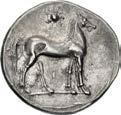
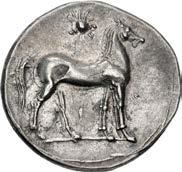
38. SICILY, Akragas. Circa 420-415 BC. AR Tetradrachm (29mm, 16.93 g, 6h). Sea eagle, wings raised, standing left on, and tearing at, dead hare, upturned left on rock below; AKPAΓ-ANTIN-O-N around / Crab; scallop shell to left, conch shell to right; below, grouper left. Westermark, Period III, 530.13 (O1/R2) = Schwartz & Mildenberg pp. 57–8, 3 = Kraay & Hirmer 173 = Mionnet 39 (this coin); HGC 2, 81; SNG Lloyd 822; ACGC 793 = Ward 140; Basel 257; BMC 59; Boston MFA 235 = Warren 201; Gulbenkian 164 = Locker Lampson 59; Jameson 508; McClean 2044; Winterthur 577 = Pozzi 390 (all from the same dies). Attractive old cabinet tone, slight die shift and a few light marks under tone on reverse. Good VF. Rare. ($50,000)
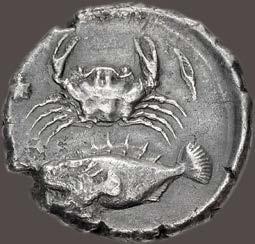


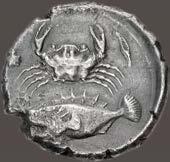
Ex Max Hirmer Collection, purchased from Bank Leu, 10 March 1961; Münzen und Medaillen AG inventory (1947); deaccessioned from the Départment des Monnaies, Médailles et Antiques, Bibliothèque Nationale de France (Fonds Générale 88; publ. in 1807 by Mionnet).
Akragas was founded in about 580 BC and quickly grew into one of the most prosperous Greco-Sicilian cities, with a population in the hundreds of thousands. Its wealth derived from the rich soil fed by the River Hypsas, productive tidepools, and trade. From its earliest coinage, struck circa 510 BC, Akragas featured the eagle, sacred to Olympian Zeus, to whom the city dedicated an immense temple, backed with an overhead view of a crab, harvested from the river as a delicacy in the region. As the city’s wealth and influence increased, the basic design was augmented and improved, with artistic achievement reaching its zenith in the period 420-406 BC, when this rare and remarkable piece was struck. Here the eagle has just snatched up its prey, a hare (symbol of the Sicilian city of Messana -- perhaps a sly allusion to civic rivalry?), and slammed it back onto a tidepool rock to which a scallop shell has attached itself, a scene of “nature red in tooth and claw” captured with a keen eye for detail and rendered with astonishing skill. On the reverse, the crab is joined on the sea bottom by a large, wide-mouthed fish with a spiny dorsal fin and fan-like tail, a rendering lifelike enough to identify the species as the stone grouper (polyprion cernium). To the left and right are another scallop and a sea snail, further symbols of aquatic bounty. The superb artistry of this particular piece was celebrated by its inclusion in Kraay & Hirmer’s Greek Coins (Thames & Hudson, 1966), a magnificent “coffee table book” of the finest in Greek numismatics that has achieved legendary status.
39. SICILY, Entella. Punic issues. Circa 345/38-320/15 BC. AR Tetradrachm (26mm, 16.81 g, 3h). Head of Arethousa left, wearing wreath of grain ears, triple-pendant earring, and necklace; four dolphins around / Horse standing right; palm tree in background, crescent to upper left, poppy head below. Jenkins, Punic, Series 2c, 119 (O39/R108); CNP 176b; HGC 2, 277; SNG Lloyd 1618 (same dies); McClean 3039 (same dies). Attractive cabinet tone with golden iridescence around the devices, a hint of die rust and a little off center on obverse. EF. An attractive specimen. ($10,000)
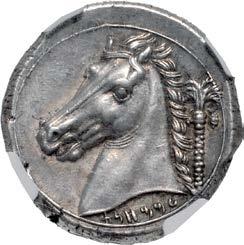
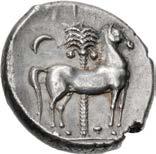




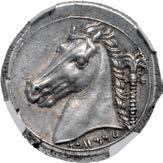
Ex Numismatica Ars Classica 120 (6 October 2020), lot 328; 51 Gallery (9 December 2013), lot 118. Reportedly ex Blayaert Collection, purchased from Tradart in the 1980s.
While many tetradrachms of Punic Entella are patterned on coins of Syracuse, none are as closely copied as this variety, the obverse of which uncannily resembles a dekadrachm of the Euainetos type. The head of Arethousa and the dolphins frolicking around her are more faithfully rendered than even the engravers of Syracuse itself could achieve under Agathokles a few decades after this issue was struck.


40. SICILY, Entella. Punic issues. Circa 320/15-300 BC. AR Tetradrachm (27mm, 17.05 g, 7h). Head of Arethousa left, wearing wreath of grain ears, triple-pendant earring, and pearl necklace; four dolphins around / Head of horse left; palm tree to right, †nJMM` (Punic ‘MMḤNT) below. Jenkins, Punic, Series 3a, 148 (O47/R133); CNP 267; BAR Issue 4; HGC 2, 284; SNG Lloyd 1631 (same dies); de Luynes 1458 (same dies). Lightly toned, a few hairlines. Good VF. ($3000)
41. SICILY, Entella. Punic issues. Circa 320/15-300 BC. AR Tetradrachm (25mm, 17.10 g, 6h). Head of Arethousa left, wearing wreath of grain ears, triple-pendant earring, and pearl necklace; four dolphins around / Head of horse left; palm tree to right, †nJMM` (Punic ‘MMḤNT) below. Jenkins, Punic, Series 3a, 150 (O47/R135); CNP 267; BAR Issue 4; HGC 2, 284; SNG Fitzwilliam 1487 (same obv. die); SNG Lloyd 1631 (same obv. die); de Luynes 1458 (same obv. die). In NGC encapsulation 6290603-008, graded AU★, Strike: 5/5, Surface: 5/5, Fine Style. Exceptional horse head, with fully struck eye. ($10,000)
Ex Mark & Lottie Salton Collection. Reportedly ex 1957 Pachino Hoard.

42. SICILY, Entella. Punic issues. Circa 320/15-300 BC. AR Tetradrachm (25mm, 16.48 g, 1h). Head of Arethousa right, wearing wreath of grain ears, triple-pendant earring, and pearl necklace; four dolphins around / Head of horse left; palm tree to right, †nJMM` (Punic ‘MMḤNT) below. Jenkins, Punic, Series 3a, 180 (O51/R160); CNP 268; BAR Issue 4; HGC 2, 286; Ars Classica XV, lot 430 (same dies). Toned, thin die breaks on reverse. Good VF. ($3000)



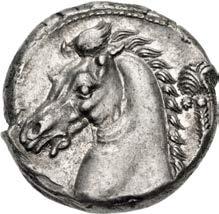

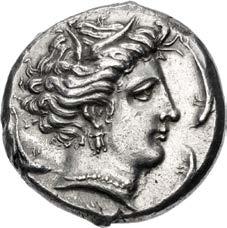




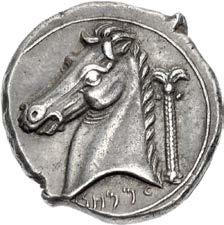
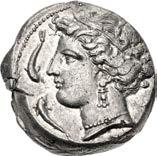

From the GTP Collection. Ex CNG inventory 926175 (May 2012); Mayflower (Sukenik) Collection (Heritage 3019, 25 April 2012), lot 23052; Superior (9 December 1994), lot 663.
43. SICILY, Entella. Punic issues. Circa 320/15-300 BC. AR Tetradrachm (24.5mm, 17.10 g, 6h). Head of Arethousa left, wearing wreath of grain ears, triple-pendant earring, and pearl necklace; four dolphins around / Head of horse left; palm tree to right, †nJMM` (Punic ‘MMḤNT) below. Jenkins, Punic, Series 3a, – (O54/R164 [unlisted die combination]); CNP 267; BAR Issue 4; HGC 2, 284; SNG Lloyd 1636 (same obv. die). Attractive cabinet tone. EF. ($7500)

Ex
44. SICILY, Entella. Punic issues. Circa 320/15-300 BC. AR Tetradrachm (24.5mm, 17.08 g, 3h). Head of Arethousa left, wearing wreath of grain ears, triple-pendant earring, and pearl necklace; three dolphins around / Head of horse left; palm tree to right, MM (Punic MM) below. Jenkins, Punic, Series 3b, 214 (O64’/R186); CNP 265a; BAR Issue 4; HGC 2, 287; de Luynes 1464 (same obv. die). A little off center on obverse, minor die wear on reverse. EF. ($5000)
45.
46. SICILY, Gela. Circa 450-440 BC. AR Tetradrachm (29.5mm, 16.64 g, 10h). Charioteer, holding kentron in right hand and reins in left, driving slow quadriga right; above, Nike flying right, crowning horses with wreath held in both hands; palmette with long tendrils in exergue / Forepart of man-headed bull right; !Es above. Jenkins, Gela, Group IV, 342 (O66/ R133); HGC 2, 343; Hermitage Sale I 50 (same dies); de Luynes 952 (same dies); Prospero 124 (this coin). Toned, light scratches under tone. VF. ($7500)


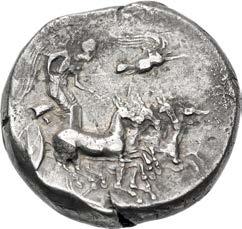

Ex Prospero Collection (New York Sale XXVII, 4 January 2012), lot 124, purchased from Spink & Son, 19 November 1985; Sotheby’s (22 April 1970), lot 50.
47. SICILY, Gela. Circa 415-405 BC. AR Tetradrachm (26mm, 17.06 g, 9h). Nike, wearing long chiton, holding kentron in right hand and reins in left, driving fast quadriga right; above, heron flying right / Forepart of man-headed bull advancing left from reeds, before which stands a heron right; above, barley grain above sŬE˝; olive spray with berry to upper right, emanating from the rump of the bull’s forepart behind the reeds; to lower left, fish upward; altar to right. Cf. Numismatica Ars Classica 114, lot 44 = Numismatica Ars Classica 9, lot 155 = Schweizerischer Bankverein Zürich 1, lot 52; cf. Numismatica Ars Classica 132, lot 191; otherwise, unpublished. Toned, minor pitting, some redeposited silver, minor double strike and slightly off center on reverse. VF. Extremely rare issue with this reverse type, one of three known. ($7500)
From the Dr. Michael Slavin Collection, purchased from Classical Cash, 7 April 2000.
This remarkable tetradrachm is part of an issue that was unknown to Jenkins, all with a similar reverse type depicting the forepart of a manheaded bull emanating left from reeds, with a heron and altar in the foreground, and grain ear and fish in the field. The previously known examples (cited above) were struck with Jenkins’s obverse die O96, securely placing the issue within his Group IX, which comprises the last tetradrachm coinage at Gela, struck from arguably the finest style dies. The present piece is struck from a different obverse die, unknown to Jenkins, which is similar to O96, but has no ethnic, and the flying eagle is replaced with a flying heron. The reverse die is also slightly different, depicting the reeds over the midsection of the forepart, giving an even more artistic depiction of the scene, where the bull is emerging from within the reeds.
48. SICILY, Himera. Circa 425-409 BC. Æ



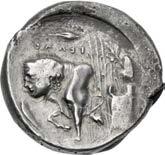
VF. ($500)
From the Pythagoras Collection.
49. SICILY, Leontini. Circa 476-466 BC. AR Tetradrachm (22.5mm, 17.49 g, 9h). Charioteer, holding kentron in right hand and reins in left, driving slow quadriga right; above, Nike flying right, crowning horses with open wreath held in both hands / Head of roaring lion right; o-˜-5-t˜-oE¬ and four barley grains around. Boehringer, Münzgeschichte 4 (same dies); Randazzo 80 (this coin); HGC 2, 660 (same dies as illustration); SNG ANS 201 (same dies); SNG Lloyd –; Basel 347 (same obv. die); Boston MFA 272 (same rev. die); cf. Rizzo pl. XXII, 8/7 (same obv./rev. die). Toned. Near EF. Rare early issue. ($3000)

Ex MoneyMuseum, Zurich Collection (Triton XVIII, 5 January 2015), lot 362; Leu 72 (12 May 1998), lot 75; Randazzo/Sicily, 1980 Hoard (CH VII, 17).
50. SICILY, Leontini. Circa 450-440 BC. AR Tetradrachm (25mm, 17.40 g, 3h). Head of Apollo right, wearing laurel wreath / Head of roaring lion right; 6Eo-˜-t-5-[˜]o-˜ and four barley grains around. Boehringer, Münzgeschichte 41 (same obv. die as illustration); HGC 2, 667; SNG ANS 222–4 (same obv. die); Jameson 629 (same dies); Rizzo pl. XXIII, 1 (same dies). Lightly toned. EF. ($5000)

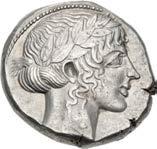
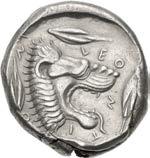


Ex Triton I (2 December 1997), lot 253.
51. SICILY, Leontini. Circa 430-425 BC. AR Tetradrachm (24.5mm, 16.94 g, 12h). Head of Apollo left, wearing laurel wreath / Head of roaring lion right; 6E-o-n-t5-n-on around; barley grain above, to left, and below; leaf to right. Boehringer, Münzgeschichte 55 (same dies); HGC 2, 671 (same dies as illustration); SNG ANS 257 (same dies); SNG Lloyd 1063 (same obv. die); Basel 353 (same dies); Rizzo pl. XXIV, 4 (same dies). Toned, underlying luster, typical die break on obverse at an early state. Superb EF. ($5000)




From the North River Collection. Ex C. G. Collection (Triton XI, 7 January 2008), lot 44; Classical Numismatic Group 63 (21 May 2003), lot 95.

52. SICILY, Lilybaion (as ‘Cape of Melkart’). Circa 330-305 BC. AR Tetradrachm (25.5mm, 17.10 g, 12h). Charioteer, holding kentron in extended right hand and reins in left, driving fast quadriga right; above, Nike flying left, crowning charioteer with open wreath held in both hands; [te]Q¬M[ße] ([RŠ]MLQ[RT] = “Raš Melqart” in Punic) in exergue / Head of Arethousa right, wearing wreath of grain ears, triple-pendant earring, and pearl necklace; four dolphins swimming around. Jenkins, Punic 48 (O17/R37); CNP 318; HGC 2, 741; SNG Lloyd 1599 (same dies); Sartiges 97 (same dies). Attractively toned over lustrous surfaces, some blue iridescence around the periphery. Near EF. Well centered. Impressive. ($3000)
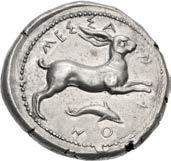
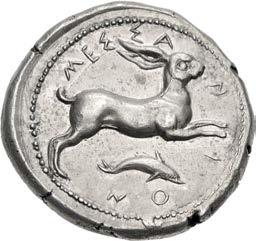




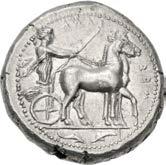

From the North River Collection. Ex Triton IV (5 December 2000), lot 122.
53. SICILY, Messana. 420-413 BC. AR Tetradrachm (24.5mm, 17.21 g, 10h). The nymph Messana, holding kentron in left hand and reins in both, driving slow biga of mules right; µEss-Å@Å above and before / Hare springing right; below, dolphin right; µEss-Å-˜5-o-˜ around. Caltabiano Series XIV, 518 (D206/R215); HGC 2, 792; SNG ANS 356 (same obv. die); SNG Lloyd 1097 (same obv. die); SNG Copenhagen 399 (same obv. die); McClean 2394 (same dies). Lightly toned, underlying luster, slightly weak strike on obverse. Near EF. ($3000)
From the North River Collection. Ex W. B. and R. E. Montgomery Collection (Triton XI, 7 January 2008), lot 48; Classical Numismatic Group 63 (21 May 2003), lot 97.
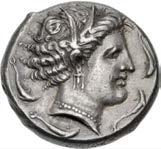

54. SICILY, Messana. 420-413 BC. AR Tetradrachm (27mm, 17.27 g, 3h). The nymph Messana, holding kentron in left hand and reins in both, driving slow biga of mules right; ŘÅs-sEµ counterclockwise from right, two dolphins confronted in exergue / Hare springing right; µEs-sÅ-˜-5-o˜ around; below, dolphin right. Caltabiano Series XIV, 533 (D210/R227); HGC 2, 792; SNG ANS 362; Pozzi 490 (same dies). Lightly toned over lustrous surfaces, minor die wear. Superb EF. Well struck on a broad flan. ($10,000)
Ex CNG inventory 525515 (there priced at $19,500); Numismatica Ars Classica 114 (6 May 2019), lot 57 (hammer CHF 13,000).
55. SICILY, Syracuse. The Gamoroi. Circa 500-490/86 BC. AR Tetradrachm (24mm, 16.94 g, 5h). Charioteer, holding reins in both hands, driving slow quadriga right; ߨRÅ above / Head of Arethousa left in incuse circle in center of quadripartite incuse square. Boehringer Series I, 23E (V17/R13); HGC 2, 1302; Bement 442 (same obv. die); Regling, Antike 261 (same dies); Traité I 2248, pl. LXXIV, 2 (same rev. die). Deep collection tone with some iridescence, light scratch in field on obverse. Near EF. ($20,000)

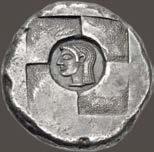

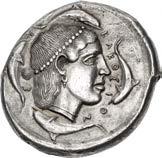
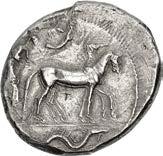

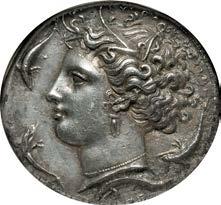
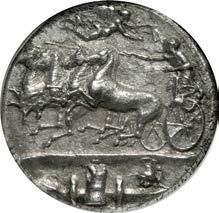
Ex JTB Collection; Numismatica Ars Classica Spring Sale 2020 (25 May 2020), lot 146; Galerie Numismatique Drouot 13 (21 November 1980), lot 946.
56. SICILY, Syracuse.
Tetradrachm (26.5mm, 17.16 g, 9h). Struck circa 460-450 BC. Charioteer, holding kentron in right hand, reins in both, driving slow quadriga right; above, Nike flying right, crowning horses with open wreath held in both hands; in exergue, ketos right / Head of Arethousa right, wearing pearl tainia, singlependant earring, and necklace; s-¨-RÅkos-5-o˜ and four dolphins around. Boehringer Series XIVa, 469 (V252/R338); HGC 2, 1311; SNG ANS 144–5 (same rev. die); SNG München 1008 (same dies); Dewing 787 (same obv. die); Gillet 560 (same dies); Jameson 761 (same obv. die); Pozzi 574 (same obv. die); Randazzo 532 (this coin). Lightly toned, a little off center and double struck on obverse. Good VF. ($7500)
From the D.K. Collection.
421–2
Ex Gorny & Mosch 280 (11 October 2021), lot 105; Hess-Leu 28 (5 May 1965), lot 91.
SNG
5785794-005,
($50,000)
58. SICILY, Syracuse. Dionysios I. 405-367 BC. AV 100 Litrai – Double Dekadrachm (13.5mm, 5.78 g, 3h). Struck circa 400-370 BC. Head of Arethousa left, hair in sakkos adorned with a star, wearing single-pendant earring and necklace; sUrÅ˚os5o@ to left, pellets flanking neck / Herakles kneeling right, strangling the Nemean Lion; rocks below. Bérend Group III, 15.10 (D11/R8 – this coin); HGC 2, 1275; SNG ANS 329 (same dies); SNG Lloyd 1421 (same obv. die); SNG Lockett 985 (same dies); Hunt IV 115 (same obv. die); Jameson 814 (same obv. die); Pozzi 605 (same dies). In NGC encapsulation 6158586-002, graded AU, Strike: 5/5, Surface: 4/5, Fine Style. ($20,000)
Ex Heritage 3048 (11 August 2016), lot 32011; Dr. Lawrence A. Adams Collection (Part III, Triton XIX, 6 January 2006), lot 2018; Triton VI (14 January 2003), lot 110; Spink 32 (30 November 1983), lot 11; Ars Classica XV (2 July 1930), lot 375.
59. SICILY, Syracuse. Dionysios I. 405-367 BC. AV 50 Litrai – Dekadrachm (11mm, 2.89 g, 4h). Struck circa 400370 BC. Head of young male (Anapos?) left; sUrÅ˚os5W@ around / Horse prancing right on exergue line [inscribed sUrÅ˚os5W@]; all within shallow incuse square. Bérend 2 (D1/R2); HGC 2, 1281; SNG ANS 341; SNG Delepierre 688; SNG Fitzwilliam 1269; SNG Lloyd 1425; BMC 170; Dewing 927–8; Sartiges 126 (all from the same dies). In NGC encapsulation 6290614-015, graded VF, Strike: 5/5, Surface: 4/5. Some luster remains, minor marks. ($5000)
Ex Mark & Lottie Salton Collection.
60. SICILY, Syracuse. Agathokles. 317-289 BC. AV Hemistater – Drachm (16mm, 4.26 g, 1h). Struck circa 317-310 BC. Head of Apollo left, wearing laurel wreath; tiny s below / Charioteer, holding kentron in extended right hand and reins in left, driving galloping biga right; triskeles below, sUr-Å˚-os-5W@ around. Bérend, l’or, pl. 9, 1; BAR Issue 1; HGC 2, 1276; SNG ANS 550; SNG Lloyd 1472–3 var. (obv. control mark); Dewing 934 var. (same); Gulbenkian 327 var. (same). In NGC encapsulation 1883232-013, graded AU, Strike: 5/5, Surface: 3/5. ($5000)
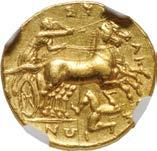

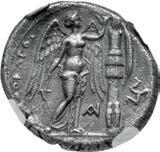








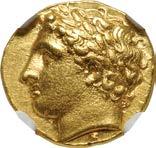
61. SICILY, Syracuse. Agathokles. 317-289 BC. AR Tetradrachm (25mm, 16.19 g, 5h). Struck circa 310-306/5 BC. Head of Kore right, wearing wreath of grain ears, single-pendant earring, and pearl necklace; [˚or]Ås to left / Nike standing right erecting trophy to right; [Å˝Å]Qo˚¬Eos to left, 5 between, clockwise triskeles to lower right. Ierardi 99 (O20/R60); BAR Issue 23; HGC 2, 1536; SNG ANS –; SNG München 1267 (same dies); Gulbenkian 335 (same dies); Sartiges 147 (same dies). Toned. In NGC encapsulation 6556066-002, graded XF, Strike: 4/5, Surface: 2/5, lt. smoothing, scratches. ($3000)

62. SICILY, Syracuse. Hieron II. 275-215 BC. AR 2½ Litrai (14mm, 2.25 g, 9h). In the name of the Syrakosioi. Head of Apollo left, wearing laurel wreath / Female standing facing, head left, holding scroll in extended right hand, and filleted palm frond in left; sUrÅ˚os5o@ to left, E to right. CCO 69–74 and 82–4 var. (unlisted dies); Burnett, Enna 44; BAR Issue 65; HGC 2, 1420. Deeply toned, some minor chips around edge, a couple of small delaminations, minor scuff at edge on reverse. Good VF. Rare. ($500)
From the GTP Collection. Ex Classical Numismatic Group 106 (13 September 2017), lot 54.
64 63
63. SICILY, Syracuse. Philistis, wife of Hieron II. 275-215 BC. AR 16 Litrai – Tetradrachm (26mm, 13.40 g, 2h). Struck circa 240-218/5 BC. Diademed and veiled head left; star to right / ∫Å%5¬5%%Å% f5¬5%t5d[o%], Nike, holding reins in both hands, driving fast quadriga right; crescent above, ˚5[%] to right, grain ear below. CCO 80 (D19/R53); Burnett, Enna 41 (same dies); BAR Issue 65; HGC 2, 1554; BMC 550 (same obv. die). Light iridescent tone around the devices, some minor die wear, small edge chip on reverse. EF. ($3000)
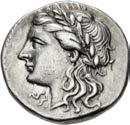



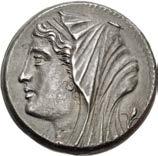


Ex Numismatica Ars Classica 40 (16 May 2007), lot 246.


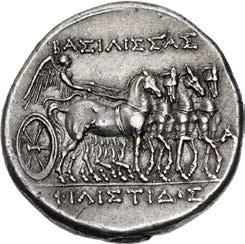
64. SICILY, Syracuse. Philistis, wife of Hieron II. 275-215 BC. AR 16 Litrai – Tetradrachm (26.5mm, 13.37 g, 8h). Struck circa 240-218/5 BC. Diademed and veiled head left; star to right / ∫Å%5¬5%%Å% f5¬5%t5do%, Nike, holding reins in both hands, driving fast quadriga right; crescent above, ˚5% to right, grain ear below. CCO 69–74 and 82–4 var. (unlisted dies); Burnett, Enna 44; BAR Issue 65; HGC 2, 1554. Deeply toned, some minor chips around edge, a couple of small delaminations, scuff at edge on reverse. Near EF. ($3000)
From the S & S Collection. Ex Virginia Ruzicka Collection (Malter XXVIII, 8 December 1984), lot 1.
65. SICILY, Syracuse. Philistis, wife of Hieron II. 275-215 BC. AR 16 Litrai – Tetradrachm (27mm, 13.27 g, 10h). Struck circa 218/7-215 BC. Diademed and veiled head left; filleted thyrsos to right / ∫Å%5¬5%%Å% f5¬5%t5do%, Nike, holding reins in both hands, driving slow quadriga right; Å to right. CCO – (D18/R15 – unlisted die combination); BAR Issue 65; HGC 2, 1556; BMC 553 (same dies); de Nanteuil 395 (same dies); Winterthur 989 (same dies). Toned, a few marks, light cleaning scratches in field on obverse. Near EF. Well centered. ($3000)

Ex Triton XII (6 January 2009), lot 115; Sternberg XX (20 April 1988), lot 448.
This coin is referenced in CCO, erroneously as no. 10 under die combination 203, which has a different obverse die (D15).
66. SICILY, Syracuse. Gelon, son of Hieron II. 275-215 BC. AR 8 Litrai – Didrachm (20mm, 6.71 g, 10h). Struck circa 218/7-214 BC BC. Diademed head left / %UrÅ˚o%5o[5] [˝]E¬W@o%, Nike, holding reins in both hands, driving slow right; ∫Å above, Å to right. CCO 279.2 (D5/R7 – this coin); BAR Issue 66; HGC 2, 1562; Boston MFA 481 (same dies); Hermitage Sale II 400 (same dies); Weber 1703 (same dies). Attractive collection tone, a few minor marks, a little off center, reverse die break. Near EF. ($2000)
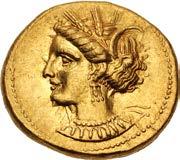
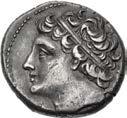

Ex Christie’s (3 March 1970), lot 701; Ciani (with Vinchon, 6 May 1956), lot 279.


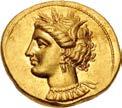

By the fourth century BC, the Punic goddess Tanit and the horse had become the standard types of Carthaginian coinage and remained so for the balance of the city’s existence. Tanit was the primary deity of Carthage. A celestial divinity with some fertility aspects, she was the North African equivalent of Astarte. She is always depicted on the coinage wearing a wreath of grain, which may have been borrowed from Demeter and Persephone as the Carthaginians assimilated the Sicilian culture into their own during the various Punic excursions to the island. The use of the horse on the reverse is usually considered part of the foundation myth of Carthage. According to Virgil’s Aeneid, the Phoenician colonists who founded Carthage were told by Juno (or Tanit) to establish the new colony at the place where they discovered a horse’s head in the ground. Another theory is that the obverse head is actually Demeter or Persephone, whose worship was introduced to Carthage in 396 BC to make amends for the destruction of the goddesses’ temples outside Syracuse by the Carthaginian army.

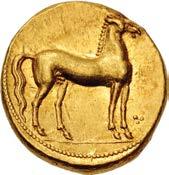



67.
68.
69. CARTHAGE. Circa 350-320 BC. AV Stater (19mm, 9.41 g, 9h). Carthage mint. Head of Tanit left, wearing wreath of grain ears, triple-pendant earring, and necklace with nine pendants / Horse standing right; three pellets to right of forelegs. Jenkins & Lewis Group IIIh, 92 (same obv. die); CNP 1.5h; MAA 4. Fully lustrous, minor die wear. EF. ($10,000)

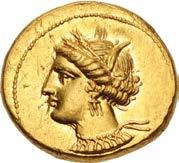
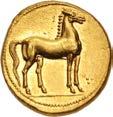


70. CARTHAGE. Circa 350-320 BC. AV Tenth Stater (7.5mm, 0.95 g, 3h). Carthage mint. Palm tree with two date clusters / Head of horse right. Jenkins & Lewis Group III, 136–55; CNP 239; MAA 8; SNG Copenhagen 133. Trace deposits, light scratches. Near EF. ($1000)


From the S & S Collection. Ex Malter XXXI (9 June 1985), lot 3755.
71. SKYTHIA, Tyra. Circa 330-310 BC. AR Drachm (17mm, 5.79 g, 5h). Head of Demeter facing slightly left, veiled and wearing grain ear wreath and necklace / Bull butting left; tUrÅ@o@ above. Zograph, Tyra 2; Anokhin 10; HGC 3, 1953; Prospero 215 (this coin). Old cabinet tone. Good VF. Very rare. Lovely head of Demeter. ($1500)

Ex Prospero Collection (New York Sale XXVII, 4 January 2012), lot 215.
72. THRACE, Abdera. Circa 450-425 BC. AR Tetradrachm (26mm, 14.85 g, 7h). Artemon, magistrate. Griffin springing left / Kantharos in linear square; År-tE-ÂW@ and ivy leaf around; all within shallow incuse square. May, Abdera, Period IV, Group LXIX, 187 (A151/P157) = Hunterian 5 (same dies); AMNG II 71; HGC 3, 1140 (same dies as illustration). A few light marks. EF. Extremely rare, only the Hunterian piece published, none in CoinArchives. ($7500)



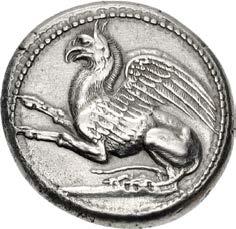

73. THRACE, Ainos. Circa 357-342/1 BC. AR Drachm (16.5mm, 3.72 g, 12h). Head of Hermes facing slightly right, wearing petasos / Cult statue of Hermes Perpheraios on throne; kantharos to left, Å5@[5o@] to right. May, Ainos 436–9 var. (unlisted dies); AMNG II 365; HGC 3, 1280; BMC 23; Pozzi 1040. Find patina, a few minor scratches on reverse. Good VF. Choice for issue. ($2000)

From the Pythagoras Collection, purchased from Leu Numismatik AG.
74 75
74. THRACE, Byzantion. Circa 90-80 BC. AR Tetradrachm (34mm, 15.99 g, 12h). In the name and types of Lysimachos. Diademed head of the deified Alexander right, with horn of Ammon / ∫Å%5¬EW% ¬Us5ÂÅcoU, Athena Nikephoros seated left, left arm resting on shield, transverse spear in background; Ļ to inner left, ∫U below throne, ornate trident in exergue. Callataÿ Group 3, obv. die D5; Müller 208. Minor die wear, small deposit, and die break at edge on obverse. EF. ($500)
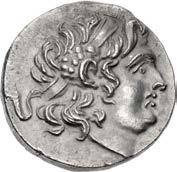



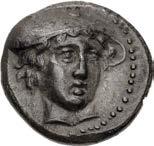

75. THRACE, Byzantion. Circa 90-80 BC. AR Tetradrachm (29.5mm, 16.34 g, 11h). In the name and types of Lysimachos. Diademed head of the deified Alexander right, with horn of Ammon / ∫Å%5¬EW% ¬Us5ÂÅcoU, Athena Nikephoros seated left, left arm resting on shield, transverse spear in background; L to inner left, ∫U below throne, ornate trident in exergue. Callataÿ Group 3, obv. die D53; Müller 157. Light mark on obverse. EF. ($500)
76. THRACE, Maroneia. Circa 400-377 BC. AR Stater (21mm, 12.91 g, 1h). Aeginetic standard. Metrodotos, magistrate. Horse rearing left / Grape arbor in linear square; Â˙t-ro-dot-os around, ivy leaf to upper left; all within shallow incuse square. Schönert-Geiss Period VI, –; AMNG II –; HGC 3, 1528; Lorber Appendix 3, p. 180, a = M&M AG 73, lot 50 (same rev. die); Lanz 135, lot 111 var. (no leaf). Toned, slight die wear on obverse. EF. Extremely rare, one of three known for this magistrate in Period VI. ($3000)


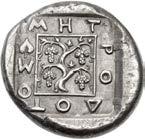
From the JTB Collection. Ex Father & Son Collection; Nomos 19 (17 November 2019), lot 61; Londinium Collection (Triton XXII, 8 January 2019), lot 164.

77 78
77. THRACE, Mesambria. Circa 275/50-225 BC. AR Tetradrachm (28mm, 16.75 g, 12h). In the name and types of Alexander III of Macedon. Head of Herakles right, wearing lion skin / ∫Å%5¬EW% ŬE$Å@droU, Zeus Aëtophoros seated left; helmet in inner left field, r below throne. Karayotov I 3 (O2/R3); Topalov, Messambria, Issue 13; Price 985 corr. (monogram); HGC 3, 1567 (same dies as illustration). EF. Fine early style. ($1500)

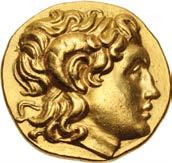


From the GTP Collection. Ex Triton XVI (8 January 2013), lot 254.
78. THRACE, Mesambria. Circa 275/50-225 BC. AR Tetradrachm (30mm, 16.94 g, 12h). In the name and types of Alexander III of Macedon. Head of Herakles right, wearing lion skin / ∫Å%5¬EW% ŬE$Å@droU, Zeus Aëtophoros seated left; in inner left field, crested Corinthian helmet right above Z. Karayotov I 12 (O7/R11); Topalov, Messambria 13; Price 992; HGC 3, 1567; ANS inv. 1955.26.2 (same dies). Even medium gray tone, some light hairlines and marks. EF. Struck from artistic dies. ($1000)

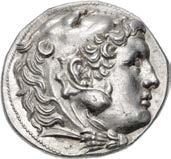
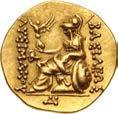

79. THRACE, Mesambria. Circa 250-225 BC. AV Stater (18.5mm, 8.40 g, 12h). In the name and types of Lysimachos of Thrace. Diademed head of the deified Alexander right, with horn of Ammon / ∫Å%5¬EW% 2U%5;ÅcoU, Athena Nikephoros seated left, left arm resting on shield, transverse spear in background; to inner left, Corinthian helmet right; 6 in exergue. Petac, From, pl. 1, 4; Karayotov I 17 = A. Rogalski, “Les statères d’or de Mesambria” [in Bulgarian] in Bulletin du Musée National de Varna 18 (1982), 17; Topalov, Messambria 15; Müller 263; HGC 3, –; Gorny & Mosch 261, lot 154 (same dies). Underlying luster, a few light marks, trace deposits on reverse. EF. Well centered. Extremely rare, only one published (previously in The Hermitage [referred to by all references above, missing since WWII]), and only one additional in CoinArchives (the Gorny & Mosch coin). ($5000)
80. THRACE, Mesambria. Circa 225-175 BC. AR Tetradrachm (31mm, 16.66 g, 1h). In the name and types of Alexander III of Macedon. Head of Herakles right, wearing lion skin / ∫Å%5¬EW% ŬE$Å@droU, Zeus Aëtophoros seated left; to inner left, helmet right; below throne, E∏5 below throne. Karayotov I 82 (O23/R92); Topalov, Messambria 13; Price 1020; HGC 3, 1567. Toned. Good VF. ($500)
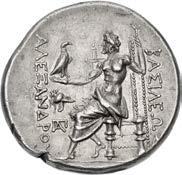
From the GTP Collection. Ex CNG inventory 940284 (December 2012); Elvira Elisa Clain-Stefanelli (“Demarete”) Collection (Stack’s Bowers and Ponterio 172, 13 November 2012), lot 11569; Frederick S. Knobloch Collection (Stack’s, 10 June 1970), lot 187.
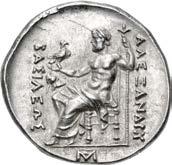
81. THRACE, Mesambria. Circa 125-100 BC. AR Tetradrachm (31.5mm, 16.17 g, 1h). In the name and types of Alexander III of Macedon. Obverse die signed by ANT–. Head of Herakles right, wearing lion skin; &@t on neck of skin / ∫Å%5¬EW% ŬE$Å@droU, Zeus Aëtophoros seated left; in inner left field, helmet above A; ú below throne. Karayotov I 255 corr. (monogram below throne; O74/R251); Callataÿ p. 102, dies D29/R1 corr. (letters on obv. not noted); Topalov, Messambria 18; Price 1095 corr. (letters on neck of lion, monogram below throne); ANS inv. 1044.100.35792 (same dies). Beautiful deep iridescent tone, minor roughness at part of edge. EF. Very rare obverse signed issue. ($500)

From the D.K. Collection. Ex Album 35 (12 September 2019), lot 440.
Karayotov remarks that the obverse die by this engraver, ANT–, is of the finest style among the late Alexander-type tetradrachms of Mesambria.

82. THRACE, Odessos. Circa 120-90 BC. AR Tetradrachm (30.5mm, 16.61 g, 12h). In the name and types of Alexander III of Macedon. Head of Herakles right, wearing lion skin / ∫Å%5¬EW% ŬE$Å@droU, Zeus Aëtophoros seated left; d˙ in left field, q (civic monogram) below throne. Callataÿ Group 1, dies D2/R3; Topalov, Odesos, Series 31, Issue 67; Price 1180; HGC 3, 1587; McClean 3477 (same dies). Lightly toned, minor doubling on obverse, die break on reverse. EF. ($500)

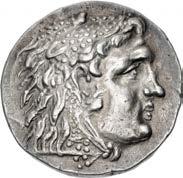

From the Pythagoras Collection. Ex New York Sale IV (17 January 2002), lot 133.
83. THRACE, Orthagoreia. Circa 340s-330s BC. AR Stater (24mm, 10.37 g, 12h). Bust of Artemis right, wearing triple-pendant earring and pearl necklace; quiver over shoulder / Chalkidian helmet facing; star above, orQÅ˝o-rEW@
Ex Shirley Hanberry Collection (Goldberg 96, 14 February 2017), lot 1572.
The conventional placement of Orthagoreia in Macedon is perplexing. Both of the only ancient literary sources, Strabo 7a.1.48 and Pliny, HN 4.42–3, place the city in Thrace, and all of the recorded find spots of its coinage are in Thrace (see Psoma, Maroneia, pp. 193–4). While the city was likely founded by Philip II, some of whose rare silver fractions mimic the obverse types of Orthagoreia’s silver, and the reverse type is of a Chalkidian helmet, these Macedonian connections provide insufficient evidence to place the city in Macedonia. The traditional attribution dates back to Eckhel (ii.76), who cited a late source that (erroneously) identified Orthagoreia with Stageira in Macedonia. B.V. Head and others reiterated this attribution, while P. Gardner (History of Ancient Coinage, p. 325) and H. Gaebler (AMNG III/2, p. 92) accurately challenged this evidence, and insisted the city was in Thrace. Interestingly, though, Gaebler still listed these coins in his volume of AMNG on Macedon, which likely perpetuated the incorrect notion of the city’s location. Among the standard references, apparently only the catalogers of SNG Copenhagen and SNG Fitzwilliam recognized the attribution to Thrace. With a large quantity of bronze issues of Orthagoreia appearing in the excavations at Maroneia, S. Psoma devoted a chapter of her work on the coin finds of Maroneia to review the totality of evidence on the city (Psoma, Maroneia, pp. 193–204). She convincingly argues that Orthagoreia was founded in the vicinity of Cape Serrhion by Philip II, in connection with his campaigns in Thrace in the 340s BC. Evidence suggests that the city was originally populated with Macedonian settlers and was later synoecized with Maroneia near the end of the 4th century BC. No evidence of the city exists from the Hellenistic period, so it appears that Orthagoreia did not flourish after the time of Alexander, and was eventually abandoned or destroyed.
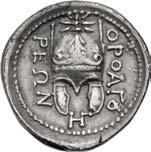
84.
ISLANDS off THRACE, Thasos. Circa 500-480 BC. AR Stater (20mm, 10.12 g). Ithyphallic satyr advancing right, carrying off protesting nymph / Quadripartite incuse square. Le Rider, Thasiennes 2; HPM pl. X, 3–5; HGC 6, 331; SNG Ashmolean 3643 = ACGC 519; Asyut 104; Boston MFA 851; Kraay & Hirmer 435. Deeply toned. In NGC encapsulation 6290604-014, graded AU★, Strike: 5/5, Surface: 4/5. ($5000)

Ex Mark & Lottie Salton Collection.
85 86
ISLANDS off THRACE, Thasos. Circa 480-463 BC. AR Stater (22mm, 8.99 g). Ithyphallic satyr advancing right, carrying off protesting nymph / Quadripartite incuse square. Le Rider, Thasiennes 5; HPM pl. X, 12; HGC 6, 331; SNG Ashmolean 3660–2; SNG Copenhagen 1010–2; ACGC 520. Edge split. Good VF. ($750)
85.
ISLANDS off THRACE, Thasos. Circa 412-404 BC. AR Stater (20.5mm, 8.83 g). Ithyphallic satyr advancing right, carrying off protesting nymph; Å to upper right / Quadripartite incuse square. Le Rider, Thasiennes 6; HPM p. 99, 21; HGC 6, 334; BMC 29–30; Hirsch 147–8. Toned, some die rust and a few marks on obverse. Good VF. ($2000)
86.
From the Pythagoras Collection, purchased from Herb Kreindler.
87. ISLANDS off THRACE, Thasos. Circa 412-404 BC. AR Stater (21mm, 9.12 g). Ithyphallic satyr advancing right, carrying off protesting nymph; s to upper right / Quadripartite incuse square. Le Rider, Thasiennes 6 var. (letter on obverse); HPM p. 99, 23; HGC 6, 334; McClean 4199 corr. (letter not noted in text). Lightly toned, a little die rust on obverse. Good VF. Well struck. Very rare with sigma on obverse. ($5000)
88.
ISLANDS off THRACE, Thasos. Circa 412-404 BC. AR Drachm (15mm, 3.56 g). Ithyphallic satyr advancing facing, head right, carrying off protesting nymph / Quadripartite incuse square. Le Rider, Thasiennes 8; HPM pl. X, 31; HGC 6, 336; SNG Ashmolean 3664 var. (satyr right); SNG Copenhagen 1019. Old cabinet tone, a few light scratches under tone on reverse. Good VF. Well centered. ($1500)




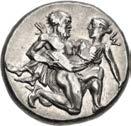
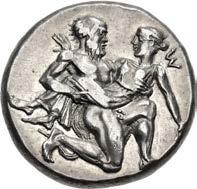
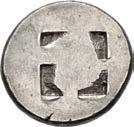
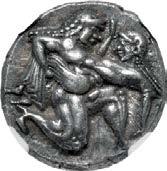



Ex Hermann Vogel Collection (A. Hess 194, 25 March 1929), lot 188.

89 90
89. ISLANDS off THRACE, Thasos. Circa 140-110 BC. AR Tetradrachm (33.5mm, 17.00 g, 12h). Head of young Dionysos right, hair in band and wreath of ivy with berries at the tip / Herakles standing left, right hand on club set on ground, lion skin draped over left arm; ˙rÅ˚¬Eo¨% to right, %Wt˙ro% to left, QÅ%5W@ in exergue; 8 to inner left. Prokopov, Silberprägung, Group IX, 312 var. (V Ig26/R – [unlisted rev. die]); Le Rider, Thasiennes 51; HGC 6, 358. Light golden tone, minor marks. Near EF. ($750)
Ex Tkalec (8 September 2008), lot 29.
90. ISLANDS off THRACE, Thasos. Circa 90-75 BC. AR Tetradrachm (31mm, 16.80 g, 12h). Imitative issue. Head of young Dionysos right, hair in band and wreath of ivy with berries at the tip / Herakles standing left, right hand on club set on ground, lion skin draped over left arm; ˙rÅ˚¬Eo¨% to right, %Wt˙ro% to left, QÅ%5W@ in exergue; Œ to inner left. Prokopov, Silberprägung, Group XIV, 991–4 var. (V CA1/R – [unlisted rev. die]); Le Rider, Thasiennes 52; HGC 6, 359; Lukanc 409 (same obv. die). Toned, traces of find patina, slight bend at edge, a few flan flaws, light scratch under tone on obverse. Good VF. ($500)
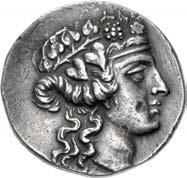
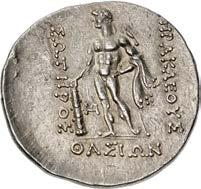


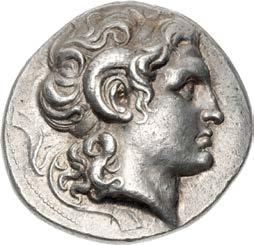

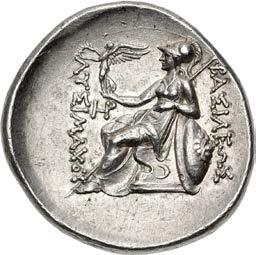
From the Pythagoras Collection. Ex Bourgey (2 April 2001), lot 144.
91. KINGS of THRACE,

Lysimachos. 305-281 BC.




Tetradrachm (28mm, 17.05 g, 12h). Lampsakos mint. Struck 297/6-282/1 BC. Diademed head of the deified Alexander right, with horn of Ammon / ∫Å%5¬EW% ¬Us5ÂÅcoU, Athena Nikephoros seated left, left arm resting on shield, transverse spear in background; A to inner left, crescent on throne. Thompson 45; Müller 402; HGC 3, 1750b; SNG BN –. Lightly toned over lustrous surfaces. EF. High relief and bold portrait, with engraver’s guide circle still visible on the reverse. ($3000)
92. KINGS of THRACE, Macedonian. Lysimachos. 305-281 BC. AV Stater (16.5mm, 8.47 g, 1h). Alexandreia Troas mint. Struck circa 297/6-282/1 BC. Diademed head of the deified Alexander right, with horn of Ammon / ∫Å%5¬EW% ¬Us5ÂÅcoU, Athena Nikephoros seated left, left arm resting on shield, transverse spear in background; in inner left field, 1 above bee; R in exergue. Thompson 147; Meadows, Earliest 44 var. (unlisted dies); Müller 429; HGC 3, 1743e. A few hairlines and tiny marks. Good VF. Extremely rare, only six examples noted by Meadows, no additional examples in CoinArchives. ($7500)
From the D.K. Collection.
93. KINGS of THRACE, Macedonian. Lysimachos. 305-281 BC. AR Tetradrachm (28mm, 16.87 g, 3h). Alexandreia Troas mint. Struck circa 297/6-282/1 BC. Diademed head of the deified Alexander right, with horn of Ammon / ∫Å%5¬EW% ¬Us5ÂÅcoU, Athena Nikephoros seated left, left arm resting on shield, transverse spear in background; to inner left, head of ram left; star on throne. Meadows, Earliest 5, obv. die O5; Thompson 151; Müller –; HGC 3, 1750h. Light iridescent tone, a hint of porosity and a few faint hairlines. EF. Struck from artistic dies. ($3000)

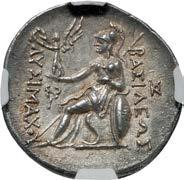

Ex Peus 388 (1 November 2006), lot 156.
94. KINGS of THRACE, Macedonian. Lysimachos. 305-281 BC. AR Tetradrachm (28mm, 17.21 g, 2h). Amphipolis mint. Struck circa 288/7-282/1 BC. Diademed head of the deified Alexander right, with horn of Ammon / ∫Å%5¬EW% ¬Us5ÂÅcoU, Athena Nikephoros seated left, left arm resting on shield, transverse spear in background; kerykeion to inner left, ! to outer right. Thompson 191; Müller 106 var. (handle on kerykeion); HGC 3, 1750l. Deep iridescent tone. In NGC encapsulation 4371988-003, graded Ch AU, Strike: 5/5, Surface: 5/5. ($1500)



From the D.K. Collection.
95. KINGS of THRACE, Macedonian. Lysimachos. 305-281 BC. AR Tetradrachm (30mm, 17.45 g, 1h). Pergamon mint. Struck 287/6-circa 282 BC. Diademed head of the deified Alexander right, with horn of Ammon; ˚ below / ∫Å%5¬EW% ¬Us5ÂÅcoU, Athena Nikephoros seated left, left arm resting on shield, transverse spear in background; crescent to outer left, cult image to inner left, 2 in exergue. Thompson 224; Arnold-Biucchi, Pergamene 55–6 (obv. die 10); Müller –; HGC 3, 1750m. In NGC encapsulation 4629121-023, graded MS★, Strike: 5/5, Surface: 4/5, Fine Style. ($5000)
Ex Classical Numismatic Review XLIV.2 (Summer 2019), no. 506203; Heritage 3071 (6 January 2019), lot 34029.
Lysimachos tetradrachms struck in Pergamon during that ruler’s hegemony of western Asia Minor are rightly regarded among the first truly great Hellenistic portrait types. The engraver responsible for this remarkable head of the deified Alexander the Great, with its deep-set, upward-gazing eye and soulful expression, was clearly an artist of singular talent. The mint’s reputation for extraordinary die work carried over into the subsequent era of Philetairos and the Attalid rulers, whose coin portraiture achieved similar heights.


96. KINGS of THRACE, Macedonian. Lysimachos. 305-281 BC. AV Stater (18mm, 8.53 g, 7h). Pella mint. Struck circa 286-282 BC. Diademed head of the deified Alexander right, with horn of Ammon / ∫Å%5¬EW% 2U%5;ÅcoU, Athena Nikephoros seated left, left arm resting on shield, transverse spear in background; q to inner left, 4 on throne, ˚ in exergue. Thompson 241; Müller –; SNG Lockett 1247 var. (letter on throne); Jameson 2464 var. (same); Naville IV, lot 521 (same dies); Triton XVIII, lot 426 (same dies). Light marks. Near EF. ($7500)


Ex Regierungsrat Dr. iur. Hans Krähenbühl Collection (Leu Numismatik AG 8, 23 October 2021), lot 41, purchased from Bank Leu, 15 May 1973; Hess-Leu 45 (12 May 1970), lot 110; Hess-Leu 28 (5 May 1965), lot 132; Collection of a Foreign Amateur (Glendining, 13 December 1963), lot 242; Ars Classica XIII (27 June 1928), lot 1261.
97. KINGS of THRACE, Macedonian. Lysimachos. 305-281 BC. AR Tetradrachm (29mm, 17.09 g, 6h). Pella mint. Struck 286/5-282/1 BC. Diademed head of the deified Alexander right, with horn of Ammon / ∫Å%5¬EW% ¬Us5ÂÅcoU, Athena Nikephoros seated left, left arm resting on shield, transverse spear in background; to inner left, Ł in circle above arm, a below. Thompson 244 var. (monogram above arm); Müller –; Auctiones SA 7, lot 107 var. (monogram; same obv. die [example of Thompson 244]); CNG E-366, lot 407 (same dies); A. Hess (18 March 1918), lot 284 = J. Hamburger (17 June 1908), lot 414 (same dies). Lightly toned. Near EF. Fine style. Rare. ($1500)



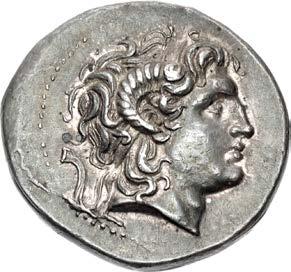

From the Pythagoras Collection, purchased from Jonathan K. Kern.
98. KINGS of THRACE, Macedonian. Lysimachos. 305-281 BC. AR Tetradrachm (32.5mm, 17.13 g, 7h). Uncertain mint. Posthumous issue, mid-late 3rd century BC. Diademed head of the deified Alexander right, with horn of Ammon / ∫Å%5¬EW% 2U%5;ÅcoU, Athena Nikephoros seated left, left arm resting on shield, spear in background; o¬ to inner left, EU in exergue. Thompson –; Müller –; cf. HGC 3, 1750 (for type); Myers XI, lot 68 (same dies); Pecunem/Gitbud & Naumann 19, lot 77 (same obv. die). Iridescent tone, minor marks, die break on obverse. Near EF. Very rare. ($1500) Purchased by the consignor from Brian Kritt, 7 January 2010 (his ticket included).


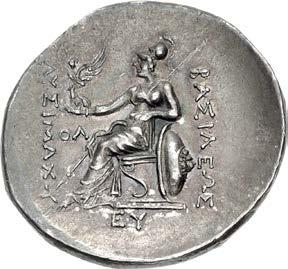
Draganov 874–5 var. (O5/R– [unisted rev. die]); Black Sea Hoard 8 (OA/R2 – this coin); Price 883; Peykov F2010; HGC 3, 1355. Even light gray tone, some faint hairlines, area of minor roughness on each side, small mark at edge on reverse. EF. ($1500)
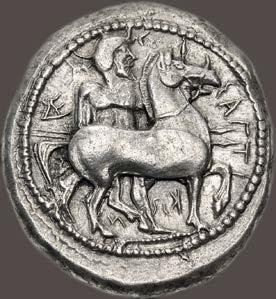


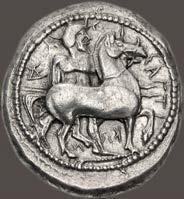

Ex “Black Sea” Hoard, 8.
100. THRACO-MACEDONIAN
(30.5mm, 28.88 g).
petasos and holding two spears; z to left, 1-5-sÅ˝t5-˚W-˜ clockwise around from the top / Quadripartite incuse square. Andersen p. 195 (this coin); Peykov A3070 (same obv. die as second illustration = Giessener Münzhandlung 102, lot 148); Topalov 33 var. (legend, no monogram); HPM –; AMNG III/2, –; HGC 3, 274 var. (same); Leu 72, lot 157. Toned, usual slight doubling. EF. Well-struck and good metal. A superb example, among the finest known. ($30,000)

From the Apollo to Apollo Collection.
The Bisaltai were a tribe of Pelasgian or Thracian origin and occupied the territory between the rivers Echedoros and Strymon, including the metalliferous mountains, which separate the territory of the Bisaltai from the territory of the Krestonioi and Mygonia on the west (Herodotos 7, 115). At the time of the invasion of Xerxes in 480 BC, the Bisaltai were governed by a Thracian ruler who was independent of Macedonian influence, and refused to assist the Great King of Persia when his army crossed Thrace to invade mainland Greece. At some point after the Persian retreat, Alexander I of Macedon, who was in the service of Persians as early as 492 BC, annexed the territory as far as the Strymon valley. Capturing its rich silver mines, he issued the first regal Macedonian coinage, which is indistinguishable from the Bisaltian but for the placing of his own name. The absence of Bisaltai oktadrachms in the Asyut hoard led Price and Waggoner to suggest a mintage date of circa 475-465 BC. This coinage was terminated about the same time as the disaster at Drabeskos in 465/4 BC, in which the Athenian colonists of Ennea Hodoi (later Amphipolis) were exterminated by the native Thracians, though it is unknown whether this coinage is directly related to the Bisaltai’s involvement in this conflict.
101. THRACO-MACEDONIAN REGION, Uncertain. Circa 520-500 BC. AR Tetrobol (11.5mm, 2.37 g). Grape bunch / Quadripartite incuse square. Artemis-Gyselen Class 2, v; SNG Copenhagen 766–7; Boston MFA 1295 = Warren 970; Jameson 1310; Pozzi 2057–60; Weber 4729 (all cataloged as Tenos). Attractive cabinet tone. Near EF. Excellent for issue. Rare. ($2000)



Purchased by the consignor from Brian Kritt, 6 January 2011 (his inventory ticket included).
This tetrobol is part of a series that was traditionally placed at Cycladic Tenos, based on a stylistic argument by F. Imhoof-Blumer, who compared the grape bunch on these to later Hellenistic issues bearing that city’s ethnic. Sheedy, however, convincingly showed that these coins cannot belong at Tenos. He argued that the style of the grapes was common at a number of mints, even outside the Cyclades, but, moreover, the metrology of these coins did not fit any weight standard used in the islands (cf. Sheedy, pp. 72–4 and HGC 6, p. 178).

102. MACEDON, Akanthos. Circa 525-470 BC. AR Tetradrachm (27mm, 16.95 g). Lion right, attacking bull crouching left, biting into its hindquarter; Q above; floral ornament in exergue / Quadripartite incuse square. Andersen pp. 67 and 69 (this coin); Desneux 48–68 (unlisted dies); AMNG III/2, 5; HGC 3, 383; SNG ANS 10; Traité I 1676. Attractively toned, light scratches. EF. High relief for issue. ($20,000)

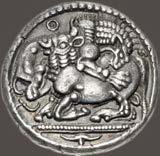


From the Apollo to Apollo Collection. Ex Leu 81 (16 May 2001), lot 155; Leu 45 (26 May 1988), lot 102.
103. MACEDON, Akanthos. Circa 470-430 BC. AR Tetradrachm (29mm, 17.06 g, 2h). Attic standard. Lion right, attacking bull crouching left, biting into its hindquarter; in exergue, fish left / Å˚Å-n-Q5o-n in shallow incuse around quadripartite square in relief. Desneux 95-102 var. (unlisted dies); AMNG III/2, 21; HGC 3, 385; Weber 1863. Slight die shift on obverse, some light scratches and scrapes on reverse. Near EF. ($5000)
Ex Classical Numismatic Group 75 (23 May 2007), lot 121.
104. MACEDON, Akanthos. Circa 430-390 BC. AR Tetradrachm (24mm, 14.06 g, 9h). Thraco-Macedonian standard. Lion right, attacking bull kneeling to left; traces of letters (magistrate) in exergue / Å˚Å-n-Q5o-n in shallow incuse square around quadripartite square with stippled quarters in relief. Cf. Desneux 139–62; cf. AMNG III 29; HGC 3, 391; cf. SNG ANS 14–5; cf. Boston MFA 531–2; cf. Gulbenkian 396–7. Iridescent tone, granular surfaces, numerous light cleaning scratches. Good VF. ($2000)
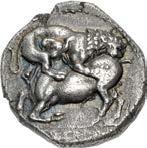
105. MACEDON, Chalkidian League. Circa 385 BC. AR Tetradrachm (23mm, 14.37 g, 9h). Olynthos mint. Head of Apollo left, wearing laurel wreath / Kithara; c-Å-¬-˚5d-EW@ around; all within incuse square. Robinson & Clement Group G, – (unlisted dies); AMNG III/2, 4; HGC 3, 497. Slight iridescent tone, underlying luster, trace deposits on obverse. EF. ($7500)
106. MACEDON, Chalkidian League. Circa 359 BC. AR Tetradrachm (14.42 g). Olynthos mint. Head of Apollo left, with short hair, wearing laurel wreath / Kithara; tripod above, c-Å-¬˚5d-EW@ around; all within incuse square. Robinson & Clement Group M, – (A–/P70); AMNG III/2, –; HGC 3, 498 corr. (some with symbols); SNG ANS 486 var. (head left; same rev. die); Boston MFA 580 var. (same; same rev. die). Lightly toned, spot of die rust on obverse, slight die shift on reverse. EF. Serene head of Apollo. Very rare Group M tetradrachm with short-haired Apollo facing right, only two examples known to Robinson & Clement. ($10,000)

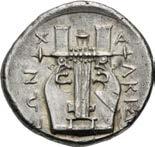
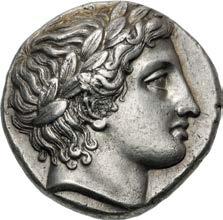
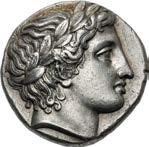

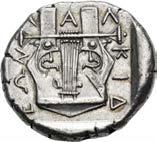
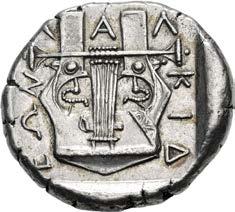
Ex G. Hirsch 275 (22 September 2011), lot 3447; Leu 59 (17 May 1994), lot 90.

107. MACEDON, Mende. Circa 460-423 BC. AR Tetradrachm (26mm, 17.13 g, 12h). Inebriated Dionysos, wearing chiton draped from his waist, holding in right hand a kantharos propped on his right knee, reclining left, head right, on the back of an ass standing right; before, bird perched right upon branch / µE@-dÅ-5-o@ within shallow incuse around quadripartite square in linear border ornamented with dots; all within incuse square. Noe, Mende 36 (this coin referenced); HGC 3, 545; SNG ANS 345 (same dies); Jameson 1964 (this coin). Attractive old cabinet tone, trace deposits, a few marks. Near EF. ($20,000)
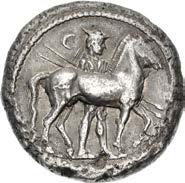

Ex Mark and Lonnie Salton Collection; Robert Jameson Collection (publ. 1924); 1913 Kaliandra Hoard (IGCH 358).
The Dionysiac types of Mende proclaim it as a famous wine producing city, as attested by its amphoras that have been found throughout the Mediterranean. On this delightful coin Dionysos, who rules wine and winemaking, is shown being carried home drunk from a symposium, a representation of careless joy which links the world of men with the Olympians – at least until the morning.



108. KINGS of MACEDON. Alexander I. 498-454 BC. AR Tristater – “Oktadrachm” (30.5mm, 28.84 g, 10h). Light Aeginetic standard. Aigai mint. Struck circa 476/5-460 BC. Horseman, petasos hanging from neck, holding two spears over his shoulder in right hand, standing right, behind horse standing right, with horizontal kerykeion on its hind quarter; crescent to upper left / ŬE-$Å-@d-ro in shallow incuse square around quadripartite square in relief. Raymond Group II, 55–6 var. (unlisted dies); AMNG III/2, 31 var. (no crescent); HGC 3, 755; SNG Alpha Bank –; SNG ANS 23 = Asyut 152 (same obv. die); SNG München –; Prospero 292; Traité I 1501. Lightly toned, minor scratches, some roughness at periphery and a couple spots of die rust on obverse. VF. Very rare, particularly as a whole coin without test cuts. ($10,000)
By the end of the sixth century BC, the Kingdom of Macedon became an influential regional power, strategically located between the Persian Empire and the city-states of Greece. The wars with Persia further extended Macedon’s importance, especially that of its young prince, Alexander I, the son of Amyntas. An astute politician, Alexander deftly maneuvered through this precarious situation. Although he early on offered his sister’s hand in marriage to a Persian to offset punishment for his revenge against the high handedness of a Persian embassy in 514-513 BC, Alexander maintained an aloof but cordial relationship with the Persians as they moved through the region in 492 BC, forcing the other tribes to Medize. At the same time, he worked towards a stronger association with the Greeks. Herodotos (9.44) says that on the eve of the battle at Plataia, Alexander entered the Athenian camp to report that a delay in engaging the Persians would help to further diminish their already low supplies. In return, he hoped the Greeks (in particular the Athenians) would assist him when the time came, thereby forging a relationship between the rising power in the north and the rising Greek city-states of Athens, Sparta and their allies.


109. KINGS of MACEDON. temp. Philip II – Alexander III. Circa 340/36-328 BC. AV Stater (17mm, 8.58 g, 11h). In the name and types of Philip II. Amphipolis mint. Head of Apollo right, wearing laurel wreath / f5¬5ππoU, charioteer, holding kentron in right hand, reins in left, driving fast biga right; club below. Le Rider Group II, 41 var. (D–/R33 [unlisted obv. die]); SNG ANS 246–7. Underlying luster, slightly off center on reverse. Near EF. ($2000)
From the Dr. Michael Slavin Collection. Ex Antiqua (Steve Rubinger) inventory 581 (ND; his ticket included).
110. KINGS of MACEDON. Alexander III ‘the Great’. 336-323 BC. AV Stater (18mm, 8.55 g, 3h). Tyre mint. Dated RY 23 of ‘Ozmilk (327/6 BC). Head of Athena right, wearing crested Corinthian helmet decorated with griffin, and pearl necklace / ŬExÅ@d[roU], Nike standing left, holding wreath in extended right hand and cradling stylis in left arm; [a (Phoenician A) below right wing];below left wing, )o (Phoenician ‘K [= ‘Ozmilk]) above ‹‹‹( (Phoenician date [23]). Price 3257 (Ake; same dies as illustration); Newell, Dated 27, obv. die K corr. (date); ANS inv. 1956.183.11 corr. (date; same dies). Underlying luster, double struck, tiny bump on edge. VF. ($2000)
From the Kenneth S. Abramowitz Collection.
Newell, Dated 27 is listed as Price 3270, but that is an erroneous entry based off of Newell’s assumption that the date on the coins he inspected was year 27 (he noted that the date on all of the coins was off the flan). Since Newell’s die study, however, several staters using his obverse die K have appeared, including the BM coin that Price illustrates for his no. 3257, clearly showing the date to be year 23. As such, Newell, Dated 27 actually corresponds to Price 3257, which previously had no reference to Newell’s die study
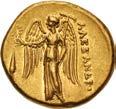

111. KINGS of MACEDON. temp. Alexander III – Philip III. Circa 325-319 BC. AV Stater (18mm, 8.61 g, 4h). In the name and types of Alexander III. Amphipolis mint. Struck under Antipater. Head of Athena right, wearing crested Corinthian helmet decorated with serpent, and necklace / ŬE$Å@droU, Nike standing left, holding wreath in extended right hand and cradling stylis in left arm; trident head downward in left field. Price 172; Troxell, Studies, p. 125, pl. 25, H. Underlying luster, a few tiny deposits, some scuffs and light scratches. EF. ($4000)
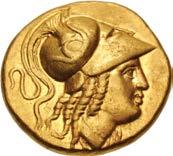






From the David J. Fleischmann Collection, purchased from Harlan J. Berk.
112. KINGS of MACEDON. temp. Alexander III – Philip III. Circa 330/25-320 BC. AV Stater (18mm, 8.60 g, 12h). In the name of Alexander III. Uncertain mint in western Asia Minor. Head of Athena right, wearing crested Corinthian helmet decorated with serpent, and necklace / ŬE$Å@dro[U], Nike standing left, holding wreath in extended right hand and cradling stylis in left arm; in left field, spearhead upward. Price 3137 (Salamis); Troxell, New, Group I, 4 (dies 4/c); Newell, Some, p. 14, 5, pl. XIII, 5 (same dies); SNG Ashmolean 2923 (same rev. die). Underlying luster, slightly off center and minor die shift on reverse. Good VF. ($3000)
113. KINGS of MACEDON. temp. Alexander III – Seleukos I. Circa 324/3-300 BC. AR Tetradrachm (31.5mm, 16.91 g, 6h). Uncertain mint, in southern Asia Minor, Syria, or the East. Head of Herakles right, wearing lion skin / ∫Ås5¬EWs ŬE$Å@droU, Zeus Aëtophoros seated left; in left field, wreath with ties above. Unpublished. Deeply toned, with some iridescence around the devices, double struck and a little die wear on reverse. Good VF. Extremely rare. ($500)
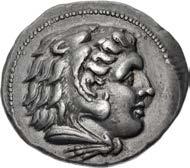
From the Pythagoras Collection.

114. KINGS of MACEDON. Philip III Arrhidaios. 323-317 BC. AR Tetradrachm (26mm, 17.26 g). In the name and types of Alexander III. Amphipolis mint. Struck under Antipater, circa 322-320 BC. Head of Herakles right, wearing lion skin / ∫Ås-5¬EWs ŬE$Å@droU, Zeus Aëtophoros seated left; Macedonian helmet in left field. Price 113; Troxell, Studies, Issue H3. EF. Well centered and struck. ($1000)
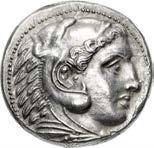

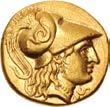

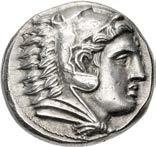
From the GTP Collection.
115. KINGS of MACEDON. Philip III Arrhidaios. 323-317 BC. AV Stater (18mm, 8.53 g, 12h). In the name and types of Philip II. Pella mint. Struck under Antipater or Polyperchon, circa 323-318/7 BC. Head of Apollo right, wearing laurel wreath / f5¬5ππoU, charioteer, holding kentron in right hand, reins in left, driving fast biga right; kantharos below. Le Rider Group IIIA, 474 (D196/R347); SNG ANS 172–6; SNG Copenhagen 529 (same obv. die). Underlying luster, a few light marks, minor edge bruise. Near EF. ($4000)

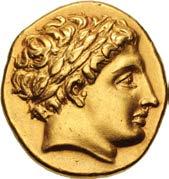
From the GTP Collection. Ex Gorny & Mosch 219 (10 March 2014), lot 110; Numismatica Ars Classica N (26 June 2003), lot 1220.

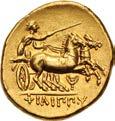
116. KINGS of MACEDON. Philip III Arrhidaios. 323-317 BC. AR Tetradrachm (25.5mm, 17.15 g, 8h). In the name and types of Alexander III. Pella mint. Struck under Antipater or Polyperchon, circa 323-318/7 BC. Head of Herakles right, wearing lion skin / ŬE$Å@droU, Zeus Aëtophoros seated left; in left field, bee right on rose. Price 206; Moore 23-43. Slight die wear, area of light roughness at edge on reverse. EF. ($1000)
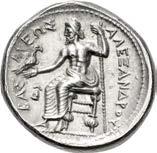
From the GTP Collection.
117. KINGS of MACEDON. Philip III Arrhidaios. 323-317 BC. AV Stater (17mm, 8.56 g, 2h). In the types of Alexander III. Lampsakos mint. Struck under Leonnatos, Arrhidaios, or Antigonos I Monophthalmos. Head of Athena right, wearing crested Corinthian helmet decorated with serpent, and necklace / f5¬5ππoU, Nike standing left, holding wreath in extended right hand and cradling stylis in left arm; buckle in left field, crescent above Å below left wing. Price P14; ADM II Series IX, 173 var. (same obv. die, different positions of controls). Underlying luster, minor die wear on obverse. EF. Well centered. ($3000)
From the North River Collection. Ex Classical Numismatic Group 90 (23 May 2012), lot 457.
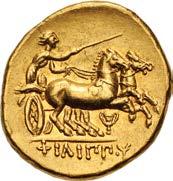
118. KINGS of MACEDON. Philip III Arrhidaios. 323-317 BC. AV Stater (19mm, 8.56 g, 11h). In the types of Philip II. Kolophon mint. Struck under Menander or Kleitos, circa 322-319 BC. Head of Apollo right, wearing laurel wreath / f5¬5ππoU, charioteer, holding kentron in right hand, reins in left, driving fast biga right; in exergue, head of lion left and spearhead right. Thompson, Philip 8 (same dies as illustration); Le Rider –; SNG ANS –; SNG Alpha Bank –; SNG Ashmolean –; SNG München –. Lustrous. In NGC encapsulation 6557515-001, graded Ch AU★, Strike: 5/5, Surface: 4/5, Fine Style. Extremely rare. ($5000)

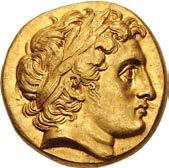


From the GTP Collection. Ex Antiqua XVII (2013), no. 15.
119. KINGS of MACEDON. Philip III Arrhidaios. 323-317 BC. AV Stater (18mm, 8.62 g, 11h). In the types of Philip II. Kolophon mint. Struck under Menander or Kleitos, circa 322-319 BC. Head of Apollo right, with the features of Alexander III, wearing laurel wreath / f5¬5ππoU, charioteer, holding kentron in right hand, reins in left, driving fast biga right; tripod below. Thompson, Philip 12 = Jameson 978 = Kunstfreund 232 = Gillet 785 (same obv. die); Le Rider pl. 90, 16 and pl. 93, 26; SNG ANS 309; SNG Alpha Bank 260 = Alpha Bank, Hellenic 72 = Alpha Bank, Macedonia 26 = Alpha Bank, Alexander 57 (same dies); SNG Ashmolean 2456; Kraay & Hirmer 565. In NGC encapsulation 65574213-0011, graded MS, Strike: 5/5, Surface: 4/5, Fine Style. ($10,000)
From the Pythagoras Collection.
120. KINGS of MACEDON. Philip III Arrhidaios. 323-317 BC. AV Stater (17.5mm, 8.66 g, 12h). In the types of Philip II. Kolophon mint. Struck under Menander or Kleitos, circa 322-319 BC. Head of Apollo right, with the features of Alexander III, wearing laurel wreath / f5¬5ππoU, charioteer, holding kentron in right hand, reins in left, driving fast biga right; tripod below. Thompson, Philip 12 = Jameson 978 = Kunstfreund 232 = Gillet 785 (same obv. die); Le Rider pl. 90, 16 and pl. 93, 26; SNG ANS 309; SNG Alpha Bank 260 = Alpha Bank, Hellenic 72 = Alpha Bank, Macedonia 26 = Alpha Bank, Alexander 57 (same dies); SNG Ashmolean 2456; Kraay & Hirmer 565. Lustrous. In NGC encapsulation 6557515-002, graded MS, Strike: 4/5, Surface: 4/5, Fine Style. ($7500)
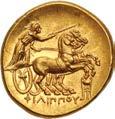

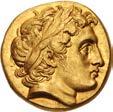

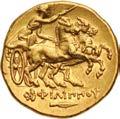

From the GTP Collection. Ex Antiqua XVII (2013), no. 21.
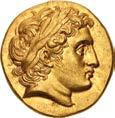
121. KINGS of MACEDON. Philip III Arrhidaios. 323-317 BC. AV Stater (17.5mm, 8.59 g, 5h). In the name and types of Alexander III. Tarsos mint. Struck under Philotas or Philoxenos. Head of Athena right, wearing crested Corinthian helmet decorated with serpent, and necklace; [Q to left] / ∫Å-s5¬EWs ŬExÅ@dro[U], Nike standing left, holding wreath in extended right hand and cradling stylis in left arm; kerykeion in left field; below left wing, 2 above Q. Price 3045 (same obv. die as illustration); Newell, Tarsos 52, obv. die O; ANS inv. 1949.134.1 (same obv. die). Underlying luster, slightly off center, tiny mark and trace deposits on reverse. Superb EF. ($5000)
122. KINGS of MACEDON. temp. Philip III – Lysimachos. Circa 323-280 BC. AV Stater (17mm, 8.53 g, 12h). Uncertain mint in western Asia Minor. Head of Athena right, wearing crested Corinthian helmet decorated with serpent, and necklace / ŬE$Å@dr[oU], Nike standing left, holding wreath in extended right hand and cradling stylis in left arm; in left field, griffin seated left;  below left wing. Price 2703 corr. var. (control letter; position of letter; same obv. die as illustration); Leu Numismatik Web Auction 15, lot 157 (same dies); Ponterio 152, lot 5841 (same dies); Roma V, lot 257 (same dies); UBS 63, lot 99 (same rev. die). In NGC encapsulation 6158068-001, graded AU, Strike: 5/5, Surface: 3/5. Very rare, one of five in CoinArchives, none in ANS Photofile. ($3000)




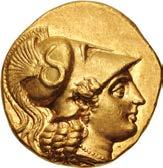
Ex Numismatik Naumann 53 (7 May 2017), lot 56.
123. KINGS of MACEDON. Antigonos I Monophthalmos. As Strategos of Asia, 320-306/5 BC. AV Stater (18.5mm, 8.45 g, 6h). In the name and types of Alexander III. Sardes mint. Struck circa 318-315 BC. Head of Athena right, wearing crested Corinthian helmet decorated with serpent, single-pendant earring, and necklace / [Å]¬E$Å@droU, Nike standing left, holding wreath in extended right hand and cradling stylis in left arm; star below left wing, Å below right wing. Price 2643; ADM I, Series XVI, 360–1. Underlying luster, light marks. EF. Very rare, none in Pella, only the two in ADM are published; only one in CoinArchives (CNG E-285, lot 59). ($4000)
From the S & S Collection, purchased from Joel L Malter & Co., Inc. (their inventory ticket included).
124. KINGS of MACEDON. Kassander. As regent, 317-305 BC. AR Tetradrachm (14.66 g, 10h). In the name and types of Philip II. Amphipolis mint. Struck circa 316-311 BC. Head of Zeus right, wearing laurel wreath / f5¬5π-πoU, youth, holding palm frond in left hand and rein in right, on horseback right; aphlaston below, À below raised foreleg. Troxell, Studies, Group 9, 323-5; Le Rider pl. 46, 17–8; HGC 3, 988; SNG ANS 738-46. Superb EF. Well struck from fresh dies. ($2000)



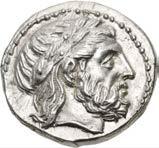
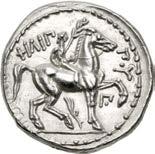

From the North River Collection. Ex Triton XI (8 January 2008), lot 112.

125. KINGS of MACEDON. Kassander. As regent, 317-305 BC. AR Tetradrachm (24mm, 14.40 g, 7h). In the name and types of Philip II. Amphipolis mint. Struck circa 316-311 BC. Head of Zeus right, wearing laurel wreath / f5¬5π-πoU, youth, holding palm frond in left hand and rein in right, on horseback right; dolphin below, À below raised foreleg. Troxell, Studies, Group 9, 331–2; Le Rider pl. 46, 9 & 19; HGC 3, 988; SNG ANS 749–56. Lustrous, two minor die breaks in field on obverse, minor flan flaw on reverse. EF. Perfectly centered and struck. ($2000)



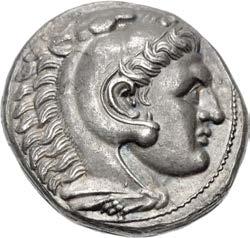
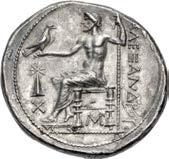

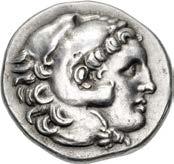

From the S & S Collection. Lot includes a Joel L. Malter ticket marked lot 53.
126. KINGS of MACEDON. Kassander. As regent, 317-305 BC, or King, 305-298 BC. AR Tetradrachm (26.5mm, 16.91 g, 10h). In the name and types of Alexander III. Ouranopolis(?) mint. Struck under Alexarchos, circa 310-297 BC. Head of Herakles right, wearing lion skin / ŬE$Å@droU, Zeus Aëtophoros seated left; in left field, star on cone above c;  below throne. Price 513; Ehrhardt 63. Deep iridescent tone, some deposits. EF ($2000)

Ex Walter Weise Collection, purchased from Rudiger Kaiser, 1986.
127. KINGS of MACEDON. Demetrios I Poliorketes. 306-283 BC. AR Tetradrachm (29mm, 16.88 g, 12h). In the name of Alexander III. Uncertain mint in western Asia Minor. Struck circa 305-295 BC. Head of Herakles right, wearing lion skin / ŬE$Å@droU, Zeus Aëtophoros seated left; in left field, head of ram left. Newell 63 var. (unlisted dies); Price 835; CNG E-349, lot 34 (same obv. die). Lightly toned, light scratches. Near EF. ($750)
From the GTP Collection. Ex Solidus 37 (16 December 2018), lot 27.
128. KINGS of MACEDON. Demetrios I Poliorketes. 306-283 BC. AR Tetradrachm (28mm, 17.26 g, 1h). Pella mint. Struck circa 294-293 BC. Nike standing left on prow of galley left, blowing trumpet she holds in her right hand and cradling stylis in her left arm / ∫Å-s5¬EW-s d˙µ˙tr5oU, Poseidon Pelagaios, nude, standing left, seen from behind, preparing to throw trident held aloft in his right hand, chlamys draped over extended left arm; g to left; to right, dolphin left above star. Newell 68, obv. die LVII; HGC 3, 1012e; SNG München 1042 var. (no dolphin; same obv. die); Dewing 1196 (same obv. die). Attractive light tone over lustrous surfaces, minor die wear on obverse. Superb EF. ($3000)
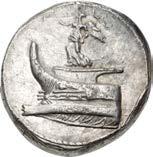




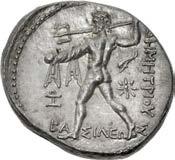

From the North River Collection; Triton IV (5 December 2000), lot 177.
129. KINGS of MACEDON. Demetrios I Poliorketes. 306-283 BC. AR Tetradrachm (24mm, 17.26 g, 8h). Amphipolis mint. Struck circa 294-293 BC. Nike standing left on prow of galley left, blowing trumpet she holds in her right hand and cradling stylis in her left arm / ∫Å-s5¬E-Ws d˙µ˙tr5oU, Poseidon Pelagaios, nude, standing left, seen from behind, preparing to throw trident held aloft in his right hand, chlamys draped over extended left arm; tripod to left; to right, z above m. Newell 94 (dies LXXXV/– [obv. die unlisted for issue, rev. die not known]); HGC 3, 1012f; Triton XIX, lot 102 (same dies); Triton XVII, lot 164 (same dies); CNG 106, lot 220 (same dies). Fully lustrous, area of light toning, minor die break on obverse (diagnostic for this die). Choice EF. Perfectly centered. ($3000)
130. KINGS of MACEDON. Antigonos II Gonatas. 277/6-239 BC. AR Tetradrachm (30mm, 17.00 g, 12h). Amphipolis mint. Struck circa 271/68-260/55 BC. Horned head of Pan left, lagobolon over shoulder, in the center of a Macedonian shield / ∫Ås5¬EWs Å@t5˝o@oU, Athena Alkidemos advancing left, shield decorated with aegis on left arm, preparing to cast thunderbolt held aloft in right hand; crested Macedonian helmet to inner left, ˆ to inner right. TEA Period I, Group 1, 4 (O4/ R3); HGC 3, 1042; Hunterian 1 (same dies). Lightly toned, minor die breaks on obverse. Near EF. ($3000)

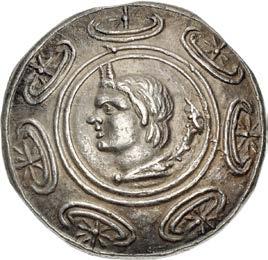
131. KINGS of MACEDON. Antigonos II Gonatas. 277/6-239 BC. AR Tetradrachm (31mm, 17.06 g, 11h). Amphipolis mint. Struck circa 271/68-260/55 BC. Horned head of Pan left, lagobolon over shoulder, in the center of a Macedonian shield / ∫Ås5¬EWs Å@t5˝o@oU, Athena Alkidemos advancing left, shield decorated with aegis on left arm, preparing to cast thunderbolt held aloft in right hand; crested Macedonian helmet to inner left, Ò to inner right. TEA Period I, Group 35, 146b (O4/R3 – this coin); HGC 3, 1042. Toned. Good VF. Well centered. ($3000)


From the GTP Collection. Ex CNG inventory 926177 (May 2012); Mayflower (Sukenik) Collection (Heritage 3019, 25 April 2012), lot 23085, purchased from Numismatic Fine Arts, 1987.
Antiogonos Gonatas was the son of Demetrios Poliorketes and grandson of Antigonos Monophthalmos. During the later years of the Diadoch Wars, he participated with his father on campaign in Greece and Macedon. In 288 BC, Demetrios was forced from Macedon by a joint attack by Lysimachos and Pyrrhos. He then took his army east to attack Lysimachos’ cities in Asia Minor in 288 BC, leaving Antigonos behind to continue campaigning in Greece. Thus, Antigonos was absent from the field when Demetrios was defeated and captured by Seleukos I later that year. Although he resolved to free his father from captivity, Antigonos was never able to leave his territories in Greece before Demetrios died in 283 BC. Upon his father’s death, Antigonos assumed the royal title and resolved to retake the Macedonian throne. Before he was able to invade Macedonia, in 279 BC, a huge wave of Galatians moved into the region from the north, killing Ptolemy Keraunos, the then king of Macedon, and advanced as far south as Delphi, ravaging the countryside and defeating any resistance that was raised against them. In 277 BC, Antigonos took his army north and decisively defeated the Celts in a victory that brought him recognition and acclaim across the Aegaean. Angtigonos was now able to take the empty Macedonian throne. In 274 BC, Pyrrhos invaded and occupied Thessaly and western Macedon, but his death in 272 BC ended this threat to Antigonos’ rule. He was able to spend the subsequent few years securing his position before the outbreak of the Chrmonidean War in 267 BC. Up to that time, the Greek cities of Chalkis, Corinth, Demetrias, and Piraios had been longstanding naval bases for the Antigonids, set up duirng the Diadoch Wars by his father, Demetrios. This cities were staunch allies to Antigonos, and were advocates for his foreign policy. Athens and Sparta viewed them as a threat, and joined with other cities and Ptolemy II in an attempt to remove the Macedonian garrisons. The conflict was indecisive until 263 BC, when Antigonos was able to capture Athens, though the war dragged on for another two years. The end of this conflict in 261 marked the end of significant external threats to Antigonos’ rule in Macedon. A long time ally of the Seleukids, Antigonos supported Antiochos II in the Second Syrian War against Ptolemy II, and defeated the Egyptian king’s navy near Kos in 255 BC. At home, Antigonos did much to restore the kingdom finanacially, culturally, and militarily, resulting in a sort of renaissance that flourished in the newfound stability that Macedon had not enjoyed since the time of Kassander some 40 years earlier. Antigonos died of old age in 239 BC, passing the throne to his son, Demetrios II.
132. KINGS of MACEDON. Philip V. 221-179 BC. AR Pentobol (18.5mm, 3.17 g). Amphipolis mint(?). Series 2, circa 215-205 BC. Macedonian shield with boss emblazoned with a spiral device / ∫Ås5¬EWs f5¬5ππoU, club. Unpublished, but cf. Burrer, Tetradrachmenprägung G1–G2, and cf. HGC 3, 1053, for this same reverse used on Philip’s rare Series 2 gold issues. Lightly toned, cleaning marks, double struck on obverse. VF. Apparently unique. ($500)


From the Pythagoras Collection, purchased from Herb Kreindler.

133. KINGS of MACEDON. Perseus. 179-168 BC. AR Tetradrachm (32.5mm, 16.51 g, 7h). Attic standard. Amphipolis mint; obverse die signed by Zoilos. Struck circa 174-170 BC. Diademed head right; zW5¬oU below neck / ∫Å%5-¬EW% ∏Er-%EW%, eagle, wings spread, standing right on thunderbolt; „˙ to right; all within oak wreath; star below. De Luca, Tetradrachms, Group I, 2a (O2/R2) = Harlan J. Berk, 100 Greatest Ancient Coins (Atlanta, 2008), 67 (this coin); Mamroth, Perseus 1 (same obv. die as illustration); AMNG III 1; HGC 3, 1091; SNG Berry 383 (same obv. die); SNG München 1196 (same obv. die); Athena Fund II 452 (same obv. die); Consul Weber 1275 = de Sartiges 212 = Kunstfreund 238 = Gillet 811 (same obv. die); de Luynes 1712 (same dies); GPCG pl. 42, 7 = EHC 588 = Boehringer, Chronologie, pl. 7, 5 (same dies). Toned. Near EF. Struck in high relief from dies of fine style. ($25,000)

Ex M.J.W. Collection (Triton XXIII, 14 January 2020), lot 229; Berk BBS 178 (15 March 2011), lot 58.
Among the first portrait tetradrachms of the Macedonian King Perseus are a few bearing the legend zW5¬oU (“of Zoilos”) below the neck. The extraordinary quality and relief of the portraits marked with this name have led to speculation that Zoilos was a master die engraver or mint official responsible for production of this type. Clearly, this Zoilos was a figure of some importance, perhaps a “chief finance minister” as some have speculated, since the name is written out in full in genitive form, rather than abbreviated in the form of a monogram, as would be typical for an engraver or magistrate. A monogram with the initials ZΩ occurs on coins of Perseus’ father, Philip V, and it is plausible this same magistrate may be the Zoilos named in full here. If so, he may have overreached, as the full name disappears after one brief issue, replaced by a monogram on the reverse for a time before disappearing entirely as the artistic quality and weight of Perseus’ coinage declines.



134. KINGS of MACEDON. Perseus. 179-168 BC. AR Tetradrachm (32mm, 16.88 g, 12h). Attic standard. Amphipolis mint. Struck circa 174-170 BC. Diademed head right / ∫Å%5-¬EW% ∏Er-%EW%, eagle, wings spread, standing right on thunderbolt; g above, g to right, h between legs; all within oak wreath; star below. De Luca, Tetradrachms, Group I, 29 (O13/R26); Mamroth, Perseus 14, pl. II, 1 (same obv. die); HGC 3, 1091; SNG Saroglos 962–3 (same obv. die). Lightly toned, some light scratches on obverse, light horn silver on reverse. Near EF. Well centered. ($3000)


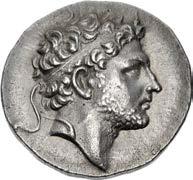
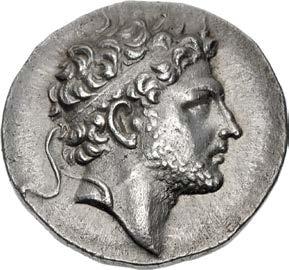
Ex Mark & Lottie Salton Collection.
135. MACEDON (Roman Protectorate), Republican period. First Meris. Circa 167-149 BC. AR Tetradrachm (32.5mm, 16.94 g, 9h). Amphipolis mint. Diademed and draped bust of Artemis right, bow and quiver over shoulder, in the center of a Macedonian shield / Club; 1 and µÅkEdo@W@ above, ∏rWt˙% below; all within oak wreath, thunderbolt to left. Prokopov, Silver, Group I.B, 163 (O46/R137); HGC 3, 1103. Lightly toned, a few minor marks. Near EF. Well centered. ($2000)
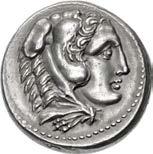

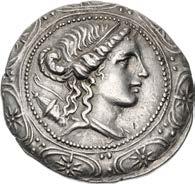
Ex Gorny & Mosch 160 (8 October 2007), lot 1409.
136. KINGS of PAEONIA. Lykkeios. Circa 358/6-335 BC. AR Tetradrachm (23.5mm, 12.79 g, 6h). Astibos or Damastion mint. Head of Zeus right, wearing laurel wreath / Herakles standing left, right hand raised to strike the Nemean Lion, which he has in a strangle-hold with his left arm; ¬U˚˚-E5oU above, bow and quiver to right. Paeonian Hoard 63 (same obv. die); Peykov E1000; NBRM Paeonia 32 (same dies); AMNG III/2, 8; HGC 3, 142; SNG ANS 1019; Alpha Bank, Hellenic 82 (same dies); Šeldarov 760 (same dies). Lightly toned, with golden hues around the devices, underlying luster, typical slight die wear on obverse. Choice EF. ($1000)

From the Dr. Michael Slavin Collection, purchased from Harlan J. Berk.
135 136 137 138
137. KINGS of PAEONIA. Patraos. Circa 335-315 BC. AR Tetradrachm (26mm, 12.37 g, 12h). Astibos or Damastion mint(?). Head of Apollo right, with short hair, wearing laurel wreath / Warrior on horse rearing right, thrusting spear held in his right hand at enemy below who defends with shield on his left arm; ∏Åtr-ÅoU around; boukranion to lower left. Paeonian Hoard 334–5 (same dies); Peykov E2190; HGC 3, 148. Lightly toned, minor scratches. EF ($750)

From the GTP Collection.
138. KINGS of PAEONIA. Audoleon. Circa 315-286 BC. AR Tetradrachm (25.5mm, 17.30 g, 9h). In the name and types of Alexander III of Macedon. Astibus or Damaston mint. Struck circa 300-286 BC. Head of Herakles right, wearing lion skin / ŬE$Å@droU, Zeus Aëtophoros seated left; thunderbolt in left field. Price –; Waggoner, Reflections –; Peykov –; cf. HGC 3, 157. Lightly toned. EF. Extremely rare, unpublished issue. ($1000)

From the GTP Collection. Ex Numismatica Ars Classica 97 (12 December 2016), lot 276; Lanz 123 (30 May 2005), lot 157; Gorny & Mosch 211 (4 March 2013), lot 207.

139. ILLYRIA, Dyrrhachion. Circa 375-280 BC. AR Stater (19.5mm, 10.87 g, 2h). Cow standing right, looking back at suckling calf standing left below; [above, dolphin right] / Double stellate pattern divided by two lines, all in double linear square border; d-U-r and club around; all within linear circle border. Meta Series II, Group III, 2, dies D65/R119; Maier 14; HGC 3, 33; SNG München 335; BMC 13–4. Deep cabinet tone. Good VF. ($500)


From the Pythagoras Collection.
140. KINGS of ILLYRIA. Monounios. Circa 280-270 BC. AR Stater (21mm, 9.82 g, 7h). Dyrrhachion mint. Cow standing right, looking back at suckling calf standing left below; above, jawbone of boar right / Double stellate pattern divided by line, all in double linear square border; ∫Å%5¬EW% Âo@oU@5oU above and below, spearhead to left, club to right; all within linear circle border. Meta dies D118/R177; Gjongecaj Emission 4, 203 (same dies); Paškvan 2; Maier 87; HGC 3, 69 (this coin illustrated); SNG Copenhagen –; BMC 1 (same dies). Minor die shift on obverse. EF. Very rare. ($3000)
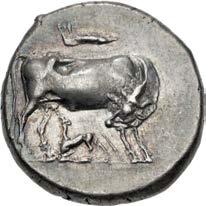
From the North River Collection. Ex Triton XVII (7 January 2014), lot 192; Nomos 6 (8 May 2012), lot 62.
141. KINGS of ILLYRIA. Ballaios. Circa 217-182 BC. AR Diobol(?) (11mm, 1.02 g). Macedonian shield / Star. Visonà, Greek-Illyrian, UM4; D. Ujes, “Le monete del ‘RE’ Ballaios e della zecca Rizonia al Museo Nazionale di Belgrado” in Numizmaticar 16 (1993), pl. III, 30; HGC 3, 61 (unattributed issue). Old collection tone. Good VF. Very rare. ($750)




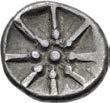
From the Pythagoras Collection, purchased from Edward J. Waddell, Ltd. (his ticket included). Ex Hess-Leu 45 (12 May 1970), lot 170.

142. KINGS of EPEIROS. Pyrrhos. 297-272 BC. AR Tetradrachm (29mm, 16.20 g, 4h). Lokroi Epizephyrioi mint. Struck circa 278-275 BC. Head of Zeus of Dodona left, wearing oak wreath; [Å below] / ∫Ås5¬EWs πUrroU, Dione, draped and wearing polos, seated left on high backed throne, holding staff in right hand and lifting her veil with her left. Babelon, Roi, Type B/c; HGC 3, 261; Basel 211 (same obv. die); Bement 972; Boston MFA 944 = Warren 735; Virzi Sale 476 (same dies); Hess-Leu 11, lot 192 (same rev. die); Munzen und Medaillen AG 53, lot 70 = Leu 2, lot 181 = G. Hirsch 19, lot 347 (same dies); NAC 1, lot 61 (same rev. die). Toned, minor flan crack, trace deposits, areas of roughness, scratches. VF. Rare. ($5000)

From the Pythagoras Collection. Ex Bourgey (2 April 2001), lot 156.
A majestic example of early Hellenistic artwork, as noted by G.K. Jenkins: “It is at once apparent that in one important respect Pyrrhos’ practice is closely akin to that of the Macedonian kings of this time, in that nowhere does his portrait appear. Much as we may regret this, the splendid and exuberant types of Pyrrhos’ Lokrian coins go far to compensate for it. The tetradrachm has for the obverse the head of Dodonean Zeus, whose sanctuary lay in Pyrrhos’ homeland; this head, crowned with oak leaves and with restless flowing hair and beard, makes a strong contrast with the restrained and classical head of the same god minted for Alexander of Epeiros at Tarentum, and even with the more concentrated style of Antigonos Doson’s Poseidon, but the Pyrrhos coin is masterly in its different way. Its exciting and dynamic quality is well matched by the calm majesty of the reverse type, Dione seated on a high-backed throne and swathed in the complex drapery so typical of Hellenistic sculpture.... The impressive style of these coins is quite different from anything we might have expected at an Italian mint at this time, and it may well be that the artist responsible was not a local one, but may have come from mainland Greece or Macedonia.” (G.K. Jenkins, Ancient Greek Coins [New York: Putnam, 1972], pp. 247-8.)

143. THESSALY, Krannon. Circa 462/1-460 BC. AR Hemiobol (8.5mm, 0.56 g, 9h). Hoof of bull; trident horizontally left in background / Head and neck of bridled horse right; ˚-r-å counterclockwise around from upper right; within incuse square. Liampi, Corpus, Group II.I.H, 1a (V1/R1 – this coin, illustrated); BCD Thessaly II 114.3; BCD Thessaly I 1078 corr. (no legend on obv.; this coin); HGC 4, 379; Pozzi (Boutin) 2753 (same dies). Toned, light granularity as usual, typical die break on reverse (diagnostic for die). EF. Very rare, and exceptional for issue. ($2000)






Ex Triton XXIII (14 January 2020), lot 232; BCD Collection (Nomos 4, 10 May 2011), lot 1078.
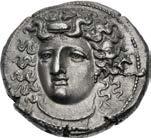
144.
Group Electronic Auction 35 (13 August 2001), lot 63715.
From the JTB Collection. Ex Patrick H. James Collection (Triton XVIII, 6 January 2015), lot 498; Classical
145. THESSALY, Larissa. Circa 356-342 BC. AR Drachm (19mm, 6.07 g, 5h). Head of the nymph Larissa facing slightly left, hair in ampyx, wearing single-pendant earring and plain necklace / Horse standing right, preparing to lie down; ¬År5s-Å5W@ above and below. Lorber, Hoard, Phase L-III, 48 (same obv. die); BCD Thessaly II 316; HGC 4, 453; Gulbenkian 477; Traité IV 701. Toned, trace patches of find patina, a little off center on reverse. Good VF. ($750)


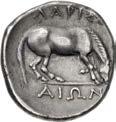
146. THESSALY, Trikka. Circa 440-400 BC. AR Hemidrachm (17mm, 2.88 g, 11h). The hero Thessalos, nude but for cloak and petasos, holding with both hands a band below the horns of forepart of bull leaping right / Forepart of bridled horse right; all within incuse square with rounded corners; no5-˚-˚5r-t counterclockwise around from upper right; all within incuse square. BCD Thessaly II 767 var. (orientation of ethnic); HGC 4, 311. Minor double strike. EF. ($500)



147. AKARNANIA, Anaktorion. Circa 350-300 BC. AR Stater (21mm, 8.46 g, 8h). Pegasos flying left; ô below / Head of Athena left, wearing Corinthian helmet decorated with laurel branch; shell behind. Imhoof-Blumer, Akarnaniens 33; Pegasi 11; BCD Akarnania 80; SNG Copenhagen –; BMC 23; McClean 5289. Lightly toned, some edge marks. Near EF. Fine style. Rare. ($1500)


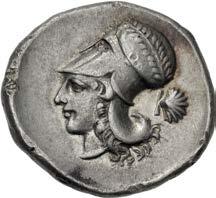

From the JTB Collection. Ex Deyo Collection (Triton XV, 3 January 2012), lot 1160; Classical Numismatic Group 36 (5 December 1995), lot 1896.
145 146 148 149
148. AKARNANIA, Anaktorion. Circa 350-300 BC. AR Stater (20.5mm, 8.53 g, 7h). Pegasos flying left; 5 below / Head of Athena left, wearing Corinthian helmet with neck guard; + and tripod-in-wreath to left. Imhoof-Blumer, Akarnaniens 75 var. (monogram on rev.); Pegasi 29 var. (same); BCD Akarnania 82–3 var. (same); HGC 4, 755. In NGC encapsulation 4276190-005, AU★, Strike: 5/5, Surface: 5/5, Fine Style. ($1500)



Ex Roy Iwata Collection; CNG inventory 157830 (July 2005).
149. AKARNANIA, Anaktorion. Circa 350-300 BC. AR Stater (18mm, 8.52 g, 5h). Pegasos flying left; 5 below / Head of Athena left, wearing Corinthian helmet with neck guard; ¬Us5 above; tiny ¬, 5, and thymiaterion to right. ImhoofBlumer, Akarnaniens –; Pegasi 70 corr. (tiny ¬ not noted; same obv. die); BCD Akarnania 106 var. (no tiny ¬); HGC 4, 763. In NGC encapsulation 6290626-009, graded Ch XF★, Strike: 5/5, Surface: 5/5. Very rare variety. ($1500)
Ex Mark and Lottie Salton Collection.
150. AKARNANIA, Leukas. Circa 320-280 BC. AR Stater (19.5mm, 8.58 g, 6h). Pegasos flying left; A below / Helmeted head of Athena left; behind neck, Å and grape bunch on vine above amphora. Imhoof-Blumer, Akarnaniens –; BCD Akarnania –; Pegasi 129; HGC 4, 825. Lightly toned, underlying luster, minor die break on obverse. VF. ($1500)
151. BOEOTIA, Thebes. Circa 364-362 BC. AR Stater (22.5mm, 12.21 g). Epami(nondas), magistrate. Boeotian shield / Amphora; rosette above, E∏-ÅÂ5 across central field; all within concave circle. Hepworth, Epaminondas pl. 3, 3 (same rev. die); Hepworth 32 (same rev. die); BCD Boiotia 543 (same dies); HGC 4, 1333; Traité III 267, pl. CCI, 16 (same rev. die). A few minor flan flaws. EF. ($1500)

From the Pythagoras Collection. Ex Triton XIII (5 January 2010), lot 1201.
Remnants of the earlier form of the magistrate’s name, E∏-∏Å, are visible on the reverse.
There are times when some of us wonder what the world would be like today if Alexander the Great had lived to a ripe old age. The same kind of “What if ...” thinking could be applied to Epaminondas. His premature death on the battlefield of Mantineia in 362 BC deprived Thebes of its greatest statesman and soldier, signalling the start of Thebes’ rapid decline into obscurity. If Epaminondas had lived to reap the benefits of his Mantineian victory, he would have undoubtedly proceeded to unite all Greece under his leadership. The next step would be to turn to the North and face Philip who, instead of finding a divided Greece ready for the taking, would think twice before attempting to invade Thessaly. Whether then there would be a clash between the two emerging superpowers, or a truce between them, is anybody’s guess. Perhaps Philip would remember the years he spent as a hostage in Thebes and his respect for the Theban statesman would prevail. The conquest of Asia would then materialize sooner and in a more permanent manner. But, like many great soldiers, Epaminondas inspired his men by leading them into battle and, instead of capitalizing on his genius, Thebes paid the price for his bravery.
152. ATTICA, Athens. Circa 515-510 BC. AR Obol (8mm, 0.71 g). “Wappenmünzen” type. Wheel with four spokes / Irregular quadripartite incuse square. Seltman pl. IV, ν; Svoronos, Monnaies, pl. 1, 60–1; HGC 4, 1653; SNG Copenhagen 9; Dewing 1568; Jameson 2488 (this coin). In NGC encapsulation 6290919-007, graded Ch XF★, Strike: 5/5, Surface: 5/5. ($5000)

Ex Mark and Lottie Salton Collection; Robert Jameson Collection (publ. 1932).
153. ATTICA, Athens. Circa 454-404 BC. AR Tetradrachm (24mm, 17.16 g, 11h). Head of Athena right, with frontal eye, wearing earring, necklace, and crested Attic helmet decorated with three olive leaves over visor and a spiral palmette on the bowl / Owl
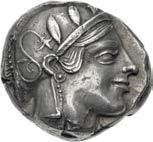

The certain elements of the
coin was among the earliest




more closely resemble those found on the later groups of early-mid 5th
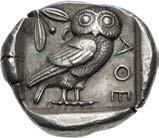
154. ATTICA, Athens. Circa 454-404 BC. AR Tetradrachm (24.5mm, 17.16 g, 10h). Head of Athena right, with frontal eye, wearing earring, necklace, and crested Attic helmet decorated with three olive leaves over visor and a spiral palmette on the bowl / Owl standing right, head facing; olive spray and crescent to left, AQE to right; all within incuse square. Kroll 8; HGC 4, 1597; SNG Copenhagen 31; SNG München 49; Dewing 1591–2 and 1594–8; Gulbenkian 519–21. Lightly toned. EF. Perfectly centered on a broad flan, with full crest. ($2500)
155. ATTICA, Athens. Circa 454-404 BC. AR Tetradrachm (24.5mm, 17.19 g, 7h). Head of Athena right, with frontal eye, wearing earring, necklace, and crested Attic helmet decorated with three olive leaves over visor and a spiral palmette on the bowl / Owl standing right, head facing; olive spray and crescent to left, AQE to right; all within incuse square. Kroll 8; HGC 4, 1597; SNG Copenhagen 31; SNG München 49; Dewing 1591–2 and 1594–8; Gulbenkian 519–21. Deeply toned, underlying luster. Superb EF. Struck on a broad flan. Fine style. ($2000)
156. ATTICA, Athens. Circa 454-404 BC. AR Tetradrachm (25.5mm, 17.21 g, 4h). Head of Athena right, with frontal eye, wearing earring, necklace, and crested Attic helmet decorated with three olive leaves over visor and a spiral palmette on the bowl / Owl standing right, head facing; olive spray and crescent to left, AQE to right; all within incuse square. Kroll 8; HGC 4, 1597; SNG Copenhagen 31; SNG München 49; Dewing 1591–2 and 1594–8; Gulbenkian 519–21. Light golden tone over lustrous surfaces. EF. Well centered on a broad flan, showing much crest. ($2000)

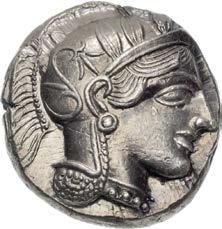
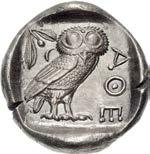


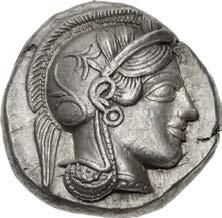

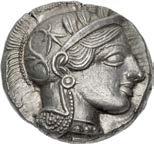

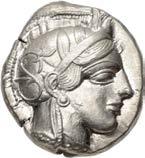

From the JTB Collection.
157. ATTICA, Athens. Circa 454-404 BC. AR Tetradrachm (24mm, 17.15 g, 5h). Head of Athena right, with frontal eye, wearing earring, necklace, and crested Attic helmet decorated with three olive leaves over visor and a spiral palmette on the bowl / Owl standing right, head facing; olive spray and crescent to left, AQE to right; all within incuse square. Kroll 8; HGC 4, 1597; SNG Copenhagen 31; SNG München 49; Dewing 1591–2 and 1594–8; Gulbenkian 519–21. Underlying luster, small delamination on obverse. EF. Struck on a broad flan. Fine style. ($2000)
158. ATTICA, Athens. Circa 353-294 BC. AR Tetradrachm (19.5mm, 16.64 g, 8h). Head of Athena right, with profile eye, wearing earring, necklace, and crested Attic helmet decorated with three olive leaves over visor and a spiral palmette with pi-stye end on the bowl / Owl standing right, head facing; olive spray and crescent to left, ÅQE to right. Kroll –; HGC 4, 1599; SNG Copenhagen 63–5; SNG München 91–100; Dewing 1635–6; Gulbenkian –. Toned, minor flan flaw on obverse, production cut visible on edge (see note below). EF. An exceptional example. ($1000)
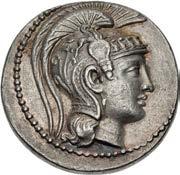
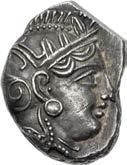
As noted by Kroll in his article, “The Reminting of Athenian Silver Coinage, 353 B.C.” in Hesperia 80.2 (April-June 2011), the Pi-Style tetradrachms are all struck on previous Athenian tetradrachms that had been hammered and folded. On this example, it appears that the previous coin had been hammered and cut, rather than folded, with the two portions stacked together for restriking. It is possible that this coin may have been among the earliest of the Pi-Style series, when the mint workers may have been experimenting with the techniques used for preparing the flans.
159. ATTICA, Athens. Circa 165-42 BC. AR Tetradrachm (30mm, 16.92 g, 12h). New Style coinage. Timarchos, Nikago–, and Doroth–, magistrates. Struck 134/3 BC. Head of Athena Parthenos right, wearing single-pendant earring and triple crested Attic helmet decorated with Pegasos and floral pattern / Owl standing right, head facing, on amphora; Å-œE above t5Â-ÅrcoU>@5˚Å˝o>dWroQ (magistrates’ names) in four lines across field, anchor and star to left, [uncertain letter on amphora], Â˙ below; all within wreath. Thompson 361a–c var. (same obv. die; unlisted with MH on rev.); HGC 4, 1602. Light iridescent tone, light marks. Near EF. ($1500)

160. ISLANDS off ATTICA, Aegina. Circa 480-457 BC. AR Stater (20mm, 12.15 g). Sea turtle, head in profile, with ‘T-back’ design on shell / Large square incuse with skew pattern. Meadows, Aegina, Group IIIa; Milbank Period III; HGC 6, 448; SNG Copenhagen 510; SNG Delepierre 1528–9; Boston MFA –; Dewing 1679; Rosen 221. Attractively toned, a few minor scratches. Near EF. Well centered and struck in high relief. ($5000)

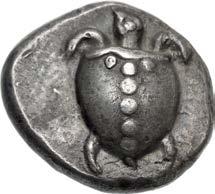


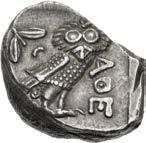
Ex Mark and Lottie Salton Collection; Münzen und Medaillen AG FPL 137 (August 1954), no. 39.

161 162
ISLANDS off ATTICA, Aegina. Circa 480-457 BC. AR Stater (19mm, 11.89 g, 4h). Sea turtle, head in profile, with ‘T-back’ design on shell / Large square incuse with skew pattern. Meadows, Aegina, Group IIIa; Milbank Period III, pl. I, 15; HGC 6, 435; SNG Copenhagen 507; SNG Delepierre 1522–6; ACGC 123; Boston MFA 1111–2; Dewing 1674–8; Gillet 947; Gulbenkian 523; Jameson 1199; Rosen 219. Toned, granular surfaces, deposits and a few scratches on reverse. VF. ($3000)
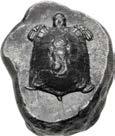






161.
From the S & S Collection. Ex Virginia Ruzicka Collection (Malter XXVIII, 8 December 1984), lot 213.
162. ISLANDS off ATTICA, Aegina. Circa 370 BC. AR Stater (18mm, 12.34 g, 12h). Land tortoise with segmented shell / Large square incuse with thin skew pattern. Milbank pl. II, 14; HGC 6, 438; SNG München 566–9; SNG Delepierre 1545; Dewing 1686. Toned with some original find patina, slightly irregular flan. Good VF. ($1500)


From the S & S Collection. Ex Sternberg XII (18 November 1982), lot 166.
163. ISLANDS off ATTICA, Aegina. Circa 350-338 BC. AR Stater (21mm, 12.24 g, 8h). Ni-, magistrate. Tortoise with segmented shell; Å-5 flanking / “Thin skew” incuse pattern; @-5 in upper incuses, dolphin in lower left. Milbank p. 51, a; cf. HGC 6, 445 (drachm); SNG Copenhagen 526; SNG Lockett 1998; BMC 190; Hunt II 433; Pozzi 1639. Attractive cabinet tone, a little die wear. Good VF. Very high relief obverse. ($5000)
Ex H. M. Robinow Collection (Morton & Eden 51, 24 October 2011), lot 111; Sternberg XII (18 November 1982), lot 166.

164.
CORINTHIA, Corinth. Circa 400-350/45 BC. AR Stater (21.5mm, 8.60 g, 1h). Pegasos, wings raised and trailing rein, alighting left; J below / Head of Athena right, wearing Corinthian helmet with neck guard. Ravel Period IV, 500g (P249/T348) = BCD Corinth 62 = Sartiges 279 (this coin); Pegasi 215 (same dies as illustrations); HGC 4, 1842 (this coin illustrated); Ars Classica X, lot 583 = Naville V, lot 2085 (same dies). Toned, trace deposits, light scratches, slightly weak strike in center. Near EF. Well centered. A very rare type. ($5000)
From the Pythagoras Collection. Ex BCD Collection (Numismatik Lanz 105, 26 November 2001), lot 62; Leu 13 (29 April 1975), lot 165; Vicomte de Sartiges Collection (publ. 1910).

165. CORINTHIA, Corinth. Circa 350/45-285 BC. AR Stater (22mm, 8.53 g, 1h). Pegasos flying left; J below / Head of Athena right, wearing Corinthian helmet with neck guard and laurel wreath on the bowl; Å-r before neck, aegis to right. Ravel Period V, 1009 var. (letters flanking neck truncation); Pegasi 427 GR (same dies as illustration); BCD Corinth –; HGC 4, 1848. Toned, underlying luster, a few light scratches under tone. Near EF. Very rare variety. ($1500)
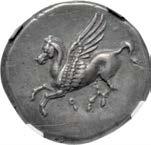
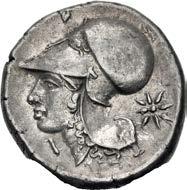
Ex Mark & Lottie Salton Collection.
Calciati (Pegasi) appears to distinguish 427 GR from the standard type 427 due to graffiti on the former, but it also has both letters before the neck, rather than flanking the neck truncation as is usual. The are currently nearly 200 examples of Pegasi 427 on CoinArchives, only five are of this variety, and all are from the same die pair. This suggest the placement of the letters here was an engraver’s error that only affected a single die.

166. CORINTHIA, Corinth. Circa 350/45-285 BC. AR Stater (20mm, 8.55 g, 7h). Pegasos flying left; J below / Head of Athena left, wearing Corinthian helmet with neck guard; 5 below chin; to right, cock standing left on club. Ravel Period V, 1031; Pegasi 423; BCD Corinth 113; HGC 4, 1848. Attractively toned. In NGC encapsulation 6290607-011, graded AU★, Strike: 5/5, Surface: 5/5, die shift. ($2000)
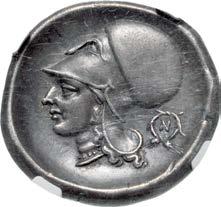



Ex Mark and Lottie Salton Collection.
167. CORINTHIA, Corinth. Circa 350/45-285 BC. AR Stater (21.5mm, 8.53 g, 10h). Pegasos flying left; J below / Head of Athena right, wearing Corinthian helmet with neck guard and laurel wreath on the bowl; 5 before neck, star to right. Ravel Period V, 1034; Pegasi 425; BCD Corinth –; HGC 4, 1848. Toned, underlying luster, die break and area of weak strike on obverse, some die rust and couple of scratches on reverse. EF. ($3000)




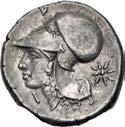
Ex Mark & Lottie Salton Collection.
168. CORINTHIA, Corinth. Circa 350/45-285 BC. AR Stater (21mm, 8.55 g, 6h). Pegasos flying left; J below / Head of Athena left, wearing Corinthian helmet with neck guard; to right, @ within wreath. Ravel Period V, 1069; Pegasi 386; BCD Corinth 128; HGC 4, 1848. Deeply toned. In NGC encapsulation 6290624-003, graded Ch XF★, Strike: 5/5, Surface: 5/5. Perfectly centered. ($2000)
Ex Mark and Lottie Salton Collection.
169. SIKYONIA, Sikyon. Circa 350-340 BC. AR Stater (24mm, 12.08 g, 3h). Chimaera advancing left; wreath above, s5 below / Dove flying left; E above tail feathers; all within wreath. BCD Peloponnesos 216; HGC 5, 199. Toned, light scratches. Good VF. Very rare. ($3000)
Ex CNG inventory 829039 (August 2009); BCD Collection (not in previous sales).
170. SIKYONIA, Sikyon. Circa 335-330 BC. AR Drachm (20mm, 5.85 g, 6h). Chimaera standing left, raising right forepaw; sE below / Dove flying left within wreath. BCD Peloponnesos 229 (this coin); HGC 5, 209 corr. (letters on obv.); BMC 68. Toned, minor roughness. Near EF. ($1000)



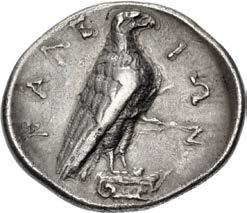







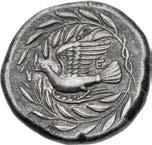
From the Pythagoras Collection. Ex BCD Collection (LHS 96, 8 May 2006), lot 229.
171. ACHAIA,
Ex
From the Pythagoras Collection. Ex private collection in Basel (per Schefold [1960]).
173. ARKADIA, Pheneos. Circa 360-350/40 BC. AR Stater (24mm, 11.16 g, 7h). Head of Demeter to right, wearing grain ear wreath, elaborate disc and crescent earring with pendants, and pearl necklace / Hermes, nude but for his petasos and a cloak over his shoulders, holding kerykeion in right hand, partially facing and advancing left, his head turned right to gaze at the infant Arkas, whom he holds on his left arm with his left hand, and who raises his right hand towards Hermes’ face; fE@E-W@ around below. Schultz 6.13 (V3/R5 – this coin); Traeger, Arkadien 515; BCD Peloponnesos 1622; HGC 5, 976; SNG Berry 867; SNG Fitzwilliam 3897; SNG Lockett 2525; BMC 13; Gillet 1001 = Regling, Antike 664; Kraay & Hirmer 515; Locker Lampson 241 = Weber 4322 (all from the same dies). Deep old cabinet tone, marks and scratches. Near VF. Artistic and rare. ($7500)

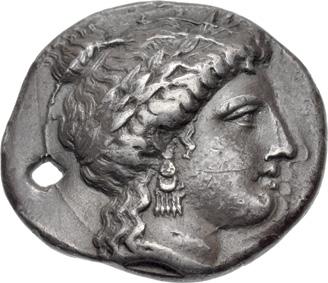

From the Pythagoras Collection. Ex Naville V (18 June 1923), lot 2260.
The stater coinage of Pheneos was very small: it was struck from only three obverse and seven reverse dies. This means the actual output was probably fairly limited, especially since the first obverse die almost immediately broke and was destroyed. These coins were surely designed to pay mercenaries: the years around 360 BC were dangerous ones in Greece and there was a considerable amount of fighting going on. The fact that such beautiful coins were made for such a reason may seem surprising, after all soldiers could be paid just in bullion, but it once again shows that civic pride was a major factor in the way coins were conceived and designed. Here the head of Demeter is remarkably elegant, especially given how beautifully struck and sharp it is; as for Hermes and the infant Arkas on the reverse, one immediately thinks of the Hermes of Praxiteles, which was made circa 343 in nearby Olympia.
174. ARKADIA,
striding left, lion skin around left arm,
bow in left hand,
aloft in his right hand; stUµfŬ5W@ to left, so between legs. Traeger, Arkadien 599; BCD Peloponnesos 1704–5; HGC 5, 1022; SNG Copenhagen 287 (same obv. die); SNG Spencer-Churchill 168 = Gillet 1005 (this coin); Kraay & Hirmer 514 (same obv. die); Traité III 884, pl. CCXXIV, 22 (same obv. die). Toned, holed in field in antiquity, a few cleaning scratches under tone, die breaks and minor double strike on obverse. VF. A masterwork of ancient art. Very rare, approximately 25 known, of which 15 are in museums. ($20,000)
From the Pythagoras Collection. Ex Leu 77 (11 May 2000), lot 226; Charles Gillet Collection; Capt. C. E. Spencer-Churchill Collection; Ars Classica XVI (3 July 1933), lot 1301.
The reverse design of this stater suggests that the artist had in mind a different approach to the myth of the Sixth Labor of Herakles when he engraved the die. According to the traditional rendering of the myth, Herakles, with the assistance of the gods Athena and Hephaistos, destroyed the Stymphalian Birds by shooting them down with his arrows once they took flight. Generally, this is the rendering of the event depicted on most coins – Herakles drawing his bow to take aim at the birds in flight. Such an active scene, however, when depicted on the coinage, results in a compact and often dense image. The engravers at Stymphalos, however, chose to employ a more novel and somewhat subtler design. Rather than adopting a literal interpretation, they chose to depict the hero in a more vigorous pose. Here, Herakles strides forth to do battle, lion skin flowing over his left arm behind him, while he holds his bow in his left hand (the only overt reference to the myth). His club, held in his raised right hand, is poised to strike. What he is about to strike, however, is the ethnic which curves upward in flight before him and serves as surrogate birds.




175. CRETE, Aptera. Circa 280 BC. AR Stater (24mm, 11.36 g, 6h). Obverse die signed by the artist Pythodoros. Head of Artemis right, wearing ornate stephanos, solar-disk pendant earring with three drops, and pearl necklace; [Å-πtErÅ5]W@ around, πUQodWroU to right / The hero Apteros-Ptoloioikos, wearing crested helmet and cuirass, holding shield and spear in left hand, right hand raised toward fir tree to left; πto[¬5]-o5-kos around. Svoronos, Numismatique 5 (same dies as illustration); Le Rider, Crétoises, p. 36, 268; SNG Copenhagen –; BMC 1 (same dies); Boston MFA Supp. 108 (same dies); Boutin –; Evans –; Traeger –. Lightly toned, typical areas of weak strike, scattered light marks. VF. Extremely rare. ($3000)



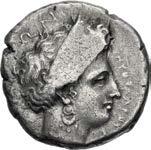

From the JTB Collection. Ex Triton XXIV (19 January 2021), lot 534; Münzen und Medaillen AG 81 (18 September 1995), lot 74.



176. CRETE, Knossos.
Crétoises, pl. XXXII, 5 (same obv. die); SNG Copenhagen
From the Pythagoras Collection.
24–5;
1986 (same obv. die); Gillet 1008; Gulbenkian 566; Hunterian 12; de Luynes 2333. Toned, a few old scratches under tone, area of weak strike, reverse slightly off center. Good VF. ($10,000)
The ancient city of Knossos, the remains of which were excavated by Sir Arthur Evans, beginning in 1900, was founded in the Minoan Period (circa 1700-1400 BC) as a large and complex palace-city. Although the exact origin of the word “labyrinth,” as well as its location, remains open to scholarly conjecture, the intricate maze of rooms and interior courtyards of this palace-city contributed to the later Greek use of the word to describe a maze and the source of the events connected with it to Crete.
According to the Greek myth, Minos was the first king of Crete. Although he gave the island its first constitution, ordered the construction of the palace at Knossos, and was the first to build a navy, he was a cruel tyrant and imperialist. One of his subject cities was Athens. He demanded from its citizens as payment every nine years seven male youths and seven female virgins. Minos would feed them then to the Minotaur, a half-man, half-bull who was held in the Labyrinth, a large walled maze. To stop this brutal tribute, the Athenian hero, Theseus, had himself sent as part of the required tribute. With the assistance of Ariadne, the daughter of Minos, Theseus was able to navigate the Labyrinth successfully and kill the Minotaur.
177.
From the S & S Collection. Ex Dr. J. S. Wilkinson Collection (Malter 49, 15 November 1992), lot 659.
178. CRETE, Olous. Circa 300-270 BC. AR Stater (26.5mm, 10.75 g, 12h). Draped bust of Artemis Britomartis left, hair in band with laurel leaves adorning the top edge, wearing pearl necklace; quiver over her shoulder / Zeus Aëtophoros seated left; Ľ in left field, o¬o@t5W@ to right. Svoronos, Numismatique 1, pl. XXII, 23 = Gillet 1023 = C.S. Liebe, Gotha numaria (Amsterdam: R. & J. Westenios, 1730), p. 191 (this coin); SNG Fitzwilliam 3976 (same dies); BMC 1; Hunterian 1; Mionnet II p. 289, 243. Deep cabinet tone, old cleaning scratches under tone on reverse. EF. Fine style. Extremely rare, one of seven known, and the sole example not in a public collection. ($50,000)


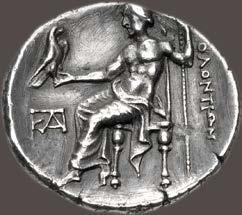
From the Pythagoras Collection. Ex Numismatica Genevensis 7 (27 November 2012), lot 205; Charles Gillet Collection; Schloss Friedenstein (Gotha) Collection (collection of Friedrich II of Saxe-Gotha-Altenburg).
Located on the northeastern coast of Crete, the city of Olous is now sunken and a popular underwater archeological park for divers. Its mint seems to have commenced striking coins circa 330 BC, but with a minimal output compared to other Cretan cities, and its coins are all exceptionally rare today. Olous contained a large wooden temple to the Cretan goddess Britomartis (”sweet maiden”), whose origins go back to Minoan times and was often syncretized with Artemis, as seen on this attractive silver stater. Though one of the lesser local deities, Britomartis had an elaborate mythology related by the Alexandrian scholar Kallimachos. According to one tale, she was pursued by King Minos with the intent to ravish her, but escaped by throwing herself into a fishing boat’s net and was taken by the crew to the mainland, thus bringing her cult to Greece. Her name and virginal character were later adopted into the allegorical female knight Britomart in Edmund Spenser’s epic poem dedicated to Elizabeth I, The Faerie Queene.
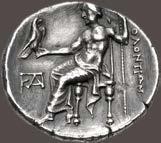
179. CYCLADES, Melos. Circa 440-416 BC. AR Stater (20mm, 14.31 g, 6h). Apple on stem with [two leaves] flanking above / Fig leaf within dotted circle border. Kraay, Melos 41a (A13iii/P31) = Jameson 1294 = Traité III pl. CCXLII, 8 (this coin); HGC 6, 806; McClean 7268 (same dies); Pozzi 2031 (same dies). Toned, minor roughness, metal flaws. Good VF. Very rare. ($10,000)






From the Pythagoras Collection. Ex Münzen und Medaillen AG 76 (19 September 1991), lot 745; Hess-Leu 45 (12 May 1970), lot 209; Robert Jameson Collection (publ. 1913); Melos, 1907 Hoard (IGCH 27).
The simplicity of Melos’ coinage belies the historical importance of the volcanic island and its eponymous city. Its founders hailed from Bronze Age Sparta, circa 1100 BC, and by circa 600 BC Melos boasted an excellent harbor and a fortified citadel with a large agora and theater. Starting circa 530 BC, its early silver coinage was struck on the Milesian standard and depicted either a wine pitcher (oinochoe) or an apple (milo) on the obverse; the latter is likely a canting pun for Melos. While extremely rare today, these early staters bore a variety of reverse types, starting with a simple quadripartite incuse and progressing to specialized floral and geometric designs, including the fig leaf seen here. During the Peloponnesian War, Melos, true to its Spartan roots, refused to join the Delian League and was subjected to a horrific siege by Athens, whose soldiers put all adult males to the sword and enslaved the women and children. Melos recovered from this disaster and today, as Milos, is a popular tourist destination most famous for a beautiful Hellenistic statue found on the island in 1820, the Venus de Milo.
180. CYCLADES, Paros. Early 490s-early 480s BC. AR Drachm (15.5mm, 6.01 g). Goat kneeling right / Quadripartite incuse square. Sheedy Class D, Group 2, unlisted dies (but cf. 110 for similar); HGC 6, 655. Lightly toned with slight iridescence, traces of find patina. Good VF. ($3000)
Ex Alde (19 October 2016), lot 88.

181. CIMMERIAN BOSPOROS, Pantikapaion. Circa 340-325 BC. AV Stater (19.5mm, 9.13 g, 11h). Head of Pan left, wearing ivy wreath / Griffin, holding spear in its mouth, standing left, head facing, forepaw raised, on grain ear; ∏-Å@ around. Frolova, Catalogue, Group V, dies B/– (unlisted rev. die); Anokhin 1021; MacDonald 54; HGC 7, 20; SNG BM Black Sea 864; Gulbenkian 588–90; Jameson 1361; Pozzi 1150; Sartiges 1580; CNG 117, lot 165 (same dies); Triton VII, lot 151 (same dies). Lustrous. NGC photo certification 6557414-001, graded Ch MS, Strike: 5/5, Surface: 4/5, Fine Style. Well centered and struck. ($100,000)
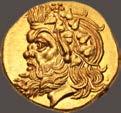
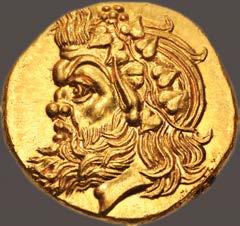

Pantikapaion was founded by Greek colonists from Miletos in the late seventh century BC. Situated on the west side of the Cimmerian Bosporos, in what is now called the Crimea, it achieved great prosperity through its exploitation of the abundant fisheries of the straits and the export of wheat from the Crimea. This wealth is attested by its splendid gold coinage, which commenced in the mid-4th century BC, and by the magnificently furnished rock tombs of its principal citizens in the same period. Later, it was to become a regional capital of the kingdom of Mithradates VI of Pontos (120-63 BC) and later still the seat of the kings of Bosporos (first century BC – fourth century AD). The coinage of Pantikapaion seems to have commenced with silver issues in the latter part of the fifth century BC, but it is for its beautiful gold staters that the mint is chiefly noted. They depict the head of the god Pan (a pun on the name of the city) and on the reverse, the griffin that Herodotos describes as being the guardian of the remote sources of gold.

182. KOLCHIS, Phasis. Circa 425-325 BC. BI Half Siglos – Hemidrachm (11mm, 2.41 g, 7h). Archaic head of female right in linear circle border / Head of bull right in linear circle border. Hind 7; HGC 7, 215; SNG BM Black Sea 1014; SNG Copenhagen 98. Toned. Good VF. Attractive for issue. ($300)

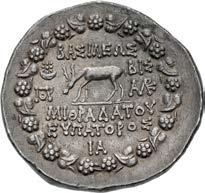


From the Dr. Robert Misbin Collection. Ex Classical Numismatic Group XXX (11 June 1994), lot 151.
183. KINGS of PONTOS. Mithradates VI Eupator. Circa 120-63 BC. AR Tetradrachm (31.5mm, 16.73 g, 12h). Pergamon mint. Dated month 5, year 206 BE (February 91 BC). Diademed head right / ∫Å%5¬EW% Â5QrÅdÅtoU EU∏Åtoro%, Pegasos grazing left; star-in-crescent to left; to right, 4s (year) above m; E (month) in exergue; all within Dionysiac wreath of ivy and fruit. Callataÿ p. 11, dies D33/R– (unlisted rev. die); HGC 7, 338; DCA 688; Gulbenkian 937 (same obv. die). Bright surfaces, a little roughness on obverse, minor double strike on reverse. Near EF. ($3000)
From the GTP Collection. Ex Roma V (23 March 2013), lot 421 (erroneous dies cited).
184. KINGS of PONTOS. Mithradates VI Eupator. Circa 120-63 BC. AR Tetradrachm (34mm, 16.72 g, 12h). Pergamon mint. Dated month 11, year 212 BE (August 85 BC). Diademed head right / ∫Å%5¬EW% Â5QrÅdÅtoU EU∏Åtoro%, stag grazing left; to left, star-in-crescent above (; to right, ∫5s (year) above ¬; 5Å (month) below; all within Dionysiac wreath of ivy and fruit. Callataÿ p. 16, dies D3/R4; M.J. Price, “Mithradates



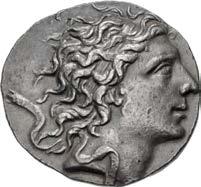

Eupator, Dionysus, and the Coinages of the Black Sea” in NC 1968, pl. I, 6 = RG 16, pl. suppl. B, 12 = Mionnet II 10 (same obv. die); HGC 7, 338; DCA 688. Old collection tone, some marks. Good VF. ($3000)
Ex Mark and Lottie Salton Collection; Salton-Schlessinger FPL 27 (Fall 1958), no. 6.
185.
(31mm, 16.72 g, 12h).
stag grazing left; to left, star-in-crescent above n; to right, ˝˚s (year) above =; œ (month) in exergue; all within Dionysiac wreath of ivy and fruit. Callataÿ dies O48/R– (unlisted rev. die); HGC 7, 340; DCA 692; SNG Ashmolean 201 (same obv. die); Davis 186 (same obv. die); Pozzi 2100 (same obv. die). Attractively toned, a few light scratches. EF. Well centered and struck, with a wonderful portrait. ($20,000)
Mithradates was the Hellenistic monarch par excellence, his career driven by megalomaniacal ambitions leading to murderous assaults upon family and followers and disastrous foreign adventures against superior forces. His portraiture attempts to mimic the gods with its bold staring gaze and unruly, free-flowing hair, but at its most extreme is a personification of hysteria in its Dionysiac sense.
At the age of 18, Mithradates overthrew his mother’s regency and embarked on a career of conquest, bringing most of the lands around the Black Sea into his domain. His expansionist aims inevitably brought him into conflict with Rome, and in preparation for the coming war he built up the largest army in Asia, unleashing it in 88 BC in what would be the First Mithradatic War. He sought to undermine the Roman power base by ordering the massacre of every Roman citizen in Asia in which nearly 80,000 people perished.
The Romans were not intimidated, and when Mithradates crossed over to Greece proper as ‘Liberator’, the Roman legions under Sulla smashed his army. Mithradates retreated to Pontus, from where he continued to skirmish with the Romans, suffering more defeats to the general Lucullus. In 63 BC, having suffered a final defeat by Pompey and facing a revolt by his own son Pharnakes, the elderly king tried to commit suicide by taking poison, but he had inured himself to its affects by years of small counterdoses, and so had to be stabbed to death by one of his mercenaries.
186. KINGS of PONTOS. Mithradates VI Eupator. Circa 120-63 BC. AR Tetradrachm (33.5mm, 16.41 g, 12h). Pergamon mint. Dated BE 231 (67/6 BC). Diademed head right / ∫Å%5¬EW% Â5QrÅdÅtoU EU∏Åtoro%, stag grazing left; star-in-crescent to left, â to right, Ŭs (date) in exergue; all within Dionysiac wreath of ivy and fruit. Callataÿ p. 22, dies D77/R– (unlisted rev. die); HGC 7, 340; DCA 692; SNG BN 826 (same obv. die). Toned. EF. Fine style. Extremely rare date, one of only eight known. ($10,000)
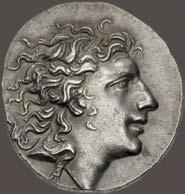




From the GTP Collection. Ex Classical Numismatic Review XLVI.1 (Winter 2021), no. 564362; Jonathan P. Rosen Collection (Triton XXIII, 14 January 2020), lot 296; Roma XIV (21 September 2017), lot 275; Roma VII (22 March 2014), lot 759.

187 188
187. KINGS of PONTOS. Mithradates VI Eupator. Circa 120-63 BC. AV Stater (18mm, 8.30 g, 12h). First Mithradatic War issue. In the name and types of Lysimachos of Thrace. Kallatis mint. Struck circa 88-86 BC. Diademed head of the deified Alexander right, with horn of Ammon / [∫]Å%5¬EW% [¬]U%5ÂÅcoU, Athena Nikephoros seated left, left arm resting on shield, spear diagonally in background; Ao to inner left, kŬ on throne; in exergue, ornate trident left. Callataÿ p. 139, dies D6/R1; AMNG I 258; HGC 3, 1824; SNG Copenhagen –; SNG Stockholm 838 (Thrace; same obv. die). Typical die wear, slight bend in flan. Good VF. ($1000)
Ex Peter J. Merani Collection (Triton XXIV, 19 January 2021), lot 18; CNG inventory 714302 (July 1999).
188. KINGS of PONTOS. Mithradates VI Eupator. Circa 120-63 BC. AV Stater (18mm, 8.31 g, 12h). First Mithradatic War issue. In the name and types of Lysimachos of Thrace. Kallatis mint. Struck circa 88-86 BC. Diademed head of the deified Alexander right, with horn of Ammon / ∫Å%5¬EW[%] 2U%5;ÅcoU, Athena Nikephoros seated left, left arm resting on shield, spear diagonally in background; Ao to inner left, kŬ on throne; in exergue, ornate trident left. Callataÿ p. 140, dies D6/R2; AMNG I 258; HGC 3, 1824; SNG Stockholm 838 (Thrace; same obv. die). Underlying luster. EF. ($1500)


From the North River Collection. Ex Triton XV (3 January 2012), lot 1192.
189.
s5@W in exergue. RG 22; HGC 7, 1488; SNG BM Black Sea 1471; SNG BN 490–1. Light iridescent tone. Superb EF. ($750)
From the GTP Collection. Ex Roma VII (22 March 2014), lot 741.
190. BITHYNIA, Kalchedon. Circa 260-220 BC. AR Tetradrachm (29mm, 16.79 g, 12h). In the name and types of Alexander III of Macedon. Head of Herakles right, wearing lion skin / ŬE$Å@droU ∫Ås5¬EWs, Zeus Aëtophoros seated left; , in left field, grain ear in exergue. Price 926 (Kallatis); Türkoğlu –; HGC 7, 521. Toned, a couple of minor cuts on obverse, slight die shift on reverse. Good VF. ($500)





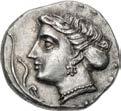


From the GTP Collection. Ex Classical Numismatic Review XLIII.2 (August 2018), no. 488413; José Miguel Márquez del Prado Collection (Classical Numismatic Group 108, 16 May 2018), lot 161; Áureo & Calicó 295 (5 July 2017), lot 23.
191. MYSIA, Kyzikos. Circa 600-550 BC. EL Hekte – Sixth Stater (8.5mm, 2.72 g). Tunny downward between two tunny heads outwards flanked by pellets / Quadripartite incuse square. Hurter & Liewald III 19.1; cf. Von Fritze I 11 (tunny upward, hemihekte); Greenwell –; Boston MFA –; cf. SNG BN 169 (same); BMC –; Gulbenkian –; Jameson –; Rosen –; Weber –; CNG E-375, lot 360; Numismatik Naumann 80, lot 137 = Numismatik Naumann 77, lot 144; Triton XII, lots 1267–8. Scratch and small area of weak strike on obverse. VF. Very rare with tunny downward. ($750)

From the Siren Collection.

192. MYSIA, Kyzikos. Circa 600-550 BC. EL Hekte – Sixth Stater (9mm, 2.70 g). Tunny head left above tunny tail right / Quadripartite incuse square. Hurter & Liewald III 12.1; Von Fritze I 6; Greenwell 167; Boston MFA –; SNG BN 165 = Traité I 244, pl. VI, 15; BMC –; Gulbenkian –; Jameson –; cf. Rosen 416 = SNG von Aulock 7262 (hemihekte); Weber –. VF. Rare early issue. ($1000)
From the Siren Collection.
193. MYSIA, Kyzikos. Circa 550-450 BC. EL Hemihekte – Twelfth Stater (8mm, 1.29 g). Fox standing left, biting into tail of tunny right below / Quadripartite incuse square. Von Fritze I 35; Greenwell 142; Boston MFA 1410 = Warren 1571; SNG BN –; SNG von Aulock 1173; BMC –; Gulbenkian –; Jameson –; Rosen –; Weber –. VF. Well centered. Very rare, only three in CoinArchives. ($1000)

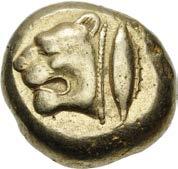

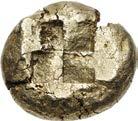




From the Siren Collection.
194. MYSIA, Kyzikos. Circa 550-450 BC. EL Stater (18mm, 16.07 g). Head of lion left; to right, tunny upward / Quadripartite incuse square. Von Fritze I 39; Greenwell 115; Boston MFA 1414 = Warren 1537; SNG BN 178; BMC 39; Gillet –; Gulbenkian –; Jameson 1403; Kraay & Hirmer 700; Myrmekion –; cf. Rosen 432 (hekte); Weber 4985. A few light hairlines. VF. Well centered. ($3000)

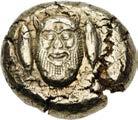

Ex Siren Collection (Classical Numismatic Group Electronic Auction 500, 22 September 2021), lot 257.
195. MYSIA, Kyzikos. Circa 550-450 BC. EL Hekte – Sixth Stater (12mm, 2.70 g). Head of tunny left and head of lion right, joined together at the neck / Incuse square punch. CNG 105, lot 151; CNG 96, lot 381; otherwise unpublished, but cf. Hurter & Liewald I 32a = Münzen und Medaillen AG FPL 308, no. 22 for the hemihekte of this issue. Minor cleaning marks. VF. Struck on an elongated flan which displays virtually complete types. Possibly the third known. ($1000)
From the Siren Collection.
196.
From the JTB Collection. Ex Jonathan P. Rosen Collection (not in the published catalog).
197. MYSIA, Kyzikos. Circa 550-450 BC. EL Hekte – Sixth Stater (10mm, 2.66 g). Facing head of Silenos, protruding tongue; at sides, two tunnies upward / Quadripartite incuse square. Von Fritze I 77; Greenwell 45; Boston MFA 1424 = Warren 1465; SNG BN 208; SNG von Aulock 7269; BMC –; Gillet –; Gulbenkian –; Jameson –; Rosen 455; Weber –. A few minor marks. Near EF. Well struck for issue. Wonderful archaic facing Silenos. ($2000)

From the JTB Collection. Ex Leu Numismatik Web Auction 7 (23 February 2019), lot 313.
198. MYSIA, Kyzikos. Circa 550-450 BC. EL Stater (15mm, 16.16 g). Griffin seated left, raising right forepaw, on tunny left / Quadripartite incuse square. Von Fritze I 101; Greenwell 144; Boston MFA 1437 = Warren 1573; SNG BN –; BMC –; Gillet –; Gulbenkian –; Jameson –; Myrmekion –; Rosen 479; Weber –; Triton XX, lot 207. Good VF. Well centered. Rare issue, not to be confused with the more common variety with a griffin standing (von Fritze I 99). ($3000) Ex Siren Collection (Classical Numismatic Group 118, 13 September 2021), lot 247.


199. MYSIA, Kyzikos. Circa 550-450 BC. EL Hekte – Sixth Stater (10mm, 2.69 g). Facing gorgoneion, mouth opened and tongue protruding between her teeth, five coiled serpents rising from her head, another two emanating from below her ears; below, tunny left / Quadripartite incuse square. Von Fritze I 129; Greenwell 75; cf. Boston MFA 1445 = Warren 1492 (stater); SNG BN –; cf. SNG von Aulock 7295 (hemihekte); BMC –; Gulbenkian –; Jameson 2192; Rosen –; cf. Weber 4972 (stater). In NGC encapsulation 6157497-005, graded Ch AU, Strike: 5/5, Surface: 4/5. ($750)




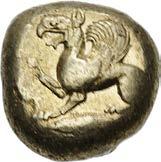



200. MYSIA, Kyzikos. Circa 550-450 BC. EL Hekte – Sixth Stater (10mm, 2.67 g). Head of Perseus left, wearing winged helmet; to right, tunny diagonally downward left / Quadripartite incuse square. Von Fritze I 65; Greenwell 73; cf. Boston MFA 1449 = Warren 1490 (stater); cf. SNG BN 193 (stater); SNG von Aulock 1186; BMC –; Gulbenkian –; Jameson 2169; Rosen –; cf. Weber 4973 (stater). Iridescent tone. EF. Exceptional, and rare as a hekte. ($3000)
From the JTB Collection. Ex Tkalec (18 February 2013), lot 54.

201. MYSIA, Kyzikos. Circa 450-330 BC. EL Stater (17.5mm, 15.86 g). Hoplite, nude but for Corinthian helmet, shield on left arm, right arm extended forward, standing in a semi-crouched stance right on ground line; to right, tunny downward / Quadripartite incuse square. Von Fritze I 119; Greenwell 91; Boston MFA 1497; SNG BN 265 = de Luynes 2452; BMC 78; Gillet –; Gulbenkian 620; Jameson 1404; Myrmekion 17; Rosen –; Weber –. A few minor scuffs on obverse, light scratches on reverse. VF. Well centered. ($3000)
Ex Buxton Collection (Heritage 3098, 18 January 2022), lot 33122; A.F. Collection (Roma XV, 5 April 2018), lot 231.
The hoplite is about to begin the foot race in which the runners carried their military equipment (see A. Milavic, “Hoplitodromos: The hoplite race in armor served as a vehicle to train for war” in The Celator 5.8 [August 1991]). Agnes Baldwin Brett, in BMFA, suggests that type here could be a “copy of Kritios’ statue erected on the Akropolis at Athens, representing Epicharinos, Athenian hoplite runner victorious in Olympic games.”
202. MYSIA, Kyzikos. Circa 450-330 BC. EL Stater (18mm, 16.01 g). Thetis, holding wreath in extended right hand and wearing shield on left arm, riding dolphin left; below, tunny left / Quadripartite incuse square. Von Fritze I 159; Greenwell 48; Boston MFA 1501 = Warren 1467; SNG BN 307; BMC 69; Gillet –; Gulbenkian 634; Jameson –; Myrmekion –: Rosen –; Weber 4994. Lightly toned, trace deposits, compact flan, scratch on reverse. VF. Very rare. ($7500)




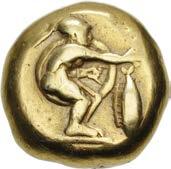
This type is traditionally thought to portray a Trojan War-related scene, with Thetis carrying the shield forged by Hephaistos to her son Achilles, for whom her wreath is also intended. However, Greenwell advanced an alternate theory, that it is a naval victory-related scene depicting a nereid, likely in commemoration of the Battle of Kyzikos in 410 BC.
203. MYSIA, Kyzikos. Circa 450-330 BC. EL Hekte – Sixth Stater (11mm, 2.53 g). Boy seated facing, head right, legs splayed to left, holding in his right hand a tunny fish by the tail / Quadripartite incuse square. Cf. Von Fritze I 169 (unlisted denomination); cf. Greenwell 89 (same); cf. Boston MFA 1511 = Warren 1508 (stater); cf. SNG BN 316 (stater); cf. BMC 77 (stater); Gulbenkian –; Jameson 2201; cf. Rosen 509 (stater); Weber –; Triton XVII, lot 264. Some hairlines, slight die wear on obverse. VF. Very rare as a hekte. ($1500)

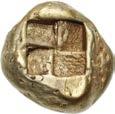

From the Siren Collection.
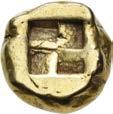
204. MYSIA, Kyzikos. Circa 450-330 BC. EL Hekte – Sixth Stater (10mm, 2.57 g). Head of Attis right, wearing Phrygian headdress; below, tunny right / Quadripartite incuse square. Von Fritze I 142; Greenwell 56; Boston MFA 1523; SNG BN 292–3; BMC –; Gillet –; cf. Gulbenkian 644 (stater); Jameson –; Weber –. Near EF. ($1000)


From the Siren Collection.
The portrait on this particular issue is thought to be Attis, the consort of Phrygian Kybele. The androgynous Kybele/Agdistis was castrated by the gods. From the severed parts grew an almond tree from which Attis sprang. Attis appears infrequently in Greek art, but he was raised in status when the Romans adopted the cult of Kybele.

205. MYSIA, Kyzikos. Circa 450-330 BC. EL Stater (18.5mm, 15.95 g). Zeus kneeling right, chiton draped from waist, holding scepter in right arm, left arm extended, above which an eagle stands right, with open wings; below, tunny right / Quadripartite incuse square. Von Fritze I 145; Greenwell 2; Boston MFA 1530 = Warren 1422; SNG BN 296; BMC 61; cf. FSD SHM 1218 (myshemihekte); Gillet 1060; Gulbenkian –; Jameson –; Myrmekion –; Rosen –; Weber –. Lightly toned, minor marks. Good VF. Attractive. ($10,000)
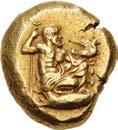

206. MYSIA, Kyzikos. Circa 450-330 BC. EL Hemihekte – Twelfth Stater (8mm, 1.25 g). Bearded male, nude but for petasos and cloak tied at neck, crouching left on the back of a sacrificial ram lying left, holding its head up with his left hand, exposing its neck that he prepares to strike with a knife held above in his right hand / Quadripartite incuse square. Cf. Von Fritze I 156 (unlisted denomination); cf. Greenwell 71 (same); Kovacs XII, lot 82; Leu Numismatik Web Auction 18, lot 1062 = Savoca 40, lot 43 = Savoca 33, lot 149; otherwise, unpublished. Minor hairlines. Good VF. Extremely rare as a hemihekte, only two in CoinArchives. ($1000)

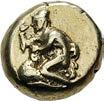


From the Siren Collection.
The identification of the male on the obverse has long been debated. M. F. Lenormant first suggested Phrixos sacrificing the ram with the golden fleece, but Greenwell preferred Odysseus slaying the animal Circe provided him before his descent into Hades, in part due to the figure being bearded, which indicated an older individual, which contrasts with the youthful portraits traditionally given to Phrixos.

207. MYSIA, Pergamon. Circa 166-67 BC. AR Tetradrachm (26mm, 12.58 g, 12h). Cistophoric standard. Ar–, prytaneis Struck circa 88-85 BC. Cista mystica with serpent; all within ivy wreath / Two serpents entwined around bow and bowcase; above, &r above ï (=prytaneis); E (civic monogram) to left, serpent-entwined staff to right. Kleiner, Hoard 27; Pinder 104; SNG BN 1729. Toned. EF. Struck with fresh dies. ($500)
From the GTP Collection. Ex Künker 226 (11 March 2013), lot 436.

208. KINGS of PERGAMON. Philetairos. 282-263 BC. AR Tetradrachm (28.5mm, 17.12 g, 12h). Pergamon mint. Struck circa 269/8-263 BC. Diademed head right / f5¬EtÅ5roU, Athena enthroned left, right hand resting on shield set at her feet, left elbow resting on small sphinx seated right; transverse spear in background, ivy leaf above knee, v on throne, bow to right. Westermark Group II, obv. die III; SNG BN 1603–5 (Eumenes I); SNG Hunterian 180 (same obv. die); SNG Ashmolean 750; SNG von Aulock 1354; BMC 30; Bement 1391; McClean 7672. EF. Well struck. ($3000)
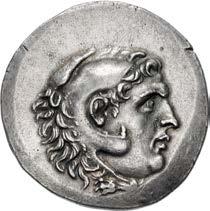

209. TROAS, Assos. Circa 500-450 BC. AR Drachm (12.5mm, 3.31 g, 9h). Chian standard. Griffin springing left / Head of roaring lion right within incuse square. SNG Arikantürk I –; BMC 1; Boston MFA 1626. Lightly toned, only a hint of the usual granularity. Good VF. Well centered on a broad flan. ($750)

210. TROAS, Assos. Circa 500-450 BC. AR Drachm (15mm, 3.51 g, 1h). Chian standard. Griffin springing left / Head of roaring lion right within incuse square. SNG Arikantürk I –; BMC 1; Boston MFA 1626. Toned, a few minor flan flaws, a couple short scratches on obverse. Good VF. Well centered on a broad flan. ($750)





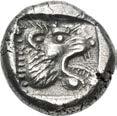
211. TROAS, Assos. Circa 500-450 BC. AR Drachm (14mm, 3.75 g, 5h). Chian standard. Griffin springing left / Head of roaring lion right within incuse square. SNG Arikantürk I –; BMC 1; Boston MFA 1626. Toned, some granularity. Good VF. ($750)
210 211 212 213
212. AEOLIS, Myrina. Circa 188-170 BC. AR Tetradrachm (35mm, 16.80 g, 12h). In the name and types of Alexander III of Macedon. Head of Herakles right, wearing lion skin / ŬE$Å@droU, Zeus Aëtophoros seated left; in left field, ÂUr5 above amphora. Price 1663; Gaziantep 318; C. Lorber, “Commerce (‘Demetrius I’ Hoard), 2003 (CH 10.301)”, 151 (same obv. die). Attractively toned, with some iridescence, a few minor scratches. Near EF. ($1000)
From the GTP Collection, purchased from Münzen und Medaillen GmbH.
213. AEOLIS, Myrina. Circa 155-143 BC. AR Tetradrachm (32mm, 16.77 g, 12h). Stephanophoric type. Head of Apollo right, wearing laurel wreath / Apollo Grynios standing right, holding phiale in right hand and laurel branch in left; `, Ĺ, and ÂUr5@Å5o@ to left, omphalos and amphora at feet; all within laurel wreath. Sacks Issue 43, dies 81/a; SNG Copenhagen –; SNG von Aulock –; BMC –. Attractively toned, small areas of weak strike. EF. ($2000)





214. LESBOS, Mytilene. Circa 521-478 BC. EL Hekte – Sixth Stater (10mm, 2.51 g). Forepart of winged lion left / Incuse head of cock left; rectangular punch to right. Bodenstedt Em. 9.1; HGC 6, 933; BMC 25; Jameson 1472; de Luynes 2546; Traité II 2135. In NGC encapsulation 6057031-008, graded Ch AU, Strike: 5/5, Surface: 5/5. ($3000)
Ex Heritage 3091 (6 May 2021), lot 32095.
215. LESBOS, Mytilene. Circa 521-478 BC. EL Hekte – Sixth Stater (10.5mm, 2.52 g, 12h). Forepart of winged boar left / Incuse head of cock left; rectangular punch to right. Bodenstedt Em. 9.1; HGC 6, 933; BMC 25; Jameson 1472; de Luynes 2546; Traité II 2135. Lightly toned, slightly compact flan, a few scratches. Near EF. Well centered. ($2000)
216. LESBOS, Mytilene. Circa 377-326 BC. EL Hekte – Sixth Stater (10.5mm, 2.53 g, 12h). Veiled head of Demeter right, wearing wreath of grain ears / Tripod tied with fillet in linear square within incuse square. Bodenstedt Em. 91; HGC 6, 1017; SNG Copenhagen 329; SNG von Aulock 1726; SNG Lockett 2766 = Pozzi 2335; BMC 118–21; Bement 1429; Boston MFA 1743; Gulbenkian 712; Hermitage Sale II 1245; McClean 7979. Lightly toned. EF. ($1500)

From the North River Collection. Ex Christopher Morcom (Triton XI, 8 January 2008), lot 230.
217. LESBOS, Mytilene. Circa 377-326 BC. EL Hekte – Sixth Stater (10mm, 2.55 g, 11h). Half length bust of Maenad, hair in sphendone, right / Race torch in linear square within shallow incuse square. Bodenstedt Em. 92; HGC 6, 1018; SNG Copenhagen 320; BMC 122; Boston MFA 1744; Jameson 1478; Traité II 2219; Weber 5643. Minor scratches, a little off center on reverse. VF. ($500)
218. LESBOS, Mytilene. Circa 377-326 BC. EL Hekte – Sixth Stater (10mm, 2.56 g, 6h). Head of Apollo right, wearing laurel wreath / Head of Artemis right, hair bound in sphendone; coiled serpent behind neck; all in linear square [within shallow incuse square]. Bodenstedt Em. 100A; HGC 6, 1026; Boston MFA 1720; SNG von Aulock 1714; BMC 85; Gulbenkian 714; Hermitage Sale II 1239; Jameson 1487; McClean 7971; Traité II 2211. Toned, somewhat irregular flan. Near EF. ($3000)




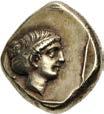



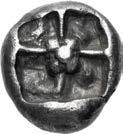











219. WESTERN ASIA MINOR, Uncertain. 5th century BC. AR Drachm (13mm, 3.94 g). Facing forepart of lion; square ornament above / Quadripartite incuse square with raised central square and pellet. CNG 105, lot 287; CNG 94, lot 692; Nomos Obolos 22, lot 281; Numismatik Naumann 75, lot 160; Numismatik Naumann 65, lot 108; Numismatik Naumann 60, lot 124; otherwise, unpublished. Toned. Good VF. Very rare. ($1000)

220 221
220. WESTERN ASIA MINOR, Uncertain. Circa 145-140 BC. AR Tetradrachm (30mm, 17.02 g, 12h). In the name and types of Alexander III of Macedon. Head of Herakles right, wearing lion skin / ŬE$Å@droU, Zeus Aëtophoros seated left; no control marks. Price –; Seyrig, Trésors, pl. 10, 5.21; CNG 108, lot 187 (same dies). Lightly toned. Near EF. Well centered and struck. Very rare. ($2000)
From the GTP Collection. Ex Numismatica Ars Classica 96 (6 October 2016), lot 1048; Patrick H. C. Tan Collection (Heritage 3032, 10 April 2014), lot 23094; California Collection (Heritage 3037, 4 January 2015), lot 29956.
There are numerous Alexander type issues without any control marks from disparate mints issued from the late 4th-1st centuries BC. Their mint of issue and dating can only be presumed from a careful comparison with other issues whose attributions are known. The present piece has a stylistic affinity to a variety of civic Alexander issues in Ionia and Caria in the mid-late 3rd century. Interestingly, Price appears to include only a handful of these unmarked issues, leaving out many that were even present in references he consulted.
221. IONIA, Ephesos. Circa 390-325 BC. AR Tetradrachm (24mm, 15.26 g, 12h). Kallidamas, magistrate. Class F, circa 360-350 BC. Bee with straight wings; E-f flanking head / Forepart of stag right, head left; palm tree to left, ˚Ŭ¬5dÅÂÅs to right. Karwiese II, Series 11.1, 375 (O82/R1 – this coin illustrated); SNG von Aulock –; SNG Copenhagen –; SNG Lockett 2809. Toned, a little off center on obverse. VF. Rare magistrate. ($2000)




Ex Roger Liles Collection (Classical Numismatic Group 94, 18 September 2013), lot 509; John F. Sullivan Collection (Classical Numismatic Group 70, 21 September 2005), lot 247.
222. IONIA, Ephesos. Circa 300-290 BC. AR Tetradrachm (31mm, 17.19 g, 12h). In the name and types of Alexander III of Macedon. Head of Herakles right, wearing lion skin / ŬE$Å@droU, Zeus Aëtophoros seated left; in left field, bee right above EfE. Price 1876; Berlin obj. no. 18252333 (same obv. die). Lightly toned, small flan flaw on obverse. EF. Well centered. ($1500)
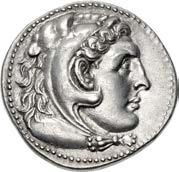
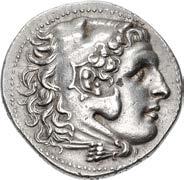
From the GTP Collection. Ex Hess-Divo 327 (22 October 2014), lot 21; Giessener Münzhandlung 58 (9 April 1992), lot 242.
223. IONIA, Ephesos. Circa 202-150 BC. AR Drachm (18mm, 4.01 g, 12h). Dioskourides (II), magistrate. Bee / Stag standing right; palm tree in background; d5o%˚oUr5d˙[%] to right. Kinns, Attic, p. 86, obv. die unlisted for magistrate; SNG Copenhagen –; SNG Delepierre 2604. Bright surfaces. EF. ($750)

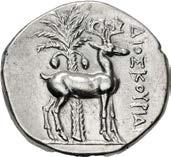

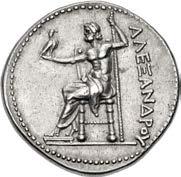
224 225
224. IONIA, Ephesos. Circa 202-150 BC. AR Drachm (18.5mm, 4.17 g, 12h). Pausanias, magistrate. Bee / Stag standing right; palm tree in background; ∏ÅU%Å@5Å% to right. Kinns, Attic, p. 89, obv. die unlisted; SNG Copenhagen –; SNG von Aulock 1850. Minor die wear on obverse. Good VF. Well centered. ($500)



225. IONIA, Herakleia ad Latmon. Circa 140-135 BC. AR Tetradrachm (31mm, 16.53 g, 12h). Stephanophoric type. Head of Athena Parthenos right, wearing crested Attic helmet decorated with Pegasos above the foreparts of five galloping horses / Club; ˙rÅ˚¬EWtW@ above; below, Nike walking left, holding wreath in extended right hand, flanked by ö and Ù; all within oak wreath. Lavva, Silberprägung, Group III, 13 var. (unlisted dies); SNG Copenhagen 781; SNG von Aulock 1978. Lightly toned, some peripheral weakness as usual. EF. Elegant style. ($2000)
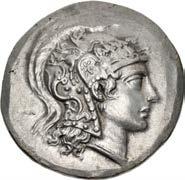


From the North River Collection. Ex Collection C.P.A. (Classical Numismatic Group 78, 14 May 2008), lot 784; Triton VI (14 January 2003), lot 352.
226. IONIA, Magnesia ad Maeandrum. Circa 350-325 BC. AR Hemidrachm (12.5mm, 1.75 g, 12h). Rhodian standard. Nisaios, magistrate. Warrior, wearing helmet and military attire, holding lance in right hand / Bull butting left on maeander pattern; ÂÅ˝@ above, grain ear to right, @5sÅ5os in exergue. SNG Copenhagen 807-8 var. (magistrate); SNG von Aulock 2035 (this coin); BMC 3. Toned, slightly off center on obverse. EF. ($1000)





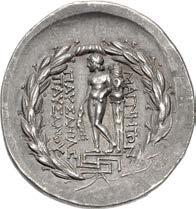
From the JTB Collection. Ex Jolimont Collection; Numismatica Genevensis SA 7 (27 November 2012), lot 223, Tradart (8 November 1992), lot 106, Numismatic Fine Arts XIV (29 November 1984), lot 147; Hans von Aulock Collection (1906-1980).
227 228
227. IONIA, Magnesia ad Maeandrum. Circa 150-140 BC. AR Tetradrachm (32.5mm, 16.89 g, 12h). Stephanophoric type. Pausanias, son of Pausanias, “magistrate”. Diademed and draped bust of Artemis right, bow and quiver over shoulder / Apollo Delphios standing left, left elbow resting on tall tripod behind, holding in right hand a branch tied with fillet; ∏ÅU%Å@5Å% ∏ÅU%Å@5oU to left, ;Å˝@˙tW@ to right, meander pattern below; all within laurel wreath. Jones dies 12/b; SNG von Aulock 7922; SNG Copenhagen 844; Jameson 1504; Pozzi 2460 (same dies). Attractively toned, with slight iridescence, trace deposits, minor double strike and thin die break on reverse, a couple of tiny edge nicks. EF. ($2000)
From the D.K. Collection.
228. IONIA, Magnesia ad Maeandrum. Circa 150-140 BC. AR Tetradrachm (29mm, 16.95 g, 12h). Stephanophoric type. Herognetos, son of Zopyrionos, “magistrate”. Diademed and draped bust of Artemis right, bow and quiver over shoulder / Apollo Delphios standing left, left elbow resting on tall tripod behind, holding in right hand a branch tied with fillet; ˙ro˝@˙to% zo∏Ur5W@o% to left, ;Å˝@˙tW@ to right, meander pattern below; all within laurel wreath. Jones obv. die 27; SNG von Aulock –; SNG Copenhagen –; SNG Lockett 2829 = Pozzi 2463 (same obv. die). Lightly toned, a hint of die wear on obverse. EF. ($2000)
From the GTP Collection. Ex CNG Inventory 920696 (February 2012); Triton XV (3 January 2012), lot 1219; Classical Numismatic Group 84 (5 May 2010), lot 627; Lanz 132 (27 November 2006), lot 197.
229. IONIA, Magnesia ad Maeandrum. Circa 150-140 BC. AR Tetradrachm (31mm, 16.79 g, 12h). Stephanophoric type. Herognetos, son of Zopyrionos, “magistrate”. Diademed and draped bust of Artemis right, bow and quiver over shoulder / Apollo Delphios standing left, elbow resting on tall tripod behind, holding branch tied with fillet; ˙ro˝@˙to% zo∏Ur5W@o% to left, ;Å˝@˙tW@ to right, meander pattern below; all within laurel wreath. Jones dies 30/b; SNG von Aulock 7921; SNG Copenhagen –; BMC 38. Lightly toned, a few tiny deposits. EF. Well centered and struck. ($2000)
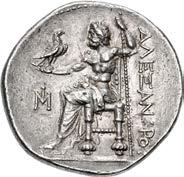
From the North River Collection. Ex Classical Numismatic Group 96 (14 May 2014), lot 382; Numismatica Ars Classica 59 (4 April 2011), lot 619.

230. IONIA, Magnesia ad Maeandrum. Circa 150-140 BC. AR Oktobol (20mm, 5.52 g, 12h). Euphemos, son of Pausianias, “magistrate”. Warrior, holding couched lance in right hand, on horse rearing right; d (mark of value) below / Bull butting left; ÂÅ˝@˙tW@ above, EUf˙Âo%/ ∏ÅU%Å@5oU in two lines in exergue; all within circular maeander pattern border. Kinns, Two 17 (O15/R5) = Naville XIII, lot 865 (same dies); Triton XXII, lot 249 (same dies); CNG E-431, lot 198 (same dies); otherwise unpublished. In NGC encapsulation 4933955-001, graded Ch AU, Strike: 5/5, Surface: 3/5. ($5000)
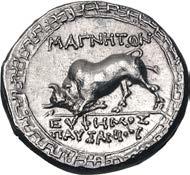

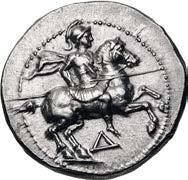

231. IONIA, Miletos. Circa 295/0-275/0 BC. AR Tetradrachm (30.5mm, 16.98 g, 12h). In the name and types of Alexander III of Macedon. Head of Herakles right, wearing lion skin / Zeus Aëtophoros seated left; I (civic monogram) in left field. Marcellesi 28; Price 2150. Toned, a little die wear, a couple of scrapes on reverse. Good VF. From dies of artistic workmanship. ($750)

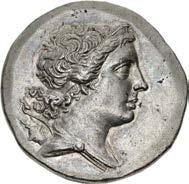

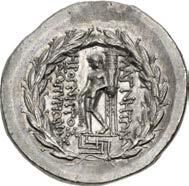


From the GTP Collection. Ex Chaponniere & Firmenich 11 (20 November 2019), lot 13; Tradart (18 November 1993), lot 64.
232. IONIA, Phokaia. Circa 625/0-522 BC. EL Hekte – Sixth Stater (10mm, 2.58 g). Head of eagle left; below, small seal left / Incuse square punch. Triton XVII, lot 306 = Nomos 7, lot 132 = CNG 91, lot 292 = Triton XV, lot 1228 (same obv. die); Triton XVI, 467; Nomos 3, lot 130 (same obv. die); Nomos 1, lot 105; otherwise unpublished in the standard references. Minor edge split, hairlines. EF. Well centered. Very rare. ($5000)
233. IONIA, Phokaia (or Teos). Circa 625/00 BC. EL Hekte – Sixth Stater (10mm, 2.76 g). Head of griffin right / Incuse square. Bodenstedt Em. E1; Matzke Series 0e2 (Teos?); SNG von Aulock 7775; cf. SNG Kayhan 1565 (myshemihekte); de Luynes 2662; Traité I 170. Minor die wear. Good VF. Well centered. Very rare. ($1000)












234. IONIA, Phokaia. Circa 625/0-522 BC. EL Hekte – Sixth Stater (10mm, 2.55 g). Head of griffin left; to right, small seal upward / Quadripartite incuse square. Bodenstedt Em. 22.1; SNG von Aulock –; BMC –; Boston MFA –; Jameson 1510; Weber 6072 = Bement 1470. Lightly toned. EF. Bold strike. Very rare. ($2000)
From the JTB Collection. Ex Heritage 3061 (7 January 2018), lot 29187.
235. IONIA, Phokaia. Circa 625/0-522 BC. EL Hekte – Sixth Stater (9.5mm, 2.59 g). Head of African left, wearing necklace; to right, seal downward / Rough incuse square. Bodenstedt Em. 24; otherwise unpublished in the standard references. A couple of minor flan flaws. Near EF. Very rare. ($1500)
236. IONIA, Phokaia. Circa 521-478 BC. EL Hekte – Sixth Stater (10mm, 2.62 g). Three seals swimming counterclockwise around central pellet-in-annulet; all on convex field with dotted border / Incuse square. Bodenstedt Em. 29 var. (central pellet without annulet, field not convex); CNG 114, lot 296; CNG E-419, lot 181; Lanz 164, lot 76 = Roma E-30, lot 128; Roma X, lot 404. Light scrape and scratch on obverse, small scuff on reverse. Good VF. Very rare variety. ($2000)




In addition to the differences noted above, the style of the seals here appear more rudimentary/archaic than what is found examples of Bodenstedt’s emission 29.

237. IONIA, Phokaia. Circa 521-478 BC. EL Hekte – Sixth Stater. Head of warrior left, wearing Corinthian helmet decorated with vine tendril on the bowl; below, seal left / Quadripartite incuse square. Bodenstedt Em. 50; otherwise, unpublished in the standard references. EF. Very rare. ($1000)
238. IONIA, Phokaia. Circa 478-387 BC. EL Hekte – Sixth Stater (10mm, 2.53 g). Head of Io left; below, small seal left / Quadripartite incuse square. Bodenstedt Em. 96; SNG von Aulock –; BMC 57; Bement 1476; Boston MFA 1918; Gulbenkian 930; Weber 6081. Lightly toned, minor die rust on obverse. Good VF. ($2000)

239. IONIA, Smyrna. Circa 150-143 BC. AR Tetradrachm (32.5mm, 16.02 g, 12h). Stephanophoric type. Zopy(ros?), magistrate. Turreted head of Tyche right / z;Ur/@Å5W@ and Ù within laurel wreath. Milne, Silver, First Series, 4, obv. die H; Milne, Autonomous 157; SNG von Aulock –; SNG Copenhagen –; Bement 1480; de Luynes 2286; Jameson 1514; Weber 6117 (same obv. die). A hint of porosity, minor die break in field on reverse. Near EF. Well centered. ($3000)
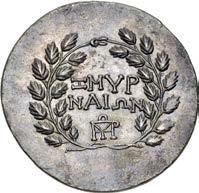

From the Pythagoras Collection. Ex Classical Numismatic Group 72 (14 June 2006), lot 747.
240. IONIA, Smyrna. Circa 150-143 BC. AR Tetradrachm (33mm, 16.48 g, 1h). Stephanophoric type. Metrodoros, magistrate. Turreted head of Tyche right / z;Ur/@Å5W@ and H within laurel wreath. Milne, Silver, First Series, 5c, obv. die G (die unlisted for 5c); Milne, Autonomous 165b; SNG von Aulock 2162; SNG Kayhan 592. Area of light porosity at edge, light marks, tiny edge scuff. EF. ($3000)
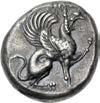

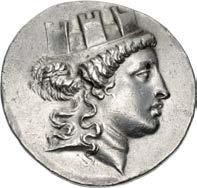


241. IONIA, Smyrna. Circa 150-143 BC. AR Tetradrachm (33mm, 16.29 g, 12h). Stephanophoric type. Metrodoros, magistrate. Turreted head of Tyche right / z;Ur/@Å5W@ and H within laurel wreath. Milne, Silver, First Series, 5c, unlisted obv. die; Milne, Autonomous 165c; SNG Copenhagen –; SNG Kayhan 592. Deep iridescent tone, light porosity. EF. ($3000)

From the North River Collection. Ex Classical Numismatic Group 97 (17 September 2014), lot 201.
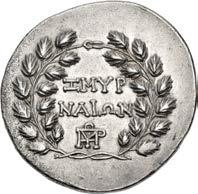

239 240 242 243
242. IONIA, Teos. Late 6th-early 5th century BC. AR Hemistater – Drachm (15.5mm, 5.92 g). Griffin seated right, raising forepaw / Incuse square. Matzke Group Bb1 (same dies as illustration); Balcer Group XX, 40 (A40/P62); Dewing 2313 (same dies). Granular surfaces. EF. ($1500)

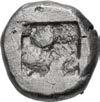
243. IONIA, Teos. Late 6th-early 5th century BC. AR Hemistater – Drachm (15.5mm, 5.89 g). Griffin seated right, raising forepaw / Incuse square. Matzke Group Bc2; Balcer Group XX, 43 (A43/P65); SNG Copenhagen 1433; BMC 1 (same dies). Iridescent tone, slight doubling on obverse. Near EF. Well centered. ($1500)
Ex Leu 61 (17 May 1995), lot 145.
244. IONIA, Uncertain. Circa 650-600 BC. EL Trite – Third Stater (12.5mm, 4.77 g). Lydo-Milesian standard. Plain globular surface / Two incuse squares. Cf. Weidauer Group II (unlisted denomination); Artemision –; Elektron I 3; Rosen –; Traité I 11; SNG Kayhan 673; SNG von Aulock 7762; Boston MFA –. Light scratches. As made. ($2000)
From the Locksmith Collection.

245. IONIA, Uncertain. Circa 650-600 BC. EL Trite – Third Stater (13.5mm, 4.67 g). Lydo-Milesian standard. Plain globular surface; traces of letters of an uncertain script along part of edge / Two incuse rectangles with geometric patterns. Cf. Weidauer Group II (unlisted denomination, plain incuses); Artemision –; cf. Elektron I 3 (plain incuses); Traité I 11 var. (same); SNG Kayhan 673 var. (same); SNG von Aulock 7762 var. (same); Rosen –. As made. Very rare with geometric patterns in incuses. ($2000)

Ex Numismatik Naumann 97 (6 December 2020), lot 134.
This trite may be related to the recently-discovered plain trites that have an inscription along part of the edge of their obverses (see following two lots). All of the known examples of the inscribed coins have incuses with an abstract geometric pattern, as here.






246. IONIA, Uncertain. Circa 650-600 BC. EL Hekte – Sixth Stater (9.5mm, 2.32 g). Lydo-Milesian standard. Plain globular surface; ÂÁËÈÍ (letters of an unknown script) along part of edge / Incuse rectangle with geometric pattern. Triton XXIII, lot 387; CNG 115, lot 231; CNG 114, lot 323; CNG 112, lot 264; Heritage 3054, lot 30097; Heritage 3020, lot 24985 (all from the same dies); otherwise unpublished. Trace deposits. As made. Very rare. ($3000)
From the Locksmith Collection.
This coin is from part of a recently discovered issue of inscribed hektai with a plain obverse and rectangular incuse on the reverse, the first of which was noted in a private British collection in 2011. The prior analysis of these coins has associated the issue with the ubiquitous plain obverse hektai of Ionia, suggesting that this inscribed version was perhaps a late issue in the production of that coinage, with struck dates suggested in the 660s and 640s BC. Admittedly, the form of this issue, and its metrology, do comport with the uninscribed plain incuse issues of that period. However, the peculiar reverse punch of this issue should not be overlooked. With regard to the complex varieties of early electrum, associations and relative chronologies are often established through reverse die linkages or similarities of idiosyncratic punch forms.


The rectangular punch used for this issue bears little resemblance to the two small punches used on the uninscribed plain hektai of the mid 7th century. The use of two small square punches, in fact, appears to have been a canonical aspect of not only the plain hektai, but also the ubiquitous striated electrum issues also dated to the 7th century, and even the contemporary royal Lydian hektai that circulated throughout the region. These small punches were also plain in appearance, devoid of any designs. These aspects suggest that the inscribed plain hektai are not closely associated to the uninscribed plain issues. Moreover, a small group of these inscribed coins was presented to a researcher, which was accompanied by a known Carian issue that dated to the early 5th century BC. The researcher noted the surfaces and fabric of the issues appeared highly consistent, suggesting they were part of a single hoard. This, in turn, suggested that these electrum coins were struck later than the 7th century, possibly as late as the end of the 6th century.
Turning to the inscription, elements of the letters appear similar to a number of glyphs in the various alphabets that were used along the coast of western Asia Minor. However, as a whole, the letters most closely resemble those found in the Carian alphabet (see Tables I and II in I.J. Adiego, The Carian Language [Brill: Leiden, 2007]), though the exact interpretation of legend remains uncertain. Before the discovery of the CNG 112, lot 263 coin, only the first three letters were visible. That said, the inscription may actually be even longer, as its visibility on the coins is hampered by the low relief of the letters and their position on the edge of the die.
247. IONIA, Uncertain. Circa 650-600 BC. EL Hekte – Sixth Stater (10mm, 2.39 g). Lydo-Milesian standard. Plain globular surface; traces of ÂÁËÈÍ (letters of an unknown script) along part of edge / Incuse rectangle with geometric pattern. Triton XXIII, lot 387; CNG 115, lot 231; CNG 114, lot 323; CNG 112, lot 263–4; Heritage 3054, lot 30097; Heritage 3020, lot 24985; otherwise unpublished. Trace deposits, light marks/scratches. As made. Very rare. ($3000)
From the Locksmith Collection.
248. IONIA, Uncertain. Circa 650-600 BC. EL Hekte – Sixth Stater (10mm, 2.38 g). Lydo-Milesian standard. Flattened striated surface / Two incuse squares. Weidauer Group II, 6; Artemision 29; Elektron II 11-2; Traité I 12; SNG von Aulock 1769; SNG Kayhan 680; Boston MFA 1751. As made. ($5000)
From the JTB Collection.
249. IONIA, Uncertain. Circa 625-600 BC. EL Trite – Third Stater (10.5mm, 4.62 g). Lydo-Milesian standard. Geometric figure resembling a star, composed of a cross centered upon a polygon of eight sides / Rectangular incuse divided horizontally and vertically into four compartments by two perpendicular lines; the upper two compartments divided into halves by a single line, the upper halves each containing a pellet, the lower halves bisected by two small vertical lines; the lower two compartments divided into thirds by two parallel lines. McFadden 1; Weidauer –; Elektron I 16; Traité –; SNG von Aulock –; SNG Kayhan 697; SNG von Aulock –; SNG Copenhagen (Cyprus, etc.), pl. 10, 318; Rosen Sale 12; Zhuyuetang 2; Konuk & Lorber fig. 14. Lightly toned, minor flan flaws on obverse and edge. Good VF. Rare. ($3000)



250. IONIA, Uncertain. Circa 625-600 BC. EL Hekte – Sixth Stater (9.5mm, 2.35 g). Lydo-Milesian standard. Geometric figure resembling a star, composed of a cross centered upon a polygon of eight sides within a square with slightly rounded sides / Rectangular incuse divided horizontally and vertically into four compartments by two perpendicular lines; the upper two compartments divided into halves by a single line, the upper halves each containing a pellet, the lower halves bisected by two small vertical lines; the lower two compartments divided into thirds by two parallel lines. McFadden 2; Weidauer –; Traité I 5; SNG von Aulock –; SNG Kayhan 698; Boston MFA –; Rosen –; Elektron –; Zhuyuetang 3 (all from same die and punch). Toned. Near EF. ($2000)
From the JTB Collection. Ex Dr. Lawrence A. Adams Collection (Part I, Classical Numismatic Group 100, 7 October 2015), lot 19; CNG Inventory 704650 (December 1997).
251. IONIA, Uncertain. Circa 600-550 BC. EL Trite – Third Stater (12mm, 4.69 g). Lydo-Milesian standard. Carapace of scarab beetle / Two incuse squares with geometric designs. Weidauer –; SNG Kayhan 673; Konuk & Lorber 36 = Linzalone 1110 (“ram”). Minor marks. EF. Rare. ($1500)










252. IONIA, Uncertain. Mid 6th century BC. EL Trite – Third Stater (13mm, 4.74 g). Lydo-Milesian standard. Head of roaring lion left, with protruding tongue, and head of bull right, inverted and conjoined at the neck / Two incuse squares, each subdivided into four squares containing pellets and lines. Unpublished, but cf. J. Hammer, “Der Feingehalt der griechischen und römischen Münzen” in ZfN 26 (1908), p. 25, 57, for a trite with a different obverse type, but likely struck from the same reverse die (at an earlier die state). Minor scrapes and marks, minor double strike on reverse. Good VF. Unique. ($20,000)
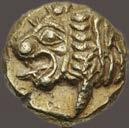


This fascinating early electrum piece has a style that links it to a series of staters found in the 1998 Klazomenai hoard. The hoard was the subject of a detailed study by E. Işik (Elektronstatere aus Klazomenai. Der Schatzfund von 1989 [Saarbrücken, 1992]), but the coins were subsequently condemned by S. Hurter in her review of the study in SNR 72 (1993). Hurter’s conclusion was that the coins were pressed forgeries, and she also connected these coins with another condemned stater that was published in the Bulletin on Counterfeits 17/2 (1993), p. 12, 2b. J. Spier, in his subsequent review of Işik in NC 154 (1994), followed Hurter in this condemnation. Recent research, to be presented in the near future, however, has rehabilitated some of these coins. In particular, two trites (third staters), in the Berlin and Vienna cabinets, that are connected to these issues are undoubtedly genuine, and the obverse of the Berlin example (cited above, from the 1873 Fox bequest [https://ikmk.smb.museum/ object?lang=de&id=18200101]) is struck from the same obverse die used on one of the condemned Klazomenai staters. As the Fox trite in Berlin is also likely from the same reverse as the present coin, the authenticity of the present piece is not in question. Additionally, the surface of this piece has all the typical striking characteristics, minor die flaws and wear, enriched surface metal, and light irregular granularity on the edge from crystallization that one would expect on a genuine ancient electrum coin from western Asia Minor. The types on this remarkable electrum trite appear to be rough derivatives of the Kroiseid coinage, which suggests a date in the mid 6th century BC for the issue.
We are grateful to Dr. Ute Wartenberg Kagan for her invaluable assistance in cataloging this lot.
253. IONIA, Uncertain. Circa 600-550 BC. EL Trite – Third Stater (12mm, 4.69 g). Lydo-Milesian standard. Facing head of lion or panther within triangular incuse [on a raised area] / Two square punches with raised lines within. Weidauer Group XXXII, 158-9; Traité I 28; Elektron I 19; SNG von Aulock –; cf. SNG Kayhan 711 (hekte); Boston MFA 1753; cf. Rosen 267 (hekte). Toned, underlying luster. EF. Very rare denomination, much rarer than the hekte and hemihekte. ($3000)
From the JTB Collection.
This trite is part of an electrum series consisting of staters, trites, hektes, hemihektes, and twenty-fourth staters (cf. Weidauer 156-65). Miletos and Samos have been proposed as the possible mint, though the former is now discounted by R. Hilbert’s die study of the electrum issues of that mint.

254. IONIA, Uncertain. Circa 600-550 BC. EL Hekte – Sixth Stater (10mm, 2.32 g). Lydo-Milesian standard. Head of roaring lion right; tiny pellet below / Incuse square with irregular lines within. Weidauer –; Traité I 48A = B.V. Head, “Electrum Coins and their Specific Gravity” in NC 1887, 16; Elektron –; SNG von Aulock –; SNG Kayhan 1546 corr. (pellet not noted; same obv. die); Boston MFA –; Rosen –. Light scratches. Good VF. Well centered. ($1500)








From the Locksmith Collection.
255. IONIA, Uncertain. Circa 600-550 BC. EL Hekte – Sixth Stater (9.5mm, 2.28 g). Lydo-Milesian standard. Head of creature (griffin or lion?) left / Two incuse squares. Weidauer –; Traité I –; Elektron –; Linzalone 1108 (seal); SNG von Aulock –; SNG Kayhan –; Boston MFA –; Rosen –; cf. CNG E-428, lot 180. Good VF. ($1500)
Purchased by the consignor from Brian Kritt, 13 January 2017 (his inventory ticket included).
256. IONIA, Uncertain. Circa 600-550 BC. EL Trite – Third Stater (11mm, 4.71 g). Lydo-Milesian standard. Winged bearded male figure (daimon) advancing left, head right / Two square punches, both with raised lines within. Weidauer Group XL, 177; CNG 85, lot 435 (both from the same die and punches). VF. Extremely rare, one of three known trites of this type. ($1500)
From the North River Collection. Ex Triton XIV (4 January 2011), lot 305. This trite is part of a series also known from staters (Rosen 246), hemistaters (Weidauer 175-6 and Triton VIII, lot 451), and hektai (Rosen 263).
257. IONIA, Uncertain. Circa 600-550 BC. EL Hekte – Sixth Stater (10mm, 2.73 g). Phokaic standard. Scorpion / Incuse square. A. Tsintsifos, Perix Pangaion Epeiros, The dawn of coinage, Part I, p. 161, 1 (Northern Greece); cf. Traité I 113 = BMC p. 12, 57 (forty-eighth stater); cf. Triton XXI, lot 488 (hemihekte); otherwise, unpublished. Slight graze on obverse. EF. Extremely rare, only three in CoinArchives. ($5000)
258. IONIA, Uncertain. Circa 600-550 BC. EL Hemihekte – Twelfth Stater (8.5mm, 1.36 g). Phokaic standard. Head of boar left / Incuse square. Weidauer –; Traité I 166; Elektron –; SNG von Aulock –; cf. SNG Kayhan 719 (myshemihekte); Boston MFA –; cf. Rosen 316 (heke); Vismara, Monetazione 79. Scratch on obverse. VF. Rare. ($750)
259. IONIA, Uncertain. Circa 600-550 BC. EL Myshemihekte – Twenty-fourth stater (7mm, 0.65 g). Phokaic standard. Bull standing right, head left / Incuse square. Weidauer –; Traité I –; Elektron –; SNG von Aulock 7794; SNG Kayhan –; Boston MFA 1793; Rosen 327. Good VF. Well centered. Very rare. ($1000)

260. ISLANDS off IONIA, Chios. Circa 435-425 BC. AR Stater (18mm, 7.82 g). Sphinx seated left; to left, grape bunch above amphora; all set on circular convex field / Quadripartite incuse square with deep rough quarters. Mavrogordato 24; HGC 6, 1121; SNG Kayhan 618; SNG Lockett 2858; McClean 8361; Pozzi 2531. Attractive old cabinet tone, light graffito under tone on obverse, some marks around edge. VF. ($500) Ex Münzen und Medaillen GmbH 8 (10 May 2001), lot 181.


261. LYDIA, Tralleis. Circa 166-67 BC. AR Tetradrachm (26.5mm, 12.53 g, 12h). Cistophoric standard. Cista mystica with serpent; all within ivy wreath / Two serpents entwined around bow and bowcase; star above, trŬ (civic monogram) to left; to right, radiate head of Helios right; M below. Kleiner & Noe Series 39 var. (monogram), obv. die 70; Kurth –; SNG Copenhagen –; SNG von Aulock 3257 var. (same; same obv. die); SNG Fitzwilliam 4900 var. (same; same obv. die); BMC 26 var. (same). Toned, slightly off center on reverse. EF. Well struck. Very rare variety. ($750)








From the GTP Collection. Ex Melchione Collection (Nomos FPL, Winter/Spring 2013), no. 42; Freeman & Sear 2 (31 January 1996), lot 426.

262. KINGS of LYDIA. temp. Alyattes – Kroisos. Circa 620/10-550/39 BC. EL Trite – Third Stater (15.5mm, 4.73 g). Lydo-Milesian standard. Sardes mint. Head of roaring lion right, “sun” with multiple rays on forehead / Two incuse squares. Weidauer Group XVI, 89; Kurth G26; SNG Ashmolean 749–51; SNG Kayhan 1013; Boston MFA 1765–6; Traité I 44. Edge split, light marks. Good VF. Well centered on a broad flan. ($2000)



263. KINGS of LYDIA. temp. Alyattes – Kroisos. Circa 620/10-550/39 BC. EL Trite – Third Stater (12mm, 4.71 g). Lydo-Milesian standard. Sardes mint. Head of roaring lion right, “sun” with multiple rays on forehead / Two incuse squares. Weidauer Group XVI, 89; Kurth G26; SNG Ashmolean 749–51; SNG Kayhan 1013; Boston MFA 1765–6; Traité I 44. Light marks, minor roughness. Good VF. Well centered. ($2000)
264. KINGS of LYDIA. temp. Alyattes – Kroisos. Circa 620/10-550/39 BC. EL Hemihekte – Twelfth Stater (7.5mm, 1.17 g). Lydo-Milesian standard. Sardes mint. Head of roaring lion right, “sun” with no rays on forehead / Incuse square. Weidauer Group XVI, 90; Kurth G29–30; SNG Ashmolean 757; SNG Kayhan 1731; Boston MFA 1770; Traité I 47. Lightly toned, small edge split, some roughness and marks. VF. Well centered. ($500)


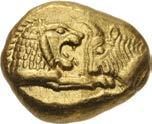






265. KINGS of LYDIA. Kroisos. Circa 564/53-550/39 BC. AV Stater (16mm, 8.10 g). Light standard. Sardes mint. Confronted foreparts of lion and bull / Two incuse squares. Berk 3; Kurth G51; Le Rider, Naissance, pl. V, 8; Traité I 401–3; SNG von Aulock 2875; BMC 31; Boston MFA 2073; Gulbenkian 757. Underlying luster, a hint of die wear. Near EF. Well centered. ($15,000)
266. KINGS of LYDIA. Kroisos. Circa 564/53-550/39 BC. AV Third Stater (10.5mm, 2.68 g). Light standard. Sardes mint. Confronted foreparts of lion and bull / Two incuse squares. Walburg Group II; Berk 6; Kurth G52; Traité I 404–5; SNG von Aulock 8212; BMC 36; Boston MFA 2074; de Luynes 2779. Small scuff on obverse. Good VF. ($7500) Ex J. de Wilde Collection; Late Belgian Collector (Bru Sale & Wellico 1, 21 November 2012), lot 40, purchased from Tradart, 1980s.
267. KINGS of LYDIA. Kroisos. Circa 564/53-550/39 BC. AV Twelfth Stater (6mm, 0.67 g). Light standard. Sardes mint. Confronted foreparts of lion and bull / Incuse square. Walburg Group VI; Berk 10–3; Kurth G56; Traité –; SNG von Aulock –; SNG München 9; BMC –; Boston MFA –; Gulbenkian 759. Slight weakness to strike, tiny nick at edge on obverse. VF. ($1000)

268. KINGS of LYDIA. Kroisos. Circa 564/53-550/39 BC. AR Stater (19.5mm, 10.71 g). Sardes mint. Confronted foreparts of lion and bull / Two incuse squares. Berk 20; Kurth S1; Traité I 407–8; SNG Ashmolean 760; SNG von Aulock 2873–4; SNG Lockett 2980 = Pozzi 2730; SNG Lockett 2981 = Bement 1566 = Weber 6773; BMC 37; Boston MFA 2070; Rosen 662. Minor pit on obverse. Good VF. Well centered, and excellent metal for issue. ($2000)






269. KINGS of LYDIA. Kroisos. Circa 564/53-550/39 BC. AR Stater (20.5mm, 10.59 g). Sardes mint. Confronted foreparts of lion and bull / Two incuse squares. Berk 20; Kurth S1; Traité I 407–8; SNG Ashmolean 760; SNG von Aulock 2873–4; SNG Lockett 2980 = Pozzi 2730; SNG Lockett 2981 = Bement 1566 = Weber 6773; BMC 37; Boston MFA 2070; Rosen 662. Lightly toned, usual light granularity, slight doubling. Good VF. ($1500)


270. KINGS of LYDIA. Kroisos. Circa 564/53-550/39 BC. AR Hemistater (17.5mm, 5.20 g). Sardes mint. Confronted foreparts of lion and bull / Two incuse squares. Berk 23; Kurth S3; Traité –; SNG Ashmolean –; SNG Kayhan 1024–6; Boston MFA –; Rosen 665. Typical granularity. Good VF. Well centered on a broad flan. ($750)
269 270 271 272
271. KINGS of LYDIA. Kroisos. Circa 564/53-550/39 BC. AR Third Stater (14mm, 3.55 g). Sardes mint. Confronted foreparts of lion and bull / Two incuse squares. Berk 24; Traité I 412; Kurth S5; Boston MFA 2071 = Regling 1291; Rosen 666. Typical granularity. Good VF. Well centered on a broad flan. ($500)
272. KINGS of LYDIA. temp. Cyrus – Darios I. Circa 550/39-520 BC. AR Siglos (16mm, 5.31 g). Sardes mint. Confronted foreparts of lion and bull / Two incuse square punches. Berk 22; Kurth S11; SNG Ashmolean 762–71; SNG von Aulock 2877-9; Traité I 411, pl. X, 11; SNG Kayhan 1025. Toned, some of the typical granularity. Good VF. ($1000)

Ex Classical Numismatic Group Electronic Auction 205 (25 February 2009), lot 186.
273. CARIA, Alabanda. Circa 167/6 BC. AR Tetradrachm (32.5mm, 16.59 g, 12h). Dated CY 1. Head of Apollo right, wearing laurel wreath / Pegasos alighting right; ŬÅ∫-Å@dEW@ above, & (date) below. Meadows, Alabanda, Series 4, 14b (A4/P13 – this coin); Waggoner, New, Series 4; HNO 451; DCA 361; SNG Keckman 5; SNG von Aulock 8050; Karl 57. Lightly toned. Superb EF. Rare. ($7500)




From the North River Collection. Ex Semon Leper Collection (Triton XI, 8 January 2008), lot 262; G. Hirsch 183 (20 September 1994), lot 465.
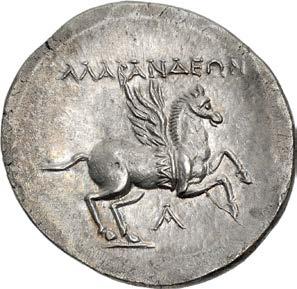
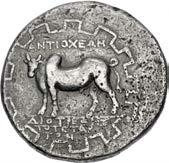

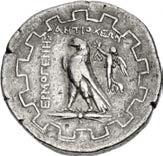

The Carian city of Antioch, located near the eastern end of the Maeander valley, was founded on the south bank of the river Maeander, where the river is joined by a major tributary, the Morsynos River, flowing north from Aphrodisias. It was a Hellenistic settlement that was founded by Antiochos I Soter (though some argument has been advanced in favor of Antiochos III), and likely through a synoecism of two villages, Symmaithos and Kranaos (Pliny, NH 5.108). The location was a significant crossing point of the Common Road over the Maeander, between the important cities of Tralles, to the west, and Laodikeia on the Lykon, to the east. Given its important location, surprisingly little is known today about Antioch in the Hellenistic period; there is little mention of the city in contemporary literature and epigraphy, and the site remains unexcavated. In contrast, the city took on a much more important role in the Roman period, when it was fortified, and figured significantly in many emperors’ eastern campaigns.
Its strategic location along a major trade route certainly must have enriched the city, which grew to a considerable size by the first century AD, spanning both sides of the Maeander (cf. Strabo 13.4.15). While the Roman provincial coinage at Antioch is quite sizable, the Hellenistic civic coinage is quite rare. All the civic issues date from the 2nd-1st centuries BC, and primarily consists of bronze coins, with very rare issues of silver tetradrachms and drachms. The types are fairly consistent across all denominations, with the obverse featuring the portrait of either Zeus, Apollo, Dionysos, or Artemis, while the reverse featuring a zebu bull or an eagle standing on a thunderbolt. Interestingly, some of the coins bear the name of a magistrate, while others do not.
The silver has traditionally been dated to the 2nd century BC, and may have begun with a couple of rare issues of Alexander type tetradrachms that M.J. Price (following H. Seyrig) tentatively placed there, circa 190-180 BC, but it is more likely that these Alexanders are actually issues of Tabai (cf. Price p. 311 and Thonemann p. 52). No Seleukid issues are currently attributed to Antioch, but there are many western issues that are unattributed from the reigns of Antiochos I through Antiochos III, so it is possible that some of these issues may actually belong to this city. Thonemann’s recent study of the city’s Hellenistic silver coinage convincingly places it in the early-mid 1st century BC. He notes that Antioch was one of many cities in their region that began striking silver around the same time, and some of those cities struck dated issues that firmly places them in this period. It also seems likely to him that all of these silver issues were struck in relation to the Mithradatic Wars; that their production was not for purely civic needs, that the silver was struck for the benefit of a more powerful entity, which was likely the Roman forces that were in the region to counter the Pontic threat. In fact, the weight standard of the Antioch silver, with a drachm at c. 3.903.96 grams, is compatible with the contemporary Roman denarius. Thonemann also notes that it is possible that Antioch may have received the status of a civitas libera from Sulla for services the city performed for Rome in the early 80s BC. In any case, the silver coinage of Antioch appears to Thonemann to be a “surrogate” Roman coinage, struck for military purposes. Unfortunately, there is still too little evidence to firmly anchor the dating of the coinage to any particular event(s), though it is clear that the coinage probably endured until the end of the Mithradatic Wars in 63 BC, if not shortly thereafter.

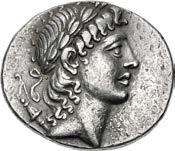


274 275
274. CARIA, Antioch ad Maeandrum. Early-Mid 1st century BC. AR Tetradrachm (29mm, 16.17 g, 1h). Diotrephes, magistrate. Head of Apollo right, wearing laurel wreath; bow and quiver over shoulder / Zebu bull standing left, head facing; Å@tocEW@ above, maeander pattern and d5otrEf˙% in exergue. Thonemann Group A, 1, a–h var. (unlisted dies); HN Online 1528. Scattered marks and scratches. VF. Rare. ($2000)
275. CARIA, Antioch ad Maeandrum. Early-Mid 1st century BC. AR Tetradrachm (27.5mm, 16.17 g, 12h). Diotrephes, magistrate. Head of Apollo right, wearing laurel wreath; bow and quiver over shoulder / Zebu bull standing left, head facing; Å@tocEW@ above, d5otrEf˙%/ to tEtÅr/ to@ in exergue; all within circular maeander pattern. Thonemann Group A, 3, a var. (O5/R– [unlisted rev. die]); HN Online 2314. Lightly toned, pitting, scattered marks and scratches. Near VF. Very rare. ($1000)
276. CARIA, Antioch ad Maeandrum. Early-Mid 1st century BC. AR Tetradrachm (27mm, 16.03 g, 12h). Hermogenes, magistrate. Type 2. Bearded head of Zeus right, wearing laurel wreath / Eagle, with closed wings, standing left on thunderbolt; Å@t5ocEW@ above, ErÂo˝E@˙% to left; to right, Nike flying left, crowning eagle with wreath held in her extended right hand; all within circular maeander pattern. Thonemann Group B, 10, b–d var. (O11/R– [unlisted rev. die]); HN Online 2070. Lightly toned, minor cleaning scratches, traces of find patina on obverse. VF. Rare. ($2000)
277. CARIA, Antioch ad Maeandrum. Early-Mid 1st century BC. AR Tetradrachm (26.5mm, 16.05 g, 1h). Kalas, magistrate. Bearded head of Zeus right, wearing laurel wreath / Eagle, with closed wings, standing left; [&]@t5ocEW@ above, winged kerykeion to left, ˚&¬&% to right; all within circular maeander pattern. Thonemann Group B, 12, a (O13/R26); HN Online 1531. Scattered light marks, cleaning scratches, graffiti on reverse. VF. Very rare. ($2000)



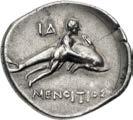

278. CARIA, Antioch ad Maeandrum. Early-Mid 1st century BC. AR Tetradrachm (29mm, 16.05 g, 12h). Adrastos, son of Pytheos, magistrate. Head of Dionysos right, wearing ivy wreath / Zebu bull standing left, head facing; Å@t5ocEW@ above; to left, turreted head of Tyche left; ÅdrÅ%to%/ ∏UQEoU in two lines in exergue; all within circular maeander pattern. Thonemann Group C, 16, a (O17/R31); HN Online 2078. Lightly toned, porosity, scattered marks and scratches. VF. Very rare. ($1500)


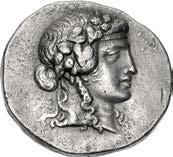




279. CARIA, Antioch ad Maeandrum. Early-Mid 1st century BC. AR Tetradrachm (29mm, 16.03 g, 12h). Eunikos, magistrate. Bearded head of Zeus right, wearing laurel wreath / Zebu bull standing left, head facing; to left, small female figure, wearing long chiton, standing right; Å@t5ocEW@/tW@ ∏ro% tW in two lines above, ÂÅ5Å@drW in exergue, E¨@5˚o% to right; all within laurel wreath. Thonemann Group C, 17, a–d (O18/R32); HN Online 2069 var. (position of legend). Lightly toned, slightly off center, edge chip, minor pitting, light marks, a few scratches on obverse. VF. Rare. ($2000)

280.
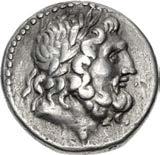
282. CARIA, Idyma. Late 5th-early 4th centuries BC. AR Drachm (12.5mm, 3.62 g, 12h). Chian standard. Head of Pan facing / Fig leaf; 5-d-UÂ-5-o-[@] around; all within incuse square. Hecatomnus 2–4 var. (A2/P– [unlisted rev. die]); HN Online 74; SNG Copenhagen 419; SNG Keckman 60; SNG von Aulock 2560 (same obv. die); BMC 2 (same obv. die). Lightly toned, some roughness on obverse, slightly off center on reverse. VF. Rare. ($1000)


From the DFA Collection. Ex Trausnitz Collection (Nomos Obolos 18, 21 February 2021), lot 310; Künker 46 (9 March 1999), lot 114.
283. CARIA, Knidos. Circa 490-465 BC. AR Drachm (18mm, 6.23 g, 9h). Forepart of lion right / Head of Aphrodite right within incuse square. Cahn Series III, 64.2 (V31/R48 – this coin, rev. illustrated enlarged on pl. 15); HN Online 301; SNG Ashmolean 66 = Pozzi 2584 (same obv. die); SNG Copenhagen 217 (same dies); BM inv. 1914.0709.13 (same dies). Old cabinet tone, minor die wear on obverse, light cleaning scratches under tone on reverse. Good VF. Fine style. ($2000)

Ex Münzen & Medaillen GmbH 38 (5 June 2013), lot 46; Münzhandlung Basel 4 (1 October 1935), lot 824.






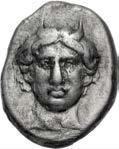
284. CARIA, Mylasa. Circa 250-200 BC. AR Tetradrachm (27mm, 13.00 g, 12h). Rhodian standard. Iatrokles, magistrate. Zeus Labraundos standing right, wearing chiton and himation, holding labrys in right hand, left hand on staff set on ground / Zeus Osogoa standing right, wearing chiton and himation, holding eagle in right hand, left hand holding trident; µU¬ÅsEW@ to left, 5Åto˚¬˙s to right. Delrieux Group B, 3 (D3/R3 – this coin, illustrated); Akarca –; HN Online 1723 var. (additional letters on rev.). Lightly toned, deposits, roughness, scratches. VF. Extremely rare; the only example published of this issue. ($1000)
From the Pythagoras Collection. Ex Münzen und Medaillen AG FPL 565 (May 1993), no. 42.
According to the first century BC Greek geographer Strabo (Geography 14. 2. 23), the Mylasians had three temples of Zeus in their city. In addition to the temples of Zeus Labraundos and Zeus Karios, a third was dedicated to Zeus Osogoa, an indigenous Carian god. The temple complex dedicated to him in Mylasa was of such a size and style that Pausanias (8.10.3) equated it with the Athenian Acropolis. The cult statue depicted here first appeared on very rare tetradrachms of Maussolos struck at Mylasa, circa 377 BC. It also appears later on cistophori of Hadrian, as well as Roman provincial bronze issues of Mylasa. For a further discussion of this god, see A. Laumonier, Les cultes indigènes en Carie (Paris, 1958), pp. 45-126.
285. CARIA or LYCIA, Uncertain. Circa 525/0 BC. AR Stater (17mm, 10.75 g). Aeginetic standard. Archaic head of female left / Two incuse squares of unequal size. J.-A. Chevillon & R. Fournials, “Asie Mineure de Sud-Ouest: un statère inédit à la tortue avec un double carré creux” in NK 30 (2012), fig. 5 (Lycia) = K.A. Sheedy, “The Dolphins, The Crab, The Sphinx and ‘Aphrodite’” in Studies Price, 8 (Caria or Lycia) = ACGC 90 (Uncertain Caria) = BMC Caria, Knidos 1 (Knidos in Caria). Toned, some granularity. VF. The second known of this stater type, the other in the British Museum. ($3000)
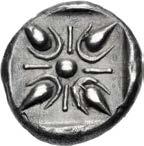

This intriguing archaic stater has traditionally been viewed as part of a group of early silver issues struck with similar incuses, featuring two squares of significantly different size. The majority of these issues were struck on the Aeginetan standard, which Kraay (in ACGC) thought had been adopted through trade between Aegina and communities along the Carian coast and nearby islands. It was believed that the Aeginetan traders introduced silver coinage to this region, which supports the suggestion that these issues were among the first silver coins produced there. While the present issue is undoubtedly linked to the others with this unusual incuse type, the 9.92 gram weight of the only specimen that had been known until recently, the BM piece, was significantly lower than those of the other coins, all of which were between 11.97 and 12.50 grams. While some authors suggested the lower weight was the result of wear, others suggested the coin may have been struck on a different standard, such as the Heavy Lycian standard (9.70-9.90 grams) or the Persian standard (where a double siglos would equal 10.70 grams). These alternative standards, combined with the knowledge that the early Lycian types often were derivative of imported coinage, suggests that this issue may have been among the earliest issues in Lycia. Recently, three other coins from this female head issue came to light; the present stater, a hemistater (Nomos 3, lot 136 = Gorny & Mosch 159, lot 187), and another stater with the obverse head facing right (Prospero 500). While the two staters, at 10.75 and 10.45 grams, respectively, are still a little light for the Aeginetan standard, the weight of the hemistater, at 5.79 grams, is quite close, which led to Chevillon & Fournials to conclude that they were struck on the Aeginetan standard, like the other issues. However, they think that the types, and the unusual incuse type, point to a Lycian, rather than Carian origin. It appears the question of the location of the mint shall remain open pending future coin finds, but it is unquestionable that these coins are among the earliest silver issues struck in southern Asia Minor.

286. SATRAPS of CARIA. Hekatomnos. Circa 392/1-377/6 BC. AR Tetradrachm (24mm, 14.82 g, 12h). Chian standard. Mylasa mint. Struck circa 380 BC. Zeus Labraundos standing right, wearing chiton and himation wrapped around the left arm, holding labrys in right hand, left hand on staff set on ground to right / Lion at bay right; EkÅtoµ@W above; all within incuse circle. Hecatomnus 1–77 var. (unlisted dies); Konuk, Identities 15; HN Online 223; SNG von Aulock 2354; SNG Kayhan 868–9; BMC 1; Karl 2–3; Traité II 82. Toned, some redeposited silver, scratches, areas of smoothing in field on reverse. Near EF. ($2000)

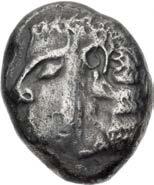


From the Pythagoras Collection.
287. SATRAPS of CARIA. Hekatomnos. Circa 392/1-377/6 BC. AR Tetrobol (15mm, 4.17 g). Milesian standard. Mylasa mint. Head and leg of roaring lion, the leg to right, head turned left; E˚Å above / Stellate pattern in incuse square. Konuk, Identities 11; HN Online 226; SNG Ashmolean 354–5; SNG von Aulock 2357; SNG Kayhan 862 and 1676–7; McClean 8515–6. Toned, minor die wear. Good VF. ($750)
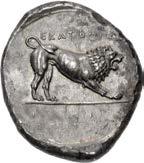


From the GTP Collection.
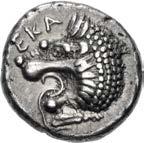
288. SATRAPS of CARIA. Pixodaros. Circa 341/0-336/5 BC. AV Sixth Daric (8.5mm, 1.37 g, 11h). Persian standard. Halikarnassos mint. Head of Apollo right, wearing laurel wreath / Zeus Labraundos standing right, wearing chiton and himation wrapped around the left arm; π5$odÅ to right. Konuk, Identities –; Babelon, Perses –; HN Online 56; SNG von Aulock 2372; SNG Kayhan 896; SNG von Aulock 2372; Bement 1522; Jameson 2594; Prospero 547. Slightly rough, scratches. VF. ($1500)




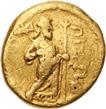
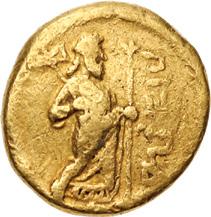
289. SATRAPS of CARIA. Pixodaros. Circa 341/0-336/5 BC. AV Sixth Daric (9mm, 1.36 g, 1h). Persian standard. Halikarnassos mint. Head of Apollo left, wearing laurel wreath / Zeus Labraundos standing right, wearing chiton and himation wrapped around the left arm; π5$Wd[Å] to right. Konuk, Identities –; Babelon, Perses –; HN Online 56; SNG von Aulock 2372; SNG Kayhan 896; SNG von Aulock 2372; Bement 1522; Jameson 2594; Prospero 547. Deposits, marks. Near VF. Rare. ($750)
From the S & S Collection. Lot includes a Joel L. Malter ticket marked lot 122.
290. SATRAPS of CARIA. Rhoontopates. Circa 336/5-333/2 BC. AR Tetradrachm (24.5mm, 15.15 g, 1h). Halikarnassos mint. Head of Apollo facing slightly right, wearing laurel wreath and drapery around neck / Zeus Labraundos standing right, wearing chiton and himation wrapped around the left arm; roo@toπÅtoU to right. Konuk, Identities 34; HN Online 49 (this coin illustrated). Lightly toned, hairlines on reverse, small die break on obverse. Near EF. Fine style. Extremely rare, fewer than ten examples known. ($5000)





From the Pythagoras Collection, purchased from Herb Kreindler (his inventory ticket included). Ex Classical Numismatic Group 42 (29 May 1997), lot 511; Berk BBS 94 (16 January 1997), lot 192; Berk BBS 91 (25 June 1996), lot 186; Berk BBS 88 (28 November 1995), lot 196.
Rhoontopates, a Persian noble, first appears in history during the reign of Philip II of Macedon. As Philip commenced his invasion of Asia, the satrap of Caria, Pixodaros, proposed an alliance to be sealed by the marriage of Pixodaros’ daughter with Philip’s son, Philip Arrhidaios. As negotiations progressed, Alexander learned of the plans and secretly sent the famous actor Thettalos to Pixodaros to tell him that Philip Arrhidaios was a half-wit and to offer Alexander himself as bridegroom. Alexander’s meddling ruined the negotiations, no alliance was made, and Caria remained an enemy to resist Alexander in his eventual march through Asia. Pixodaros thereupon married his daughter to Rhoontopates, who was the first Persian to marry into the ruling family of Caria. Philip, infuriated by Alexander’s meddling, punished his son. The episode shows Alexander’s immaturity, as he did not realize that Philip was prepared to sacrifice Philip Arrhidaios to a Carian marriage but would not have compromised his heir in such an alliance.
After the death of Pixodaros in 334 BC, Rhoontopates succeeded him, and as Alexander marched south he found himself opposed by the man who had married the woman to whom he had offered himself. With the assistance of Greek mercenaries, Rhoontopates led a spirited defense of the capital city of Halikarnassos, which fell to Alexander after fierce fighting that helped establish Alexander’s reputation for siege warfare. Rhoontopates continued to hold outlying areas of Caria for a further few months, but in 333/2 BC Alexander’s conquest of the province was completed.
291. ISLANDS off CARIA, Kos. Circa 625-600 BC. EL Myshemihekte – Twenty-fourth Stater (7mm, 0.71 g). Phokaic standard. Crab / Incuse square. Stefanaki Series I, unlisted denomination; HN Online –; cf. HGC 6, 1295 (1/96th stater); CNG 121, lot 422. Good VF. Well centered. Very rare in this denomination. ($1000)
292. ISLANDS off CARIA, Kos. Circa 280-250 BC. AR Tetradrachm (26.5mm, 15.21 g, 12h). Xanthippos, magistrate. Head of Herakles right, wearing lion skin / Crab; ˚-W5o-@ above; below, $Å@Q5ππos above bow-in-bowcase; all within dotted square. Requier Group III, 63 (D11/R53); Ingvaldsen Issue XIV, Type 1, 69 (O14/R56); Stefanaki Series VII, Issue 17, 870 (this coin, illustrated); HGC 6, 1308; Boston MFA Supp. 195 (same dies); Gulbenkian 1005 = Bement 1535 = Weber 6630; Karl 355 (same dies). Lightly toned, underlying luster. Near EF. ($5000)

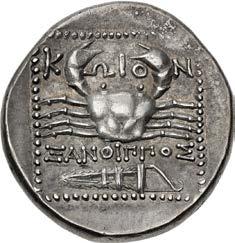
From the North River Collection. Ex Classical Numismatic Group 73 (13 September 2006), lot 372; Numismatica Ars Classica 29 (11 May 2005), lot 209.
293. ISLANDS off CARIA, Rhodos. Rhodes. Circa 229-205 BC. AR Tetradrachm (26mm, 13.58 g, 12h). Ameinias, magistrate. Radiate head of Helios facing slightly right / Rose with bud to right; rod5o@ above; to left, prow right; ÅÂE5@5Å% flanking stem. Ashton 212; HN Online 387; HGC 6, 1432; SNG Copenhagen 759; SNG Keckman 542; SNG von Aulock 2799. Usual softness in obverse strike. EF. Well centered on a broad flan. ($3000)
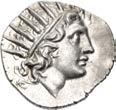




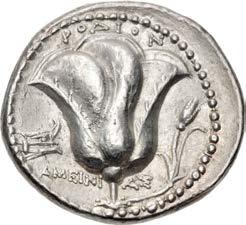

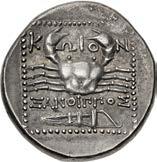


From the North River Collection. Ex David Herman Collection (Triton X, 9 January 2007), lot 364; Classical Numismatic Auctions IX (7 December 1989), lot 102.
294.
ISLANDS off CARIA, Rhodos. Rhodes. Circa 125-88 BC. AR Drachm (18.5mm, 2.97 g, 12h). Plinthophoric standard. Antaios, magistrate. Radiate head of Helios right / Rose with bud to left; Å@tÅ5os above, r-o across field, sun to lower right; all within incuse square. Jenkins, Rhodian, Group D, 128; HN Online 188; HGC 6, 1460; SNG Copenhagen 811 var. (symbol); SNG Keckman 664 var. (same); Karl 609; SNG von Aulock 2824 var. (same). Lightly toned over lustrous surfaces. Superb EF. ($1500)
From the North River Collection. Ex Triton XI (7 January 2008), lot 272.
295. DYNASTS of LYCIA. Uncertain dynast. Circa 500-470/60 BC. AR Stater (22mm, 9.23 g). Forepart of boar left / Incuse square, with semicircles on three sides, triangular device on the other. Müseler III, 1 var. (letters on shoulder); cf. Falghera 38; SNG Copenhagen Supp. –; SNG von Aulock –; SNG Ashmolean –; cf. SNG Keckman II 417; Rosen –; Traité –. Lightly toned, deposits, minor scratches, slightly off center on obverse. Near EF. ($750)


From the S & S Collection. Ex Dr. J. S. Wilkinson Collection (Malter 49, 15 November 1992), lot 656.
296. DYNASTS of LYCIA. Kherei. Circa 410-390 BC. AR Stater (24mm, 8.53 g, 3h). Head of Athena right, wearing crested Attic helmet decorated with three olive leaves, wing, and spiral palmette / Athena seated left on dolphin left, wearing crested Attic helmet and long chiton, holding spear in right hand, left hand extended and placed on shield to right, upon which stands an owl left, head facing; e f rg E (KhERẼI in Lycian) around. Mørkholm & Zahle II 36; Müseler VI, 5 (same dies); Falghera 166 (same dies); SNG von Aulock –; SNG Copenhagen Supp. –; Traité II 343, pl. XCIX = Waddington 2933 (same dies). Lightly toned, trace deposits, a few light scratches, double struck on obverse with worn die. Good VF. Very rare. ($4000)

297. DYNASTS of LYCIA. Kherei. Circa 410-390 BC. AR Stater (17.5mm, 8.30 g, 4h). Telmessos mint. Head of Athena right, wearing crested Attic helmet; [e]f ([K]H in Lycian) behind and on neck guard / Bearded head of Herakles right, wearing lion skin; efrg[E] (KhERẼI in Lycian) before, tf¬f∫fCE (TELEBEHE in Lycian) behind; all within incuse square. Mørkholm & Zahle II 53; Müseler VI 61–3; Falghera –; SNG von Aulock 4198 (same obv. die, but not noting letter on neck guard); SNG Copenhagen Supp. 451 (same obv. die). Toned, granular surfaces. Good VF. Rare. ($1000)
298. PAMPHYLIA, Side. Circa 205-100 BC. AR Tetradrachm (28mm, 16.95 g, 12h). Attic standard. Dei(no)-, magistrate. Head of Athena right, wearing crested Corinthian helmet / Nike advancing left, holding wreath in extended right hand; to left, pomegranate above dE5. Seyrig, Side 6; SNG BN 674-6; SNG von Aulock 4786 = Hunt II 560 (this coin). Lightly toned, minor marks. Near EF. ($1500)
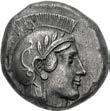



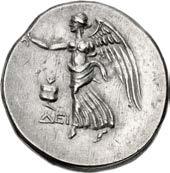
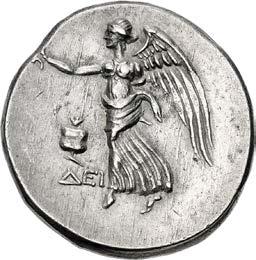

From the GTP Collection. Ex Numismatica Ars Classica 66 (17 October 2012), lot 66; Nelson Bunker Hunt Collection (Part II, Sotheby’s New York, 21 June 1990), lot 560; Hans von Aulock Collection.

299. CILICIA, Issos. Balakros. Satrap of Cilicia, 333-323 BC. AR Stater (27mm, 10.81 g, 9h). Baal of Tarsos seated left, holding lotus-tipped scepter in right hand; grain ear and grape bunch to left; ∫ to right, 5 below throne / Draped bust of Athena facing slightly left, wearing triple-crested Attic helmet, single-pendant earring, and pearl necklace. Casabonne Series 2, D12/R1; SNG BN 420 (same dies); SNG Levante –; SNG von Aulock –; SNG Hunterian –; BMC 67 (Tarsos). Toned, some minor porosity, cleaning scratches in obverse margin, scrape on reverse. EF. Overstruck on a stater of Tiribazos from Tarsos, with types Baal / Lion attacking bull (cf. Casabonne Group D; cf. SNG BN 332; cf. SNG Levante 105). ($1000)


From the GTP Collection. Ex CNG inventory 900449 (November 2011); Peus 401 (3 November 2010), lot 414; R. Sussmeyer Collection (Elsen 93, 15 September 2007), lot 316; Elsen 77 (13 December 2003), lot 145.
300. CILICIA, Kelenderis. Circa 410-375 BC. AR Stater (23mm, 10.72 g, 11h). Nude youth, holding whip in right hand, dismounting from horse rearing right / Goat kneeling left, head right; ˚E¬ and ivy leaf above, π to left; all within shallow incuse circle. Casabonne Type 4; Celenderis Series IV, unlisted variety; SNG BN –; SNG Levante –; SNG von Aulock –; BMC 26. Minor die wear, spot of roughness on obverse, slight die shift on reverse. Near EF. Very rare. ($750)
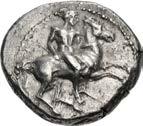


299 300 301 302
301. CILICIA, Kelenderis. Circa 410-375 BC. AR Stater (23mm, 11.04 g, 2h). Nude youth, holding whip in right hand, dismounting from horse rearing right / Goat kneeling left, head right; ˚E¬E@ above; all within shallow incuse circle. Casabonne Type 4; Celenderis Series IV, unlisted variety; SNG BN 75 (same dies); SNG Levante –; SNG von Aulock –; BMC 25 var. (ethnic). Toned, minor die wear and a few flan flaws on obverse, slight die shift on reverse. Good VF. ($500)
302. CILICIA, Kelenderis. Circa 410-375 BC. AR Stater (22.5mm, 10.81 g, 4h). Nude youth, holding whip in right hand, dismounting from horse rearing right / Goat kneeling right, head left; ivy leaves on vine and ˚E¬E-@ above; all within shallow incuse circle. Casabonne Type 4; Celenderis Series IV, unlisted variety; SNG BN 24 (same dies); SNG Levante –; SNG von Aulock –; BMC –; CH VIII, pl. VI, 9 (same dies). Patches of light find patina, struck with worn obverse die, minor double strike on reverse. Near EF. Rare. ($750)



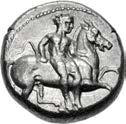


303. CILICIA, Kelenderis. Circa 410-375 BC. AR Stater (20mm, 10.68 g, 1h). Nude youth, holding whip in right hand, dismounting from horse rearing right / Goat kneeling right, head left; ˚E¬E-@ and É above; all within shallow incuse circle. Casabonne Type 4; Celenderis Series IV, unlisted variety; SNG BN 73 (same dies); SNG Levante –; SNG von Aulock –; SNG Hunterian 923 (same dies); BMC –. Underlying luster, minor double strike on reverse. EF. ($750)

304. CILICIA, Kelenderis. Circa 410-375 BC. AR Stater (20mm, 10.74 g, 1h). Nude youth, holding whip in right hand, dismounting from horse rearing right / Goat kneeling right, head left; ˚E¬E-@ above; all within shallow incuse circle. Casabonne Type 4; Celenderis Series IV, unlisted variety; SNG BN –; SNG Levante 25; SNG von Aulock –; SNG Ashmolean 1669; BMC 27 (same obv. die). A little off center, minor die wear. EF. ($750)

305. CILICIA, Kelenderis. Circa 410-375 BC. AR Stater (23mm, 10.70 g, 1h). Nude youth, holding whip in right hand, dismounting from horse rearing right; t below / Goat kneeling right, head left; ˚E¬E@ and Ċ above; all within shallow incuse circle. Casabonne Type 4; Celenderis Series IV, unlisted variety; SNG BN –; SNG Levante –; SNG von Aulock –; BMC 22. Patches of light find patina, minor double strike on reverse. Good VF. ($500)
304 305 306 307
306. CILICIA, Kelenderis. Circa 410-375 BC. AR Stater (21.5mm, 10.68 g, 1h). Nude youth, holding whip in right hand, dismounting from horse rearing right; t below / Goat kneeling right, head left; ˚E¬E@ above; all within shallow incuse circle. Casabonne Type 4; Celenderis Series IV, unlisted variety; SNG BN –; SNG Levante –; SNG von Aulock –; SNG Lockett 3034 var. (ethnic); BMC –. Spots of roughness and a couple of scratches on reverse. Good VF. Very rare without monogram on reverse. ($500)
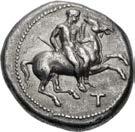
307. CILICIA, Nagidos. Circa 400-385/4 BC. AR Stater (21mm, 10.73 g, 11h). Aphrodite seated left, holding patera in extended right hand; to right, Eros, nude, standing left, grasping Aphrodite’s arm with his right hand, and holding wreath in his left; 5s to outer right / Bearded Dionysos, nude but for drapery hanging from arms, standing left, holding kantharos in extended right hand, thyrsos in left; grape bunch hanging from vine to left, @Å˝5dEW@ to right. Casabonne Type 1; Lederer Group 1, unlisted variety; SNG BN 1 var. = SNG Levante 1 var. (legends); SNG von Aulock –; BMC –. Minor double strike on obverse, small test cut at edge on reverse. Good VF. Very rare variety. ($750)
308 309
308. CILICIA, Soloi. Circa 440-410 BC. AR Stater (20.5mm, 10.65 g, 3h). Amazon kneeling left, holding bow in both hands, quiver on left hip / Grape bunch on vine; Å-˚ flanking stem, so¬EW˜ to left, fly to lower right; all in dotted square within incuse square. Casabonne Type 2; SNG BN 130 = Traité II 542; SNG Levante –; SNG von Aulock –; SNG Lockett 3043; BMC –; Dewing 2493 (same obv. die). Lightly toned, slight die wear on obverse. Good VF. ($500)
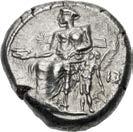








309. CILICIA, Soloi. Circa 440-410 BC. AR Stater (20mm, 10.73 g, 8h). Amazon kneeling left, holding bow in both hands, quiver on left hip / Grape bunch on vine; Q to right of stem, so¬EW˜ to left, e to lower right; all within dotted circle. Casabonne Type 3; SNG BN –; SNG Levante –; SNG von Aulock –; SNG Ashmolean 1791; SNG Copenhagen 225; BMC –; Boston MFA 2124. Light marks, some die wear. VF. ($500)
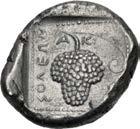
310. CILICIA, Soloi. Circa 410-375 BC. AR Stater (19mm, 10.72 g, 12h). Head of Athena right, wearing crested Attic helmet decorated with a griffin on the bowl / Grape bunch on vine tendril with leaves at sides; so¬EW@ to left, A to lower right. Casabonne Type 5; SNG BN –; SNG Levante –; SNG von Aulock –; SNG Copenhagen –; BMC –; CNG 93, lot 465 = Triton XV, lot 1255 (same dies). Minor die wear on obverse. EF. Very rare. ($1500)
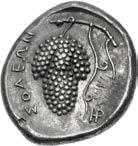


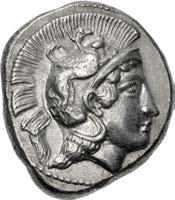
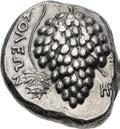

311. CILICIA, Soloi. Circa 410-375 BC. AR Stater (20.5mm, 10.68 g, 9h). Head of Athena right, wearing crested Attic helmet decorated with a griffin on the bowl / Grape bunch on vine tendril; A to upper left, so¬EW@ to right; all within incuse circle. Casabonne Type 5; SNG BN –; SNG Levante –; SNG von Aulock –; SNG Copenhagen –; BMC –; Athena Fund II 791 (same dies); Triton XXV, lot 294 (same dies). Toned, slightly off center on reverse. EF. Very rare. ($1500)

312 313
312. CILICIA, Soloi. Circa 410-375 BC. AR Stater (22.5mm, 10.82 g, 12h). Head of Athena right, wearing crested Attic helmet decorated with a griffin on the bowl / Grape bunch on vine tendril; A to upper left, so¬EW@ to right; all within incuse circle. Casabonne Type 5; SNG BN –; SNG Levante –; SNG von Aulock –; SNG Copenhagen –; BMC –; Athena Fund II 791 (same dies); Triton XXV, lot 294 (same dies). Die wear. Near EF. Very rare. ($1000)
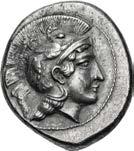




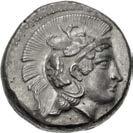
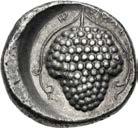
313. CILICIA, Soloi. Circa 410-375 BC. AR Stater (21mm, 10.67 g, 12h). Head of Athena right, wearing crested Attic helmet decorated with a griffin on the bowl / Grape bunch on vine tendril with leaf to right; so¬EW@ to left, A to lower right. Casabonne Type 5; SNG BN –; SNG Levante –; SNG von Aulock –; SNG Copenhagen –; BMC –; Triton XXV, lot 296 (same dies). Traces of find patina, tiny die break on reverse. EF. ($1000)

314. CILICIA, Soloi. Tiribazos. Satrap of Lydia, 388-380 BC. AR Stater (20mm, 10.10 g, 12h). Struck circa 390/87387/6 BC. Bearded head of Herakles right, lion skin tied around neck / Head of satrap right, wearing bashlyk; ˚-5-¬-os around. Casabonne Series 2, Group B; SNG BN 160–3 var. (ethnic); SNG Levante 50 = SNG Ashmolean 1793 var. (same); SNG von Aulock 5863 var. (same); Traité II 563. Toned, slight die shift on obverse. Near EF. ($2000)
From the North River Collection. Ex Triton XVI (8 January 2013), lot 527.
315. CILICIA, Tarsos. Circa 440-420 BC. AR Third Stater (14mm, 3.42 g, 9h). Warrior advancing left, raising left hand, holding spear in right; e to left / Forepart of Pegasos flying right; zd† (TRZ in Aramaic) to right; all in dotted square within incuse square. Cf. CNG E-342, lot 327 (for stater of this issue), otherwise, unpublished. Lightly toned, granular surfaces, a few marks. VF. Apparently unique. ($500)
316 317
316. CILICIA, Tarsos. Circa 410 BC. AR Stater (20.5mm, 10.49 g, 12h). Male figure, wearing satrapal dress, holding rein in left hand, on horse galloping right / Hoplite, nude but for Corinthian helmet, kneeling left, holding spear in right hand and round shield decorated with gorgoneion in left; [zrt (TRZ in Aramaic) to right]. Casabonne Type F10; Müseler, Tarsos, Group 5, l; SNG BN 226; SNG Levante 61; SNG von Aulock 5913. Underlying luster, flan a little compact, faint marks. Good VF. ($500)
317. CILICIA, Tarsos. Circa 410 BC. AR Stater (21mm, 10.43 g, 7h). Male figure, wearing satrapal dress, holding rein in left hand, on horse galloping right / Hoplite, nude but for Corinthian helmet, kneeling left, holding spear in right hand and round shield decorated with gorgoneion in left; zrt (TRZ in Aramaic) to right. Casabonne Type F10; Müseler, Tarsos, Group 5, l; SNG BN 226; SNG Levante 61; SNG von Aulock 5913. Weakly struck in center. Good VF. ($500)


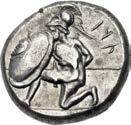
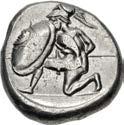
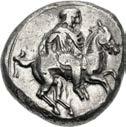



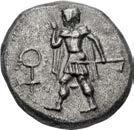

318. CILICIA, Tarsos. Circa 389-375 BC. AR Stater (21.5mm, 10.57 g, 9h). Herakles wrestling the Nemean Lion; club below / Head of Hera left, wearing stephanos decorated with palmette between two circles containing large pellets; tErs5˚[o@] to left. Casabonne Group J1; SNG BN 235 (same dies); SNG Levante 63 (this coin); SNG von Aulock –. Toned, roughness and pitting. VF. Fine style. Rare. ($1000)
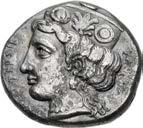
From the Pythagoras Collection. Ex Edoardo Levante Collection (Classical Numismatic Group 66, 19 May 2004), lot 611.

319. CILICIA, Tarsos. Tarkumuwa (Datames). Satrap of Cilicia and Cappadocia, 384-361/0 BC. AR Stater (24mm, 10.71 g, 1h). Struck circa 370 BC. Baal of Tarsos seated right, head and torso facing, holding grain ear and grape bunch in extended right hand, cradling eagle-tipped scepter in left arm; zRtL`b (B’LTRZ in Aramaic) to left, thymiaterion in background; all within crenellated wall / Ana, nude, standing right, extending right hand and pointing at the head of Tarkumuwa, standing left, wearing chlamys, leaning on staff in left hand, right hand raised; thymiaterion and wMdRt (TRKMW in Aramaic) between; all within square dotted border in linear border. Casabonne Series 3; Moysey Issue 5, Var. 1; SNG BN 292; SNG Levante 83 = SNG von Aulock 5944; SNG von Aulock 5943. Lightly toned, with some iridescence, minor marks, obverse sightly off center, slight doubling on reverse. EF. ($750)
From the Dr. Robert Misbin Collection. Ex CNG inventory 902660 / 70664 (before 1995).
320. CILICIA, Tarsos. Pharnabazos. Persian military commander, 380-374/3 BC. AR Stater (20mm, 10.72 g, 8h). Struck circa 380 BC. Head of Arethousa facing slightly left, hair in ampyx, wearing single-pendant earring and necklace with pendants; to left, fish upward / Bearded head left, wearing crested helmet with raised earflap and floral motif, drapery around neck; ˚5¬5˚o@ and klÓ (ḤLK in Aramaic) to left. Casabonne Series 2; Moysey Issue 3, dies 2/– (unlisted rev. die); SNG BN 242 (same obv. die [erroneously listed under obv. die 1 in Moysey]); SNG Levante –; SNG von Aulock –; SNG Hunterian 966 (same obv. die); Jameson 2603 = Pozzi 2847 (same obv. die [erroneously listed under obv. die 1 in Moysey]). Small mark and a little die wear on obverse. Near EF. Very rare with fish and this legend. ($1000)
321 322
321. CILICIA, Tarsos. Pharnabazos. Persian military commander, 380-374/3 BC. AR Stater (19mm, 10.73 g, 2h). Struck circa 380 BC. Head of Arethousa facing slightly left, hair in ampyx, wearing single-pendant earring and necklace with pendants; to left, fish upward / Bearded head left, wearing crested helmet with raised earflap and floral motif, drapery around neck; ˚5¬5˚o@ and klÓ (ḤLK in Aramaic) to left. Casabonne Series 2; Moysey Issue 3, dies 2/– (unlisted rev. die); SNG BN 242 (same obv. die [erroneously listed under obv. die 1 in Moysey]); SNG Levante –; SNG von Aulock –; SNG Hunterian 966 (same obv. die); Jameson 2603 = Pozzi 2847 (same dies [erroneously listed under dies 1/c in Moysey]). Minor die wear, contact mark on reverse. Good VF. Very rare with fish and this legend. ($750)





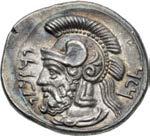

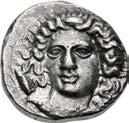

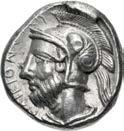
322. CILICIA, Tarsos. Pharnabazos. Persian military commander, 380-374/3 BC. AR Stater (21mm, 10.60 g, 11h). Struck circa 380 BC. Head of Arethousa facing slightly left, hair in ampyx, wearing single-pendant earring and necklace with pendants; to left, fish upward / Bearded head left, wearing crested helmet with raised earflap and floral motif, drapery around neck; ˚5¬5˚o@ and klÓ (ḤLK in Aramaic) to left. Casabonne Series 2; Moysey Issue 3, dies 2/– (unlisted rev. die); SNG BN 242 (same obv. die [erroneously listed under obv. die 1 in Moysey]); SNG Levante –; SNG von Aulock –; SNG Hunterian 966 (same obv. die); Jameson 2603 = Pozzi 2847 (same obv. die [erroneously listed under obv. die 1 in Moysey]). Lightly toned, some minor marks, deposits. VF. Very rare with fish and this legend. ($750)
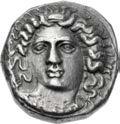

323. CILICIA,
Casabonne
From the North River Collection. Ex Triton XVIII (6 January 2015), lot 695; Gorny & Mosch 190 (11 October 2010), lot 319.
324. CILICIA, Tarsos. Mazaios. Satrap of Cilicia, 361/0-334 BC. AR Stater (24.5mm, 10.89 g, 6h). Baal of Tarsos seated left, head and torso facing, holding eagle, grain ear, and grape bunch in extended right hand, lotus-tipped scepter in left; rt (TN in Aramaic) to left, M (M in Aramaic) below throne, zRtL`b (B’LTRZ in Aramaic) to right / Lion left, attacking bull left; ydzM (MZDY in Aramaic) above, å below. Casabonne Series 2, Group C; SNG BN –; SNG Levante 106; SNG Ashmolean –; SNG von Aulock –; BMC –; Traité –. Lightly toned, a little porosity on obverse, reverse struck off center and with a minor double strike. Superb EF. ($2000)
From the GTP Collection. Ex Nomos FPL (Winter/Spring 2012), no. 43; Gorny & Mosch 164 (17 March 2008), lot 248.
325. CILICIA, Tarsos. Mazaios. Satrap of Cilicia, 361/0-334 BC. AR Stater (23.5mm, 11.19 g, 7h). Baal of Tarsos seated left, head and torso facing, holding eagle, grain ear, and grape bunch in extended right hand, lotus-tipped scepter in left; rt (TN in Aramaic) to left, M (M in Aramaic) below throne, zRtL`b (B’LTRZ in Aramaic) to right / Lion left, attacking bull left; ydzM (MZDY in Aramaic) above, å below. Casabonne Series 2, Group C; SNG BN –; SNG Levante 106; SNG Ashmolean –; SNG von Aulock –;
Ex Gorny & Mosch 141 (10 October 2005), lot 159.

326. CILICIA, Tarsos. Mazaios. Satrap of Cilicia, 361/0-334 BC. AR Stater (23mm, 11.01 g, 12h). Baal of Tarsos seated left, head and torso facing, holding eagle, grain ear, and grape bunch in extended right hand, lotus-tipped scepter in left; rt (TN in Aramaic) to left, M (M in Aramaic) below throne, zRtL`b (B’LTRZ in Aramaic) to right / Lion left, attacking bull left; ydzM (MZDY in Aramaic) above. Casabonne Series 2, Group D; SNG BN 335; SNG Levante Supp. 20; SNG von Aulock 5960. In NGC encapsulation 4938384-002, graded MS, Strike: 4/5, Surface: 5/5, Fine Style. ($2000)
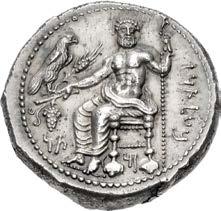


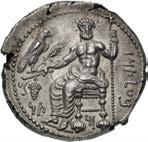


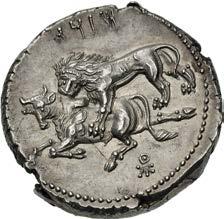
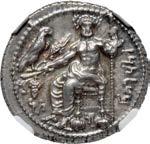

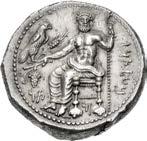
327. KINGS of ARMENIA MINOR. Aristoboulos, with Salome. AD 54-92. Æ (21.5mm, 7.89 g, 12h). Dated RY 13 (AD 66/7). ∫å45¬EW4 år54to∫oU¬oU Et 5˝, diademed and draped bust of Aristoboulos left / ∫å45¬54-4˙4 4å¬oÂ˙4, diademed and draped bust of Salome left. Kovacs 300; Meshorer 365 corr. (date); Hendin 1257a; RPC I 3840 corr. (same). Red-brown and green surfaces, light scratch on reverse. Good VF. Clear and complete legends and date. ($20,000)

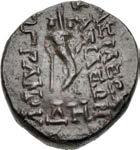



Salome is described in the Gospels (Matthew 14 and Mark 6) only as the daughter of Herodias, who asked Herod Antipas for the head of John the Baptist in return for his daughter’s risqué dance for the king. Salome’s name is supplied by Josephus in Antiquities 18.5, where he also informs us that she grew up to marry her great-uncle Philip the Tetrarch and, after Philip’s death, her cousin Aristoboulos, who is featured on the obverse of this coin and with whom Salome had three sons. Aristoboulos was the son of Herod V of Chalkis and great grandson of Herod I, and was appointed king of Armenia Minor in the first year of Nero’s reign.
The present issue was struck in AD 66/7 (year 13 of Aristoboulos’s reign), the first year of the Jewish war and around 40 years since the execution of John the Baptist, which has been tentatively dated to some time between AD 25 and 29. Hendin (5th ed., p. 275) suggests that Aristoboulos struck this issue for propagandistic and political purposes, in the first year of the war, as a show of loyalty to Rome and his patron Nero.
When RPC was published, citing three known examples of this type, the date was off the flan on two pieces and the one example with partial date had been tentatively read as date Α or Η (RPC p. 570). Frank Kovacs subsequently discovered an example with a clear date 13 (Hendin p. 275, pl. 24, same obverse die as the present coin), and Kovacs’s opinion was that other reported dates were most likely mis-readings of that date. The publication of additional specimens has since confirmed Kovacs’ opinion, and it is now clear that all coins of this type are dated year 13.
328 329
328. KINGS of ARMENIA. Tigranes II ‘the Great’. 95-56 BC. AR Tetradrachm (25.5mm, 15.73 g, 1h). Tigranocerta mint. Struck circa 80-68 BC. Diademed and draped bust right, wearing tiara decorated with star between two eagles / ∫&%5¬EW% t5˝r&@oU, Tyche of Antioch seated right on rock, holding laurel branch; below, river-god Orontes swimming right; è to inner right, › on rock; all within wreath. SCADA Group 3, dies A38/P76; Kovacs 71.2; M&D 29; CAA 20; AC
34. Toned, earthen deposits, light scratches. Good VF. ($1500)
329. KINGS of ARMENIA. Tigranes II ‘the Great’. 95-56 BC. AR Tetradrachm (25.5mm, 15.81 g, 1h). Tigranocerta mint. Struck circa 80-68 BC. Diademed and draped bust right, wearing tiara decorated with star between two eagles / ∫&%5¬EW% t5˝r&@oU, Tyche of Antioch seated right on rock, holding laurel branch; below, river-god Orontes swimming right; f to inner right, › on rock; all within wreath. SCADA Group 4, dies A42/P133; Kovacs 71.1; M&D 27; CAA 20; AC 34. Toned, light marks, a few small marks on obverse. Good VF. ($1500)
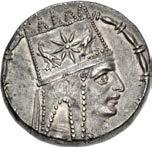

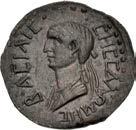



330. KINGS of ARMENIA. Tigranes II ‘the Great’. 95-56 BC. Æ Chalkous (14.5mm, 2.10 g, 1h). Series 4. Tigranocerta mint. Struck circa 80-68 BC. Diademed and draped bust right, wearing tiara decorated with star between two eagles / ∫¬%5¬EW% ∫¬%5¬EW@ t5˝r¬@oU, cornucopia tied with fillet; d˙ below. Kovacs 91; M&D 47; CAA –; AC 98. Dark red-brown patina. Good VF. Exceptional for issue. ($500) From the Pythagoras Collection.

331. CYPRUS, Paphos. Stasandros. Second half 5th century BC. AR Stater (24mm, 10.85 g, 12h). Bull standing left; winged solar disk above, e to left, palmette ornament in exergue / Eagle standing left; one-handled vase to left, s1 ß^ß (Basi Stasa in Cypriot) around; all within dotted square in incuse square. Destrooper-Georgiades 15; Zapiti & Michaelidou 7; Tziambazis 7. Slightly off center, minor die wear. Near EF. ($3000)
332 333
332. CYPRUS, Salamis. Phausis(?). Circa 480-460 BC. AR Stater (23mm, 11.24 g, 3h). Ram couchant left; pellet-increscent and íì1 (pa-u-si in Cypriot) above, nö (se-o in Cypriot) below / Large ornate ankh enclosing 1 (pa in Cypriot); övsî (se-si-le-o in Cypriot) counterclockwise around from upper right; all within incuse circle. McGregor Group F.II.b, 282 corr. (legends; o1/r1); Zapiti & Michaelidou –; Tziambazis –; BMC –; Sternberg XIII, lot 243 (same dies). Some weakness to strike, minor double strike on reverse. Good VF. Extremely rare. ($3000)

333. CYPRUS, Salamis. Evagoras I. Circa 411-374/3 BC. AR Stater (22.5mm, 11.04 g, 9h). Herakles seated right on rock draped with lion’s skin, leaning on club and holding cornucopia; [üèã]ìñ (e-u-[wa-ko-ro] in Cypriot) around / Goat couchant right; ankh above, †rvs1 (pa-si-le-wo-se in Cypriot) around; all within incuse circle. McGregor Group K.AR.I var. (unlisted variety with ankh); Masson & Amandry I.a.1 var. (no ankh); Zapiti & Michaelidou –; Tziambazis –. Lightly toned, slightly soft strike, trace deposits. Good VF. Very rare with ankh on reverse, only five in CoinArchives. ($3000)
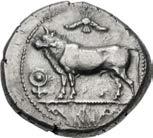
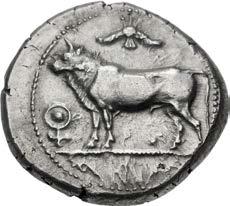


334. CYRRHESTICA,
Didrachm (22mm, 7.99 g, 6h). Draped bust of female facing,

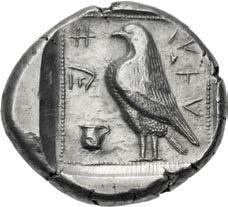



h†`w Kdh (Aramaic
Ateh) and circle to left] / Persian satrap and driver, who holds reins in both
in
mules
¥†¥
) above; countermark on horse: ; in conforming incuse. Andrade Series 1, Issue 1, 9 (O3/R6) = Mildenberg, Note 3 (this coin, illustrated in both); HGC 9, 1344. Lightly toned, area of rough find patina, surface roughness, a couple of light scratches on obverse. VF. Very rare, one of only ten examples in Andrade, and no additional examples in CoinArchives. ($1000)
From the Pythagoras Collection. Ex Giessener Münzhandlung 71 (3 May 1995), lot 386.
335. SELEUKID EMPIRE. Seleukos I Nikator. First satrapy, 321-315 BC. AR Tetradrachm (27mm, 17.26 g, 6h). In the name of Philip III of Macedon, types of Alexander III. Uncertain Mint 6A in Babylonia. Struck circa 320-315 BC. Head of Herakles right, wearing lion skin / ∫Ås5¬EWs f5¬5ππoU, Zeus Aëtophoros seated left; in left field, ˛ on shield; ˝ below throne. SC Ad39.1; Taylor Series I, 8–9 (A8/P8); Price P165 (Marathos); HGC 9, 11a; CNG 61, lot 486 (same dies). Lightly toned, minor double strike on reverse. Good VF. Very rare, only ten examples noted by Taylor, two additional in CoinArchives. ($750)
336. SELEUKID EMPIRE. Seleukos I Nikator. Second satrapy and kingship, 312-281 BC. AR Tetradrachm (27.5mm, 17.07 g, 3h). In the types of Alexander III of Macedon. Antioch on the Orontes mint. Struck from circa 300-281 BC. Head of Herakles right, wearing lion skin / ∫Ås5¬EWs sE¬EU˚oU, Zeus Nikephoros seated left; √ in left field, QE below throne. SC 13.1c; Le Rider, Antioche 22–5 var. (A7/P– [unlisted rev. die]); WSM 909, pl. XVI, 6 (same obv. die); HGC 9, 16c; Meydancikkale 2748 (same obv. die). Toned, underlying luster, slight die shift on reverse. Good VF. Well centered on a broad flan. ($500)
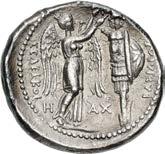




337. SELEUKID EMPIRE. Seleukos I Nikator. Second satrapy and kingship, 312-281 BC. AV Stater (17mm, 8.54 g, 5h). In the name and types of Alexander III of Macedon. Babylon I mint. Struck circa 311-300 BC. Head of Athena right, wearing single pendant earring, necklace, and triple-crested Corinthian helmet adorned with a serpent / ∫Å-s5¬EWs ŬE$Å@ droU, Nike standing left, holding wreath in extended right hand, cradling stylis in left arm; below left wing, pellet above µ5; © below right wing. SC 81.2; Price 3748; HGC 9, 3a; SNG Saroglos 166–8. In NGC encapsulation 3763549-004, graded MS, Strike: 5/5, Surface: 5/5, Fine Style. ($7500)

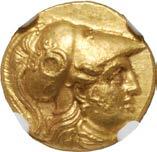
Session 2 – Tuesday, January 10, 2023 — 2 PM 335 336 338 339
338. SELEUKID EMPIRE. Seleukos I Nikator. Second satrapy and kingship, 312-281 BC. AR Tetradrachm (27mm, 16.97 g, 11h). In the name and types of Alexander III of Macedon. Babylon I mint. Struck circa 311-300 BC. Head of Herakles right, wearing lion skin / ∫Ås5¬EWs ŬExÅ@droU, Zeus Aëtophoros seated left; ü in left field, Â5 below throne. SC 82.5a; Price 3746; HGC 9, 10f. Lightly toned, some marks, minor die wear and roughness on obverse. Good VF. ($750)
From the GTP Collection. Ex Gorny & Mosch 226 (16 October 2014), lot 76.
339. SELEUKID EMPIRE. Seleukos I Nikator. Second satrapy and kingship, 312-281 BC. AR Tetradrachm (27.5mm, 17.02 g, 12h). Susa mint. Struck circa 305/4-295 BC. Head of hero (Alexander or Seleukos?) right, wearing helmet covered with panther skin and adorned with the ear and horns of a bull / ∫Å%5¬EW% %E¬EÆ˚oÆ (sic), Nike standing right, holding in both hands a wreath that she places on trophy to right; ˙ to lower left, Åc in lower middle field. SC 173.12; ESMS Tr.73–4 var. (A51/P– [unlisted rev. die]); Marest-Caffey Group 1.9, 129–46 var. (A21/P– [unlisted rev. die]); ESM 417 (unlisted dies); HGC 9, 20. Iridescent tone, slightly off center. Good VF. Rare mint error. ($2000)
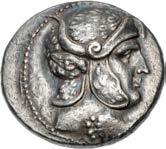
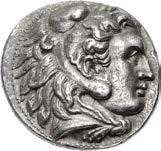


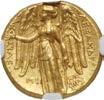
340. SELEUKID EMPIRE. Seleukos I Nikator. Second satrapy and kingship, 312-281 BC. AR Tetradrachm (24mm, 16.78 g, 12h). Susa mint. Struck circa 305/4-295 BC. Head of hero (Alexander or Seleukos?) right, wearing helmet covered with panther skin and adorned with the ear and horns of a bull / ∫Ås5¬EWs sE¬EU˚oU, Nike standing right, holding in both hands a wreath that she places on trophy to right; 8 to lower left, Åc in lower middle field. SC 173.13; ESMS Tr.91 (A60/ P1) = Marest-Caffey Group 9, A2 (same dies); ESM –; HGC 9, 20; Triton VIII, lot 525 (same rev. die); Goldberg 84, lot 3061 (same rev. die). Darkly toned, some minor smoothing in fields. Good VF. Extremely rare issue, apparently the fourth known with this monogram on reverse. ($3000)



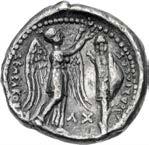



From the D.K. Collection.
341. SELEUKID EMPIRE. Seleukos I Nikator. Second satrapy and kingship, 312-281 BC. AR Drachm (16mm, 4.18 g, 4h). Susa mint. Struck circa 305/4-295 BC. Head of hero (Alexander or Seleukos?) right, wearing helmet covered with panther skin and adorned with the ear and horns of a bull / ∫Å%5¬EW% %E¬EÆ˚oU (sic), Nike standing right, holding in both hands a wreath that she places on trophy to right; ˙ to lower left, Åc in lower middle field. SC 174.5; ESMS S-31; Marest-Caffey Group 2.5, 231 (A14/P17 – this coin); ESM 418α (same dies); HGC 9, 34; G.K. Jenkins, “Coin hoards from Pasargadae” in Iran III (1965), 10 (same dies); Jameson 1656 (same obv. die); SNG Newham Davis 353 (same dies). Toned, slightly off center on reverse. VF. Interesting mint error. ($1500)

Ex Heritage 3032 (10 April 2014), lot 23285; Classical Numismatic Group 93 (22 May 2013), lot 492.
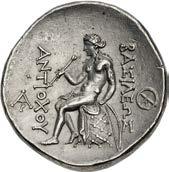
379.3c; ESM –;

343. SELEUKID EMPIRE. Antiochos I Soter. 281-261 BC. AR Tetradrachm (26mm, 17.07 g, 7h). Seleukeia on the Tigris mint. Diademed head right / ∫Å%5¬EW% Å@t5-ocoU, Apollo, nude, testing arrow in his right hand, left hand holding tip of bow set on ground to right, seated left on omphalos; Û to outer left, ¢ to outer right. SC 379.3d; ESM 157; HGC 9, 128g. Toned. In NGC encapsulation 6290624-015, graded AU★, Strike: 5/5, Surface: 4/5. ($2000)
Ex Mark & Lottie Salton Collection.
344 345
344. SELEUKID EMPIRE.


I Soter. 281-261 BC.

Tetradrachm (27.5mm, 17.15 g, 12h). Seleukeia on the Tigris mint. Diademed head right / ∫Å%5¬EW% Å@t5-ocoU, Apollo, nude, testing arrow in his right hand, left hand holding tip of bow set on ground to right, seated left on omphalos; Û to outer left, ¢ to outer right. SC 379.3d; ESM 157; HGC 9, 128g. Toned, minor scratch on obverse. Good VF. ($1000)



Ex Peus 378 (28 April 2004), lot 298.
345. SELEUKID EMPIRE. Antiochos I Soter. 281-261 BC. AR Tetradrachm (30mm, 17.00 g, 8h). Seleukeia on the Tigris mint. Diademed head right / ∫Å%5¬EW% Å@t-5ocoU, Apollo, nude but for drapery around waist, testing arrow in extended right hand, and placing left hand on grounded bow, seated left on omphalos; ° to outer left, ¢ to outer right. SC 379.6a; ESM 162γ = Hermitage Sale II 1428 (this coin); HGC 9, 128g; Bement 1670 (same obv. die). Old collection tone, a couple old scratches under tone on obverse. Near EF. ($2000)
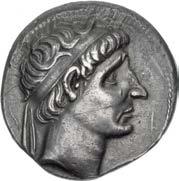
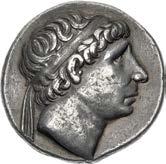

Ex Mark & Lottie Salton Collection; Hermitage Museum Collection (Schlessinger 13, 4 February 1935), lot 1428.
346. SELEUKID EMPIRE. Antiochos I Soter. 281-261 BC. AV Stater (16.5mm, 8.22 g, 6h). Aï Khanoum mint. Struck circa 266-261 BC. Diademed head right, with elderly features / [∫]Å%5¬EW% [Å]@t5oco[U], Apollo, nude, testing arrow in extended right hand, and placing left hand on grounded bow, seated left on omphalos; ò to inner left below arrow. SC 435.1; SMAK A1SA-1 (A1/P1); ESM 695β; HGC 9, 122; SNG ANS (Bactria) 50 (same dies). Slightly compact flan, trace deposits, scattered marks. VF. ($3000)

347. SELEUKID EMPIRE. Antiochos I Soter. 281-261 BC. AV Stater (19.5mm, 8.47 g, 6h). Aï Khanoum mint. Struck circa 266-261 BC. Diademed head right, with rejuvenated and idealized features / [∫]Å%5¬EW% Å@t5ocoU, Apollo, nude but for drapery around waist, testing arrow in extended right hand, and placing left hand on grounded bow, seated left on omphalos; d to inner left below arrow. SC 436.6; SMAK A1SA-38 var. (A–/P21i [unlisted obv. die]); ESM 704; HGC 9, 122. Underlying luster, hairlines, some die wear, minor doubling on reverse. EF. Very rare. ($10,000)



348 349
348. SELEUKID EMPIRE. Antiochos II Theos. 261-246 BC. AR Tetradrachm (27.5mm, 17.12 g, 11h). Lysimacheia mint. Diademed head right / ∫Å%5¬EW% Å@-t5ocoU, Apollo, nude, testing arrow in his right hand, left hand holding tip of bow set on ground to right, seated left on omphalos; to outer left, head of male right; in exergue, head of lion right and P. SC 483.6; Le Rider, Lysimachie, Series 2, dies D1/R2; WSM –; HGC 9, 236a; Meydancikkale 2867 (same dies). Lightly toned, minor die wear. VF. Very rare. ($1000)

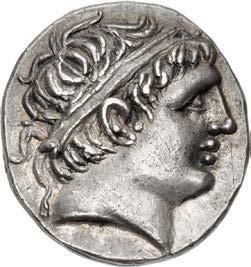

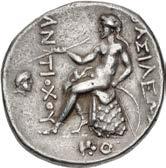
From the Pythagoras Collection.
The obverse die used for this issue under Antiochos II continued to be used to strike issues at Lysimacheia under Antiochos Hierax (cf. SC 858).


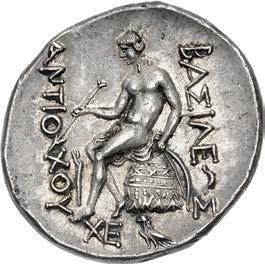
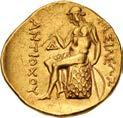
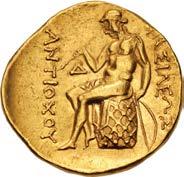
349. SELEUKID EMPIRE. Antiochos II Theos. 261-246 BC. AR Tetradrachm (31.5mm, 16.64 g, 12h). Lysimacheia mint. Diademed head right / ∫Å%5¬EW% Å@t5ocoU, Apollo, nude, testing arrow in his right hand, left hand holding tip of bow set on ground to right, seated left on omphalos; to outer left, ™ above Ç. SC 483.8; Le Rider, Lysimachie, Series 2, dies D1/R6; WSM 1620 (same dies); HGC 9, 236a. Lightly toned, some roughness, die wear. VF. Very rare. ($750)
From the Pythagoras Collection.
350. SELEUKID EMPIRE. Antiochos Hierax. Circa 242-227 BC. AR Tetradrachm (28mm, 16.99 g, 11h). Abydos or barbarous mint. Diademed head right, of “barbarous” style / ∫Å%5¬EW% Å@t5ocoU, Apollo, nude, testing arrow in his right hand, left hand holding tip of bow set on ground to right, seated left on omphalos adorned with geometric pattern between horizontal bands; g and eagle standing left in exergue. SC 844a; Houghton, Lampsacus, Series 1, Group A, dies A3/P–(unlisted rev. die); WSM 1558 var. (monogram); HGC 9, 405b; CSE 651 (same dies). Lightly toned, a few minor scratches. EF. ($3000)
From the Pythagoras Collection. Ex Leu 22 (8 May 1979), lot 158.
351.
SELEUKID EMPIRE. Antiochos Hierax. Circa 242-227 BC. AR Tetradrachm (30mm, 17.13 g, 12h). Lampsakos mint. Diademed youthful head right / ∫Å%5¬EW% Å@t5ocoU, Apollo, nude, testing arrow in his right hand, left hand holding tip of bow set on ground to right, seated left on omphalos adorned with horzontal pelleted bands between linear bands; bee to inner left. SC 852.2; Houghton, Lampsacus, Series 4, dies A5/P19; WSM 1549α (same dies); HGC 9, 403c (same obv. die as illustration). Old collection tone, minor die wear. Good VF. Well centered. Very rare, only two examples noted by Houghton, one additional in CoinArchives. ($1000)
From the Pythagoras Collection, purchased from Spink & Son, London. Ex Münzen und Medaillen AG 64 (30 January 1984), lot 190.
352. SELEUKID EMPIRE. Antiochos Hierax. Circa 242-227 BC. AR Tetradrachm (30mm, 17.10 g, 12h). Probably Phokaia mint. Diademed head right / ∫Å%5¬EW% Å@t-5ocoU, Apollo, nude, testing arrow in his right hand, left hand holding tip of bow set on ground to right, seated left on omphalos adorned with horzontal pelleted bands between linear bands; to outer left, os reading downward; to inner left, head of griffin left. SC 895.1 (this coin referenced and illustrated); WSM –; HGC 9, 403e; CSE 677 (this coin). Toned, small area of flat strike. Good VF. Extremely rare. ($1500)
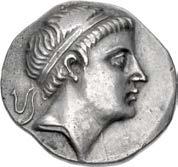

From the Pythagoras Collection. Ex Arthur H. Houghton Collection.
353 354
353. SELEUKID EMPIRE. Antiochos Hierax. Circa 242-227 BC. AR Tetradrachm (30mm, 17.13 g, 12h). ΕΠO mint, in Inland Asia Minor, probably Phrygia. Diademed head of Antiochos Hierax right, with mature features and sideburn / ∫Å%5¬EW% Å@-t5ocoU, Apollo, nude, testing arrow in his right hand, left hand holding tip of bow set on ground to right, seated left on omphalos; E∏o in exergue. SC 907c (same obv. die as illustration); WSM 1679α = SNG Salting 39 (same dies); HGC 9, 403i. Lightly toned, minor double strike on reverse. EF. Very rare, one in SCO, four in CoinArchives. ($750)
354. SELEUKID EMPIRE. Antiochos III ‘the Great’. 222-187 BC. AR Tetradrachm (29mm, 16.97 g, 12h). Nisibis mint. Series 2, circa 211-187 BC. Diademed head right (Type B) / ∫Å%5¬EW% Å@t5o-coU, Apollo, nude, testing arrow in his right hand, left hand holding tip of bow set on ground to right, seated left on omphalos; no control marks. SC 1129.2; WSM –; HGC 9, 447dd; Seyrig, Trésors 8.134. Lightly toned, minor scratches on obverse, double struck on reverse. Near EF. Extremely rare unmarked issue at Nisibis, only one in SCO (the Seyrig coin, referenced in SC), none in CoinArchives (though two are erroneously attributed to SC 1129.2). ($750)



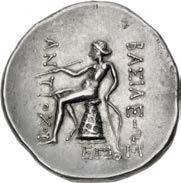
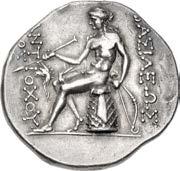

355.
SELEUKID EMPIRE. Antiochos IV Epiphanes. 175-164 BC. AR Tetradrachm (30mm, 17.11 g, 1h). Antioch on the Orontes mint. Series 1, struck 175–circa 173/2 BC. Diademed head right / ∫Å%5¬EW% Å@t-5ocoU, Apollo, nude, testing arrow in his right hand, left hand holding tip of bow set on ground to right, seated left on omphalos; tripod to outer left, kithara to outer right, : in exergue. SC 1395.1b; Le Rider, Antioche, Series I, 10–12A (A3/P6); HGC 9, 615d; SNG Spaer 960 = CSE 97 (same dies); BMC 4 (same dies). Trace deposits, light marks, faint cleaning scratches. Good VF. Very rare issue from the first series at Antioch, only ten noted by Le Rider, none in SCO, one additional in CoinArchives. ($3000)
356. SELEUKID EMPIRE. Antiochos IV Epiphanes. 175-164 BC. AR Tetradrachm (31mm, 16.58 g, 1h). Antioch on the Orontes mint. Series 3, struck 168-164 BC. Diademed head right / ∫Å%5¬EW% Å@t5ocoU QEoU E∏5fÅ@oU% @5˚EforoU, Zeus Nikephoros seated left; ∫ to outer left. SC 1400d; Le Rider, Antioche, Series IIIB, 402–21 var. (A39/P– [unlisted rev. die]); Mørkholm Series III, 17; HGC 9, 620a. Bright surfaces, obverse slightly off center. Near EF. ($750)
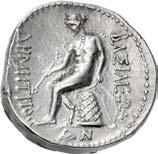
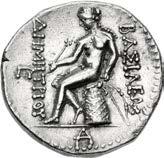



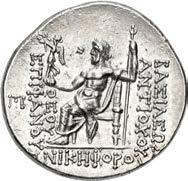
From the Pythagoras Collection, purchased from Pars Coins.
357. SELEUKID EMPIRE. Antiochos IV Epiphanes. 175-164 BC. AR Tetradrachm (34.5mm, 17.08 g, 12h). Ptolemaïs (Ake) mint. Struck circa 167-164 BC. Head right, wearing diadem terminating in stars; J to left / ∫Å%5¬EW% Å@t5ocoU QEoU E∏5fÅ@oU% @5˚EforoU, Zeus Nikephoros seated left; palm frond to outer left,  in exergue. SC 1476.1e; Mørkholm 9 var. (monogram in exergue), obv. die A7; HGC 9, 620c; Superior (8 December 1993), lot 316 (same obv. die). Lightly toned, trace deposits, tiny cut on obverse. Good VF. Very rare variety, none in SCO, only four in CoinArchives. ($750)
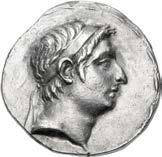
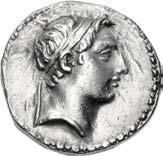
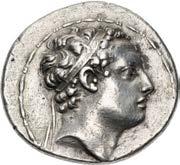

356 357 358 359
358. SELEUKID EMPIRE. Demetrios I Soter. 162-150 BC. AR Tetradrachm (27mm, 16.88 g, 12h). Susa mint. Diademed head right / ∫Å%5¬EW% d˙µ˙tr5oU, Apollo, nude, testing arrow in his right hand, left hand holding tip of bow set on ground to right, seated left on omphalos; . to outer left, ∏ in exergue. SC 1711.4a corr. (control mark in exergue; same dies as illustration); CSE 1068 (same dies); HGC 9, 790c. Trace deposits, cleaning scratches on obverse. Good VF. Very rare, one in SCO, one in CoinArchives. ($750)
359. SELEUKID EMPIRE. Demetrios I Soter. 162-150 BC. AR Tetradrachm (27mm, 16.85 g, 5h). Susa mint. Diademed head right / ∫Å%5¬EW% d˙µ˙tr5oU, Apollo, nude, testing arrow in his right hand, left hand holding tip of bow set on ground to right, seated left on omphalos; , to outer left, &@ in exergue. SC 1711.5c; CSE 1071 (same dies); HGC 9, 790c; BN inv. 1968.1114 (same dies). Scattered light marks, minor flan flaws and some cleaning scratches on obverse. Good VF. Very rare, one in SCO, one in CoinArchives. ($750)
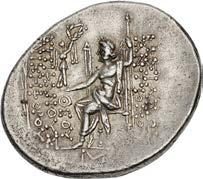
360.
SELEUKID EMPIRE. Alexander I Balas. 152-145 BC. AR Tetradrachm (27mm, 14.21 g, 1h). Tyre mint. Dated SE 163 (150/49 BC). Diademed and draped bust right / ∫Å%5¬EW% ŬE$Å@droU, eagle standing left on prow left; palm frond behind; to left, club surmounted by i; to right, ˝$r (date) above A. SC 1835.2b; Newell, Tyre 58; Rouvier 1858; HGC 9, 883; DCA 123. Toned, a few pits on obverse. EF. ($2000)
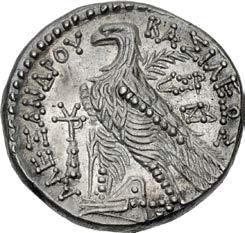
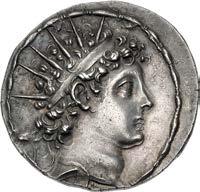




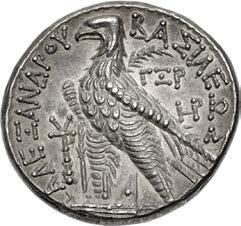


361.
Ex Father & Son Collection. Ex Classical Numismatic Group 87 (18 May 2011), lot 636.
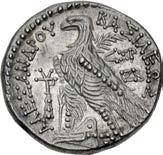
362.
SELEUKID
From the North River Collection. Ex Triton X (9 January 2007), lot 397 (erroneously described without star, attributed to SMA 233).
363 364
363. SELEUKID EMPIRE. Antiochos VI Dionysos. 144-142 BC. AR Tetradrachm (31.5mm, 15.50 g, 1h). Antioch mint. Dated SE 169 (144/3 BC). Radiate and diademed head right / ∫Å%5¬EW% Å@t5ocoU EP5fÅ@oU d5o@U%oU, the Dioskouroi on horseback riding left, holding couched lances; to right, trU, K, and %tÅ; O$r (date) below; all within wreath of lily, ivy, and grain ears. SC 2000.2b; SMA 231; HGC 9, 1032. Toned, underlying luster, minor die wear and light roughness on obverse, numerous cleaning scratches. EF. ($1500)



364. SELEUKID EMPIRE. Antiochos VII Euergetes (Sidetes). 138-129 BC. AR Tetradrachm (32mm, 16.84 g, 12h). Antioch on the Orontes mint. Diademed head right / ∫Å%5¬EW% Å@t5ocoU EUEr-˝EtoU, Athena Nikephoros standing left; to outer left, 1 above ˙; all within wreath. SC 2061.1o; Lorber, Die 29–31 (obv. die A8); SMA 277; HGC 9, 1067c; SNG Spaer 1850. Lightly toned, light scratch in field on obverse. Good VF. ($500)



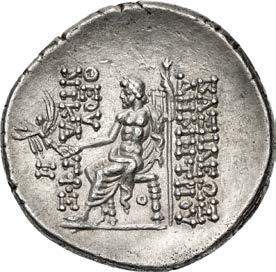



365. SELEUKID EMPIRE. Antiochos VII Euergetes (Sidetes). 138-129 BC. AR Tetradrachm (31mm, 14.07 g, 1h). Ptolemaïs (Ake) mint. Dated SE 177 (136/5 BC). Diademed head right / ∫Å%5¬EW% Å@t5ocoU, eagle standing left on thunderbolt; , to left, zor (date) to right, pellet below wing. SC 2116.1 var. (location of pellet); Babelon, Rois 1104 var. (no pellet); HGC 9, 1075; DCA 196. Lightly toned. Good VF. Extremely rare issue, of which none are recorded with pellet below the eagle’s wing. ($3000)
All of the silver issues of Antiochos VII from Ptolemaïs are dated to SE 177 (136/5 BC), and are likely connected to the Seleukid military campaign in Judaea, which culminated in a siege of Jerusalem the following year. The siege resulted in the submission of the Judaeans to the Seleukid king, and a payment of 500 talents of silver.

366. SELEUKID EMPIRE. Demetrios II Nikator. Second reign, 129-125 BC. AR Tetradrachm (30.5mm, 16.59 g, 1h). Antioch on the Orontes mint. Struck 129-128 BC. Diademed and bearded head right / ∫Å%5¬EW% d˙µ˙tr5oU QEoU @5˚Å-toro%, Zeus Nikephoros seated left; $ to outer left, o below throne. SC 2166.2c; Schwei Group 7, 82–3 (A6/P42); SMA 320; CSE 288; HGC 9, 1117b; SNG Copenhagen 34 (same obv. die). Lightly toned, a few minor marks. Near EF. ($2000)
From the North River Collection. Ex Triton XI (7 January 2008), lot 298.
367.
SELEUKID EMPIRE. Demetrios II Nikator. Second reign, 129-125 BC. AR Tetradrachm (28.5mm, 16.40 g, 12h). Damaskos mint. Dated SE 184 (129/8 BC). Diademed and bearded head right / ∫Å%5¬EW% d˙µ˙tr5oU QEoU @5˚Å-toro%, Zeus Nikephoros seated left; § below throne, d∏[r] (date) in exergue. SC 2181.2b; Schwei Group 3, 29–31 (A5/P19); HGC 9, 1116d; DCA 223; SNG Spaer 2266 (same dies). Lightly toned, compact flan, a few minor scratches. Near EF. ($1500)
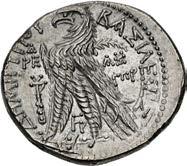

368. SELEUKID EMPIRE. Demetrios II Nikator. Second reign, 129-125 BC. AR Tetradrachm (31mm, 14.05 g, 12h). Tyre mint. Dated SE 183 (129 BC). Diademed and draped bust right / ∫Å%5¬EW% d˙µ˙tr5oU, eagle standing left on prow left; palm frond in background; to left, õ above club surmounted by i (Tyre monogram); to right, &† above ˝∏r (date); > between legs. SC 2195.1b; Newell, Tyre 156; HGC 9, 1122; DCA 230. Slightly off center. EF. ($500)

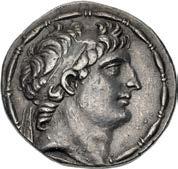




369. SELEUKID EMPIRE. Alexander II Zabinas. 128-122 BC. AR Tetradrachm (27mm, 15.92 g, 12h). Tarsos mint, “Civic” workshop. Struck circa 125-122 BC. Diademed head right / [∫]Å%5¬EW% [Ŭ]E$Å@droU, Sandan standing right on back of horned and winged lion standing right upon garlanded altar with baldachin; to outer left, L above “. SC 2211 var. (upper monogram [see SC 2212.1b for the drachm with these controls]); HGC 9, 1150. Toned, some minor porosity, scratches. VF. Extremely rare Sandan tetradrachm of Zabinas, unpublished with this upper monogram. ($3000)
Ex Classical Numismatic Group Electronic Auction 321 (26 February 2014), lot 197.


370.
`@ t5oco¨
371 372
371. SELEUKID EMPIRE. Antiochos IX Eusebes Philopator (Kyzikenos). 114/3-95 BC. AR Tetradrachm (27.5mm, 16.69 g, 12h). Sidon mint. Dated SE 202 (111/0 BC). Diademed head right within fillet border / ∫Å%5¬EW% Å@t5ocoU f5¬o∏Åtoro%, Zeus Nikephoros standing left; to outer left, %5dW above 5Er above `%U above ∫; ∫s (date) in exergue; all within wreath. SC 2385; HGC 9, 1228k; DCA 288. Lightly toned over lustrous surfaces, trace deposits. EF. Very rare, only two in CoinArchives. ($500)
372. PHOENICIA, Arados. Circa 246/5-168/7 BC. AR Tetradrachm (29.5mm, 16.75 g, 12h). In the name and types of Alexander III of Macedon. Dated CY 76 (184/3 BC). Head of Herakles right, wearing lion skin / Zeus Aëtophoros seated left; palm tree in left field, 1 (civic monogram) below throne, o4 (date) in exergue. Duyrat 1342–9 var. (unlisted obv. die); Rouvier 87; Price 3403; DCA 771; HGC 10, 61. Iridescent tone, scattered marks, a little off center. Good VF. ($300)
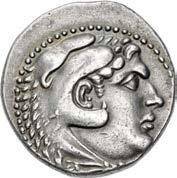


From the GTP Collection. Ex Chaponniere & Firmenich 14 (20 November 2021), lot 10.
373. PHOENICIA, Byblos (Gebal). ‘Ozba’al. Circa 400-365 BC. AR Shekel (26.5mm, 13.20 g, 6h). Three hoplites, holding shields, on galley left above waves, prow ending in lion’s head; below, hippocamp left above murex shell, Zo (‘Z in Phoenician) above dorsal fin / Lion attacking bull left; lBG klM loBZo (‘ZB‘L MLK GBL = Ozbaal, king of Gebal in Phoenician) above. E&E-B Series IV.2.1.c, 518–9 (O14/R27); Betlyon 14 var. (no letters on obv.); Rouvier 640 var. (letters on obv.); HGC 10, 133 corr. (letters on obv. not noted); SNG Fitzwilliam 6029; Athena Fund II 872 (same obv. die); Norman Davis 283. Light golden tone, underlying luster. EF. Well centered. ($1500)
374. PHOENICIA, Tyre. Uncertain king. Circa 440-425 BC. AR Quarter Shekel (15mm, 3.40 g, 11h). Dolphin right; nclc (Phoenician ŠLŠN) above, waves and murex shell below / Owl standing right, head facing; crook and flail over shoulder; all in outline incuse within incuse square. E&E-T Group I.2.2, 185 (O1/R3); Elayi & Lemaire 8 (same dies); Rouvier 1776; HGC 10, 323; AUB 2; Traité II 983; Weber 8082. Toned, with some iridescence, edge splits. Good VF. ($500)







From the Kenneth S. Abramowitz Collection.
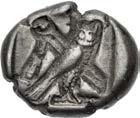
One of the great cities of Phoenicia, Tyre was first a subject of the Ptolemies and then of the Seleukids; it was an important mint for both dynasties. The city received a grant of autonomy from the Seleukid Crown in 126/5 BC, whereupon Tyre immediately inaugurated a new civic coinage dated to the era of its autonomy, with certain affinities to the coinage it had formerly minted for its royal masters. The civic silver featured a new obverse type, a head of the Phoenician god Melkart, but the reverse type of an eagle standing on a prow was identical to the reverse of Tyre’s Seleukid coinage, which in turn had been an elaboration on the Ptolemaic eagle. Half- and quarter-shekels were also struck. The early shekels, such as the first three lots offered, are struck on relatively broad, thin flans and bear a striking image of a muscular, laureate Melqart looking very much like the Greek Herakles, with a lion skin knotted around his neck. Later issues, commencing in 20/19 BC, have a distinctly different fabric, being struck on compact, thick flans, with cruder images and lettering.
375. PHOENICIA, Tyre. 126/5 BC-AD 65/6. AR Shekel (28.5mm, 14.19 g, 1h). Dated CY 16 (111/0 BC). Head of Melkart right, wearing laurel wreath, [lion skin around neck] / Eagle standing left on prow; palm frond in background; to left, ?5 (date) above club; Ê to right, b (Phoenician B) between legs; tUroU 5Er&% ˚&5 &%U¬oU around. DCA-Tyre 42 (same obv. die as illustration); HGC 10, 357; DCA 919. Lightly toned, small deposit on obverse. EF. Well struck on a broad flan. ($2000)

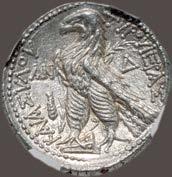


376. PHOENICIA, Tyre. 126/5 BC-AD 65/6. AR Shekel (28.5mm, 14.20 g, 12h). Dated CY 48 (79/8 BC). Bust of Melkart right, wearing laurel wreath, [lion skin around neck] / Eagle standing left on prow; palm frond in background; to left, ˙Â (date) above club; Ù to right, b (B in Phoenician) between legs; tUroU 5E[r`%] ˚`5 `%U¬oU around. DCA-Tyre 169 var. (letter between legs); Rouvier 2032 var. (monogram); HGC 10, 357; DCA 919; BMC –. Iridescent tone, some deposits, light marks. Near EF. Very rare variety. ($1500)
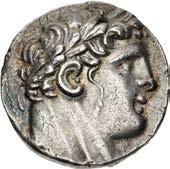



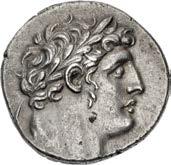
378. PHOENICIA, Tyre. 126/5 BC-AD 65/6. AR Shekel (27mm, 13.96 g, 12h). Dated CY 92 (35/4 BC). Head of Melkart right, wearing laurel wreath, lion skin around neck / Eagle standing left on prow; palm frond in background; to left, r∫ (date) above club; ∫@ to right, å (Phoenician A) between legs; [t¨ro¨] 5Er`% ˚`5 `%¨¬o¨ around. DCA-Tyre 313 (same obv. die as illustration); Rouvier –; HGC 10, 357; DCA 919. Light roughness. Near EF. ($1500)
379. PHOENICIA, Tyre. 126/5 BC-AD 65/6. AR Shekel (25mm, 14.06 g, 1h). Dated CY 159 (AD 33/4). Head of Melkart right, wearing laurel wreath, [lion skin around neck] / Eagle standing left on prow; palm frond in background; to left, r@œ (date) above club; to right, ˚r above ); b (Phoenician B) between legs; t¨ro¨ 5Er[`% ˚`5 `%]¨¬o¨ around. DCATyre 578 (same obv. die as illustration); Rouvier 2107 var. (monogram); RPC I 4663; HGC 10, 357; DCA 920; BMC 204 var. (same). Toned, roughness, cleaning scratches, a little off center, lamination on reverse. Good VF. Clear date. ($2000)




According to the traditional chronology, this coin was struck in the year of Jesus’ crucifixion.
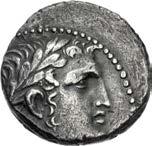

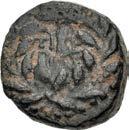

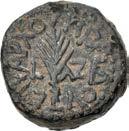
380. JUDAEA, Macedonian Period. Hezekiah. Circa 332-302/1 BCE. AR Half Gerah – Ma’ah (7mm, 0.21 g, 5h). Facing head of male / Owl standing right, head facing; HjpH (HPḤH in Phoenician) upward to left, HyQ4jy (YḤZQYH in Phoenician) downward to right. MCP YHD 24, dies O1/R1; Meshorer 22; Hendin 6069; HGC 10, 450; Bromberg 319; Shoshana II 20048; cf. Sofaer 20; Spaer 22. Toned, light porosity. Good VF. Exceptional for issue. ($750)
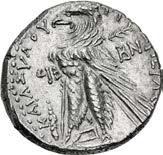

From the DMS Collection, purchased from David Hendin, August 2005.
381. JUDAEA, Herodians. Herod III Antipas. 4 BCE-39 CE. Æ Quarter Unit (13.5mm, 2.95 g, 12h). Tiberias mint. Dated RY 37 (33/4 CE). t5∫E/r5Å1 in two lines within wreath / ˙rWdoU tEtr&rcoU, palm frond; l ¬Z (date) flanking. K&F dies O1/R4; Meshorer 89; Hendin 6244 corr. (rev. legend); RPC I 4932; Bromberg 341 (same dies); Shoshana II 20065; cf. Sofaer 107/108 (for obv./rev. dies); Spaer –. Earthen dark green patina. Near EF. Exceptional for issue. ($750)
From the DMS Collection, purchased from David Hendin, May 2006.
382. JUDAEA, Jewish War. 66-70 CE. AR Shekel (23mm, 14.21 g, 12h). Jerusalem mint. Dated year 2 (67/8 CE). Omer cup; @c (“Y[ear] 2” in Hebrew = date) above, L!Rc¥ LQc (“Shekel of Israel” in Hebrew) around / Sprig of three pomegranates; YcurQY 2¥Lcur¥ (“Jerusalem the holy” in Hebrew) around. Deutsch 33–50 var. (O4/R– [unlisted rev. die]); Meshorer 193; Kadman 8; Hendin 6388; Bromberg I 63 (same dies); Shoshana I 20202–3; Sofaer 7–8; Spaer 167–8. Lightly toned, a hint of die wear. Choice EF. ($5000)

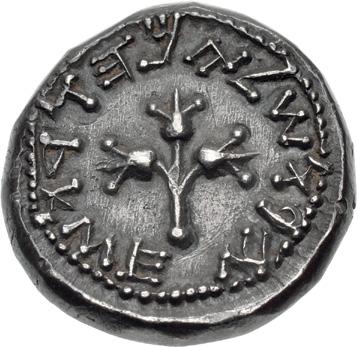
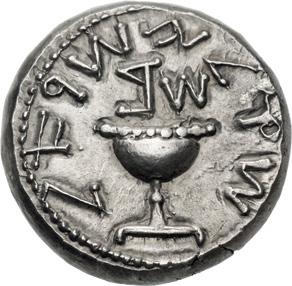
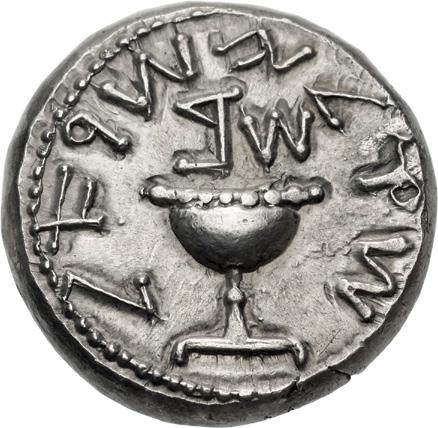
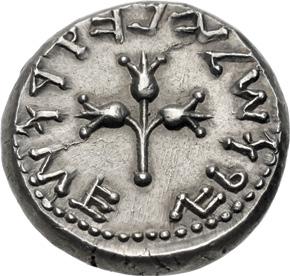




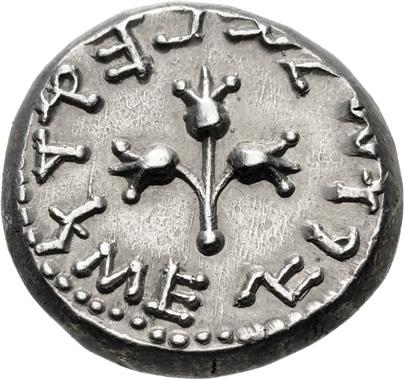


383. JUDAEA, Jewish War. 66-70 CE. AR Shekel (22mm, 14.16 g, 12h). Jerusalem mint. Dated year 2 (67/8 CE). Omer cup; @c (“Y[ear] 2” in Hebrew = date) above, L!Rc¥ LQc (“Shekel of Israel” in Hebrew) around / Sprig of three pomegranates; YcurQY 2¥Lcur¥ (“Jerusalem the holy” in Hebrew) around. Deutsch – (O5/R44 [unlisted die combination]); Meshorer 193; Kadman 8; Hendin 6388; Bromberg I 64 (same obv. die); Shoshana I 20202–3; Sofaer 7–8; Spaer 167–8. EF. ($5000)
384. JUDAEA, Jewish War. 66-70 CE. AR Half Shekel (19mm, 6.94 g, 12h). Jerusalem mint. Dated year 2 (67/8 CE). Omer cup; @c (“Y[ear] 2” in Hebrew = date) above, LQcY ¥SH (“Half Shekel” in Hebrew) around / Sprig of three pomegranates; YcurQY 2¥Lcur¥ (“Jerusalem the holy” in Hebrew) around. Deutsch 21 (O2/R20); Kadman 9; Meshorer 195; Hendin 6388; Bromberg I 65; Shoshana I 20204 (same obv. die); Sofaer 9–10 (same obv. die); Spaer 170. Deeply toned, a few light scratches under tone. EF. Well centered. ($7500)
From the JTB Collection. Ex UBS 63 (6 September 2005), lot 223; Clarence S. Bement Collection (Naville VII, 23 June 1924), lot 1751.
385.
MCP FJR-13, dies O3/R3; Kadman 32; Meshorer 211; Hendin 6396; Bromberg 73 = Shoshana I 20215; Sofaer 39; Spaer 179 (same dies). Dark green patina, earthen deposits, small dig on obverse. VF. Rare. ($5000)
By Year 4 of the Jewish War (69/70 CE), the Romans had gained the initiative and the rebellion was in dire straits. The Jews of Jerusalem were desperately short on supplies and engaged in bloody internecine battles for political control of the remaining rebel forces. The shortage of precious metals witnessed a severe drop in the number of silver shekels and their fractions from the temple mint (see previous lot). It also resulted in what has been called the world’s first issue of “siege coins.” This consisted of bronze coins intended to circulate along with the silver shekels, inscribed “half” and “quarter,” along with a much smaller denomination without a value that is surely an eighth-shekel. The large half-shekels are, by far, the rarest of these, with surviving specimens numbering in the mid thirties. The symbolism of the bronzes is distinct from that of the silver shekels, emphasizing Feast of Tabernacles on the holy day of Sukkot. Here the obverse depicts two lulavs (bound palm branches) and an etrog (citron fruit), while the reverse depicts a seven-branched palm tree (perhaps symbolizing the Menorah) flanked by two date baskets. The Paleo-Hebrew reverse inscription “to the redemption of Zion” marks a departure from previous coin slogans calling for the “freedom of Zion,” perhaps indicating awareness that the flame of freedom would soon be snuffed out by the Romans, and that any salvation would be more spiritual than physical.
386. JUDAEA, Bar Kochba Revolt. 132-135 CE. Æ (18mm, 6.08 g, 6h). Dated year 1 (132/3 CE). Palm tree with two bunches of dates; 5Y∑;Y R$oL! (“Eleazar the Priest” in Hebrew, retrograde) around / Grape bunch on vine with small leaf; L!RC¥ ¡L!GL ¡H! ¡3C (“year one of the redemption of Israel” in Hebrew) around. Mildenberg 150 (O1/R4); Meshorer 225; Hendin 6409b; Bromberg 258 (same dies); Shoshana I 20243 (same dies); Sofaer 22 (same dies); Spaer 256. Earthen green patina. EF. Exceptional for issue. ($1000)

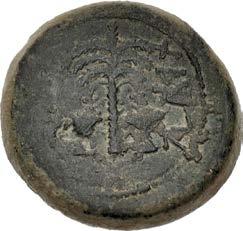
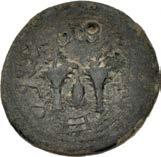

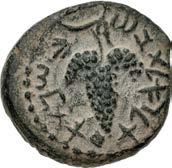


From the DMS Collection. Ex Harlan J. Berk, Ltd. inventory cc78051 (2013).
387. JUDAEA,

R8 – this coin); Meshorer 230a (same dies as illustration); Hendin 6416; Bromberg 83 (same dies); Shoshana I 20262 (same obv. die); Sofaer 31 (same obv. die); Spaer 190. Minor doubling, some roughness. EF. ($7500)
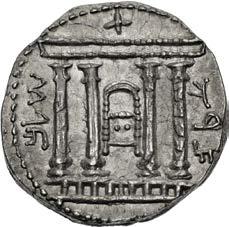
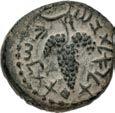
Ex J. Samel Collection (Künker 334, 17 March 2020), lot 2402 (since cleaned).

388. JUDAEA, Bar Kochba Revolt. 132-135 CE. AR Sela – Tetradrachm (27mm, 14.61 g, 1h). Dated year 2 (133/4 CE). Façade of the Temple at Jerusalem; showbread table within, star above, 3∑o2C (“Shim‘on” in Hebrew) at sides / Bundle of lulav; etrog to left, L!RC¥ RHL @C (“Y(ear) 2 of the freedom of Israel” in Hebrew) around. Mildenberg 38 (O8’’/R27); Meshorer 233; Hendin 6417; BMC 3 (same dies); Bromberg 95 (same dies [but before obv. die modified]); Pozzi 3080 (same dies); Shoshana I 20276 (same dies); Sofaer 35 (same dies); Spaer 192. Light iridescent tone, underlying luster. Choice EF. Exceptional for issue. ($6000)
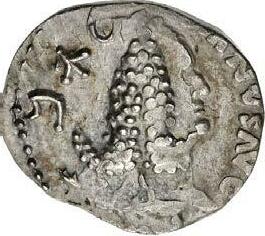










From the JTB Collection. Ex Goldberg 90 (2 February 2016), lot 3018.
389. JUDAEA, Bar Kochba Revolt. 132-135 CE. AR Zuz – Denarius (20.5mm, 3.23 g, 12h). Dated year 2 (133/4 CE). #⁄o2C (“Shim‘on”

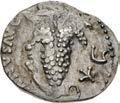
From
390.
From the DMS Collection. Ex Pegasi Numismatics inventory 11100316 (2011).
391. JUDAEA, Bar Kochba Revolt. 132-135 CE. AR Zuz – Denarius (18.5mm, 3.30 g, 7h). Undated, attributed to year 3 (134/5 CE). Grape bunch on vine tendril; 3∑o2C (“Shim‘on” in Hebrew) around / Two upright trumpets; pellet between, 2LC∑R¥ ¡∑RHL (“For the freedom of Jerusalem” in Hebrew, a few letters retrograde) around. Mildenberg 200 (O24/R128); Meshorer 277; Hendin 6458; Bromberg 533 (same dies); Shoshana I 20448 (same dies); Sofaer 139 (same dies); cf. Spaer 230–2; SNG ANS 558 (same dies). In NGC encapsulation 6327321-010, graded MS, Strike: 4/5, Surface: 3/5, overstruck. ($1500)

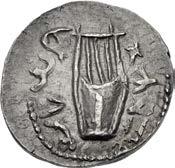

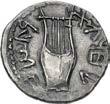





Ex New England Collection.
392. JUDAEA, Bar Kochba Revolt. 132-135 CE. AR Zuz – Denarius (17.5mm, 2.63 g, 6h). Irregular issue. Undated, attributed to year 3 (134/5 CE). Grape bunch on vine tendril; ∑o2C (“Shim‘o” in Hebrew) around / Elongated kithara; 2LC∑R ¡∑RHL (sic) (“For the freedom of Jerusalem” in Hebrew) around. Mildenberg 233 corr. (O24/R139; second lamed not missing on rev.); cf. Meshorer 275; Hendin 6462c; cf. Bromberg 547; Shoshana I 20499 = SRM 130 (this coin); Sofaer –; Spaer –. Toned, light roughness, deposit on reverse. Good VF. Extremely rare, and superior to the sole example in Mildenberg. ($5000)


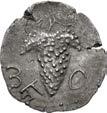

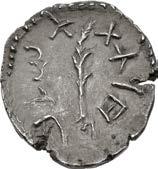
From the Kenneth S. Abramowitz Collection. Ex Shoshana Collection (Part I, Heritage 3003, 8 March 2012), lot 20499 (hammer $7000).
393. JUDAEA, Bar Kochba Revolt. 132-135 CE. AR Zuz – Denarius (19mm, 3.24 g, 12h). Irregular issue. Undated, attributed to year 3 (134/5 CE). ∑3o2C (“Shim‘on” in retrograde Hebrew) irregularly arranged within wreath / Elongated kithara; 2LCR ¡∑RHL (sic) (“For the freedom of Jerusalem” in Hebrew) around. Mildenberg 241 (O38/R158); Meshorer 273b (same dies); cf. Hendin 6451; cf. Bromberg 549 (same dies); Shoshana I 20414 (this coin); Sofaer –; Spaer –. Lightly toned, traces of undertype. EF. Extremely rare. ($4000)

From the Kenneth S. Abramowitz Collection. Ex Shoshana Collection (Part I, Heritage 3003, 8 March 2012), lot 20414 (hammer $5500); Leu 91 (10 May 2004), lot 410.
From
S.
395. JUDAEA, Bar Kochba Revolt. 132-135 CE. AR Zuz – Denarius (18.5mm, 3.37 g, 7h). Irregular issue. Undated, attributed to year 3 (134/5 CE). Grape bunch on vine tendril; 3∑o2C (“Shim‘on” in Hebrew) around / Two upright trumpets; pellet between, 2LC∑R¥ ¡∑RHL (“For the freedom of Jerusalem” in Hebrew) around. Mildenberg 252.2 (O45’/R168) = Shoshana I 20453 = Bromberg 222 (this coin); Meshorer 278c (this coin illustrated); Hendin 6458a; Sofaer –; Spaer –. Lightly toned, traces of undertype. EF. Extremely rare. ($4000)

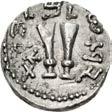




From the Kenneth S. Abramowitz Collection. Ex Shoshana Collection (Part I, Heritage 3003, 8 March 2012), lot 20453 (hammer $5000); Abraham Bromberg Collection (Part I, Superior, 5 December 1991), lot 222; El Fawar 1978 Hoard (Mildenberg no. 26).
396. JUDAEA, Bar Kochba Revolt. 132-135 CE. Æ (23.5mm, 15.75 g, 6h). Irregular issue. Undated, attributed to year 3 (134/5 CE). Palm tree with two bunches of dates; 3[∑]o2C (“Shim‘on” in Hebrew) across field / Grape leaf; LC∑ ¡RH[...] (“For the freedom of Jerusalem” in Hebrew, with some letters missing) around. Mildenberg 211 var. (O–/R48 [unlisted obv. die]); Meshorer 293; Hendin 6464a; Bromberg 270; Shoshana II 20295; Sofaer 155; Spaer 253. Earthen dark green-brown patina. Good VF. ($500)


From the DMS Collection. Ex Harlan J. Berk, Ltd. inventory cc75465 (2013).
The obverse die used for this coin is nearly identical to Mildenberg’s O43, used on his die combination 211, such that it may be from an earlier die state.




397.

399. PHILISTIA (PALESTINE), Uncertain mint. Mid 5th century-333 BC. AR Obol (12mm, 0.67 g, 3h). Bearded head facing half-left, wearing oriental headdress / Rider, holding [whip] in extended right hand, left hand on rein, dismounting from horse advancing right; all in dotted square within incuse square. Gitler & Tal XXV.3O; HGC 10, –. Toned, edge splits, usual die break on reverse. Good VF. Very rare. ($1500)
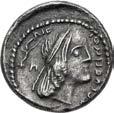

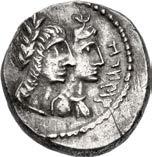


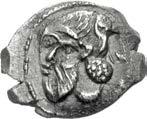


400. PHILISTIA (PALESTINE), Uncertain mint. Mid 5th century-333 BC. AR Hemiobol (7.5mm, 0.23 g, 5h). Head of female right, of oriental style / Head of Persian great king right in dotted square within incuse square. Unpublished in the standard references. Toned, light deposits. VF. Very rare. ($1000)

401 402
401. NABATAEA. Malichos I. Circa 59/8-30 BC. Quarter Shekel – “Drachm” (16mm, 3.47 g, 12h). Petra mint. Dated RY 28 (33/2 BC). Diademed head right; e (W[?] in Nabataean) / wT∫n klm Aklm uklm (MLKW MLK’ MLK NBṬW in Nabataean = Malichos the King, King of the Nabataeans), eagle standing left; 116ss (Š[NT] and date in Nabataean) across field. CN 16; Meshorer, Nabataea –; Schmitt-Korte II –; Hoover & Barkay 16 = Huth 46; cf. HGC 10, 682; cf. DCA 958 (didrachm). Lightly toned, minor roughness, light cleaning marks. Good VF. Very rare. ($3000)

402. NABATAEA. Obodas II, with Hagaru I. Circa 30-9 BC. AR Quarter Shekel – “Drachm” (18mm, 4.68 g, 12h). Petra mint. Dated RY 16 (15/4 BC). Jugate diademed and draped busts of Obodas and Hagaru right; h (Nabataean Ḥ) to left / eT∫n r¬m tr∫a (‘BDT MLK NBṬW in Nabataean = Obodas King of the Nabataeans), diademed and draped bust of Obodas right; h (Nabataean Ḥ) to inner left, 160 tn! (ŠNT 16 in Nabataean = year 16 [date]) at end of legend to left. CN 54; Barkay, King 35; Meshorer, Nabataea, Sup. 3; DCA 965; CNG E-500, lot 429 corr. (date; same rev. die). Toned, some roughness, struck with broken obverse die, die break on reverse. Good VF. ($2000)
403. NABATAEA. Aretas IV, with Huldu. Circa 9/8 BC-AD 40. AR Sela’ – “Drachm” (16mm, 4.72 g, 12h). Contemporary imitation(?). Laureate head right; blundered legend around / Jugate busts right of Aretas, laureate, and Huldu, diademed, draped, and wearing Isis crown; blundered legend to right, [date to left?]. Unpublished, but cf. CN 111 and 125 for similar. Lightly toned, off center, trace deposits, a few scratches. Good VF. ($2000)
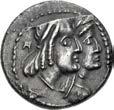





404. NABATAEA. Malichos II, with Shuqailat II. AD 40-70. Æ (15mm, 2.58 g, 12h). Petra mint. Dated RY 4 (AD 43/4). Jugate busts right of Malichos, laureate, and Shuqailat, laureate and draped; ! (Š in Nabataean [= Shuquailat]) / Crossed cornucopias; uklm (MLKW in Nabataean [= Malichos]) above ¡ (4 in Nabataean [= date]) above 9q!/[tÒ] (ŠQY/[LT] in Nabataean [= Shuquailat]) in two lines above and below cornucopias. Al-Qatanani 218 (this coin); otherwise, unpublished. Earthen dark green patina, irregular flan, flan preparation marks, light cleaning scratches on reverse. VF. Apparently unique. ($400)


405. ARABIA, Northwestern. Lihyan Circa 350-250 BC. AR Drachm (15mm, 4.00 g, 12h). Imitating Athens. Head of Athena right, with frontal eye, wearing earring, necklace, and crested Attic helmet; o (Aramaic ‘) before crest / Incuse owl standing left, head facing; uncertain object to right (head of ram downward?), uncertain Aramaic legend to left; all within incuse square. Huth, Athenian, fig. 6, c (this coin); cf. Huth 35 (rev. type right, slightly different legend). Toned, die break on reverse. Good VF. Extremely rare. ($1000)
From the S & S Collection. Ex Sternberg XIII (17 November 1993), lot 276. Lot includes a Joel L. Malter ticket marked lot 14.


406. ARABIA, Southern. Ma’in (Minaia)(?). Circa 250-150 BC. AR BLṬT – “Tetradrachm” (27mm, 15.14 g, 9h). Imitating Athens. Stylized helmeted head of Athena right / Owl standing right, wings folded; stylized olive spray and crescent to left, EQd downward to right. Huth 158 = M. Huth, “The ‘folded flan’ coinage





p. 85, I.
From the Jonathan Kagan Collection.
This fascinating coin of derivative Athenian type was struck on a folded flan of another coin, and was originally attributed by Huth (1998) to a mint in eastern Arabia, where all of the six then-extant examples had been found. The discovery of the al-Jawf hoard in 2002, however, definitively changed his view of this intriguing coinage. In his analysis of the hoard (in CCK), Huth determined that all of the previous six coins, and those found in the hoard, were struck from the same mint, in three phases that employed increasingly simplified methods. In the first phase, the coins were struck on previous tetradrachms that were folded over twice, forming a triangular shaped flan upon which derivative Athenian types were struck. The second phase consisted of coins struck on previous coins that had only been folded over once, forming a semicircular shaped flan (the present coin is the only known example from this phase). Finally, in the third phase, the host tetradrachms were cut into two halves that were then each folded once, then both halves were placed upon each other and joined by hammering, resulting in a triangular shape. The identification of the undertype used for this series in uncertain. While Huth originally surmised that Alexanders were the common host coin, his analyis of the al-Jawf hoard suggested that this was not likely. Though the question of the undertype remains unresolved, the hoard provided strong evidence that this series was not of eastern Arabian origin, but rather from a mint in the region of Wadi al-Jawf, in the Minaian trading sphere.
407. PERSIA, Achaemenid Empire. temp Darios I. Circa 520-505 BC. AR Siglos (13.5mm, 5.34 g). Lydo-Milesian standard. Sardes mint. Half-length bust of Persian king or hero right, wearing kidaris and kandys, holding bow in left hand, arrows in right / Incuse punch. Carradice Type I (pl. XI, 10); Meadows, Administration 318; BMC Arabia pl. XXVII, 25; Sunrise 17. Toned, only a hint of the usual granularity. Good VF. Well centered. Exceptional for issue. ($3000)
Ex Heritage 3076 (5 September 2019), lot 30165.
408. PERSIA, Achaemenid Empire. temp Darios I to Xerxes I. Circa 505-480 BC. AV Daric (14mm, 8.43 g, 12h). LydoMilesian standard. Sardes mint. Persian king or hero, wearing kidaris and kandys, quiver over shoulder, in kneeling-running stance right, drawing bow / Incuse punch. Carradice Type II (pl. XI, 11); Meadows, Administration 319; BMC Arabia –; Sunrise 19. Well centered. In NGC encapsulation 3763166-002, graded Ch MS★, Strike: 5/5, Surface: 5/5. ($15,000)
409. PERSIA, Achaemenid Empire. temp Darios I to Xerxes I. Circa 505-480 BC. AR Siglos (13.5mm, 5.35 g). LydoMilesian standard. Sardes mint. Persian king or hero, wearing kidaris and kandys, quiver over shoulder, in kneeling-running stance right, drawing bow / Incuse punch. Carradice Type II (pl. XI, 12); Meadows, Administration 320; BMC Arabia pl. XXVII, 23; Sunrise 21. Attractively toned, typical granularity. Good VF. ($750) Ex Pars Coins inventory PCW-A399 (ND).
410. PERSIA, Achaemenid Empire. temp Xerxes I to Darios II. Circa 485-420 BC. AV Daric (13.5mm, 8.30 g). LydoMilesian standard. Sardes mint. Persian king or hero, wearing kidaris and kandys, quiver over shoulder, in kneeling-running stance right, holding spear and bow / Incuse punch. Carradice Type IIIb, Group A/B (pl. XIII, 27); Meadows, Administration 321; BMC Arabia pl. XXIV, 26; Sunrise 24. Trace deposits, a little die wear. Good VF. ($1500)
411. PERSIA, Achaemenid Empire. temp Xerxes I to Darios II.
Circa 485-420 BC. AV Daric (13mm, 8.30 g). LydoMilesian standard. Sardes mint. Persian king or hero, wearing kidaris and kandys, quiver over shoulder, in kneeling-running stance right, holding spear and bow / Incuse punch. Carradice Type IIIb, Group A/B (pl. XIII, 27); Meadows, Administration 321; BMC Arabia pl. XXIV, 26; Sunrise 24. Slight die wear and tiny scuff on obverse. Good VF. ($1500)







Ex Triton XVI (8 January 2013), lot 578.
412. PERSIA, Achaemenid Empire. temp Xerxes I to Darios II. Circa 485-420 BC. AR Siglos (15mm, 5.53 g). LydoMilesian standard. Sardes mint. Persian king or hero, wearing kidaris and kandys, quiver over shoulder, in kneeling-running stance right, holding spear and bow / Incuse punch. Carradice Type IIIb A/B (pl. XII); Meadows, Administration 322; BMC Arabia pl. XXV, 17. Lightly toned, trace deposits, light scrape on reverse. Good VF. Well centered. ($300)
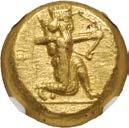







413. PERSIA, Achaemenid Empire. temp. Darios II to Artaxerxes II. Circa 420-375 BC. AV Daric (16mm, 8.33 g). Lydo-Milesian standard. Sardes mint. Persian king or hero, wearing kidaris and kandys, quiver over shoulder, in kneelingrunning stance right, holding spear and bow / Incuse punch. Carradice Type IIIb, Group C (pl. XIV, 42); cf. Meadows, Administration 323; BMC Arabia pl. XXV, 12; Sunrise 28. Underlying luster. Near EF. ($2000)
From the DMS Collection. Ex Pegasi Numismatics XXXVI (23 May 2017), lot 197.
414. PERSIA, Achaemenid Empire. temp Darios II to Artaxerxes II. Circa 420-375 BC. AV Daric (13mm, 8.31 g, 12h). Lydo-Milesian standard. Sardes mint. Persian king or hero, wearing kidaris and kandys, quiver over shoulder, in kneeling-running stance right, holding horizontal dagger in right hand, bow in left / Incuse punch. Cf. Carradice Type IV B (type unlisted for gold); Sunrise –; Adams I 110. Well centered. In NGC encapsulation 2400224-006, graded MS, Strike: 3/5, Surface: 5/5. ($7500)

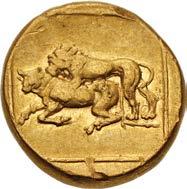




415. PERSIA, Alexandrine Empire. Mazaios. Satrap of Babylon, circa 331-328 BC. AV Double Daric (19.5mm, 17.07 g, 9h). Baal seated left, head and torso facing, holding scepter in right hand, grain ear and grape bunch on vine in left, upon which an eagle, wings folded, stands right / Lion left, grasping the back of a bull collapsing left, biting into its neck; all in linear square. F. Holt & O. Bopearachchi, The Alexander Medallion (2011), note 106; ibid. figs. 51–2 var. = Miho Museum, Treasures of Ancient Bactria (2002), 44 a–b var. (rev. type right); CNG 117, lot 322; Heritage 3073, lot 30206. For Mazaios’ Cilician silver prototype, cf. SNG Levante 100–6, and for similar local issues of the same type struck contemporaneously with this issue, cf. SNG BN 352–3. Slightly weak strike on high points, some minor marks. VF. Very rare. ($20,000)


From the Melinda Collection.
This extraordinary gold issue, unknown until the discovery of two examples in the Mir Zakah II deposit, bears the familiar types used by Mazaios as satrap of Cilicia for his silver staters, but without the usual legend and monograms. Mazaios was appointed satrap of Cilicia about 361 BC, and the region known as ‘Across the River’ (modern Syria, Lebanon, and Israel) was later added to his domain. In 331 BC, as Alexander marched into the heart of the Persian Empire, Mazaios at first led a spirited resistance, then abruptly surrendered Babylon to him and switched sides. Alexander rewarded Mazaios by retaining him as governor, a position he held until his death in 328 BC. Alexander made Babylon one of his most important mints, where a large quantity of regular ‘imperial’ coinage was struck. Babylon also produced a substantial group of local coinages, and it is among these that the present type is to be placed. Persian gold was routinely issued without legend, as were many of Mazaios’ standard double darics of the ‘running king’ type (MIG Type 14 = BMC Persia XX, 1). Perhaps it was an initial emergency issue that was later superseded, or perhaps it was a local variation for a special purpose.


416. PERSIA, Alexandrine Empire. Mazaios. Satrap of Babylon, circa 331-328 BC. AV Double Daric (19mm, 17.15 g, 3h). Baal seated left, head and torso facing, holding scepter in right hand, grain ear and grape bunch on vine in left, upon which an eagle, wings folded, stands right / Lion left, grasping the back of a bull collapsing left, biting into its neck; all in linear square. F. Holt & O. Bopearachchi, The Alexander Medallion (2011), note 106; ibid. figs. 51–2 var. = Miho Museum, Treasures of Ancient Bactria (2002), 44 a–b var. (rev. type right); CNG 117, lot 322; Heritage 3073, lot 30206. For Mazaios’ Cilician silver prototype, cf. SNG Levante 100–6, and for similar local issues of the same type struck contemporaneously with this issue, cf. SNG BN 352–3. A little off center, minor flan flaws. Good VF. Very rare. ($20,000)

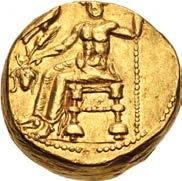
417. PERSIA, Alexandrine Empire. temp Stamenes – Seleukos. Satraps of Babylon, circa 328/3-311 BC. AV Double Daric (19.5mm, 16.71 g). Babylon mint. Persian king or hero, wearing kidaris and kandys, quiver over shoulder, in kneelingrunning stance right, holding dagger in right hand, bow in left; satrapal bonnet to left / Patterned incuse punch. Carradice Type IV Late (pl. XV, 54 var. [no bonnet]); Meadows, Administration –; BMC Arabia pl. XX, 1 var. (same); Sunrise 38 var. (same); CNG 120, lot 494 (same die and punch [hammer $38,000]); CNG 106, lot 516 corr. (bonnet not noted). Some flatness to strike. Near VF. Extremely rare with bonnet. ($5000)


Ex Stack’s Bowers Galleries (5 August 2020), lot 20078; Classical Numismatic Group 112 (11 September 2019), lot 364 (erroneously attributed to Dareios III).
Carradice lists this type with all the late double darics that he attributes as Alexandrine issues. Nicolet-Pierre, in her article on the Alexandrine gold and silver at Babylon, though, does not mention any Type IV Late double darics, only pieces similar to Type III, where the king/hero holds a spear, and all include control marks. The style of this issue is closer to the standard darics of this type that Carradice gives to the time of Artaxerxes II to Darios III. Thus, it is possible that this was a very late, if not the last, Achaemenid issue, just prior to the defeat of Darios III. However, some have no control marks, as the Achaemenid darics, while the present issue has a control mark that is known on the double darics struck under Alexander. As such, it is most likely that this issue was the among the very earliest of those struck at Babylon by the Alexandrine administration.

418. PERSIA, Alexandrine Empire. temp. Stamenes – Seleukos. Satraps of Babylon, circa 328/3-311 BC. AV Daric (15mm, 8.33 g). Babylon mint. Persian king or hero, wearing kidaris and kandys, quiver over shoulder, in kneeling-running stance right, holding transverse spear in right hand, bow in left; satrapal bonnet to left / Patterned incuse punch. Nicolet-Pierre 12; Sunrise 159; Münzen und Medaillen AG XXV, lot 479; Triton XVIII, lot 24 = Triton XVI, lot 581 (same rev. punch). Underlying luster, small lamination in field on obverse, a few light scrapes. VF. Very rare. ($3000)
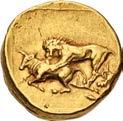



From the Kenneth S. Abramowitz Collection.
419. PERSIA, Alexandrine Empire. temp. Stamenes – Seleukos. Satraps of Babylon, circa 328/3-311 BC. AV Daric (17mm, 8.40 g). Babylon mint. Persian king or hero, wearing kidaris and kandys, quiver over shoulder, in kneeling-running stance right, holding spear in right hand, bow in left; [control mark to upper left?] / Patterned incuse punch. Cf. Nicolet-Pierre 1 and 12 (for similar punch and flan). Small edge split, a little off center on obverse, light scratches. Good VF. Very rare. ($5000)


420.
PTOLEMAIC KINGS of EGYPT. Ptolemy I Soter. As satrap, 323-305/4 BC. AV Stater (17.5mm, 8.50 g, 11h). In the name and types of Alexander III of Macedon. Memphis mint. Struck circa 322/1 BC. Head of Athena right, wearing crested Attic helmet decorated with serpent, single-pendant earring, and pearl necklace / [Ŭ]E$Å@droU, Nike standing left, holding wreath in extended right hand and cradling stylis in left arm; rose in left field, E-U across lower field. CPE 7; Svoronos –; Zervos Issue 79A, dies 739/– (unlisted rev. die); Price 3965; SNG Copenhagen –. Trace deposits, a little die wear, flan flaw on reverse. Good VF. Very rare, only three in Pella, three in CoinArchives, two in the ANS photofile. ($3000)
From the GTP Collection. Ex Antykwariat Numizmatyczny 7 (23 May 2015), lot 4.




421.
PTOLEMAIC KINGS of EGYPT. Ptolemy I Soter. As satrap, 323-305/4 BC. AR Tetradrachm (27mm, 17.09 g, 12h). In the name of Alexander III of Macedon. Memphis or Alexandreia mint. Struck circa 320/19-314/3 BC. Diademed head of the deified Alexander right, wearing elephant skin / ŬE$Å@droU, Zeus Aëtophoros seated left; thunderbolt in left field, , below throne. CPE 33; Svoronos 22; Zervos Issue 13, dies 251/– (unlisted rev. die); SNG Copenhagen 11; Noeske –; Athena Fund I 77 (this coin). Lightly toned. EF. Struck in high relief from dies of exemplary style. ($15,000)


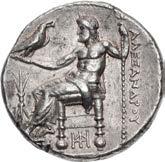
Ex Nomos 23 (30 November 2021), lot 182 (hammer 20,000 CHF); collection of a Northern California Gentleman (Triton XXII, 8 January 2019), lot 400; Nomos 19 (17 November 2019), lot 222; Athena Fund (Part I, Sotheby’s Zurich (26 October 1993), lot 77; Numismatic Fine Arts XXVII (4 December 1991), lot 85; Christie’s New York (2 May 1989), lot 760; Kovacs FPL 26 (July 1987), no. 63.
Ptolemy I Soter, the son of a Macedonian nobleman, was a friend and intimate of Alexander III the Great from boyhood and accompanied him on his great career of conquest, from 333-323 BC. Upon Alexander’s death in 323 BC, Ptolemy was granted the prized satrapy of Egypt, the richest of the formerly Persian provinces. Alone among the Diadochi (”successors”), he was content with his sphere of influence and did not risk all to succeed Alexander. However, he was not above using the great conqueror’s image and reputation to secure his own position. He hijacked Alexander’s funeral cortege as it was proceeding back to Macedon and had his embalmed corpse formally interred at Memphis in Egypt; later the body was relocated to a splendid mausoleum in Alexandria. Ptolemy’s early coinage is modeled on that of Alexander and carries the conqueror’s image and name, as seen on this remarkable tetradrachm, which shows Alexander wearing an elaborate elephant-skin headdress in honor of his victories in India. Ptolemy declared his own kingship in 305/4 BC and was the only one of Alexander’s Successors to die peacefully, in his bed, in 282 BC, having founded a dynasty that would last three centuries.
422.
PTOLEMAIC KINGS of EGYPT. Ptolemy I Soter. As satrap, 323-305/4 BC or king, 305/4-282 BC. AR
Tetradrachm (28.5mm, 15.59 g, 12h). Ptolemaic standard. In the name of Alexander III of Macedon. Alexandreia mint. Struck circa 306-300 BC. Diademed head of the deified Alexander right, wearing elephant skin, aegis around neck with tiny d in scales / ŬE$Å@droU, Athena Alkidemos advancing right, brandishing spear in right hand and wearing shield on extended left arm; to right, helmet, (, and eagle standing right on thunderbolt. CPE 69; Svoronos 162; Zervos Issue 28, dies 455/c (this coin referenced); SNG Copenhagen 29. Deep iridescent tone, scratches under tone, traces of undertype on reverse. Good VF. ($2000)
From the S & S Collection. Ex Malter XXXIX (2 April 1989), lot 512; G. Hirsch XXXII (22 October 1962), lot 2483.
423.
PTOLEMAIC KINGS of EGYPT. Ptolemy I Soter. As satrap, 323-305/4 BC or king, 305/4-282 BC. AR
Tetradrachm (28mm, 15.71 g, 12h). Ptolemaic standard. In the name of Alexander III of Macedon. Alexandreia mint. Struck circa 306-300 BC. Diademed head of the deified Alexander right, wearing elephant skin, aegis around neck with tiny d in scales / ŬE$Å@droU, Athena Alkidemos advancing right, brandishing spear in right hand and wearing shield on extended left arm; to right, helmet, (, and eagle standing right on thunderbolt. CPE 69; Svoronos 162; Zervos Issue 28, dies 492/a; SNG Copenhagen 29; McClean 9766 (same dies). Light iridescent tone. Good VF. ($2000)

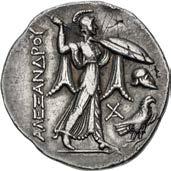
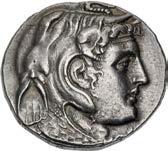

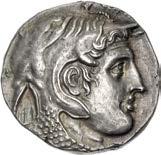

Ex Classical Numismatic Group 50 (23 June 1999), lot 949.
424.
PTOLEMAIC KINGS of EGYPT. Ptolemy I Soter. As satrap, 323-305/4 BC, or king, 305/4-282 BC. AR Tetradrachm (25mm, 15.75 g, 1h). Ptolemaic standard. In the name of Alexander III of Macedon. Alexandreia mint. Struck circa 306-300 BC. Diademed head of the deified Alexander right, wearing elephant skin, aegis around neck with tiny d in scales / ŬE$Å@droU, Athena Alkidemos advancing right; to right, ’, Corinthan helmet right, and eagle standing right on thunderbolt. CPE 70; Svoronos 164; Zervos Issue 29, dies 518/c; SNG Copenhagen –; Noeske –; SNG Lockett 3393; Weber 8226. Toned, traces of undertype. EF. Well centered. ($2000)
From the North River Collection. Ex RCM Collection (Triton XVI, 8 January 2013), lot 587; Triton VII (13 January 2004), lot 372.

425.
PTOLEMAIC KINGS of EGYPT. Ptolemy I Soter. As satrap, 323-305/4 BC or king, 305/4-282 BC. AR Tetradrachm (28mm, 15.77 g, 11h). Ptolemaic standard. In the name of Alexander III of Macedon. Alexandreia mint. Struck circa 306-300 BC. Diademed head of the deified Alexander right, wearing elephant skin, aegis around neck with tiny d in scales / ŬE$Å@droU, Athena Alkidemos advancing right, brandishing spear in right hand and wearing shield on extended left arm; to right, helmet, d5, and eagle standing right on thunderbolt. CPE 72; Svoronos 169; Zervos Issue 31, dies 531/b; SNG Copenhagen 30; BMC 26. Lightly toned, hairline flan crack, some die wear on obverse. Near EF. ($2000)


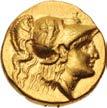





From the GTP Collection. Ex CNG inventory 419724 (December 2015).
426.
PTOLEMAIC KINGS of EGYPT. Ptolemy I Soter. As satrap, 323-305/4 BC. AV Stater (17mm, 8.54 g, 3h). In the name and types of Alexander III. Tyre mint. Dated RY 33 of ‘Ozmilk (317/6 BC). Head of Athena right, wearing crested Corinthian helmet decorated with griffin, and pearl necklace / ŬExÅ@dro[U], Nike standing left, holding wreath in extended right hand and cradling stylis in left arm; below left wing, )o (Phoenician ‘K [= ‘Ozmilk]) above [‹‹‹ 0]( (Phoenician date [33]). Price 3284A; Newell, Dated 36, dies N/α; ANS inv. 1944.100.35275 (same dies); Berlin obj. no. 18253623 (same dies). Underlying luster, scratches, minor die wear, a couple of edge marks, nick on reverse. Good VF. Very rare, only two examples (the ANS and Berlin coins) cited by Newell, just one in CoinArchives (which is also the only example in the ANS Photofile). ($2000)
From the Kenneth S. Abramowitz Collection.
427. PTOLEMAIC KINGS of EGYPT. Ptolemy I Soter. As satrap, 323-305/4 BC. AV Stater (18mm, 8.53 g, 10h). In the name and types of Alexander III. Tyre mint. Dated RY 33 of ‘Ozmilk (317/6 BC). Head of Athena right, wearing crested Corinthian helmet decorated with griffin, and pearl necklace / ŬExÅ@dro[U], Nike standing left, holding wreath in extended right hand and cradling stylis in left arm; below left wing, )o (Phoenician ‘K [= ‘Ozmilk]) above [[‹]‹‹ 0( (Phoenician date [33]). Price 3284A; Newell, Dated 36, dies N/– (unlisted rev. die); ANS inv. 1944.100.35275 (same obv. die); Berlin obj. no. 18253623 (same obv. die). Underlying luster, weakly struck in center, scrape on obverse, trace deposits and slightly off center on reverse. Good VF. Very rare, only two examples (the ANS and Berlin coins) cited by Newell, just one in CoinArchives (which is also the only example in the ANS Photofile). ($2000)
From the Kenneth S. Abramowitz Collection.
It is possible that this coin may actually be dated RY 32 of ‘Ozmilk, for which there are no staters published. Obverse die N was used for examples dated RY 30 and 33, so it would have been available for any staters struck with RY 32. However, as the date is right on the edge of the coin, and no other examples from the same reverse die are known, it is uncertain whether the date is 32, or 33 with the final digit off the flan.
428.
PTOLEMAIC KINGS of EGYPT. Ptolemy I Soter. 305/4-282 BC. AV Tetarte – ‘Triobol’ (10mm, 1.79 g, 12h). Alexandreia mint. Struck circa 294-285 BC. Diademed head right, wearing aegis around neck / ∫Å%5¬EW% ∏to¬EÂÅ5oU, eagle standing left on thunderbolt; P to left. CPE 129; Svoronos 197; SNG Copenhagen 45; Boston MFA 2262. In NGC encapsulation 6156597-001, graded Ch AU★, Strike: 5/5, Surface: 4/5. An exceptional example for type. ($3000) Ex Heritage 3098 (18 January 2022), lot 33179.
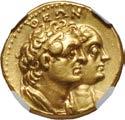

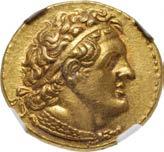




429. PTOLEMAIC KINGS of EGYPT. Ptolemy II Philadelphos, with Arsinöe II, Ptolemy I, and Berenike I. 285246 BC. AV Half Mnaïeion – ‘Tetradrachm’ (20mm, 13.81 g, 12h). Alexandreia mint. Struck circa 272-261/0 BC. Conjoined busts of Ptolemy II and Arsinöe II right; Ptolemy is diademed and draped, Arsinöe is diademed and veiled; ÅdE¬fW@ above, shield to left / Conjoined busts of Ptolemy I and Berenike I; Ptolemy is diademed and draped, Berenike is diademed and veiled; QEW@ above. CPE 314; Svoronos 604; Olivier & Lorber dies 31/– (unlisted rev. die); SNG Copenhagen 133; Adams III 2084; Boston MFA 2275; Dewing 2753-4; Noeske 38. Lustrous, light graffito. In NGC encapsulation 2400916-003, graded AU, Strike: 5/5, Surface: 3/5. ($3000)




430. PTOLEMAIC KINGS of EGYPT. Ptolemy II Philadelphos. 285-246 BC. AV Trichryson – ‘Pentadrachm’ (24mm, 17.87 g, 1h). Alexandreia mint. Struck circa 275/4-c. 272 BC. Diademed head of Ptolemy I right, wearing aegis around neck / ∫Å%5¬EW% ∏to¬EÂÅ5oU, eagle standing left on thunderbolt; to left, Ï above Gallic shield; 5 between legs. CPE 287; Svoronos 573; SNG Copenhagen –; Adams –; Boston MFA –; Dewing –; Kraay & Hirmer –; Noeske –. In NGC encapsulation 5784010-001, graded Ch AU, Strike: 5/5, Surface: 4/5. Very rare, only four in CoinArchives. ($20,000)
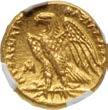
431.
PTOLEMAIC KINGS of EGYPT. Ptolemy II Philadelphos, with Arsinöe II, Ptolemy I, and Berenike I. 285246 BC. AV Mnaieion – ‘Oktadrachm’ (26mm, 27.74 g, 12h). Alexandreia mint. Struck circa 272-261/0 BC. Conjoined busts of Ptolemy II and Arsinöe II right; Ptolemy is diademed and draped, Arsinöe is diademed and veiled; ÅdE¬fW@ above, shield to left / Conjoined busts of Ptolemy I and Berenike I; Ptolemy is diademed and draped, Berenike is diademed and veiled; QEW@ above. CPE 313; Svoronos 603; Olivier & Lorber dies 18/68; SNG Copenhagen 132; Adams III 2083; Boston MFA 2274; Dewing 2752; Kraay & Hirmer 801; Noeske 37. Lustrous, a few light marks. Good VF. ($10,000)
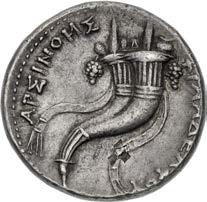
432.
PTOLEMAIC KINGS of EGYPT. Arsinoe II Philadelphos. Died 270/268 BC. AR Dekadrachm (34mm, 35.63 g, 12h). Alexandreia mint. Struck under Ptolemy II, circa 261/0-253/2 BC. Head right, with ram’s horn, veiled and wearing stephane; lotus-tipped scepter in background, Ç to left / År%5@o˙% f5¬ÅdE¬foU, double cornucopia with grape bunches hanging at sides, bound with fillet. CPE 341 (Ptolemy II); Svoronos 517; Troxell, Arsinoe, Group 3, p. 42 and pl. 4, 4 (same obv. die); SNG Copenhagen –; CNG E-452, lot 486 (same dies). Toned, light scratches, a few minor flan flaws, banker’s mark(?) on reverse. Good VF. Very rare, Troxell records only four specimens, only the CNG E-452 coin in CoinArchives. ($10,000)
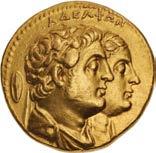
From the S & S Collection. Ex Virginia Ruzicka Collection (Malter XXVIII, 8 December 1984), lot 296.
Arsinoe II, daughter of Ptolemy I and Berenike I, was born in 316 BC. Her early life saw her married off to Lysimachos of Thrace at the age of 15 and then to her half-brother, the brutal Ptolemy Keraunos. She conspired against the latter and was forced to flee circa 280 BC to the protection of Egypt, ruled by her younger full brother, Ptolemy II. Her beauty, charm and intelligence utterly captivated Ptolemy, and, after eliminating his previous wife with an accusation of treason, Arsinoe married her brother, probably about 276 BC. Sibling marriage was traditional among Egyptian royalty but among the Greeks it was known only among deities; thus their union advanced the concept of rulers being worshipped as divinities. Though unscrupulous, Arsinoe proved a capable queen and co-ruler, taking charge of Egypt’s foreign affairs. Her death in 270 or 268 BC was marked by her full deification and a huge outpouring of gold and silver coinage bearing her veiled portrait. The ram’s horn just visible emerging from the veil is a further symbol of her deification, reminiscent of the horn of Ammon on images of the deified Alexander.

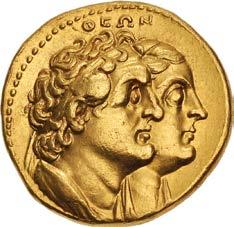


433.
PTOLEMAIC KINGS of EGYPT. Arsinoe II Philadelphos. Died 270/268 BC. AV Mnaïeion – ‘Oktadrachm’ (28mm, 27.73 g, 12h). Alexandreia mint. Struck under Ptolemy II, circa 252/1-250/49 BC. Head right with ram’s horn, veiled and wearing stephanos; lotus-tipped scepter in background, ˚ to left / År%5@o˙% f5¬ÅdE¬foU, double cornucopia, grape bunches hanging at sides, bound with fillet. CPE 390; Svoronos 475ε = BMC 10 (same dies); Olivier & Lorber dies 1/20; Troxell, Arsinoe, Group 3, p. 44 and pl. 7, 3 (same obv. die); SNG Copenhagen –; Adams –; Boston MFA 2268 (same obv. die); Pozzi 3223 (same obv. die). Lustrous, some faint scratches, minor edge bump. Good VF. ($10,000)


434.
PTOLEMAIC KINGS of EGYPT. Arsinoe II Philadelphos. Died 270/268 BC. AV Half Mnaïeion – ‘Tetradrachm’ (21.5mm, 14.04 g, 11h). Alexandreia mint. Struck under Ptolemy VI–VIII, circa 180-116 BC. Head right with ram’s horn, veiled and wearing stephane; lotus-tipped scepter in background, ˚ to left / År%5@o˙% f5¬ÅdE¬foU, double cornucopia, grape bunches hanging at sides, bound with fillet. Svoronos 1500; Olivier 3384 (D14/R21) = SNG Lockett 3446 = Bement 1860 (this coin); SNG Copenhagen –; BMC 40; Boston MFA –; Consul Weber 4511; Hirsch 1829; Gulbenkian 1085; Hunterian p. 391, 5; De Luynes 3599; Noeske –. In NGC encapsulation 5785794-004, graded Ch AU, Strike: 5/5, Surface: 2/5, smoothing. Two small cuts on obverse, visible in Bement and Lockett catalogs, previously repaired, but not noted on the NGC slab (the smoothed areas they note correspond to the repairs). ($20,000)

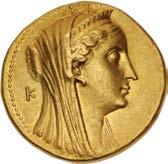

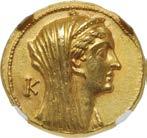


Ex Richard Cyril Lockett Collection (Greek Part IV, Glendining, 21 February 1961), lot 2828; Clarence S. Bement Collection (Part II, Naville VII, 23 June 1924), lot 1860, acquired from Sir Hermann Weber (†1918).
435. PTOLEMAIC KINGS of EGYPT. Ptolemy III Euergetes. 246-222 BC. Æ Oktobol (47.5mm, 85.10 g, 12h). Alexandreia mint. Series 4A. Head of Zeus-Ammon right, wearing tainia with basileion / ∫Å%5¬EW% ∏to¬EÂÅ5oU, eagle with closed wings standing right, head left, on thunderbolt; ¬ between legs. CPE B358; Svoronos 478; SNG Copenhagen 143; Noeske –; Weiser –. Dark brown patina. Good VF. Well centered and struck. ($750)
From the DMS Collection, purchased from Jonathan K. Kern, 8 January 2012. Ex CNG inventory 909259 (December 2011).

436. PTOLEMAIC KINGS of EGYPT. Ptolemy III Euergetes. 246-222 BC. Æ Drachm (44mm, 70.12 g, 12h). Alexandreia mint. Series 5B. Diademed head of Zeus-Ammon right / ∫Å%5¬EW% ∏to¬EµÅ5oU, eagle with closed wings standing left on thunderbolt; filleted cornucopia to left, ^ between legs. CPE B395; Svoronos 964; SNG Copenhagen 171–2; Noeske 117–9; Weiser 71. Brown surfaces, minor die shift on reverse. EF. Well centered on a broad flan, showing complete borders on both sides. ($1500)

437.
PTOLEMAIC KINGS of EGYPT. Ptolemy III Euergetes. 246-222 BC. AV Mnaieion – ‘Oktadrachm’ (26.5mm, 27.79 g, 11h). Posthumous issue under Ptolemy IV. Alexandreia mint. Struck circa 219-217 BC. Bust of the deified Ptolemy III right, wearing radiate diadem and aegis; trident over left shoulder, middle prong ends in a lotus finial / ∫Å%5¬EW% ∏to¬EÂÅ5oU, radiate and filleted cornucopia; d5 below. CPE 888; Svoronos 1117; Olivier & Lorber dies 3/7; SNG Copenhagen 196; BMC 103 (same dies); Bement 1851 (same dies); Boston MFA 2283; Kraay & Hirmer 803; Nanteuil 452 (same obv. die); Noeske 137; Pozzi 3239 (same obv. die); Weber 8264 (same obv. die). In NGC encapsulation 5785795-003, graded AU, Strike: 5/5, Surface: 2/5, Fine Style, edge marks, brushed. ($10,000)
438. PTOLEMAIC KINGS of EGYPT. Ptolemy III Euergetes. 246-222 BC. AV Mnaieion – ‘Oktadrachm’ (26mm, 27.78 g, 12h). Posthumous issue under Ptolemy IV. Alexandreia mint. Struck circa 219-217 BC. Bust of the deified Ptolemy III right, wearing radiate diadem and aegis; trident over left shoulder, middle prong ends in a lotus finial / ∫Å%5¬EW% ∏to¬EÂÅ5oU, radiate and filleted cornucopia; d5 below. CPE 888; Svoronos 1117; Olivier & Lorber dies 3/12 corr. (illustration switched with that of dies 3/11); SNG Copenhagen 196; BMC 103 (same obv. die); Bement 1851 (same obv. die); Boston MFA 2283; Kraay & Hirmer 803; Nanteuil 452 (same obv. die); Noeske 137; Pozzi 3239 (same obv. die); Weber 8264 (same obv. die). Underlying luster, a few faint hairlines, only a hint of the usual die rust on obverse, a couple of tiny die breaks on obverse. Good VF. ($10,000)
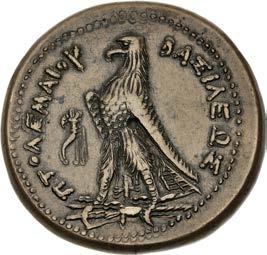





439.
PTOLEMAIC KINGS of EGYPT. temp. Ptolemy VI–VIII. Circa 180-116 BC. Æ (33mm, 26.76 g, 12h). Alexandreia mint. Series 7C. Head of Zeus-Ammon right, wearing tainia with basileion / ∫Å%5¬EW% ∏to¬EÂÅ5oU, two eagles with closed wings standing left on thunderbolt; cornucopia to left. Svoronos 1424B (Joint reign of Ptolemy VI and VIII); Faucher & Lorber Series 7C; SNG Copenhagen 308–10 (Joint reign of Ptolemy VI and Ptolemy VIII); Noeske 212–5 (Joint reign of Ptolemy VI and Ptolemy VIII). Even brown surfaces, minor double strike on reverse. Near EF. ($500)
From the DMS Collection, purchased from Jonathan K. Kern, 2003.
440. PTOLEMAIC KINGS of EGYPT. Ptolemy VIII Euergetes II (Physcon). 145-116 BC. AR Tetradrachm (24.5mm, 14.20 g, 12h). Paphos mint. Dated RY 54 (117/6 BC). Diademed head of Ptolemy I right, wearing aegis around neck / ∫Å%5¬EW% ∏to¬EµÅ5oU, eagle standing left on thunderbolt; to left, LNΔ (date) above wreath; ΠA to right. Svoronos 1532; Olivier 2282–8 (obv. die D385); Paphos Hoard 96–7 (obv. die 30); SNG Copenhagen 629; BMC 92 (same obv. die). Iridescent tone, short, light scratch under tone on obverse, minor deposit on reverse. EF. ($1500)


441. KYRENAICA, Barke. Circa 510-475 BC. AR Drachm (12.5mm, 2.90 g). Period I. Asiatic standard. Two pairs of silphion fruit set base-to-base; two branches with leaves between / Head of ram right; ∫År above; all within incuse square. SNG Copenhagen –; BMC p. clxvii, 2b; Hirsch 1857. Toned, rough and porous surfaces, edge chips. VF. Very rare. ($1000)
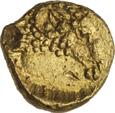








442. KYRENAICA, Barke. Circa 475-435 BC. AR Hemidrachm (12mm, 1.61 g, 3h). Period II. Asiatic standard. Silphion plant / Head of Zeus Ammon right; Å to right; all in dotted circular border within shallow incuse square with [∫-Å-r-˚ in corners]. SNG Copenhagen –; BMC –, but cf. p. clxxii for a discussion of issues with an isolated letter on the reverse; Gorny & Mosch 244, lot 389 (same obv. die). Toned, roughness, cleaning scratches/smoothing. Good VF. Extremely rare. ($500)


443. KYRENAICA, Barke. Circa 435-331 BC. AV Twentieth Stater (6.5mm, 0.43 g, 2h). Period III. Head of horse right / Head of ram right. Naville 261 = G. F. Hill, “Greek Coins Acquired by the British Museum in 1920” in NC 1921, 29; Naville 262 (Naville Collection); Adams I 115; Triton XXII, lot 430; otherwise unpublished in the standard references. Some minor marks and scratches, reverse slightly off center. Good VF. Extremely rare, only two in CoinArchives (the Adams and Triton XXII coins). ($1000)

444. KYRENAICA, Kyrene. Circa 510-490 BC. AR Drachm (12.5mm, 3.78 g). Period I.1.A. Asiatic standard. Silphion fruit / Incuse square with irregular lines. Buttrey, Catalogue –; SNG Copenhagen –; BMC 6 = Weber 8419. Some porosity. VF. Very rare. ($1000)

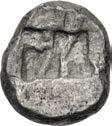





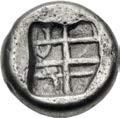

445. KYRENAICA, Kyrene. Circa 510-490 BC. AR Tetrobol(?) (12mm, 2.38 g). Period I.1.A. Asiatic standard. Silphion fruit / Incuse square with irregular lines. Buttrey, Catalogue –; SNG Copenhagen –; BMC p. xxii, 6a. Some porosity, light marks. VF. Very rare. ($1000)

446. KYRENAICA, Kyrene. Circa 490-475 BC. AR Drachm (12.5mm, 3.45 g, 12h). Period I.2. Asiatic standard. Head of lion facing; silphion fruit above / Head of griffin right in dotted square within incuse square. Buttrey, Catalogue –; SNG Copenhagen –; BMC p. XXVI, 21a; Boston MFA 1303. Lightly toned, granular surfaces, minor pitting, light scuff on reverse. VF. Very rare. ($2000)






447. KYRENAICA, Kyrene. Circa 331-322 BC. AV Tenth Stater (8mm, 0.84 g, 9h). Kyd(is), magistrate. Youthful head of Karneios left; ˚Ud to left, star to right / Head of female (Libya?) right. Naville 62 (same dies); SNG Copenhagen –; BMC 150; Hunterian 18; Jameson 2531; Traité III 1875, pl. XV, 20; Weber 8443 (all from the same dies). Edge marks. VF. ($1000)


448. KYRENAICA, Kyrene. temp. Ophellas. Ptolemaic governor, second reign, 312-308 BC. AV Tenth Stater (7mm, 0.78 g, 10h). The(upheides?), magistrate. Youthful head of Karneios left; [Q-E flanking neck] / Head of female (Libya?) left. Naville 145 (same dies); SNG Copenhagen 231 var. (no letters); BMC 213 (same dies). Edge scuffs. Good VF. Rare. ($1000)

449. KYRENAICA, Kyrene. temp. Ophellas. Ptolemaic governor, second reign, 312-308 BC. AV Tenth Stater (7.5mm, 0.81 g, 7h). Bearded head of Karneios right / Head of female (Libya?) right. Naville 151 (same dies); SNG Copenhagen –; BMC p. xcix, 214b = Traité III 1868 (same rev. die); Boston MFA 1341. Some roughness, struck with worn reverse die. Good VF. Very rare, only two examples noted by Naville (both in public collections: BN and The Hague), and just one in CoinArchives. ($1000)

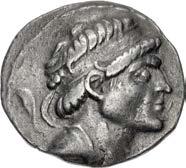

450. KINGS of PARTHIA. Arsakes X. 122-121 BC. AR Tetradrachm (32.5mm, 15.81 g, 12h). Seleukeia on the Tigris mint. Diademed and draped bust right; all within bead-and-reel border / ∫Å%5¬EW%>År%Å˚oU to left, E∏5fÅ@ oU%>f5¬¬E¬˙@o% to right, goddess enthroned left, holding Nike, who crowns her with wreath, in extended right hand and cornucopia in left; winged Tritoness forms base of her throne; tU and t in exergue. Sellwood 23.2 (Mithradates II); Sunrise 280; Shore –. Iridescent toning, some porosity and pitting. VF. ($2500)
451. KINGS of PARTHIA. Mithradates II. 121-91 BC. AR Tetradrachm (29mm, 15.63 g, 12h). Seleukeia on the Tigris mint. Struck circa 120/19-109 BC. Diademed bust left / ∫Å%5¬EW% to left, ;E˝Å¬o¨ above, År%Å˚o¨ to right, E∏5fÅ@o¨% below, archer (Arsakes I) seated right on omphalos, holding bow; palm to outer right; t¨ in exergue. Sellwood 24.4; Sunrise 284; Shore 67. Iridescent toning, some light marks and area of porosity, archer’s head weakly struck. Good VF. ($1000)
From the Pythagoras Collection.
452. KINGS of PARTHIA. Vologases V. Circa AD 191-208. AR Drachm (18mm, 3.83 g,




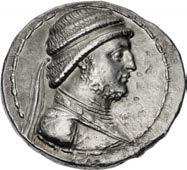
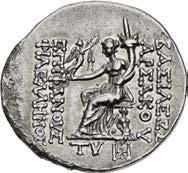
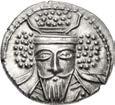

450 451 453 454
(31.5mm, 15.60 g, 12h). Posthumous issue under Apodakos. Charax-Spasinu mint. Dated SE 191 (122/1 BC). Diademed head right / [∫]Å%5¬EW% to right, [U]%∏Åo%5@oU to left, Herakles seated left on rock, holding club on knee; 6 to outer left, ÅJr (date) in exergue. Assar fig. 17; Alram 491; De Morgan 1 and pl. XL, 1 var. (date listed as SE 188, but illustration SE 190); Sunrise –; DCA 479. Iridescent toning, scattered marks, tiny edge split. VF. Overstruck on uncertain undertype. Very rare. ($1000)
453.
454. KINGS of CHARACENE. Apodakos. Circa 110/09-104/03 BC. AR Tetradrachm (31mm, 16.08 g, 12h). CharaxSpasinu mint. Dated SE 209 (104/3 BC). Diademed head right / ∫Å%5¬EW[%] to right, Å˝˝odÅ˚[oU] to left, Herakles seated left on rock, holding club on knee; i to outer left; œ% (date) in exergue. Alram 495 var. (year 203); De Morgan 2 and pl. XL, 3 var. (same); BMC –; Sunrise –; DCA 481. Find patina, hint of porosity, light marks. VF. Overstruck on uncertain Alexandrine undertype. ($1000)
455. KINGS of ELYMAIS. Kamnaskires III, with Anzaze. Circa 82/1-73/2 BC. AR Tetradrachm (29mm, 16.19 g, 12h). Seleukeia on the Hedyphon mint. Dated SE 233 (80/79 BC). Conjoined busts of Kamnaskires III, diademed and draped bust and wearing long beard and torque, and Anzaze, draped and wearing stephane and necklace, left; anchor symbol to right / 5G45GE∑5 above, ˚G;@G4˚55o[U] to right, ˚G5 5G45G54[4˙4] to left, 2@Z[2]Z˙5, Zeus-Belos enthroned left, holding in outstretched right hand Nike, standing right and holding wreath, and scepter in left; traces of ;G˚Ed∑@ to inner left; ˝2% (date) in exergue. van’t Haaff Type 7.1.1-1-2 (date unlisted); Alram 454 (date unlisted); Sunrise –. Traces of find patina, numerous cleaning marks, die rust and porosity, weak strike on reverse. Good VF. ($1000)





456. KINGS of PERSIS. Vādfradād (Autophradates) II. Early-mid 2nd century BC. AR Tetradrachm (25.5mm, 16.46 g, 10h). Istakhr (Persepolis) mint. Bearded head right, wearing diadem and kyrbasia adorned with eagle / Fire temple of Ahura-Mazda; above, half-figure of Ahura-Mazda; to left, Vādfradād standing right, bow before; to right, eagle standing left on standard; ! (’ in Aramaic) to inner righttraces of additional legend in exergue. van’t Haaff, Persis Type 546a (same obv. die as illustration) K&M 3/1 var. (no legend on rev. - same obv. die); Alram 546 var. (no legend on rev.); DeMorgan, pl. XXVIII, 7 and 10 var. (same); cf. BMC 1 (Darius[?]; for type); Sunrise –; MACW –; Roma XXI, lot 306 (same obv. die); Leu Web Auction 14, lot 648 (same obv. die); nomos 14, lot 172 (same obv. die); VAuctions 354/Pars Coins 10, lot 111 = VAuctions 350/Pars Coins 7, lot 169 (same dies); CNG 111, lot 441 (same obv. die). Deposits, hairline die break on reverse. EF. ($2000)
Ex Gorny & Mosch 228 (9 March 2015), lot 180.
457. KINGS of PERSIS. Uncertain king I. 2nd century BC. AR Drachm (16mm, 3.59 g, 9h). Istakhr (Persepolis) mint. Head right with close cropped beard and mark on cheek, wearing diadem and kyrbasia surmounted by eagle; no crescent on back of kyrbasia / Fire temple, Ahura-Mazda above; to left, king standing right, holding bow; to right, standard surmounted by eagle. Cf. van’t Haaff Type 547h (Vadfradad II); K&M –; cf. Alram 547; Sunrise –. Iridescent toning. EF. ($300)

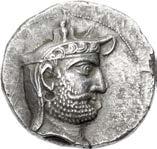


From the Dr. Robert Misbin Collection. Ex CNG inventory 72443 (circa 1996).
458. KINGS of PERSIS. Šabuhr (Shahpur), son of Pāpag (Papak). Circa AD 211/2-213. AR Drachm (23mm, 4.00 g, 3h). Istakhr (Persepolis) mint. çnlq (MRK’ in Pahlavi) to left, [Ò]ZSZµS√ (šhpwhr[y] in Pahlavi) to right, bearded bust of Šabuhr left, wearing diadem and Parthian-style tiara decorted with pellet-in-crescent / çnlq (MRK’ in Pahlavi) to left, 1p $˙∫ ( BRH bgy p’ in Pahlavi) to right, bearded bust of Pāpag left, wearing diadem and Parthian-style tiara with leaf ornament. van’t Haaff, Persis, Type 654Aa; K&M –; Alram 654; Saeedi 1; Sunrise 687. Iridescent toning, hint of porosity and double strike on reverse. EF. Extremely rare. ($5000)


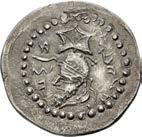

459. KINGS of PERSIS. Šabuhr (Shahpur), son of Pāpag (Papak). Circa AD 211/2-213. AR Hemidrachm (18mm, 1.65 g, 3h). Istakhr (Persepolis) mint. çnlq (MRK’ in Pahlavi) to left, [Ò]YZSZµS√ (šhpwhry in Pahlavi) to right, bearded bust of Šabuhr left, wearing diadem and Parthian-style tiara decorted with pellet-in-crescent / çnlq (MRK’ in Pahlavi) to left, 1p $˙∫ (BRH bgy p’ [sic] in Pahlavi) to right, bearded bust of Pāpag left, wearing diadem and Parthian-style tiara with leaf ornament. van’t Haaff, Persis, Type 655f; K&M 6/1; Alram 655; Saeedi 3; Sunrise 688. Iridescent toning, hint of porosity and double strike, minor edge marks. EF. Very rare. ($1500)
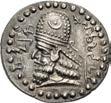



460. BAKTRIA, Greco-Baktrian Kingdom. Diodotos II Theos. Circa 235-225 BC. AV Stater (20mm, 8.38 g, 6h). Mint A (near Aï Khanoum). Diademed head right / ∫Å%5GE∑% down right field, d5odotoU down left, Zeus Bremetes, seen from behind, advancing left, extended left arm draped with aegis, preparing to hurl thunderbolt in right hand; in inner left field, wreath above eagle standing left. Kritt, New, D7, Style 3; Bopearachchi 5A; SNG ANS 82; HGC 12, 20 corr. (mint). Lightly toned, traces of die rust and marks, underlying luster. EF. ($7500)

461. BAKTRIA, Greco-Baktrian Kingdom. Euthydemos I Theos Megas. Circa 225-200/195 BC. AR Tetradrachm (27mm, 16.49 g, 12h). Mint B (“Baktra”). Struck circa 210-206 BC. Diademed head right / ∫Å%5¬EW% to right, EUQUd˙;oU to left, Herakles seated left on rock, holding in left hand a club set on rocks to left, right hand placed on rock; } to right of rock. Kritt B15; Bopearachchi 10A; Bopearachchi & Rahman 112; MPHB B Group V; SNG ANS 138; MIG Type 96; HGC 12, 42. Iridescent toning, traces of deposits in devices, some porosity. Good VF. Exceptional dies of masterful style. ($1500)
462. BAKTRIA, Greco-Baktrian Kingdom. Euthydemos I Theos Megas. Circa 225-200/195 BC. AR Drachm (17.5mm, 4.15 g, 12h). Mint B (‘Baktra’). Struck circa 206-200 BC. Diademed head right / ∫Å%5¬EW% to right, EUQUd˙;oU to left, Herakles, holding in extended right hand club set on knee, seated left on rock draped with lion skin; Ò to inner right. Kritt B18-D; Bopearachchi 13A; Bopearachchi & Rahman –; SNG ANS 143–4; MIG Type 95a; HGC 12, 47. Light iridescence. Near EF. Impressive style. Rare. ($1500)



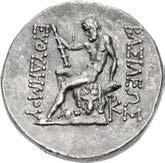

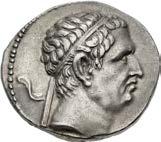


463. BAKTRIA, Greco-Baktrian Kingdom. Demetrios I Aniketos. Circa 200-185 BC. AR Tetradrachm (35mm, 16.89 g, 12h). Diademed and draped bust right, wearing elephant skin headdress / ∫Å%5¬EW% to right, d˙;˙tr5oU to left, Herakles standing facing, crowning himself, holding club and lion skin; I to inner left. Bopearachchi 1B; Bopearachchi & Rahman 121; MPHB Group I, (dies unlisted); SNG ANS 186; MIG Type 103b; HGC 12, 63. Toned, scattered marks. Good VF. ($2000)
From the D.K. Collection.
464. BAKTRIA, Greco-Baktrian Kingdom. Demetrios I Aniketos. Circa 200-185 BC. AR Tetradrachm (32mm, 16.96 g, 12h). Diademed and draped bust right, wearing elephant skin / ∫Å%5¬EW% to right, d˙;˙tr5oU to left, Herakles standing facing, crowning himself, holding club and lion skin; } to inner left. Bopearachchi 1C; Bopearachchi & Rahman 122; MPHB Group IIIB; SNG ANS 187; MIG Type 103d; HGC 12, 63. Toned. Good VF. Fine style dies. ($3000)

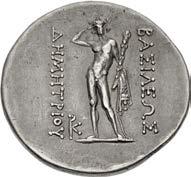



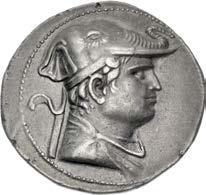
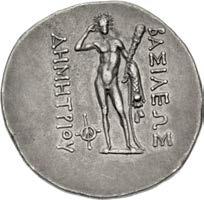
From the JTB Collection. Ex Grand Haven Collection (Triton XXIV, 19 January 2021), lot 850 (hammer $5500), purchased from Palladium Numismatics.
465. BAKTRIA, Greco-Baktrian Kingdom. Demetrios I Aniketos. Circa 200-185 BC. AR Tetradrachm (35mm, 16.89 g, 12h). Diademed and draped bust right, wearing elephant skin headdress / ∫Å%5¬EW% to right, d˙;˙tr5oU to left, Herakles standing facing, crowning himself, holding club and lion skin; D to inner left. Bopearachchi 1F; cf. Bopearachchi & Rahman 124 (illustrated example is fourrée); MPHB Group IIA, dies 11/– (unlisted rev. die); SNG ANS 190-2; MIG Type 103c; HGC 12, 63. Toned, scattered marks. Good VF. ($2000)
466. BAKTRIA, Greco-Baktrian Kingdom. Agathokles Dikaios. Circa 185-175 BC. AR Tetradrachm (32mm, 16.89 g, 12h). Diademed and draped bust right / ∫Å%5¬EW% to right, Å˝Åœo˚GEoU% to left, Zeus standing facing, holding scepter in left hand, and in right hand a statue of Hekate, who holds torch in each hand; D to inner left. Bopearachchi 1D; Bopearachchi & Rahman 149 (same obv. die); MPHB Group I, dies 1/7; SNG ANS 230; MIG Type 137a; HGC 12, 81. Iridescent toning, traces of deposits. Near EF. ($3000)
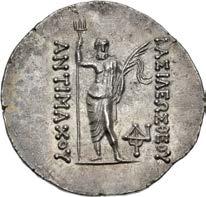
From the JTB Collection. Ex Triton XXII (8 January 2019), lot 457 (hammer $4000).
467. BAKTRIA, Greco-Baktrian Kingdom. Agathokles Dikaios. Circa 185-175 BC. AR Tetradrachm (32mm, 16.77 g, 12h). Diademed and draped bust right / ∫Å%5¬EW% to right, Å˝Åœo˚GEoU% to left, Zeus standing facing, holding scepter in left hand, and in right hand a statue of Hekate, who holds torch in each hand; D to inner left. Bopearachchi 1D; Bopearachchi & Rahman 149 (same obv. die); MPHB Group I, dies 1/34; SNG ANS 230; MIG Type 137a; HGC 12, 81. Toned, minor die break and small patch of roughness on obverse, slight double strike on reverse. Good VF. ($2500)
Ex Classical Numismatic Group 115 (16 September 2020), lot 400.
468. BAKTRIA, Greco-Baktrian Kingdom. Agathokles Dikaios. Circa 185-175 BC. AR Tetradrachm (32mm, 16.75 g, 12h). Diademed and draped bust right / ∫Å%5¬EW% to right, Å˝Åœo˚GEoU% to left, Zeus standing facing, holding scepter in left hand, and in right hand a statue of Hekate, who holds torch in each hand; D to inner left. Bopearachchi 1D; Bopearachchi & Rahman 149 (same obv. die); MPHB Group I, dies 6/18; SNG ANS 230; MIG Type 137a; HGC 12, 81. Iridescent toning, deposits, marks, obverse struck with worn die. Near EF. ($2500)


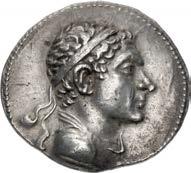


467 468 469 470
BAKTRIA, Greco-Baktrian Kingdom. Antimachos I Theos. Circa 180-170 BC. AR Tetradrachm (34mm, 16.43 g, 12h). Diademed and draped bust right, wearing kausia / ∫Å%5¬EW% QEoU to right, Å@t5;ÅcoU to left, Poseidon, laureate, standing facing, holding trident and filleted palm; Í to inner right. Bopearachchi 1A; Bopearachchi & Rahman 1734; MPHB Group II, dies 13/35 (unlisted die combination); SNG ANS 274-5; MIG Type 124f; HGC 12, 106. Iridescent toning, minor spots of porosity on obverse. EF. ($1500)




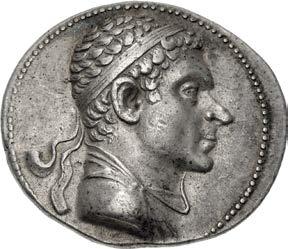
469.
From the North River Collection. Ex Triton IX (10 January 2006), lot 1121.
470. BAKTRIA, Greco-Baktrian Kingdom. Antimachos I Theos. Circa 180-170 BC. AR Tetradrachm (34mm, 16.43 g, 12h). Diademed and draped bust right, wearing kausia / ∫Å%5¬EW% QEoU to right, Å@t5;ÅcoU to left, Poseidon, laureate, standing facing, holding trident and filleted palm; K to inner right. Bopearachchi 1D; Bopearachchi & Rahman 176–8; MPHB Group III, dies 41/– (unlisted rev. die); SNG ANS 276-7; MIG Type 124b; HGC 12, 106. Light iridescent toning, light roughness. EF. ($1500)



471. BAKTRIA, Greco-Baktrian Kingdom. Antimachos I Theos. Circa 180-170 BC. AR Drachm (20mm, 4.20 g, 12h). Diademed and draped bust right, wearing kausia / ∫Å%5¬EW% QEoU to right, Å@t5;ÅcoU to left, Poseidon, laureate, standing facing, holding trident and filleted palm; K to inner right. Bopearachchi 2B; Bopearachchi & Rahman 183; MPHB Group III, dies 41/– (unlisted rev. die); SNG ANS 280-281; MIG Type 125a; HGC 12, 10. Light iridescence. EF. ($1000)
472. BAKTRIA, Greco-Baktrian Kingdom. Eukratides I Megas. Circa 170-145 BC. AR Drachm (20.5mm, 4.26 g, 12h). Diademed and draped bust right / ∫Å%5GE∑% above, EUkrÅt5doU in exergue, the Dioskouroi, holding palm fronds and spears, on horses rearing right; Å in upper left field, à in lower right. Bopearachchi 2D; Bopearachchi & Rahman –; SNG ANS –1; MIG Type 169 (monogram combination unlisted; HGC 12, 135. NGC encapsulation 6557459-001, graded Ch AU, Strike: 5/5, Surface: 5/5. ($1000)
473. BAKTRIA, Greco-Baktrian Kingdom. Eukratides I Megas. Circa 170-145 BC. AR Drachm (21mm, 4.19 g, 12h). Diademed, draped, and cuirassed bust right, wearing crested helmet adorned with bull’s horn and ear / ∫Å%5GE∑% above, EUkrÅt5doU in exergue, the Dioskouroi, holding palm fronds and spears, on horses rearing right; T to lower right. Bopearachchi 7I var. (monogram to left); Bopearachchi & Rahman 249 var. (same); SNG ANS 479-82; MIG Type 178c (no distinction of monogram placement); HGC 12, 136. In NGC encapsulation 6557459-002, graded AU, Strike: 5/5, Surface: 3/5. ($1000)

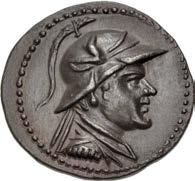



474. BAKTRIA, Greco-Baktrian Kingdom. Eukratides I Megas. Circa 170-145 BC. AR Tetradrachm (34mm, 16.97 g, 12h). Diademed and draped bust right / ∫Å%5GE∑% above, EUkrÅt5doU in exergue, the Dioskouroi, holding palm fronds and spears, on horses rearing right; } in lower right field. Bopearachchi 1B; Bopearachchi & Rahman –; SNG ANS 431; MIG Type 168f (no distinction of monogram placement); HGC 12, 130. Scattered marks, scrape and slight double strike on obverse, traces of underlying luster. Good VF. ($1000)
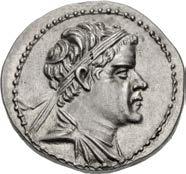



475. BAKTRIA, Greco-Baktrian Kingdom. Eukratides I Megas. Circa 170-145 BC. AR Drachm (20.5mm, 4.26 g, 12h). Diademed and draped bust right / ∫Å%5GE∑% above, EUkrÅt5doU in exergue, the Dioskouroi, holding palm fronds and spears, on horses rearing right; } in upper left field. Bopearachchi 2B; Bopearachchi & Rahman –; SNG ANS 438 var. (placement of monogram); MIG Type 169b var. (same); HGC 12, 135. Iridescent toning. Near EF. Attractive style. ($1000)
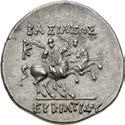
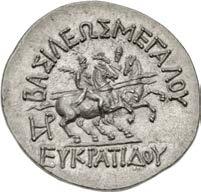


476. BAKTRIA, Greco-Baktrian Kingdom. Eukratides I Megas. Circa 170-145 BC. AR Tetradrachm (34mm, 16.93 g, 12h). Helmeted, diademed, draped, and cuirassed bust right / ∫å%5GE∑% ÂE˝ÅGoU around, EUkrÅt5doU in exergue, the Dioskouroi, holding palm fronds and spears, on horses rearing right; Í in lower right field. Bopearachchi 6E; Bopearachchi & Rahman 240-2; SNG ANS 465; MIG Type 177ee; HGC 12, 131. Light iridescent toning, traces of underlying luster, a few minor marks. EF. ($1500)

477 478
477. BAKTRIA, Greco-Baktrian Kingdom. Eukratides I Megas. Circa 170-145 BC. AR Tetradrachm (35mm, 16.96 g, 12h). Helmeted, diademed, draped, and cuirassed bust right / ∫å%5GE∑% ÂE˝ÅGoU around, EUkrÅt5doU in exergue, the Dioskouroi, holding palm fronds and spears, on horses rearing right; ä in lower right field. Bopearachchi 6T; Bopearachchi & Rahman –; SNG ANS 468; MIG Type 177i; HGC 12, 131. Traces of deposits, tiny flan crack, flan flaw on reverse, traces of underlying luster. Near EF. ($1000)
478. BAKTRIA, Greco-Baktrian Kingdom. Eukratides I Megas. Circa 170-145 BC. AR Tetradrachm (34mm, 16.96 g, 12h). Helmeted, diademed, draped, and cuirassed bust right / ∫å%5GE∑% ÂE˝ÅGoU around, EUkrÅt5doU in exergue, the Dioskouroi, holding palm fronds and spears, on horses rearing right; Î in lower right field. Bopearachchi 6Z; Bopearachchi & Rahman –; SNG ANS 473; MIG Type 177l; HGC 12, 131. Light iridescence. EF. ($1500)

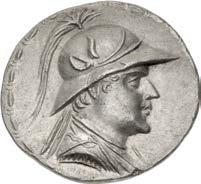
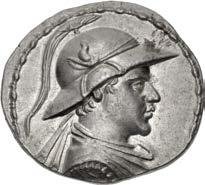


479 480
479. BAKTRIA, Greco-Baktrian Kingdom. Eukratides I Megas. Circa 170-145 BC. AR Tetradrachm (32.5mm, 16.93 g, 12h). Helmeted, diademed, draped, and cuirassed bust right / ∫å%5GE∑% ÂE˝ÅGoU around, EUkrÅt5doU in exergue, the Dioskouroi, holding palm fronds and spears, on horses rearing right; § in lower right field. Bopearachchi 6DD; Bopearachchi & Rahman –; SNG ANS –; MIG Type 177dd; HGC 12, 131. Deposits, traces of underlying luster. Near EF. ($1000)
480. BAKTRIA, Greco-Baktrian Kingdom. Eukratides I Megas. Circa 170-145 BC. AR Tetradrachm (34mm, 16.88 g, 12h). Helmeted, diademed, draped, and cuirassed bust right / ∫å%5GE∑% ÂE˝ÅGoU around, EUkrÅt5doU in exergue, the Dioskouroi, holding palm fronds and spears, on horses rearing right; à in lower right field. Bopearachchi 6EE var. (no Y in monogram); Bopearachchi & Rahman –; Qunduz –; SNG ANS –; MIG Type 177 (monogram unlisted); BMFA 2243 var. (same; same obv. die); Zeno –; HGC 12, 131; cf. Peus 431, lot 3333 (monogram with addition of Y). Light iridescence, hint of deposits, traces of underlying luster. Near EF. Extremely rare, none in CoinArchives. ($1500)
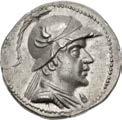
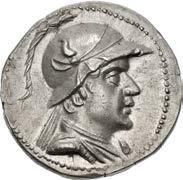


481. BAKTRIA, Greco-Baktrian Kingdom. Eukratides I Megas. Circa 170-145 BC. AR Drachm (20mm, 4.24 g, 12h). Helmeted, diademed, draped, and cuirassed bust right / ∫å%5GE∑% ÂE˝ÅGoU around, EUkrÅt5doU in exergue, the Dioskouroi, holding palm fronds and spears, on horses rearing right; T in lower left field. Bopearachchi 7I; Bopearachchi & Rahman 249; SNG ANS 479-82 var. (monogram to right); MIG Type 178c (no distinction of monogram placement); HGC 12, 136. Light iridescence, short flan crack, scuff on obverse, traces of underlying luster. EF. ($750)
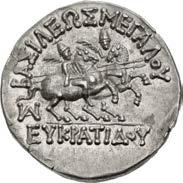



482. BAKTRIA, Greco-Baktrian Kingdom. Eukratides I Megas. Circa 170-145 BC. AR Drachm (19.5mm, 4.25 g, 12h). Helmeted, diademed, draped, and cuirassed bust right / ∫å%5GE∑% ÂE˝ÅGoU around, EUkrÅt5doU in exergue, the Dioskouroi, holding palm fronds and spears, on horses rearing right; T to lower right. Bopearachchi 7I var. (monogram to left); Bopearachchi & Rahman 249 var. (same); SNG ANS 479-82; MIG Type 178c (no distinction of monogram placement); HGC 12, 136. Light deposits, scuff on obverse, minor scratches on reverse, traces of underlying luster. EF. ($750)

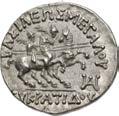

483. BAKTRIA, Greco-Baktrian Kingdom. Eukratides I Megas. Circa 170-145 BC. AR Tetradrachm (33mm, 16.96 g, 12h). Diademed and helmeted heroic bust left, seen from behind, brandishing spear in right hand / ∫å%5GE∑% ÂE˝ÅGoU around, EUkrÅt5doU in exergue, the Dioskouroi, holding palm fronds and spears, on horses rearing right; D in lower right field. Bopearachchi 8B; Bopearachchi & Rahman 255; SNG ANS 485; MIG Type 179a; HGC 12, 132. Traces of deposits, some porosity. Near EF. ($5000)

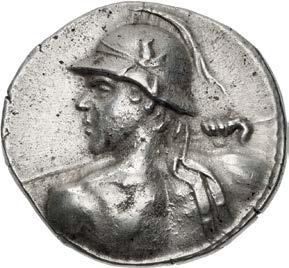
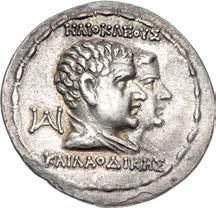
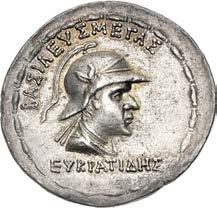
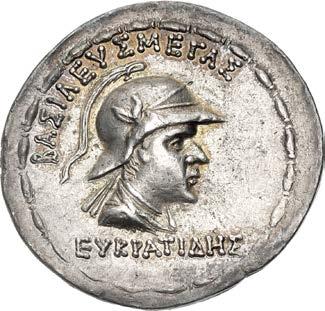
From the JTB Collection. Ex Peter Corcoran Collection; Menlo Park Collection (Triton XXII, 8 January 2019), lot 468, purchased from Frank L. Kovacs, circa 1998-2002.

484. BAKTRIA, Greco-Baktrian Kingdom. Eukratides I Megas. Circa 170-145 BC. AR Tetradrachm (32.25mm, 16.54 g, 12h). Dynastic pedigree issue. ∫å%5GEU% ÂE˝Å% around, EUkrÅt5d˙% in exergue, bust of Eukratides right, wearing helmet adorned with bull’s horn and ear; all within bead-and-reel border / ˙G5okGEoU% above, kÅ5 GÅod5k˙% in exergue, conjoined draped busts of Heliokles and Laodike, wearing tainia, right; T to left; all within bead-and-reel border. Bopearachchi 13A; Bopearachchi & Rahman –; SNG ANS –; MIG Type 182b; HGC 12, 133. Iridescent toning, light marks, trace of porosity. Near EF. Struck on a broad flan. ($4000)
From the North River Collection. Ex Classical Numismatic Group 75 (23 May 2007), lot 645; Classical Numismatic Group 73 (13 September 2006), lot 536.
485. BAKTRIA, Greco-Baktrian Kingdom. Demetrios II. Circa 150-145 BC. AR Tetradrachm (33mm, 17.01 g, 12h). Diademed and draped bust right / ∫Å%5GEW% to right, d˙Â˙tr5oU to left, Athena standing facing, wearing triple crested helmet, holding spear and shield set on ground; , below spear. Bopearachchi 1E; Bopearachchi & Rahman –; SNG ANS 393-4; MIG Type 101f; HGC 12, 126. Iridescent toning. EF. A beautiful example. ($5000)
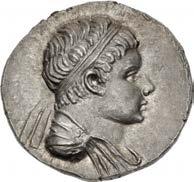



The reign of Demetrios II in Greco-Baktria and India, as well as his lineage, presents a puzzle, since the timelines of several other rulers, as many as three named Demetrios, seem to intersect and overlap during the mid to late second century BC. It is accepted that Demetrios I, the son of Euthydemos I, reigned circa 220-180 BC and added northern India to his realm by conquest. His portraits do not resemble the Demetrios depicted on this coin, however, nor do the reverse types match up -- the Euthydemid rulers chose Herakles as their reverse type, while this Demetrios uses a standing figure of Athena. Mitchiner and Bopearachchi believed this Demetrios must be the “Demetrius, king of the Indians” mentioned by the Roman historian Justin, whose brief summary of Greco-Baktrian history written in the second century AD are the only near-contemporary record we have of these realms. Justin writes that “Eucratides led many wars with great courage, and, while weakened by them, was put under siege by Demetrius, king of the Indians. He made numerous sorties, and managed to vanquish 60,000 enemies with 300 soldiers, and thus liberated after four months, he put India under his rule” (Epitome XLI, 6). Bopearachichi theorizes that this came at the outset of Eukratides’ reign and, indeed, cemented his power in Baktria; thus Demetrios II’s reign must terminate circa 171 BC, when Eukratides I’s rule commenced. Justin’s account, however, is ambiguous as to its timing. In fact the Attic-weight coinage of Demetrios II is of a different style and fabric than that of the Baktrian rulers Demetrios I, Euthydemos II, Agathokles, and Antimachos I, whose reigns precede and overlap that of Eukratides. It more closely resembles the coins of Eukratides’ successors, Platon, Eukratides II, and Heliokles I. That would place it toward the end of Eukratides I’s reign, rather than the beginning. If this Demetrios is the one mentioned by Justin, the four-month siege and battle must come toward the end of Eukratides I’s reign, circa 150-145 BC, where we have provisionally placed it.
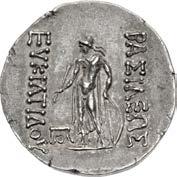
487.
BAKTRIA, Greco-Baktrian Kingdom. Eukratides II Soter. Circa 145-140 BC. AR Tetradrachm (33mm, 16.99 g, 12h). Diademed and draped bust right / ∫å%5GE∑% to right, EUkrÅt5doU to left, Apollo, holding arrow, standing left and leaning on bow set on ground; Ò to inner left. Bopearachchi 1H; Bopearachchi & Rahman –; SNG ANS –; MIG Type 177g; HGC 12, 131. A hint of deposits, some metal flaws. EF. Very rare in high grade. ($1500)


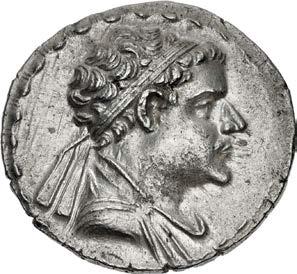


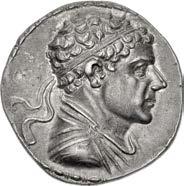

488. BAKTRIA, Greco-Baktrian Kingdom. Eukratides II Soter. Circa 145-140 BC. AR Tetradrachm (21.5mm, 16.90 g, 12h). Diademed and draped bust right / ∫Å%5GE∑% to right, EUkrÅt5doU to left, Apollo standing left, holding arrow and bow set on ground; ◊ to inner left. Bopearachchi 1M; Bopearachchi & Rahman –; SNG ANS –; MIG Type 164h; HGC 12, 161. Light iridescence, traces of deposits. EF. ($1500)
489. BAKTRIA, Greco-Baktrian Kingdom. Eukratides II Soter. Circa 145-140 BC. AR Tetradrachm (31mm, 16.85 g, 12h). Diademed and draped bust right / ∫Å%5GE∑% to right, EUkrÅt5doU to left, Apollo standing left, holding arrow and bow set on ground; x to inner left. Bopearachchi –, but cf. 1U ([Heliokles I] for monogram); Bopearachchi & Rahman –; Qunduz –; SNG ANS –, but cf. 642-5 (same); MIG Type 164 (monogram unlisted); HGC 12, 161; Zeno –. Iridescent toning, minor marks, traces of underlying luster. Near EF. None in CoinArchives. ($1500)

490 491
490. BAKTRIA, Greco-Baktrian Kingdom. Plato Epiphanes. Circa 145-140 BC. AR Tetradrachm (30mm, 16.68 g, 12h). Diademed and draped bust right / ∫Å%5¬EW% E∏5fÅ@oU% ∏¬ÅtW@o%, Helios standing facing in quadriga; M to inner left. Cf. Bopearachchi 1A; Bopearachchi & Rahman 288; Qunduz 388; SNG ANS 628; MIG Type 198a (second example illustrated); HGC 12, 165; Triton II, lot 612 (same obv. die). Traces of iridescence, hint of deposits, light cleaning marks, slight weakness on reverse. EF. High relief portrait. Very rare. ($15,000)
491. BAKTRIA, Greco-Baktrian Kingdom. Plato Epiphanes. Circa 145-140 BC. AR Tetradrachm (33mm, 16.84 g, 12h). Diademed and draped bust right, wearing helmet adorned with bull’s horn and ear / ∫Å%5¬EW% E∏5fÅ@oU% ∏¬ÅtW@o%, Helios standing facing in quadriga; M to right, ;Z in exergue. Bopearachchi 3A; Bopearachchi & Rahman –; Qunduz 378 (same dies); SNG ANS 631 (same obv. die); Mitchiner Type 197a; Zeno 299655 (this coin); HGC 12, 167. Some find patina, hint of deposits, marks, slightly double struck on reverse. EF. Very rare. ($20,000)




Not much is known about Plato Epiphanes apart from his coinage. He was likely a son of Eukratides I, along with Eukratides II and Heliokles I, posssibly the eldest, as his portrait apparently shows him to be a middle-aged man at the time of his accession. Bopearachchi cites one tetradrachm (Série 2A) with a possible date (MZ = “year 47”) in the exergue. Possibly based on the Indo-Greek era, which began in 186 BC, this possible date would suggest that Plato was ruling in 140 BC and supports the dating proposed by Bopearachchi, who noted that none of Plato’s coins are found at Aï Khanoum, which had been destroyed during the reign of Eukratides I. Frank Holt notes that Eukratides I is known to have been killed by one of his sons, who supposedly desecrated his father’s corpse by driving repeatedly over it with a chariot. Based on the highly unusual reverse of Plato’s rare coins, which depict Helios in a facing quadriga, Holt suggested that Plato might be the parricide and his coin reverses a sly allusion to his deed.


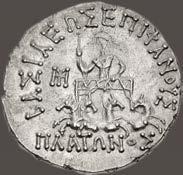

492. BAKTRIA, Greco-Baktrian Kingdom. Heliokles Dikaios. Circa 145-130 BC. AR Tetradrachm (33.5mm, 16.58 g, 12h). Diademed and draped bust right / ∫å%5GE∑% to right, ˙¬5o˚¬EoU% to left, d5kÅ5oU in exergue, Zeus standing facing, holding thunderbolt and scepter; x to inner left. Bopearachchi 1U; Bopearachchi & Rahman 292; SNG ANS 642-8; MIG Type 284o; HGC 12, 169. Light iridescence, traces of deposits, areas of porosity and corrosion on reverse, hairline die breaks on obverse. EF. ($2000)
493. BAKTRIA, Greco-Baktrian Kingdom. Heliokles Dikaios. Circa 145-130 BC. AR Tetradrachm (30mm, 16.84 g, 12h). Diademed and draped bust right / ∫å%5GE∑% to right, ˙¬5o˚¬EoU% to left, d5kÅ5oU in exergue, Zeus standing facing, holding thunderbolt and scepter; x to inner left. Bopearachchi 1U; Bopearachchi & Rahman 292; SNG ANS 642-8; MIG Type 284o; HGC 12, 169. Slight double strike, minor edge lamination. EF. ($2000)
494. BAKTRIA, Greco-Baktrian Kingdom. Heliokles Dikaios. Circa 145-130 BC. AR Tetradrachm (31mm, 16.75 g, 12h). Diademed and draped bust right / ∫å%5GE∑% to right, ˙¬5o˚¬EoU% to left, d5kÅ5oU in exergue, Zeus standing facing, holding thunderbolt and scepter; x to inner left. Bopearachchi 1U; Bopearachchi & Rahman 292; SNG ANS 642-8; MIG Type 284o; HGC 12, 169. Light iridescence, obverse struck with slightly worn die. Near EF. ($1000)


493 494 495 496
495. BAKTRIA, Greco-Baktrian Kingdom. Heliokles I Dikaios. Circa 145-130 BC. AR Tetradrachm (31mm, 14.59 g, 12h). Diademed, draped, and cuirassed bust right, wearing crested helmet covered with pelt of scales and adorned with head of Gorgon and wing; all within bead-and-reel border / ∫å%5GE∑% to right, ˙¬5o˚¬EoU% to left, d5kÅ5oU in exergue, Zeus Nikepohoros enthroned left; ; to inner left. Bopearachchi 3A; Bopearachchi & Rahman –; SNG ANS –; MIG Type 286a; HGC 12, 170. Traces of deposits, some metal flaws, light smoothing and tooling in fields. Near EF. ($3000)
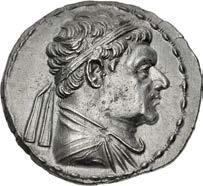
496. BAKTRIA, Greco-Baktrian Kingdom. Heliokles I Dikaios. Circa 145-130 BC. AR Tetradrachm (31mm, 11.39 g, 12h). Diademed, draped, and cuirassed bust right, wearing crested helmet covered with pelt of scales and adorned with head of Gorgon and wing; all within bead-and-reel border / ∫å%5GE∑% to right, ˙¬5o˚¬EoU% to left, d5kÅ5oU in exergue, Zeus Nikepohoros enthroned left; ; to inner left. Bopearachchi 3A; Bopearachchi & Rahman –; SNG ANS –; MIG Type 286a; HGC 12, 170. Iridescent toning, deposits, light porosity, a couple of short scratches and slight doubling on reverse, test cut on edge. Good VF. ($3000)
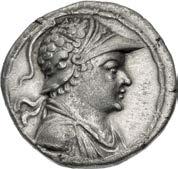





Ex Melinda Collection.

497. BAKTRIA, Indo-Greek Kingdom. Zoilos I Dikaios. Circa 150-130 BC. AR Tetradrachm (33mm, 16.93 g, 12h). Diademed, draped, and cuirassed bust right / ∫Å%5¬EW% d5˚Å5oU around, zo52oU in exergue, Herakles standing facing, holding wreath and club; I to inner left. Bopearachchi 1A = HGC 12, 216 (same rev. die as illustration); Bopearachchi & Rahman –; SNG ANS 966 (same dies, but later die state); MIG –. In NGC encapsulation 6157848-001, graded Ch AU★, Strike: 5/5, Surface: 4/5, Fine Style. Superb fine style portrait; extremely rare, one of three known specimens. ($100,000)
Although virtually nothing is now known about the reign of Zoilos I “The Just,” the scant evidence from coinage argues for his importance as a ruler in the Indo-Greek realms and possibly Baktria. We know two of his Indic-weight coins, a drachm and a tetradrachm, were overstruck by types of Menander, indicating he reigned concurrently with, and perhaps in opposition to, that great Indo-Greek king in Arachosia, the Paropamisadai, and Ghandara (see CNG 37, 20 March1996, lot 825 and R.C. Senior. “Menander versus Zoilos - another overstrike,” ONS Newsletter No. 150 [Autumn 1996], p. 12, ill. 2). His exceptionally rare tetradrachms on the heavier Attic weight standard (three known specimens, of which this is unquestionably the finest) suggest he may have held power briefly in parts of Baktria, perhaps during the chaotic collapse of Eukratides I’s regime. On both his Indic and Attic-weight coins, he uses the standing figure of Herakles as a reverse, evoking the types employed by Demetrios I Aniketos, the first king to extend Greek rule into India, and his successor Euthydemos II. Whether this implies a distant dynastic connection cannot be known. Wherever he fits into the sequence of rulers, the style of portraiture and quality of engraving on the coinage of Zoilos are extraordinary and among the best of the entire Baktrian series, as can be readily seen on this medallic Attic-weight tetradrachm.




498. BAKTRIA, Indo-Greek Kingdom. Theophilos Autokrator. Circa 130-129 BC. AR Tetradrachm (35mm, 17.04 g, 12h). Diademed and draped bust right / ∫Å%5¬EW% ÅUto˚rÅtoro% around, [œ]Eof52[oU] in exergue, Athena Nikephoros seated left on cuirass and shield, holding spear; ù to inner left. Bopearachchi 1A = Qunduz 615 (same dies); Bopearachchi & Rahman –; SNG ANS –; MIG Type 371a (second example illustrated; same obv. die); HGC 12, 165. In NGC encapsulation 6157848-002, graded Ch AU, Strike: 3/5, Surface: 4/5, flan flaws. One of five known, only the Gorny and Spink coins in CoinArchives. ($30,000)
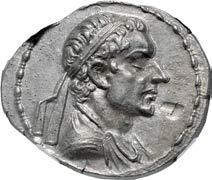

The five examples of this issue are known with only the ù and f monograms, and were struck from one obverse die and a total of three reverse dies:
ù monogram: dies A/a1 1) Qunduz 615 2) this coin dies A/a2 1) MIG 371a (second example) = Spink 165, lot 157 = Numismatic Fine Arts XXV, lot 243 dies A/a3 1) Gorny & Mosch 207, lot 460
f monogram: dies A/b1 1) HGC 12, 223 = MIG 371a (first example) = BM Inv. 1965,0410.1.
Except for a few extremely rare coins, Theophilos Autokrator is unknown to history. The name Theophilos, meaning “beloved of god,” occurs infrequently in the pre-Christian Greek world, most famously as a correspondent of the evangelist Luke. Among Hellenistic rulers, the only coins to bear the name are found in the Baktrian and Indo-Greek realms. The unresolved question remains, was there just one King Theophilos, or were there two? The surviving silver coins are on two weight standards, the larger and heavier Attic standard with Greek legends (the present example), and the bilingual Indo-Greek standard (see Triton XXV, lot 567). The Attic coins depict a lean, sharp-nosed man with the name and titles King Theophilos Autokrator (”the Self-Empowered”), while the Indo-Greek issues depict a man with a somewhat more rounded nose and the epithet Dikaios (”the Just”). The reverses are also distinctly different: The Attic type depicts a seated Athena Nikephoros, while the Indic examples show a standing Herakles with club and lion skin. Experts differ as to whether one or two rulers are depicted. Osmund Bopearachchi contends the Theophilos Autokrator and Dikaios are one in the same, citing as evidence what he calls the similarity in portraits and the identical treatment of their diadem ties, with one straight and the other crooked. Jens Jakobsson, in Journal of the Oriental Numismatic Society 202 (2010), contends they are separate; that Dikaios’ use of Herakles as a reverse type links him with the Euthydemid Dynasty and to his near-contemporary, Zoilos (see lot 498), while Autokrator’s use of Athena links him more closely to the line of the great Indo-Greek ruler Menander. He also points out the dissimilar aspects of the portraiture and the stylistic resemblance of Theophilos Autokrator to the last Greek kings of Baktria proper, Eukratides II, Platon and Heliokles I. As for dating, the epithet Autokrator was also employed by the Seleukid usurper Diodotos Tryphon (ruled 139-138 BC), and “apparently refers to an assertion of independence.” Jakobsson further proposes that Theophilos Autokrator was a “princelet who briefly rose against the new rulers of Bactria (Sakas or Yuezhi, or even the Parthaians) after the Greek kingdom had ceased to exist” in the late 130s or 120s BC, and thus was the last Greek king of Baktria proper. Another possibility is that the same Theophilos ruled in Baktria and Pakistan / northern India at different times, perhaps years or decades apart, employing different titles and iconography each time.

499. BAKTRIA, Indo-Greek Kingdom. Philoxenos Aniketos. Circa 125-110 BC. AR Tetradrachm (28mm, 9.54 g, 12h). ∫Å%5¬EW% Å@5˚˙toU f5¬o$E@oU, diademed heroic bust left, wearing crested helmet adorned with bull’s horn and ear, and brandishing spear in right hand / snSUf sthˇpA sjrhm (maharajasa apadihatasa philasinasa in Kharosthi), Philoxenos, in military attire, on horse rearing right on ground line; % below, N to upper left. Bopearachchi 9C = MIG Type 343c (third example); Bopearachchi & Rahman –; SNG ANS 1198; HGC 12, 270. Lightly toned, hint of deposits, porosity, cleaning marks. EF. Great metal. ($1500)
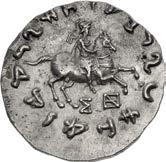

Rare Zeionises Tetradrachm


500. INDO-SKYTHIANS, Northern Satraps. Zeionises. Circa 45/35-5 BC. AR Tetradrachm (27mm, 9.62 g, 11h). Uncertain mint in Chukhsa (Chach). ~@5˝o2oU U5o[...]~;oU Z15w@5˝oU, king in Parthian attire and holding whip right on horseback; 0 to right; uncertain Kharosthi letter between horse’s leg / ÅAnHJ Ål˝nm (Manigulasa chatrapasa putrasa chatrapasa Jihuniasa in Kharosthi), king enthroned facing, being crowned with wreath by Tyche, standing slightly left, holding cornucopia; monogram to left, b (bu in Kharosthi) to right. Zeno 236710 = Triton XXIII, lot 548 (same dies); CNG 118, lot 658 (same dies). Minor find patina in recesses, areas of weak strike at periphery. VF. ($7500)
Ex Triton XXIII (14 January 2020), lot 548.
Bob Senior writes: “The coin is a tetradrachm of Zeionises of unpublished type. See Indo-Scythian Coins and History (ISCH) types 130 - 132 for the obverse. This coin has very good Greek legends which indicates that it was struck very early in the reign of Zeionises – the regular coins get cruder the later they are struck, and the Greek becomes garbled.

Zeionises was the successor of Azilises, probably around 40/35 BC and the obverse design copied from his coins – see S32 - 37. Zeionises’s father is mentioned on the coins – Manigula, and we know from an inscription that he was ‘brother of the king’ presumably Azilises. Zeionises would therefore be Azilises’ nephew. The reverse has the King enthroned with City deity (same deity as on his regular coins) crowning him with a wreath. As such it is unique amongst Indo-Scythian coins.”

501. INDIA, Kushan Empire. Vima Kadphises. Circa AD 113-127. AV Dinar (21mm, 7.97 g, 12h). Bilingual series. Main mint in Baktria. bacilEyc ooh mo kadfichc, diademed and crowned half-length bust of Vima Kadphises left on clouds, holding mace-scepter in right hand and hilt of sword in left; flames at shoulder; 9 to right / [Å]rd~ Å9`k m˙ År·Óm År·Ó g¬‰Å ÅjrÎjr Åjrhm (Maharajasa rajadirajasa sarvaloga iśvarasa mahiśvarasa vima kaphthiśasa tradara[sa] = “of the great king, king of kings, lord of the world, the great lord, vima kadphises, savior” in Kharosthi), ithyphallic Siva standing facing, head left, holding trident in right hand and water flask in left; left arm draped with animal skin; 9 to left, 0 (Three Jewels) to right. Bopearachchi, Premiers Série XV, 41; MK 15/9 (O2/R11); ANS Kushan 266-268; Donum Burns 79 (same obv. die). Traces of deposits. Near EF. Very rare. ($5000)



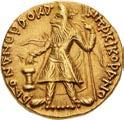


Ex Triton X (9 January 2007), lot 474.
502. INDIA, Kushan Empire. Kanishka I. Circa AD 127-151. AV Dinar (20.5mm, 7.96 g, 12h). Main mint in Baktria (Balkh?). Early phase. saonanosao ˚a nIs˚i ˚osano, Kanishka, diademed and crowned, standing facing, head left, holding goad and scepter, sacrificing over altar to left; flame at shoulder / nana to left, Nana, nimbate, wearing fillet and crescent, standing right, holding scepter and box; 8 to right. MK 35 (O7/R9); ANS Kushan 370; Donum Burns 117. Lightly toned. Near EF. ($1500)



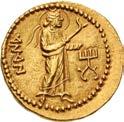





Ex Sincona 46 (14 May 2018), lot 512.
503. INDIA, Kushan Empire. Kanishka I. Circa AD 127-151. AV Quarter Dinar (13mm, 1.99 g, 12h). Main mint in Baktria (Balkh?). Early phase. s aonanosao ˚anIs˚i ˚OsanO, diademed and crowned half-length bust of Kanishka left on clouds, holding spear; flames at shoulder / oIso to right, Siva, nimbate, standing facing, head left, pouring water from flask and holding vajra (thunderbolt), trident, and he-goat; 8 to left. MK 45 (O2/R22) = BM Inv. 1851,0205.1 (same dies); ANS Kushan –; Donum Burns –. Lightly toned, die break on reverse. Near EF. Göbl cites only two examples (both in the BM), none in CoinArchives. ($3000)
Ex Triton XVII (7 January 2014), lot 458.
505. INDIA, Kushan Empire. Kanishka I. Circa AD 127-151. AV Dinar (20mm, 7.95 g, 12h). Main mint in Baktria (Balkh?). Late phase. saonanosao ˚a nIs˚i ˚osan[o], Kanishka, diademed and crowned, standing facing, head left, holding goad and scepter, sacrificing over altar to left; flame at shoulder / oIso to right, Siva, nimbate, standing facing, head left, pouring water from flask and holding vajra (thunderbolt), trident, and he-goat; 8 to left. MK 62 (O22/R31A); ANS Kushan 382; Donum Burns 131. Superb EF. ($3000)
Ex Heritage 3026 (25 September 2013), lot 23265.
506. INDIA, Kushan Empire. Kanishka I. Circa AD 127/8-152. AV Dinar (20mm, 7.99 g, 12h). Main mint in Baktria (Balkh?). Late phase. sa[O]nanOsaO ˚a nIs˚i ˚OsanO, Kanishka, diademed and crowned, standing facing, head left, holding goad and scepter, sacrificing over altar to left; flame at shoulder / oIso ton right, Siva, nimbate, standing facing, head left, pouring water from flask and holding vajra (thunderbolt), trident, and he-goat; 8 to left. MK 62 (O25/R31 – unlisted die combination); ANS Kushan 382; Donum Burns 131 (same dies). EF. ($3000)






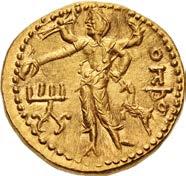
Ex Triton XVII (7 January 2014), lot 461.

507. INDIA, Kushan Empire. Kanishka I. Circa AD 127-151. AV Quarter Dinar (14mm, 1.88 g, 12h). Main mint in Baktria (Balkh?). Late phase. sÅo˜Å˜osÅo kÅ ˜Is˚i ˚osŘ, Kanishka, diademed and crowned, standing facing, head left, holding goad and scepter, sacrificing over altar to left; flame at shoulder / ßoddo to left, standing Śākyamuni Buddha: Buddha standing facing, hand raised in gesture of abhayamudrā; 8 to right. Cribb, Buddha 4 (dies c/3) = MK 73 (O35/ R2); ANS Kushan –; Donum Burns –; CNG 70, lot 497 (same rev. die); New York Sale XXIII, lot 296 = Skanda Collection (Spink-Taisei 9), lot 18 (same rev. die). Evidence of prior mounting. Near VF. Extremely rare, one of five known (the Skanda specimen was resold in Gorny & Mosch 257 [15 October 2018], lot 551). ($50,000)
Ex Triton XX (10 January 2017), lot 434.
According to Cribb’s study of the coinage, this issue consists of two obverse dies (his gold obverse dies c and d) and one reverse die (his reverse die 3). To date, six specimens (including our coin) are known. They are listed below by Cribb die combinations and include their publication history.
Cribb dies c/3:
1) MK 73 = Cribb, Buddha 4 = idem, “A re-examination of the Buddha images on the coins of King Kanishka,” in A.K. Narain, ed., Studies of Buddhist Art of South Asia (New Delhi: 1985), p. 60 (coin cited, but not illustrated) = idem, “The origin of the Buddha image – the numismatic image,” in Bridget Allchin, ed., South Asian Archaeology 1981. Proceedings of the Sixth International Conference of the Association of South Asian Archaeologists in Western Europe (Cambridge: 1984), Fig. 30.1, no. 2 = K. Tanabe, “A new gold dinar of Kanishka I with the Buddha image,” Orient: Journal of the Society for Near Eastern Studies in Japan 23 (1987), Fig. 6 = idem, “Kanishka I’s coins with the Buddha image on the reverse and some references to the art of Gandhara,” Orient: Journal of the Society for Near Eastern Studies in Japan 10 (1974), no. III (unillustrated) = B.J. Stavisky, La Bactriane sous les Kushans: problemes d’histoire et de cultures (Paris: 1986), frontispiece no. 13 = G. Fussman, “Monnaie d’or de Kanishka inédite au type du Buddha,” RN 1982, Fig. 1 = R. Curiel Collection (= BN [acquired in 1982]).




2) this coin = Triton XX (10 January 2017), lot 434.
Cribb dies d/3:
1) Hirayama Collection = Cribb, Buddha 5 = K. Tanabe, Silk Road Coins. The Hirayama Collection (Kamakura 1993), 126 (= K. Tanabe, History, Art and Iconography of Silk Road Coins [in Japanese]).
2) Zeno 79082 = Zeno 209797 = New York Sale XXIII, lot 296 = Sammlung eines Geschichtsfreundes (Gorny & Mosch 257, 15 October 2018 = Skanda Collection (Spink-Taisei 9), lot 18 = M.L. Carter, “A consideration of some iconographic details of Buddha images on Kushana coins,” in Amal Kumar Jha and Sanjay Garg, eds., Ex Moneta. Essays in Numismatics in Honour of Dr. David W. MacDowell (New Delhi, 1998), Fig. 1d.
3) Classical Numismatic Group 70 (21 September 2005), lot 497.
4) Triton VII (13 January 2004), lot 701.
Kanishka, a fervent Buddhist, is best remembered today for sponsoring the first great Buddhist conference at Kanish Vihar, that led to the adoption and promotion of Mahayana Buddhism, a school of thought that revered the life of Buddha as much as his spiritual teaching. The great bronze plaques that recorded the conference proceedings have never been found, but we are fortunate to have a report of the conference from the Chinese scholar Hien Tsang. The Buddha coinage was probably struck as a special issue in conjunction with the conference, and the image of Buddha would have made a stunning impact at the time. Buddha had previously only been represented in symbolic form, but under Kanishka the fusion of Greek and Indian culture led to the portrayal of Buddha in human form. Kanishka’s coins were among these first representations and provide the earliest firmly datable images of the Buddha in any artistic medium.
508. INDIA, Kushan Empire. Huvishka. Circa AD 152-192. AV Dinar (21mm, 8.00 g, 12h). Main mint in Baktria (Balkh?). Early phase. sDOnDnOsaO o oIs˚i ˚OsÅIO, diademed and crowned half-length bust of Huvishka right on clouds, flames at shoulder, holding mace-scepter in right hand and goad in left / Miiro to left, Miiro (Mithra), radiate and nimbate, standing right, holding diadem in right hand and goad in left; 7 to left. MK 135 (O1/R1) = Cribb & Bracey E.G1ii = A. Cunningham, “Coins of the Kushâns, or Great Yue-ti,” NC 1892, 2 = FdS 73 = Rosenfield 119 = BM inv. 1888, 1208.551 (same dies); ANS Kushan –; Donum Burns –. Lightly toned, slight double strike on obverse, hairline flan crack on reverse. Superb EF. ($10,000)
Ex Triton XVII (7 January 2014), lot 462.
509. INDIA, Kushan Empire. Huvishka. Circa AD 151-190. AV Dinar (21mm, 7.96 g, 12h). Main mint in Baktria (Balkh?). Late phase. sÅO˜Å˜OsÅa O ooIs˚[i ˚OsŘO], diademed and crowned half-length bust of Huvishka right on clouds, flames at shoulder, holding mace-scepter in right hand and goad in left / iÅMso to right, Iamsho, diademed and wearing high peaked cap, holding bird left in outstretched right hand and filleted spear in left; 7 to left . MK Supplement II 230B; ANS Kushan p. 291 (this coin; reverse only illustrated); Donum Burns 253 = Göbl, Himmel, pl. 7, 13 (same rev. die). Lightly toned, deposits in devices, light scrapes and slight double strike on reverse, minor edge marks. Near EF. Extremely rare, none in CoinArchives. ($40,000)
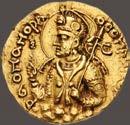




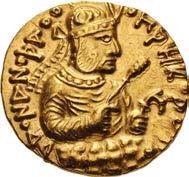
Ex Archytas Collection.
The reverse of this fascinating coin depicts the standing figure of Iamsho (Yama), the Kushan god of death and guardian of the underworld. The bird he holds in his right hand might perhaps be identified as either an eagle or a hawk, both of which symbolize the legitimacy of kingship. The reverse of this issue provides us with the only numismatic representation of Iamsho, and the appearance of this exceptionally rare coin is the first opportunity for collectors of the Kushan series to obtain an example at public auction.


510. INDIA, Kushan Empire. Huvishka. Circa AD 151-190. AV Dinar (21mm, 7.84 g, 12h). Main mint in Baktria (Balkh?). Late phase. sÅO˜Å˜OsaO OO Is˚i ˚OsŘO, nimbate, diademed, and crowned half-length bust left on clouds, holding mace scepter and filleted spear / ÅrdOxsO to left, Ardoxsho, wearing stephane, standing facing, head right, extending cornucopia with both hands; 7 to right. MK 286 (O12/R44); ANS Kushan 749; Donum Burns 263-264. Lightly toned, hint of deposits, a few slight scrapes on reverse, tiny die breaks on obverse, which is slightly off center. Good VF. ($1500)



511. INDIA, Kushan Empire. Huvishka. Circa AD 151-190. AV Dinar (20mm, 7.87 g, 12h). Subsidiary mint in Gandhara (Peshawar?). Late phase. sÅO˜Å˜OsÅO O˜s˚i ˚OsŘO, diademed and crowned half-length bust left on clouds or mountain, holding mace-scepter and goad / sÅOrhOÅ to left, Shaoreoro (Ares-Mars) standing right, holding spear and shield set on ground; 7 to right. MK 382 var. (rev. legend; dies unlisted); ANS Kushan 770 = Adams III, lot 2135 (same rev. die); Donum Burns –; Archytas Collection (Triton XXV), lot 613 (same dies); Künker 318, lot 2170 (same rev. die); CNG 100, lot 1686 (same rev. die); Triton V, lot 1685 (same rev. die). Lightly toned, a few peck marks on obverse. Good VF. Extremely rare with die combination unknown to Göbl, only the Archytas coin listed in CoinArchives. ($4000)
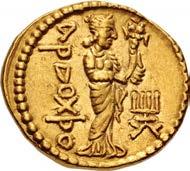



Shaoreoro, like the later Pahlavi Shahrevar, was originally the Hindu Kshathra Vairya, or “Desirable Kingdom.” Like Indra, the chief god of the Rig Veda, Shaoreoro was the genius of Kushan imperial might and the god of the molten metal that was to cover the earth on the Last Day.

512. INDIA, Kushan Empire. Huvishka. Circa AD 151-190. AV Dinar (21mm, 7.93 g, 12h). Main mint in Baktria (Balkh?). Early phase. sao˜a˜osao o oIs˚i ˚Osa˜O, diademed and crowned half-length bust left on clouds, holding mace-scepter and goad / c˚a˜Do/Åro ˚o M bizago, Skando-Komaro and Bizago, both nimbate, standing facing, heads vis-à-vis; Skando-Komaro holding spear in right hand, left hand on hilt; Bizago with right hand on hip, holding spear in left hand; 8 between. MK 156 (O1/R1); cf. ANS Kushan 723 (for type); Donum Burns –; CNG 100, lot 1673 (same dies). Lightly toned, trace of deposits, light scratches, some smoothing and tooling, ex jewelry. Good VF. Extremely rare. ($7500)

513. INDIA, Kushan Empire. Huvishka. Circa AD 151-190. AV Dinar (20mm, 8.04 g, 12h). Main mint in Baktria (Balkh?). Early phase. saO˜a˜OsaO O OIs˚i ˚Osa˜O, diademed, and crowned half-length bust left on clouds, holding mace-scepter and goad / MÅÅcI˜O, Maaseno, nimbate and crowned, standing facing, holding bird-tipped and filleted scepter in right hand, left hand on hilt of sword; 7 to left. MK 298 (O31/R3); ANS Kushan 709; Donum Burns 271. Lightly toned, traces of luster, a little off center on obverse, minor double strike on reverse. Superb EF. ($10,000)
Ex Triton XVII (7 January 2014), lot 474.
514. INDIA, Kushan Empire. Vasudeva I. Circa AD 190-230. AV Dinar (21mm, 7.96 g, 12h). Main mint in Baktria (Balkh?). Middle phase. s ÅO˜Å˜OsÅO bÅ zOÅIO ˚OsŘO, Vasudeva, nimbate, helmeted, and diademed, standing facing, head left, holding trident, sacrificing over altar to left; filleted trident to left / OIsO to right, Siva standing facing, holding a garland or diadem in extended right hand and trident in left; behind, the bull Nandi standing left; 6 to upper left. MK 509 (O3/5); ANS Kushan 1085-90; Donum Burns 413–9. Lightly toned, reverse deposits, scratches. Good VF. ($500)


From the S & S Collection. Ex Malter XXXI (9 June 1985), lot 3372.
515. INDIA, Kushan Empire. Kanishka II. Circa AD 230-247. AV Dinar (21.5mm, 7.86 g, 12h). Main mint in Peshawar. sao˜a˜OsaO [˚a˜]Is˚O ˚Osa˜O, Kanishka, standing facing, head left, sacrificing over altar and holding filleted staff; filleted trident to left; (ha in Brahmi) to right of altar; V (vi in Brahmi) to right / ardOxsO to right, Ardoxsho enthroned facing, holding filleted investiture garland and cornucopia; ^ to left; † (tha in Brahmi) to right. MK 550 (O10/12); ANS Kushan –; Donum Burns 609-11. Lightly toned. Good VF. ($750)
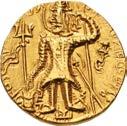
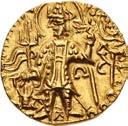



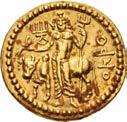

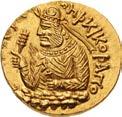

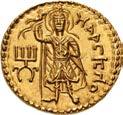
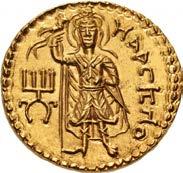
514 515 516 517
516. INDIA, Kushan Empire. Vasudeva II. Circa AD 290-310. AV Dinar (21mm, 7.83 g, 12h). Main mint in Mathura/ Gandhara. [sooNoNo]soo b[ozodIo ˚osoNo] (sic), Vasudeva standing facing, head left, sacrificing over altar and holding standard; filleted trident to left; “bha” in Brahmi to inner left at feet; V between legs; 1 in inner right field; 2 in outer right field / OdOdox (sic), Ardoxsho, ω-shaped head adornment, seated facing, holding filleted investiture garland in right hand and cradling cornucopia in left arm; ^ to left above. MK 574 (O34/– [unlisted rev. die]); ANS Kushan –; Donum Burns 723. Near EF. ($500)
Ex Heritage 3026 (25 September 2013), lot 23286; Freeman & Sear inventory G11813 (ND).
517. INDIA, Kushan Empire. Vasudeva II. Circa AD 267-300. AV Dinar (21mm, 7.95 g, 12h). Main mint in Mathura/ Gandhara. sDONONOsDO bDz˚OsONO ˚OsON, Vasudeva standing left, sacrificing over altar and holding filleted staff; filleted trident to left; J (rju in Brahmi) to right of altar; 1 (gho in Brahmi) between Vasudeva’s feet; (tra in Brahmi) to right of Vasudeva’s foot; 2 (rda in Brahmi) to right / OIsO to right, ithyphallic Siva standing facing, holding a garland or diadem and trident; behind, the bull Nandi standing left; ^ to upper left. MK 630/10 (Vasishka; O6/R–[rev. dies not numbered by Göbl for this series]); ANS Kushan 1650 var. (symbol to right of foot); Donum Burns 715 (same obv. die). Lightly toned. Good VF. ($500)
From the S & S Collection. Ex Malter XXXI (9 June 1985), lot 3003.
518. INDIA, Kushan Empire. Mahi. Circa AD 300-305. AV Dinar (19mm, 7.81 g, 12h). Uncertain mint. s[aO˜a˜OsaO...] ˚Osa˜OO, Mahi standing left, sacrificing over altar and holding filleted staff; filleted trident to left; P (pu in Brahmi) below arm; (mahi in Brahmi) to outer right / [ardO]xsO to right, Ardoxsho enthroned facing, holding filleted investiture garland and cornucopia; ^ to left. MK 588 (“Usurper I”); Donum Burns 766-8 (“Maiores domus”); ANS Kushan 1666. Lightly toned. EF. ($750)

519. INDIA, Kushan Empire. Shaka. Circa AD 325-345. AV Dinar (20mm, 12h). Uncertain mint. Shaka, nimbate, standing facing, head left, sacrificing over altar and holding filleted staff; filleted trident to left; b (bha in Brahmi) to right of altar; ß (sya in Brahmi) under Shaka’s left arm; pellet above left foot; _ (śaka in Brahmi) to outer right; legend off flan / Ardoxsho enthroned facing, holding diadem in right hand and cradling cornucopia in left arm; ^ to left; legend off flan. MK 586 (unlisted dies); ANS Kushan –; Donum Burns 763. In ANACS encapsulation 7172779, graded AU 58. ($750)



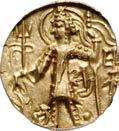

Ex Heritage 3091 (7 May 2021), lot 32131.
520. INDIA, Kushan Empire. Circa 320s-330s. AV Medallion (28.5mm, 7.32 g, 12h). Anonymous imitation of Roman Imperial type. COsTHNTI Hs P F HVC (sic), laureate and draped bust of Constantine I right / COsTHNTI Hs P F HVC (sic), laureate and draped bust of Constantine I right. Cf. MK, pl. 175, 13/1-3 (for obv. type); cf. E. Errington, J. Cribb, and M. Claringbull, eds. The Crossroad of Asia (1992), 146 (same); cf. Triton XXV, lot 618 (for type); cf. Triton XXII, lot 475 (same); cf. Triton IX, lot 1156 (same). Toned, minor scratches. VF. Set in ornate bezel with ornate suspension loop. ($3000)


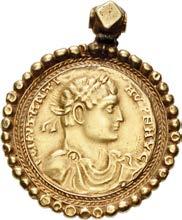
522. SASANIAN KINGS. Šābuhr (Shahpur) I. AD 240-272. AV Dinar (23mm, 7.35 g, 3h). Mint I (“Ctesiphon”). Phase 1a, circa AD 240-244. !U RM UKiX WNM L!RL! !0M L!LLM 00 j˚π j!U 4 0¡dRM (mzdysn bgy šhpwhry MRK’n MRK’ ’yr’n MNW ctry MN ya in Pahlavi), bust right, wearing diadem and mural crown with korymbos and ribbons; ≥ above crown / ‚j1RWN (nwr’zy in Pahlavi) to left, KjKµjV ([š]hpwhr[y] in Pahlavi) to right, fire altar; flanked by two attendants wearing mural crowns; • or Ḧ to right of altar shaft. SNS type IIc/1a, style A, groupe indéterminé; Saeedi AV9 var. (no pellets); Sunrise –; Zeno –. Light die rust, a few scratches, some tooling, underlying luster. EF. Extremely rare, none in CoinArchives. ($3000)
523. SASANIAN KINGS. Šābuhr (Shahpur) I. AD 240-272. AV Dinar (21.5mm, 7.35 g, 3h). Mint I (“Ctesiphon”). Phase 2, circa AD 260-272. !000 NM 0000X 0NM N! 00!!00M N!00 M 00j000j! 4 †0000µ (mzdysn bgy šhpwhry MRK’n MRK’ ’yr’n MNW ctry MN yzd’n in Pahlavi), bust right, wearing diadem and mural crown with korymbos / bj100) (nwr’zy in Pahlavi) to right, )00jojç (šhpwhry in Pahlavi) to left, fire altar; flanked by two attendants wearing mural crowns. SNS type IIc/1b, style P, group b; Saeedi AV4; Sunrise 739. Lightly toned, deposits in devices, light die rust, slightly double struck. EF. ($3000)
524. SASANIAN KINGS. Šābuhr (Shahpur) I. AD 240-272.

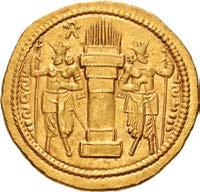
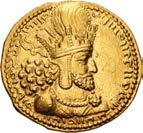



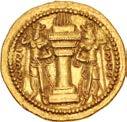


525. SASANIAN KINGS. Vahrām (Bahram) I. AD 273-276. AV Dinar (22mm, 7.39 g, 3h). Style A/a. ‘Ctesiphon’ mint. 0000π oZ UjiNo NN!o N!00 U N!ZjZeZ $ N00UZZo (mzdysn bgy wrhr’n MRK’n MRK’ ’yr’n MNW ctry MN yz[d’n] in Pahlavi), bust right, wearing diadem and radiate crown with korymbos; T¡ 0 1tU1U (y’yt’ n št in Pahlavi = who has rendered the empire ‘just’) in second line behind crown / bZZY (nwr’ zy in Pahlavi) to left, ZZjR!ˆ (wrhr’n in Pahlavi) to right, fire altar; flanked by two attendants, the one on the left wears crown with korymbos, the other wears mural crown; on altar shaft, > surrounded by three pellets. SNS type I(2)/1ab(1a) and pl. 4, A1 = Saeedi AV 11 (same dies); Sunrise –; Zeno –. Lightly toned, some slight hairlines, contact mark on obverse, traces of underlying luster. Near EF. Extremely rare, none in CoinArchives. ($7500)

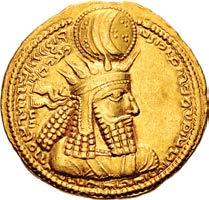


526. SASANIAN KINGS. Vahrām (Bahram) II, with Queen and Prince 4. AD 276-293. AR Drachm (27mm, 3.97 g, 3h). Style A. ‘Ctesiphon’ mint. 0!01uM 0II00 0uM 0 !! 0!! 0M 0UU00j00 Y$ YY0ZZM (mzdysn bgy wrhr’n MRK’ ’yr’n MN yzd’n in Pahlavi), jugate busts of Vahrām (Bahram), wearing winged crown with korymbos, and his queen, wearing kolah with boar’s head, right, vis-à-vis bust of Prince 4, wearing kolah with eagle’s head, left, holding fravahr / ˆu!j00 (wrhr ’n in Pahlavi) on left, ¨¨010¨ (nwr ’zy in Pahlavi) on right, fire altar; flanked by Bahram, wearing winged crown with korymbos, and queen, wearing kolah and holding ring; > to left of flames. SNS II Type VIIa(1)/5a(1a), Style A; Paruck 158; Saeedi 168; Sunrise 789. Hint of iridescent toning, deposits, and die rust; slightly crystallized surfaces. Good VF. ($750)




527. SASANIAN KINGS. Vahrām (Bahram) II. AD 276-293. AV Dinar (22mm, 7.39 g, 3h). Style I. ‘HWPY/HRPY’ (Herat?) mint. Phase I. YNuXZNP N!Zu! !RRM N!fijLˆ Y$ NsYduµ (blundered mzdysn bgy wrhr’n MRK’ ’yr’n MN yzd’n in Pahlavi), bust right, wearing winged crown with korymbos; . above ribbons / bZZZY (blundered nwr ’zy in Pahlavi) on left, ´YºWZZ (blundered wrhr ’n in Pahlavi) on right, fire altar; flanked by two attendants, the left wearing winged crown with korymbos, the right wearing mural crown; > and ö flanking flames; ˘ on altar shaft. SNS type I(1)/1(1a), style I (unrecorded as a dinar); Göbl type I/1; –; Sunrise –; Classical Numismatic Group 120, lot 604 (same dies); Zeno 218938 = Gorny & Mosch 261, lot 430 (same dies); Zeno 163923 = New York Sale XXXVII, lot 422 var. (no pellets; same rev. die); Triton XXIII, lot 569 (same dies); Zeno 229225 = Classical Numismatic Group 112, lot 414 var. (no pellets; same rev. die); Zeno 172466 = Album 26, lot 59 var. (no pellets; same rev. die); VAuctions - Pars Coins Sale 1, lot 209 (same dies). Underlying luster, hint of deposits on obverse. EF. Very rare with the two pellets above the ribbons. ($5000)
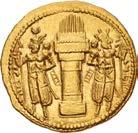
528. SASANIAN KINGS. Vahrām (Bahram) II, with Prince 3. AD 276-293. AR Drachm (28mm, 4.22 g, 3h). Style I. HWPY (Herat) mint. Bust of Bahram right vis-à-vis bust of prince 3 left; Bahram wearing winged crown with korymbos, prince wearing kolah with boar’s head; pseudo-Pahlavi legend around / Fire altar; flanked by two attendants, the left wearing crown with korymbos, the right with mural crown; yM wÔ (hw py in Pahlavi) flanking flames; pseudo-Pahlavi legend to left and right. SNS type III(1)/1(1a), Style I and pl. 24, 64; Saaedi –; Sunrise –; Triton XXV, lot 6283. Iridescent toning, slight wave at edge. EF. Rare. ($1500)




529. SASANIAN KINGS. Vahrām (Bahram) II, with Queen. AD 276-293. AR Drachm (27mm, 4.11 g, 3h). Style I. HWPY (Herat) mint. Busts of Bahram and queen Bahram wearing winged crown with korymbos, queen wearing kolah ; pseudo-Pahlavi legend around / Fire altar; flanked by two attendants, the left wearing crown with korymbos, the right with mural crown; ÁM Kj (hw py in Pahlavi) flanking flames; pseudo-Pahlavi legend to left and right. SNS type IV(1)/1(1a), Style I and pl. 24, A804; Saaedi 158; Sunrise 779. Iridescent toning, edge chip. EF. Very rare. ($3000)


530 531
530. KUSHANO-SASANIANS. Ardaxšīr (Ardashir) (I–II). Circa AD 230-245. AV Dinar (23mm, 7.89 g, 12h). Imitating Kushan king Vasudeva I. Uncertain mint in Baktria. Early series. s OOnOnOsO bO z OÅnO KOsÅnO], Vasudeva standing left, flames on shoulder, holding filleted standard, sacrificing over altar to left; filleted trident to left; O on altar; 0 to right / OIsO to right, ithyphallic Siva standing facing, holding a garland or diadem and trident with o on shaft; behind, the bull Nandi standing left; : to upper left; ˘ below Nandi’s head. MK 642; ANS Kushan –; Donum Burns 460 var. (pellet to left of tamgha). Reddish toning in devices, a few edge marks, possibly having been placed in a bezel. EF. Attractive example. ($1000)




Ex Tamco Numismatics inventory (includes ticket).
531. KUSHANO-SASANIANS. Ardaxšīr (Ardashir) (I–II). Circa AD 230-245. AV Dinar (24mm, 12h). Imitating Kushan king Vasudeva I. Uncertain mint in Baktria. Early series. s OOnOnOsO [O bÅz OÅnO KOsÅnO], Vasudeva standing left, flames on shoulder, holding filleted standard, sacrificing over altar to left; filleted trident to left; O on altar; [0 to right] / OIsO to right, ithyphallic Siva standing facing, holding a garland or diadem and trident with o on shaft; behind, the bull Nandi standing left; : to upper left; ≥ below Nandi’s head; • to left of rear leg. MK 651 (Vasudeva II) var. (additional pellet to left of tamgha); ANS Kushan –; Donum Burns –. Superb EF. ($1000)
Ex Heritage 3091 (7 May 2021), lot 32126.
532 533
532. THRACE, Byzantium. Marc Antony(?). Circa mid-1st century BC. Æ (20mm, 3.90 g, 1h). Bare male head (Marc Antony?) left / BY ZAN/TI ΩN, Trophy of arms set on prow, between crossed rudder and anchor. Schönert-Geiss, Byzantion 1888 (V1/R3); RPC I 1770.10 (this coin); Varbanov –. Green-brown patina, slight roughness, reverse flan flaw. VF. Rare. ($300)

Ex Hannelore Scheiner Collection.
533. THRACE, Perinthus. Nero. AD 54-68. Æ Pentassarion (31mm, 20.54 g, 1h). NЄPΩN KAIΣAP ΣЄBAΣTOΣ, laureate head right / ΠEPINΘIΩN, Herakles standing right; leaning on club with right hand and holding bow with left; to right, tree with coiled serpent, head left. Schönert, Perinthos 241; RPC I 1757.2 (this coin); Varbanov 17 (this coin). Redbrown patina, some smoothing. VF. Extremely rare, only the second known specimen. ($500)


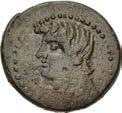
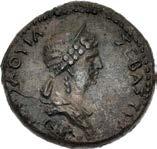

Ex Lanz 123 (30 May 2005), lot 469.
534. THRACE, Perinthus. Claudia Octavia. Augusta, AD 54-62. Æ (26mm, 10.46 g, 12h). Struck under Nero, circa AD 59-63. OKTAOYIA ΣEBAΣTH, draped bust right, wearing stephane / HPA ΠEPINΘIΩN, cult statue of Hera Samios standing left. Schönert-Geiss 255; RPC I 1755; Varbanov 3694. Mottled red-brown patina, small die break on obverse, scratches, roughness, reverse slightly off center. Good VF. ($500)
From the S & S Collection.
535. MACEDON, Koinon of Macedon. Time of Caracalla to Severus Alexander. Circa AD 212-244. AV Medallion, in the weight of a half aureus or hemistater (13.5mm, 3.50 g, 12h). Beroia(?) mint. Diademed head of Alexander the Great right, locks curled to resemble the horn or Ammon, hair flowing behind / AΛEΞANΔPOY, Athena Nikephoros seated left, left arm resting on shield, transverse spear in background. Seemingly unique, unpublished except for its previous auction appearances. Some luster, scratches, minor deposits. EF. Based on the types of Lysimachos. Extremely rare. ($10,000)
Ex Nomos 23 (30 November 2021), lot 239; Tkalec (26 November 2014), lot 131.
The image of Alexander appeared regularly on the coinage of the Koinon of Macedon, his likeness used as a symbol of their city’s history and homage to their favorite son. A large series of coins was struck without imperial portraits during the third and fourth centuries but gold struck there is incredibly rare. This medallion was likely struck as a prize at one of the many local games or a donative for distinguished members of society.




536. MACEDON (Roman Province). Aesillas. Quaestor, circa 95-70 BC. AR Tetradrachm (34mm, 16.82 g, 12h). Uncertain mint. MA[KЄΔONΩN], head of the deified Alexander the Great right; Θ to left / AESILLAS, Q, money chest, club, and chair; all within wreath, Ā above. Bauslaugh Group II, obv. die O7; HGC 3, 1110. Deeply toned with iridescence, minor scratches. Near EF. ($1000)



From the S & S Collection, purchased from Joel L. Malter.
537. MACEDON (Roman Province). Aesillas. Quaestor, circa 95-70 BC. AR Tetradrachm (31mm, 16.84 g, 12h). Uncertain mint. MAKЄΔONΩN, head of the deified Alexander the Great right; below chin, B monogram / AESILLAS, Q, money chest, club, and chair; all within wreath, [B at lower knot of wreath]. Bauslaugh Group III, obv. die O14; HGC 3, 1110. Minor scratches. EF. ($1000)

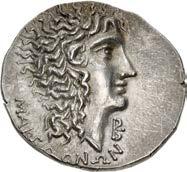


538. ASIA MINOR, Uncertain. Domitia. Augusta, AD 82-96. AR Cistophorus (25mm, 11.25 g, 7h). Struck under Domitian, AD 82. DOMITIA AVGVSTA, draped bust right, hair in long braids with single looped plait at back / VENVS AVG, Venus Victrix, seen half from behind, naked to the hips, standing right, resting elbow on column, holding scepter in left hand and helmet in right. RPC II 870; RIC II 847 (Domitian); RSC 19. Lightly toned, minor deposits. Good VF. Very rare, with a portrait in fine style. ($4000)
Ex Gorny & Mosch 257 (15 October 2018), lot 611; Künker 280 (26 September 2016), lot 574.
Domitia Longina was the daughter of the famous Roman general Corbulo, and the mistress of Domitian before the two were married in AD 71. A boy was born to the couple, but died very young and was deified upon Domitian’s accession as emperor in AD 81. Domitia was acclaimed as Augusta shortly thereafter, but the marriage was a tempestuous one and she was exiled from the palace for a time in AD 83. By the following year she had returned, and the couple seems to have arrived at a modus vivendi for the rest of Domitian’s reign. The historian Cassius Dio claims Domitia had a role in her husband’s assassination in September of AD 96. However, she continued to refer to herself as “Domitia, wife of Domitian” for the rest of her long life. She died peacefully sometime between AD 126 and 130.

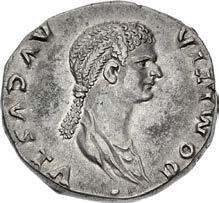
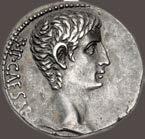
539. ACHAEA, Fleet coinage. Uncertain mint. Mark Antony, with Octavia. Summer 37 BC. Æ “Sestertius” (27mm, 12.22 g, 4h). ‘Fleet coinage’ issue. Light series. Uncertain

base mint (Tarentum?); L. Sempronius Atratinus, consul designatus. [Â ANT iÂp [Ter COÍ DeÍ iTer eT Ter iii uir r p C], bare head of Mark Antony and draped bust of Octavia, vis-à-vis / L ATr[ATiNuÍ Augur C]OÍ DeÍig, Mark Antony and Octavia in quadriga of hippocamps right, lituus above; hÍ to left; d and astragalus below. Amandry, Bronze I, Series II.2.A, 8 (D3/R–, unlisted reverse die); RPC I 1459; CRI 291; Sydenham 1261; BMCRR East 151. Brown surfaces, flan adjustment marks. VF. Very rare. ($5000)
The curious “fleet coinage” of Mark Antony was struck at several mints over the course of 37/6 BC, probably commencing after Antony and Octavian signed the Pact of Tarentum, which renewed their triumval powers and partnership. Octavia, Antony’s wife and Octavian’s sister, was instrumental in the negotiations and frequently appears on the coins, including this rare specimen. The coins are all bronzes of a range of denominations that anticipate the ones in use during the empire -- sestertius, dupondius, as, etc. Three Antonian admirals are named as moneyers, including L. Sempronius Atratinus, as seen here. All coins feature nautical themes, hence the term “fleet coinage.” Although Roman denominations and legends are employed, many of the numerals, including marks of value, are Greek, indicated they were intended for use in the east, where many were struck. The evidence points to an early experiment in a revolutionary new universal coinage system that was ahead of its time, but was later taken up, tweaked, and fully implemented by Augustus.

540. KINGS of BOSPORUS. Sauromates I, with Hadrian. AD 93/4-123/4. AV Stater (19.5mm, 7.82 g, 12h). Dated Bosporan Era 416 (AD 119/20). BACIΛЄωC CAYPOMATOY, diademed and draped bust of Sauromates right / Laureate head of Hadrian right, globe at point of bust; ςIY (date) below. Frolova p. 109 and pl. VI, 21 (rev. die; obv. die unrecorded); MacDonald 390/2; Anokhin 409; RPC III 814. Toned, slight deposits, reverse off center. VF. Rare. ($2000)



541. MYSIA, Pergamum. Augustus. 27 BC-AD 14. AR Cistophorus (24.5mm, 11.94 g, 12h). Struck 27-26 BC. IMP • CAESAR, bare head right / AVGVSTVS, capricorn right, head left, bearing cornucopia on back; all within laurel wreath. Sutherland Group IV 129a (O4/R7); RPC 2211; SNG von Aulock 6568 (same obv. die); RIC 493; RSC 16. Attractive old cabinet tone, patch of iridescence, struck on a compact flan. EF. Wonderful portrait in high relief. ($4000)

The capricorn represents Octavian’s birth sign and appeared often as a coin type during his reign. Adding the cornucopia, or horn of plenty, to the back of the capricorn symbolizes the prosperity brought about through his efforts, and his victories are symbolized by the laurel wreath.

542 543
542. IONIA, Ephesus. Claudius. AD 41-54. AR Cistophorus (26mm, 10.80 g, 6h). Struck AD 41-42. TI CLAVD CAES • AVG, bare head left / COM ASI across field, distyle temple of Roma and Augustus, enclosing standing facing figures of Augustus leaning left, holding spear in right hand, being crowned by Fortuna, holding wreath in right hand and cornucopia in left; ROM • ET AVG on entablature. RPC I 2221; RIC I 120; RSC 3. Old cabinet tone with hints of iridescence, light scratches. Good VF. Nicely centered with a superb portrait. ($2000)




Ex Rauch 109 (11 November 2019), lot 302.
543. IONIA, Ephesus(?). Claudius. AD 41-54. AR Cistophorus (29mm, 11.51 g, 6h). Struck circa AD 41-42. TI CLAVD CAES • AVG, bare head left / DIAN EPHE across field, temple of Diana Ephesia: cult statue of Diana of Ephesus within tetrastyle temple, pediment decorated with figures flanking a central table with disk above, two tables and recumbent figures in angles. RPC I 2222; RIC I 118 corr. (obv. type); RSC 30; BMCRE 229-30; BN 298-301. Deep cabinet tone. VF. Struck on a large flan with full circle border, rare thus. ($2000)
From the DMS Collection, purchased from Jonathan K. Kern, August 2005.
544. IONIA, Ephesus. Statilia Messalina. Augusta, AD 66-68. Æ (19.5mm, 6.30 g, 11h). M. Acilis Aviola, proconsul; Aichmokles, magistrate. Struck under Nero, AD 65-66. MECCA[ΛINAN], draped bust right / AIXMOKΛHΣ EΠ ABIOΛA, PΩMH, EΦE, Roma standing facing, head right, holding scepter in right hand and statue of Artemis Ephesia in left. Karwiese, MvE 5 87; RPC I 2632. Brown surfaces, roughness. VF. Rare. ($1000)
From the S & S Collection. Ex Triton V (15 January 2002), lot 1724 (hammer $1400).

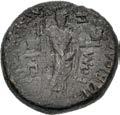

545. IONIA, Ephesus. Hadrian. AD 117-138. AR Cistophorus (27mm, 10.37 g, 12h). Struck after 129 AD. HADRIANVS AVG COS III P P, bare head right / DIA-NA across field, EPHESIA in exergue, cult statue of Diana of Ephesus within ornate tetrastyle temple set on three-tiered base; pediment decorated with figures flanking a central table with disk above, two recumbent figures in angles; decorated acrostolium. Metcalf, Cistophori 8 var. (O29/R-; unlisted reverse die); RPC III 1332 var. (rev. pediment); Pinder 70; RIC 475a. Old cabinet tone with golden iridescence around devices. Good VF. Very rare variety. ($2000)
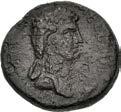

Ex Numismatica Ars Classica 87 (8 October 2015), lot 242; Gorny & Mosch 133 (11 October 2004), lot 317; Triton VII (12 January 2004), lot 964; Gorny & Mosch 112 (17 October 2001), lot 4210.
Diana is the Roman version of the Greek goddess Artemis; she is normally depicted as a young huntress, dressed in a short chiton, carrying a bow and quiver of arrows, and accompanied by her hunting hounds. A distinct form of Artemis / Diana was worshipped in Ephesus, where an immense temple complex, one of the Seven Wonders of the Ancient World, was devoted to the goddess. The famous cult statue housed in the temple was distinctly Anatolian (i.e., non-Greek) in form: mummiform in shape and covered with a multitude of breasts that signify the original association of the goddess with fecundity. With the arrival of the Greeks, the popular tales of Artemis were transferred to this mysterious Ephesian goddess. Hadrian visited Ephesus during his imperial tour of AD 128-134, arriving at the city in March of AD 129, where he is sure to have made a pilgrimage to the great temple and gazed upon the statue.
546. LYDIA, Nysa. Hadrian. AD 117-138. Æ Medallion (37mm, 37.40 g, 1h). AYT KAI TPAIA NOC AΔPIANOC CЄ, laureate, draped, and cuirassed bust right, seen from the front; cuirass decorated with the radiate bust of Helios / N YCAEΩN KAMAPЄITHC, Mên Kamareites standing facing, head left, wearing Phrygian cap, short chiton, long cloak and boots, crescent at shoulders, holding patera in extended right hand and long scepter in left. Kurth 77 var. (size, obv. legend); RPC III 2090A (this coin); Regling, Nysa 70 var. (size, obv. legend). Red-green patina, smoothing. Good VF. Extremely rare. ($1500)
547 548
547. LYDIA, Philadelphia (as Neocaesarea). Tiberius. AD 14-37. Æ (16mm, 3.19 g, 6h). TIBEPION CЄBACTON, bare head right / NEOKECAPEIC, thunderbolt. Clark, Renaming 33e (dies O1/R3 – this coin); Kurth 150 (under Tiberius Gemellus); LS 24 (under Tiberius Gemellus; same obv. die as illustration); RPC I 3017; Vagi 480 (under Tiberius Gemellus; same obv. die as illustration). Brown patina, obverse porosity. Near VF. ($500)





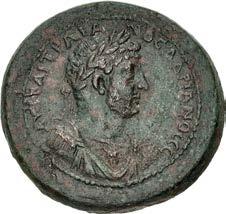

From the S & S Collection. Ex Triton V (15 January 2002), lot 1728 (hammer $1300).
Previously attributed to Tiberius Gemellus, a note in RPC online confirms the attribution to the emperor Tiberius based on the existence of a couple of high grade specimens; “Coin /14 removes any doubt about the attribution to Tiberius. See J. Clark, ‘The renaming of Philadelphia Neocaesarea under the emperor Tiberius’ in NC 180 (2020), pp. 127-31, for a die study and confirmation of the attribution to Tiberius. The reading is clear on the rare die.”

548. CARIA, Alabanda. Augustus. 27 BC-AD 14. Æ (17mm, 3.20 g, 12h). Aristogenes and Hipparches, magistrates. APIΣTOΓIN HΣ IΠΠAPXHΣ, laureate head of Augustus right / AΛABANΔEΩN MAIA, head of Livia right, wearing pearl necklace; to right, monogram. RPC I 2808. Earthen green patina, scratch on obverse. VF. Rare. The finest known, superior to any recorded in RPC or CoinArchives. ($500)
549. PAMPHYLIA, Perge. Valerian I. AD 253-260. AE Dekassarion (40.5mm, 27.16 g, 6h). A K ΠOY ΛIK OYAΛEPIANON CЄ, laureate, draped, and cuirassed bust right, seen from behind; I (mark of value) to right / ΠEP Γ AIΩN, agonistic prize crown containing two palm fronds inscribed ΠYΘIA set on table with curved legs inscribed ACYΛIA; beneath, two-handled jug, palm fronds flanking. SNG BN 549-50; SNG Leypold 1871 (all from the same pair of dies). Dark green patina with earthen deposits; attempted piercing and slight double strike on obverse, flan crack. Good VF. Rare. Struck on an impressively large flan. ($1000)
The crowns and purses seen on the reverses of Pergaian coinage represent prizes for the winners in the Asylia games, held in honor of Artemis Asylos at Perge in the 3rd century. The games were first held by Valerian and then again by Tacitus.
550. PAMPHYLIA, Side. Aemilian. AD 253. Æ Pentassarion (31.2mm, 13.37 g, 7h). AVTO K MAP AI AIMIΛIANON ЄYC, laureate, draped, and cuirassed bust right; Є (mark of value) to right / CI ΔH TΩN, Apollo Sidetes advancing left, holding patera in right hand and bow in left. RPC IX 1163. Green patina, light uniform roughness. Good VF. Very rare, only five known to RPC. ($1500)
Ex Peter Weiss Collection, acquired between 1967 and 2015.
551. PISIDIA, Sagalassus. Claudius II Gothicus. AD 268-270. Æ Dekassarion (33mm, 17.91 g, 12h). AY K M AYP KΛAYΔION, laureate, draped, and cuirassed bust right, seen from behind / CAΓAΛACCЄΩN, the Dioscuri, each holding spear and horse by reins, standing vis-à-vis; upturned crescent above, palm frond below; I (mark of value) to left. SNG BN –; SNG von Aulock 8628 (same dies); Z. Klawans, An Outline of Ancient Greek Coins (Racine: 1959), pp. 136 and 160 (this coin). Brown patina, roughness. Good VF. ($500)
Ex Berk BBS 217 (30 November 2021), lot 462; Spink 36 (20 May 1984), lot 257; Richard Cyril Lockett Collection (Part XII, Glendining, 21 February 1961), lot 2949.
552. LYCAONIA, Iconium. Time of Claudius. Circa AD 41-54. Æ (19mm, 4.73 g, 12h). Annius Afrinus, legate of Galatia. Struck circa AD 49-54. ANNIOC AΦPЄINOC, bare head of Annius Afrinus right / KΛAYΔЄIKONIЄωN, Perseus standing left, holding harpa in outstretched right hand and head of Medusa in left at side. von Aulock, Lykaoniens 245-6; SNG BN 2280; RPC I 3543; SNG von Aulock 8645. Chipped green patina. VF. Extremely rare. ($1000)
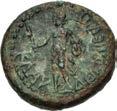

From the S & S Collection. Ex Triton V (15 January 2002), lot 1760 (hammer $900).
It is unusual at this date that a governor would place his own portrait, rather than that of the emperor, on his coinage. Following his tenure in Galatia, Afrinus was elevated to full consul and served as governor of Pannonia until AD 73.


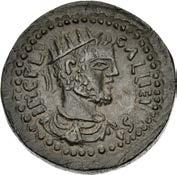




550 551 553 554
553. LYCAONIA, Iconium. Gallienus. AD 253-268. Æ (29mm, 18.63 g, 1h). IMP C P LI GALLIENVS, radiate, draped, and cuirassed bust right, seen from behind / ICONIENSIVM COL, S R in exergue, she-wolf standing right, head left, suckling the twins Romulus and Remus. Von Aulock, Lykaoniens 374; SNG BN –; SNG Hunterian 2152. Green-brown patina, flan adjustment marks. EF. Rare. The finest known to come to market in 20 years. ($500)
Ex Aretusa 3 (25 November 1994), lot 376; Auctiones 15 (18 September 1985), lot 332.
554. CILICIA, Hierapolis-Castabala. 1st century AD(?). Æ (23mm, 8.90 g, 6h). IЄPO ΠOΛITΩN, turreted, veiled, and draped bust of Tyche right / TΩN ΠPOC T Ω ΠYPAMΩ, river-god Pyramos swimming right, holding lighted torch in right hand. Robert, Hierapolis 19; SNG BN 2225; RPC II 1784; SNG Levante 1570. Earthen brown patina. Choice EF. ($500)
From the Dr. Michael Slavin Collection, purchased from Tom Cederlind, April 2005.

555. CILICIA, Tarsus. Hadrian. AD 117-138. AR Tetradrachm (25mm, 9.50 g, 12h). AYT KAI ΘE TP ΠAP YI ΘE NEP YI TP AΔPIANOC CЄ, laureate head right within fillet border / MH T POΠOΛEωC, TAP/CEωN in two lines in field, Tyche enthroned left, turreted and veiled, holding palm frond in right hand and cornucopia in left; below, half-length figure of river-god Kydnus swimming left; all within wreath. SNG BN 1405 (same dies); RPC III 3259; Prieur 759; SNG Levante –. Attractive iridescent tone, scratches on obverse. Good VF. ($500)
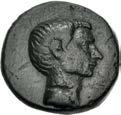

From the Dr. Michael Slavin Collection, purchased from Harlan J. Berk.
556. CILICIA, Tarsus. Caracalla. AD 198-217. Æ (36mm, 18.21 g, 1h). Struck AD 214/5. AVT KAI M AVP CЄVHPOC ANTΩNЄINOC CЄB, Π Π, bust left, clad in the crown and robes of the demiourgos priest; star below / ANTΩNЄINIANHC CЄV[HP AΔPIANH] TAPCOV MHT, A/M/K, ΓB, elephant walking right, carrying two sacks on its back marked XP. Cf. SNG Levante 1047-1048; cf. SNG BN 1541; cf. BMC Lycaonia 196; cf. SNG Copenhagen 364; SNG von Aulock –; cf. McClean 9116 (same obverse die). Green and brown patina. Near EF. Rare, only three specimens in CoinArchives. ($2000)

The elephant bronzes of Caracalla form a remarkable series of complex types and symbolism relating to the emperor’s journey through the eastern provinces in 214/15 AD. Caracalla is portrayed in imperial dress or else in the garb of the chief priest. The elephant bears a variety of gifts and offerings – the kiliarch crown, symbolizing the role of Tarsus as chief city of Cilicia; three palms (probably representing the three districts comprising Cilicia); two sacks containing offerings or money (on the present well-preserved coin the markings on the sacks can just be made out – XP for crisma (sacrificial oil) or crhmata (money); or on a few rare coins, all three items plus a fourth object that may be an imperial eagle. One can imagine a grand procession entering the city, led by a parade of elephants bearing the symbols of imperial might, provincial wealth, civic pride, and sacred piety.
557 558
557. ASIA MINOR, Uncertain. Octavian(?). Circa 30 BC(?). Æ (19mm, 6.83 g, 12h). Bare head right / Fiscus, sella, quaestoria and hasta; Q below. RPC I 5410; FITA p. 13. Dark green patina, minor marks, metal flaws. VF. ($500)
From the S & S Collection. Ex David Freedman Collection (Triton V, 15 January 2002), lot 521.
This issue has previously been attributed to a Macedonian mint with the portrait identified either as Brutus (Friedlander), Caesar (Grant), or to the governor of Syria, Gaius Sosius (in the trade). RPC presents a case for an origin in northern Turkey, supported by find data, with a suggestion that the portrait is Octavian. Issues of similar portrait style, very likely by the same engraver, include the “Princeps Felix” coinage from Cilicia (RPC 4082-3).



558. KINGS of ARMENIA. Tigranes IV, with Augustus. Second reign, circa 2 BC-AD 1. Æ 8 Chalkoi (27mm, 15.09 g, 1h). Artaxata mint. BACIΛЄYΣ MЄΓAC NЄOC TIΓPANHC, diademed and draped bust of Tigranes right, wearing Armenian tiara / KAICAP ΘЄOC ΘЄOY Y[IOC CЄBACTOC], bare head of Augustus left. Kovacs 178; CAA 167; AC 184; RPC I 3841 (Tigranes III or Tigranes V). Brown patina with earthen deposits. Fine. Rare, especially with full obverse legend. ($1000)

Situated between the two major powers of the day, Armenia could not remove itself from the frequent Romano–Persian conflicts. We are told that anti–Roman sentiment in Armenia was high during the reign of Tigranes IV, with the king supporting Parthia until he was eventually forced to ally with Rome to maintain his throne. His decision to do so must have proved unpopular in the kingdom, and it is possible that the battle in which Tigranes lost his life was an internal one aimed at quelling a rebellion.

559. CYPRUS, Koinon of Cyprus. Diva Faustina Senior, with Galerius Antoninus. Died AD 140/1 and before AD 138, respectively. Æ As or Dupondius (27mm, 7.81 g, 12h). Dies likely produced in Rome. Struck AD 140/1. ΘЄA ΦAYCTЄINA, veiled and draped bust of Diva Faustina right / M ΓAΛЄPIOC ANTωNINOC AYTOKPATOPOC ANTωNINOY YIOC, bareheaded and draped bust of Galerius Antoninus right. Overbeck, Galerius 9-16 (Vs:9/Rs:1); Parks 22; RPC IV.3 Online 8345. Earthen green patina, scrape on obverse. VF. Very rare. ($750)



From the S & S Collection.
Marcus Galerius Aurelius Antoninus was the son of Antoninus Pius and Faustina Senior. He died in infancy or childhood, before Antoninus became emperor in AD 138; a sepulchral inscription for him is in the Mausoleum of Hadrian. This provincial issue is the only coin naming him.



Of the sixteen specimens illustrated in RPC, half of the museum pieces are casts or outright forgeries, illustrating how difficult it was for the major museums to acquire authentic specimens for their permanent collections.
42,
Lucian of Samosata describes in detail the Hierapolitan cult images of Haddad and Atargatis (whom he refers to as Zeus and Hera) in his De Dea Syria (31-33), a “guidebook” of sorts to the deities’ temple in Hierapolis and the cult practices taking place there. His description of the statues of Atargatis, Haddad, and the mysterious “symbol” comports wonderfully with the figures as they appear on this type:
The great temple is open to all; the sacred shrine to the priests alone and not to all of these, but only to those who are deemed nearest to the gods and who have the charge of the entire administration of the sacred rites. In this shrine are placed the statues, one of which is Hera, the other Zeus, though they call him by another name. Both of these are golden, both are sitting; Hera is supported by lions, Zeus is sitting on bulls...between the two there stands another image of gold, no part of it resembling the others. This possesses no special form of its own, but recalls the characteristics of other gods. The Assyrians themselves speak of it as a symbol (Greek σημεῖον), but they have assigned it no definite name. They have nothing to tell us about its origin, nor its form: some refer to it as Dionysus; others to Deukalion; others to Semiramis; for its summit is crowned by a golden pigeon, and this is why they allege it is the effigy of Semiramis.
561 562
561. SELEUCIS and PIERIA, Antioch. Otho. AD 69. AR Tetradrachm (29.5mm, 11.89 g, 12h). Dated RY 1 (AD 69). AYTOKPATωP MAPKOC OΘωN KAICAP CЄBACTOC, laureate head right / Eagle standing facing on wreath, with wreath in beak and wings displayed; palm frond to left; ЄTOYC A (date) in exergue. McAlee 315; RPC I 4200; Prieur 102. Toned, light porosity, some light scratches. VF. ($750)
562. SELEUCIS and PIERIA, Antioch. Otho. AD 69. Æ As (31mm, 18.43 g, 12h). IMP • M • OTHO CA E • AVG, laureate head right / Large S • C within laurel wreath composed of eight sets of leaves. McAlee 321c; RPC I 4318. Dark brown patina with earthen deposits, die break on obverse, minor flan adjustment marks. VF. Well centered and struck for issue on a large and heavy flan, full legends. ($500)
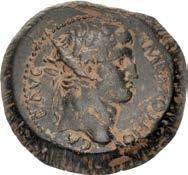

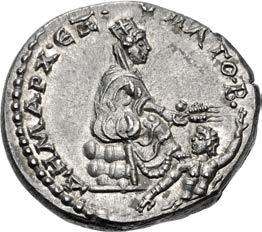


From the DMS Collection. Ex Roma E-Sale 18 (27 June 2015), lot 611.
563. SELEUCIS and PIERIA, Antioch. Caracalla. AD 198-217. AR Tetradrachm (28mm, 13.51 g, 6h). Struck AD 205-207. AVT KAI ANTΩNЄINOC, laureate head right / ΔHMAPX • ЄΞ • VΠATO • B •, Tyche seated right on rocky outcropping, holding grain ears and poppy in right hand; below, half-length figure of river-god Orontes swimming right. McAlee 665; Prieur 199. Light iridescent tone with patches of luster. Superb EF. Extremely rare, only 2 cited by Prieur, three in CoinArchives. ($2000)

From the Dr. Michael Slavin Collection, purchased from Freeman & Sear, 2003. Ex Lanz 102 (28 May 2001), lot 763; Leu 33 (May 3 1983), lot 95.
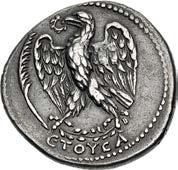
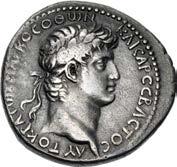

564. SELEUCIS and PIERIA, Emesa. Uranius Antoninus. Usurper, AD 253-254. BI Tetradrachm (25mm, 13.29 g, 12h). AYTO K COYΛΠ ANTωNINOC CЄ, laureate, draped, and cuirassed bust right, seen from behind / Eagle standing facing, head and tail left, with wings displayed, holding wreath in beak; S C beneath wings, ЄMICA below. Baldus 5 (both dies unknown to Baldus); Prieur 1029 var. (obv. legend); RPC IX 1866 var. (same); Nurpetlian, Orontes 49. Deeply toned, a little rough, reverse slightly off center. Good VF. Extremely rare; Prieur knew of two specimens, two in RPC, four in CoinArchives but none with a clear reading of the obverse legend. ($2000)

From the S & S Collection.
Uranius Antoninus is unknown from the ancient literary sources, although Zosimus perhaps confuses this usurper with two usurpers he names as Uranius and Antoninus during the reign of Severus Alexander. He established his government at Emesa, probably in response to repeated Persian attacks rather than as a challenge to Rome. In any event, it appears he was finally subdued when Valerian marched to recover the East.

565. SELEUCIS
AD 193-211. BI Tetradrachm (27mm, 13.87 g, 11h).



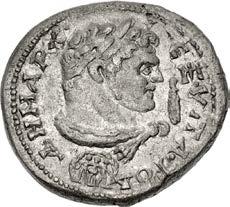

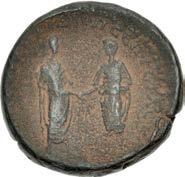
circa AD 205-207.
on breastplate, seen from the front / ΔHMAPX • ЄΞ • YΠATTOC • Γ •, eagle standing facing, head and tail right, with wings displayed; star between legs. Prieur & Amandry Group I, 5 (this coin illustrated); McAlee, Severan, Group I, –; Prieur 1119 (this coin). Lightly toned with hints of iridescence, lustrous. Choice EF. Superb portrait and bust, carved by a master die cutter. Very rare, only five noted by Prieur, eleven in CoinArchives. ($1000)

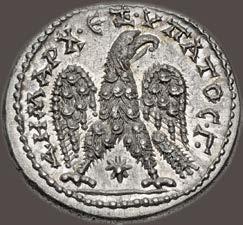

Ex Lanz 102 (28 May 2001), lot 707; Leu 33 (3 May 1983), lot 91.
From
568. PHOENICIA, Sidon. Elagabalus. AD 218-222. Æ (29mm, 14.82 g, 12h). [IMP] CAESAR M A ANTONINVS AV, laureate, draped, and cuirassed bust right, seen from behind / Carriage of Astarte flanked by crescent and star; all within center of zodiacal wheel; around, [COLO AVR PIA METRO SIDON] divided by registers. RPC VI Online 8385; Rouvier 1527. Brown surfaces, smoothed obverse, cleaning scratches, bare metal exposed in spots. Near VF. Very rare. ($1000)
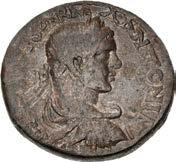

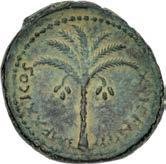
Astarte, a Syro-Phoenician goddess of fertility, sexuality and war, derived from the Mesopotamian goddess Ishtar and was known in other cultures as Asthart and Ashtoreth. She was worshipped in Phoenicia in the form of a baetyl, an aniconic stone cult image. In many cases the baetyl was believed to have fallen from the heavens and would be known today as a meteorite. Perhaps indicative of this connection, here the baetyl is shown on its sacred cart in the center of a Zodiacal ring. The heavenly Zodiacal belt was divided into 12 sections containing the major constellations and planets, whose movements were thought to guide the affairs of humans and gods alike.
569 570
569. JUDAEA,
Æ (27mm, 14.83 g,
From the DMS Collection. Ex Classical Numismatic Group 91 (19 September 2012), lot 675.

570. JUDAEA, Aelia Capitolina (Jerusalem). Caracalla. AD 198-217. BI Tetradrachm (16.5mm, 11.92 g, 12h). Struck AD 215-217. AYT KAI ANTW NINOC CЄB, laureate, draped, and cuirassed bust right / ΔHMAPX ЄΞ VΠATOC T Δ, eagle standing facing on filleted thyrsus, head and tail left, with wings displayed, holding wreath in beak; vine leaf between legs. Meshorer, Aelia 95; Prieur 1617; Sofaer 82-3. Toned. Good VF. Rare. ($750)
571. JUDAEA, Ascalon. Caracalla. 198-217 CE. BI Tetradrachm (25mm, 14.71 g, 11h). Struck 215-217 CE. AVT K • M • AN TΩNЄINOC C Є, laureate head right / ΔH EΞ Y ΠATOCTO • Δ, eagle standing facing on palm frond, head and tail left, with wings displayed, holding wreath in beak; in exergue, dove right with olive branch in beak. Prieur 1654; Sofaer 177. Toned, slight roughness, minor die break on reverse. VF. Rare, only six known to Prieur, eleven in CoinArchives. ($2000)

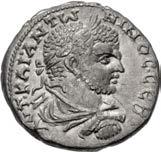
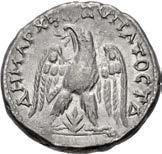



572 573
572. JUDAEA, Gaza. Hadrian. 117-138 CE. Æ (28mm, 20.33 g, 12h). Dually dated CY 193 and Epidemia 4 (132/3 CE). [AYT] KAI TPAI AΔPIANOC, laureate and draped bust right, seen from behind / ΓAZA MAPNA, Artemis, on left, standing right, drawing arrow from quiver at shoulder with right hand and holding bow with left, and Marnas, on right, standing left, holding short sceper with left hand and uncertain object in right; all within distyle temple; floral element in pediment; Δ EΠI ΓЧP (dates) in exergue. Rosenberger –; RPC III 4028; Sofaer 53. Dark green surfaces with earthen highlights. Good VF. Exceptional. ($1000)
From the Kenneth S. Abramowitz Collection.
573. JUDAEA, Neapolis. Philip II. 247-249 CE. Æ (29mm, 12.38 g, 6h). IMP M IVL PHIL[IPPVS A]VG, laureate, draped, and cuirassed bust right, seen from the front / COL SERG NEAPOL, She-wolf standing left, suckling the twins Remus and Romulus; Mt. Gerizim above, star right. Harl 95 (A19/P34) corr. (obv. legend); Rosenberger 104 (same obv. die); RPC VIII Online 2403; Sofaer 199 var. (legends, wolf right). Dark green patina with earthen highlights, scrapes. Near VF. Very rare. ($500)



From the Kenneth S. Abramowitz Collection.
574. JUDAEA, Neapolis. Domitian. 81-96 CE. Æ (17mm, 4.92 g, 6h). Dated CY 11 (82/3 CE). AYT[OK ΔO]MITIANOΣ KAIΣAP ΣE, laureate head right / ΦΛA NEAΠ ΣAMA L AI (date), two ears of grain on one stalk. Rosenberger 6 var. (date); RPC II 2221; Sofaer 6-7. Brown patina with red earthen highlights. EF. Great surfaces. ($400)
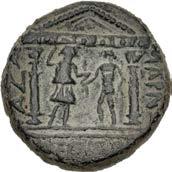
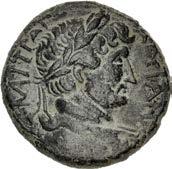

From the Kenneth S. Abramowitz Collection.
575. JUDAEA, Neapolis. Antoninus Pius. 138-161 CE. Æ (32mm, 21.88 g, 12h). Dated CY 88 (159/60 CE). AYTOK KAICAP [ANT]ωNINOC CЄBAC ЄVCЄ, laureate, draped, and cuirassed bust right, seen from behind / ΦΛ NЄAC ΠOΛЄωC CYIAC ΠAΛЄCT, Mount Gerizim with two peaks; between, ravine with sloping roadway; left peak with temple in perspective; to right, another building and steep stairway with shrines attached; right peak with shrine on top and trees at base; colonnade before with open gateway; ET ΠH (date) in exergue. Rosenberger 9; RPC IV.3 Online 10934 var. (different representation of rev. scene); cf. Sofaer 21-2 (date unclear). Dark green patina with earthen highlights. Good VF. Very attractive. ($5000)



From the Kenneth S. Abramowitz Collection.
The modern day city of Nablus in the northern West Bank, Neapolis was located in a strategic position between Mts. Ebal and Gerizim, the latter of which figured prominently on its coinage. This mountain, sacred to the Samaritans, was believed to have been the location chosen by Yahweh for a holy temple rather than the Temple Mount in Jerusalem, some 40 miles south. The Samaritan shrine on Gerizim can be clearly seen on this appealing bronze of Antoninus, together with the staircases leading up to it. However, the original temple was destroyed by the Hasmonean king John Hyrcanus in 112-111 BCE, so the shrine seen here seems to be a retrospective view, like that of the Jerusalem temple facade seen on coins of the Bar Kochba Revolt.
576. JUDAEA, Neapolis. Lucius Verus. 161-169 CE. Æ (25.5mm, 9.67 g, 11h). Dated CY 90 (161/2 CE). AYT[OK] KAI AYP OV HPOC CЄB, laureate bust right, slight drapery on left shoulder / [ΦΛ] NЄACΠO Λ Є CYPIAC ΠAΛAICTI, cult statue of Zeus Heliopolites facing, wearing kalathos, holding whip in raised right hand, two grain ears in left; foreparts of bulls flanking, ЄT Ч (date) across field. Rosenberger 22; RPC IV.3 Online 6351; Sofaer 61 corr. (obv. legend). Brown surfaces, flan adjustment marks. Good VF. Rare. ($500)






From the Kenneth S. Abramowitz Collection.
577. JUDAEA, Neapolis. Macrinus. 217-218 CE. Æ (26mm, 14.23 g, 12h). AYT K M OΠ CЄ MAKPINOC CЄ, laureate, draped, and cuirassed bust right, seen from the front / ΦΛ • NЄAC ΠOΛЄωC [CYP ΠAΛA], Mount Gerizim with two peaks; between, ravine with sloping roadway; left peak with temple in perspective, steep stairway with shrines attached; right peak with altar on top and trees at base; colonnade before. Rosenberger 32 var. (bust seen from behind); SNG ANS 993; Sofaer 83 var. (same). Dark brown patina with red earthen deposits. Good VF. Very rare. ($500)

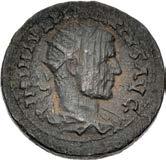
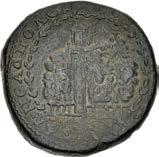
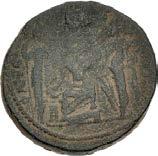
From the Kenneth S. Abramowitz Collection.
576 577 578 579
578. JUDAEA, Neapolis. Philip I. 244-249 CE. Æ (27.5mm, 14.38 g, 6h). IMP M IVL PHILIPPVS AVG, radiate, draped, and cuirassed bust right, seen from behind / COL SERG NEAPOL, Mount Gerizim surmounted by temple complex above eagle with wings displayed, standing facing, head left; to left, Marsyas standing right, right hand raised, carrying wine skin over shoulder. Harl 12 (A3/P12); Rosenberger 77 (same obv. die); RPC VIII Online 2359; SNG ANS 1010 (same dies); Sofaer 141. Dark brown patina with red earthen highlights, a few flan adjustment marks. Good VF. ($500)
From the Kenneth S. Abramowitz Collection.
579. JUDAEA, Neapolis. Philip I, with Philip II. 244-249 CE. Æ (26.5mm, 17.88 g, 1h). IIMM CC P FILIPPIS AVGG, Jugate busts of Philip I and II right, both laureate, draped, and cuirassed busts right, seen from behind / NEAPOL NEOCORO, COL, two Victories standing facing each other, holding wreath enclosing Mount Gerizim; below, star. Harl 43 (A9/P41); Rosenberger 90; RPC VIII Online 2381; Sofaer 171. Earthen brown patina, some roughness. Near VF. Very rare. ($500)
From the Kenneth S. Abramowitz Collection.
580. JUDAEA, Neapolis. Trebonianus Gallus. 251-253 CE. Æ (24mm, 12.13 g, 12h). [AYT KAI Γ OY]I TPЄB ΓAΛΛOC CЄB, radiate and cuirassed bust left, holding trophy over right shoulder, shield on left shoulder / ΦΛ NЄ[ACΠOΛЄωC], The Capitoline Triad: Cult statues of Zeus seated on throne facing, holding long scepter, sacrificing from patera over low altar to his right; at left, Athena standing right, holding spear in right hand and shield in left, at right Hera, standing left, holding short scepter in left hand; above, Mount Gerizim. Harl – (type unlisted, but obv. die A30); Rosenberger –; RPC IX –; ANS –; Sofaer –. Brown patina with red earthen highlights, minor roughness. Near VF. Extremely rare and unpublished. ($500)
From the Kenneth S. Abramowitz Collection.
The Capitoline Triad was a group of three deities; namely, Jupiter, Juno, and Minerva. They were worhiped within the Capitolium, the temple on the Capitoline Hill that was devoted to this sacred Triad. Though appearing very infrequently upon Roman coinage, the Triad remained the most important religious center in the Roman world.
581. JUDAEA, Neapolis. Volusian. 251-253 CE. Æ (26mm, 13.11 g, 6h). AYT KAIC Γ OYI TPЄB OYOΛOYCAN, laureate, draped, and cuirassed bust right, seen from the front / ΦΛ NЄAC •ΠOΛЄωC, temple complex atop Mount Gerizim, the whole supported on wings of eagle standing facing with wings displayed, head left. Harl 131-6 (A31/P– [unlisted rev. die]); Rosenberger 125; RPC IX 2158; Sofaer 248 var. (rev. legend). Brown patina with red earthen highlights, some roughness. VF. ($500)
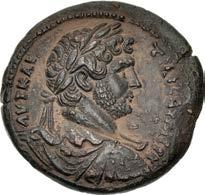

From the Kenneth S. Abramowitz Collection.
582. JUDAEA, Neapolis. Volusian. 251-253 CE. Æ (26.5mm, 14.27 g, 6h). AYT KAIC Γ OYI TPЄB OYOΛOYCAN, laureate, draped, and cuirassed bust right, seen from the front / ΦΛ NЄ A CΠOΛ ЄωC, tablet inscribed ЄΠICHMOY NЄωKOPOY, the whole supported on wings of eagle standing facing with wings displayed, head left. Harl 137 (A31/P130) corr. (Mount Gerizim
From
583.
Ex Triton XI (7 January 2008), lot 525. The “Iς” on the reverse represents 16 cubits on the Nilometer, the gauge which measured the annual flood crest of the Nile, with 16 being the ideal point for the agriculture of the Nile valley. Lower than 16 cubits brought the danger of drought conditions, much higher and there was the possibility of damaging floods.

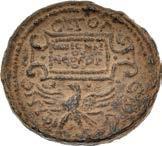


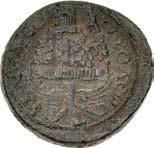
584. EGYPT, Alexandria. Antoninus Pius. AD 138-161. Æ Drachm (34mm, 21.33 g, 12h). Dated RY 7 (AD 143/4). AYT K T AIΛ A∆P
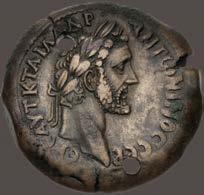

Judgment of Paris – Raised platform upon which from left to right: Aphrodite standing facing, head left; Hera standing facing, holding long scepter and looking right; Athena standing facing, head left, holding spear with her left hand and balancing shield on platform with her right (all goddesses wearing their usual attire); to their left on the ground: Hermes standing facing, head left, looking at Paris, left hand raised and pointed at Aphrodite; to his left, Paris seated right; above, two Erotes holding wreath; sheep below; L Z (date) flanking scene. Köln –; Dattari (Savio) 2998; K&G –; RPC IV.4 13519.12 (this coin); Emmett 1635.7 (R4). Even brown surfaces, holed twice in antiquity, small flan cracks. Good VF. Very rare. Overall better than the Staffieri specimen which we sold in Triton XXI, lot 161, which hammered for $32,000. All details embraced in portraying the Judgement scene are sharp and clear. This is not true for most known examples. ($30,000)
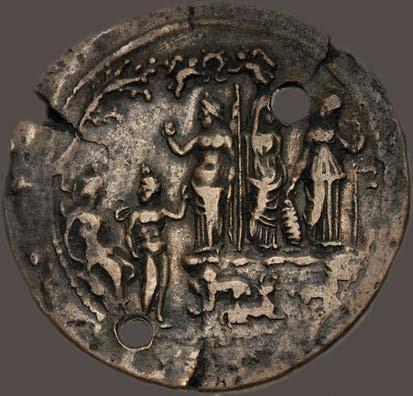


Ex Naville Numismatics 64 (21 March 2021), lot 267.
The Judgment of Paris, a mythical “beauty contest” of sorts, serves as a prelude to the Trojan War. Eris, goddess of discord, was excluded from a feast thrown by Zeus, but the scorned deity arrived uninvited with a golden apple inscribed “for the fairest.” Hera, Athena, and Aphrodite each claimed the apple, and Zeus was asked to award it to the most beautiful. Zeus, wishing to avoid this uncomfortable situation, appointed the mortal Paris as judge, as the shepherd and prince of Troy had a reputation for his fairness. Each goddess attempted to sway Paris with a bribe in order to win the apple: Athena offered him incredible skill in battle, Hera offered him an immense kingdom, and Aphrodite offered him the most beautiful woman in the world, Helen of Sparta, the wife of the Greek king Menelaus. Paris could not refuse Aphrodite’s offer, setting in motion the war between the Greeks and Trojans.
This particular piece has been pierced twice, likely serving as a funerary piece on a Romano-Egyptian mummy. Coins and other amulets were woven into the fabric of the mummies to serve as talismans against the spirits that would try to harm them on their way to the afterlife, the coin would pay the toll to Charon, the Greco-Roman tradition of paying the ferryman, which had been absorbed into Egyptian customs. Mummification was still practiced by the Egyptians through the third century AD until Christianity became the dominant religion of the empire.
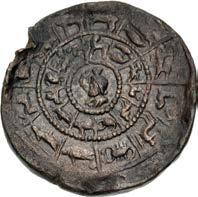


top; in the innermost circle, conjoined busts left of Sarapis and Isis, not dated. Köln –; Dattari (Savio) 2983 (same rev. die); K&G 35.257; RPC IV.4 Online 15280; Emmett 1705.8 (R5). Red-brown patina, light smoothing and tooling, edge nick. Good VF. Very rare and elusive type, missing from most of the major collections. ($7500)
The Great Sothic Cycle was a calendrical cycle based on the heliacal rising in July of the star Sirius (known to the Greeks as Sothis) and lasting approximately 1460 years. According to ancient Egyptian mythology, in a Golden Age, the beginning of the flooding of the Nile coincided exactly with the rising of Sirius, which was reckoned as the New Year. Only once every 1460 years did Sirius rise at exactly the same time. Thus, the coincidence of this along with the concurrent beginning of the flooding of the Nile gave the event major cosmological significance by heralding not just the beginning of a new year, but the beginning of a new eon. This event also was thought to herald the appearance of the phoenix, a mythological bird which was reborn every 500 to 1000 years out of its own ashes. According to one version of the myth, each new phoenix embalmed its old ashes in an egg of myrrh, which it then deposited in the Egyptian city of Heliopolis. So important was the advent of the new Great Sothic Cycle, both to the realignment of the heavens and its signaling of the annual flooding of the Nile, that the Egyptians celebrated it in a five-day festival, which emphasized the important cosmological significance.
In the third year of the reign of Antoninus Pius (AD 139/40), a new Great Sothic Cycle began. To mark this event, the mint of Alexandria struck an extensive series of coinage, especially in large bronze drachms, each related in some astrological way to the reordering of the heavens during the advent of the new Great Sothic Cycle. This celebration would continue throughout Pius’ reign, with an immense output of coinage during the eighth year of his reign in Egypt, which included this coin type, part of the Zodiac series.

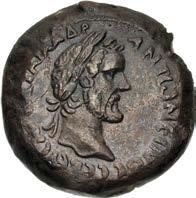
586. EGYPT, Alexandria. Antoninus Pius. AD 138-161. Æ Drachm (33mm, 27.61 g, 1h). Menelaeites Nome. Dated RY 8 (AD 144/5). AYT K T AIΛ A∆P ANTω[NINOC CЄB ЄYC], laureate head right / MЄNЄ ΛAЄITHC, Harpocrates, with the lower part of his body in form of crocodile and wearing the skhent crown, standing left, raising finger to lips and holding cornucopia; H (date) to left. Köln 3438; Dattari (Savio) 11041 (same rev. die); K&G N31.8; RPC IV.4 Online 13971; Emmett 1819.8. Earthen brown patina with red highlights. VF. Rare in high grade. ($1000)
The nome coinage is typically found in smaller denominations, obols and dichalkons, but this is one of the few series where the larger drachm is the predominant denomination.
587. EGYPT, Alexandria. Antoninus Pius. AD 138-161. Æ Drachm (33mm, 23.28 g, 12h). Zodiac series. Dated RY 8 (AD 144/5). AVT K T AIΛ A∆P ANTωNЄINOC CЄB ЄVC, laureate head right / Sun in Leo – Lion leaping right; above, radiate and draped bust of Helios (Sun) right and eight-rayed star; L H (date) below. Köln 1495-6; Dattari (Savio) 2968; K&G 35.278; RPC IV.4 Online 13547; Emmet 1530.8. Red-brown surfaces, minor pitting, a few cleaning scratches. Near VF. ($1000)



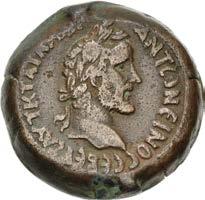

588. EGYPT, Alexandria. Antoninus Pius. AD 138-161. Æ Drachm (35mm, 27.87 g, 11h). Dated RY 10 (AD 146/7). AYT K T AIΛ A∆P ANTωNINOC CЄB ЄYC, laureate head right / Herakles and Hippolyte’s Girdle – Herakles standing right, nude but for lion’s skin draped over his left shoulder, holding club with left hand over his left shoulder and with right hand he seizes the “Golden Girdle” from the prostrate Hippolyte on her fallen horse which lies left; L ΔЄKATOY (date) around. Köln 1539; Dattari (Savio) –; K&G 35.345; RPC IV.4 14888; Emmett 1540.10 (R4). Red and brown surfaces, fields smoothed, details enhanced. Good VF. Very rare bust type of an already rare variety. ($3000)
At the request of Admete, Eurystheus’ daughter, Herakles as his Ninth Labor went to seize the golden girdle of Hippolyte, a garment that gave power and supremacy to the wearer. The daughter of Otrera and the god Ares, Hippolyte was the queen of the Amazons, an all female warrior race who lived near the slopes of the Caucasus. To carry out this Labor, Herakles organized an expedition, which included the Athenian hero Theseus. Upon the heroes’ arrival, the Amazon women greeted them warmly, while Hippolyte offered the girdle as a gift. Hera, on hearing this, took the form of an Amazon, spreading a rumor that Herakles had come to steal away their queen, and take her back with him to Greece. The female warriors, in protection of their queen, began fighting the heroes. In the melée that followed, Herakles slew Hippolyte, thinking she had betrayed him. Winning the battle, Herakles headed back for Mycenae. On the way, he saved the life of Hesione, daughter of Laomedon, king of Troy. Laomedon, however, refused to reward the hero for his service. In retribution, Herakles slew the king and all his sons, save the youngest, Podarces, who later became known as Priam.

590. EGYPT, Alexandria. Antoninus Pius. AD 138-161. Æ Drachm (37mm, 26.61 g, 12h). Dated RY 10 (AD 146/7). AYT K T AIΛ A∆P ANTωNINOC CЄB ЄYC, laureate head right / Herakles and the Stymphalian Birds – Herakles standing right, wearing lion’s skin over his head and down his shoulders, quiver over his right shoulder, drawing arrow back in bow and pointing it slightly upward; before, two of the Stymphalian birds falling from the sky; L ΔЄKATOY (date) around. Köln 1538; Dattari (Savio) 2587 (same dies); K&G 35.353; RPC IV.4 13980; Emmett 1543.10. Brown and green patina, some cleaning scratches and smoothing, minor deposits, small pit on reverse. Good VF. Rare. ($5000)

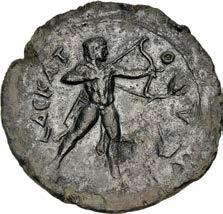

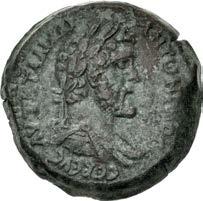
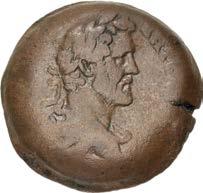

The Stymphalian Birds were man-eating birds that had claws of brass, sharp metallic feathers they could launch at their victims, and highly toxic dung. Driven to the heavily wooded area around Lake Stymphalia by a pack of wolves, they bred quickly and took over the countryside, destroying local crops and fruit trees. They were also favorites of Ares. To complete this Labor, Athena and Hephaestos assisted Herakles by forging crotala, or large bronze clappers, by which the birds could be frightened into flight; then, Herakles shot them down with his arrows, as depicted on the coin type.
591. EGYPT, Alexandria. Antoninus Pius. AD 138-161. Æ Drachm (34mm, 28.79 g, 11h). Dated RY 13 (AD 149/50). AYT K T AIΛ AΔP ANTωNINOC CЄB ЄVC, laureate, draped, and cuirassed bust right, seen from the front / The Dioscuri on horseback facing each other, both holding a spear and wearing pileus, star above each; L TPIC KAIΔ (date) above and below. Köln 1636; Dattari (Savio) 8401 (same dies); K&G –; RPC IV.4 Online 14910; Emmett 1492.13. Mottled green-brown patina. Good VF. Rare. ($2000)
From the Dr. Michael Slavin Collection, purchased from Harlan J. Berk. Ex Kerry K. Wetterstrom Collection (Classical Numismatic Auctions XIII, 4 December 1990), lot 113.
592. EGYPT, Alexandria. Antoninus Pius. AD 138-161. Æ Drachm (34mm, 25.74 g, 12h). Dated RY 17 (AD 153/4). AYT K T AIΛ AΔP ANTωNINOC CЄB ЄVC, laureate, draped, and cuirassed bust right, seen from the front / Nilus reclining left on crocodile, holding reed in right hand and cornucopia in left, from which emerges an infant Genius; to left, two genii standing right of domed shrine inscribed Iς (for 16 cubits); L IZ (date) above. Köln 1711; Dattari (Savio) 2764 var. (one genius); K&G 35.604; RPC IV.4 13801; Emmett 1622.17. Brown patina, small flan crack. Good Fine. Rare reverse type, only known for year 17 of Pius. ($300)
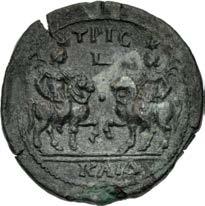
593. EGYPT, Alexandria. Lucius Verus. AD 161-169. Æ Drachm (32mm, 19.04 g, 12h). Dated RY 5 (AD 164/5). Λ AVPHΛIOC OVHPOC CЄB, laureate bust left, slight drapery / Nike seated left on cuirass, holding wreath in outstretched right hand and palm frond in left; L Є (date) before. Köln 2166; Dattari (Savio) 3737; K&G 39.126; RPC IV.4 Online 14086; Emmett 2400.5. Green-red patina, flan crack, smoothing, reverse flan flaws. Good VF. Bold portrait. ($1000)





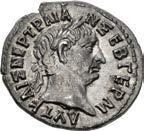


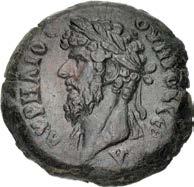


594.
595. EGYPT, Alexandria.
Tetradrachm or Hexadrachm (21mm, 9.71 g, 12h). Dated RY 2 (AD 297/8). ΔOMITI
laureate, draped, and cuirassed bust right / Draped bust of Serapis left, wearing kalathos; L B (date) in fields. Köln –; Dattari (Savio) 10820; K&G 126.8; Emmett 4243.2. Red-brown patina, minor roughness. Near EF. Extremely rare, only two recorded in CoinArchives. ($1500)
From the S & S Collection.
The revolt of Domitius Domitianus in Egypt destabilized a vitally strategic region by interrupting the grain supply to Rome and opening the possibility of a Sasanian invasion. For almost a year, Domitius Domitianus controlled Alexandria and its mint, striking aurei and folles, as well as a series of pre-reform provincial denominations. Diocletian regained control of Alexandria in March, 298 and ended the long tradition of provincial coinage. From this point forward, only imperial denominations were struck at Alexandria until the fall of the Roman empire.
596.
98-117.
Ex Triton XXIV (19 January 2021), lot 927.


Ex Peus 420 (1 November 2017), lot 28;

From
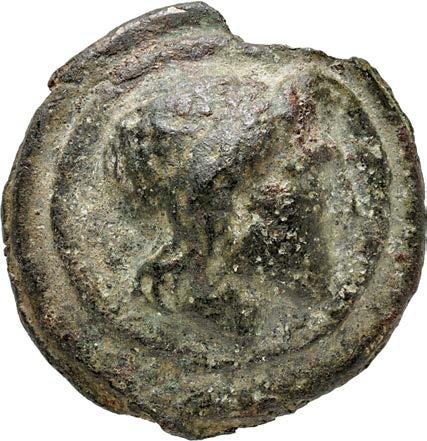
599. Anonymous. 211-208 BC. AV 60 Asses (14mm, 3.35 g, 5h). Rome mint. Bearded head of Mars right, wearing crested Corinthian helmet; çc (mark of value) to left / Eagle standing right on thunderbolt, with wings spread; rOÂA below. Crawford 44/2; Sydenham 226; Bahrfeldt 4a; Biaggi 3; BMCRR Rome 185-6; Kestner 285-6; RBW 160–1. In NGC encapsulation 4938385-042, graded Ch AU, Strike: 5/5, Surface: 4/5. ($10,000)
Ex Hess-Divo 298 (22 October 2003), lot 1098.
The Roman Republic’s earliest large-scale issue of gold coins was part of the massive overhaul of Rome’s coinage system circa 211 BC, at the height of the Second Punic War against Carthage. A whole new system of coinage replaced the old one based on the silver didrachm, or quadrigatus, and clumsy cast Aes Grave. At the top end of the value scale, three gold coin denominations were now issued, all marked with their value in copper asses. All gold coins bore the same design: A helmeted head of Mars on the obverse, and an eagle standing on a thunderbolt on the reverse (the eagle represented Jupiter and was one of the identifying standards carried into battle by the legions). These included a gold 60-as piece, weighing about 3.4 grams, marked with a ↓X (VI times X); a 40-as piece (XXXX), and a 20-as piece (XX). A comparison of the weights of values of the precious metal denominations indicates the relative ratio of silver to gold at this time was about 12 to one. The gold for this considerable issue likely came from Rome’s capture and sack of Syracuse in 212 BC. Unlike the accompanying silver denarius and bronze denominations that were introduced during this reform, the gold issues were discontinued after a few years, and Rome would not resume any coinage in gold for another century and a half.

600.
601.
From
This coin is from the first issue of Sulla, struck in his army camp while
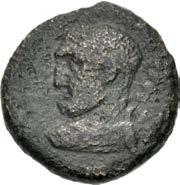





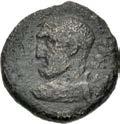

Marius, in Rome. He is the first of the great imperatores of Rome to issue his own personal coinage without the authority of the Senate, the majority of whose members were allied to the Republican-minded Marius.
The iconography of this issue is telling of the self-promotion of Sulla, as the types and legends only refer to himself rather than some ancestor as was typical of the Republican coinage up to that time. Venus appears as she is the patron of Sulla, whom he regards as responsible for his successes for which he received his two acclamations of imperator by his troops. These two acclamations are commemorated by the reverse; the legend and the two trophies are overt references. The jug and lituus, though, are more subtle, but also probably symbolic of his claim to imperium rather than a reference to his holding a position in one of the priestly colleges in Rome. This issue, which transformed Roman coinage into a form of overt propaganda for the issuer (rather than his family), set a precedent which was followed by all the later imperatores and directly led to the development of the imperial coinage.
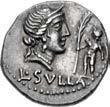
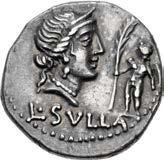
602. C. Poblicius Q.f. 80 BC. AR Serrate Denarius (20mm, 4.09 g, 10h). Rome mint. Draped bust of Roma right, wearing helmet ornamented with griffin’s head, and at each side a feather; D above, rOÂA to left / Hercules, naked, standing left, and strangling the Nemean Lion; club on ground at his feet, bow case to left, D above left, C • pOBLiCi • œ • F to right. Crawford 380/1; Sydenham 768; Poblicia 9; Kestner –; BMCRR Rome 2899; RBW –. Light iridescent toning, traces of deposits and die rust, tiny hairline flan crack. Choice EF. Bold reverse. ($1500)









Ex Numismatica Ars Classica 15 (18 May 1998), lot 113.
603. L. Rustius. 74 BC. AR Denarius (18mm, 3.95 g, 5h). Rome mint. Helmeted head of young Mars right; • (mark of value) below chin / Ram standing right. Crawford 389/1; Sydenham 782; Rustia 1; BMCRR Rome 3271; Kestner 3266; RBW 1423. Old cabinet tone, light iridescence. Good VF. ($750)


From the S & S Collection. Ex Edward J. Waddell inventory 42753 (early-mid 1990s).
604. C. Hosidius C.f. Geta. 64 BC. AR Denarius (17mm, 4.09 g, 5h). Rome mint. Diademed and draped bust of Diana right, with bow and quiver over shoulder; iii uir downward to left, geTA downward to right / Calydonian boar standing right, pierced by spear and attacked by dog; C hOÍiDi C F in exergue. Crawford 407/2; Sydenham 903; Hosidia 1; BMCRR Rome 3388; Kestner 3317–8; RBW 1456. Lightly toned, some luster at the high points, slight delamination flaw on reverse. Choice EF. A superb example of the type. ($1000)
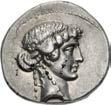
Ex Count Emery Hutten Czapski Collection (Spink 374, 16 January 2022), lot 434.
605. L. Torquatus. 58 BC. AR Denarius (18.5mm, 3.99 g, 6h). Rome mint. Head of Sibylla right, wearing ivy wreath; [ÍiBULLA below]; all within border of dots / Tripod surmounted by amphora between two stars; L • TOrœuAT downward to left, iii • uir upward to right; all within ornamented torque. Crawford 411/1b var. (border of dots); Sydenham 836; BMCRR Rome 3514; Manlia 12a; RBW –. Lustrous, a few tiny spots of encrustation. EF. From dies of fine style. ($2000)
Ex Bertolami Fine Arts 67 (11 July 2019), lot 288.

606. Servius Sulpicius. 51 BC. AR Denarius (19.5mm, 3.82 g, 6h). Rome mint. Head of Apollo right, wearing laurel wreath; Íer downward to left, Í^p upward to right / Ornate naval trophy, consisting of a central vexillum atop prow of galley set on base, and decorated with rudder, palm frond, anchor, apluster and prow; to left, draped figure standing facing, head right; to right, naked Macedonian captive standing facing. Crawford 438/1; Sydenham 931; Sulpicia 1; RBW 1553. Old collection tone, scrapes on obverse. Good VF. Very rare. ($1500)
Ex Marti Hervera (19 March 1998), lot 115; I. Vecchi 4 (5 December 1996), lot 14.
The moneyer, and the reverse of this rare type, remain somewhat enigmatic. He was clearly a member of the prestigious Sulpicia gens, perhaps the son of Servius Sulpicius Rufus, consul in 51 BC. The reverse seems to show the auction of captive slaves following a Roman naval victory. Which event the reverse commemorates, however, is uncertain. Pompey’s defeat of the pirates has been suggested as the key event, but this occurred in 67-66 BC, well before the issue was struck. Additionally, that victory involved none of the Sulpicii. Crawford suggests that it refers to the victory of C. Sulpicius Paterculus (possibly a direct ancestor of the moneyer), who prevailed in 258 BC over the Carthaginian admiral Hannibal Gisco in the First Punic War. Another alternative is that the reverse refers to the victory achieved by P. Sulpicius Galba Maximus over Macedon’s navy in 209/8 during the Second Punic War.
607. Moneyer issues of Imperatorial Rome. L. Hostilius Saserna. 48 BC. AR Denarius (18mm, 4.03 g, 11h). Rome mint. Bare head of Gallia right, wearing long, disheveled hair; carnyx (Gallic trumpet) to left / Diana (Artemis) of Ephesus standing facing, laureate, wearing long hair falling down her shoulders and long flowing robes, holding spear in left hand and stag by its antlers in her right; ÍAÍerNA upward to left, L • hOÍTiLiuÍ downward to right. Crawford 448/3; CRI 19; Sydenham 953; Hostilia 4; BMCRR Rome 3996-8; Kestner 3541; RBW 1570. Nicely toned with light iridescence, minor porosity, obverse slightly off center. Near EF. ($750)

From the S & S Collection. Ex Edward J. Waddell inventory 42717 (early-mid 1990s).
608. Moneyer issues of Imperatorial Rome. T. Carisius. 46 BC. AR Denarius (16mm, 3.67 g, 1h). Rome mint. Head of Juno Moneta right, hair tied in bun behind, with one lock falling down neck, wearing cruciform earring and necklace; ÂONeTA downward to left / Implements for coining money: anvil die with garlanded punch die above, tongs and hammer on either side; T CAriÍiuÍ above; all within laurel wreath. Crawford 464/2; CRI 70; Sydenham 982a; Carisia 1a; BMCRR Rome 4057; Kestner –; RBW 1614. Light hairlines, struck on a broad flan, area of weak strike on reverse, otherwise sharp. Near EF. ($750)




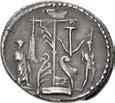




610. The Pompeians. Q. Caecilius Metellus Pius Scipio and P. Licinius Crassus Junianus. 47- Spring 46 BC. AR Denarius (15mm, 3.96 g, 9h). Utica mint. Genius of Africa (Sekhmet) standing facing, holding ankh in right hand; gT A flanking head, ÍCipiO • iÂp upward to left, œ • ÂeTeL • piuÍ downward to right / Victory standing left, holding winged caduceus in right hand, small round shield in left; Leg prO pr upward to left; p • CrAÍÍuÍ • iuN downward to right. Crawford 460/4; CRI 43; Caecilia 51; Sydenham 1050; BMCRR Africa 8; Kestner 3585; RBW 1604. Light hairlines, small scrape on obverse. Near EF. Rare. ($1000)

611.
(18.5mm, 3.65 g, 6h).
 • pOBLiCi
Crawford 469/1e;
From the D.K. Collection.
612. The
BC. AR Denarius (18.5mm, 3.80 g, 3h). Uncertain Sicilian mint. Bare head of Pompey the Great right; capis to left, lituus to right; ÂAg • piuÍ • iÂp • iTer around / Neptune, naked but for chlamys on left arm, holding apluster and resting right foot on prow, standing left between the Catanaean brothers Anapias and Amphinomus running in opposite directions, bearing their parents on their shoulders; pr‰F above; CLAÍ • eT • Or‰/ºiT • ex • Í • C in two lines in exergue. Crawford 511/3a; CRI 334; Sydenham 1344; RSC 17 (Pompey the Great); BMCRR Sicily 7-10; Kestner 3783-4; RBW 1785. Deeply toned, minor scratches. Good VF. ($2000)
From the S & S Collection.
Sextus Pompey came of age during the ascendancy of his father, Gnaeus Pompeius Magnus (Pompey the Great), as the leading general of Rome. After Pompey’s defeat by Julius Caesar at Pharsalus in August of 48 BC, and his treacherous murder in Egypt later that year, Sextus joined the Pompeian resistance to Caesar in Spain. Caesar’s assassination on March 15, 44 BC brought a brief revival of Senatorial control, during which Sextus relocated to Massalia in southern Gaul. In April of 43 BC, the Senate appointed him commander of the Roman fleet. Although the promotion was rescinded three months later, Sextus wasted no time in seizing Sicily and spent the next months building an impregnable power base on the island even as Rome fell under the sway of Caesar’s political heirs, the Triumvirs Antony, Octavian and Lepidus. While the Triumvirs hunted down Caesar’s assassins, Sextus enjoyed a rollicking life as a pirate king, using his fleet to raid far and wide.
This attractive denarius belongs to his piratical period on Sicily and honors his father, Pompey the Great, on the obverse, while the reverse depicts the sea god Neptune along with the semi-legendary Catanean twins, Anapius and Amphinomus, who rescued their parents from an eruption of Mount Aetna and became symbols of filial piety.
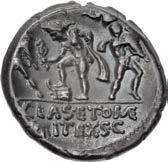







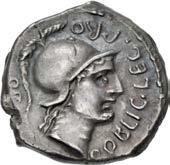

613. The Caesarians. Julius Caesar. April-August 49 BC. AR Denarius (17mm, 3.94 g, 9h). Military mint traveling with Caesar. Elephant advancing right, trampling on horned serpent; CAeÍAr in exergue / Emblems of the pontificate: simpulum, aspergillum, securis, and apex. Crawford 443/1; CRI 9; Sydenham 1006; RSC 49; BMCRR Gaul 27-30; Kestner 3515-8; RBW 1557. Iridescent toning. In NGC encapsulation 6290527-007, graded Ch AU, Strike: 5/5, Surface: 5/5. ($1000)
614. The Caesarians. Julius Caesar. April-August 49 BC. AR Denarius (18mm, 3.97 g, 1h). Military mint traveling with Caesar. Elephant advancing right, trampling on horned serpent; CAeÍAr in exergue / Emblems of the pontificate: simpulum, aspergillum, securis, and apex. Crawford 443/1; CRI 9; Sydenham 1006; RSC 49; BMCRR Gaul 27-30; Kestner 3515-8; RBW 1557. Lightly toned with iridescence, slightly off center. EF. Well struck. ($2000)
Ex CNG inventory 848484 (October 2009).
615. The Caesarians. Julius Caesar. April-August 49 BC. AR Denarius (19mm, 3.98 g, 1h). Military mint traveling with Caesar. Elephant advancing right, trampling on horned serpent; CAeÍAr in exergue / Emblems of the pontificate: simpulum, aspergillum, securis, and apex. Crawford 443/1; CRI 9; Sydenham 1006; RSC 49; BMCRR Gaul 27-30; Kestner 3515-8; RBW 1557. Deep cabinet tone, reverse a bit off center, a few scattered marks. Choice EF. ($3000)



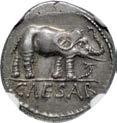



From the DMS Collection. Ex CNG inventory 839509 (August 2009); Bob Levy Collection (Leu 57, 25 May 1993), lot 175.
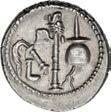
616. The Caesarians. Julius Caesar. April-August 49 BC. AR Denarius (17.5mm, 3.71 g, 12h). Military mint traveling with Caesar. Elephant advancing right, trampling on horned serpent; CAeÍAr in exergue / Emblems of the pontificate: simpulum, aspergillum, securis, and apex. Crawford 443/1; CRI 9; Sydenham 1006; RSC 49; BMCRR Gaul 27-30; Kestner 3515-8; RBW 1557. Lightly toned, minor porosity, small die flaw on obverse. EF. ($2000)



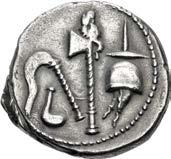

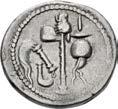
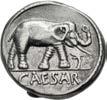
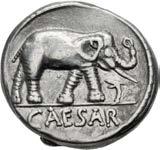


From the GTP Collection. Ex CNG inventory 942419 (January 2013).
617. The Caesarians. Julius Caesar. April-August 49 BC. AR Denarius (17mm, 3.78 g, 5h). Military mint traveling with Caesar. Elephant advancing right, trampling on horned serpent; CAeÍAr in exergue / Emblems of the pontificate: simpulum, aspergillum, securis, and apex. Crawford 443/1; CRI 9; Sydenham 1006; RSC 49; BMCRR Gaul 27-30; Kestner 3515-8; RBW 1557. Lightly toned, minor scratches, small die flaw on obverse. Good VF. ($1000)
618. The Caesarians. Julius Caesar. April-August 49 BC. AR Denarius (17mm, 3.92 g, 5h). Military mint traveling with Caesar. Elephant advancing right, trampling on horned serpent; CAeÍAr in exergue / Emblems of the pontificate: simpulum, aspergillum, securis, and apex. Crawford 443/1; CRI 9; Sydenham 1006; RSC 49; BMCRR Gaul 27-30; Kestner 3515-8; RBW 1557. Light hairlines, minor porosity. Near EF. ($1000)
619. The Caesarians. Julius Caesar. Late spring-early summer 48 BC. AR Denarius (19mm, 3.99 g, 3h). Military mint traveling with Caesar, probably commencing after the battle of Pharsalus, 9 August 48 BC. Diademed female head (Clementia?) right, wearing oak wreath, cruciform earring, necklace, hair collected into a knot behind, and falling in locks down her neck; %ii (= 52, Caesar’s age) to left / Trophy of Gallic arms, wearing horned helmet, holding oval shield ornamented with thunderbolt in right hand and carnyx in left; securis to right, CAe ÍAr across lower field. Cf. Crawford 452/4-5 (for obv.) and 452/2 (for rev.); cf. CRI 12-13/11 (for obv./rev.); cf. Sydenham 1010-1/1009 (for obv./rev.); DCA 937; BMCRR Rome –; Kestner –; RBW –; CNG 99, lot 562. Minor marks. Good VF. Knot of hair is not jeweled. Extremely rare hybrid denarius, possibly the sixth known. The rarest of the Julius Caesar denarii. ($2000)

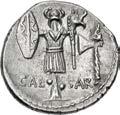


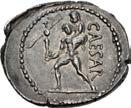

Ex Noble Numismatics 90 (31 March 2009), lot 3405.


This coin is an extremely interesting hybrid of the Crawford 452/4-5 obverse and the 452/2 reverse. As noted in Numismatica Ars Classica 80, 20 October 2014, lot 48: “Not only is the style of Crawford 452/4-5 more delicate and refined than the 452/2 coin (obverse), but more importantly the design of the hair in the chignons [is] completely different. In Crawford 452/4-5, the hair appears to be designed as curls simply tied in a bun, whilst in 452/2 the hair seems to be held [and] covered by a veil; these particular characteristics are only found on obverses of Crawford 452/4 and 5 and never on the ones of 452/2.”
East 31; Kestner 3577-9; RBW 1600. Deep cabinet tone with attractive iridescence, struck on an oval flan. Near EF. ($1000)
Purchased by the consignor from Dr. Arnold R. Saslow (Ye Olde Curiositie Shoppe), 11 November 1995.
Julius Caesar traced his descent all the way back to the Trojan hero Aeneas, legendary founder of the Romans. Aeneas, in turn, was the product of a liaison between the goddess Venus and Anchises, a herdsman who was related to the Trojan royal family. In a scene recounted by Virgil in the Aeneid, when the Greeks torched Troy, Aeneas escaped from the burning city carrying the aged Anchises on his shoulder and the sacred Palladium, a cult statue of Pallas Athena rescued from the household shrine. The scene is depicted on the reverse of this denarius of Caesar, struck in 48-47 BC, at least two decades before the Aeneid was composed. Venus, the mother of Aeneas (and thus the divine antecedent of Caesar) appears on the obverse.
621. The Caesarians. Julius Caesar. Late 48-47 BC. AR Denarius (18mm, 3.78 g, 6h). Military mint traveling with Caesar in North Africa. Diademed head of Venus right / Aeneas advancing left, holding palladium and bearing Anchises on his shoulder; CAeÍAr downward to right. Crawford 458/1; CRI 55; Sydenham 1013; RSC 12; BMCRR East 31; Kestner 3577-9; RBW 1600. Well struck, lustrous. EF. ($1000)
Ex Classical Numismatic Group Electronic Auction 208 (8 April 2009), lot 367.
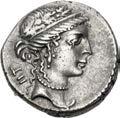



622. The Caesarians. Julius Caesar. Early 46 BC. AV Aureus (19mm, 8.11 g, 6h). Rome mint; A. Hirtius, praetor. Veiled head of female (Vesta or Pietas?) right; C • CAeÍAr COÍ Ter around / Emblems of the augurate and pontificate: lituus, capis, and securis; A • hirTiuÍ • pr around from lower left. Crawford 466/1; Molinari – (D25/R214, unrecorded die pair); CRI 56; Sydenham 1018; Bahrfeldt 19; Calicó 37; Biaggi –; BMCRR Rome 4052; Kestner 3634-6; RBW 1634. Lustrous, a few minor scratches, trace deposits. EF. Fine style portrait. Well centered on a broad flan. ($10,000)
From the Willamette Valley Collection. Ex Bertolami Fine Arts 87 (14 December 2020), lot 447.
Aulus Hirtius, friend and confidant of Julius Caesar, was praetor in 46 BC, and thus charged with the distribution of the first truly large issue of Roman gold coins to date. The aurei were for distribution to the general’s successful troops after their final victory over the Pompeians in Africa at Thapsus. Each legionary received 5000 denarii (200 aurei), centurions twice that. Since Caesar had at least 40,000 legionnaires at Thapsus, the amount of coin needed was immense. But the amount of booty collected from Caesar’s many campaigns was also colossal, and Hirtius seems to have been able to supply the need. Hirtius later finished the dictator’s memoirs after his assassination and was himself killed at the Battle of Mutina in 43 BC.







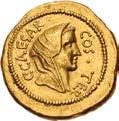
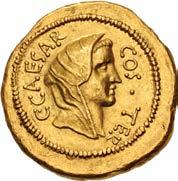

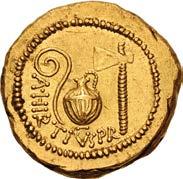
623. The Caesarians. Julius Caesar. Early 46 BC. AV Aureus (21mm, 8.00 g, 5h). Rome mint; A. Hirtius, praetor. Veiled head of female (Vesta or Pietas?) right; C • CAeÍAr COÍ Ter around / Emblems of the augurate and pontificate: lituus, capis, and securis; A • hirTiuÍ • pr around from lower left. Crawford 466/1; Molinari 365 (D58/R263); CRI 56; Sydenham 1018; Bahrfeldt 19; Calicó 37; Biaggi –; BMCRR Rome 4052; Kestner 3634-6; RBW 1634. Minor marks, bend in flan. VF. ($5000)
From the S & S Collection. Ex Frederick Hastings Rindge Collection (Part II, Malter XXX, 7 June 1985), lot 1842.
624. The Caesarians. Julius Caesar. January-February 44 BC. AR Denarius (19mm, 3.45 g, 3h). Lifetime issue. Rome mint. L. Aemilius Buca, moneyer. Laureate head right; CAeÍAr • i downwards to right; to left, large crescent dividing p  / Venus Victrix standing left, holding Victory in extended right hand and leaning on scepter in left; L • AeÂiLiuÍ BuCA around from upper right. Crawford 480/4; Alföldi Type IV, 18 (A4/R21); CRI 102; Sydenham 1060; RSC 22; BMCRR Rome 4152-3; Kestner 3685; RBW –. Light scratch on obverse, areas of soft strike, minor die flaw on obverse. Good VF. ($1500)

625. The Caesarians. Julius Caesar. February-March 44 BC. AR Denarius (18mm, 3.72 g, 7h). Lifetime issue. Rome mint; C. Cossutius Maridianus, moneyer. Laureate and veiled head right; CAeÍAr downwards to right, DiCT • iN • perpeTuO upwards to left / Venus Victrix standing left, holding Victory in extended right hand and resting left arm on shield set on globe to right; C • ÂAriDiANuÍ downwards to right. Crawford 480/16; Alföldi Type XIX, 23 (dies A6/R4); CRI 111; Sydenham 1067; RSC 9; RBW –. Lightly toned. In NGC encapsulation 6290513-004, graded Ch XF, Strike: 3/5, Surface: 4/5. Expressive portrait. ($5000)
For two centuries, Rome had spurned the Hellenistic practice of placing the ruler’s portrait, or any living person, on its coinage. So, early in 44 BC, many Romans must have been stunned to see the image of Julius Caesar, recently appointed to an unprecedented fourth term as dictator, stamped upon newly minted silver denarii. Like a profusion of other honors and titles, the right to place his image on coins had been bestowed on Caesar by the Roman Senate. Caesar’s enemies may have had an ulterior motive in pushing for the honor, as it certainly fueled the growing suspicion that Caesar intended to name himself king (Rex) of Rome, an intolerable offense to tradition. If this was their intent, it succeeded, for within three months a conspiracy had been formed and Caesar was assassinated at a meeting of the Senate on March 15, 44 BC. This silver denarius carries a startlingly realistic, warts-and-all portrait of Caesar on the obverse and the image of the dictator’s patron goddess, Venus, on the reverse. The obverse legend acclaims Caesar as DICT IN PERPETVO -- Perpetual dictator -- a title bestowed by the Senate between January 26 and February 15 of 44 BC. Caesar’s shattering of tradition would continue after his death, as portraits of living Romans on the state’s coinage began to proliferate, ultimately even among his assassins.
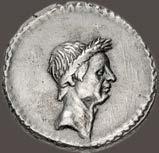



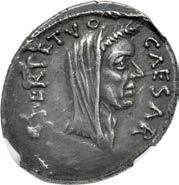


626 627
626. The Caesarians. Julius Caesar. 42 BC. AR Denarius (17mm, 3.86 g, 10h). Rome mint. L. Livineius Regulus, moneyer. Wreathed head of Caesar right; laurel branch to left, winged caduceus to right / Bull charging right; L • LiuiNeiuÍ above, reguLuÍ below. Crawford 494/24; CRI 115; Sydenham 1106; RSC 27; BMCRR Rome 4274-6; Kestner 3729-30; RBW 1730. Lightly toned. In NGC encapsulation 4936382-001, graded Ch XF(star), Strike: 5/5, Surface: 5/5, Fine Style. ($10,000)


627. The Caesarians. Julius Caesar. 42 BC. AR Denarius (17mm, 3.76 g, 12h). Rome mint; L. Mussidius Longus, moneyer. Laureate head right / Rudder, cornucopia on globe, winged caduceus, and apex; L • ÂuÍÍiDiuÍ • LONguÍ in semicircle above. Crawford 494/39a; CRI 116; Sydenham 1096a; RSC 29; BMCRR Rome 4238-9; Kestner 3750; RBW 1742. Lightly toned. Near EF. Beautifully centered and well struck for issue. Rare as such. ($5000)
Ex Dr. John Whitehead Collection; CNG inventory 804308 (December 2007); Hess-Divo 308 (24 October 2007), lot 128.
628. The Republicans. C. Cassius Longinus. Spring 42 BC. AR Denarius (17mm, 3.91 g, 6h). Military mint, probably at Smyrna; P. Cornelius Lentulus Spinther, legatus. Tripod surmounted by cortina and two laurel branches, fillet hanging on either side; C • CAÍÍi upwards to left, iÂp upwards to right / Capis and lituus; LeNTuLuÍ/ÍpiNT in two lines below. Crawford 500/1; CRI 219; Sydenham 1308; RSC 7; BMCRR East 79; Kestner –; RBW 1761. Lustrous, reverse slightly off-center. EF. ($2000)






From the Brian Holland Collection. Ex Classical Numismatic Group Electronic Auction 216 (12 August 2009), lot 430.
629. Moneyer issues of Imperatorial Rome. C. Cassius Longinus. Spring 42 BC. AV Aureus (19mm, 7.97 g, 7h). Diademed head of Libertas right; C • CAÍÍi • iÂp upward to left, LeiBerTAÍ upward to right / Capis and lituus; LeNTuLuÍ/ ÍpiNT in two lines below. Crawford 500/2; CRI 220; Calicó 65; Sydenham 1306; BMCRR East 76; RBW –. Minor marks, underlying luster. VF. Very rare. ($20,000)
P. Cornelius Lentulus Spinther and M. Servilius were joint legates to Cassius and Brutus, and both issued coins in the names of their generals. Lentulus Spinther was born in 74 BC and assumed the toga virilis in 57 BC, and in the same year was elected to the college of augurs. After the murder of Caesar, he joined the parties of Cassius and Brutus and was probably killed at Philippi. The reverse type of this coin refers to Lentulus’ appointment to the college of augurs, and is one of the few instances in imperatorial coinage in which a moneyer used a reverse type that was personal to himself.

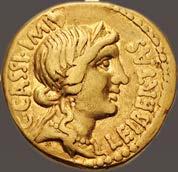

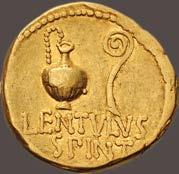
631. The Republicans. C. Cassius Longinus. Spring 42 BC. AR Denarius (20mm, 3.85 g, 6h). Military mint, probably at Smyrna; P. Cornelius Lentulus Spinther, legatus. Diademed head of Libertas right; C • CAÍÍi • iÂp upward to left, LeiBerTAÍ upward to right / Capis and lituus; LeNTuLuÍ/ÍpiNT in two lines below. Crawford 500/3; CRI 221; Sydenham 1307; RSC 4; BMCRR East 77; Kestner 3767; RBW 1762. Old cabinet tone with hints of iridescence, a few light scratches under tone. Near EF. ($1500)

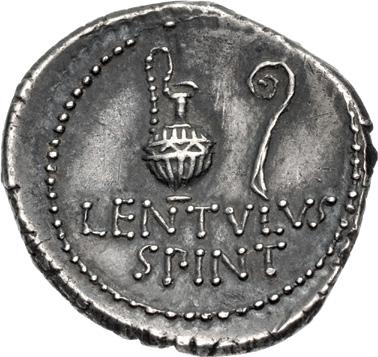
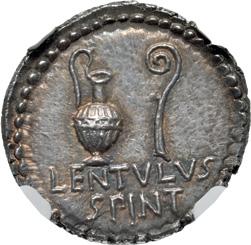
Ex Tauler and Fau 95 (2 November 2021), lot 251; Poinssot Collection (assembled 1879-1967).
632. The Republicans. Brutus. Early 42 BC. AR Denarius (18mm, 3.96 g, 12h). Military mint, probably at Smyrna; P. Cornelius Lentulus Spinther, legatus. Emblems of the pontificate: securis, simpulum, and secespita; BruTuÍ below / Emblems of the augurate: capis and lituus; LeNTuLuÍ/ÍpiNT in two lines below. Crawford 500/7; CRI 198; Sydenham 1310; RSC 6; BMCRR East 80-1; Kestner 3770; RBW 1766. In NGC encapsulation 5780848-005, graded MS★, Strike: 5/5, Surface: 5/5. Exceptional iridescent tone and strike. Among the finest known. ($5000)


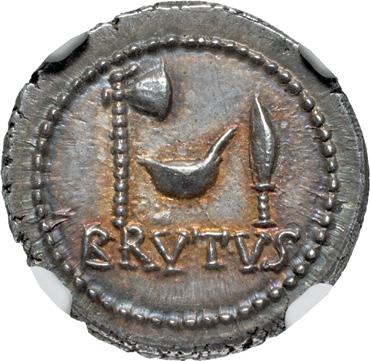
Ex Nomos AG 2 (18 May 2010), lot 159.
Although religion was an essential part of Roman daily life, Rome had no separate priestly class or caste. Instead, religious practice was interwoven with civic and political life and all public men and women were expected to learn, observe and practice civic rites. Priesthoods were bestowed on members of rich, powerful or politically connected families; politicians and military men often served as Pontiffs (high priests), Flamens (cult leaders), and Augurs (interpreters of signs), while their daughters were named Vestals (keepers of the sacred flame). This coin of Marcus Junius Brutus, leader of Caesar’s assassins, depicts the tools of the Pontificate on the obverse, including the securis victima (sacrificial axe), simpulum (dipper for libations), and secespita (sacrificial knife). The reverse depicts tools of the Augurate: The capis (ritual bowl for entrails) and the lituus (augur’s wand, used to divide the sky into quadrants for studying the flight of birds).
633. The Republicans. Cn. Domitius L.f. Ahenobarbus. 41-40 BC. AR Denarius (19mm, 3.97 g, 5h). Uncertain mint in the region of the Adriatic or Ionian Sea. Bare head of Ahenobarbus right, wearing short beard; AheNOBAr upward to right / Prow right surmounted by a military trophy; CN • DOÂiTiuÍ • iÂp around from lower left. Crawford 519/2; CRI 339; Sydenham 1177; Domitia 21; BMCRR East 94-7; Kestner 3801-2; RBW 1803. Some die wear and peripheral roughness on reverse, some luster remains. EF. ($3000)



Gnaeus Domitius Ahenobarbus commanded a fleet against the Triumvirs, achieving a minor victory in September of 42 BC. But that very day, the Triumvirs won the battle of Philippi, and Ahenobarbus found himself fighting for a lost cause. He became a piratical rogue, terrorizing the ports of the Adriatic like his western counterpart, Sextus Pompey, until he signed the Pact of Brundisium in 40 BC, which reconciled him to Mark Antony. His great-grandson would become the Emperor Nero (AD 54-68). The rare coinage of Ahenobarbus belongs to his stint as a “pirate king” 42-40 BC. This silver denarius bears an appropriately nautical reverse celebrating his victories at sea. The balding, bearded portrait on the obverse remains enigmatic; it may represent Gnaeus himself, or one of his ancestors.

634 635
634. The Republicans. Labienus. Early 40 BC. AR Denarius (19mm, 3.67 g, 5h). Uncertain mint in Syria or southeastern Asia Minor. Bare head right; œ • LABieN[uÍ pA]rThiCuÍ • iÂp around / Horse standing right on ground line, wearing saddle with quiver attached and bridle. Crawford 524/2; Hersh 15 (dies F/13); CRI 341; Sydenham 1357; RSC 2; BMCRR East 132; Kestner –; RBW 1809. Toned, banker’s marks. Near VF. Very rare. ($10,000) Ex Paulo Leitão Collection.


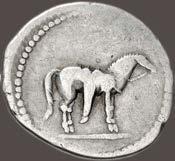

635. The Republicans. Labienus. Early 40 BC. AR Denarius (18.5mm, 3.63 g, 5h). Uncertain mint in Syria or southeastern Asia Minor. Bare head right; œ • LABieNuÍ pArThiCuÍ • iÂp around / Horse standing right on ground line, wearing saddle with quiver attached and bridle. Crawford 524/2; Hersh 19 (dies F/17); CRI 341; Sydenham 1357; RSC 2; BMCRR East 132; Kestner –; RBW 1809. Toned, porous, old scratches and cleaning marks, irregular flan. Near VF. Very rare. ($10,000)
Quintus Labienus’ father, a loyal Republican despite his distinguished service to Caesar in Gaul, died at the battle of Munda in 45 BC. His son joined the Republican cause and was sent to Persia to negotiate a pact of assistance with Orodes I, remaining at the Parthian court after the defeat of Brutus and Cassius in 42 BC. Orodes, concerned about the growing Roman presence in Asia and learning of growing dissatisfaction in the provinces, sent his son Pacorus and a large and heavily armored cavalry force with Labienus on an invasion of Syria in 40 BC. Labienus quickly subdued Syria and Cilicia and sent forces into Lycia and Caria before Ventidius Bassus arrived from Greece with eleven legions. Labienus and his allies were driven back to Cilicia, where the Parthian cavalry was routed at Mt. Taurus and Labienus was killed. Labienus, the last of the Republicans, died a traitor to Rome, and all but a handful of his coinage was melted down after his defeat.
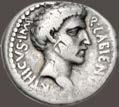


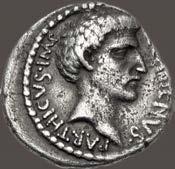
636. The Triumvirs. Mark Antony. April-May 44 BC. AR Denarius (18mm, 3.40 g, 1h). Rome mint; P. Sepullius Macer, moneyer. Veiled head right, wearing beard; capis to left, lituus to right / Desultor (horseman who leaps from one horse to another), wearing conical cap and holding whip in right hand, right on horseback, second horse at side in background; palm frond and wreath to left; p • ÍepuLLiuÍ above, ÂACer below. Crawford 480/22; Alföldi Type XXI, 27 (A7/R4); CRI 142; Sydenham 1077; RSC 74; BMCRR Rome 4178; Kestner –; RBW 1689. Deep cabinet tone, slightly clashed reverse die, off center. Good VF. ($1000)
From the S & S Collection.
637. The Triumvirs. Mark Antony. 42 BC. AR Denarius (18mm, 4.18 g, 6h). Rome mint; C. Vibius Varus, moneyer. Bare head right, wearing short beard / Fortuna, draped, standing left, holding Victory in outstretched right hand and cradling cornucopia in left; C • uiBiuÍ downwards to right, uAruÍ upwards to left. Crawford 494/32; CRI 149; Sydenham 1144; RSC 4; BMCRR Rome 4293-4; Kestner 3739-40; RBW –. Iridescent toning, light scratches and marks under tone, reverse slightly off center. Good VF. Strong portrait of Antony. ($5000) Ex Aretusa 4 (22 March 1996), lot 401.

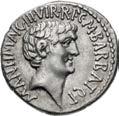

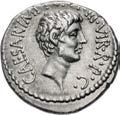



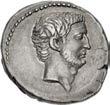

638. The Triumvirs. Mark Antony and Octavian. Spring-early summer 41 BC. AR Denarius (18mm, 4.02 g, 12h). Ephesus mint; M. Barbatius Pollio, quaestor pro praetore. Bare head of Mark Antony right;  ANT • if Yg iii uir • r • p • C •  BArBAT œ p around / Bare head of Octavian right, with slight beard; CAeÍAr • iÂp • pONT • iii • uir • r • p • C • around. Crawford 517/2; CRI 243; Sydenham 1181; RSC 8a; BMCRR East 100; Kestner 3793-5; RBW 1798. Minor marks, small die flaws on reverse. Near EF. ($1500)

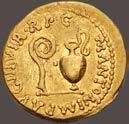
639. The Triumvirs. Mark Antony. Early summer 40 BC. AV Aureus (20mm, 7.58 g, 5h). Military mint traveling with Antony in Greece; L. Munatius Plancus, moneyer. Lituus and capis; Â • ANTON • iÂp • AuG • iii • uir • r • p • G around / Sacrifical jug with handle between winged thunderbolt and winged caduceus; L • pLANCuÍ • pRO • COÍ around. Crawford 522/1; Bahrfeldt 85; CRI 252; Calicó 89; Sydenham 1190; BMCRR East, p. 496 note; Biaggi –; Kestner –; RBW –. Minor scratches, residual luster. VF. Of the highest rarity and the only example available. ($100,000)
Lucius Munatius Plancus was a central figure in the political and military landscape of the late Republic and early Principate, and his career serves as a roll call of the famous names from this period. He had served as a legate of Julius Caesar during the Gallic War, and as proconsul of Transalpine Gaul from 44 to 43 BC. He fought with Caesar against Pompey during the Civil War and, after Caesar’s assassination, was encouraged by Cicero to oppose Antony. Following his participation in the War of Mutina in 43, against Decimus Brutus, Plancus held the consulship with Lepidus in 42, and allied himself with Antony, as evidenced by the striking of this aureus in 40 BC.
Plancus participated in the Perusine War in 41-40 BC, where he assisted Lucius Antony in annihilating one of Octavian’s legions before fleeing to Greece with Mark Antony’s wife, Fulvia. Following the Peace of Brundisium, he served as proconsul of Asia where he fought against Quintus Labienus and the Parthian prince, Pacorus I. He later joined with Ahenobarbus to capture Sextus Pompey, before switching allegiance once again, perhaps because he was uncomfortable with Cleopatra’s growing influence over Antony, to Octavian in 32. Indeed, it was Plancus who proposed that Octavian take the name Augustus during the First Settlement of 27 BC.
Plancus died circa 15 BC in Gaeta, Italy where his tomb still stands, recording his career as Consul, Censor, twice Imperator and Septemvir Epulonum; a monument to a man whose political and moral flexibilities enabled him to live into old age at a time when many of his contemporaries succumbed to a more brutal end.
His coinage, from his first issues struck under Julius Caesar in 45 BC, all feature the distinctive, one-handled jug on the reverse, possibly symbolizing his membership of the priestly college of the Epulones. The iconography of this aureus follows that of the denarii of the same issue, featuring both the lituus and capis on the obverse, symbolizing Antony’s status as augur, and a thunderbolt and winged caduceus flanking the jug on the reverse. Within this issue, two different types exist variably naming Plancus as either Proconsul or Imperator Iterum While examples of both are known for his denarii, the aureii are considerably rarer, with no examples of the PRO COS variety accounted for since two examples held in the Paris cabinet were lost in the robbery of 1831. The present coin therefore presents the only opportunity to own an example of this aureus of this remarkable individual.

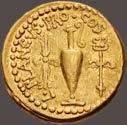

640. The Triumvirs. Mark Antony and Octavian. Late 40-early 39 BC. AR Denarius (18.5mm, 3.51 g, 5h). Mint in central or southern Italy. Bare head of Antony right; Â • ANTON • iÂp • iii • uir • r • p • Caround / Bare head of Octavian right, wearing slight beard; CAeÍAr • iÂp • iii • uir • r • p • C • around. Crawford 528/2b; CRI 261a; Sydenham 1193a; RSC 1b; RBW 1814. Light iridescent tone, some marks, minor obverse die break. Good VF. Rare variety. ($750) From the S & S Collection.
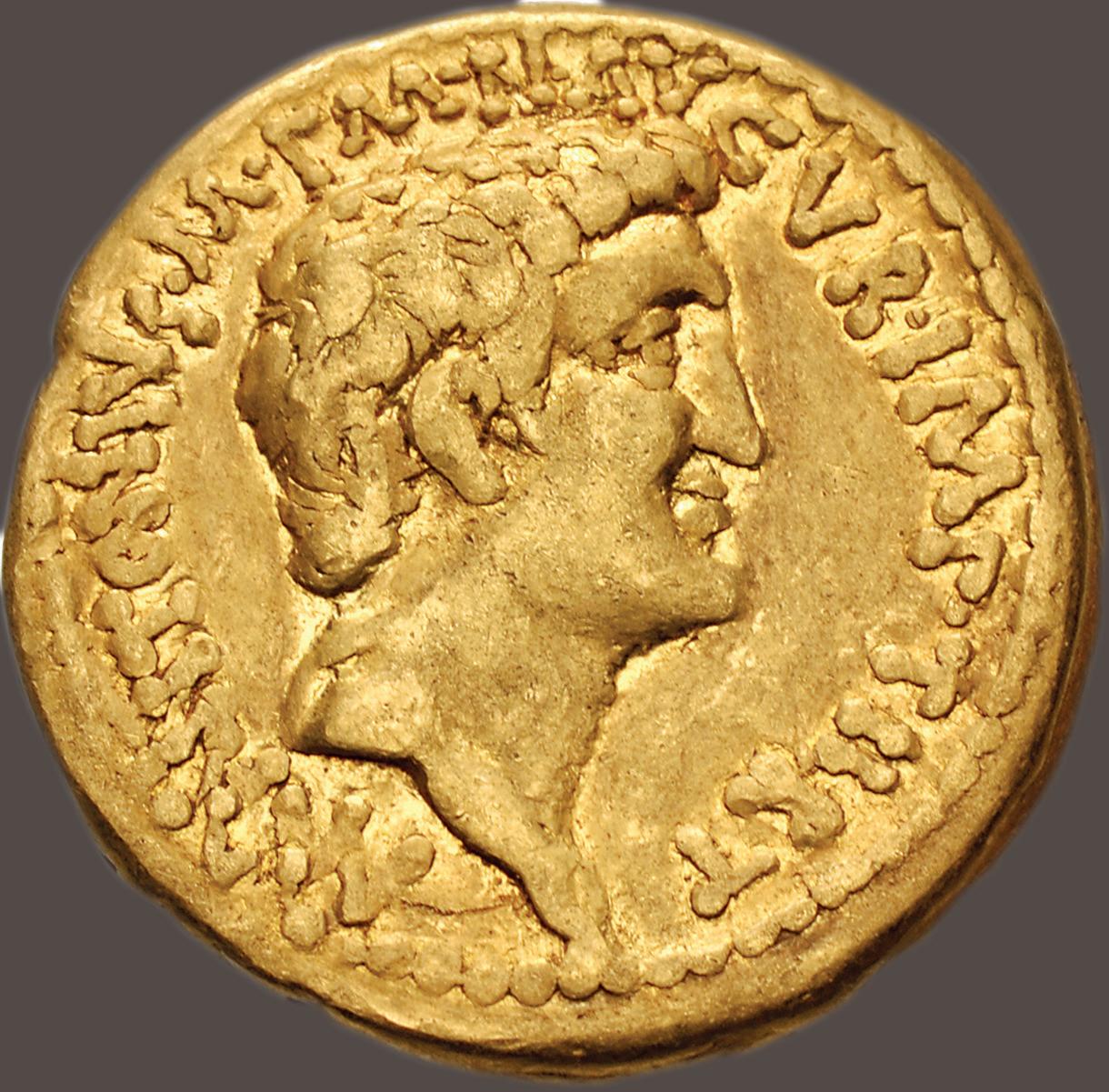



641. The Triumvirs. Mark Antony and Octavia. Summer-autumn 39 BC. AV Aureus (20mm, 8.02 g, 11h). Athens mint. Bare head of Mark Antony right; Â • ANTONiuÍ • Â • F • Â • N • Augur • iÂp • TiirT around / Head of Octavia right, her hair tied in a knot behind with one long plait arranged as a loop on top of her head; COÍ • DiiÍiG • iTiir • iiT • TiirT • iii • uir • r • p • C around. Crawford 533/3b; CRI 269; Bahrfeldt 91; Calicó 116; Sydenham 1201; BMCRR East 145; RBW –. Minor marks, residual luster. VF. Exceptionally rare variety of an extremely rare issue. Possibly the second recorded example. ($50,000)
The aurei of this issue that have appeared at auction over the last twenty years have different obverse and reverse legends to the example offered here (cf. Crawford 533/3a). The only example of this specific type, and with these legends, to have been publicly offered at auction was the same coin that was published by Eckhel in his 1828 Doctrina Numorum Veterum (VI, pp. 46-7), where it was described as being the only example known, prior to it selling in Sotheby’s Metropolitan Museum of Art sale (Part I, 10 November 1972, lot 11), where it was described as being “of the highest rarity and probably unique.”
Shortly after the Battle of Philippi in 42 BC, cracks began to appear in the Second Triumvirate. Antony’s affair with Cleopatra, queen of Egypt, and his designs on Rome’s eastern holdings, prompted Octavian to formulate a binding agreement that would buy him time to strengthen his own position. At Brundisium a pact was signed, bringing about a reconciliation and some semblance of peace. As a condition of this reconciliation, Antony was married to Octavian’s widowed sister, Octavia. She stayed with him in Athens while he continued to prepare for a war against Parthia, and where, in 39 BC, he was associated with the “New Dionysus”. In 37 BC, she helped negotiate the Pact of Tarentum, which renewed the triumvirate until 33 BC. Antony, by this time, however, had renewed his affair with Cleopatra. He remained in the East, where he married the queen, and subsequently fathered several children. In 32 BC, as a renewal of civil war became imminent, Antony divorced Octavia. In the aftermath of Antony’s death, Octavia, known for her loyalty and nobilty, brought Antony’s surviving children to Rome to live with her.


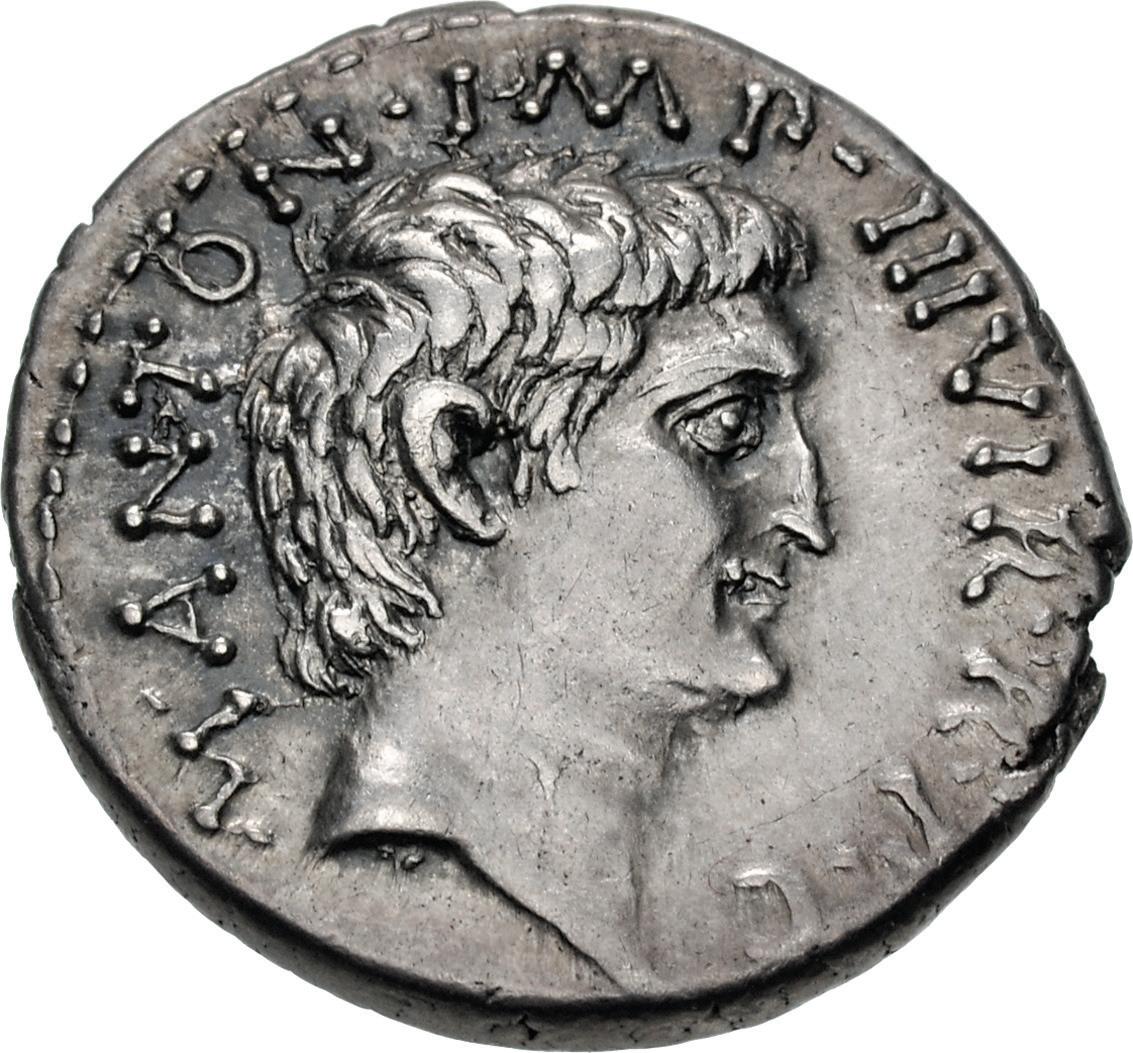



642. The Triumvirs. Mark Antony. Summer 32 BC. AR Denarius (19mm, 3.80 g, 11h). Athens mint. Bare head right; small p (signature) in hair below ear; ANTON • Aug iÂp iii COÍ DeÍ iii • iii u r p C around / ANTONiuÍ/Aug • iÂp • iii in two lines. Crawford 542/2; CRI 347; Sydenham 1209; RSC 2; BMCRR East 177; Kestner 3834-5; RBW 1831. Minor marks, off center obverse, flan and die flaw on reverse. EF. ($2000)

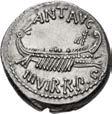






After Mark Antony left his wife Octavia in Greece to resume his liaison with Cleopatra VII of Egypt in 36 BC, full-scale war for control of the Roman world became inevitable between Antony and Octavian, his fellow triumvir and brother of Octavia. A propaganda campaign began as both sides started marshaling forces and producing the money needed to pay the vastly expanded armies. However, their resources were unequal, with Antony possessing the wealthy eastern provinces and Egypt, while Octavian controlled the relatively impoverished west. Consequently, silver and gold coins struck in Antony’s name greatly outnumbered those of Octavian even before the legionary series commenced. Antony’s coinage of 34 BC, struck after the infamous Donations of Alexandria, stressed his partnership with Cleopatra, but this provided fodder for Octavian’s propagandists, who claimed Antony had become the queen’s slave and had ceased being a Roman. In 32 BC, Octavian forced Antony’s supporters out of the Senate and obtained a declaration of war against Egypt. Antony anticipated this action and had already begun moving his legions to Greece, with the intention of staging up for an invasion of Italy. It was there, probably at Antony’s winter quarters in Patrae, that the legionary denarius entered production in the fall of 32 BC, naming the individual units making up his formidable force. Unusually for the era, the coins eschew any portraiture and instead celebrate both the land and naval components of Antony’s military force, with the obverse depicting a war galley under oar, and the reverse depicting a legionary eagle (aquila) flanked by two cohort standards (signa). Antony is identified as the issuer by name and his titles, ANT AVG III VIR R.P.C, abbreviating Antonii auguris, tresviri rei publicae constituendae (”Antony, Augur and Triumvir for the Organizing of the Republic”). The reverses name 22 legions (Legiones II - XXIII); all examples naming a “first legion” (LEG PRI) seem to be forgeries of later eras. Three legions, specifically raised by Antony, receive special names along with their numerals, LEG XII ANTIQVAE (“venerable”), LEG XVII CLASSICAE (“of the fleet”), and LEG XVIII LYBICAE (“Lybian”); coins with the same legionary numeral but no epithet were also struck, making it unclear whether these are the same or different units. Several legionary numerals are also rendered in different forms (i.e. IV and IIII, IX and VIIII, XIX and XVIIII). Thus the actual varieties far outnumber the legions represented. Two specialized units also receive coins: The Praetorian Cohorts, Antony’s personal guard, and the Speculatores, or scouts, with the latter signified by specially decorated naval standards. Antony’s total forces numbered perhaps 200,000, so as many as 30 million legionary denarii were struck to pay them. Tests have shown the silver alloy employed was about 92% pure, slightly more base than that used by the Rome mint (96%). Oddly enough, this ensured that Antony’s legionary denarii remained in circulation for centuries after his defeat at the naval battle of Actium, as the government made no special effort to recall and remint them in the Imperial period, as was frequently done with coins of purer silver. Hoards in the late third century AD still contain significant numbers of heavily worn legionary denarii, a testament to Gresham’s Law (”bad money drives out good”).


643. The Triumvirs. Mark Antony. Autumn 32-spring 31 BC. AR Denarius (17mm, 3.51 g, 6h). Legionary type. Patrae(?) mint. Praetorian galley right; ANT • Aug above, iii uir • r • p • C below / Aquila between two signa; LeG ii across lower field. Crawford 544/14; CRI 349; Sydenham 1216; RSC 27; BMCRR East 190; Kestner 3842-3; RBW 1838. Lightly toned, reverse slightly off center. EF. ($1000) From the S & S Collection.
644. The Triumvirs. Mark Antony. Autumn 32-spring 31 BC. AR Denarius (17mm, 3.82 g, 7h). Legionary type. Patrae(?) mint. Praetorian galley right; ANT • Aug above, iii uir • r • p • C below / Aquila between two signa; LeG ii across lower field. Crawford 544/14; CRI 349; Sydenham 1216; RSC 27; BMCRR East 190; Kestner 3842-3; RBW 1838. Light hairlines. EF. ($1000)
645. The Triumvirs. Mark Antony. Autumn 32-spring 31 BC. AR Denarius (18mm, 3.93 g, 6h). Legionary type. Patrae(?) mint. Praetorian galley right; ANT • Aug above, iii uir • r • p • C below / Aquila between two signa; LeG ii across lower field. Crawford 544/14; CRI 349; Sydenham 1216; RSC 27; BMCRR East 190; Kestner 3842-3; RBW 1838. Scrape on obverse, small die flaw on reverse. EF. ($1000)
646. The Triumvirs. Mark Antony. Autumn 32-spring 31 BC. AR Denarius (18mm, 3.88 g, 6h). Legionary type. Patrae(?) mint. Praetorian galley right; ANT • Aug above, iii uir • r • p • C below / Aquila between two signa; LeG iii across lower field. Crawford 544/15; CRI 350; Sydenham 1217; RSC 28; BMCRR East 193; Kestner 3844; RBW 1839. Lightly toned, off center obverse. Near EF. ($1000)

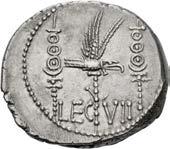



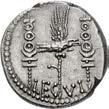


647. The Triumvirs. Mark Antony. Autumn 32-spring 31 BC. AR Denarius (17mm, 3.91 g, 9h). Legionary type. Patrae(?) mint. Praetorian galley right; ANT • Aug above, iii uir • r • p • C below / Aquila between two signa; LeG iu across lower field. Crawford 544/17; CRI 352; Sydenham 1219; RSC 30; BMCRR East 195; Kestner 3846; RBW –. Area of weak strike. Good VF. ($750)




648. The Triumvirs. Mark Antony. Autumn 32-spring 31 BC. AR Denarius (18mm, 3.75 g, 18h). Legionary type. Patrae(?) mint. Praetorian galley right; ANT • Aug above, iii uir • r • p • C below / Aquila between two signa; LeG u across lower field. Crawford 544/18; CRI 354; Sydenham 1221; RSC 32; BMCRR East 196; Kestner 3847; RBW 1840. Minor deposits, weakly struck at center. Good VF. ($750)


649. The Triumvirs. Mark Antony. Autumn 32-spring 31 BC. AR Denarius (17mm, 3.91 g, 6h). Legionary type. Patrae(?) mint. Praetorian galley right; ANT • Aug above, iii uir • r • p • C below / Aquila between two signa; LeG ui across field. Crawford 544/19; CRI 356; Sydenham 1223; RSC 33; BMCRR East 197; Kestner 3848; RBW 1841. Light iridescent tone, small scrape on reverse. EF. ($1500)
650. The Triumvirs. Mark Antony. Autumn 32-spring 31 BC. AR Denarius (18mm, 3.76 g, 6h). Legionary type. Patrae(?) mint. Praetorian galley right; ANT • Aug above, iii uir • r • p • C below / Aquila between two signa; LeG uii across field. Crawford 544/20; CRI 357; Sydenham 1224; RSC 34; BMCRR East 198; Kestner 3849; RBW 1842. Lightly toned, hairlines. Near EF. ($1000)
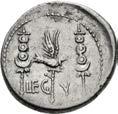

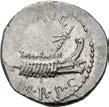
651. The Triumvirs. Mark Antony. Autumn 32-spring 31 BC. AR Denarius (19mm, 3.76 g, 6h). Legionary type. Patrae(?) mint. Praetorian galley right; ANT • Aug above, iii • uir • r • p • C below / Aquila between two signa; LeG ix across field. Crawford 544/23; CRI 359; Sydenham 1227; RSC 37; BMCRR East 201; Kestner 3852; RBW –. Well struck on a full flan, lustrous. Choice EF. A superb specimen. ($2000)
652 653
652. The Triumvirs. Mark Antony. Autumn 32-spring 31 BC. AR Denarius (17.5mm, 3.53 g, 6h). Legionary type. Patrae(?) mint. Praetorian galley right; ANT • Aug above, iii • uir • r • p • C below / Aquila between two signa; Leg x across lower field. Crawford 544/24; CRI 361; Sydenham 1228; RSC 38; BMCRR East 202; Kestner 3853; RBW –. Scattered marks, minor porosity, well centered. Near EF. ($500)
Of all the Roman legions, Legio X is perhaps the most famous. It was the favorite of Julius Caesar during the conquest of Gaul, and served at times as his personal bodyguard, playing a key role in the Civil Wars against Pompey, including the decisive battle of Munda in 45 BC. Antony’s Legio X proved so loyal to him that Octavian disbanded the unit and replaced it with his own Legio X Gemina (twin).






653. The Triumvirs. Mark Antony. Autumn 32-spring 31 BC. AR Denarius (19mm, 3.88 g, 3h). Legionary type. Patrae(?) mint. Praetorian galley right; ANT • Aug above, iii • uir • r • p • C below / Aquila between two signa; Leg x across lower field. Crawford 544/24; CRI 361; Sydenham 1228; RSC 38; BMCRR East 202; Kestner 3853; RBW –. Lightly toned, flan chip. Good VF. ($750)

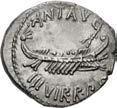



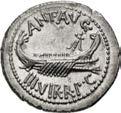
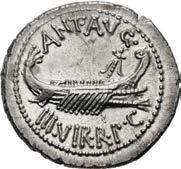
654. The Triumvirs. Mark Antony. Autumn 32-spring 31 BC. AR Denarius (18mm, 3.78 g, 7h). Legionary type. Patrae(?) mint. Praetorian galley right; ANT • Aug above, iii • uir • r • p • C below / Aquila between two signa; LeG xi across lower field. Crawford 544/25; CRI 362; Sydenham 1229; RSC 39; BMCRR East 203; Kestner 3854; RBW –. Lightly toned, small flan crack. EF. Good metal. ($1000)
655. The Triumvirs. Mark Antony. Autumn 32-spring 31 BC. AR Denarius (18mm, 3.74 g, 7h). Legionary type. Patrae(?) mint. Praetorian galley right; ANT • Aug above, iii • uir • r • p • C below / Aquila between two signa; Leg xii across lower field. Crawford 544/26; CRI 365; Sydenham 1230; RSC 41; BMCRR East 204; Kestner 3855; RBW –. Lightly toned. EF. ($1000)

656. The Triumvirs. Mark Antony. Autumn 32-spring 31 BC. AR Denarius (17mm, 3.77 g, 6h). Legionary type. Patrae(?) mint. Praetorian galley right; ANT • Aug above, iii • uir • r • p • C below / Aquila between two signa; LeG xiii across lower field. Crawford 544/27; CRI 367; Sydenham 1232a; RSC 42; BMCRR East 205-6; Kestner 3856; RBW 1844. Lustrous, die flaw on obverse. Near EF. ($1000)
Legio XIII is one of the most famous Roman legions, thanks to its steadfast support of Julius Caesar from its foundation in circa 57 BC. In 49 BC it crossed the Rubicon river in northern Italy with Caesar, igniting the sequence of civil wars that doomed the Roman Republic and placed Caesar and his heirs in power. Antony’s thirteenth was built around a core of veterans from Caesar’s unit and was conjoined with Octavian’s after Actium to form Legio XIII Gemina of imperial fame.
657. The Triumvirs. Mark Antony. Autumn 32-spring 31 BC. AR Denarius (18mm, 3.95 g, 6h). Legionary type. Patrae(?) mint. Praetorian galley right; ANT • Aug above, iii • uir • r • p • C below / Aquila between two signa; LeG xu across lower field. Crawford 544/30; CRI 371; Sydenham 1235; RSC 47; BMCRR East 210; Kestner 3859; RBW 1845. Underlying luster, light marks. Near EF. ($1000)
658. The Triumvirs. Mark Antony. Autumn 32-spring 31 BC. AR Denarius (19mm, 3.67 g, 5h). Legionary type. Patrae(?) mint. Praetorian galley right; ANT • Aug above, iii • uir • r • p • C below / Aquila between two signa; LeG xui across lower field. Crawford 544/31; CRI 372; Sydenham 1236; RSC 48; RBW –. Lightly toned, faint scratches. EF. ($750)
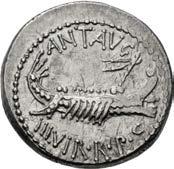

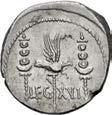


659. The Triumvirs. Mark Antony. Autumn 32-spring 31 BC. AR Denarius (18mm, 3.69 g, 3h). Legionary type. Patrae(?) mint. Praetorian galley right; ANT • Aug above, iii • uir • r • p • C below / Aquila between two signa; LeG xui across lower field. Crawford 544/31; CRI 372; Sydenham 1236; RSC 48; BMCRR East 211; Kestner 3860; RBW –. Lightly toned, minor metal flaws. Good VF. ($750)
Not to be confused with a similar legion under the command of Octavian, this Antonian legion was either disbanded or incorporated into another legion after Actium.







660. The Triumvirs. Mark Antony. Autumn 32-spring 31 BC. AR Denarius (16mm, 3.55 g, 6h). Legionary type. Patrae(?) mint. Praetorian galley right; ANT • Aug above, iii • uir • r • p • C below / Aquila between two signa; Leg xuii • CLAÍÍiCAe above. Crawford 544/10; CRI 373; Sydenham 1238; RSC 50; BMCRR East 223; Kestner 3839; RBW 1835. Toned, cleaning scratches, light pitting. Near EF. ($750)
661. The Triumvirs. Mark Antony. Autumn 32-spring 31 BC. AR Denarius (18mm, 3.78 g, 6h). Legionary type. Patrae(?) mint. Praetorian galley right; ANT • Aug above, iii • uir • r • p • C below / Aquila between two signa; Leg xuii • CLAÍÍiCAe above. Crawford 544/10; CRI 373; Sydenham 1238; RSC 50; BMCRR East 223; Kestner 3839; RBW 1835. Toned, light hairlines, well struck. EF. ($1500)
The epithet “Classicae” means “of the fleet,” so perhaps the men of this unit were expected to serve as marines in the coming battle against Octavian. If so, they never got the chance to fight in this role, for they remained ashore during the naval battle of Actium, after which they surrendered to Octavian.
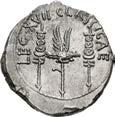


662. The Triumvirs. Mark Antony. Autumn 32-spring 31 BC. AR Denarius (17mm, 3.83 g, 6h). Legionary type. Patrae(?) mint. Praetorian galley right; ANT • Aug above, iii • uir • r • p • C below / Aquila between two signa; LeG xuii across lower field. Crawford 544/32; CRI 374; Sydenham 1237; RSC 49; BMCRR East 212; Kestner 3861; RBW 1846. Toned, light scratches, good metal. EF. ($1000)
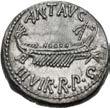
663.
Patrae(?) mint. Praetorian galley right; ANT • Aug above, iii • uir • r • p • C below / Aquila between two signa; LeG xuiii across lower field. Crawford 544/33; CRI 376; Sydenham 1239; RSC 51;



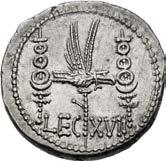
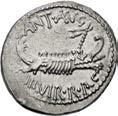

East 213; Kestner 3862; RBW –. Hairlines, small scrape on obverse, area of weak strike. Near EF. ($1000)


664. The Triumvirs. Mark Antony. Autumn 32-spring 31 BC. AR Denarius (18mm, 3.90 g, 6h). Legionary type. Patrae(?) mint. Praetorian galley right; ANT • Aug above, iii • uir • r • p • C below / Aquila between two signa; LeG xix across lower field. Crawford 544/35; CRI 378; Sydenham 1242; RSC 55; BMCRR East 214; Kestner 3863; RBW 1847. Light hairlines, well struck on good metal, lustrous. EF. ($1500)
665. The Triumvirs. Mark Antony. Autumn 32-spring 31 BC. AR Denarius (17mm, 4.02 g, 6h). Legionary type. Patrae(?) mint. Praetorian galley right; ANT • Aug above, iii • uir • r • p • C below / Aquila between two signa; LeG xx across field. Crawford 544/36; CRI 380; Sydenham 1243; RSC 57; BMCRR East 215; Kestner 3864; RBW 1848. Light hairlines, underlying luster. Near EF. ($1000)
666. The Triumvirs. Mark Antony. Autumn 32-spring 31 BC. AR Denarius (17mm, 3.91 g, 6h). Legionary type. Patrae(?) mint. Praetorian galley right; ANT • Aug above,
544/37; CRI 381; Sydenham 1244; RSC 58;
667.
Patrae(?) mint. Praetorian galley right; ANT • Aug above,






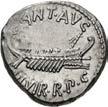
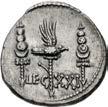
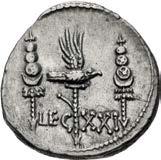


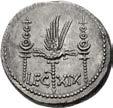

544/38; CRI 382; Sydenham 1245;
59;
East 218; Kestner 3866; RBW –. Light hairlines, scrape at edge. EF. ($1000)
668. The Triumvirs. Mark Antony. Autumn 32-spring 31 BC. AR Denarius (17mm, 3.48 g, 10h). Legionary type. Patrae(?) mint. Praetorian galley right; ANT • Aug above, iii • uir • r • p • C below / Aquila between two signa; Leg xxiii across lower field. Crawford 544/39; CRI 383; Sydenham 1246; RSC 60; BMCRR East 219; Kestner 3867; RBW –. Lightly toned. Near EF. ($1000)
669. The Caesarians. Octavian. 42 BC. AR Denarius (20mm, 8.12 g, 6h). Rome mint; L. Mussidius Longus, moneyer. Bare head right; C • CAeÍAr • iii • uir • r • p • C around / Cornucopia tied with fillets; L • ÂuÍÍiDiuÍ above, LONguÍ below. Crawford 494/15; CRI 153; Sydenham 1101; Bahrfeldt 43 (same dies as illustration); Calicó 140 (same dies as illustration); Biaggi 73 (same dies); BMCRR Rome 4231; Kestner –; RBW –. A few minor marks. VF. Extremely rare. ($20,000)
Ex Gadoury (16 November 2018), lot 36.
This rare aureus is among the first gold portrait pieces to depict Octavian by himself, and was struck by the moneyer Lucius Mussidius Longus, a loyal supporter of his uncle and patron Julius Caesar. His nomen Mussidius indicates that he was a novus homo, or up-and-coming man with no long family pedigree. Nevertheless, the made the most of his appointment as moneyer and his output of gold and silver coins in 43-42 BC was prodigious, including several issues with Republican types, three with Octavian’s portrait, two each of Mark Antony and Lepidus, and one depicting the soon-to-be-deified Caesar. Mussidius continued to strike coins for Antony until 37 BC, and seems to have been appointed proconsul of Sicily under Augustus. A distant relation, T. Mussidius Pollianus, was a senator under the new regime in the first century AD.



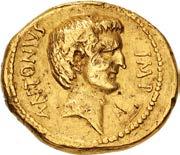


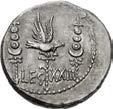
670. Octavian and Mark Antony. Late 40-early 39 BC. AV Aureus (19.5mm, 8.03 g, 6h). Mint in central or southern Italy. Bare head of Octavian right, wearing slight beard; CAeÍAr iÂp around / Bare head of Mark Antony right; ANTONiuÍ iÂp around. Crawford 529/1; Sydenham 1327; CRI 301; BBMRR 90 (Gaul); Calicó 105b. Scattered marks, scrapes. Near VF. Extremely rare. ($15,000)

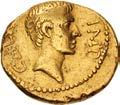
From the S & S Collection.
Unlike most other dual portrait Imperatorial issues, the fabric of this rare aureus suggests that Octavian (identified as CAeÍAr iÂp) is on the obverse and Antony (ANTONiuÍ iÂp) occupies the reverse, and so it is attributed to Octavian rather than the senior Triumvir. It also omits the triumviral titles and the name of the moneyer, both of which appear on the counterpart issues of Antony. The mint is not immediately obvious; Crawford attributes it to a “mint moving with Octavian,” Calico suggests Gaul, and Sear proposes southern or northern Italy. The types suggest that the occasion for this issue was the signing of the Treaty of Brundisium between Octavian and Antony in October of 40 BC, which renewed their partnership and, for a time, staved off civil war between them.
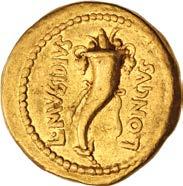

671. The Triumvirs. Octavian and Divus Julius Caesar. 38 BC. Æ Sestertius or Dupondius (29mm, 18.61 g, 4h). Southern Italian(?) mint. Bare head of Octavian right, wearing slight beard; CAeÍAr downward to right; Diui • F downward to left / Laureate head of Divus Julius Caesar right; DiuOÍ downward to right; iuLiuÍ downward to left. Crawford 535/1; Alföldi & Giard 4 (D2/R- [unlisted rev. die]); CRI 308; Sydenham 1335; RPC I 620; BMCRR Gaul 106; Kestner 3826-8; RBW 1822. Green patina, minor deposits. Good VF. Well struck for issue. ($5000)




From the DMS Collection, purchased from Jonathan K. Kern, 2012. Ex Triton XI (8 January 2008), lot 633.
672. The Triumvirs. Octavian. Autumn 30-summer 29 BC. AR Denarius (21mm, 3.92 g, 5h). Uncertain mint in Italy (Rome?). Bare head right / Naval and military trophy facing, composed of helmet, cuirass, shield, and crossed spears, set on prow of galley right; crossed rudder and anchor at base; iÂp CAeÍAr across field. CRI 419; RIC I 265a; RSC 119; BMCRR Rome 4352 = BMCRE 625; BN 57-63. Toned, light scratches, minor metal flaws. Good VF. ($1000)
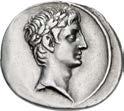

From the S & S Collection.
673. The Triumvirs. Octavian. Autumn 30-summer 29 BC. AR Denarius (19mm, 3.71 g, 10h). Uncertain mint in Italy (Rome?). Bare head right / Rostral column ornamented with two anchors and six beaks of galleys, surmounted by a statue of Octavian, holding spear with right hand and parazonium with left; iÂp CAeÍAr across field. CRI 423; RIC I 271 (Augustus); BMCRE 633-6 = BMCRR Rome 4349-51; BN 68-71; RSC 124 (Augustus). Lightly toned, some light scratches, minor smoothing near edge. Good VF. ($1000)




From the GTP Collection. Ex Alejandro Lifchuz Collection (Gorny & Mosch 276, 19 April 2021), lot 498, reportedly acquired prior to 1976.
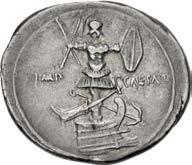

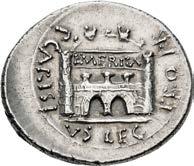



674. Augustus. 27 BC-AD 14. AR Denarius (19mm, 3.77 g, 2h). Emerita mint; P. Carisius, legatus pro praetore. Struck circa 25-23 BC. IMP CAESAR AVGVST, bare head left / P CARISI VS LEG PRO PR, bird’s-eye view of town, with gateway, in which are two doors and on which are three battlements in front and walls around and behind; EMERITA inscribed above doors. RIC I 9b; RSC 398; BMCRE 291 = BMCRR Spain 128; BN 1039-43. Light iridescent tone. Choice EF. Well struck. ($3000)
From the Viggo Collection. Ex Collection of a Perfectionist (Numismatica Ars Classica 106, 9 May 2018), lot 542; Numismatica Ars Classica 92 (Part 1, 23 May 2016), lot 455.
In 23 BC, Publius Carisius, pro praetor of Lusitania (northwestern Spain and Portugal), completed the construction of the city of Augusta Emerita, modern Merida. It was founded by Augustus as the capital of Lusitania, and settled by veterans (emeriti) of the fifth and seventh legions. The city was situated at the junction of several important routes and featured a properly fortress-like set of walls with a monumental gate, depicted on this attractive coin. A magnificent theater, still in use today, was added by Marcus Agrippa in 16 BC.
675. Augustus. 27 BC-AD 14. AR Denarius (19mm, 3.83 g, 4h). Uncertain Spanish mint (Colonia Patricia?). Struck 19-18 BC. CAESAR AVGVSTVS, bare head right / OB/ CIVIS/ SERVATOS in three lines within oak wreath with wreath ties drawn upward. RIC I 77a; RSC 208; BMCRE 378-80 = BMCRR Rome 4391-2; BN 1154-61. Lightly toned, traces of deposits. Good VF. ($1000)
From the S & S Collection.
676. Augustus. 27 BC-AD 14. AR Denarius (20mm, 3.76 g, 6h). Uncertain Spanish mint (Colonia Patricia?). Struck circa AD 18-17/16 BC. Bare head right / AVGVSTVS below, capricorn right, holding globe attached to rudder between front hooves; cornucopia above its back. RIC I 126; RSC 21; BMCRE 346-8 = BMCRR Rome 4374-6; BN 1266-7. Toned, some deposits on reverse. Good VF. ($1500)

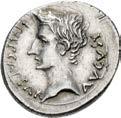


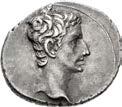
From the S & S Collection.




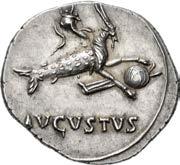


677. Augustus. 27 BC-AD 14. AR Denarius (21mm, 3.82 g, 6h). Uncertain Spanish mint (Colonia Patricia?). Struck circa 18-17/16 BC. Bare head left / AVGVSTVS below, capricorn right, holding globe attached to rudder between front hooves; cornucopia above its back. RIC I 130; RSC 22; BMCRE 307-8 (Emerita) = BMCRR Gaul 126-7; BN 1354-7 (Nimes). Faint hairlines. Superb EF. Well struck and fully lustrous. ($7500)


From the Viggo Collection. Ex Numismatica Ars Classica 64 (17 May 2012), lot 1044 (hammer CHF 10,000).

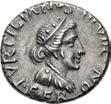
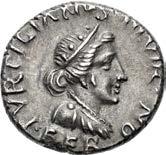


According to Suetonius, Augustus had been born while the moon was in the sign of Capricorn. Seeing this as a sign of his great destiny, Augustus associated the symbol closely with himself by striking it on coins and incorporating it into numerous works of art, so that it became a standard part of the imperial iconography. In order to legitimize their own claims, his successors periodically employed the capricorn imagery on their own coinage. Adding the cornucopia, or horn of plenty, to the back of the capricorn symbolizes the prosperity brought about by the emperor.
678. Augustus. 27 BC-AD 14. AR Denarius (18.5mm, 3.81 g, 6h). Uncertain Spanish mint (Colonia Patricia?). Struck 17-16 BC. Bare head right / AVGVSTVS below, capricorn right, holding globe attached to rudder between front hooves; cornucopia above its back. RIC I 126; RSC 21; BMCRE 346-8 = BMCRR Rome 4374-6; BN 1266-7. Beautiful cabinet tone. Superb EF. Wonderful portrait. Struck with fresh dies. Exceptional. ($7500)


Ex Alba Longa Collection (Áureo & Calicó 339, 14 November 2019), lot 1164; Numismatica Ars Classica 21 (17 May 2001), lot 356.
679. Augustus. 27 BC-AD 14. AR Denarius (19mm, 3.87 g, 6h). Lugdunum (Lyon) mint. Struck 15 BC. AVGVSTVS DIVI • F, bare head right / IMP • X in exergue, bull butting right, left forefoot raised, lashing his tail. RIC I 167a; Lyon 19; RSC 137; BMCRE 451-3; BN 1373-82. Lustrous. Superb EF. Attractively toned. ($3000)

From the G.W. Trow Collection. Ex Triton XXI (9 January 2018), lot 690 (hammer $4250).
680.
From the S & S Collection.

681. Augustus. 27 BC-AD 14. AR Denarius (19mm, 3.50 g, 11h). Rome mint; Q. Rustius, moneyer. Struck 19 BC. Q RVSTIVS FORTVNÆ above, [ΛNTIΛ]T in exergue, jugate, draped busts right of Fortuna Victrix, wearing round helmet, holding patera in right hand, and Fortuna Felix, wearing stephane; both busts rest on bar terminating at each end in a ram’s head / CΛESΛRI ΛVG VSTO, EX • S • C in exergue, ornamented rectangular altar inscribed FOR • RE set on base. RIC I 322; RSC 513; BMCRE 2-4 = BMCRR Rome 4580-2; BN 221-8; FFC 322 (this coin). Some faint hairlines. Choice EF. Well struck from fresh dies. ($3000)
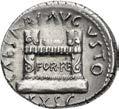
From the Viggo Collection. Ex Alba Longa Collection (Roma XXI, 24 March 2021), lot 490; Áureo & Calicó 339 (14 November 2019), lot 1363.
682. Augustus (for Caius Caesar). 27 BC-AD 14. AR Denarius (18mm, 3.78 g, 6h). Uncertain eastern mint. Struck circa 17 BC. CA ES AR, youthful, bare head (of Caius Caesar?) right; all within oak wreath / AVG VST •, candelabrum, ornamented with rams’ heads and surmounted by a crescent; all within a floral wreath entwined with two bucrania and two pateras. RIC I 540; RSC 2 (Caius Caesar); BMCRE 684-5; BN 1013-6; CNR VIII, 11/4 (this coin). Toned. Good VF. ($2500)
From the S & S Collection. Ex Classical Numismatic Group 55 (13 September 2000), lot 1123; Münzen und Medaillen AG 52 (19 June 1975), lot 554.
The unusual youthful portrait on this denarius, identified only as CAESAR, was for many years identified as Caius Caesar, one of the grandsons of Augustus by way of his daughter Julia and right-hand-man Marcus Agrippa. Caius was born in 20 BC and his brother Lucius three years later; both were officially adopted by Augustus in 17 BC and the emperor clearly hoped one or both youths would eventually succeed him. They were given every preferment as they grew up and Caius was named consul in AD 1, while on a military tour of the eastern provinces. Both met tragic fates while still young: Lucius died of a sudden illness in AD 2, while Caius was wounded in a skirmish in AD 4 and died of sepsis en route back to Rome, leaving Augustus bereft and dependent upon his stepson Tiberius, for whom he had little affection. More recent scholarly opinion has swung toward identifying this type as depicting a “rejuvenated” portrait of Augustus for the revived Saecular Games of 17 BC. However, Augustus was already being depicted in idealized fashion as a young man on his coinage of 17 BC (as would continue throughout his reign), and there seems no obvious reason for a “rejuvenated” adolescent portrait. Furthermore, the adoption of Caius and Lucius that same year would seem to be a prime opportunity for dynastic propaganda. We therefore tend to side with David R. Sear as continuing to identify the handsome boy seen here as Caius, or perhaps a conflation of both youths.





683. Divus Augustus. Died AD 14. Æ As (28.5mm, 10.86 g, 6h). Rome mint. Struck under Tiberius, circa AD 22/3-30. DIVVS • AVGVSTVS • PATER, radiate head left / S C across field, PROVIDENT in exergue, altar, with closed, double-panelled door; acroteria above to left and right. RIC I 81 (Tiberius); BMCRE 146-50 (Tiberius); BN 131-5 (Tiberius). Glossy dark green patina, some scratches on obverse, evidence of flip-over double strike on reverse above altar. Near EF. ($1000)
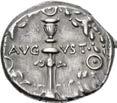
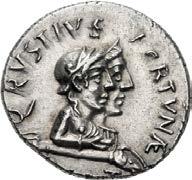
684. Divus Augustus. Died AD 14. Æ Sestertius (33.5mm, 22.73 g, 7h). Rome mint. Struck under Tiberius, AD 35-36. DIVO AVGVSTO S P Q R, shield inscribed OB/ CIVES/ SER in three lines, surrounded by a laurel wreath and supported by two capricorns, facing outward; globe below / TI CAESAR DIVI AVG F AVGVST P M TR POT XXXVII around large S • C. RIC I 63; BMCRE 109 (same obv. die); BN 93-5. Attractive warm red-brown surfaces. VF. ($2000)

From the DMS Collection, purchased from Jonathan K. Kern, 2010. The Capricorns flanking the shields of this sestertius refer to the natal sign of Augustus, as seen on several of his denarii and aurei.

685. Tiberius, with Divus Augustus. AD 14-37. AV Aureus (19mm, 7.81 g, 8h). Lugdunum (Lyon) mint. Struck AD 14-16. TI CΛESΛR DIVI ΛVG F ΛVGVSTVS, laureate head of Tiberius right / DIVOS ΛVGVST DIVI F, laureate head of Divus Augustus right; six-pointed star above. RIC I 24; Lyon 118, 6a (D3/R4); Calicó 311; BMCRE 29; BN 1-2; Adda 16 (same rev. die); Biaggi 167; Jameson 32; Mazzini 3 (Tiberius and Augustus). Lustrous, a few minor marks, some faint hairlines. EF. Two wonderful portraits. Rare. ($25,000)

Ex Numismatica Ars Classica 119 (with Jesús Vico, 6 October 2020), lot 7.

The son of Augustus’ wife Livia by her previous marriage to a member of the Claudian family, Tiberius Claudius Nero was born in 42 BC in the last days of the Roman Republic. Augustus had ambivalent feelings toward his stepson, finding him dour and humorless, but still provided him with an excellent education and an accelerated career. He found his true calling as a soldier, where he spent years in the field with his legions expanding the Empire’s holdings and the Balkans and Germany. In 12 BC, Augustus arranged for his widowed daughter Julia to marry Tiberius, seemingly a mark of high favor. But Julia was promiscuous and capricious, and the marriage was a failure. A despairing Tiberius went into exile in Rhodes in 6 BC, seemingly ending his public life. With the deaths of Augustus’ two grandsons, Tiberius was recalled to Rome in A.D. 4, officially adopted and granted the Tribunican power, marking him out clearly as successor. From then forward, he was essentially co-emperor and succeeded to the throne without challenge upon Augustus’ death on August 19, AD 14. His first coinage issues quite understandably stressed his dynastic connections and the deification of his adoptive father
686. Tiberius. AD 14-37.
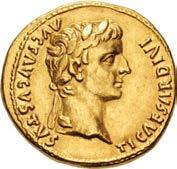




Ex Roma XXI (24 March 2021), lot 499; Künker 318 (11 March 2019), lot 998.

687. Tiberius. AD 14-37. AR Denarius (19.5mm, 3.79 g, 9h). “Tribute Penny” type. Lugdunum (Lyon) mint. Group 4, AD 18-35. TI CΛESΛR DIVI ΛVG F ΛVGVSTVS, laureate head right; one ribbon on shoulder / PONTIF MΛXIM, Livia, as Pax, seated right, holding scepter in right hand and olive branch in left, feet on footstool; ornate chair legs, single line below.

RIC I 30; Lyon 150; RSC 16a; BMCRE 48-60; BN 28-31. Lustrous, hairlines. EF. Portrait in high relief. ($1500)




From the DFA Collection.
688. Tiberius. AD 14-37. AR Denarius (18mm, 3.80 g, 7h). “Tribute Penny” type. Lugdunum (Lyon) mint. Group 4, AD 18-35. TI CΛESΛR DIVI ΛVG F ΛVGVSTVS, laureate head right; one ribbon on shoulder / PONTIF MΛXIM, Livia, as Pax, seated right, holding scepter in right hand and olive branch in left, feet on footstool; ornate chair legs, single line below. RIC I 30; Lyon 150; RSC 16a; BMCRE 48-60; BN 28-31. Attractive old collection toning, minor marks under tone. Near EF. ($1000)

From the G.W. Trow Collection, purchased from Antiqua (Steve Rubinger), 8 January 2016.
689. Tiberius. AD 14-37. AV Aureus (18mm, 7.73 g, 7h). “Tribute Penny” type. Lugdunum (Lyon) mint. Group 6, AD 36-37. TI CΛESΛR DIVI ΛVG F ΛVGVSTVS, laureate head right; long, parallel ribbons, caricature portrait / PONTIF MΛXIM, Livia (as Pax) seated right on chair, feet on footstool, holding scepter in right hand and olive branch in left; ornate chair legs, single line below. RIC I 29; Lyon 153; Calicó 305c; BMCRE 46-7; cf. BN 26-34; Biaggi 170; Mazzini 15. In NGC encapsulation 6330208-003, graded AU, Strike 5/5, Surface 2/5, brushed. Lovely portrait. ($7500)
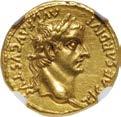






Ex Gadoury (30 October 2020), lot 162

690. Tiberius. AD 14-37. AV Aureus (19mm, 7.76 g, 6h). “Tribute Penny” type. Lugdunum (Lyon) mint. Group 6, AD 36-37. TI CΛESΛR DIVI ΛVG F ΛVGVSTVS, laureate head right; long, parallel ribbons, caricature portrait / PONTIF MΛXIM, Livia (as Pax) seated right on chair, feet on footstool, holding spear in right hand and olive branch in left; ornate chair legs, single line below. RIC I 29; Lyon 153; Calicó 305c; BMCRE 46-7; cf. BN 26-34; Biaggi 170; Mazzini 15. Lustrous, some light scratches and minor metal flaws. EF. ($7500)

691. Tiberius. AD 14-37. AV Aureus (19mm, 7.72 g, 6h). “Tribute Penny” type. Lugdunum (Lyon) mint. Group 6, AD 36-37. TI CΛESΛR DIVI ΛVG F ΛVGVSTVS, laureate head right; long, parallel ribbons / PONTIF MΛXIM, Livia (as Pax) seated right on chair, feet on footstool, holding scepter in right hand and olive branch in left; ornate chair legs, single line below. RIC I 29; Lyon 153; Calicó 305c; BMCRE 47; BN 26-7 var. (one ribbon on shoulder); Adda 14; Biaggi 170; Mazzini 15** var. (same). A few marks on reverse. EF. Well struck on a broad flan. Wonderful portrait. ($10,000)

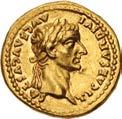
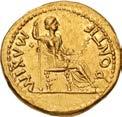
692 693
693. Nero Claudius Drusus. Died 9 BC. Æ Sestertius (37mm, 25.94 g, 6h). Rome mint. Struck under Claudius, AD 4142. NERO CLAVDIVS DRVSVS GERMANICVS IMP, bare head left / TI CLAVDIVS CAESAR AVG P M TR P IMP, S C in exergue, Claudius seated left on curule chair, holding branch in right hand and resting left hand on lap; weapons and armor on either side of globe beneath. RIC I 93 (Claudius); von Kaenel Type 57; BMCRE 157 (Claudius); BN 130. Dark brown surfaces, minor smoothing, lightly tooled. VF. ($1500)

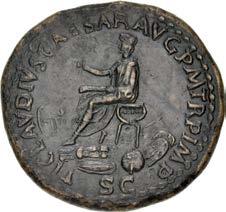




From the DMS Collection. Ex Robert O. Ebert Collection (Stack’s Bowers and Ponterio 174, 11 January 2013), lot 6056; Property of a Gentleman (Sotheby’s, 1 October 1981), lot 69.
694. Agrippina Senior. Died AD 33. Æ Sestertius (35.5mm, 28.82 g, 6h). Rome mint. Struck under Claudius, AD 42-43. AGRIPPINA • M • F • GERMANICI • CAESARIS •, draped bust right / TI CLAVDIVS • CAESAR • AVG • GERM • P M TR • P • IMP • P • P • around large S • C. RIC I 102 (Claudius); von Kaenel Type 78; BMCRE 219-23 (Claudius); BN 236-40 (Claudius). Glossy brown patina, rough in a few areas, some deposits. Good VF. ($5000) Ex Triton XVI (7 January 2013), lot 1033; Numismatica Ars Classica N (26 June 2003), lot 1719.
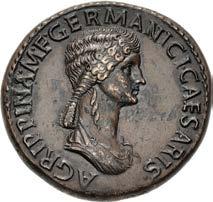
695. Gaius (Caligula), with Agrippina Senior. AD 37-41. AR Denarius (19mm, 3.78 g, 8h). Lugdunum (Lyon) mint. 2nd emission, 1st phase, late AD 37. [C • CAESAR] • AVG • GERM • P • M TR POT, bare head of Gaius (Caligula) right / AGRIPPINA • M[AT • C • CAES • A]VG GERM, draped bust of Agrippina right. RIC I 8; Lyon 162 (unlisted dies); RSC 4 (Caligula and Agrippina Senior); BMCRE 8; BN 12-13; Mazzini 4 (Agrippina and Caligula). Deep iridescent tone. Near EF. Two wonderful portraits. ($3000)
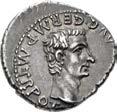






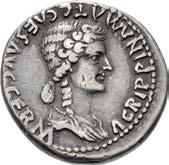
From the G.W. Trow Collection. Ex New York Sale XXX (9 January 2013), lot 269.
696. Gaius (Caligula), with Agrippina Senior. AD 37-41. AR Denarius (18mm, 3.70 g, 3h). Lugdunum (Lyon) mint. 2nd emission, 2nd phase, late AD 37-early 38. C • CΛESΛR • ΛVG • GERM • P • M • TR • POT, laureate head of Gaius (Caligula) right / AGRIPPINA • MAT • C • CAES • AVG • GERM •, draped bust of Agrippina right. RIC I 14 (Rome mint); Lyon 170 (unlisted dies); RSC 2; BMCRE 15; BN 24-6. Toned, minor marks. VF. ($3000)
From the S & S Collection.
697. Claudius. AD 41-54. AV Aureus (20mm, 7.79 g, 10h). Lugdunum (Lyon) mint. Struck AD 41-42. TI CLAVD • CAESAR • AVG • P • M • TR • P •, laureate head right / PACI AVGVSTAE, Pax-Nemesis advancing right, holding out fold of drapery below chin with right hand and holding in left hand a winged caduceus pointing down at serpent gliding right with head erect. RIC I 9; von Kaenel Type 3, – (V–/R28 [unlisted obv. die]); Lyon 7 (unlisted dies); Calicó 363; BMCRE 6-7; BN 21; Biaggi 208; Mazzini 50. Luster, small marks, shallow scrape on reverse. EF. ($20,000)




From the S & S Collection.
Nemesis is the goddess who enacts divine retribution on those who display hubris, or arrogance before the gods. By Roman times she is usually depicted as a winged woman holding out a fold of her garment before her, expressing aversion by spitting upon her bosom (supposedly humans could avoid her anger by making the same gesture). From early in his reign, Claudius employed on his gold and silver coins a version of Nemesis sharing some features with Pax (Peace) along with the legend PACI AVGVSTAE (“the Emperor’s peace”). Claudius’ Nemesis coinage starts in AD 43 and probably refers to his invasion and subsequent conquest of Britain, with Rome meting out “divine retribution” on the arrogant British tribes. “The Emperor’s peace” presumably refers to Britannia being brought within the Pax Romana, albeit by force of arms. Nine decades later Hadrian would employ a similar reverse as a reference to the Bar Kochba conflict.




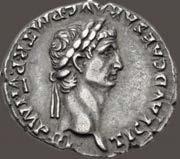

698. Claudius. AD 41-54. Æ Sestertius (36mm, 27.43 g, 7h). Rome mint. Struck AD 41-42. TI CLAVDIVS CAESAR


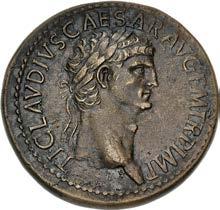
AVG P M TR P IMP, laureate head right / EX S C/ O B/ CIVES/ SERVATOS in four lines within oak wreath. RIC I 96; von Kaenel Type 54; BMCRE 115-6; BN 152-61. Even, natural brown patina. EF. ($10,000)
From
699. Claudius. AD 41-54. AR Denarius (19mm, 3.78 g, 7h). Rome mint. Struck AD 46-47. TI CLAVD • CAESAR • AVG • P • M • TR • P • VI • IMP • XI, laureate head right / PACI AVGVSTAE, Pax-Nemesis advancing right, holding out fold of drapery below chin, and holding winged caduceus, pointing down at erect snake, gliding right. RIC I 39; von Kaenel Type 24 (unlisted dies); RSC 58; BMCRE 40-1; BN 51. Deeply toned. EF. Attractive portrait. Well struck from dies of exemplary style. ($10,000)


Ex Phil Peck (Morris) Collection (Heritage 3071, 6 January 2019), lot 32038; Classical Numismatic Group 28 (8 December 1993), lot 255; Numismatic Fine Arts XXV (29 November 1990), lot 343; Art Monaco (22 April 1977), lot 55.
700. Claudius. AD 41-54. AR Denarius (16.5mm, 3.80 g, 5h). Rome mint. Struck AD 46-47. TI CLAVD CAESAR AVG P M TR P VI IMP XI, laureate head right / S P Q R/ P P/ OB C S in three lines within oak wreath. RIC I 41; von Kaenel Type 26 (unlisted dies); RSC 87; BMCRE 45-7; BN 59-60. Beautiful old cabinet toning. In NGC encapsulation 4279707-001, graded XF★, Strike 5/5, Surface 5/5. ($5000)
Ex Michael Joffre Collection (Triton XVIII, 5 January 2015), lot 1021.
701. Claudius. AD 41-54. AR Denarius (17.5mm, 3.83 g, 12h). Rome mint. Struck AD 51-52. TI CLAVD CAESAR








• AVG • P • M • TR • P • XI • IMP • P • P COS V, laureate head right / PACI AVGVSTAE, Nemesis, winged and draped, advancing right, her right arm is bent upwards and with right hand she pulls out a fold of her robe below the neck, holding in left hand a winged caduceus pointed downwards at a serpent gliding right before her. RIC I 62; von Kaenel Type 44, 752 (V638/R655); RSC 68; BMCRE 69; BN 71 (Lugdunum). Beautifully toned and extremely attractive. Choice EF. Perfectly centered on both sides. ($10,000)
From the G.W. Trow Collection. Ex New York Sale XXXIV (6 January 2015), lot 532; C.K. Collection (Triton XIV, 4 January 2011), lot 648; Leu 86 (5 May 2003), lot 765.
702. Nero. AD 54-68. AR Denarius (19mm, 3.63 g, 6h). Lugdunum (Lyon) mint. Struck AD 61-62. NERO • CAESAR
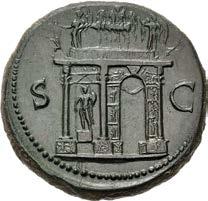
• AVG • IMP •, youthful bare head right / PONTIF • MAX TR P VIII COS IIII • P • P, EX S C across field, Roma standing right, holding and inscribing shield supported on left knee, left foot on helmet; dagger and bow at feet to right. RIC I 34; WCN 49; Lyon 34; RSC 222a; BMCRE 37-38; BN 44. Light toning, traces of deposits on reverse. EF. Rare in this condition. ($3000)

703. Nero. AD 54-68. Æ Sestertius (34mm, 27.96 g, 6h). Lugdunum (Lyon) mint. Struck circa AD 65. NERO • CLAVD • CAESAR • AVG • GER • P • M • TR • P • IMP • P • P, laureate head right, globe at point of neck / S C across field, Triumphal arch, hung with wreath across front and left side; above, Nero in facing quadriga escorted on right by Victory holding wreath and palm and on left by Pax holding caduceus and cornucopia; just below the quadriga on extreme left and right, two small figures of soldiers; on left side of arch in niche, figure of Mars standing facing, holding spear and round shield; ornamental reliefs on the faces and plinths of the arch. RIC I 392; WCN 410; Lyon 70; BMCRE 329; BN 77. Green-brown patina, minor smoothing. Near EF. An excellent portrait and terrific details on reverse. ($5000)
Ex Helios 4 (14 October 2009), lot 262.
The arch depicted on the reverse is almost certainly the one ordained by the Senate in AD 58 to commemorate the Armenian and Parthian victories of the general Cn. Domitius Corbulo. As related by Tacitus (Annals Book XIII, 35-41), Corbulo’s legions captured Artaxata and replaced the pro-Parthian King Tiridates I with Tigranes, an obedient vassal of Rome. The Senate heaped praise on Nero for the victories and ordered “statues and an arch” built in his honor, although the public credited them to Corbulo. Apparently the arch was located on Capitoline Hill, but it no longer exists and its exact location remains uncertain. The Parthian-Armenian conflict would not be settled until AD 65, when this sestertius was issued; the diplomatic solution placed Tiridates back on the throne, but required him to come to Rome to be crowned. Corbulo’s popularity caused Nero to resent him and suspect his loyalty. Ordered to commit suicide in AD 67, Corbulo is said to have uttered the enigmatic word axios, variously interpreted as “I deserve it” or “I am worthy,” before falling on his sword.
704. Nero. AD 54-68. Æ Sestertius (36mm, 25.31 g, 6h). Lugdunum (Lyon) mint. Struck circa AD 65. NERO CLAVD CAESAR AVG GER P M TR P IMP P, laureate head left, globe at point of neck / ANNONA AVGVSTI CERES, S C in exergue, Annona standing right, holding cornucopia in left hand, facing Ceres seated left, holding grain ears in outstretched right hand and torch in left; between them, modius on garlanded altar, ship’s stern in background. RIC I 389; WCN 404; Lyon 62; BMCRE –; BN –. Dark green-brown patina, minor smoothing. Near EF. Rare with this obverse legend. ($5000)
Ex Lanz 138 (26 November 2007), lot 581; Numismatica Ars Classica 40 (16 May 2007), lot 664.
The Roman government regarded the public grain dole as so important to maintaining civic order that a goddess, Annona, was created by Nero’s imperial propagandists to represent it. Depicted as a matronly woman holding a cornucopia, Annona makes her first appearance on Roman coinage with this sestertius issue, joined by Ceres, venerable deity of the grain harvest, along with a modius of grain and a ship’s prow, symbolizing the transport of grain from the breadbasket provinces of Sicily, Africa and Egypt to the port of Ostia. Annona continued to appear regularly on Roman coinage for another two centuries, signifying the emperor’s care for the nutritional needs of his subjects.


705. Nero. AD 54-68. Æ Sestertius (36.5mm, 24.30 g, 7h). Lugdunum (Lyon) mint. Struck circa AD 66. IMP • NERO


• CAESAR • AVG • PONT • MAX • TR • POT • P • P, laureate bust left, globe at point of bust / S C across field, triumphal arch, showing the front, with a wreath hung across it, surmounted by the emperor in facing quadriga accompanied by Pax and Victory, flanked by two soldiers; statue of Mars in side niche; the faces and plinths of the arch are ornamented with elaborate reliefs. RIC I 500; WCN 452; Lyon 191; BMCRE 333-4; BN 139-40. Green patina. VF. ($1000)
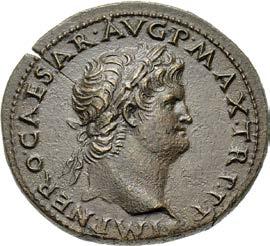
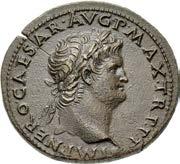
Ex Numismatik Naumann 106 (1 August 2021), lot 497.
706. Nero. AD 54-68. Æ Dupondius (30mm, 13.40 g, 6h).
• NERO
• CAESAR • AVG • P • MAX • TR • P • P • P, laureate head right,
Ex Classical Numismatic Group 81 (20 May 2009), lot 996.

at
of neck / SECVRITAS AVGVSTI, S C in exergue, Securitas seated right, resting right elbow on back of chair, right hand to head, holding scepter in left; garlanded and lighted altar to right, against which leans lighted torch. RIC I 596; WCN 531; Lyon 210; BMCRE 344-6; BN 192-3. Attractive river patina, flan crack. EF. ($2500)
Colossus of Nero – CNR Plate Coin


707. Nero. AD 54-68. AV Aureus (19.5mm, 7.29 g, 6h). Rome mint. Struck circa AD 64-65. NERO CAESAR, laureate head right / AVGVSTVS GERMANICVS, Nero, radiate and togate, standing facing, holding branch in right hand and globe surmounted by Victory in left. RIC I 46; Calicó 402; BMCRE 56-9; BN 202-5; Adda 28; Biaggi 221; Jameson 50; Mazzini 44; CNR 9/5 (this coin, “Collezione privata”). Light reddish-orange tone, a few faint hairlines. Near EF. ($10,000)




Ex Triton V (5 December 2000), lot 468. The reverse depicts Nero’s Colossus, a roughly 120-foot tall bronze statue of the emperor as Sol that was created by Zenodorus for the vestibule of the Domus Aurea, or Golden House, the massive palace constructed by Nero after the fire of AD 64. Its memory was retained in the popular name of the amphitheater constructed by the Flavians close to the site – the Colosseum.
708. Nero. AD 54-68. AV Aureus (18mm, 7.27 g, 9h). Rome mint. Struck circa AD 64-65. [NERO] CAESAR AVGVSTVS, laureate head right / IVPPITER CVSTOS, Jupiter, bare to waist, with cloak around lower limbs, seated left on throne, holding thunderbolt in right hand and vertical scepter in left. RIC I 52; WCN 25; Calicó 412; BMCRE 67-73; BN 213-9; Biaggi 225-6. In NGC encapsulation 6029852-003 graded XF, Strike: 3/5, Surface: 4/5, “Boscoreale” tone, flan flaw. ($5000)

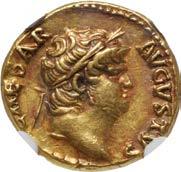

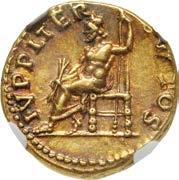
709. Nero. AD 54-68. AR Denarius (17mm, 3.11 g, 6h). Rome mint. Struck circa AD 64-65. NERO CAESAR • AVGVSTVS, laureate head right / ROMA in exergue, Roma, helmeted and draped, seated left on cuirass, right foot set on helmet, holding Victory in right hand and resting left on parazonium at side; greave to right. RIC I 55 var. (shields to right); WCN 59; RSC 258; BMCRE 83-5 var. (same); BN 224. Deep iridescent tone, a couple of scratches under tone. EF. Struck with dies of fine style. ($5000)

From the G.W. Trow Collection. Ex Künker 288 (13 March 2017), lot 439; Numismatica Ars Classica 38 (21 March 2007), lot 31; Triton III (1 December 1999), lot 1009; Peus 336 (28 April 1993), lot 592; Aufhäuser 9 (7 October 1992), lot 283.

710. Nero. AD 54-68. Æ Sestertius (33mm, 26.39 g, 6h). Rome mint. Struck circa AD 65. NERO CLAVDIVS CAESAR AVG GER P M TR P IMP P P, laureate head left / PACE P R TERRA MARIQ PΛRTΛ IΛNVM CLVSIT, S C across field, Temple of Janus, with latticed windows to left and garland hung across closed double doors to right. RIC I 267; WCN 143; BMCRE –; BN –. Attractive brown patina, minor smoothing. Good VF. Artistic portrait struck in high relief. ($4000) Ex Numismatica Ars Classica 64 (17 May 2012), lot 1122.





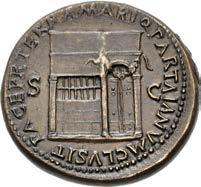
711. Nero. AD 54-68. Æ Sestertius (34.5mm, 26.23 g, 6h). Rome mint. Struck circa AD 67. IMP NERO CLAVD CAESAR AVG GERM P M TR P XIII P P, laureate head right wearing aegis / ROMA in exergue, S C across field, Roma seated left on cuirass, holding Victory and spear; various shields around and to right. RIC I 360 var. (bust type); BMCRE –; BN –; WCN 167 var. (same); CNG 50, lot 51 (same dies). Natural dark brown and red patina, minor doubling. Near EF. A rare bust variety on an issue with a desirable legend. ($5000)
From the DMS Collection, purchased from David Vagi in 2005.
Published in Hewitt – Referenced in RIC
712. Clodius Macer. Usurper, AD 68. AR Denarius (17mm, 3.46 g, 12h). Legionary issue. Carthage mint. Group III. L CLODI · MACRI, draped bust of Victory right, with wings folded upward; S C below / L IB above, AVG to right, LEG III across lower field, legionary aquila between two signa. RIC I 14 (this coin referenced); Hewitt Group C/1 (dies 12/15 – this coin); RSC 4; BMCRE p. 287, note 4; BN 4. In NGC encapsulation 5770285-002, graded XF★, Strike: 4/5, Surface: 5/5. ($25,000)
Ex Schulman Vault Collection (Schulman 365, 22 October 2020) lot 1535; Münzen und Medaillen AG 25 (17 November 1962), lot 591. Reportedly from the Tunis find, circa 1959.
Clodius Macer, propraetore in North Africa, rose in rebellion against the reign of Nero during the Civil War in the spring of AD 68. The legion he commanded was Legio III Augusta, based in Numidia. He includes S C (senatus consulto) on his denarii, most likely to show that his revolt was not against the senate, but against Nero.
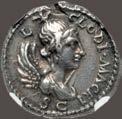

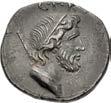
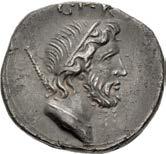




713. Clodius Macer. Usurper, AD 68. AR Denarius (17mm, 3.17 g, 6h). Carthage mint. L • CLODIVS • MΛCER, S C below, bare head right / PROPRA (sic) above, ΛFRICΛ (sic) below, galley left with ten oars and seven oarsmen. RIC I 39; Hewitt Group G/5, 58-9 (Obv. die –/Rev. die 40 [unlisted obv. die]) ; RSC 13b. Darkly toned, light marks and scratches, scrapes on reverse. VF. Very rare. ($30,000)
From the S & S Collection. Ex Triton V (15 January 2002), lot 1896.
During his rebellion, Macer acted as little more than a pirate, sweeping the north African coast hoping to increase his power by cutting into the grain supplies of Rome. By April of 68, Macer had decided not to support Galba, and in June when Nero died, Macer began striking coins in his own name. All of Macer’s coins are of rather crude style, an indication of the lack of skilled die engravers and the haste at which they were produced. By October, Galba had solidified his power in Rome and ordered Macer’s execution. All of Macer’s coins are extremely rare, with fewer than 85 coins of all types known, of which fewer than 20 are portrait types.



714. Civil War. AD 68-69. AR Denarius (18mm, 3.67 g, 7h). ‘G P R Group II’. Uncertain mint in Gaul or in the Rhine Valley. G•P•R, draped bust of the Genius of the Roman people to right; scepter over shoulder / MARS VLTOR, Mars, nude but for helmet and parazonium slung around his chest, advancing right, wielding spear in his right hand and holding shield in his left. RIC I 48; AM 25, but cf. 24 and pl. 2, 24 P (for an aureus struck from the same reverse die); RSC –; Mairat 35.3 (this coin); BMCRE 21 note; Nicolas, Néron 26, but cf. 24-25 and pl. I, 24 P & 25 CAL (for aurei struck from the same reverse die). Deeply toned, slight roughness in the fields. Near EF. Extremely rare and exceptional for issue. Among the finest known. ($10,000)
Ex Dipl.-Ing Christian Gollnow Collection; Lanz 128 (22 May 2006), lot 291; Numismatica Ars Classica 92 (23 May 2016), lot 501.
Exceptional style, not typically encountered in the Civil War denarii. While most of the Rhine mint denarii tend to be of a more crude style and fabric, this specimen is superb, revealing the hand of a particularly talented engraver.
715. Galba. AD 68-69. AV Aureus (18.5mm, 7.41 g, 6h). Uncertain mint in Gaul (Narbo?). Struck April to late Autumn AD 68. SER GALBA IMPERATOR, laureate head right / VICTORIA P R, Victory standing left on globe, holding wreath in right hand and palm frond in left. RIC I 110; Calicó 513; BMCRE 226; Adda –; Biaggi –; Jameson –; Mazzini 322. Lustrous. In NGC encapsulation 6157870-002, graded VF, Strike 4/5, Surface 3/5, light graffito, flan flaw. Very rare. ($10,000)
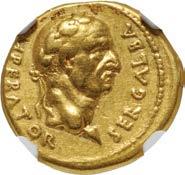

716. Galba. AD 68-69. AR Denarius (18mm, 3.58 g, 6h). Uncertain mint in Gaul (Vienna?). Struck circa April to late autumn AD 68. SER • GALBA • IMP, Galba, in military attire, on horseback galloping right, extending right hand / HISPANIA, bareheaded and draped bust of Hispania right; to left, two javelins above round shield; to right, two stalks of grain. RIC I 86 var. (Galba brandishing javelin); RSC 76a; BMCRE 207-8; BN –. Toned, minor scratch, some cleaning marks. Good VF. ($2000)




By AD 68, Servius Sulpicius Galba had governed Hispania for nearly eight years with a single Roman legion, VI Victrix, under his command. In April of that year, with Nero’s support crumbling, Galba proclaimed himself as representing the Senate and People of Rome, not Nero, thus taking the first steps that would lead to his brief, chaotic reign as emperor. However, the final collapse of Nero’s regime took several months, during which the Roman coinage reflected the uncertain political climate. This rare issue, struck in the name of Galba at an uncertain Gallic mint, refrains from depicting Galba’s portrait, instead showing a female profile personifying the province he governed, Hispania, while the reverse depicts him as a victorious Roman general (imperator) astride his steed.
717. Galba. AD 68-69. AR Denarius (17.5mm, 3.02 g, 5h). Rome mint. Struck circa July AD 68-January 69. IMP SER GALBA AVG, bare head right / S P Q R/ OB/ C S in three lines within oak wreath. RIC I 167; RSC 287; BMCRE 34 corr. (not laureate); BN 76-7. Colorful iridescent toning, a few scratches under tone. Near EF. Bold portrait. ($2500)


From the G.W. Trow Collection. Ex Numismatica Ars Classica 97 (12 December 2016), lot 94.
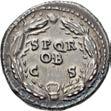
718 719
718. Galba. AD 68-69. Æ Sestertius (36mm, 26.42 g, 6h). Rome mint, 4th officina. Struck circa June-August AD 68. SER GALBA IMP CAES AVG TR P, laureate head right / Roma seated left on cuirass, foot on helmet, holding spear and resting arm on shield; two greaves and bow to right. RIC I 244; ACG 251 (A138/P36). Dark brown patina, some roughness. Good VF. ($1000)
Ex Naville Numismatics 66 (27 June 2021), lot 397.
719. Galba. AD 68-69. Æ Sestertius (35.5mm, 24.83 g, 6h). Rome mint. Struck circa October AD 68. SER GALBA • IMP • CAESAR AVG TR P •, laureate and draped bust right / S P Q R/ O B/ CIV SER in three lines within oak-wreath. RIC I 405; ACG 186 (A94/P138); BMCRE p. 327, note *; BN –. Dark brown patina, a hint of smoothing. Good VF. Portrait of fine style. ($1500)

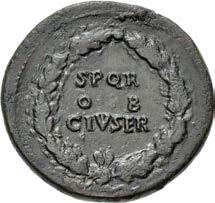

Ex Heinrich Peter Rudolf Collection; Hirsch 269 (23 September 2010), lot 2722.

720. Otho. AD 69. AR Denarius (19mm, 3.32 g, 6h). Rome mint. Struck 15 January–8 March. [IMP] M OTHO CAESAR AVG TR P, bare head right / SECVR I TAS P R, Securitas, draped, standing left, holding wreath in right hand and scepter in left. RIC I 8; Muona Group 1, Type 4B, Portrait Type A; RSC 17; BMCRE 17-8; BN 10. Iridescent toning, areas of minor roughness, trace of die rust on the obverse, hairline flan crack. EF. A beautiful example. Rare in this condition. ($4000)



Ex Rauch 99 (8 December 2015), lot 119; Giessener Münzhandlung 84 (13 October 1997), lot 5799; Giessener Münzhandlung 82 (29 April 1997), lot 257.
721. Otho. AD 69. AR Denarius (18mm, 3.19 g, 5h). Rome mint. Struck 15 January–8 March. IMP M OTHO CAESAR AVG TR P, bare head right / SECV RI TΛS P R, Securitas, draped, standing left, holding wreath in right hand and scepter in left. RIC I 8; Muona Group 1, Type 4B, Portrait Type A; RSC 17; BMCRE 17-8; BN 10. Iridescent tone. Near EF. Well centered on a round flan. Bold portrait. ($2000)
From the G.W. Trow Collection. Ex Hess-Divo 332 (31 May 2017), lot 102.
722. Vitellius. AD 69. AV Aureus (19mm, 7.18 g, 6h). Spain (Tarraco?) mint. Struck circa January-June. A • VITELLIVS • IMP GERMANICVS, laureate bust left, globe at point of neck / LIBERTAS RESTITVTA, Libertas, draped, standing right, holding pileus in right hand and vindicta (liberation rod) in left. RIC I 9; CSB 28; Calicó 564; BMCRE 88; cf. BN 3 (Denarius); Biaggi 280. Minor deposits. In NGC encapsulation 6158333-001, graded VF, Strike: 5/5, Surface: 2/5, scuffs. Very rare. ($5000)
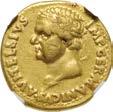


Ex Harmers 2 (27 September 2021), lot 98; Heritage 3076 (5 September 2019), lot 30269.
723. Vitellius. AD 69. AR Denarius (18mm, 3.57 g, 6h). Tarraco mint. Struck circa January-June. A • VITELLIVS • IMP • GERMANICVS , laureate head left, globe at point of neck / CLEMENTIA IMP GERMAN, Clementia, draped, seated left, holding branch in right hand and long, vertical scepter in left. RIC I 18 var. (obv. legend); CSB 4; RSC 10; BMCRE p. 384, note †; BN 1; ACIP 4235a (this coin); S 2189 var. (this coin illustrated). Attractive light toning, a few faint scratches. EF. Exceptional. ($3000)

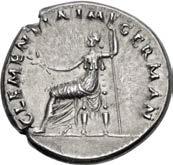
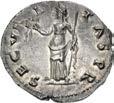



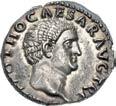
Ex Lanz 150 (13 December 2010), lot 249; David Dougherty Collection (Part I, Ponterio 141, 12 January 2007), lot 1641; John Whitney Walter Collection (Stack’s, 29 November 1990), lot 33, purchased from Harlan J. Berk, 18 August 1986.
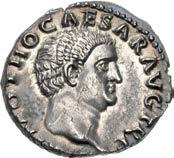
724. Vitellius. AD 69. AV Aureus (18.5mm, 7.39 g, 6h). Uncertain Spanish mint (Tarraco?). Struck January to June. Λ VITELLIVS IMP GERMΛN, laureate bust of Vitellius left, globe at point of neck, small palm frond in front / VICTORIΛ ΛVGVSTI, Victory, draped, flying left and holding shield inscribed SP/QR in two lines. RIC I 35; Calicó 576; Biaggi 284; BMCRE 91 var. (lacking palm frond); BN 12 var. (same); Adda –; Hunter 51; Jameson –; Mazzini –. In NGC encapsulation 4684161-003, graded Ch VF, Strike 5/5, Surface 3/5, Fine Style, edge marks. Extremely rare. ($20,000)
Ex George C. Hopkins Collection (Numismatica Ars Classica 114, 6 May 2019), lot 631; Lanz 154 (11 June 2012), lot 317.
725. Vitellius. AD 69. AR Denarius (19mm, 3.30 g, 6h). Rome mint. Struck circa late April–20 December. [A V] ITELLIVS GERMANICVS IMP, bare head right / Victory, draped, seated left, holding patera in right hand and palm frond in left. RIC I 71; RSC 121; BMCRE 4-5; BN 37. Iridescent tone with luster around devices, a few minor scratches. Near EF. With an attractive portrait. ($3000)
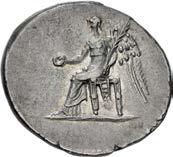
Ex Künker 168 (12 March 2010), lot 7702; A. Lynn Collection (Helios 4, 14 October 2009), lot 280; Triton IV (5 December 2000), lot 492.
726. Vitellius. AD 69. AR Denarius (18mm, 3.26 g, 6h). Rome mint. Struck circa late April-20 December. Λ VITELLIVS

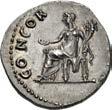
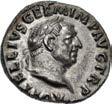


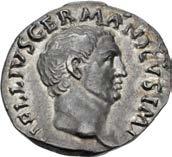

GERM IMP ΛVG TR P, laureate head right / CONCOR [DIΛ P] R, Concordia, draped, seated left, holding patera in right hand and cornucopia in left. RIC I 90; RSC 18; BMCRE 20-1; BN 52. Attractive toning, traces of die rust, reverse slightly off center. EF. Outstanding portrait. ($3000)
From the G.W. Trow Collection. Ex New York Sale XXXIV (6 January 2015), lot 554; Ex Leu 72 (12 May 1998), lot 420.
727. Vitellius. AD 69. AR Denarius (18mm, 3.35 g, 6h). Rome mint. Struck circa late April-20 December. Λ VITELLIVS


GERM IMP AVG TR P, laureate head right / XV VIR SΛCR FΛC, tripod-lebes surmounted by dolphin right; below, raven perched right. RIC I 109; RSC 111; BMCRE 39-40; BN 77. Attractive cabinet tone, a couple of tiny deposits. Superb EF. ($4000)
Ex Rauch 100 (18 April 2016), lot 4; Numismatica Ars Classica 11 (29 April 1998), lot 396.



728. Vespasian. AD 69-79. AV Aureus (18mm, 7.20 g, 6h). Lugdunum (Lyon) mint. Struck AD 70. IMP CAESAR VESPASIANVS AVG TR P, laureate head rightq / COS ITER FORT RED, Fortuna, draped, standing left, dropping right hand to touch prow on ground to left, and holding cornucopia in left. RIC II.1 1104; Lyon 1 (unlisted dies); Calicó 602; BMCRE 373; BN –; Biaggi –. Lustrous, faint hairlines, edge marks. Good VF. ($5000)
729. Vespasian. AD 69-79. Æ Sestertius (34.5mm, 27.05 g, 6h). “Judaea

Rome mint. Struck AD 71. IMP CAES VESPASIAN AVG P M TR P P P COS III, laureate head right / IVDAE A CAPTA, S C in exergue, palm tree; to left, Vespasian standing right, left foot on helmet, holding spear in right hand, cradling parazonium in left arm; to right, Judaea seated right on cuirass, in attitude of mourning. RIC II.1 167; Cayon 95; Hendin 6534; BMCRE 543; BN 497-8. Brown surfaces, minor pitting. VF. ($2000)

From the DMS Collection, purchased from Jonathan K. Kern, January 2005.
The Roman victory in the Jewish War (66-73 CE) became a keystone of the numismatic propaganda deployed on the Judaea Capta coins in gold, silver, and bronze struck by both Vespasian and Titus. This Judaea Capta sestertius is part of this series. The figure of Judaea is shown slumped in abject defeat, head in hand, while the triumphant Vespasian is shown standing in a general’s armor, uncaring of her suffering. Such brutal images helped consolidate Vespasian’s hold on power and made Romans forget the disastrous civil wars of AD 68-69.
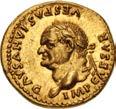


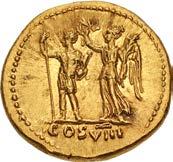
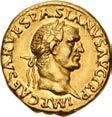



731. Vespasian. AD 69-79. Æ Sestertius (33mm, 24.01 g, 6h). Rome mint. Struck AD 77-78. IMP CAES VESPASIAN AVG P M TR P P P COS VIII, laureate head right; eagle inset of the d’Este family behind head / ANNONA AVGVST, S C across field, Annona, draped, seated left, holding open on her lap a bag of grain ears, the ends held in her hands. RIC II 987; BMCRE 730 (this coin illustrated); BN 768. Even brown surfaces. Host coin VF, inset Good VF. Rare. ($3000)



From the DMS Collection, purchased from Harlan J. Berk, January 2003. Ex Henry Platt Hall Collection (Part II, Glendining, 16 November 1950), lot 1173; Theodor Prowe Collection (28 November 1904), lot 2391; D’Este Collection, formed initially by Leonello d’Este (14071450), Marquis of Ferrara.
For many centuries, numismatists and scholars have debated the attribution of the distinctive eagle collector’s mark, found on the obverse of a small number of predominantly Greek and Roman coins. Attribution has been generally divided between two Italian noble families: the Gonzag’s, rulers of Mantua, which proclaims itself as the birthplace of the poet Virgil, and the Este family of Ferrara in northern Italy, who could trace their ancestry back to the 10th century. Much of the confusion stems from the intermingling of the Gonzaga and Este family collections in the 17th century. During the War of the Mantuan Succession (1628-1631), the Gonzaga coin collection was used as collateral by the embattled Duke Charles II Gonzaga of Nevers (1609-1631). It was during this tumultuous time in late Renaissance Italy that the Este family acquired the Gonzaga collection. The Gonzaga’s subsequently failed to recover their collection from the Este’s. Leonello d’Este (14071450) Marquis of Ferrara, initially formed what grew into a massive generational collection that was passed down through the Este family for centuries. Leonello began his collection with mostly bronze coins, such as the example offered here. Leonello acquired these earliest coins as a young man prior to 1430. Ercole I d’Este (1431-1505), Leonello’s half-brother, and Duke of Ferrara from 1471-1505, owned a collection of 437 gold coins by 1494. Some were notably acquired from the collection of Pope Paul II (d. 1471). Ercole’s son, Alfonso I d’Este, Duke of Ferrara from 1505-1534, enlisted the assistance of the lauded artist Raphael (painter of the famous The School of Athens in the Vatican library) to help him track down “antique medals, heads and figures.” A rough catalogue of the d’Este family collection was compiled between 1538-1541 under the direction of Ercole II d’Este (1508-1559), Duke of Ferrara from 1534-1559. The 1541 catalogue lists 783 ancient gold coins in the collection.


The collection continued to expand and reached its zenith under Alfonso II d’Este (1533-1597), Duke of Ferrara from 1559-1597.Some of the gold coins that are known today that feature the eagle inset appear in the 1541 manuscript. The absence of some of the coins that today bear the eagle inset supports a date for the inset’s application sometime after 1541. Enea Vico (1523-1567), who directed acquisitions for the d’Este family, referenced the collection in a 1563 writing that makes no mention of the inset. This again supports a slightly later date post 1563. A good possibility for the catalytic event that resulted in the inset’s application to these coins is an exhibition prepared by the famous artist and architect Pirro Ligorio (c.1510-1583). Ligorio, author of a number of famous manuscripts, worked under the patronage of the d’Este family in Ferrara between 1568 and 1574. It was while he worked for the d’Este’s, organizing the duke’s collections in his Antichario, that he compiled many of his famous manuscripts. Ligorio also served as the Vatican’s Papal Architect under Popes Paul IV and Pius IV.
From this evidence, scholars have concluded that the eagle inset did indeed belong to the Este family and was likely applied sometime between 1563-1614, perhaps during the tenure of Pirro Ligorio’s employment from 1568-1574. Later, in 1647, the Este’s recovered 710 pawned aurei with the eagle inset. Additionally, out of the 12,000–15,000 coins which at one time constituted the collection in its entirety, only around 1,500 were chosen to bear the eagle inset, applied in either silver or gold. Bronze coins, such as this one, are less commonly found from the d’Este collection wearing the eagle inset. Portions of the d’Este collection made their way into collections and museums in Milan, Modena, and Paris, as well as in Queen Christina of Sweden’s (1626-1689) personal cabinet of Roman coins. Apart from those collections, the remaining coins featuring the inset irregularly and infrequently appear on the market, such as this example which has been in sales since 1904. This is a rare chance to own a rare coin from a verifiable, famous, and coveted 15th century collection.

732. Vespasian. AD 69-79. AR Denarius (18mm, 3.32 g, 6h). Ephesus mint. Struck AD 69-70. IMP • CAES VESPAS • AVG, laureate head right / CONCORDIΛ ΛVG, Ceres seated left on ornate, high-backed chair, holding poppy and grain ears in right hand and cornucopia in left; sideways (Φ) in exergue. RIC II.1 1400 (this coin cited and illustrated); RPC II 809; RSC 65c; cf. BMCRE 434A. Light iridescent tone. Choice EF. Struck from dies of artistic merit. Rare. ($1000) Ex Roma XVIII (29 September 2019), lot 1117; Gorny & Mosch 126 (14 October 2003), lot 2325.

733. Vespasian. AD 69-79. AR Denarius (17mm, 3.48 g, 12h). Ephesus mint. Struck AD 71. IMP CAESAR VESPAS AVG COS III TR P P P, laureate head right / AVG/ E(PHE) in two lines within wreath. RIC II.1 1427; RPC II 829; RSC 40; BMCRE 452; BN 341. Lustrous, faint hairlines. EF. Beautifully centered and well struck. Exceptional. ($2000)
From the G.W. Trow Collection. Ex Goldberg 80 (3 June 2014), lot 3129; Künker 143 (6 October 2008), lot 518.
When Vespasian’s reign began, he was supreme general in the eastern provinces leading the Roman army against the Jewish rebels in Judaea. The established eastern mints of Antioch and Ephesus were employed to strike coins in his name to pay the legions needed to challenge for the throne and complete the Judaean war. The production of denarii and aurei at Ephesus continued after he secured power until circa AD 76, including this specimen dated to 71. Ephesus having a long history of coinage, portraiture and overall quality were equal or superior to the mint of Rome, while retaining a distinctive style.
734. Divus Vespasian. Died AD 79. Æ Sestertius (33.5mm, 25.78

S • C. RIC II.1 257 (Titus) (same dies); BMCRE 222 (Titus); BN 231 (Titus). Green patina, some minor smoothing, minor marks and deposits. VF. ($2000)
From the DMS Collection. Ex Robert O. Ebert Collection (Stack’s Bowers and Ponterio 174, 12 January 2013), lot 6121.
The unusual obverse of this sestertius likely depicts a scene from Vespasian’s funeral cortege, showing his radiate effigy being pulled behind a quadriga of elephants. Another variety depicts a closer view of the statue, which appears to be considerably larger than life-sized. As the first emperor successful enough to have merited deification since Claudius, his funeral was surely a major public event, and the mourning for the stability he brought was likely sincere. The funerals of deified Roman emperors typically ended with the waxen effigy being burned atop an enormous tiered pyre, from which an eagle is released to symbolized his spirit’s ascent to the heavens.
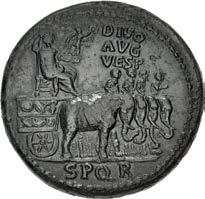
735.
From the S & S Collection.
A vexing problem of Flavian numismatics is the identity of a woman named Domitilla, who died sometime before the family rose to power and was deified and honored on coinage struck under Domitian. Vespasian’s wife, the mother of Titus and Domitian, was named Flavia Domitilla and was long regarded as the most likely candidate. However, Vespasian’s daughter, the sister of Titus and Domitian, bore the same name and also predeceased Vespasian’s rise to power in AD 69; some numismatists, notably Carradice and Buttrey in the revised RIC II (London, 2007) assign the Diva Domitilla coinage to her. A 2010 article by Susan Wood in the American Journal for Archaeology Online, again makes the case for the senior Domitilla: “Her purely symbolic but significant role in the official propaganda contrasts with the living women of Domitian’s principate [his sister, Julia Titi, and his wife, Domitia], both of whom held the title of Augusta and were perceived to be rivals for power.”


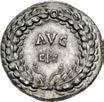


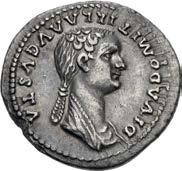
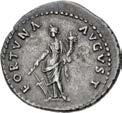
736. Titus. As Caesar, AD 69-79. Æ Sestertius (32mm, 25.05 g, 7h). “Judaea Capta” commemorative. Rome mint. Struck under Vespasian, AD 72. T CAES VESPASIAN IMP PON TR POT COS II, laureate head right / IVDAEA CAPTA, S C in exergue, palm tree; to left, Titus standing right, left foot on helmet, holding spear in right hand, cradling parazonium in left arm; to right, Judaea seated right on cuirass, in attitude of mourning. RIC II.1 422; Hendin 6553; BMCRE 631-2; BN 618. River patina, smoothing and minor tooling. VF. Powerful portrait. ($3000)

From the Dr. Jay M. Galst Collection; Ex Leo Benz Collection (Lanz 94, 22 November 1999), lot 348.
737. Titus. As Caesar, AD 69-79. AR Denarius (18mm, 3.27 g, 6h). Rome mint. Struck under Vespasian, AD 72-73. T CAES IMP VESP PON TR POT, laureate head right / Palm tree; to left, Titus standing right, foot on globe, holding spear and parazonium; to right, Judaea seated right in attitude of mourning. RIC II.1 369; Hendin 6512; RSC 391a. Toned, well struck, minor laminations. Good VF. Rare. ($1000)
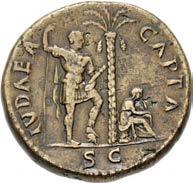

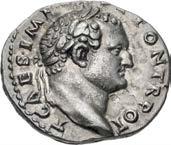


From the DMS Collection, purchased from David Hendin, August 2011.
738. Titus. As Caesar, AD 69-79. Æ Sestertius (33.5mm, 25.66 g, 7h). “Judaea Capta” commemorative. Rome mint. Struck under Vespasian, AD 73. T CAES VESP IMP PON TR POT COS II CENS, laureate head

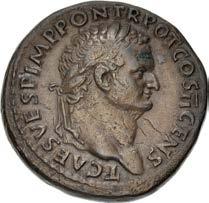
From
When Vespasian was acclaimed Emperor by the eastern legions on 1 July AD 69, he left his son Titus in command of ongoing operations to repress the Jewish Revolt (AD 66-73). Like his father, Titus was a skilled general and, by April AD 70, he had forced the rebels behind the walls of Jerusalem, which he besieged for four months and ultimately demolished, setting the Temple ablaze. Although mopping up operations against surviving rebel elements continued, Titus traveled to Rome in AD 71 to celebrate a formal triumph as Caesar alongside his father. Despite its lack of any legend other than S C (Senatus Consulto), the reverse of this sestertius belongs to the “Judaea Capta” Flavian propaganda program in its depiction of Titus riding serenely in the triumphal chariot, drinking in the adulation of the Roman people.
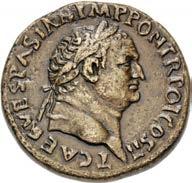
739. Titus. AD 79-81. AV Aureus (19mm, 7.27 g, 6h). Rome mint. Struck after 1 July AD 79. IMP TITVS CAES VESPASIAN AVG P M, laureate head left / TR P VIIII IMP XIIII COS VII, Venus, seen half from behind, naked to the hips, standing right, right knee bent, resting left elbow on column, holding helmet up in right hand and transverse spear in left. RIC II.1 14 var. (shield against column); Calicó 756 var. (head right); cf. BMCRE 4; BN –; Adda –; Biaggi –; Jameson –; Mazzini 267 var. (head right). Lustrous, minor hairlines. EF. Unpublished and unique with head left. ($20,000)
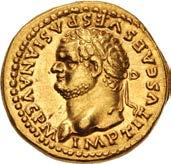





This charming reverse type, depicting the goddess Venus, leaning on a column, holding a scepter and helmet, with her half-covered derriere turned coyly to the viewer, is rather unusual for a male ruler. Indeed, the same reverse was also used on coins of Titus’ daughter, Julia Titi, in the next reign by his brother’s wife, Domitia, and ultimately by Julia Domna, but never again by a Roman emperor. Venus was supposedly progenitor of the Julian clan and was thus employed by Caesar on his coinage, and by later emperors as well, although on male issues she usually appears fully clothed as Venus Victrix. Titus, a military man but with an eye for art and beauty, perhaps was captivated by a statue depicting Venus Callipyge (”Venus of the beautiful buttocks”) and ordered that a variant image be employed as a reverse type for his coinage and that of his daughter. While relatively common in Titus’ silver, it is quite rare in gold. This example, with a left-facing portrait, appears to be unique.


740. Titus. AD 79-81. AV Aureus (20mm, 7.15 g, 6h). Rome mint. Struck AD 80. IMP TITVS CAES VESPASIAN AVG P M, laureate head right / TR P IX IMP XV COS VIII P P, elephant, cuirassed, advancing left. RIC II.1 114; Calicó 775; BMCRE 42; BN 36; Biaggi 377; Jameson 74; Mazzini 302. Hairlines. Near VF. An important historic type. ($4000)
The elephant on this aureus type represents one of the numerous species displayed in the newly constructed Flavian Amphitheater, or Colosseum, built by prisoners of the First Jewish War on the site of the Domus Aurea of Nero. Opened to the public during Titus’ rule in AD 80, and commemorated by Martial in de Spectaculis, the Colosseum was welcomed with great fanfare and games. During the opening ceremonies a great number of animals, including elephants, were both exhibited and slaughtered.

741. Titus. AD 79-81. AV Aureus (19mm, 7.19 g, 5h). ‘Atonement’ series. Rome mint. Struck 1 January-30 June AD 80. IMP TITVS CAES VESPASIAN AVG P M, laureate head right / TR P IX IMP XV COS VIII P P, pulvinar (throne) of Jupiter: square seat, draped and surmounted by horizontal winged thunderbolt. RIC II.1 117; Calicó 782; BMCRE 49; BN 42; Biaggi 382. Lustrous. Good VF. Well centered. ($3000)

742. Titus. AD 79-81. AR Denarius (19mm, 3.38 g, 6h). ‘Atonement’ series. Rome mint. Struck 1 January-30 June AD 80. IMP TITVS CΛES VESPΛSIΛN ΛVG P M, laureate head right / TR P IX IMP XV COS VIII P P, pulvinar (throne) of Mars and Venus: curule chair, above which is a wreath. RIC II.1 108; RSC 318; BMCRE 66-9; BN 53. Lightly toned, a few minor scratches. EF. ($1000)
From the G.W. Trow Collection. Ex Goldberg 80 (3 June 2014), lot 3136.
743. Julia Titi. Augusta, AD 79-90/1. AR Denarius (19.5mm, 3.16 g, 6h). Rome mint. Struck under Titus, AD 80-81. IVLIA AVGVSTA TITI AVGVSTI F, diademed and draped bust right; hair in long plait / VENVS AVGVST, Venus, seen half from behind, naked to the hips, standing right, resting elbow on column, holding transverse scepter and crested helmet. RIC II.1 388 (Titus); RSC 14; BMCRE 141-3 (Titus); BN 106-7 (Titus). Toned, minor deposits. EF. ($3000) From the S & S Collection.
In AD 79, Vespasian died and Titus became sole emperor. One of his first official acts was to raise his daughter Julia to the rank of Augusta, or Empress, the first woman in more than a decade to hold that exalted position. He struck this lovely coin for the occasion. Julia thus became the first reigning Roman empress to be honored with a regular issue of Roman coins struck solely in her own name.

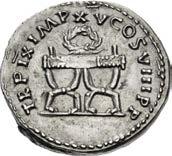
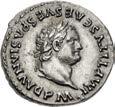


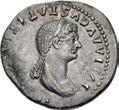
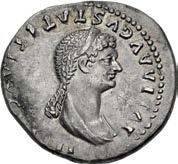
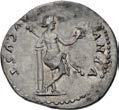
744. Domitian. As Caesar, AD 69-81. AV Aureus (19mm, 7.34 g, 6h). ‘Atonement’ series. Rome mint. Struck under Titus, AD 80-81. CAESΛR DIVI F DOMITIΛNVS COS VII, laureate head right / PRINCEPS IVVENTVTIS, garlanded and lighted altar. RIC II.1 265 (Titus); Calicó 918; BMCRE 91 (Titus); BN 74 (Titus); Adda 75; Biaggi 430. Broad flan, residual luster. VF. ($3000)




745. Domitian. As Caesar, AD 69-81. AV Aureus (19mm, 7.20 g, 6h). ‘Atonement’ series. Rome mint. Struck under Titus, AD 80-81. CΛESΛR DIVI F DOMITIΛNVS COS VII, laureate head right / PRINCEPS IVVENTVTIS, pulvinar (throne) of Minerva: crested Corinthian helmet set on draped square seat. RIC II.1 270 (Titus); Calicó 920; BMCRE 97 (Titus); BN 78 (Titus); Adda –; Biaggi –; Jameson –; Mazzini –. Minor surface marks. VF. ($3000)
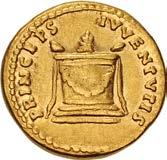
746. Domitian. As Caesar, AD 69-81. AR Denarius (18.5mm, 3.30 g, 6h). Rome mint. Struck under Titus, AD 80-81. CAESΛR DIVI F DOMITIΛNVS COS VII, laureate head right / PRINCEPS IVVENTVTIS, garlanded and lighted altar. RIC II.1 266 (Titus); RSC 397a; BMCRE 92-6 (Titus); BN 76-7 (Titus). Light marks. EF. Well struck with fresh dies. ($750)
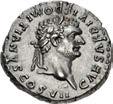
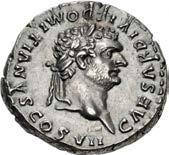
From the G.W. Trow Collection. Ex Goldberg 80 (3 June 2014), lot 3139; Spink 206 (1 December 2010), lot 1320; Numismatica Ars Classica 8 (3 April 1995), lot 797.
747. Domitian. AD 81-96. AV Aureus (21mm, 7.75 g, 6h). Rome mint. Struck AD 85. IMP CΛES DOMITIΛNVS ΛVG GERMΛNIC, laureate bust right, wearing aegis / P M TR POT IIII IMP VIII COS XI P P, Minerva standing right on capital of rostral column, holding spear and shield; at her feet to right, owl. RIC II 258 var. (without aegis); Calicó 910a var. (same); BMCRE 70 var. (same); BN –; Biaggi 423; CNG 105, lot 857 (same obv. die). Lustrous, scratches on obverse. EF. ($15,000)






Domitian considered Minerva to be his own personal patron goddess and devoted much of his personal time, and public funds, to her worship. He constructed the Templum Minverva Chalcidicia in close proximity to the Pantheon, restored the Templum Castorum et Minervae, had built a substantial altar to the goddess in his bedroom, and erected multiple statues around the city. The symbolism on his coinage is obvious with over 75% of his denarii and aurei having Minerva on the reverse. He also founded a legion in her name, Legio I Minervia.
748. Domitian. AD 81-96. Æ Sestertius (34mm, 23.47 g, 6h). Rome mint. Struck AD 95-18 September 96. IMP CAES DOMIT AVG GERM COS XVII CENS PER P P, laureate head right / IOVI VICTORI, S C in exergue, Jupiter, naked to hips, seated left, holding Victory in extended right hand and vertical scepter in left. RIC II.1 794; BMCRE 474-5; BN 504-5. Handsome river brown surfaces, a few minor flan flaws. EF. ($5000)

Ex Numismatica Ars Classica 59 (4 April 2011), lot 1932 (hammer CHF 7000).

749. Nerva. AD 96-98. Æ Sestertius (34mm, 26.44 g, 6h). Rome mint. Struck AD 96. IMP NERVA CAES AVG P M TR P COS II DESIGN III P P, laureate head right / CONCORDIA EXERCITVVM, clasped hands; legionary aquila set on prow of galley behind. RIC II 70; Banti 6 (this coin); BMCRE p. 17, §; Mazzini 27 = L. G. P. Messenger, “Some Further Unpublished Roman Bronze Coins in my Collection” in NC 1933, 8 (this coin). Red-brown patina, some roughness, minor smoothing in fields. VF. Very rare, only two in CoinArchives, one known to Banti. ($1500)

Ex Roma E-Sale 85 (17 June 2021), lot 1678; Áureo & Calicó 311 (31 May 2018), lot 42; Classical Numismatic Group Electronic Auction 156 (17 January 2007), lot 173; Tony Hardy Collection (Classical Numismatic Group 67, 22 September 2004), lot 1402; Giuseppe Mazzini Collection; Leopold G. P. Messenger Collection; Ratto 4 (11 March 1933), lot 226; Clarence S. Bement Collection (Ars Classica VIII, 25 June 1924), lot 799; Gustave Burel Collection (Feuardent, 11 June 1913), lot 517.

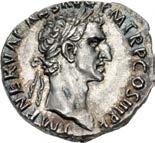

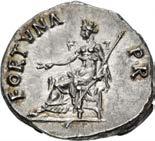

750. Nerva. AD 96-98. AR Denarius (17mm, 3.33 g, 6h). Rome mint. Struck AD 97. IMP NERVΛ CΛES ΛVG P M TR P COS III P P, laureate head right / FORTVNΛ P R, Fortuna Populi Romani, draped, enthroned left, holding two grain ears in extended right hand and transverse scepter in left. RIC II 17; RSC 79; BMCRE 41-3; BN 28-9 corr. (rev. legend). Colorful iridescent tone. EF. Well struck with fresh dies. A superb denarius of Nerva. ($2000)
From the G.W. Trow Collection. Ex Numismatica Ars Classica 80 (20 October 2014), lot 87; Triton XVI (8 January 2013), lot 1076.
751. Nerva. AD 96-98. Æ Sestertius (33mm, 28.58 g, 6h). Rome mint. Struck AD 97. IMP NERVA CAES AVG P M TR P COS III P P, laureate head right / FORTVNA AVGVST, S C across field, Fortuna standing left, holding rudder in right hand and cornucopia in left. RIC II 83; Banti 21; BMCRE 107-8; BN 98. Attractive original green and brown patina. Good VF. ($5000)

From the DMS Collection. Ex CNG inventory 944074 (May 2013); Numismatica Genevensis SA VII (27 November 2012), lot 358 .

752. Trajan. AD 98-117. Æ Sestertius (34.5mm, 23.91 g, 6h). Rome mint. Struck AD 101-102. IMP CAES NERVA TRAIAN AVG GERM P M, laureate bust right, slight drapery / TR POT COS IIII P P, S C in exergue, Pax, draped, seated left on throne, holding olive branch in extended right hand and transverse scepter in left. RIC II 432 var. (bust type); Woytek 107b; Strack 338; Banti 337; BMCRE 745, note; BN 144-5. Glossy green patina. Choice EF. Boldly struck, with a magnificent portrait. A first class bronze. ($15,000)
When Trajan entered his fourth consulship in AD 101, the Roman Empire seemed securely at peace, as celebrated by the figure of Pax on the reverse of this attractive sestertius. These allusions were possibly a ruse, however, as Trajan was already planning a massive campaign against the Dacian King Decebalus, who had humiliated Roman armies on two occasions during Domitian’s reign.



753. Trajan. AD 98-117. AR Denarius (18mm, 3.26 g, 6h). First Dacian war issue. Rome mint. Struck AD 102. IMP CAES NERVA TRAIΛN ΛVG GERM, Laureate bust right, slight drapery / P • M • TR P • COS • IIII • P • P, Victory, draped, standing right on prow, terminating in serpent, holding palm frond in left hand over left shoulder and wreath in right hand. RIC II 59; Woytek 123b; Strack 51; RSC 241a; BMCRE 107; BN 132. Toned. EF. Well struck and perfectly centered. ($750)
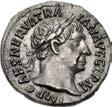


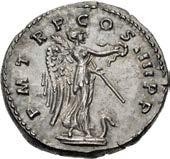
From the G.W. Trow Collection. Ex Goldberg 80 (3 June 2014), lot 3147.
754. Trajan. AD 98-117. AV Aureus (20mm, 7.16 g, 6h). Rome mint. Struck AD 112-113. IMP TRAIANVS AVG GER DAC P M TR P COS VI P P, laureate, draped, and cuirassed bust right / Triumphal gateway to Trajan’s Forum, with six columns, sculptural reliefs, and attic statuary consisting of a chariot drawn by six horses flanked by two figures standing to either side of trophy; FORVM TRAIAN in exergue. RIC II 257; Beckmann, Early Group I, 2 (dies a13/F1); Woytek 409f; Strack 216; Calicó 1031a; Adda 95; Biaggi 494; Mazzini 168 v. Residual luster, minor deposit on reverse. Good VF. Struck on a broad flan, with a detailed depiction of Trajan’s Forum. ($5000)

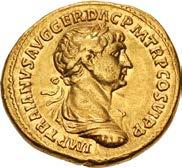


Nearly every detail of Trajan’s Forum was intended as a celebration and aggrandizement of the emperor’s Dacian victory, so it is fitting that the forum’s entrance doubled as Trajan’s triumphal arch. In typical fashion, the arch is surmounted by a statuary group with figures of the emperor and Victory in a chariot. A large portion of the Forum survives to this day, containing multiple market stalls, indicating its function as the ancient Roman equivalent to a shopping mall.

755. Trajan. AD 98-117. Æ Sestertius (33mm, 26.68 g, 6h).





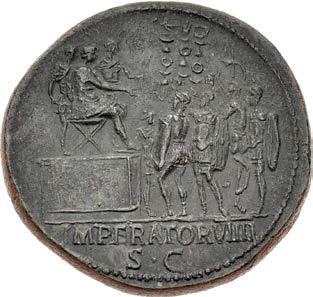

mint. Struck circa AD 112/3-114.
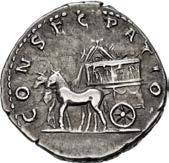

NERVAE TRAIANO
GER DAC P M TR P COS VI P P,
/ S P Q R OPTI MO PRINCIPI, S C across field, Trajan’s column surmounted by statue of Trajan, holding patera and scepter; two eagles at base; relief in base and pediment. RIC 601; Woytek 472a (same dies); Banti 296; BMCRE 971 note; BN 761. Even brown surfaces with some areas of red, minor edge chip. Good VF. Rare. ($2000)
From the DMS Collection, purchased from Harlan J. Berk, August 2008.
Trajan excelled in civilian government and understood the importance of public works. One of his most famous was the column bearing his name, which st…ill stands today. His conquest of Dacia in AD 102-105 can be followed on the spiral reliefs of Trajan’s Column, and brought an enormous windfall of plunder into the Roman economy, financing construction of his enormous new Forum, for which the column served as a centerpiece. This sestertius was struck to celebrate completion of the column, and the relief is readily apparent. Trajan’s mortal remains were later entombed under its base.
756.
757.
Trajan’s sister Marciana and her daughter Matidia moved into the Imperial palace upon his ascension and formed part of a distaff cabal of women relations, led by his wife Plotina, who are widely thought to have influenced the domestic policies of his government. Upon her death on 29 August AD 112, Marciana was formally deified and honored with this attractive denarius issue, the rarest of all her coin types, which is missing in most museum and major private collections.

758. Matidia. Augusta, AD 112-119. AR Denarius (19.5mm, 2.97 g, 7h). Rome mint. September AD 112-117. MATIDIA AVG DIVAE MARCIANAE F, draped bust right, wearing double stephane upright on head, in front of which her hair is built up in two tiers: the hair is massed at top and back of head in a coil / PIETAS AVGVST, Matidia (as Pietas), draped, standing front, head left, placing hands on heads of two children, Sabina and Matidia, who stand on either side, raising hands to her. RIC II 759 (Trajan); Woytek 729; RSC 10; BMCRE 660-4 (Trajan); BN 913-4 (Trajan). Deeply toned, old scratches under tone, some die marks, minor deposits. VF. Rare. ($2000)


From the S & S Collection.

759.
From the S & S Collection.
760.
Ex Numismatica Ars Classica 52 (7 October 2009), lot 425; Tkalec (22 April 2007), lot 222.




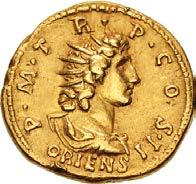

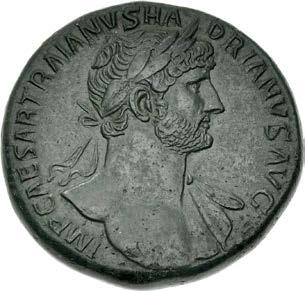
761. Hadrian. AD 117-138. AR Denarius (19mm, 3.39 g, 6h). Rome mint. Struck late AD 121-123. IMP CAESAR TRAIAN HADRIANVS AVG, laureate head right / P M TR P COS III, galley left, in the stern is an arched cabin under a curved apluster, in the bow a mast raking forward with sails attached. RIC II.3 525; Strack105δ; RSC 1174; BMCRE 244. Toned, trace deposits. EF. ($1000)


From the G.W. Trow Collection, purchased from Edward J. Waddell, 8 January 2016. Ex Künker 243 (21 November 2013), lot 4868.
762. Hadrian. AD 117-138. AV Aureus (18mm, 7.25 g, 7h). Rome mint. Struck circa AD 122-123. IMP CAESAR TRAIAN H ADRIANVS AVG, laureate head right / P M TR P COS III, River god (the Tiber, Tyne, Beatis or Euphrates) reclining left, cradling rudder in crook of right arm and testing left elbow on overturned urn, from which water flows. RIC II.3 590; Strack 103; Calicó 1337 (this coin illustrated); cf. BMCRE 132; Adda –; Biaggi –; Jameson –; Mazzini –. In NGC encapsulation 4938386-010, graded AU★, Strike: 5/5, Surface: 4/5, Fine Style. Rare. ($20,000)

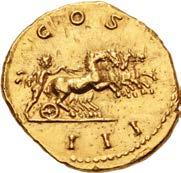
Ex Collection of a Retired Banker (Numismatica Ars Classica 111, 24 September 2018), lot 171; Classical Numismatic Group 82 (16 September 2009), lot 1011; Numismatica Ars Classica 49 (21 October 2008), lot 210; V.J.E. Ryan Collection (Part IV, Glendining, 20 February 1951), lot 1771.
Struck in the midst of Hadrian’s first great journey after becoming emperor, the reverse of this coin clearly depicts a reclining river god of classic type. Which river is represented has been the subject of much speculation and debate. In the 1926 edition of RIC, Mattingly and Sydenham identify the river as the Tiber. Sear, in Roman Coins and Their Values Vol II (Spink, 2002), states “more recent scholarship suggests it is the Tyne (Tinea)” across northern Britannia, which Hadrian visited in AD 122, prior to initiation of the famous wall that bears his name. Richard A. Abdy, in his new edition of RIC II Vol. 3 (Spink, 2019), suggests it is the Euphrates, which Hadrian reached in AD 123 for a summit meeting with the Parthian king, although he also notes Hadrian also traveled on the river Beatis in southern Spain earlier the same year. As Hadrian is recorded to have been present at or near all three rivers during 122-123, and the Tiber is often used to represent Rome itself, it is also possible the reclining figure is left unidentified so as to represent all four
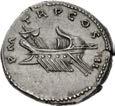

763. Hadrian. AD 117-138. AV Aureus (18.5mm, 7.32 g, 6h). Rome mint. Struck circa AD 124-125. HADRIANVS AVGVSTVS, laureate bust right, slight drapery / COS III, Sol, radiate, naked but for cloak on left arm, holding reins with right hand, and mounting quadriga right. RIC II.3 725 (same dies as illustration); RIC II 167 (same rev. die as illustation); Strack 163α; Calicó 1207 (this coin illustrated); BMCRE 377 (same dies); Biaggi 582 (this coin); Jameson –; Mazzini –. In NGC encapsulation 4938385-014, graded Ch AU, Strike: 5/5, Surface: 2/5, Fine Style, marks. ($10,000)
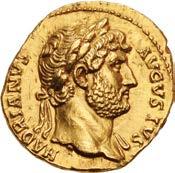




Ex Numismatica Genevensis SA 13 (15 November 2021), lot 26; Jonathan P. Rosen Collection (Triton XXIII, 15 January 2020), lot 727; Numismatica Ars Classica 38 (21 March 2007), lot 57; Conte Alessandro Magnaguti Collection (Part III, Santamaria, 26 June 1950), lot 302; Leo Biaggi de Blasys Collection, 582; M. L. Vierordt Collection (Schulman, 5 March 1923), lot 1293.

764. Hadrian. AD 117-138. Æ As (24.5mm, 9.88 g, 7h). Rome mint (for circulation in Syria). Struck circa AD 124-125. HADRIANVS AVGVSTVS, laureate, draped, and cuirassed bust right, seen from behind / COS III, S C across field, Antioch seated left on rocks, towered and holding grain ears; below, river-god Orontes, swimming left. RIC II.3 750; RPC II 3756; McAlee 544. Dark green patina, earthen deposits, cleaning scratches. VF. ($500)



From the Dr. Michael Slavin Collection, purchased from Freeman & Sear.
765. Hadrian. AD 117-138. Æ Dupondius/As (26.5mm, 11.35 g, 6h). Rome mint. Struck circa AD 129-130. HADRIANVS AVGVSTVS, bareheaded and draped bust right / FELICITATI AVG, S C across field, COS III P P in exergue, galley left with steersman and and five rowers; at stern, acrostolium, arch over steersman, signum and vexillum; at prow, mast slanted forward and sail. RIC II.3 1333; Strack 839; BMCRE 1458 var. (number of rowers). Green-brown patina, smoothing in fields. Near EF. ($1000)
Ex CNG inventory 720852 (June 2000); Leu 77 (11 May 2000), lot 551.
766. Anonymous issues. temp. Hadrian–Antoninus Pius, AD 117-161. Æ Quadrans (15.5mm, 2.15 g, 6h). Rome mint. Draped bust of Annius Verus, as the personification of Summer, right, wearing floral wreath / S • C within wreath. RIC II 34; Van Heesch pl. XXV, 8; Weigel 21; Kestner, Tesseren –. Brown patina. EF. Excellent detail in fine style. ($500)
From the S & S Collection.
Mattingly originally assigned this type to the large number of anonymous quadrantes issued in the general period of the late first and early second centuries. He dismissed the assertion of Cohen, however, who assigned this type to Annius Verus, the deceased twin of the emperor Commodus. The presence of several consistent varieties of this type prompted Van Heesch to retain the Antonine attribution, but to assign these coins instead to personifications of the seasons, representations of the abundance present in Rome’s “Golden Age.”



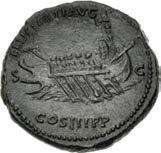


767. Aelius. Caesar, AD 136-138. AV Aureus (17mm, 7.01 g, 6h). Rome mint. Struck under Hadrian, AD 137. L • AELIVS CAESAR, bare head right / TRIB • POT COS II, CONCORD in exergue, Concordia, draped, seated left on throne, holding patera in extended right hand and resting left arm on cornucopia, balanced on side of chair. RIC II.3 2706; Strack 398; Calicó 1444; BMCRE 997; Adda 170; Biaggi 688 (same dies). Scattered marks, scrape on obverse. VF. ($4000)
From the S & S Collection.

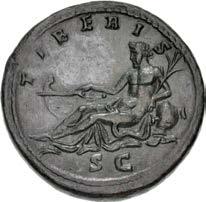
768. Antoninus Pius. AD 138-161. Æ Sestertius (33mm, 23.97 g, 12h). Rome mint. Struck circa AD 141-143. ANTONINVS AVG PI VS P P TR P COS III, laureate head right / TIBERIS, S C in exergue, Tiber reclining left on overturned urn from which water flows, right hand resting on boat, cradling reed in left arm; waves beneath. RIC III 642a; Banti 414 var. (break in obv. legend); BMCRE 1313-4 var. (no waves); Mazzini 819 var. (break in obv. legend). Dark brown surfaces, hints of smoothing, flan flaw, a couple of light scratches on reverse. Near EF. Exceptional strike. ($1500)
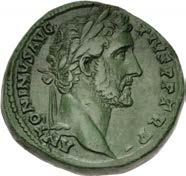
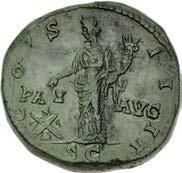
From the DMS Collection, purchased from Harlan J. Berk, January 2003.
Unlike the restless Hadrian, Antoninus never left Italy during his reign and was content to rule from Rome. Stability and equanimity were his watchwords, and his policies kept the Empire on an even keel for 24 years. Although his coinage does refer to other provinces, Italy and Rome predominate, as with this sestertius with an elegant reclining figure representing the River Tiber.





769. Antoninus Pius. AD 138-161. Æ Sestertius (31mm, 26.37 g, 11h). Rome mint. Struck circa AD 145-147. ANTONINVS AVG PIVS P P TR P •, laureate head right / COS II II, PAX AVG across field, S C in exergue, Pax standing left, setting fire to heap of arms at her feet to left and holding cornucopia in left. RIC III –; Strack –; Banti 264 (same rev. die as illustration); BMCRE 1703. Wonderful apple green patina. Good VF. Extremely rare, only the British Museum example noted by Banti and only this example in CoinArchives. ($1500)
Ex Triton X (9 January 2007), lot 633.
770.
469α
771. Diva Faustina Senior. Died AD 140/1. AV Aureus (19mm, 6.98 g, 6h). Rome mint. Struck under Antoninus Pius, circa AD 146-161. DIVA FAV STINA, draped bust right, wearing hair bound in pearls on top of her head / AVG V STA, Venus, draped, standing left, extending right hand and raising hem of skirt with left. RIC III 367; Beckmann dies df8/AG1; Strack 466α; Calicó 1767 (same rev. die as illustration); BMCRE p. 61, note ‡; Biaggi 814 (same rev. die). Lustrous. Choice EF. ($20,000)


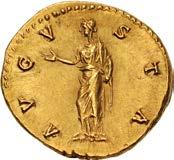
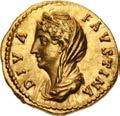
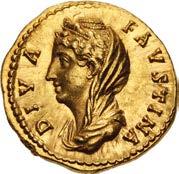



Ex Rauch 106 (10 April 2018), lot 217; Franz Trau Collection (Gilhofer & Ranschburg, 22 May 1935), lot 1574.
772. Diva Faustina Senior. Died AD 140/1. AV Aureus (19mm, 7.31 g, 6h). Rome mint. Struck under Antoninus Pius, circa AD 146-161. DIVA FAVSTINA, veiled and draped bust left, wearing stephane and hair bound in pearls on top of her head / AETER NITAS, Fortuna, draped, standing left, holding patera in extended right hand and rudder in left. RIC III 349a (Pius) var. (bust type); Beckmann dies df62/AC2; Calicó 1745a (same obv. die as illustration); BMCRE –. Lustrous, traces of deposits on reverse. Choice EF. Outstanding portrait of artistic merit struck in high relief. ($20,000)
Ex Numismatica Ars Classica 120 (6 October 2020), lot 785; Egon Beckenbauer Collection (Künker 280, 26 September 2016), lot 627 (front cover coin); Aufhäuser 4 (7 October 1987), lot 311.


773.
From the DMS Collection. Ex CNG inventory 998515 (April 2015); Morton & Eden 72 (15 December 2014), lot 112; Galerie des Monnaies (9 June 1978), lot 1745.
774. Marcus Aurelius & Lucius Verus. AD 161-169. Æ Medallion (40mm, 51.00 g, 12h). Rome mint. Struck AD 161165. IMP ANTONINVS AVG COS III IMP VERVS AVG COS II, confronted bareheaded busts of Marcus Aurelius right and Lucius Verus left, both with slight drapery / Jupiter, half-nude and draped to the waist, seated facing on a high-backed throne, holding a thunderbolt in his right hand and a long scepter in his left; on his left, Juno seated facing holding short scepter with her left hand and offering a patera to Jupiter with her right; on his right, Minerva seated facing, holding scepter with her left hand and raising her right to adjust her helmet. Gnecchi II 7, pl. 71, 5; MIR 18, 1009-2/12-22; Banti 7. Green and red-brown patina, slightly rough surfaces. VF. Extremely rare. An impressive medal showing the Capitoline Triad. ($10,000)
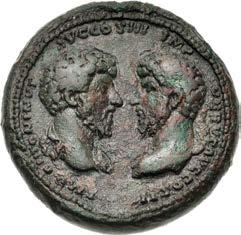


Ex Nomos 23 (30 November 2021), lot 224.
The Capitoline Triad was a group of three deities; namely, Jupiter, Juno, and Minerva. They were worhiped within the Capitolium, the temple on the Capitoline Hill that was devoted to this sacred Triad. Though appearing together infrequently upon Roman coinage, the Triad remained an important part the Roman pantheon and was often celebrated on medallions such as this one, struck jointly by Marcus Aurelius and Lucius Verus, as a handout to loyal officers, dignitaries, and high officials.
775. Marcus Aurelius. AD 161-180. Æ Sestertius (32mm, 28.39 g, 12h). Rome mint. Struck AD 162. IMP CAES M AVREL ANTONINVS AVG P M, laureate and cuirassed bust right / CONCORD AVGVSTOR TR P XVI, S C across field, COS III in exergue, Marcus Aurelius and Lucius Verus, both togate, standing facing each other, clasping right hands and each holding volumen in left. RIC III 824 var. (bust type); MIR 18, 30-6/35; Banti 37; BMCRE 1008 var. (same). Even brown surfaces. Near EF. Rare bust type. Banti records only two examples. ($3000)

From the DMS Collection. Ex CNG inventory 162082 (January 2006); Lanz 125 (28 November 2005), lot 785 (conserved since); P.H. Webb Collection (A. Hess, 9 May 1932), lot 2213.
776. Marcus Aurelius. AD 161-180. AV Aureus (19mm, 7.23 g, 12h). Rome mint. Struck AD 172. M ΛNTONINVS ΛVG TR P XXVI, laureate and draped bust right / IMP VI COS III, Marcus Aurelius, in military dress standing left, holding thunderbolt in right hand and reversed spear in left, being crowned by Victory, draped, to right, advancing left, holding palm frond in left hand; central dot. RIC III 265; MIR 18, 229-2 var. (bust type); Calicó 1872 (same obv. die as illustration); Adda –; Biaggi 856 (same obv. die); BMCRE 566 var. (same); Jameson –; Mazzini 308 (same dies). In NGC encapsulation 3987479003, graded Ch XF★, Strike: 5/5, Surface: 5/5, Fine Style. ($5000)

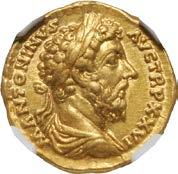
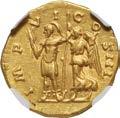







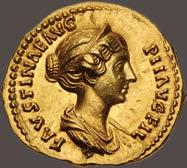
777. Faustina Junior. Augusta, AD 147-175. AV Aureus (20mm, 7.23 g, 6h).
circa AD 147-150. FAVSTINΛE ΛVG PII ΛVG FIL,
mint.
back of head / LAETITIΛE
BLICΛE, Laetitia,
Ex Tkalec (22 April 2007), lot 236 (hammer CHF 18,000).
left,
extended right hand and vertical scepter in left. RIC III 506c (Pius); Beckman, Faustina, Group I (dies fa6/LP2), a (this coin referenced and illustrating dies in plates); Calicó 2069a; BMCRE 1047; Biaggi 933. Lustrous. FDC. Struck with dies of artistic merit, this coin is certainly among the finest, if not the finest known. ($15,000)
Faustina Junior’s coin portraits during her long reign as Augusta show clearly the rapid evolution in Roman feminine hairstyles in the second century AD. On this beautiful aureus struck under her father, Antoninus Pius, she resembles a young lady of the French imperial court of the early 1800s, demonstrating that Napoleon and his advisors were keenly aware of, and imitated, Imperial Roman styles.
778. Lucius Verus. AD 161-169. AV Aureus (20mm, 7.26 g, 6h). Rome mint. Struck AD 161. IMP CΛES L ΛVREL VERVS ΛVG, laureate, draped, and cuirassed bust right / CONCORDIAE AVGVSTOR TRP, COS II in exergue, Marcus Aurelius and Lucius Verus, both togate, standing facing each other, clasping right hands and each holding volumen in left. RIC III –; MIR 18, 15-12/37; Calicó 2114; Biaggi 950 var. (no break in obv. legend); BMCRE p. 391, note 32 (Aurelius and Verus). In NGC encapsulation 3762656-002, graded Ch XF, Strike: 5/5, Surface: 5/5. ($5000)
Ex Classical Numismatic Group 99 (13 May 2015), lot 658.

779. Lucius Verus. AD 161-169. AV Aureus (19mm, 6.64 g, 12h). Rome mint. Struck AD 163. • L • VERVS ΛVG • ΛRMENIΛCVS, laureate and cuirassed bust right / TR P IIII • IMP II COS II, ΛRMEN in exergue, Armenia, wearing cloak and breeches to ankles, and pointed cap, seated left, on ground, in attitude of mourning, propping head on right hand, right elbow bent and resting on right knee, left hand on bow and quiver; to right, behind her, trophy. RIC III 507; MIR 18, 68-12/35; Calicó 2106 (this coin illustrated); BMCRE 297 corr. (bust type); Biaggi 946 (this coin). Toned, some scratches and marks, scrape on obverse. Good VF. ($5000)
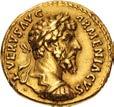
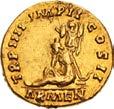
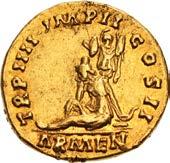
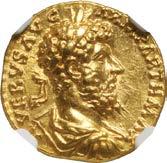
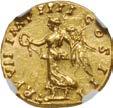
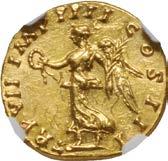

From the S & S Collection. Ex Biaggi de Blasys Collection (1906-1979), 946.
Immediately after Marcus Aurelius and Lucius Verus had been installed as joint emperors, the Parthians tested the new regime by breaking a long-standing peace treaty and invading the buffer state of Armenia in AD 161, ejecting its pro-Roman king. In response, Lucius led a large Roman expeditionary force eastward and launched a counter-offensive, ejecting the Parthians from Armenia in AD 163. This initial Roman victory is celebrated on the reverse of this aureus, which gives Verus the title Armeniacus.
780. Lucius Verus. AD 161-169. AV Aureus (17.5mm, 6.03 g, 11h). Rome mint. Struck AD 167. L VERVS ΛVG ΛRM PΛRTH MΛX, laureate, draped, and cuirassed bust right / TR P VII IMP IIII COS III, Victory advancing left, holding wreath in right hand and holding palm frond in left. RIC III 573 (Aurelius) var. (bust type); MIR 18, 149-12/37; Calicó 2197 (same dies as illustration); Adda –; BMCRE 449 (Aurelius and Verus); Biaggi 970 (same dies); Jameson –; Mazzini –. In NGC encapsulation 3762656-003, graded MS, Strike: 5/5, Surface: 3/5, Fine Style, scuffs. ($7500)
781. Commodus. AD 177-192. Æ Medallion (38mm, 44.61 g, 12h). Rome mint. Struck AD 177-178. L AVREL COMMODVS AVG GERM SARM TR P III, laureate, draped, and cuirassed bust right / IMP II COS P P, VOTΛ PVBLICΛ in exergue, Commodus, togate, sacrificing out of patera over altar to left; to left, victimarius preparing to sacrifice bull, citizen, tibicen playing tibia, and child; four citizens to right, behind Commodus; hexastyle temple in background. Gnecchi II 166, pl. 89, 2 (same dies as illustration); MIR 18, 1076/11-37; Banti 502. Brown surfaces. VF. ($3000)

Apart from normal coinage intended for general commerce, Roman emperors struck large medallions intended as special handouts to highranking government and military officials on important occasions, often to mark the beginning of a new year. Commodus was particularly prolific in the striking of large and impressive bronze medallions, this splendid piece included. The obverse depicts the young Commodus, coruler with his father Marcus Aurelius, in the military role of Imperator, wearing a general’s cuirass and cloak. The occasion is his acclamation as Imperator for the second time, no doubt won during the course of his father’s wars against the German tribes. The reverse shows him in civilian mode as Pontifex Maximus, high priest, wearing his toga of office and performing a sacrifice to undertake his “public vows” (VOTA PVBLICA).

782. Commodus. AD 177-192. AV Aureus (20.5mm, 7.35 g, 12h). Rome mint. Struck AD 178. L AVREL COM MODVS AVG, laureate, draped, and cuirassed bust right / TR P III IMP II COS P P, Castor standing left, holding horse by its bridle with right hand and cradling reversed spear in left. RIC III 648 (Aurelius); MIR 18, 420-12/37 (same obv. die as illustration); Calicó 2337 (this coin illustrated); BMCRE 774-5 (Aurelius and Commodus); Adda 372; Biaggi 1014 var. (same); Mazzini 760 var. (bust type). Fully lustrous, miniscule metal flaw on obverse, scratch on reverse. EF. Struck from artistic dies. ($20,000)
From the Willamette Valley Collection. Ex Long Valley River Collection (Roma XX, 29 October 2020), lot 619; John Whitney Walter Collection (Stack’s, 29 November 1990), lot 54; Superior (7 June 1987), lot 4522; Numismatic Fine Arts XVI (2 December 1985), lot 482; Leu 36 (7 May 1985), lot 284.
This coin was struck in the second year of Commodus’ reign when he was still a young man. Interestingly, the reverse legend proclaims that the young emperor already possessed an impressive résumé and litany of honorifics: thrice had he held tribunician powers, was twice imperator, once consul, and most outlandishly, was already pater patriae–the father of the state. This was an honorific title offered to emperors; however, it was considered customary and idoneous to defer the title until one had achieved one’s own magna facta. The young, vain, and ambitious Commodus, however, seemingly had no such compunctions about deferring the use of the title. Rather, he readily accepted and adopted its usage and immediately had it applied to his coinage, such as on this early specimen.





Commodus had furthermore only been elevated to Augustus the year prior in addition to being made consul (the youngest in Roman history at that time). This followed his previous station as Caesar, which he had received at the young age of five. The coin’s reverse showcases Castor as the patron and protector of the young emperor in his station as princeps iuventutis. This itself was a high honor conferred upon the heir apparent to the throne and was bestowed on Commodus three years before in AD 175. It would perhaps not be unfair to perceive that despite his father’s reputation for reason, Commodus had himself not been tempered in his appetites and excesses, but rather, indulgent. The large assortment of honors that Commodus held at a young age likely did little to moderate him and perhaps helped pave the way to his future megalomania.

Cassius Dio records a serious uprising in Britannia just before or after the death of Marcus Aurelius
the
a
general (possibly
784. Pertinax. AD 193. AV Aureus (21mm, 7.35 g, 12h). Rome mint. 2nd emission. IMP CAES P HELV PERTIN • AVG, laureate head right / PROVID DEOR COS II, Providentia, draped, standing left, holding up right hand toward small star, left hand on breast. RIC IV 11a; Lempereur Type 10, 120a (D31/R79 – this coin); Calicó 2389 (same dies as illustration); BMCRE 11 var. (size of star); Adda 381; Biaggi 1045; Jameson –; Mazzini –. Well struck and lustrous. In NGC encapsulation 4938352005, graded Ch AU, Strike: 5/5, Surface: 4/5. ($50,000)
Ex Numismatica Genevensis SA 10 (3 December 2018), lot 53; “Imagines Imperatorium” Collection (Aureo & Calicó 241, 8 February 2012), lot 135; Sotheby’s (12 February 1969), lot 29.
If AD 69 is known as “The Year of the Four Emperors,” then AD 193 should be called “The Year of the Five Emperors.” On 31 December AD 192, the maniacal emperor Commodus was assassinated. The plotters appear to have predesignated the aged Helvetius Pertinax as the successor of Commodus, a decision that was likely influenced by two prominent Romans: Claudius Pompeianus, a patron of Pertinax and second husband of Lucilla, and Flavius Sulpicianus, an ex-consul who was Pertinax’s father-in-law. Pertinax had followed a long and winding path to the imperial throne. His father was a former slave who upon freedom became a successful wool merchant. With his wealth, he was able to have his son educated, and Pertinax became a grammaticus. In AD 161, he left his teaching position, opting instead for a military career and greater pay. Once there, he quickly distinguished himself and was rapidly promoted from commander of a cohort to military tribune, then to consul, and eventually to proconsul in several provinces, including Upper and Lower Moesia, Dacia, Syria, Britain, and Africa. During his tenure in the army and as proconsul he acquired a reputation for probity and severity, which led on occasion to mutinies, one of which almost cost him his life. In AD 189, Commodus appointed him urban prefect of Rome, and from this position he was offered the throne upon the death of Commodus on 31 December AD 192. Unfortunately, the strict measures Pertinax instituted to reform the government and military antagonized important factions, and the emperor was assassinated by disgruntled Praetorians on 28 March AD 193, after a reign of only 87 days. After the death of Pertinax, there was no clear successor to the throne. Two prominent Romans, the aforementioned Flavius Sulpicianus, and Didius Julianus, a senator and perhaps the wealthiest man in Rome, approached the Praetorians and made a bid for their support as the new emperor. Legend has it that the Praetorians compelled the two men to make competing bids in an auction-for-empire. While it was conventional for new emperors to distribute a sum of cash to the Praetorians upon their accession to the throne, such bidding for power was an affront to conservative Romans. Didius Julianus made the higher offer, and was given the support of the Praetorians, who presented him to a Senate that was obliged to confirm their choice. At the same time, the new emperor’s wife, Manlia Scantilla, and daughter, Didia Clara, were given the rank of Augusta. Clara was then given in marriage to Cornelius Repentinus, who was presumably Julianus’ candidate for successor. The reaction to the situation in Rome precipitated the acclamation of three provincial governors by their troops, each to the throne: Clodius Albinus, governor of Britain; Septimius Severus, governor of Upper Pannonia; and Pescennius Niger, governor of Syria. Severus was the closest of all three, and a little more than two months after Julianus’ elevation, marched on Rome at the head of his legions. In light of Severus’ imminent arrival, on 1 June AD 193, the Praetorians quickly shifted their allegiance and murdered Julianus. When the new emperor took possession of the capital he granted an interview to Scantilla and Clara, and agreed to their request that the remains of the late emperor should be deposited in his family tomb. Both were stripped of their imperial rank and Clara lost her inheritance. They retired into private life and nothing further is known of them. Before his arrival in Rome, Severus had already begun preparing to deal with Albinus and Niger. He offered Albinus the rank of Caesar and heir to the throne should Albinus join him. Sensing his own tenuous position, Albinus prudently threw his support behind the much-stronger Severus by accepting the latter’s offer, and the two shared the consulship in AD 194. Once Severus secured his position in Rome, he deployed an army east to deal with Niger. A series of battles ensued between the two, with each one slowly eroding Niger’s legions and support. Eventually, faced with certain defeat, Niger attempted to flee to Parthia, but his plan failed, and he was captured and executed along with his entire family. The alliance between Severus and Albinus was short-lived. In AD 196, while Severus was away in the east fighting Pescennius Niger, he learned of Albinus’ proclamation of himself as emperor. Severus responded by declaring Albinus a public enemy, and, in turn, appointed his eight-year-old son, Caracalla, to the rank of Caesar. Rallying his troops in Britain to begin a march on Rome, Albinus and his army were stalled in Gaul. A battle between Albinus and Severus occurred near Lugdunum (Lyon) on 19 February AD 197. After making initial gains, Albinus’s army was routed, and he committed suicide when he became trapped in a house near the Rhône. Now, Septimius Severus became sole emperor of Rome.

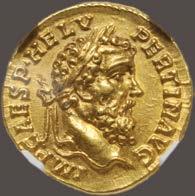


785. Pertinax. AD 193. AV Aureus (19mm, 7.19 g, 6h). Rome mint. 2nd emission. IMP CAES P HELV PERTIN AVG, laureate head right / PROVID DEOR COS II, Providentia, draped, standing left, raising right hand toward large star high at left, left hand on breast. RIC IV 11b; Lempereur Type 10, 150a (D40/R92 – this coin); Calicó 2389a; BMCRE 12; Biaggi 1045 var. (size of star); Jameson –; Mazzini 39 var. (two hands towards star); cf. Woodward, Pertinax pl. 10, 5 (same obv. die). In NGC encapsulation 5783263-001, graded XF, Strike: 5/5, Surface: 2/5, scratch, ex-jewelry. ($15,000) Ex Numismatica Ars Classica 33 (6 April 2006), lot 516.
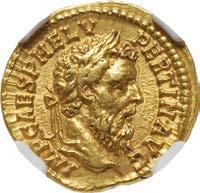
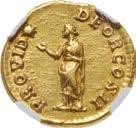
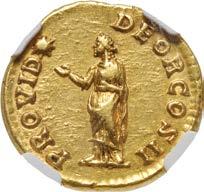



786. Pertinax.
From
787.
Gnecchi II, 16 (pl. 94, 7); Banti 51; Cohen 152; Grueber 3; Froehner p. 153. Attractive dark green and brown patina, some minor roughness. Good VF. Extremely rare and impressive. ($20,000)
Ex Triton XX (10 January 2017), lot 786; Gorny & Mosch 232 (5 October 2015), lot 456.
Although Septimius Severus is often described as first of the “soldier emperors,” his early career was almost entirely civilian, rising steadily through the ladder of Roman magistracies, much like his predecessors. Nevertheless, his reign proved a major step in militarizing Roman government and life. He entered the Senate in AD 173 and gained some early military experience as legionary officer in Africa and Syria, where he served under the later Emperor Pertinax. After reaching the Consulship in AD 190, he was appointed as governor of Pannonia Superior, which placed him in command of Legio XIV Gemina Martia Victrix, strategically located within easy march of Italy and Rome. With the assassination of Commodus in AD 193, followed within weeks by the murder of his mentor Pertinax, Severus was hailed as emperor by the XIVth at Carnuntum. A lightning march to Rome deposed the pathetic Didius Julianus and placed Severus in firm control of the capital, whereupon he immediately prepared for civil war against two rivals who had likewise been proclaimed in the provinces, Clodius Albinus and Pescinnius Niger. Though wealthy and connected, Severus was from a “new” family and relied heavily on the army to cement his power. He raised military pay and showed his troops many preferments, including ending the longtime ban on marriage for regular soldiers. The army began to think of him as one of their own and, after disposing of Niger and Albinus, he suffered no revolts or serious internal threats for the rest of his reign. This remarkable bronze medallion, struck in AD 194 for presentation to a senior officer, depicts Severus being hailed as Imperator (victorious general) by his soldiers. Behind him stand his sons, Caracalla and Geta, whom he told on his deathbed, “get along with one another, enrich the soldiers, and despise everyone else!”
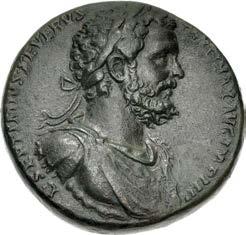

788. Septimius Severus, with Caracalla and Geta as Caesar. AD 193-211. AV Aureus (21mm, 7.26 g, 7h). Dynastic issue. Rome mint. Struck AD 201. SEVERVS PIVS AVG P M TR P VIIII, laureate head of Severus right / AETERNIT IMPERI, confronted busts of Caracalla, laureate, draped, and cuirassed right, and Geta, bareheaded, draped, and cuirassed left. RIC IV 174; Calicó 2602; BMCRE 254; Adda 404; Biaggi 1129; Jameson –; Mazzini –. In NGC encapsulation 4938352008, graded Ch AU, Strike: 5/5, Surface: 3/5, scuffs. Very rare. ($20,000)
Ex Peus 417 (2 November 2016), lot 408; 1909 Getrudenstraße Hoard, no. 1503.
The Gertrudenstraße Hoard of approximately 22,500 gold and silver coins, ranging from Claudius to Maximinus I, was found in 1909 during excavation work for the construction of a house on Gertrudenstraße, approximately midway between Wolfstraße and Neumarkt in Cologne, Germany. Many of the coins from this hoard exhibit a distinctive coloration similar to that of the Boscoreale Hoard, derived from the decomposition of the original container.
789. Septimius Severus. AD 193-211. AV Aureus (21mm, 7.24 g, 12h). Rome mint. Struck AD 207. SEVERVS PIVS AVG, laureate head right / P M TR P XV COSIII P P, distyle temple; within, Aesculapius standing facing between two serpents erect, holding a serpent-entwined wand. RIC IV 205; Calicó 2511 (same dies as illustration); BMCRE p. 262, note †; Biaggi 1094 (same dies). Underlying luster, shallow scratches. Good VF. Extremely rare. Only one example in CoinArchives. ($30,000)

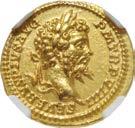
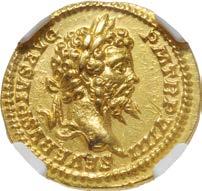

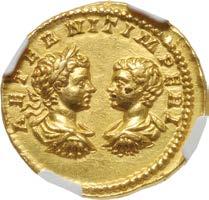
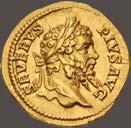
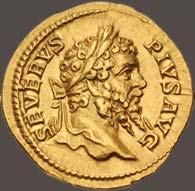

Aesculapius, the god of healing, is depicted in his temple, which was located on Tiber Island in Rome. Built circa 290 BC, according to legend the location was marked by a snake that slithered out of a ship and into a grotto on the island, indicating the god’s favor. Remains of the temple can still be seen on the island today. The Severans all counted Aesculapius among their patron deities and featured him on their coinage.

790. Septimius Severus. AD 193-211. AV Aureus (20mm, 7.06 g, 6h). Rome mint. Struck AD 209. SEVERVS PIVS AVG, laureate head right / CONCORDIA AVGVSTORVM, Caracalla and Geta, both laureate and togate, standing facing one another, each holding a volumen in left hand, supporting between them on their right hands a globe surmounted by Victory. RIC IV 255; Calicó 2435 (same rev. die as illustration); BMCRE 312; Biaggi 1064 (same rev. die); Triton XVI, lot 1103 (same obv. die). Lustrous, minor die rust, tiny mark on reverse, a few edge nicks. EF. ($15,000)
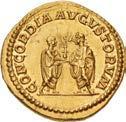
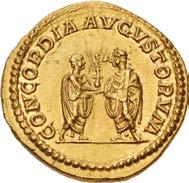
791. Septimius Severus. AD 193-211. AV Aureus (20mm, 7.53 g, 6h). Rome mint. Struck AD 209. SEVERVS PIVS AVG, laureate head right / LI BERA LITAS, AVGG VI in exergue, distribution scene: Geta, Septimius Severus, and Caracalla seated left on curule chairs on platform; to right stands a lictor, to left stands Liberalitas, holding abacus in right hand and cornucopia in left; to left, citizen, togate, mounting steps of platform, holding out fold of toga with both hands. RIC IV 279 (same rev. die as illustration); Calicó 2481a (same rev. die as illustration); BMCRE 352 (same rev. die); Biaggi 1080 (same rev. die); Mazzini 300 v. (same rev. die). A few edge marks, traces of deposits. EF. Rare. ($15,000)


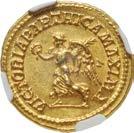

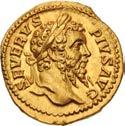

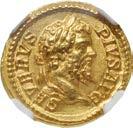
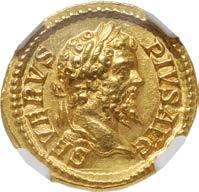
Ex Numismatica Ars Classica 106 (9 May 2018), lot 990.

The scene in which the emperor makes liberal distributions to citizens is known as a congiarium. This distribution can be thought of as an ancient version of the modern “stimulus check,” as recently offered by the U.S. government in the form of pandemic relief. The occasion was the acclamation of the second son of Severus, Geta, as co-Augustus with his father and brother, for the first time giving the Roman Empire three supposedly co-equal rulers and making the platform set up for the distribution rather crowded.
792.
4938386-019, graded AU, Strike: 5/5, Surface: 5/5. ($10,000)
793. Caracalla. AD 198-217. Æ Sestertius (32mm, 29.06 g, 6h). Rome mint. Struck under Septimius Severus, AD 210. M AVREL ANTONI NVS PIVS AVG, laureate bust right, slight drapery / PONTIF TRP X III COS III, SC across field, Mars advancing left, holding olive branch in outstretched right hand and cradling trophy in left arm. RIC IV 450b; Banti 87; BMCRE 203; SCBC –. impressive hard brown patina, hairline flan crack, double strike on reverse. Near EF ($3000)
Ex Triton XXII (8 January 2019), lot 1127; Distinguished Collection of Roman Bronze Coins (Dix, Noonan, Webb 139, 15 February 2017), lot 147 (hammer £5000); A. Hess [230] (28 April 1936), lot 1553.
This sestertius celebrates the Severan campaign in Britain circa AD 208-211, the last Roman attempt to conquer Caledonia, now called Scotland, thereby controlling the entire island. Septimius Severus mounted the expedition in mid AD 208, hoping for a quick victory to crown his later years, and also to curb the ferocious sibling hatred of his sons, Caracalla and Geta, who accompanied him. Caracalla took the opportunity to play common soldier and ingratiate himself with the legions, while Geta took an administrative role in York. But what was supposed to be an easy conquest turned into a long, bitter slog, which took its toll on the emperor’s health and intensified the brothers’ mutual hatred. Severus died at York on 4 February AD 211. Caracalla and Geta quickly abandoned Scotland, declared victory, and returned to Rome.

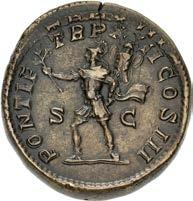

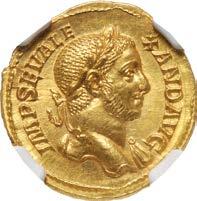

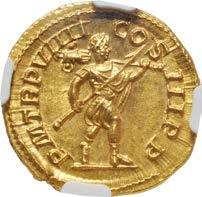

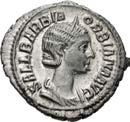
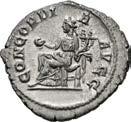
794.
222-235.
795.
796. Maximinus I. AD 235-238. AR Denarius (19.5mm, 2.79 g, 6h). Rome mint. 2nd emission, AD 236. IMP MAXIMINVS PIVS AVG, laureate, draped, and cuirassed bust right / SALVS AVGVSTI, Salus enthroned left, feeding from patera held in her right hand a snake coiled around an altar, resting her left arm on armrest. RIC IV 14; BMCRE 99; RSC 85a. Lustrous, bold portrait. EF. ($750)
From the DFA Collection.
797. Gordian I. AD 238. AR Denarius (20mm, 3.21 g, 12h). Rome mint. Struck 1-22 April. IMP M ANT GORDIANVS AFR AVG, laureate, draped, and cuirassed bust right / P M T R P COS P P, Gordian I, togate, standing left, holding up branch in right hand and wearing parazonium. RIC IV 1; BMCRE 1-3; RSC 2. Lightly toned. Good VF. ($3000)


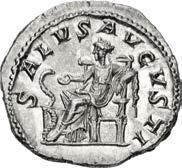

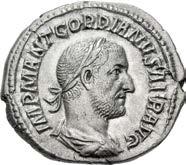

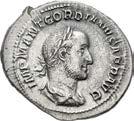
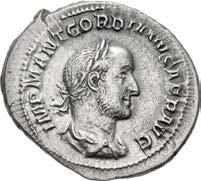

From the S & S Collection.
798. Gordian II. AD 238. AR Denarius (21mm, 3.10 g, 6h). Rome mint. Struck 1-22 April. IMP M ANT GORDIANVS AFR AVG, laureate, draped, and cuirassed bust right / VICTORIA AVGG, Victory, draped, advancing left, holding up wreath in right hand and palm frond, sloped up to right, on left shoulder in left hand. RIC IV 2; BMCRE 28; RSC 12. Toned, light scratches, deposits. Good VF. ($3000)
From the S & S Collection.
799. Balbinus. AD 238. Æ Sestertius (31mm, 19.53 g, 12h). Rome mint. 1st emission. IMP CAES D CAEL BALBINVS AVG, laureate, draped, and cuirassed bust right / P M TR P COS II P P, Balbinus, togate, standing left, holding branch in right hand and parazonium in left. RIC IV 16; BMCRE 28; Banti 7. Brown patina. Good VF. Well centered. ($3000)

Ex Classical Numismatic Group 87 (18 May 2011), lot 1055.

800. Gordian III. AD 238-244. AV Aureus (19mm, 4.97 g, 12h). Rome mint, 1st officina. 8th-11th emissions, AD 240-243. IMP GORDIANVS PIVS FEL AVG, laureate, draped, and cuirassed bust right / AETER NITATI AVG, Sol, radiate, standing facing, head left, raising right hand and holding globe in left. RIC IV 97; Calicó 3186 (same dies as illustration); Adda 467; Biaggi 1352; Hunter –; Jameson –. In NGC encapsulation 6066349-061, graded MS, Strike: 5/5, Surface: 4/5. ($7500)
Ex Triton XXV (11 January 2022), lot 969; Stack’s Bowers Galleries (16 August 2021), lot 43134; Paramount Collection (Heritage 3096, 25 March 2021), lot 30061.
801. Philip I. AD 244-249. AV Aureus (20mm, 4.26 g, 5h). Rome mint. 1st emission, AD 244. IMP M IVL PHILIPPVS AVG, laureate, draped, and cuirassed bust right / FIDES MILIT, Fides standing left, holding vertical scepter in right hand and transverse signum in left. RIC IV –; Bland, Gold 1 (dies PI –/Fides 01[unlisted obv. die]); Calicó –; Adda –; Hunter –; Biaggi –; Jameson –. In NGC encapsulation 6057674-001, graded Ch XF, Strike: 5/5, Surface: 2/5, brushed. Extremely rare; only two other examples were cited by Bland. This is apparently the third known. ($10,000)
802. Philip I. AD 244-249. AV Aureus (19.5mm, 4.62 g, 5h). Rome mint, 5th officina. 5th emission, AD 246. IMP M IVL PHILIPPVS AVG, laureate, draped, and cuirassed bust right / ANNONA AVGG, Annona, draped, standing left, holding cornucopia in left hand and grain ears in right over modius filled with grain ears set on ground to left. RIC IV 28a; Bland, Gold –; Calicó 3246; Hunter –; Adda 482; Biaggi 1378; Jameson 233. In NGC encapsulation 4938386-024, graded Ch AU, Strike: 5/5, Surface: 3/5. Very rare. An excellent example, among the finest known. ($10,000)






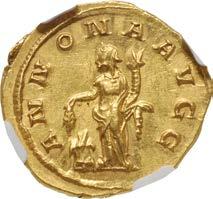
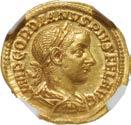
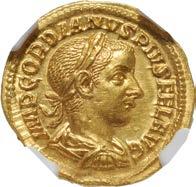

Ex Numismatica Genevensis SA 13 (15 November 2021), lot 65; Numismatica Genevensis SA 10 (3 December 2018); Numismatica Ars Classica 99 (29 May 2017), lot 26; Numismatica Genevensis SA 4 (11 December 2006), lot 216; Tkalec (18 February 2002), lot 225.

803. Pacatian. Usurper, circa AD 248-249. AR Antoninianus (20.5mm, 4.19 g, 7h). Viminacium mint. 1st emission. IMP TI CL MAR PACATIAN[VS AVG], radiate, draped, and cuirassed bust right / FORTVNA REDVX, Fortuna seated left on wheel, holding rudder in right hand and cornucopia in left. RIC IV 4; Szaivert, Beginn 3; RSC 5; Hunter 1. Typical rough surfaces, deposits. Near VF. ($2000)
From the S & S Collection.
Very little is known of the usurper Tiberius Claudius Marinus Pacatianus, who seized power in Upper Moesia in AD 248. Most of our information about Pacatian comes from his coinage. Viminacium is the most probable site for his mint, and a comparison with the local bronze coinage shows remarkable similarity of style. Seven different reverses were used on the antoniniani of Pacatian -- Concordia, Felicitas, Fides, Fortuna, Pax, Roma and Victory -- all common themes in the third century. Such a variety of reverse types would suggest a large issue of coins, though today all coins of Pacatian are very rare, with only about 100 specimens of all varieties known.
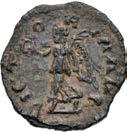

804. Jotapian. Usurper, circa AD 248-249. Antoninianus (21.5mm, 3.04 g, 12h). Nicopolis in Seleucia mint. IM C M F R IOTAPIANVS A, radiate and cuirassed bust right / VICT OR I A AV G, Victory, winged, draped, advancing left, holding wreath in right hand and palm frond in left. RIC IV 2a var. (obv. legend); Bland 13a/5a (Obv. die VII/Rev. die iv); RSC 1a var. (same). Brown surfaces, thick encrustation on obverse, flan crack. Near VF. ($7500)
Ex Classical Numismatic Group 112 (11 September 2019), lot 654.
Jotapian led a short-lived revolt in Syria in the autumn of AD 249 while Philip I was still emperor. Little is known of Jotapian’s background. It was said that he boasted of a relationship to Severus Alexander, and his unusual name, although otherwise unknown for a man, is attested in its feminine form “Jotape” in the royal houses of Commagene and Emesa. The revolt was brief, and the crude style proves that the revolt was geographically confined, for Jotapian plainly did not control a major Roman mint. His head was brought to Rome and shown to Trajan Decius “as was customary, although Decius had not asked for it” (Aur. Vict., Caes. 29.4).


805. Jotapian. Usurper, circa AD 248-249. Antoninianus (20mm, 2.84 g, 12h). Nicopolis in Seleucia mint. IM C M F R IOTAPIANVS AV, radiate and cuirassed bust right / VICT O R IA AV G, Victory, winged, draped, advancing left, holding wreath in right hand and palm frond in left. RIC IV 2b var. (obv. legend); Bland 9 (Obv. die IV/Rev. die vi); RSC 1b var. (same). Dark gray patina, typical rough surfaces, earthen deposits. Near VF. ($5000)

From the S & S Collection. Ex CNG inventory 718419 (January 2000).

806. Trajan Decius. AD 249-251. Æ Double Sestertius (36.5mm, 47.64 g, 11h). Rome mint, 5th officina. 2nd-3rd emissions, late AD 249-mid 250. IMP C M Q TRAIANVS DECIVS AVG, radiate and cuirassed bust right / VICTORIA AVG, S C across field, Victory advancing left, holding wreath in right hand and palm frond in left. RIC IV 126a; Banti 29; Gnecchi III, 6. Dark green patina, areas of roughness, some minor marks, some deposits. Good VF. Rare. ($3000)

From the DMS Collection, purchased from Jonathan K. Kern, 2012. Ex Gemini I (11 January 2005), lot 424.
An attractive and overweight specimen. Bastien recorded a number of Trajan Decius double sestertii and their weights in 1967. Of those listed, only one is heavier than the present example. None of the examples in Coin Archives are heavier than this impressive coin.
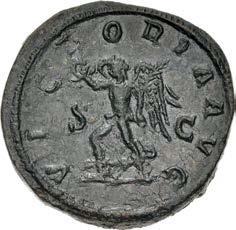
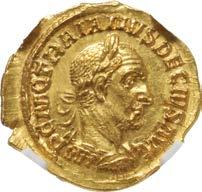
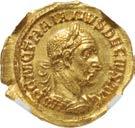
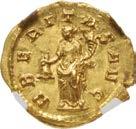
807. Trajan Decius. AD 249-251. AV Aureus (19.5mm, 3.87 g, 12h). Rome mint, 5th officina. 4th emission, mid-late AD 251. IMP C M Q TRAIANVS DECIVS AVG, laureate, draped, and cuirassed bust right / VBERITAS AVG, Uberitas, draped, standing left, holding purse in right hand and cornucopia in left. RIC IV 28a; Calicó 3299; Adda 489; Biaggi 1397; Hunter 19; Jameson –. Lustrous. In NGC encapsulation 6327124-001, graded MS, Strike: 5/5, Surface: 4/5. Rare. ($7500)
Ex Rauch 99 (8 December 2015), lot 239; Triton XV (3 January 2012), lot 1549.
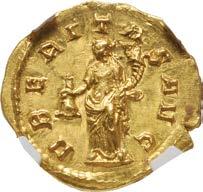



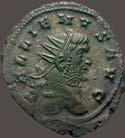







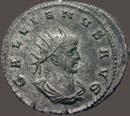

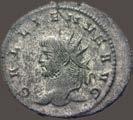
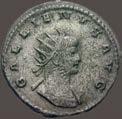

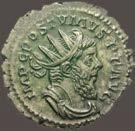


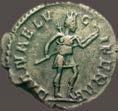

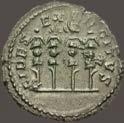

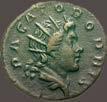



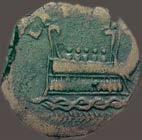







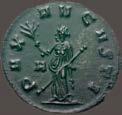

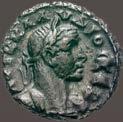


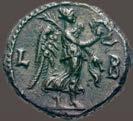






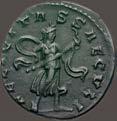

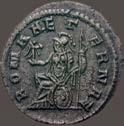













The present selection of the now well-known A.K. Collection offers 385 silver and bronze coins of the mid-third century AD. The first two lots feature coins of Gallienus and his family, focusing on the mints of Siscia, Cyzicus, Samosata, and Antioch. Western mint issues of Gallienus were sold in the three previous Triton sales.
These are followed by parallel offerings of the “separatist empires” in Gaul and the east, together with the “Recovery of the Empire” under Claudius II Gothicus. Included in this offering are bronze and silver coins of Claudius and Postumus in three lots of antoniniani (see lots 818820). Issues of the other Romano-Gallic emperors (Aureolus, Marius, Victorinus and Tetricus ) will be offered next January in Triton XXVII.
The present portion of the A.K. Collection begins with three lots of silver coins: (808) antoniniani of Gallienus and Salonina from the mints of Siscia, Cyzicus and Samosata; (809) antoniniani of Gallienus and Salonina from the mint of Antioch; and (810) antoniniani of Postumus from different mints. Please note, that we are here following the order of Cunetio and that we are not following the order of Schulzki, but instead the corrections of M. Weder.
Additional lots follow: (811) Imperial and imitation radiate bronze coins of Postumus; (812) a particularly massive lot of antoniniani of Claudius Gothicus from the mints of Milan and Rome; (813) Alexandrian coins of Claudius Gothicus; and finally (814) irregular, hybrid, plated, and unusable coins of Gallienus and Postumus.
Some of the coins are illustrated in various publications and/or are extremely rare as noted in the descriptions, and a few are published in the famous books like G. Dattari, Monete Imperiali Greche. Numi Augg. Alexandrini (Cairo, 1901) or Pflaum H.G. – P. Bastien, La Trouvaille de Canakkale, Deniers et antoniniani émis de 261 à 284 (Wetteren, 1969). Most of the pieces are pedigreed: some from auctions (G. Hirsch Munich, K. Kress, Muenchner Muenzhandlung, Naville Lucerne) and some from Fixed Price Lists (E. Beckenbauer Munich, H.H. Kricheldorf Stuttgart, F. Jacquier Kehl). Many also come from the stock of such notable dealers as Bankhaus Leu Zurich, Münzen und Medaillen AG, Pilartz Cologne, Sternberg Zurich, and more. The quality of the coins ranges from Fine to Extremely Fine and includes pieces from significant collections, including those of Dattari, Naegeli, Perron, Rosche, and Weder.
A separate, fully illustrated catalogue of the complete collection has been compiled, containing the photos and full description of all the coins in each lot. This catalogue will be available during the Triton lot viewing in New York, but you may also request that a catalogue be sent to you. Additionally, this catalogue will be available online (see individual lots below for details).
808. Collection of 50 antoniniani of Gallienus and Salonina. AD 253-268. Siscia, Cyzicus, and Samosata mints. Includes the following: Gallienus (45 coins) // Salonina (5 coins). Fifty (50) coins in lot. Fine to good VF. Photos and detailed descriptions available online, at http://ak.cngcoins.com ($1000)
From the A.K. Collection.
809. Collection of 88 antoniniani of Gallienus and Salonina. AD 253-268. Antioch mint. Includes the following: Gallienus (77 coins) // Salonina (11 coins). Fine to good VF. Photos and detailed descriptions available online, at http:// ak.cngcoins.com. ($1500)
From the A.K. Collection.
810. Collection of 60 antoniniani of Postumus. Romano-Gallic Emperor, AD 260-269. Treveri (Trier), Colonia Agrippensis (Cologne), and Milan mints. Lot also includes one coin of Aureolus. Sixty (60) coins in lot. Fine to good VF. Photos and detailed descriptions available online, at http://ak.cngcoins.com ($1000)
From the A.K. Collection.
811. Collection of 11 radiate bronzes of Postumus. Romano-Gallic Emperor, AD 260-269. Official and unofficial mints. Several contemporary imitations included, including smaller module (dupondii). Eleven (11) coins in lot. Fine to VF. Photos and detailed descriptions available online, at http://ak.cngcoins.com. ($500)
From the A.K. Collection.
812. Collection of 121 antoniniani of Claudius Gothicus. AD 268-270. Mediolanum (Milan) and Rome mints. Milan (5 coins) // Rome (116 coins). One hundred twenty-one (121) coins in lot. Fine to good VF. Photos and detailed descriptions available online, at http://ak.cngcoins.com ($1500)
From the A.K. Collection.
813. Collection of 25 tetradrachms from Alexandria of Claudius Gothicus. AD 268-270. . Year 1 (7 coins) // Year 2 (15 coins) // Year 3 (3 coins). Twenty-five (25) coins in lot. Near VF to good VF. Photos and detailed descriptions available online, at http://ak.cngcoins.com ($500)
From the A.K. Collection.
814. Collection of 28 unusual, irregular, hybrid, or plated coins of Gallienus and Postumus. AD 253-269. Gallienus (2 coins) // Postumus (26 coins). Twenty-eight (28) coins in lot. Near VF to good VF. Photos and detailed descriptions available online, at http://ak.cngcoins.com. ($300)
From the A.K. Collection.
815. Volusian. AD 251-253. AV Binio (23mm, 5.39 g, 6h). Rome mint, 3rd officina. 4th emission, early AD 253. IMP C AE C VIB VOLVSIANO AVG, radiate, draped, and cuirassed bust right / PIETAS AVGG, Pietas, veiled, standing left, raising both hands; lighted and garlanded altar to left. RIC IV 151 (same dies as illustration); Calicó 3365 (same dies as illustration); Biaggi –. Lustrous, scratches in fields. EF. Rare. ($20,000)
Ex Numismatica Genevensis SA 13 (15 November 2021), lot 70; Numismatica Ars Classica 100 (29 May 2017), lot 578; Triton VII (12 January 2004), lot 1020.
Double aurei or biniones, distinguished by a radiate crown, were first introduced by Caracalla as part of the extensive monetary reform in AD 215. At that time, the weight standard of the aureus was reduced to about 6.54 g at 50 to the pound. Within a two decades, the weight of the aureus had dropped precipitously as the supply of precious metal diminished and inflation took hold. Although struck on a broad flan and superficially impressive, this binio of Volusian, struck early AD 253, weighs only 5.39 grams, far less than a single aureus under Caracalla. Such sleight-of-hand could not have gone unnoticed by the primary recipients of these coins, the soldiers, who by this time were quite willing to switch loyalty to whomever promised to pay them the most.





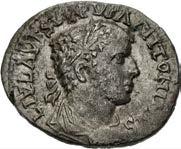
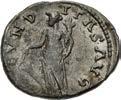
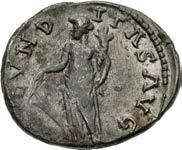
From the S & S
Baldus
two
817. Macrianus. Usurper, AD 260-261. Antoninianus (21mm, 4.07 g, 6h). Samosata mint. 2nd emission. IMP C FVL MACRIANVS P F AVG, radiate and cuirassed bust right / SOL INVICTO, Sol standing left, right hand raised and holding globe in left; *|–//–. RIC V 12 (Antioch); MIR 44, 1741k; RSC 12a. Silvered, minor roughness, traces of deposit. EF. Rare in this condition. ($1000)

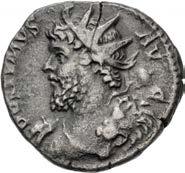

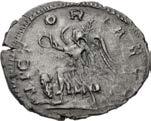





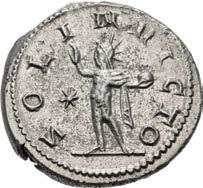
818. Postumus. Romano-Gallic Emperor, AD 260-269. AR Antoninianus (24mm, 2.63 g, 5h). Treveri (Trier) mint (“Mint I”). 1st emission, AD 260. IMP C M CASS LAT POSTIM[VVS P F AVG], radiate, draped and cuirassed bust right / VICT OR IA AVG, Victory advancing left, holding palm in left hand and wreath in right hand; captive at feet. RIC –; Mairat –; AGK 97b corr. (POSTVMVS); RSC –. Deeply toned, minor flan crack. VF. Very rare. ($250)
From the A.K. Collection. Ex M. Weder Collection; deaccessioned from the British Museum Collection; F.W. Hasluck Bequest 1920.
819. Postumus. Romano-Gallic Emperor, AD 260-269. AR Antoninianus (19.5mm, 3.64 g, 12h). Treveri (Trier) mint (“Mint I”). 5th emission, AD 268. POSTVMVS A VG, radiate bust left, draped with lion’s skin and holding club over shoulder / IOVI S TATORI, Jupiter standing facing, head right, holding long scepter in right hand and thunderbolt cradled in left arm. RIC V 310; Mairat –; AGK 38b; RSC 160. Toned, minor porosity, flan crack. Near VF. Very rare. ($500)
From the A.K. Collection. Ex M. Weder Collection; Prince Waldeck Collection (Münzhandlung Basel 8, 23 March 1937), lot 1980.
820. Postumus. Romano-Gallic Emperor, AD 260-269. AR Antoninianus (21mm, 3.54 g, 7h). Treveri (Trier) mint (“Mint I”). 5th emission, AD 268. IMP C POSTVMVS P F AVG, radiate, draped, and cuirassed bust right / RESTITVTOR GA LLIAR, Postumus standing left, holding scepter in left hand, right foot on seated captive, raising figure of Gallia kneeling to right, wearing mural crown and holding cornucopia. RIC V 82; Mairat –; AGK 74; RSC 319. Deeply toned, small flan flaw on reverse. Near EF. Very rare. ($500)
From the A.K. Collection, purchased from Münzen und Medaillen AG, 1970.








821. Postumus. Romano-Gallic Emperor, AD 260-269. AV Aureus (21mm, 4.92 g, 6h). Colonia Agrippinensis (Cologne) mint (“Mint II”). Struck winter AD 263-264. POSTVMVS PIVS AVG, laureate head right / INDVLG PIA POSTVMI AVG, Postumus, laureate and togate, seated left on sella curulis, extending right hand and holding short scepter in left; at feet to left, captive kneeling right, raising hands in supplication. RIC V 276; Schulte Group 6b, 92 (Av59/Rv63); Sondermann 6b.9; Calicó 3737; Biaggi 1518; Mazzini 145 (same dies). A few minor marks, traces of deposits, hairline flan crack. Good VF. Rare. ($15,000)
Ex Elsen 147 (4 June 2021), lot 580.
The coinage of Postumus is of far higher quality, both in artistry and precious metal content, than coins struck by the “legitimate” regime of Gallienus. This attractive gold aureus, struck at Cologne, is roughly a third heavier than its Rome-mint counterparts. The amazingly lifelike portrait depicts Postumus as a heavily bearded and jovial character, resembling his chosen protector, the demigod Hercules.

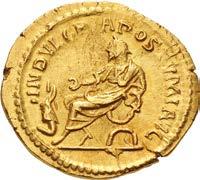
From the S & S Collection.
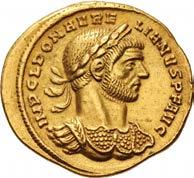

823. Zenobia. Usurper, AD 268-272. Antoninianus (21mm, 2.88 g, 6h). Antioch mint, 8th officina. 2nd emission, MarchMay AD 272. S ZЄNOBIA AVG, draped bust right, wearing stephane, set on crescent / IVNO RЄGINA, Juno standing left, holding patera in right hand and scepter in left; at feet to left, peacock standing left, head right; *|–//H. RIC V Online 3129; RIC V 2; Bland, Coinage 30e (dies 50/Jun v); BN 288-9. Dark brown patina. Good VF. ($10,000)

From the S & S Collection.
Septimia Zenobia was the second wife of Odenathus, the hereditary nas (lord) of Palmyra, a wealthy caravan city in eastern Syria. As the Roman Empire crumbled under a torrent of calamities after AD 260, Odenathus undertook to defend Syria against the Sasanian Persians, ostensibly as viceroy of the Roman emperor Gallienus. Odenathus and his eldest son were assassinated in AD 267, after which Zenobia seized power as queen regent for their younger son, the 10-year-old Vabalathus. In late AD 270, Zenobia sent the Palmyran army to secure control of greater Syria and Egypt, bringing the mints of Antioch and Alexandria under her control. Coins were struck depicting Vabalathus, with the titles Vir Clarissimus, Rex, Imperator, Dux Romanorum, paired with the current Emperor Aurelian, who was styled Imperator Caesar Augustus. It is uncertain whether Aurelian ever granted the tacit recognition this coinage implies, but by AD 272 he had clearly decided to suppress the Palmyran regime. Zenobia reacted by having Vabalathus proclaimed Augustus and herself took the title of Augusta, or empress. Zenobia appears on this antoninianus of Antioch with the same trappings as previous Roman empresses, a helmet-like coif of hair adorned with a simple headpiece called a stephane. The reverse depicts a Roman goddess, Juno Regina (”Queen Juno”), perhaps as an avatar for her own claimed authority. As it happened, Aurelian’s forces rapidly reclaimed Zenobia’s conquests, defeated her army outside of Palmyra, and captured her as she attempted flight to Persia. Her coinage in Antioch only lasted two or three months at most, accounting for its rarity today.
From the Dr. Michael Slavin Collection. Ex Classical Numismatic Group 49 (17 March 1999), lot 1733.
By the mid to late 3rd century, the larger demand for coinage along with increased military presence and activity in the provinces necessitated the opening of several new mints outside Italy, including that of Siscia. While numismatically important, these cities left little trace on the designs of the coins they minted. This elusive type has a civic design more in line with provincial issues, thus making it an outlier among imperial issues.




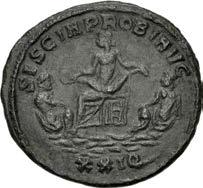
825. Probus. AD 276-282. Aureus (21mm, 6.26 g, 12h). Siscia mint. 5th emission, AD 278. IMP C PROB


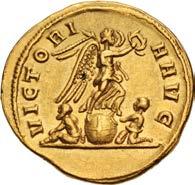
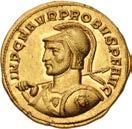


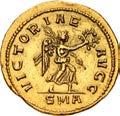
PIVS F AVG, laureate, draped, and cuirassed bust right / VICTORI A AVG, Victory standing right on globe, holding wreath in right hand and palm frond in left hand over left shoulder; to left, captive seated left, to right, captive kneeling left. RIC V 599 var. (bust type); Pink VI/1, p. 52; Calicó 4214 var. (same); Biaggi 1641 var. (same). Shallow scratch on obverse, minor deposit on reverse. Good VF. Apparently an unpublished bust type with the cuirass. ($10,000)
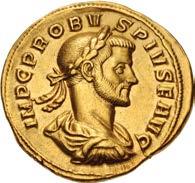
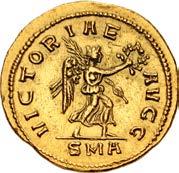
826.
rare.
Ex Numismatica Ars Classica 120 (6 October 2020), lot 826.



Marcus Aurelius Probus was one of a series of tough Balkan military men who rescued the Roman Empire from certain destruction in the late third century. He was the son of a peasant gardener who entered the army as a teenager and rose steadily through the ranks. By AD 276, he had achieved command of the Roman field armies in Syria and Egypt and was well-positioned to seize the throne when the elderly emperor Tacitus died. His reign was one of constant, frenetic military activity, racing from one frontier to the other to confront and defeat enemy invaders or internal usurpers. This is reflected on his coinage, including this superb aureus, depicting him in full military gear on the obverse and driving a triumphal quadriga on the reverse, presaging his well-deserved triumph in Rome in AD 281.
827. Carinus. As Caesar, AD 282-283. AV Aureus (19mm, 4.33 g, 12h). Antioch mint, 1st officina. 1st emission, February AD 283. IMP C M AVR CARINVS NOB C, laureate and cuirassed bust right / VICTORIAE AVGG, Victory advancing right, holding wreath in outstretched right hand and palm frond over left shoulder; SMA. RIC –; Pink VI/2 p. 55; Calicó 4393b (this coin illustrated); Biaggi 1677 var. (bust). Lightly toned and attractive, faint scratches on obverse. Near EF. Very rare. ($10,000)
Ex Trausnitz Collection (Nomos 19, 17 November 2019), lot 340; Numismatica Ars Classica 24 (5 December 2002), lot 227; Numismatica Ars Classica 8 (3 April 1995), lot 925.
828. Julian of Pannonia. Usurper, AD 284-285. Antoninianus (21mm, 3.77 g, 12h). Siscia mint, 2nd officina. Struck December AD 284. IMP C M AVR IVLIANVS P F AVG, laureate, draped, and cuirassed bust right / FELICIT AS TEMPORVM, Felicitas standing left, holding caduceus in right hand and scepter in left; S|B//XXI. RIC V 2; Pink VI/2, p. 49; Venèra 4398. Toned silvering, deposits. Good VF. ($2000)

From the S & S Collection.
Marcus Aurelius Sabinus Iulianus was a corrector in Northern Italy under Carus. In AD 284, during the struggles surrounding the succession between Carinus and Diocletian, Julian usurped imperial authority in Pannonia for a brief period and began issuing coins from Siscia. Carinus marched from his base in Britain to deal with the usurpation, dispatching Julianus early in AD 285 near Verona.


829. Diocletian. AD 284-305. AV Aureus (18mm, 5.09 g, 6h). Treveri (Trier) mint. Struck AD 303. DIOCLETI ANVS P AVG, laureate head right / IOVI CONSERVAT AVGG ET CAES NN, Jupiter seated left, holding thunderbolt in right hand and scepter in left; TR. RIC VI 52; Depeyrot 10B/1 (same dies as illustration); Calicó 4478 (this coin illustrated); Biaggi 1712 (this coin). A few scratches and some faint hairlines. Good VF. ($15,000)
Ex Numismatica Ars Classica 34 (21 November 2006), lot 201; Leo Biaggi de Blasys Collection.


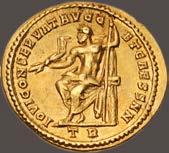

830. Diocletian. AD 284-305. AV Medallion of Ten Aurei (38mm, 53.65 g, 12h). Aquileia mint. Struck AD 294. IMP C G VAL DIOCLETIANVS P F AVG, bare head right / IOVI CONSER VATORI, Jupiter, naked to the waist, with himation over knees, seated left on ornate throne, holding thunderbolt in right hand and vertical scepter in left; to left, eagle standing left, head right, holding wreath in beak; AQ in exergue. Cf. Gnecchi I 5, pl. 4, 12 (Alexandria mint); cf. RIC VI 1 (Alexandria mint); cf. Lukanc p. 125, 2 (Alexandria mint); cf. Cohen 264 (Alexandria mint). Lustrous with just a hint of minor staining, slight die shift on reverse. In NGC encapsulation 5872664-001 graded Ch AU★, Strike: 5/5, Surface: 5/5, Fine Style. Of the highest rarity, the only denio offered at public auction since 1922. ($500,000)
Equivalent to ten gold aurei, this magnificent medallion of Diocletian ranks among the largest denomination Roman Imperial gold medallions in existence and is a masterpiece of late classical portraiture. A gold multiple of this size and artistry, termed a denio in numismatic circles, represented vast wealth at the time of issue and must have been created for a special occasion. Before we examine the possible reasons for its striking, let us briefly review the extraordinary career and historical importance of the man it celebrates.
Although he attained the purple via the brutal path of coup and civil war, Gaius Valerius Diocletianus turned out to be a far-sighted statesman whose reforms and innovations shaped the world of Late Antiquity. Seizing power at a time of anarchy in AD 284, he arrived with a detailed blueprint for Roman revival. Recognizing that the task of governing the Empire had grown too great for one man, in AD 286 he divided supreme power with his old military colleague, Maximian, whom he named joint Augustus and placed in charge of the western provinces. In 293, this collegiate rule was expanded with two other loyal officers, Constantius and Galerius, who were each given the junior title of Caesar. All four rulers of this newly minted “Tetrarchy” took charge of their territorial spheres and cooperated fully. By AD 300, the revolts and barbarian invasions that nearly destroyed the Roman Empire in previous decades had been defeated and the frontiers restored, allowing Roman civil and economic life to recover.
Among his most urgent priorities was reform of the Roman finances and the coinage. Decades of chaos and hyperinflation had witnessed the disappearance of the old silver and bronze denominations, while the gold aureus, so vital for paying the army, had fluctuated wildly in weight. By AD 286, Diocletian and Maximian had stabilized the gold aureus at about 5.4 grams, or 60 to the Roman pound. In AD 294, a whole new set of denominations were introduced and new mints opened, including one at the northern Italian city of Aquileia, to accommodate the new flood of coinage.
Thus the year AD 294 represented a threefold occasion for celebration by the increasingly confident regime: the tenth anniversary (decennalia) of Diocletian’s reign, the enlargement of the Dyarchy into a Tetrarchy, and the full implementation of a new system of coinage. Here, then, is the historical context for the striking of this highly impressive denio, no doubt intended as a handout to a military officer of high rank. The decennalia in particular was notable: no emperor since the revolt-plagued Gallienus (AD 253-268) had held the throne so long. Indeed, the subtext of “ten aurei for a decade of rule” would have been readily apparent to the recipient.
The task of creating dies for such an impressive medallion was bestowed on an experienced engraver of singular talent. The portrait, while reflecting some of the stylized Tetrarchic artistic conventions of the time, is still highly individualistic and conveys Diocletian’s dominating personality, particularly in the pursed lips and piercing gaze. His military origins are revealed in his close-cropped haircut and trim beard. Remarkably, the head of Diocletian is shown plain and unadorned without a laurel wreath, cuirass, cloak or other symbol of rank. The reverse depicts Diocletian’s patron god, Jupiter, half-draped and clutching a thunderbolt, enthroned in a three-quarter frontal pose reminiscent of Alexander the Great’s coinage six centuries before. An eagle, symbol of Rome’s legions, stands at his feet, clutching the laurel wreath of victory. The legend IOVI CONSERVATORI (”to Jupiter the Protector”) reflects the chief god’s role as guardian of the regime. The letters A Q in the exergue show the mint to be the newly opened one at Aquileia; perhaps this medallion was among the first pieces struck there.
At just under 54 grams, this unique piece is among the weightiest Roman gold medallions on record. At least four other ten aurei medallions of Diocletian by himself are recorded, all in museum collections. Two other examples of the same types and similar weight, but struck at the Alexandria mint, are recorded by Gnecchi; in Paris and Berlin respectively. Another, from the Nicomedia mint, has the same legends but a standing figure of Jupiter and a more “Tetrarchic”style head; this piece presently resides in the British Museum collection. All of these are dated to AD 294. At least eight denio medallions representing the Tetrarchs singly and in groups were found in the Arras (Beaurains) Treasure of 1922; several were sold privately at the time and most, if not all, are currently in institutional collections.
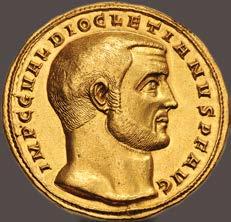
The present example is the only known Tetrarchic gold multiple from the Aquileia mint, and the only denio to be offered for sale at public auction in over a hundred years. It thus presents a unique opportunity to acquire the largest Roman gold coin currently available, from a momentous time in history.

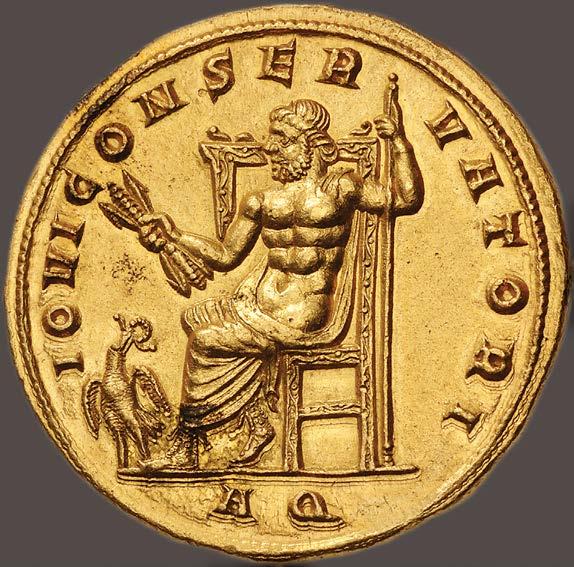
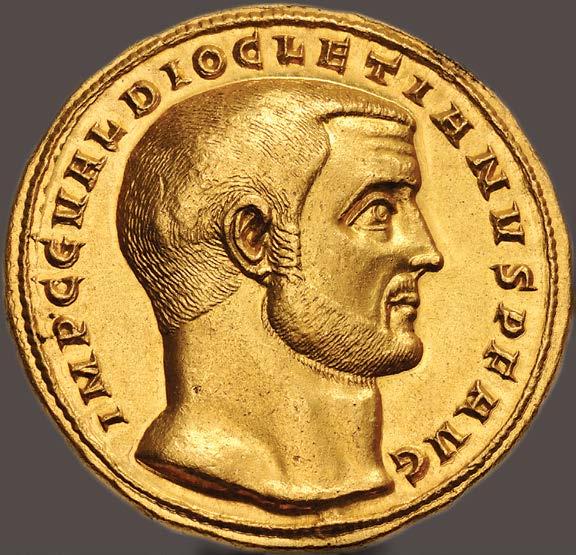
831. Diocletian. AD 284-305. AV Aureus (18mm, 5.31 g, 12h). Nicomedia mint. Struck AD 294. DIOCLETIA NVS P F AVG, laureate head right / IOVI CONSE RVΛTORI, Jupiter standing left, holding thunderbolt in right hand and scepter in left; SMN. RIC VI 5a; Depeyrot 2/4; Calicó 4506; Biaggi 1716 (same dies). Lustrous. NGC photo certificate 6556306-002, graded AU, Strike: 5/5, Surface: 4/5. ($5000)
832. Diocletian. AD 284-305. AV Aureus (19.5mm, 5.39 g, 12h). Uncertain (Cyzicus or Antioch) mint. Struck AD 293. DIOCLETIANVS AVGVSTVS, laureate head left / CONCORDI AE AVGG NN, Diocletian and Maximian seated left on curule chairs, each holding globe in right hand and parazonium with left, being crowned by Victory above. RIC V 313 (Antioch); Lukanc p. 126, 10 (Cyzicus) and p. 153, 5 (Antioch); Pink, Goldprägung, p. 43 (Cyzicus); Depeyrot 13/2 (Cyzicus); Calicó 4429; Biaggi 1694. NGC photo certificate 6556306-005, graded AU, Strike: 5/5, Surface: 4/5. ($7500)
833. Diocletian. AD 284-305. AV Aureus (20mm, 4.67 g, 12h). Antioch mint. Struck AD 284. IMP C C VAL DIOCLETIANVS P F AVG, laureate, draped, and cuirassed bust right / VICTO RI A AVG, Victory advancing right, holding wreath in outstretched right hand and palm frond over left shoulder, small circle in lower right field; SMA. RIC V 320; Depeyrot 1/2; Calicó 4570; Biaggi 1742. Light scuffs on reverse and edge, some residual luster. Near EF. ($3000)

834. Diocletian. AD 284-305. AV Aureus (20mm, 5.28 g, 11h). Antioch mint. Struck AD 290. DIOCLETIANVS AVGVSTVS, laureate head right / CONSVL IIII P P PROCOS, Diocletian, laureate and togate, standing left, holding globe in right hand; -|Σ//SMA. RIC V 307; Depeyrot 7/1; Calicó 4436; Biaggi –; Mazzini 46; Roma XXII, lot 858 (same rev. die). Lustrous, shallow scratch on reverse. NGC photo certificate 6556306-003, graded Ch AU, Strike: 5/5, Surface: 4/5. Rare. ($5000)







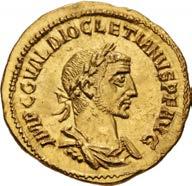






835. Diocletian. AD 284-305. AV Aureus (20mm, 5.35 g, 12h). Alexandria mint. Struck AD 298. DIOCLETI ANVS AVG, laureate head right / IOVI CO N SER AVςς (sic), Jupiter standing left, holding thunderbolt in right hand and vertical scepter in left; at feet to left, eagle standing left, head right, holding wreath in beak; –|*//ALE. VanHorn Emission 5; RIC VI 4; Lukanc p. 146, 55; Depeyrot 6/1; Calicó 4454 var. (no star). NGC photo certificate 6556306-004, graded Ch AU, Strike: 5/5, Surface: 4/5. Very rare. ($5000)

836. Diocletian. AD 284-305. AV Aureus (18mm, 5.41 g, 11h). Alexandria mint. Struck AD 298. DIOCLET IANVS AVG, laureate head right / IOVI CO N SER AVςς (sic), Jupiter standing left, holding thunderbolt in right hand and vertical scepter in left; at feet to left, eagle standing left, head right, holding wreath in beak; -|*//ALE. VanHorn Emission 5; RIC VI 4 var. (obv. legend break); Lukanc p. 135, 2; Depeyrot 6/1 var. (same); Calicó 4454 var. (no star). Underlying luster. Wonderful high relief portrait. In NGC encapsulation 6556106-004, graded MS, Strike: 5/5, Surface: 4/5, scratch. Very rare, only two in CoinArchives. ($5000)
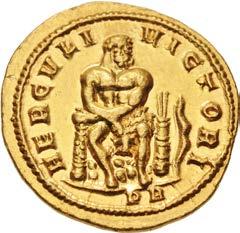
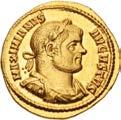
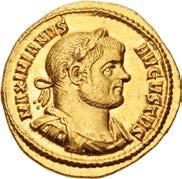


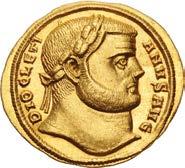


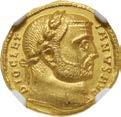

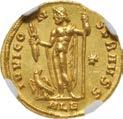
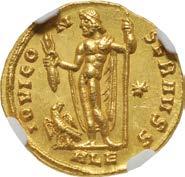
837.
4682 (same obv. die as illustration). Lustrous. NGC photo certificate 6556306-001, graded AU, Strike: 5/5, Surface: 3/5, banker’s mark. Rare. ($15,000)
838. Maximianus. First reign, AD 286-305. AV Quinarius – Half-Aureus (15mm, 3.40 g, 6h). Rome mint. Struck circa AD 296-299. IMP MAXIMIANVS P F AVG, laureate, draped, and cuirassed bust right / VIRTV S AVGG, Hercules standing right, right hand behind back and holding club set on rock and lion skin in left hand; PR. RIC –; Depeyrot –; Calicó –. Lustrous, some faint hairlines. EF. Extremely rare. ($30,000)


The gold quinarius, or half-aureus, was struck only on special occasions, likely for handouts to the public during an imperial visit or procession, much as Maundy Money is employed by modern British monarchs. Hence they are all extremely rare, particularly in the Tetrarchic period.

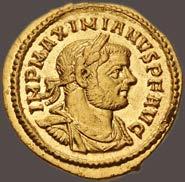






839. Maximianus. First reign, AD 286-305. AV Aureus (19mm, 5.30 g, 6h). Alexandria mint. Struck circa AD 294-296. MAXIMI ANVS AVG, laureate head right / HERCVLI C ON A Vςς (sic), Hercules standing facing, head left, holding club set on ground in right hand, and golden apples of the Hesperides in left hand, lion skin draped over left shoulder; *|–//ALE. Cf. RIC VI 3; cf. Depeyrot 5/2; cf. Calicó 4646; Adda 543; Biaggi 1782 var. (placement of star); cf. Jameson 322. Lustrous. NGC photo certificate 6556306-008, graded Ch AU★, Strike: 5/5, Surface: 4/5. Very rare. ($10,000)
840.
From the Joshua Lee Collection.
($1000)
841. Constantius I. As Caesar, AD 293-305. AV Aureus (18.5mm, 5.06 g, 6h). Treveri (Trier) mint. 1st emission, autumn AD 293-early 294. CONSTA NTIVS N C, laureate head right / IOVI CONS ERVATORI, Jupiter enthroned left, holding thunderbolt in outstretched right hand and scepter in left; at feet to left, eagle standing left, head and tail right, with wings displayed, holding wreath in beak; PTR. RIC VI –; Zanchi & Estiot 14a (CCL 2/ R 6 – this coin, illustrated); Depeyrot –; Calicó 4847a (this coin illustrated). Lustrous, a few faint hairlines/scratches. Superb EF. The only example in CoinArchives. Apparently unique. ($15,000)

Ex Numismatica Ars Classica 24 (5 December 2002), lot 250; Tkalec (25 October 1996), lot 270.


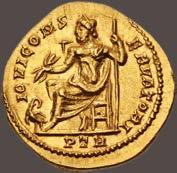
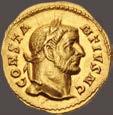
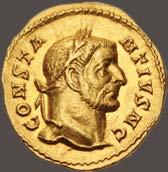
842. Constantius I. As Caesar, AD 293-305. AV Aureus (18mm, 5.29 g, 12h). Treveri (Trier) mint. 2nd emission, early AD 294. CONSTA NTIVS N C, laureate head right / VIRTVS AVGG, Hercules kneeling upon the lowered hind quarters of the Ceryneian Hind, which stands right, and holding animal by antlers with both hands; TR. RIC VI 85; Zanchi & Estiot 31 (CCL 6/R 15); Depeyrot 3A/3; Calicó 4878 (R5). NGC photo certificate 6556306-007, graded AU★, Strike: 5/5, Surface: 4/5. So rare that Calicó only has a line drawing, rather than a photo, of this type. Zanchi & Estiot knew of three other examples from this die pairing. ($10,000)


Hercules, made temporarily insane by the goddess Hera, murdered his wife and children. Once recovered, and distressed by his actions, Hercules consulted the Delphic Oracle to find a means of expiating his sin. As a punishment, Apollo replied that the hero would have to serve his cousin Eurystheus, the king of Tiryns, a man whom Hercules despised, for a period of twelve years. Because Eurystheus also hated Hercules, he devised a series of ten feats of such difficulty that they would be either insurmountable, or Hercules would die in the attempt. Because Hercules received assistance in completing two of the tasks, Eurystheus added two more. Each Labor became more fantastic, and eventually Hercules was compelled to break the bonds of the supernatural in order to complete his task. Once he accomplished the Labors, Hercules was absolved of his guilt, and proceeded to perform many other heroic feats.
Angered to find that Hercules had successfully completed the previous two Labors, Eurystheus ordered him to capture the Ceryneian Hind, a creature sacred to Artemis that was renowned for its incredible speed. The king hoped that Hercules, by capturing this animal, would incur the wrath of that goddess. Since it could elude even the swiftest arrow, Hercules devised a cunning plan. He chased it across the earth for a whole year, and when it stopped to drink, Hercules rendered it lame by shooting it with one of his few unpoisoned arrows. Another version of the story relates that he captured the animal when it was unable to run any farther. As he was returning to Mycenae, Hercules encountered Artemis and Apollo. He begged the goddess for forgiveness, explaining that he had to catch it as part of his punishment, but he promised to return it. Artemis forgave him, foiling Eurystheus’ plan. However, Eurystheus was not to be undone. Wishing to include the Hind in his menagerie, he ordered Hercules to release it to him. Since he had promised Artemis to return the Hind to her, Hercules devised a strategem: he agreed to hand the Hind over on the condition that Eurystheus himself came out and took it from him. The King came out, but the moment Hercules let the Hind go, it sprinted away. Hercules answered that Eurystheus had not been quick enough.
843. Constantius I. As Caesar, AD 293-305. AV Aureus (18mm, 5.38 g, 6h). Rome mint. Struck AD 294. D N CONSTA NTIO CAES, laureate head right / PRINCIPI IVVENTVT, Constantius I, in military attire, standing right, holding transverse spear in right hand and globe in left; PRON. RIC –; Depeyrot 9/10 var. (rev. legend); Calicó –; Biaggi –; The New York Sale XXXII, lot 51 (same rev. die). Lustrous. NGC photo certificate 6556306-006, graded Ch AU, Strike: 5/5, Surface: 4/5. Extremely rare. ($10,000)

844. Constantius I. As Caesar, AD 293-305. AV Aureus (18mm, 5.55 g, 5ah). Carthago (Carthage) mint. Struck AD 297-298. CONSTAN TIVS CAES, laureate head right / FELIX AD V ENT AVGG NN, Africa, wearing long drapery, wearing elephant-skin headdress, standing facing, head left, holding signum in right hand and elephant tusk in left; at feet to left, lion with captured bull; PK. RIC VI 2a (same dies as illustration); Depeyrot 1/2; Calicó 4825; Franz Trau Collection (Gilhofer & Ranschburg), lot 3536 (same dies). Lustrous. NGC photo certificate 6556307-002, graded MS★, Strike: 5/5, Surface: 4/5. Extremely rare, such that the type is illustrated in Calicó by only a line drawing. ($10,000)
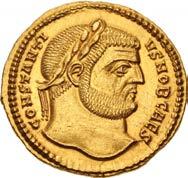
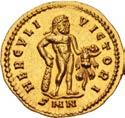

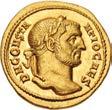

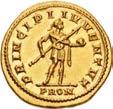




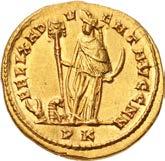
Although Carthage had been destroyed following the Third Punic War (149-146 BC), by the first century BC, a new city had been built upon its ruins. In later centuries, Carthage became the third most populous city of the Empire and a major exporter of grain to Rome. During the Tetrarchy, a confederation of Moorish tribes threatened to overrun Roman Africa, drawing a quick response from Maximianus, who moved a substantial army to Carthage and campaigned for over a year to defeat them. The presence of so many soldiers required the opening of a mint to pay them, and the first coins of the Carthage mint are dated to AD 296. This extremely rare aureus, struck in the name of the western Caesar Constantius I Chlorus, depicts the personified province of Africa on the reverse, wearing a distinctive elephant-skin headdress. The lion subduing a bull at her feet surely represents Rome defeating the Moors.
The
846. Constantius I. As Caesar, AD 293-305. AV Aureus (19.5mm, 5.36 g, 6h). Cyzicus mint. Struck AD 294. CONSTAN TIVS NOB C, laureate head right / FIDES M I LITVM, Fides standing facing, head right, holding signum in each hand. RIC VI 1; Depeyrot 15/1; Calicó 4826 (same dies as illustration); Biaggi 1847 (same dies). Lustrous. NGC photo certificate 6556306-010, graded Ch AU★, Strike: 5/5, Surface: 4/5. Very rare. ($5000)
847. Constantius I. As Caesar, AD 293-305. AV Aureus (19mm, 5.34 g, 5h). Antioch mint. Struck AD 299. CONSTANTI VS NOB CAES, laureate head right / HERCVLI CONS CAES, Hercules standing facing, head left, holding club set on ground in right hand and holding golden apples of the Hesperides and lion skin in left; *|–//SMAΣ*. RIC VI 24; Depeyrot 16/3; Calicó 4834 var. (break in obv. legend); Biaggi 1830 var. (same); Tkalec (28 February 2007), lot 97 (same rev. die). NGC photo certificate 6556306-009, graded AU, Strike: 5/5, Surface: 4/5. Very rare. ($7500)
848. Constantius I. AD 305-306.
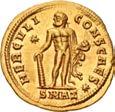
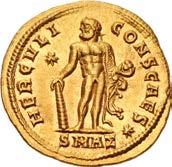


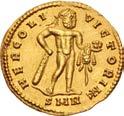


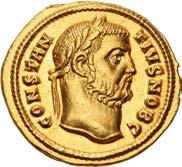




(20mm, 5.33 g, 5h).
mint. Struck AD 305. CONSTANTI VS AVGVSTVS, laureate head right / HERCOLI VICTORI 1, Hercules standing right, holding club in right hand and holding lion skin and golden apples of the Hesperides in left; SMN. RIC VI 32 var. (rev. legend); Depeyrot 9/1 var. (same); Calicó 4845 (this coin illustrated). Light marks, small area of skilled edge repair. Near EF. Bold portrait, and with an interesting engraving error of HERCOLI in the legend instead of HERCVLI. ($5000)
From the Willamette Valley Collection.
849. Galerius. As Caesar, AD 293-305. AV Aureus (17.5mm, 5.44 g, 6h). Treveri (Trier) mint. Struck AD 303. MAXIMI ANVS NOB C, laureate head right / IOVI CONSERVAT AVGG ET CAES NN, Jupiter seated left, holding thunderbolt in right hand and scepter in left; TR. RIC VI 53; Depeyrot 10B/3 (same dies as illustration); Calicó 4914 (same dies as illustration); Biaggi 1859 (same dies); Mazzini 121 (this coin). A few faint scratches. EF. Rare. ($10,000)
Ex Numismatica Ars Classica 46 (2 April 2008), lot 695; Giuseppe Mazzini Collection (publ. 1957).



850. Galerius. As Caesar, AD 293-305. AR Argenteus (18mm, 2.78 g, 6h). Ticinum mint. 1st emission, 2nd series, AD 294-295. MAXIMIAN VS CAESAR, laureate head right / VICTORIA SARMAT, four tetrarchs sacrificing over tripod before city enclosure with six turrets. RIC VI 17b; Gautier, Argent 12; RSC 208c. Attractive iridescent toning. EF. ($750)

From the G.W. Trow Collection. Ex Roma XX (29 October 2020), lot 683; ArtCoins Roma 19 (11 November 2015), lot 770.

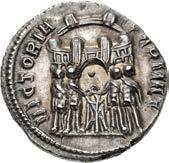
851. Galerius. As Caesar, AD 293-305. AV Aureus (18mm, 5.32 g, 6h). Rome mint. Struck AD 294-299. MAXIMIA NVS CAES, laureate head right / PROVIDE NTIA AVGG, city gate, open archway, three forward turrets; behind, two small turrets between two towers; PR. RIC VI 6b; Depeyrot 12A/4; Calicó 4945. NGC photo certificate 6556307-003, graded Ch




AU★, Strike: 5/5, Surface: 5/5. Very rare. ($7500)

852. Martinian. Usurper, AD 324. Æ Follis (20mm, 2.47 g, 5h). Nicomedia mint, 3rd officina. D N M MARTINIANVS P F AVG, radiate, draped, and cuirassed bust right / IOVI CONS ERVATORI, Jupiter, naked except for cloak over left shoulder, standing left, holding Victory on globe in right hand and eagle-tipped scepter in left; to left, eagle standing left, head right, holding wreath in its beak; to right, bound captive seated right; X/IIn//SMNΓ. RIC VII 45; Hunter 1 var. (officina). Green and brown patina, light roughness. Near VF. Very rare. ($2000)
From the S & S Collection.
Proof that history does repeat itself can be found in the sad tale of Martinian, a puppet ruler installed by the Eastern Roman Emperor Licinius in the midst of his second civil war against Constantine I “the Great.” Martinian was of obscure origins, but by the mid AD 320s he had risen to become the chief minister of Licinius, just as it became apparent that a final clash with Constantine was imminent. Though Licinius had a bigger army, Constantine was much the better general and inflicted a heavy defeat on his rival in Thrace on July 3, AD 324. Crossing to Chalcedon, Licinius declared Constantine deposed and raised Martinian to the office of Augustus, with instructions to prevent Constantine from crossing into Asia Minor. Constantine easily evaded Martinian’s blocking force, landed in Asia and cornered Licinius at Nicomedia. Having no choice, Licinius surrendered on terms brokered by his wife (and Constantine’s sister) Constantia. Martinian went into exile in Cappadocia, but was executed a few months later when Licinius was detected plotting a return to power. Seven years before, under virtually identical circumstances, Licinius had appointed Valerius Valens to a similar role, with almost identical results.
Like those of Valerius Valens, coins of Martinian are quite rare and limited to a single issue from the mint of Nicomedia. The reverse evokes “Jupiter the Protector,” Licinius’ patron deity, who notably failed to protect him and Martinian from the wrath of Constantine and his Christian god.


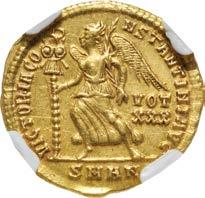
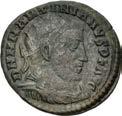





853. Constantine I. AD 307/310-337. AV Solidus (19.5mm, 4.47 g, 6h). Tricennalia issue. Antioch mint. Struck AD 335-336. CONSTANTI NVS MAX AVG, rosette-diademed, draped, and cuirassed bust right / VICTORIA CO NSTANTINI AVG; VOT/XXX in two lines in right field; SMAN in exergue, Victory advancing
with right hand and cradling palm frond with left arm. RIC VII 96; Depeyrot 46/1; Biaggi 2013; Mazzini –; Jameson –; Adda 598. In NGC encapsulation 6557028-003, graded AU, Strike: 5/5, Surface: 3/5, marks. ($10,000)
854.
Ex
November 1925), lot 181.
855. Constantius II. AD 337-361. AV Solidus (21mm, 4.29 g, 5h). Treveri (Trier) mint. Struck December AD 343-November AD 344. FL IVL CONSTAN TIVS P F AVG, rosette-and-laurel-diademed, draped, and cuirassed bust right / VICTORIA DD NN AVGG, Victory standing left, holding trophy set on long staff in right hand and palm frond in left; TR. RIC VIII 122; Depeyrot, 4/3; Biaggi 2177. Minor marks, die flaw at reverse edge. EF. ($3000)
856.
Ex Numismatica Ars Classica 23 (19 March 2002), lot 1689.
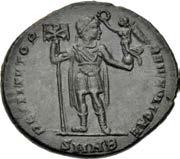




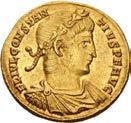



857.
858 859
858. Julian II. AD 360-363. Æ (27.5mm, 8.40 g, 6h). Sirmium mint, 2nd officina. Struck summer AD 361-26 June 363. D N FL CL IVLI ANVS P F AVG, pearl-diademed, draped, and cuirassed bust right / SECVRITAS REI PVB, bull standing right; two stars above; *BSIRM(wreath). RIC VIII 106; LRBC 1621. Superb EF. Wonderful dark green patina. ($1000)
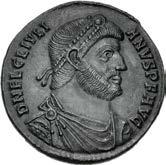

From the DFA Collection. Ex Classical Numismatic Group 69 (8 June 2005), lot 1767.
859. Valentinian I. AD 364-375. Æ (29mm, 9.24 g, 12h). Nicomedia mint, 2nd officina. Struck AD 364-367. D N VALENTINI ANVS P F AVG, pearl-diademed, draped, and cuirassed bust right / RESTITVTOR REIPVBLICAE, Valentinian standing facing, head right, holding Victory on globe in right hand, labarum in left; SMNB. RIC IX 7a.2; LRBC 2321. Dark green patina, a few minor cleaning marks, smoothed, details enhanced. EF. ($1000) From the DFA Collection.


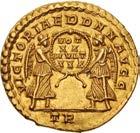

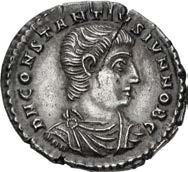
860 861
860. Valentinian I. AD 364-375. AV Solidus (21mm, 4.37 g, 6h). Antioch mint, 6th officina. Struck AD 365. D N VALENTINI ANVS P F AVG, rosette-diademed, draped, and cuirassed bust right / RESTITVTOR REIPVBLICAE, Valentinian standing facing, head right, holding labarum with right hand and Victory on globe in left; ANTI*. RIC IX 2bxxx.6; Depeyrot 22/1; Biaggi –. Underlying luster, a couple of spots of die rust, one insignificant bruise in reverse field, light scratches and scrapes. Choice EF. ($1500)
From the DFA Collection.
861. Valens. AD 364-378. AR Heavy Siliqua (20mm, 3.01 g, 12h). Quinquennalia issue. Constantinople mint, 3rd officina. Struck AD 364-367. D N VALENS P F AVG, pearl-diademed, draped, and cuirassed bust left / VOT/·/V in three lines within wreath with large central jewel; CONSΓ. RIC IX 11j(2); RSC 87†a corr. (bust type). Toned, light scratches. Good VF. Very rare left facing portrait, only two in CoinArchives. ($750)
From the DFA Collection.
862. Gratian. AD 367-383. Æ (22mm, 4.26 g, 12h). Treveri (Trier) mint. Struck August AD 367 - February AD 369. D N GRATIANVS P F AVG, pearl-diademed, draped, and cuirassed bust right / GLORI A ROMA N ORVM, city gate with two turrets, no door, S above; SMTR. RIC IX 29d; LRBC 91. Dark brown patina, minor porosity and deposits. EF. Very rare. ($2000)
The authors of RIC note (p. 4) that “the mint-mark SMTR can be dated to the period between the elevation of Gratian and the completion of the senior emperor’s quinquennium in Feb. A.D. 369. Most of the coinage is commemorative of these important events...” This very rare type was struck for Valentinian I, Valens, and Gratian only at Trier, and an extremely rare issue at Constantinopolis for Valens, where he resided at the time.
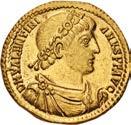
863. Gratian. AD 367-383. AV Solidus (21mm, 4.40 g, 12h). Constantinople mint, 6th officina. Struck AD 380-381. D N GRATIA NVS P F AVG, rosette-diademed, draped, and cuirassed bust right / CONCOR DIA AVGGG, Constantinopolis enthroned facing, head right, right foot on prow, holding scepter in right hand, globe in left; lions’ heads on throne; H//CONOB. RIC IX 45a.6; Depeyrot 33/1; Biaggi 2273-4 var. (officina). Lustrous, small scrapes on obverse. EF. ($1500)


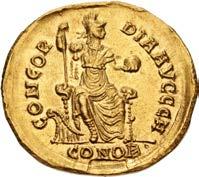







864. Valentinian II. AD 375-392. AR Light Miliarense (22mm, 4.01 g, 7h). Lugdunum (Lyon) mint. Struck August AD 388 - May AD 392. D N VALENTINI ANVS P F AVG, pearl-diademed, draped, and cuirassed bust right / VIRTVS EXERCITVS, Valentinian standing facing, head left, in military dress, holding labarum in left hand, resting right hand on grounded shield to right; LVG•. RIC IX 41.2; Lyon 215; RSC 58e. Toned, roughness, trace deposits. Irregular flan. VF. Extremely rare, only two recorded in CoinArchives, one example in Lyon. ($2000)
865. Valentinian II. AD 375-392. AV Solidus (21mm, 4.48 g, 6h). Constantinople mint, 6th officina. Struck AD 388-392. D N VALENTINI ANVS P F AVG, rosette-diademed, draped, and cuirassed bust right / CONCORDI A AVCCC, Constantinopolis enthroned facing, head right, right foot on prow, holding scepter in right hand, globe in left; lions’ heads on throne; S//CONOB. RIC IX 69b2; Depeyrot 47/5; Biaggi 2288. Lustrous, light scattered marks. Choice EF. ($1500)



Ex New York Sale XLVI (11 January 2022), lot 411.
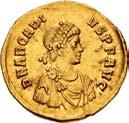
866. Theodosius I. AD 379-395. AV Solidus (20mm, 4.39 g, 12h). Constantinople mint, 1st officina. Struck AD 388-392. D N THEODO SIVS P F AVG, pearl-diademed, draped, and cuirassed bust right / CONCORDI A AVGGG, Constantinopolis enthroned facing, head right, right foot on prow, holding scepter in right hand and shield inscribed VOT/X/MVLT/XV in four lines in left; A//CONOB. RIC IX 71a.1; Depeyrot 48/1; Biaggi 2298 var. (officina). Overall porosity, minor scratches, scrape on obverse. Good VF. ($750)
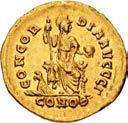

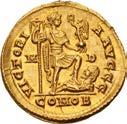


From the S & S Collection.
867. Arcadius. AD 383-408. AV Solidus (20.5mm, 4.48 g, 6h). Mediolanum (Milan) mint. Struck AD 397-402. D N ARCADI VS P F AVG, pearl-diademed, draped, and cuirassed bust right / VICTORI A AVGGG, Arcadius standing right, holding labarum in right hand and Victory on globe in left, right foot on captive below; M|D//COMOB. RIC IX 35b and RIC X 1205b; Toffanin 500/2; Depeyrot 16/1; DOCLR 265; Biaggi –. Light marks and deposits. EF. ($1500)
866 867 868 869
868. Arcadius. AD 383-408. AV Solidus (21mm, 4.44 g, 6h). Constantinople mint, 3rd officina. Struck AD 383. D N ARCADI VS P F AVG, pearl-diademed, draped, and cuirassed bust right / CONCOR DIA AVGGG, Constantinopolis enthroned facing, head right, right foot on prow, holding scepter in right hand, globe in left; lions’ heads on throne; Γ// CONOB. RIC IX 45e (officina not recorded); Depeyrot 34/2; cf. DOCLR 1-4 (officina not recorded); Biaggi –. Traces of find patina, underlying luster. Near EF. ($1000)
869. Arcadius. AD 383-408. AV Solidus (21mm, 4.48 g, 12h). Constantinople mint, 10th officina. Struck AD 397-402. D N ARCADI VS P F AVG, pearl-diademed, helmeted, and cuirassed bust facing slightly right, holding spear over right shoulder and shield on left / CONCORDI A AVGGG, Constantinopolis enthroned facing, head right, right foot on prow, holding long scepter in right hand and Victory on globe in left; I//CONOB. RIC X 7; Depeyrot 55/1; cf. DOCLR 212 (officina not recorded); Biaggi –. Lustrous, light marks. EF. ($1500)

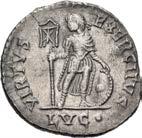



870. Aelia Eudoxia. Augusta, AD 400-404. AV Tremissis (14mm, 1.50 g, 6h). Constantinople mint. Struck under Theodosius II, AD 439-450/5. AEL EVDO XIA AVC, pearl-diademed, draped, and cuirassed bust right / Latin cross pattée within wreath (ties 14); large central jewel above; CONOB*. RIC X 336 and 346; MIRB 51; Depeyrot 72/3; Biaggi 2359. Scrapes, metal flaws, area of flat strike on reverse. Good VF. ($1500)
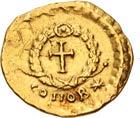

From the S & S Collection.



871. Magnus Maximus. AD 383-388. AV Solidus (21mm, 4.46 g, 6h). Treveri (Trier) mint. Struck AD 383-384. D N MAG MA XIMVS P F AVG, rosette-diademed, draped, and cuirassed
RIC IX 76.2; Depeyrot 50/1 corr. (position of star); Biaggi 2309. A few faint marks and hairlines, otherwise lustrous and attractive. EF. Rare. ($5000)
A capable general of Spanish birth, Flavius Magnus Clemens Maximus was appointed military commander of Britain in AD 380. Three years later, Maximus made a bid for the throne of the Western Roman Empire, then ruled by the young Gratian and his brother Valentinian II. After disposing of Gratian, Maximus proposed a three-way division of the Empire, with himself ruling Britain, Gaul, Germany and Spain, Valentinian II ruling Italy and Africa, and Theodosius I, another Spaniard, holding the East. During this period of relative calm, Maximus struck this gold solidus at the mint of Trier, with a reverse hailing him as the “Restorer of the Republic.” He was a zealous Christian who persecuted those whom he percieved as heretics, including the Spanish ascetic Priscillian and his followers; however, he showed respect for the Jewish faith. The uneasy equilibrium lasted about three years but, in AD 387, Maximus launched an invasion of Italy, provoking a final showdown with Theodosius. In a lightning campaign, Theodosius struck westward and defeated Maximus before he could fully marshal his forces. Both Maximus and his son Victor were summarily executed by Theodosius, who restored Valentinian II to the Western throne. Maximus’ grab for power proved ill-advised, igniting a destructive civil war and fatally weakening the Western Empire, particularly in Britain and northern Gaul. It is claimed, however, that a descendent of his ended up marrying Vortigern, king of the Britons, and is it through this union that several Welsh kings claimed Maximus as an ancestor.
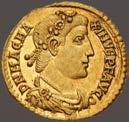




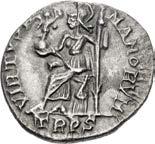
872. Eugenius. AD 392-394. AR Siliqua (16.5mm, 1.69 g). Treveri (Trier) mint. D N EVGENI VS P F AVG, pearldiademed, draped, and cuirassed bust right / VIRTVS RO MANORVM, Roma seated left on cuirass, holding Victory on globe in her right hand and inverted spear with left; TRPS. RIC IX 106d; RSC 14†a. Attractive cabinet tone, hairline flan crack, light scratches, minor die breaks. Good VF. ($1000)

873. Eugenius. AD 392-394. AR Siliqua (16mm, 1.59 g, 6h). Lugdunum (Lyon) mint, 2nd officina. D N EVGENI VS P F AVG, pearl-diademed, draped, and cuirassed bust right / VRBS ROMA, Roma seated left on cuirass, holding Victory on globe in right hand and inverted spear in left; LVGPS. RIC IX 46; Lyon 230; RSC 18A. Attractive toning. Near EF. ($1000)
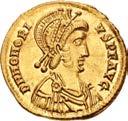
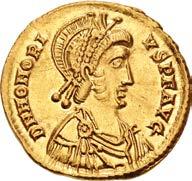
From the S & S Collection.
874. Honorius. AD 393-423. AV Solidus (20.5mm, 4.45 g, 12h). Mediolanum (Milan) mint. Struck AD 397-402. D N HONORI VS P F AVG, pearl-diademed, draped, and cuirassed bust right / VICTORI A AVGGG, Honorius standing right, holding labarum and Victory on globe, foot on captive below; M|D//COMOB. RIC IX 35c = RIC X 1206b; Toffanin 486/2; Depeyrot 16/2; Biaggi 2320. Lustrous. In NGC encapsulation 6057291-004, graded MS, Strike: 5/5, Surface: 4/5. ($1500)
875. Honorius. AD 393-423. AV Solidus (21mm, 4.47 g, 12h). Ravenna mint. Struck AD 415. D N HONORI VS P F AVG, diademed, helmeted, draped, and cuirassed bust right / VICTORI A AVGGG, Honorius standing facing, right foot on lion recumbent left, holding long staff terminating in staurogram in right hand, placing left on hilt of sword; above, manus Dei crowning emperor; R|V//COB. RIC X 1310; Ranieri 16; Depeyrot 3/1; DOCLR 742; Biaggi 2318. Fully lustrous, small scratch on obverse. EF. Rare. ($4000)
876 877
876. Honorius. AD 393-423. AV Solidus (21mm, 4.50 g, 12h). Ravenna mint. Struck AD 415. D N HONORI VS P F AVG, diademed, helmeted, draped, and cuirassed bust right / VICTORI A AVGGG, Honorius standing facing, right foot on lion recumbent left, holding long staff terminating in staurogram in right hand, placing left on hilt of sword; above, manus Dei crowning emperor; R|V//COB. RIC X 1310; Ranieri 16; Depeyrot 3/1; DOCLR 742; Biaggi 2318. Some luster, edge nicks. Good VF. Rare. ($2000)
877. Theodosius II. AD 402-450. AV Solidus (21mm, 4.43 g, 6h). Constantinople mint, 3rd officina. Struck late AD 425-429. D N THEODO SIVS P F AVG, pearl-diademed, helmeted, and cuirassed bust facing slightly right, holding spear over shoulder in right hand and shield decorated with horseman motif in left / SALVS REI PVBLICAE, Theodosius II and Valentinian III seated facing on double throne, each nimbate and wearing consular robes, holding mappa in right hand, cruciform scepter in left; star above; Γ//CONOB. RIC X 237; MIRB 23a; Depeyrot 79/1; DOCLR 375; Biaggi –. Lustrous, light deposits. Good VF. ($750)

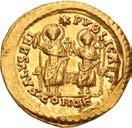
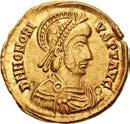
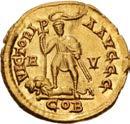

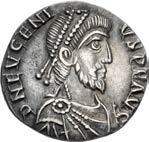


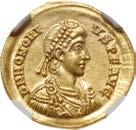
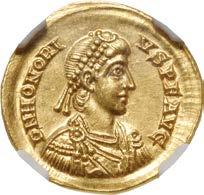


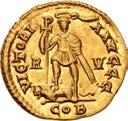
From the S & S Collection.

878 879
878. Theodosius II. AD 402-450. AV Solidus (21.5mm, 4.52 g, 6h). Tricennalia issue. Constantinople mint, 6th officina. Struck AD 430-440. D N THEODO SIVS P F AVG, pearl-diademed, helmeted, and cuirassed bust facing slightly right, holding spear over shoulder and shield decorated with horseman motif / VOT XXX MVLT XXXX, Constantinopolis seated left on throne, foot on prow, holding globus cruciger and scepter; shield to right side of throne; star to right; S//CONOB. RIC X 257; MIRB 25; Depeyrot 81/1; DOCLR 382; Biaggi –. Lustrous, double struck at the periphery. Choice EF. ($1500)
879. Theodosius II. AD 402-450. AV Solidus (21mm, 4.50 g, 6h). Constantinople mint. Struck AD 442-443. D N THEODOSI VS P F AVG, pearl-diademed, helmeted, and cuirassed bust facing slightly right, holding spear in right hand and shield at left shoulder / IMP XXXXII COS XVII P P, Constantinopolis seated left on throne, foot on prow, holding globus cruciger and scepter; shield to right side of throne; star to left; CONOB. RIC X 323; MIRB 33; Depeyrot 84/1; DOCLR 410–13; Biaggi –. Lustrous, obverse die break, scratches, minor deposits. Choice EF. Rare. ($750)
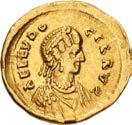



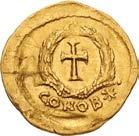
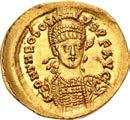




From the S & S Collection.
880. Aelia Eudocia. Augusta, AD 423-460. AV Tremissis (14mm, 1.45 g, 6h). Constantinople mint. Struck under Theodosius II, circa AD 420-450/455. AEL EVDO CIA AVG, pearl-diademed and draped bust right / Latin cross pattée within wreath (ties 7); large central jewel above; CONOB*. RIC X 252; Depeyrot 72/2; DOCLR 461; Biaggi 2359. Lustrous, scattered light marks, graffiti on reverse. Good VF. ($750)


From the S & S Collection.
Aelia Eudocia started life as Athenais, born in Antioch to a prominent Pagan professor of rhetoric. Raised on the classics, she blossomed into a beautiful young woman who was an accomplished poet and orator. When her father died and her brothers cut her out of any inheritance, she traveled to Constantinople in AD 420 to seek redress from the emperor Theodosius II. But the scholarly young emperor was in the market for a wife and he was immediately smitten with Athenais. His sister, the devout Pulcheria, insisted that she convert to Christianity before any marriage, terms she readily accepted, taking the name Eudocia. The new Empress quickly became an advocate for universal education and tolerance, particularly toward Jews and other persecuted sects. She also sought to blend Classical Hellenism and Christianity. This placed her at odds with Pulcheria, who began to denigrate the sincerity of her conversion. To prove her devotion, Eudocia made a pilgrimage to the Holy Land in AD 438, but soon after returning she was accused of adultery and banished from the court. Theodosius still loved her, however, and the terms were not severe. She was able to retire to Jerusalem where she continued her writing and charitable work until her death in AD 460.
From the S & S Collection.
882. Aelia Pulcheria. Augusta, AD 414-453. AV Solidus (21mm, 4.47 g, 6h). Vicennalia issue. Constantinople mint. Struck under Theodosius II, AD 423-425. AEL PVLCH ERIA AVG, pearl-diademed and draped bust right, wearing earring and necklace; crowned by manus Dei / VOT XX MVLT XXX, Victory standing left, holding long jeweled cross in right hand; CONOB. RIC X 220; MIRB 17; Depeyrot 75/3; DOCLR 437; Biaggi –. Lustrous, light scratches, minor die break and metal flaw on reverse. EF. Rare. ($5000)

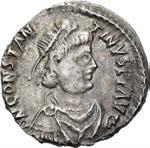



883. Constantine III. AD 407-411. AR Siliqua (16mm, 1.67 g, 5h). Treveri (Trier) mint. Struck AD 408-411. D N CONSTANTINVS P F AV, pearl-diademed, draped, and cuirassed bust right / VICTORIA AAVCCC, Roma seated left on stylised cuirass, holding Victory on globe and inverted spear; TRMS. RIC X 1533; King, Fifth 2, pl. 22, 3; DOCLR 799-802; RSC 4a. Iridescent tone, light scratches. VF. Rare. ($750)

From the S & S Collection.
Constantine III was proclaimed emperor by the legions in Britain following the assassinations of the usurpers Marcus and Gratianus. Hoping to secure his position, he sailed to Gaul where he met little opposition. Constantine was officially recognized by Honorius, although Theodosius and Arcadius failed to follow his lead. Constantine had early successes, defeating the local barbarians and negotiating agreements with the Alamanni and Burgundians, but his attempt to enter Italy failed. Attacked by his own general Gerontius and soon afterwards the troops of Honorius, Constantine was killed in 411.
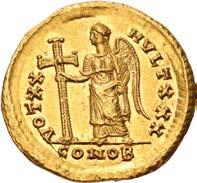


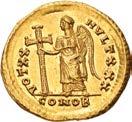
884. Constantine III. AD 407-411. AR Siliqua (15.5mm, 1.67 g, 12h). Arelate (Arles) mint. Struck AD 408-411. D N CONSTANTINVS P F AV, pearl-diademed, draped, and cuirassed bust right / VICTORIA AAVCCC, Roma seated left on stylised cuirass, holding Victory on globe and inverted spear; SMAR. RIC X 1538; King, Fifth, 1a, pl. 22, 4; Ferrando 1705; RSC 4d; DOCLR 805. Struck on a small flan. Good VF. ($750)
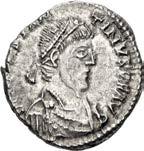
From the S & S Collection.

885. Maximus of Spain. Usurper, AD 409-411. AR Siliqua (14mm, 1.11 g, 6h). Barcino (Barcelona) mint. Struck AD 410411. D N MAXIM VS P F AVG, pearl-diademed, draped, and cuirassed bust right / VICTOR IA AAVGGG, Roma seated left on cuirass, holding Victory on globe in right hand and inverted spear with left; [SMBA]. RIC X 1601; Balaguer 1-37; King, Fifth p. 291; ACIP 4437; RSC 1b corr. (rev. legend). Toned, light porosity, scratches, scrape on reverse. VF. Very rare. ($2000)
From the S & S Collection.
Maximus was the domesticus (household manager) and probably a relative of the general Gerontius, who revolted against Constantine III in AD 409. Basically a non-entity and Gerontius’ puppet, Maximus was allowed to retire into private life when his master committed suicide in AD 411. However, if this Maximus is the same person as the Maximus tyrannus who unsuccessfully attempted to seize power in Spain around AD 420, his good fortune did not last. Maximus tyrannus was captured and publicly executed at the games celebrating Honorius’ tricennalia at Ravenna in AD 422 as an example for any other would-be traitors. According to Philip Grierson (DOCLR, p. 219), there are about twenty known coins of Maximus.



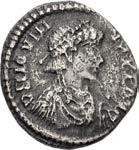




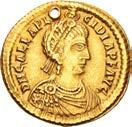

886. Jovinus. Usurper, AD 411-413. AR Siliqua (15mm, 1.72 g, 11h). Arelate (Arles) mint. D N IOVIN VS P F AVC, pearl-diademed, draped, and cuirassed bust right / VICTOR IA AVCC, Roma seated left on curule chair, holding Victory on globe in outstretched right hand and reversed spear with left; KONT. RIC X 1721; King, Fifth, p. 290 and pl. 22, 9; DOCLR –; Ferrando 1717; RSC 2†b. Toned, rough surfaces. Near VF. Very rare. ($1000)

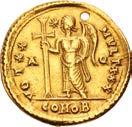
From the S & S Collection.
887. Galla Placidia. Augusta, AD 421-450. AV Solidus (21mm, 4.43 g, 12h). Aquileia mint. Struck circa May-October AD 425. D N GALLA PLA CIDIA P F AVG, pearl-diademed and draped bust right, with Christogram on shoulder; manus Dei above, crowning her / VOT XX MVLT XXX, Victory standing left, holding long cross in right hand; A|Q//COMOB. RIC X 1808 (same obv. die as illustration); Depeyrot 23/2; DOCLR 825 (same obv. die as illustration); P&Z 825; Sagramora 731 (same obv. die as illustration); Biaggi –. Light marks, pierced. Good VF. Rare. ($1000)
From the S & S Collection.
888. Valentinian III. AD 425-455. AV Solidus (22mm, 4.45 g, 6h). Ravenna mint. Struck AD 426-430/455. D N PLA VALENTI NIANVS P F AVG, rosette-diademed, draped, and cuirassed bust right / VICTORI A AVGGG, Valentinian, foot on human-headed serpent, standing facing, holding long cross in right hand and Victory on globe in left; R|V//COMOB. RIC X 2011; Ranieri 95; Depeyrot 17/1; DOCLR 844; Biaggi –. Small flan crack, deposits. Good VF. ($750)


From the S & S Collection.
889. Justa Grata Honoria. Augusta, circa AD 426-450. AV Solidus (22mm, 4.47 g, 6h). Ravenna mint. Struck AD 439. D N IVST GRAT HO NORIA P F AVG, pearl-diademed and draped bust right, cross on shoulder; manus Dei holding nimbus above / BONO REI PVBLICAE, Victory standing facing, head left, holding long jeweled cross with her right hand; star in upper left field; R|V//COMOB. RIC X 2022; Depeyrot 15/1; DOCLR 866; Biaggi –. Underlying luster, edge split. Choice EF. Very rare. ($5000)
From the S & S Collection. Ex CNG inventory 722952 (December 2000).
Honoria was sister to the emperor Valentinian III. She was to be married to a Roman Senator named Bassus Herculanus but she had no interest in this union and sought aid from the already infamous Hun, Atilla. In the Spring of 450, she sent him her ring and a plea for help, whether Honoria intended this to be an invitation to wed is uncertain but Atilla took it as such and accepted, asking for half the Western Empire as his dowry. In 452 he unsuccessfully invaded northern Italy after negotiations with Rome failed. Little is known of Honoria’s fate from this point on other than a brief exile and possible time in a Constantinople convent.



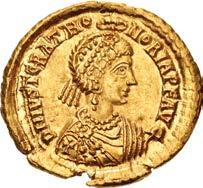
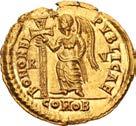

890. Marcian. AD 450-457. AV Solidus (20.5mm, 4.48 g, 5h). Constantinople mint, 5th officina. Struck AD 450. D N MARCIA NVS P F AVG, pearl-diademed, helmeted, and cuirassed bust facing slightly right, holding spear over shoulder and shield / VICTORI A AVGGG, Victory standing left, holding long, jeweled cross in right hand; star to right; Є//CONOB. RIC X 510; DOCLR 479; Depeyrot 87/1; Biaggi –. Deposits, metal flaws. Near EF ($750)
From the S & S Collection.
891. Petronius Maximus. Usurper, AD 455. AV Solidus (22mm, 4.25 g, 6h). Rome mint. D N PETRONIVS MA XIMVS P F AVC, pearl-diademed, draped, and cuirassed bust right / VICTORI A AVGGG, Petronius standing facing, holding long cross in right hand and Victory set on globe in left, right foot on human-headed serpent; R|M//COMOB. RIC X 2201 (same obv. die as 2202/2); Depeyrot 48/1; Lacam Groupe, Pl. XVII, 1; DOCLR 874; Biaggi 2362. Lightly toned, scratches. Fine. Extremely rare. ($5000)
From the S & S Collection. Ex Classical Numismatic Group 51 (15 September 1999), lot 1540.
Following the assassination of Valentinian III in AD 455, Petronius Maximus seized the throne and immediately married Valentinian’s wife, Licinia Eudoxia. Licinia, believing that Petronius was responsible for her late husband’s death, was not happy with the new arrangement, and she appealed to the Vandal king of Carthage, Gaiseric, for help. Gaiseric responded to Licinia’s plea and quickly sailed for Italy. Fearing for his life, Petronius decided to flee, but was abandoned by his bodyguard. While riding out of Rome on 31 May, he was stoned and killed. His reign lasted for only seventy days.


892.
AD 457-484. AV Solidus (21mm, 4.48 g,



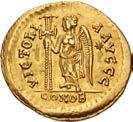



mint.
under Leo I, AD 462-466. AEL ЧERI NA AЧG, pearl-diademed and draped bust right, wearing necklace and earrings;
Dei holding nimbus above / VICTORI A AVGGG, Victory standing left, holding long jeweled cross with right hand; star in right field; CONOB. RIC X 607; MIRB 4; Depeyrot 93/2; DOCLR 593 var. (obv. legend); Biaggi –. Underlying luster, minor marks. Good VF. ($15,000)
Ex Moneta Imperii Romani Byzantini: The Collection of a Connoisseur (Stack’s, 12 January 2009), lot 3036; Schweizerischer Bankverein 28 (17 September 1991), lot 791.
Aelia Verina, the wife of Leo I, had an extraordinary personal history, plotting from time to time for and against her various relatives in numerous intrigues to control the succession or seize the throne. The very rare gold coinage in her name is attributed to two separate periods, an earlier issue struck in 462 or 466 and a later issue in 471 or 473. From the scant historical sources, Verina appears to have been the consummate imperial schemer who regularly instigated and switched sides in various deadly dynastic disputes without suffering any consequences for her actions. She retired to a nunnery in AD 480, but emerged in AD 484 for one final intrigue against her son-in-law Zeno. This, too, failed and Verina died in the aftermath; whether or not by violence is not recorded.
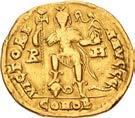

893.

894. Majorian. AD 457-461. AV Tremissis (13mm, 1.41 g, 6h). Ravenna mint. D N IVL MAIORIANVS P F AVC, pearl-diademed, draped, and cuirassed bust right / Latin cross pattée within wreath; large central jewel above; COMOB. RIC X 2610; Depeyrot 23/2; DOCLR 886; Lacam 42; Ranieri 141; Biaggi 2368 var. (obv. legend). Lightly toned, faint scratches, light deposits. VF. ($2000)
From the S & S Collection.
895. Julius Nepos. AD 474-475/480. AV Solidus (19.5mm, 4.25 g, 6h). Ravenna mint. Struck AD 474-475. D N IVL NE POS P F AVG, pearl-diademed, helmeted, and cuirassed bust facing slightly right, holding spear in right hand over shoulder, on left arm, shield decorated with horseman spearing an enemy below / VICTORI A AVCCC:, Victory standing left, holding long, jeweled cross in right hand; R|V//COMOB. RIC X 3212; Lacam 9; Ranieri 181; DOCLR 939; Depeyrot 41/1; Biaggi –. Minor deposits, graffiti on obverse, slight doubling on reverse, slightly wavy flan. Good VF. Rare. ($5000)
From the S & S Collection.
896. Basiliscus. AD 475-476. AV Solidus (21mm, 4.48 g, 6h). Uncertain western? mint. D N ЬASILIS C*S P P AVC, pearl-diademed, helmeted, and cuirassed bust facing slightly right, holding spear and shield / VICTORI A AVCCC, Victory standing left, holding long, jeweled cross in right hand; star to right; CONOR. RIC X 1003 var. (CONOB); Lacam –, but cf. Classe I, Type 1 (Theoderic in name of Zeno [for mintmark]); Depeyrot 101/1 var.(same); DOCLR 607 var.(same); Biaggi –. Lustrous. Choice EF. Extremely rare. ($4000)
From the S & S Collection.
Based on the mintmark CONOR in the exergue of issues in the name of Zeno, Lacam assigned them to the reign of the Ostrogothic king Theoderic. M.A. Metlich, however, in his study of the Ostrogothic coinage (COI), states that no solidi in the name of Zeno can be attributed to Theoderic, implying that issues with CONOR must be official coinages of the emperor. In fact, P. Grierson noted a Zeno with Leo tremissis with the CONOR mintmark in Dumbarton Oaks (DOCLR 628), which he assigned to Constantinople. While CONOR is suggestive of an unofficial or imitative issue, examples in the name of Zeno with this mintmark are recorded with one of seven different officina letters – A, B, Γ, Δ, Є, Z, and Θ. So many officina letters are unknown in contemporary Germanic issues that imitate imperial coinage, and argue instead for a well-structured official western mint whose identification is not yet certain. Our coin, in the name of Basiliscus and with the mintmark found on issues of Zeno, offers tangible evidence for such a mint scenario, since Germanic imitations in the name of Basiliscus are unknown.



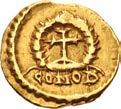




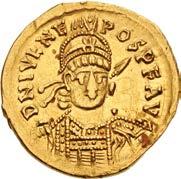



897. Romulus Augustus. AD 475-476. AV Tremissis (12.5mm, 1.32 g, 6h). Mediolanum (Milan) mint. D N ROMVLVS AGVSTVS PF AVG, Pearl-diademed, draped, and cuirassed bust right / Cross within wreath; COMOB in exergue. RIC X 3419; Lacam 37 (same dies); Depeyrot 43/2 corr. (obv. legend); Toffanin 541/1; cf. Biaggi 2393; cf. Mazzini 10. Light scratch. VF. Extremely rare. ($30,000)
From the S & S Collection. Ex Waddell inventory C35985 (ND); Sternberg XXXV (29 October 2000), lot 947.
The task of ruling the Western Roman Empire in the late fifth century AD was devoid of the glory that once accompanied the office. Gone were the days of conquest and firm imperial power. In their place were consistent threats on the Empire’s crumbing borders, a corrupt bureaucracy, and the ever-present threat of violent insurrection and usurpation. During this fraught time in Rome, on 31 October AD 475, a new emperor was proclaimed — Romulus Augustus.
Romulus was the young son of the Western Empire’s magister militum, Orestes, who had deposed the Emperor Julius Nepos via military coup. Nepos fled to Dalmatia in exile, while the rogue Orestes elected to put Romulus, about 14 years old, on the throne. With his son as his puppet, Orestes went about his own agenda while trying to fulfill the expected functions of government in Italy, which was about all that was left of the West Roman Empire. Unfortunately for Orestes and Romulus, the presence of the East Roman Empire, far more wealthy and powerful, could not be ignored. To gain legitimacy, they needed the recognition of Constantinople. Unfortunately for them, the Eastern Empire was undergoing its own ruling crisis between the rival emperors Zeno and Basiliscus, and both claimants still considered the exiled Julius Nepos as the legitimate western ruler.
Nepos wielded no real power in exile, leaving Romulus Augustus as the de facto western emperor. However, his time was destined to be short. Early in AD 476, a group of barbarian foederati, mercenaries in Rome’s employ, demanded a third of the arable land in Italy in payment for their services. Orestes refused their demands. Led by one Odovacer, the mercenaries marched on Ravenna. Orestes and his personal guard tried to stop them, but was defeated and killed at Ticinum. On 4 September AD 476, Odovacer seized Ravenna. Young Romulus, alone and friendless, sat on the throne wearing his diadem and purple cloak, holding the imperial scepter and orb, awaiting his fate. Odovacer, on account of the boy’s “youth and beauty,” spared his life, but ordered him to hand over the ruling regalia and made him sign an instrument of abdication, which he sent on the Zeno in Constantinople. Romulus Augustus, whose name combined those of the first king and emperor of Rome, had reigned just under 11 months. Orestes proclaimed himself King of Italy and told Zeno he would rule as viceroy of the East Roman emperor; Zeno politely insisted that Julius Nepos was still the legitimate Augustus of the West. Nepos, however, never set foot in Italy again and was murdered in AD 480, snuffing out the last feeble ember of the Western Roman Empire.
Romulus himself survived his overthrow and was sent to the countryside to live out his days on a yearly pension of 6,000 solidi. He was still alive in AD 507, when he had a brief correspondence with Theodoric the Great, who had replaced Odovader as king.

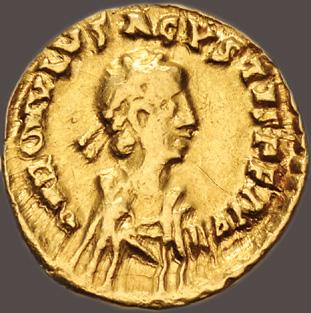

The sad episode of Romulus Augustus is considered by most historians to mark the end of the West Roman Empire. The great Edward Gibbon popularized this verdict in his monumental History of the Decline and Fall of the Roman Empire. Gibbon had this to say of the unremarkable, but historic Romulus Augustus. “The son of Orestes assumed and disgraced the names of Romulus Augustus; but the first was corrupted into Momyllus, by the Greeks, and the second has been changed by the Latins into the contemptible diminutive Augustulus. The life of this inoffensive youth was spared by the generous clemency of Odoacer; who dismissed him, with his whole family, from the Imperial palace, fixed his annual allowance at six thousand pieces of gold, and assigned the castle of Lucullus, in Campania, for the place of his exile or retirement.” Ultimately, due to the brief nature of his reign, the coinage of Romulus Augustus is quite rare and highly sought after for its historical significance.

898. Anastasius I. 491-518. AV Solidus (21mm, 4.49 g, 6h). Constantinople mint, 10th officina. Struck 492-507. D N ANASTA SIVS P P AVG, helmeted and cuirassed bust facing slightly right, holding spear over shoulder in right hand, shield decorated with horseman motif on left shoulder / VICTORI AVGGG, Victory standing left, holding long jeweled cross in right hand; star in right field; I//CONOB. DOC 3i; MIBE 4a; SB 3. Lustrous, die break on reverse, a few faint hairlines, minor deposit on reverse. EF. ($1000)
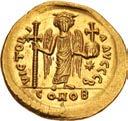




From the S & S Collection.
899 900
899. Anastasius I. 491-518. Æ Follis (35mm, 19.56 g, 6h). Constantinople mint, 4th officina. Struck 512-517. D N ANASTA SIVS P P AVG, diademed, draped, and cuirassed bust right / Large M; cross above, stars of six rays flanking; ∆/CON. DOC 23f; MIBE 27; SB 19. Warm red-brown surfaces, triple strike on reverse. EF. ($750)
From the Iconodule Collection.
900. Anastasius I. 491-518. Æ Follis (36.5mm, 18.05 g, 5h). Constantinople mint, 5th officina. Struck 512-517. D N ANASTA SIVS P P AVG, diademed, draped, and cuirassed bust right / Large M; cross above, stars of six rays flanking; Є/CON. DOC 23i; MIBE 27; SB 19. Warm brown surfaces, slight doubling. EF. Well struck for issue. ($1000)

From the Iconodule Collection.
901. Justin I. 518-527. AV Solidus (21mm, 4.47 g, 6h). Constantinople mint, 2nd officina. Struck 522-527. D N IVISTI NVS P P AVG, helmeted and cuirassed bust facing slightly right, holding spear over shoulder in right hand, shield decorated with horseman motif on left shoulder / VICTOR I A AVGGG, angel standing facing, holding long cross in right hand and globus cruciger in left; star in right field; B//CONOB. DOC 2b; MIBE 3; SB 56. Lustrous, slight bend in flan, a few die breaks on reverse, minor mark on reverse. EF. ($750)






902. Justin I. 518-527. AV Solidus (20.5mm, 4.47 g, 7h). Constantinople mint, 10th officina. Struck 522-527. D N IVISTI NVS P P AVG, helmeted and cuirassed bust facing slightly right, holding spear over shoulder in right hand, shield decorated with horseman motif on left shoulder / VICTOR I A AVGGG, angel standing facing, holding long cross in right hand and globus cruciger in left; star in right field; I//CONOB. DOC 2i; MIBE 3; SB 56. Lustrous. EF ($750)



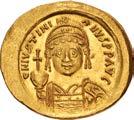
903. Justin I & Justinian I. 527. AV Solidus (20.5mm, 4.48 g, 8h). Constantinople mint, 4th officina. Struck 4 April-1 August. D N IVSTIN [ЄT IVST]INIAN P P AVG, Justin and Justinian seated facing on backless throne, each with hands clasped before chest; CONOB / VICTORI A AVGGG, angel standing facing, holding long cross in right hand and globus cruciger in left; [star in right field]; ∆//CONOB. DOC –; MIBE 1a; Metcalf, Joint Group Ia, 2 (O1/∆1); SB 114. Areas of flat strike. Near EF. ($2000)
From the S & S Collection.
904. Justin I & Justinian I. 527. AV Solidus (20mm, 4.48 g, 7h). Constantinople mint, 4th officina. Struck 4 April-1 August. D N IVSTIN ЄT IVSTINIAN P P AVG, Justin and Justinian seated facing on backless throne, each holding globus in left hand; CONOB / VICTORI A AVGGG, angel standing facing, holding long cross in right hand and globus cruciger in left; star in right field; ∆//CONOB. DOC 5b; MIBE 1d; Metcalf, Joint Group Id, 11 (O7/∆1); SB 120. Underlying luster. EF. ($3000)









905 906
905. Justinian I. 527-565. AV Solidus (22mm, 4.48 g, 6h). Constantinople mint, 8th officina. Struck 537-542. D N IVSTINI ANVS P P AVG, helmeted and cuirassed bust facing, holding globus cruciger in right hand, shield decorated with horseman motif on left shoulder / VICTORI A AVGGG, angel standing facing, holding long cross in right hand and globus cruciger in left; star to right; H//CONOB. DOC 8f; MIBE 6; SB 139. Lustrous, double strike, mark, and trace deposit on reverse. Near EF. ($500)
906. Justinian I. 527-565. AV Solidus (21mm, 4.44 g, 6h). Constantinople mint, 3rd officina. Struck 542-552. D N IVSTINI ANVS P P AVG, helmeted and cuirassed bust facing, holding globus cruciger in right hand, shield decorated with horseman motif on left shoulder / VICTORI A AVGGG, angel standing facing, holding long staff surmounted by staurogram in right hand and globus cruciger in left; star to right; Γ//CONOB. DOC 9c; MIBE 7; SB 140. Lustrous, lightly clipped. Near EF. ($500)
907. Justinian I. 527-565. AV Solidus (20.5mm, 4.49 g, 6h). Constantinople mint, 7th officina. Struck 542-552. D N IVSTINI ANVS P P AVG, helmeted and cuirassed bust facing, holding globus cruciger in right hand, shield decorated with horseman motif on left shoulder / VICTORI A AVGGG, angel standing facing, holding long staff surmounted by staurogram in right hand and globus cruciger in left; star to right; Z//CONOB. DOC 9 var. (unlisted officina); MIBE 7; SB 140. Lustrous, light edge shaving, area of flat strike on reverse. EF. ($500)
908. Justin II. 565-578. AR Half Siliqua (12mm, 0.67 g, 6h). Ravenna mint. ∂ N IVSTI NVS PP AV, pearl-diademed, draped, and cuirassed bust right / Staurogram set on globe, flanked by two stars; all within wreath. DOC –; cf. MIBE 41 (third siliqua); cf. Ranieri 430 (quarter siliqua); SB 413. Cabinet toning, obverse slightly off center, a few faint scratches. Near EF. Excellent for issue. ($750)
From the Iconodule Collection. Ex Dr. Max Blaschegg Collection (Sternberg XIII, 17 November 1983), lot 1096.
909. Justin II. 565-578. AR Quarter Siliqua (9.5mm, 0.41 g, 6h). Ravenna mint. ∂ N IVSTI [NV]S PP AVG, pearldiademed, draped, and cuirassed bust right / Staurogram set on globe within wreath. DOC 216; MIBE 42 (sixth siliqua); Ranieri 432; SB 415. Beautiful cabinet tone. EF. ($750)
From the Iconodule Collection. Ex Elsen 125 (13 June 2015), lot 523.
910. Maurice Tiberius. 582-602. AV Solidus (21mm, 4.43 g, 6h). Constantinople mint, 2nd officina. Struck 582583/584. O N TIЬЄR m AVRIC P P AV, helmeted and cuirassed bust facing, holding globus cruciger in right hand, shield decorated with horseman motif on left shoulder / VICTORI A AVGG, angel standing facing, holding long staff surmounted by staurogram in right hand and globus cruciger in left; B//CONOB. DOC 3 var. (unlisted officina); MIBE 4a; SB 476. Lustrous, crimped flan. Choice EF. ($750)







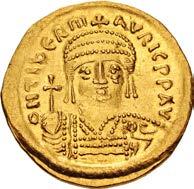
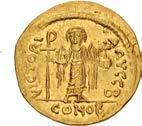


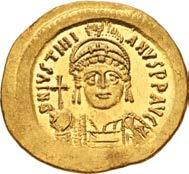
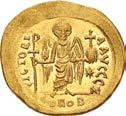


911. Phocas. 602-610. Æ Follis (31mm, 12.15 g, 7h). Nicomedia mint, 1st officina. Dated RY 2 (603/604). ∂m FOCA Є PRAV ς, crowned bust facing, wearing consular robes, holding mappa in right hand and eagle-tipped scepter in left, crown with pendilia / Large XXXX; ANNO above, II (date) to right; NIKOA. Cf. DOC 55; MIBE 69a var. (crown type); cf. SB 658. Black-green patina with earthen highlights, light cleaning scratches. Near EF. Exceptional for issue. Extremely rare. Second known example, the other of which is in Istanbul. ($1000)
From the Iconodule Collection.
912. Revolt of the Heraclii. 608-610. AV Solidus (22mm, 4.45 g, 7h). Military mint in the east, 3rd officina. Struck 10 May-late 610. ∂ N ЄRACLIO CONS[LI BA], bareheaded busts of Heraclius the younger, and the exarch Heraclius, both bearded and wearing consular robes; cross above / VICTORI A AVGG, cross potent set on four steps; Γ//CONOB. DOC 10.1 (same obv. die; Alexandria); MIBE 4 (same obv. die as illustrated coin); SB 718 (Alexandria). Overstruck on a solidus of Phocas, undertype clearly visible, underlying luster, double struck. Near EF. Very rare and choice for issue. ($7500)









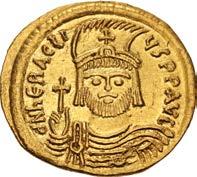


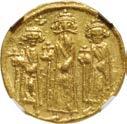
913. Heraclius. 610-641. AV Solidus (21.5mm, 4.55 g, 7h). Constantinople mint, 5th officina. Struck 610-613. ∂ N hЄRACLI ЧS P P AVG, draped and cuirassed bust facing, wearing plumed helmet and holding cross in right hand / VICTORIA AVςЧ, cross potent set on three steps; Є//CONOB. DOC 3b; MIB 5; SB 731. Lustrous, minor mark and some die rust on obverse in devices. EF. ($750)
From the S & S Collection.
914. Heraclius, with Heraclius Constantine and Heraclonas. 610-641. AV Solidus (18.5mm, 4.48 g, 7h). Constantinople mint, 2nd officina. Dated IY 10 (636/7). Heraclonas, Heraclius, and Heraclius Constantine standing facing, each wearing crown and chlamys and holding globus cruciger in right hand; cross to upper left / VICTORIA AVςЧ, cross potent set on three steps; â to left, I (date) to right; B//CONOB+. DOC 37 var. (unlisted officina); MIB 43; SB 762. In NGC encapsulation 1883765-053, graded Ch AU, Strike: 5/5, Surface: 3/5. ($1000)
From the Iconodule Collection.
915. Heraclius, with Heraclius Constantine and Heraclonas. 610-641. AV Solidus (19.5mm, 4.48 g, 6h). Constantinople mint, 2nd officina. Dated IY 12 (AD 638/9). Heraclonas, Heraclius, and Heraclius Constantine standing facing, each wearing crown and chlamys and holding globus cruciger in right hand / VICTORIA AVςЧ, cross potent set on three steps; â to left, IB monogram (date) to right; B//CONOBΛ. DOC 42 var. (unlisted officina); MIB 49 var. (same); SB 768 var. (same). Lustrous, die clashing on reverse, hairlines. EF. ($1500)
From the Iconodule Collection. Ex Leu Numismatik AG Web Auction 18 (18 December 2021), lot 3814.
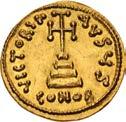
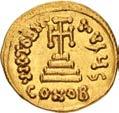
916. Heraclius. 610-641. Æ Follis (32mm, 19.14 g, 6h). Jerusalem mint. Dated RY 4? (613/4). D Һ hЄRAC [...], crowned bust facing, wearing consular robes, holding mappa in right hand and eagle-tipped scepter in left / Large M; cross above, A/N/N/O and I[I]/I[I] (date) across field; IЄPOC[...]. DOC–; Bendall, Jerusalem 1 = MIB pl. 14, X27-8; SB 852B. Green and red-brown patina, some areas of flat strike, cleaning scratches, some bare metal exposed, traces of possible undertype. VF. Very rare. ($2000)
917. Constans II. 641-668. AV Solidus (19.5mm, 4.49 g, 6h). Constantinople mint, 6th officina. Struck 651-654. [∂] N CONSτAN τINЧS P P AV, crowned facing bust, wearing long beard and chlamys, holding globus cruciger in right hand; cross above / VICTORIA AVςЧ, cross potent set on three steps; S//CONOB. DOC 19f; MIB 23; SB 956. Lustrous, trace die rust on obverse. Near EF. ($500) From the S & S Collection.

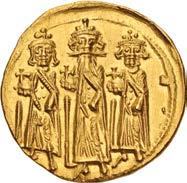






918. Tiberius III (Apsimar). 698-705. AV Solidus (20.5mm, 4.42 g, 6h). Constantinople mint, 6th officina. D τIЬЄRI ЧS PЄ AV, crowned and cuirassed bust facing, holding spear in right hand, shield decorated with horseman motif on left shoulder / VICTORIA AVςЧ, cross potent set on three steps; S//CONOB. DOC 1e; MIB 1; SB 1360. Lustrous, double strike on obverse, some marks, some die marks. EF. Exceptional for issue. ($2000)

919. Justinian II, with Tiberius. Second reign, 705-711. AV Solidus (20.5mm, 4.32 g, 7h). Constantinople mint. Struck 705-711. ∂ N IҺS CҺS RЄX RЄCNANTIЧM, facing bust of Christ Pantokrator / [D N IЧ]STINIAN ЧS ЄT TIЬЄRIЧS PP A `, crowned facing busts of Justinian, wearing slight beard and chlamys, and Tiberius, wearing chlamys; holding between them cross potent set on two steps. DOC 2b; MIB 2b; SB 1415. Lustrous, minor deposits, double strike on reverse, some cleaning scratches. EF. ($1500)
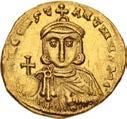
From the S & S Collection.
920. Julian. apo hypaton and genikos commerciarios of the Apotheke of Cappadocia, late 7th century. PB Seal (29.5mm, 21.49 g, 1h). Dated IY 2 (AD 688/9). OVΛIANO [AΠ]O VΠATON, crowned figure of Justinian II standing facing, wearing chlamys, holding globus cruciger in right hand; I B (date) across field / S ΓЄN/IK∂ KOMM/ЄPKIAPIOY/ AΠOΘIKIC/ KAΠΠAΔ/OKIAC in six lines. Cf. Zacos 159 and note (as genikos commerciarios of the Apotheke of Kilikia and Crete); DOCBS III 24.5 (Lydia); cf. Roma E-Sale 102, lot 1421 (Constantinople). Earthen brown surfaces. Good VF. ($1000)
Julian was apparently quite an effective bureaucrat, as lead seals in his name bear the title apo hypaton and genikos kommerkiarios of a number of Apotheke, including Kilikia, Crete, Lydia, Constantinople, and, on this example, Kappadokia.


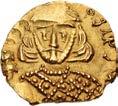




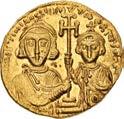


921. Theodosius III of Adramytium. 715-717. AV Tremissis (12.5mm, 1.14 g, 7h). Ravenna mint. [...] OSI*S M, crowned facing bust, wearing loros, and holding patriarchal globus cruciger in right hand / VICT[...] A, cross potent; CO[N]OB. DOC –; MIB 11 (same rev. die) = Ranieri 806 (same) = SB 1501a. Clipped, area of flat strike, a few light scratches on reverse. Near EF. Extremely rare. The second known and the only one in private hands, the other of which is in The Hague. ($1500)
From the Porphyrogenitus Collection. Ex Heritage 3014 (18 April 2011), lot 25313.
922. Leo III the “Isaurian”, with Constantine V. 717-741. AV Solidus (20.5mm, 4.46 g, 6h). Constantinople mint. Struck circa 725-732. ∂ N D LЄO N PA MЧL, crowned facing bust of Leo, wearing chlamys, holding globus cruciger in right hand and akakia in left / ∂ N CONSτ ANτINЧS M ´, crowned facing bust of Constantine, wearing chlamys, holding globus cruciger in right hand and akakia in left. DOC 5; Füeg 5; SB 1504. Lustrous, scratches. Near EF. ($1000)

923. Artavasdus, with Nicephorus. 741/2-743. AV Solidus (20mm, 4.46 g, 6h). Constantinople mint. Struck 742/743. APτAЧA SDOS MЧLτ, crowned bust of Artavasdus facing, wearing chlamys, holding patriarchal cross in right hand / NICҺORЧS MЧLτЧ, crowned bust of Nicephorus facing, wearing chlamys, holding patriarchal cross in right hand; A at end of legend. DOC 2a; Füeg 2.A; SB 1542. A number of scratches and scrapes, a little weak in center. Good VF. Very rare. ($15,000)
From the S & S Collection.
Artavasdus was the son-in-law of Leo III. After Leo’s death in 741, Artavasdus seized the throne in opposition to Leo’s young son, Constantine V. He managed to capture Constantinople, where he restored the worship of icons. But Constantine rallied the army to his cause and defeated Artavasdus in a number of battles. After a few months, Artavasdus and his son Nicephorus were cornered, imprisoned and blinded. His coinage was recalled and melted down, accounting for the great rarity of his solidi today.


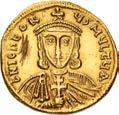
925 924
924. Constantine V Copronymus, with Leo III. 741-775. AV Solidus (21mm, 4.48 g, 6h). Constantinople mint. Struck 741-751. LЄO N PA MЧL `, crowned facing bust of Leo, wearing chlamys, holding cross potent in right hand and akakia in left / [ CO] N SτANτINЧS•, crowned facing bust of Constantine, wearing chlamys, holding cross potent in right hand and akakia in left. DOC 1d.1; Füeg –/2.B.6 (obv./rev.); SB 1550. Areas of weak strike. Good VF. ($500)

From the S & S Collection.
925. Constantine V Copronymus, with Leo III. 741-775. AV Solidus (19mm, 4.44 g, 6h). Constantinople mint. Struck 741-751. LЄO N PA MЧL, crowned facing bust of Leo, wearing chlamys, holding cross potent in right hand and akakia in left / N C ON SτANτINЧS, crowned facing bust of Constantine, wearing chlamys, holding cross potent in right hand and akakia in left. DOC –; cf. Füeg 2.A.9/2.A.6 (obv./rev.); SB 1550. Lustrous, double struck, scratches. EF. ($750)
926. Constantine V Copronymus, with Leo IV and Leo III. 741-775. AV Solidus (20.5mm, 4.42 g, 6h). Constantinople mint. Struck 751-circa 757. COҺSτAҺτIҺOS S LЄOҺ O ҺЄOS, crowned and draped busts of Constantine V and Leo IV facing; cross above, • between / C LЄ ON PA MЧL, crowned bust of Leo III facing, wearing loros, holding cross potent in right hand. DOC 2a.1; Füeg 4.B.3; SB 1551. Underlying luster, double struck, a few scratches. Good VF. ($500)
From the S & S Collection.
927.
Struck 751-circa 757. COҺSτAҺτIҺOS S LЄOҺ O ҺЄOS, crowned and draped busts of Constantine V and Leo IV facing; cross above, • between / C LЄ ON PA MЧ , crowned bust of Leo III facing, wearing loros, holding cross potent in right hand; Θ at end of legend. DOC 2c.1; Füeg 4.A.1; SB 1551. Lustrous, light scratch and minor die break on reverse. Near EF. ($750)

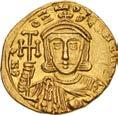


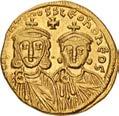


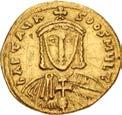

928. Constantine V Copronymus, with Leo IV and Leo III. 741-775. AV Solidus (21mm, 4.41 g, 6h). Constantinople mint. Struck 757-775. COҺSτAҺτIҺOS S LЄOҺ O ҺЄO ß, crowned and draped busts of Constantine V and Leo IV facing; cross above, • between / C LЄ ON PA MЧL, crowned bust of Leo III facing, wearing loros, holding cross potent in right hand. DOC 2f/2d (obv./rev.); Füeg 6.B.4; SB 1551. Lustrous, slight die shift on obverse. Near EF. ($500)
929. Constantine V Copronymus, with Leo IV and Leo III. 741-775. AV Solidus (19mm, 4.32 g, 6h). Constantinople mint. Struck 757-775. COҺSτAҺτIҺOS S LЄOҺ O ҺЄOS, crowned and draped busts of Constantine V and Leo IV facing; cross above, • between / C LЄ ON PA MЧL, crowned bust of Leo III facing, wearing loros, holding cross potent in right hand. DOC 2d; Füeg 6.A; SB 1551. Lustrous, a few light marks. Near EF. ($500)
928 929 930 931
930. Constantine V Copronymus, with Leo IV and Leo III. 741-775. AV Solidus (20.5mm, 4.41 g, 6h). Constantinople mint. Struck 757-775. COҺSτAҺτIҺOS S LЄOҺ O ҺЄOS, crowned and draped busts of Constantine V and Leo IV facing; cross above, • between / C LЄ ON PA MЧL, crowned bust of Leo III facing, wearing loros, holding cross potent in right hand;. DOC 2d; Füeg 6.A; SB 1551. Lustrous, a few light marks. Good VF. ($500)
931. Leo IV the Khazar, with Constantine VI, Leo III, and Constantine V. 775-780. AV Solidus (20mm, 4.43 g, 6h). Constantinople mint. Struck 778-780. LЄOҺ [VS S ЄςςOҺ COҺSτAҺτIҺOS O] ҺЄOß, Leo IV and Constantine VI enthroned facing, each wearing crown and chlamys, and holding akakia in right hand; cross above / [LЄ]OҺ PAP COҺSτAҺτIҺOS PAτHR, crowned facing busts of Leo III and Constantine V, each wearing loros; cross above, [•] between. DOC 2; Füeg 1.B.2 (Constantine VI); SB 1584. Some areas of weakness. Good VF. ($500)


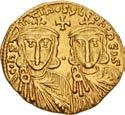
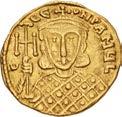
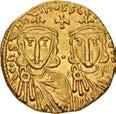




From the S & S Collection.
932. Constantine VI & Irene. 780-797. AV Solidus (19.5mm, 4.51 g, 6h). Constantinople mint. Struck 792-797. IRIҺH AΓOVSτI, crowned facing bust of Irene, wearing loros, holding globus cruciger in right hand and cruciform scepter in left / COҺSτAҺ τIҺOS ЬAS´, crowned facing bust of Constantine, wearing chlamys, holding globus cruciger in right hand and akakia in left; Θ at end of legend. DOC 3a; Füeg 5.A; SB 1594. Lustrous, a few light marks, some weakness in periphery. Near EF. ($2000)
933. Constantine VI & Irene. 780-797. AV Solidus (19.5mm, 4.43 g, 7h). Constantinople mint. Struck 792-797. IRIҺH AΓOVSτI, crowned facing bust of Irene, wearing loros, holding globus cruciger in right hand and cruciform scepter in left / COҺSτAҺ τIҺOS ЬAS´, crowned facing bust of Constantine, wearing chlamys, holding globus cruciger in right hand and akakia in left; Θ at end of legend. DOC 3a; Füeg 5.A; SB 1594. Lustrous, double strike on obverse, a few marks. Good VF. ($2000)

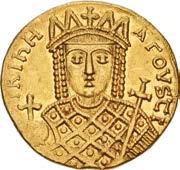





934. Irene. 797-802. AV Solidus (18.5mm, 4.46 g, 6h). Constantinople mint. Struck 797-802. [ЄIP]IҺH ЬASILISSH, crowned facing bust of Irene, wearing loros, holding globus cruciger in right hand and cruciform scepter in left / • ЄIPIҺH ЬASILISSH, crowned facing bust of Irene, wearing loros, holding globus cruciger in right hand and cruciform scepter in left; X at end of legend. DOC 1c; Füeg 1.B; SB 1599. Underlying luster, some minor weakness on obverse, a few die breaks on obverse. Good VF. ($2000)
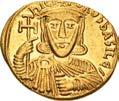

935. Irene. 797-802. AV Solidus (18.5mm, 4.38 g, 6h). Constantinople mint. Struck 797-802. ЄIPIҺH ЬASILISSH, crowned facing bust of Irene, wearing loros, holding globus cruciger in right hand and cruciform scepter in left / • ЄIPIҺH ЬASILISSH, crowned facing bust of Irene, wearing loros, holding globus cruciger in right hand and cruciform scepter in left; X at end of legend. DOC 1c; Füeg 2.A; SB 1599. Underlying luster, area of minor roughness and a few light scratches on obverse. EF. ($3000)


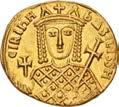

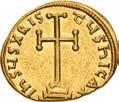
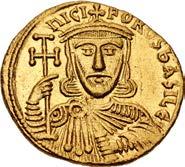


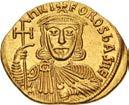

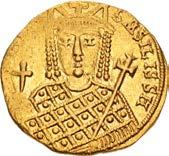



936. Nicephorus I. 802-811. AV Solidus (19.5mm, 4.44 g, 6h). Constantinople mint. Struck 802-803. ҺICI FOROS ЬASILЄ’, crowned facing bust, wearing slight beard and chlamys, holding cross potent in right hand and akakia in left / IҺSЧS XRIS τЧS ҺICA, cross potent set upon three steps; X at end of legend. DOC 1b; Füeg 1.B; SB 1603. Some scratches and marks. Good VF. ($1000)
937. Nicephorus I, with Stauracius. 802-811. AV Solidus (19.5mm, 4.42 g, 6h). Constantinople mint. Struck 803-811. ҺICI FOROS ЬASILЄ´, crowned bust of Nicephorus facing, wearing slight beard and chlamys, holding cross potent in right hand and akakia in left / SτAVRA CIS ∂ЄSPO´, crowned bust of Stauracius facing, wearing chlamys, holding globus cruciger in right hand and akakia in left; X at end of legend. DOC 2c; Füeg 2.A.2; SB 1604. Underlying luster, a couple faint hairlines, tiny deposit on reverse. Near EF. ($1000)
938. Nicephorus I, with Stauracius. 802-811. AV Solidus (21mm, 4.40 g, 6h). Constantinople mint. Struck 803-811. ҺICI FOROS ЬASILЄ´, crowned bust of Nicephorus facing, wearing slight beard and chlamys, holding cross potent in right hand and akakia in left / SτAVRA CIS ∂ЄSPO´, crowned bust of Stauracius facing, wearing chlamys, holding globus cruciger in right hand and akakia in left; X at end of legend. DOC 2c; Füeg 2.A.2; SB 1604. Lustrous, double strike on reverse. EF. ($500)
939.
1b; Füeg 1.A; SB 1615. Lustrous, well struck and centered, one of the finest known. Superb EF. Very Rare. ($30,000)
From the Mystras Collection. Ex Nomos 3 (10 May 2011), lot 254.
A high court official, Michael Rhangabe seized power when Nicephorus I was killed in battle. Michael raised his eldest son Theophylactus as co-emperor and reversed the iconoclast policies of his predecessor. In 812 he recognized Charlemagne as emperor of the West in return for Venice returning to Byzantine control; the Venetians, however, ignored the edict. Early in 813, Michael mounted a campaign against the Bulgarians, but they routed his army. In the aftermath, Michael abdicated and named the general Leo V as his successor. Michael took monastic vows and died peaceably as a monk 30 years later. His coinage in all metals is very rare.
940. Leo V the Armenian, with Constantine. 813-820. AV Solidus (21mm, 4.42 g, 6h). Constantinople mint. LЄ OҺ ЬASILЄЧS, crowned facing bust of Leo, wearing chlamys, holding cross potent in right hand and akakia in left / COҺSτ AҺτ´ ∂ЄSP´, crowned facing bust of Constantine, wearing chlamys, holding globus cruciger in right hand and akakia in left; X at end of legend. DOC 3b.1; Füeg 2.B.2; SB 1627. Lustrous, double strike on reverse, light scratches, minor die break, area of flat strike. EF. ($1000)

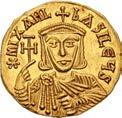

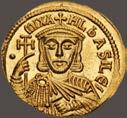




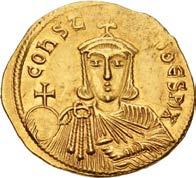



From the S & S Collection.
941. Michael II the Amorian, with Theophilus. 820-829. AV Solidus (19.5mm, 4.41 g, 6h). Constantinople mint. Struck 821-829. * mIXAHL ЬASILЄЧS, crowned and draped facing bust of Michael, holding cross potent in right hand and akakia in left / ΘЄOFI LO ∂ЄSP´ +, crowned facing bust of Theophilus, wearing loros, holding globus cruciger in right hand and cruciform scepter in left; X at end of legend. DOC 5b; Füeg 4.A.2; SB 1640. Lustrous. EF. ($3000)
From the S & S Collection, purchased from Freeman & Sear.
942. Theophilus. 829-842. AV Solidus (19.5mm, 4.50 g, 6h). Constantinople mint. Struck 829-830-831. * ΘЄOFI LOS ЬASILЄ´, crowned facing bust, wearing slight beard and loros, holding globus cruciger in right hand and cruciform scepter in left / CVRIЄ ЬOHΘH τO SO ∂OVLO, patriarchal cross set on three steps; *Є at end of legend. DOC 1a; Füeg 1.A.1; SB 1655. Underlying luster, trace deposits on reverse. EF. ($3000)



From the S & S Collection.
943. Theophilus. 829-842. AV Semissis (12mm, 1.79 g, 6h). Syracuse mint. Struck 829-circa 830. ΘЄO FILOS ЬA, crowned facing bust, wearing loros, holding globus cruciger in right hand / * ΘЄO FILOS ЬA, crowned facing bust, wearing chlamys, holding globus cruciger in right hand. DOC 19; Anastasi 544; SB 1676. Choice EF. ($500)
From the S & S Collection.
944. Theophilus. 829-842. AV Semissis (11.5mm, 1.78 g, 6h). Syracuse mint. Struck 829-circa 830. ΘЄO FILOS ЬA, crowned facing bust, wearing loros, holding globus cruciger in right hand / * ΘЄO FILOS ЬA, crowned facing bust, wearing chlamys, holding globus cruciger in right hand. DOC 19; Anastasi 544e (same dies); SB 1676. Minor flan flaws, a few faint scratches. EF. ($500)
From the S & S Collection.
945. Theophilus. 829-842. AV Solidus (15.5mm, 3.90 g, 6h). Syracuse mint. Struck 831-842. ΘЄ OFILOS, crowned facing bust, wearing loros, holding cross potent in right hand / ΘЄO FILOS, crowned facing bust, wearing chlamys, holding globus cruciger in right hand. DOC 24; Anastasi 530b; SB 1670. Minor die rust. EF. ($750)


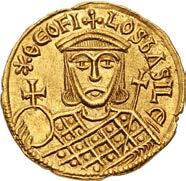



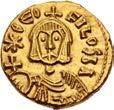

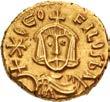



From the S & S Collection.


946. Michael III “the Drunkard”, with Theodora and Thecla. 842-867. AV Solidus (19.5mm, 4.37 g, 7h). Constantinople mint. Struck 842-circa 843. + ΘЄO∂O RA∂ЄSPVҺA, crowned facing bust of Theodora, wearing loros, holding patriarchal globus cruciger in right hand and cruciform scepter in left / • mIXAHLS Θ ЄCLA, crowned facing bust of Michael, wearing chlamys, and holding globus cruciger in right hand, and half-length figure of Thecla, to right, wearing loros, and holding patriarchal cross in right hand and akakia in left. DOC 1e; Füeg 1.A.1 (this coin); SB 1686. EF. Very rare. ($15,000)
From the S & S Collection, purchased from Freeman & Sear, circa 2003-2004.
947. Michael III “the Drunkard”. 842-867. AV Semissis (13mm, 1.76 g, 5h). Syracuse mint. Struck 842-866. mI XAHΛΘ, crowned facing bust, wearing loros, holding patriarchal globus cruciger in right hand / mI XAHLΘ, crowned facing bust, wearing chlamys, holding patriarchal globus cruciger in right hand. DOC 9; Anastasi 563d; SB 1694. Iridescent tone. EF. ($500)
From the S & S Collection.
948. Basil I the Macedonian, with Constantine. 867-886. AR Miliaresion (24.5mm, 2.95 g, 1h). Constantinople mint. Struck 868-879. IҺSЧS XRI SτЧS ҺIC A, cross potent set on three steps on globe / + ЬASI/ LIOS CЄ/ COҺSτAҺ/ τIҺ PISτV/ ЬASILIS/ ROMЄO´. DOC 7; SB 1708. Toned, slight die shift on reverse, stains. EF. ($500)

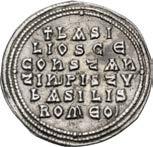
From


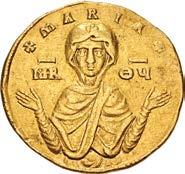




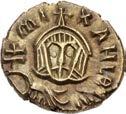


949.
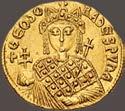
950. Leo VI the Wise, with Constantine VII. 886-912. AV Solidus (19.5mm, 4.32 g, 7h). Constantinople mint. Struck 908-912. + IҺS XPS RЄX RЄ Ų NANTIЧm, Christ Pantokrator enthroned facing, raising hand in benediction and holding Gospels / LЄOҺ ЄT COҺS†AҺ†´ AЧ ŲŲ ´ ROm´, Leo and Constantine standing facing, both crowned and wearing loros decorated with a cross at end, each holding globus cruciger and patriarchal cross between them. DOC 2; Füeg 3.B.4; SB 1725. Some light scratches, trace deposits. Good VF. ($1500)
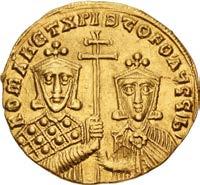


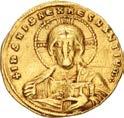
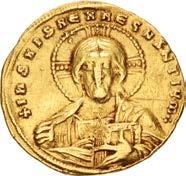




From the S & S Collection.
951. Constantine VII Porphyrogenitus, with Romanus I and Christopher. 913-959. AV Solidus (21mm, 4.31 g, 6h). Constantinople mint. Struck 921-931. +IҺS XPS RЄX RЄ Ų NANτIЧM *, Christ Pantokrator enthroned facing, raising hand in benediction and holding Gospels / ROMAҺ´ ЄT XPISτOFO´ AЧ ŲŲ ´ Ь´, crowned facing busts of Romanus, wearing loros, and Christopher, wearing chlamys, holding patriarchal cross between them. DOC 7; Füeg 7.B.1; SB 1745. Underlying luster, double strike on reverse, light edge scuff. Near EF. ($1500)
From the S & S Collection.
952. Constantine VII Porphyrogenitus. 913-959. AV Solidus (19.5mm, 4.47 g, 6h). Constantinople mint. Struck January-April 945. +IҺS XPS RЄX RЄ Ų NANTIЧM *, facing bust of Christ Pantokrator / +COҺSτAҺ τ´ AVτ´ CRAτ ЬR´, crowned facing bust of Constantine VII, wearing ornate jeweled loros, and holding patriarchal globus cruciger in right hand. DOC 13b; Füeg 13.B; SB 1747. Scratches, minor die break on reverse, deposits. VF. Very Rare. ($10,000)


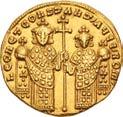

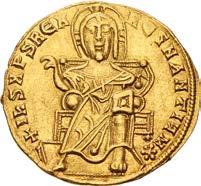
From the S & S Collection.
953. Constantine VII Porphyrogenitus, with Romanus II. 913-959. AV Solidus (20.5mm, 4.42 g, 6h). Constantinople mint. Struck 945-959. + IҺS XPS RЄX RЄ Ų NANTIЧM, facing bust of Christ Pantokrator, three pellets in each arm of nimbus / COҺSτAҺτ´ CЄ ROMAN´ AЧ ŲŲ IR, crowned facing busts of Constantine, wearing loros, and Romanus, wearing chlamys, holding patriarchal cross between them. DOC 15.8; Füeg 15; SB 1751. Lightly clipped, usual minor doubling, some minor marks and die marks, a few minor scratches, some light deposits in devices. Good VF. A wonderful bust of Christ. ($750)
From the DMS Collection. Ex Stack’s Bowers Galleries (30 October 2014), lot 365.
954. Constantine VII Porphyrogenitus. 913-959. PB Seal (31mm, 18.53 g, 12h). [+ IҺSUS X]RISTҺS +, facing bust of Christ Pantokrator / [+ C]OҺ[SτAτ AVτ(...)], crowned facing bust of Constantine VII, weraring loros and holding patriarchal globus cruciger. BLS 70; DOCBS 63-4. Brown and gray patina, earthen encrustation, some weakness. Good VF. ($1000)
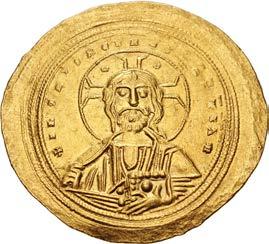
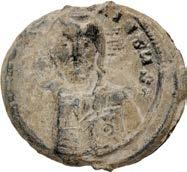


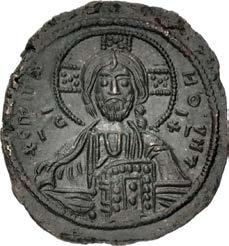

955. Basil II Bulgaroktonos, with Constantine VIII. 976-1025. AV Histamenon Nomisma (28.5mm, 4.44 g, 7h). Constantinople mint. Struck 1005-1025. + IҺS XIS RЄX RЄ Ų NANTIҺm, facing bust of Christ Pantokrator; crescents in upper quarters of nimbus / + ЬASIL Є COҺSτAҺτ IЬR, crowned half-length busts of Basil, wearing loros, with suspended crown above head, and Constantine, wearing chlamys, holding long cross between them. DOC 6a; Füeg II 6.B; SB 1800. Lustrous, double strike on obverse, a few minor scratches, die break on reverse. EF. Struck on a broad flan. ($1500)


From the S & S Collection.
956. Anonymous Folles. temp. Basil II & Constantine VIII, circa 1020-1028. Æ Follis (25mm, 10.24 g, 6h). Class A3. Constantinople mint. + ЄMMA NOVHΛ, facing bust of Christ Pantokrator; two pellets on book, five pellets in bars of nimbus; IC XS, each with macron above, flanking head of Christ / + IҺSЧS XRISTЧS ЬASILЄЧ ЬASILЄ in four lines. DOC A2.39; SB 1818. Brown-green surfaces. EF. ($1000)


From the Iconodule Collection.
957. Anonymous Folles. temp. Basil II & Constantine VIII, circa 1020-1028. Æ Follis (26mm, 10.14 g, 6h). Class A3. Constantinople mint. + ЄMMA NOVHΛ, facing bust of Christ Pantokrator; two pellets on book, five pellets in bars of nimbus; IC XS, each with macron above, flanking head of Christ / + IҺSЧS XRISTЧ[S] ЬASILЄ[Ч] ЬASILЄ in four lines. Cf. DOC A2.39; SB 1818. Brown-green surfaces, some minor cleaning scratches. EF. ($1000)
From the Iconodule Collection.

958 959
958. Constantine VIII. 1025-1028. AV Histamenon Nomisma (23mm, 4.39 g, 6h). Constantinople mint. + IҺS XIS RЄX RЄ Ų NANTIҺm, facing bust of Christ Pantokrator; crescents in upper quarters of nimbus / + CωҺ SτAҺτIҺ ЬASILЄ*S ROm, crowned facing bust of Constantine, wearing jeweled loros, holding labarum in right hand and akakia in left. DOC 1; Füeg II 1.A.6; SB 1815. Some marks and scratches, minor die breaks. Good VF. ($500)
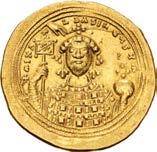


From the S & S Collection.
959. Romanus III Argyrus. 1028-1034. AV Histamenon Nomisma (24mm, 4.44 g, 6h). Constantinople mint. + IҺS XIS RЄX RЄ Ų NANTIҺm, Christ Pantokrator enthroned facing / ΘCЄ ЬOHΘ RωmΛҺω, Romanus, placing right hand on breast and holding globus cruciger in left, standing facing, being crowned and blessed by the Theotokos; three pellets in loros end; M Θ, each with macron above, in upper field. DOC 1; Füeg II 1.D.3.y; SB 1819. Lustrous, slight die shift, die breaks on obverse. EF. ($1000)
From the Iconodule Collection.
960. Michael IV the Paphlagonian. 1034-1041. AV Histamenon Nomisma (25mm, 4.44 g, 6h). Constantinople mint. + IҺS XIS RЄX RЄ Ų NANTIҺm, facing bust of Christ Pantokrator / + mIX A H L ЬASILЄЧS Rm, crowned facing bust of Michael, wearing ornate jeweled loros, holding labarum in right hand and globus cruciger in left, being crown by manus Dei above. DOC 1e.2; Füeg II 1.C.3; SB 1824. Lustrous, light scratches, die breaks, minor indentation on obverse. EF. ($1500)







From the S & S Collection.
961. Constantine IX Monomachus. 1042-1055. AV Histamenon Nomisma (22.5mm, 4.40 g, 6h). Constantinople mint. Struck 1054-1055. + IhS XIS RЄX RЄ Ų NANTIҺm, facing bust of Christ Pantokrator / + CωnSτAnτ ҺOS bASILЄЧS Rm, crowned facing bust of Constantine, holding globus cruciger in right hand and sword in left; two stars flanking crown. DOC 4b; Füeg II 4.B.2; SB 1831. Underlying luster, clipped. EF. ($3000)

The meaning of the stars that appear on these rare histamena flanking the imperial bust has been a matter of much scholarly speculation. Hendy (DOC III, p. 734) suggested that they represented the 1054 appearance of supernova SN 1054, a celestial event that was widely seen and recorded by Chinese, Japanese, and Arab astronomers, as well as the Mimbres and Anasazi in North America, and possibly in contemporary Irish chronicles. Since it was visible even in daylight from when it first appeared in the constellation of Taurus on 4 July 1054 until it disappeared in April 1056, Grierson (DOC III, p. 736) concluded that it could not have escaped the notice of anyone interested in astronomy and “may conceivably have found its way onto the coins [since] the dates, at all events, seem to agree.”
962. Constantine IX Monomachus. 1042-1055. AV Tetarteron Nomisma (17.5mm, 4.05 g, 6h). Constantinople mint. + IҺS XIS RЄX RЄ Ų NANTIҺm, facing bust of Christ Pantokrator / + CωҺS AҺτҺ BASILЄЧ Rm, crowned facing bust of Constantine, wearing jeweled chlamys, holding scepter surmounted by trefoil in right hand and globus cruciger in left. DOC 5a; Füeg II 5.A.2; SB 1832. Minor die marks on reverse. Near EF. ($1500)
From the S & S Collection. Ex Jürgen K. Schmidt Collection (Triton V, 16 January 2002), lot 2306; Classical Numismatic Group 35 (20 September 1995), lot 1322.
963. Theodora. 1055-1056. AV Histamenon Nomisma (24mm, 4.38 g, 6h). Constantinople mint. + IҺS XIS RЄX RЄ Ų NANTIҺm, Christ standing facing on suppedion, holding Gospels / + ΘЄOΔωPA AVΓOVCT, Theodora and the Theotokos standing facing, holding between them a labarum with pellet on shaft; M Θ, each with macron above, flanking the Theotokos’ head. DOC 1a; Füeg II 1.A; SB 1837. Light scrape on reverse, a few minor die marks, trace deposits. Near EF. ($2000)
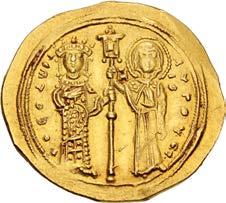

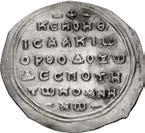

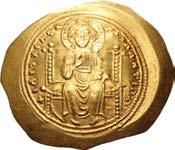





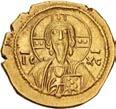
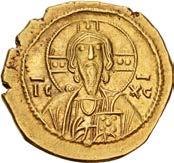
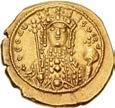

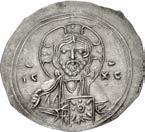
From the S & S Collection. Ex Jürgen K. Schmidt Collection (Triton V, 16 January 2002), lot 2307; New York Sale III (7 December 2000), lot 815.
964. Theodora. 1055-1056. AV Tetarteron Nomisma (18.5mm, 4.03 g, 6h). Constantinople mint. Facing bust of Christ Pantokrator; IC XC, each with macron above, flanking the head of Christ / + ΘЄOΔω AVCOT, facing bust of Theodora, wearing crown with pendilia, saccos, and loros, holding jeweled scepter in right hand and globus cruciger in left. DOC 2 var. (legend); Füeg II 2.y var. (same); SB 1838. Minor deposits. Good VF. ($2000)
965.
From
966.
From the S & S Collection.
967. Romanus IV Diogenes, with Eudocia, Michael VII, Constantius, and Andronicus. 1068-1071. AV Histamenon Nomisma (26mm, 4.42 g, 6h). Constantinople mint. KωN MX ANΔ, Michael standing facing, holding in right hand labarum and akakiain left, between Constantius and Andronicus, each holding globus cruciger and akakia; each ruler standing on suppedion / + PωMAN~ ЄVΔKRPM, Christ standing facing on suppedion, crowning Romanus to right and Eudocia to left, each holding globus cruciger; IC XC, with macron above each, flanking head of Christ. DOC 1; SB 1859. Well struck. Good VF. ($500)
968. Michael VII Ducas. 1071-1078. EL Histamenon Nomisma (29.5mm, 4.41 g, 6h). Constantinople mint. Facing bust of Christ Pantokrator, holding gospels with cover decorated by nine pellets, four pellets around singular square in bars of nimbus, IC XC, each with macron above, flanking head of Christ; all within double border / + MIX AHA RACIΛOΛ, crowned facing bust of Michael, wearing jeweled loros, holding labarum with pellet on shaft in right hand and globus cruciger in left; all within double border. DOC 2d; SB 1868. Well struck portraits, some doubling. Near EF. ($500)
969. Isaac II Angelus. First reign, 1185-1195. EL Aspron Trachy (29.5mm, 4.07 g, 6h). Constantinople mint. The Theotokos enthroned facing, holding head of the Holy Infant on lap; MP ΘV, each with macron above, flanking head / [...] CΔЄC [...] X [...], Isaac, wearing chlamys with six jewels on collar, holding cruciform scepter and akakia, being crowned by St. Michael the Archangel, holding jeweled scepter; Q between. DOC 2c.9/2c (obv./rev.); SB 2002. Toned, clipped. EF. ($750)


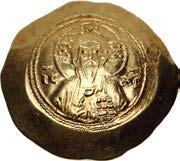


From the S & S Collection.
967 968 970 971
970. John Comnenus-Ducas. As emperor of Thessalonica, 1237-1242. BI Trachy (22.5mm, 3.03 g, 3h). Series II. Thessalonica mint. Ornate eight-rayed cross / John standing facing, holding sword in right hand and model of city in left; Iω to left, ΔЄ to right. Cf. DOC 30 (as series II); cf. CLBC 14.20.3; (same); cf. SB 2216 (same). Green-brown surfaces, minor edge splits. VF. Unpublished as Series II. ($1500)

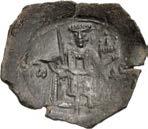

Ex Numismatik Naumann 107 (3 September 2021), lot 666.
971. John Comnenus-Ducas. As emperor of Thessalonica, 1237-1242. BI Trachy (22mm, 1.61 g, 6h). Thessalonica mint. Facing bust of Christ Pantokrator holding scroll in left hand, one pellet in bars of nimbus, IC XC, each with macron above, flanking head of Christ; • | • / [...] OAΓ[IOC ΔMIT], half-length figures of John, wearing loros, and St. Demetrius, wearing military tunic, standing facing, holding patriarchal cross between them. DOC –; cf. Bendall, Notes, Type 3; SB –. Green-brown surfaces, scratches. Near VF. Unpublished in the standard references and apparently unique. ($1000)
Ex Roma 88 (9 September 2021), lot 1552.

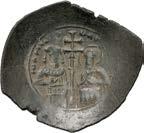
972. Liberos. sebastos, 13th century. PB Seal (39mm, 42.99 g, 12h). Daniel in the Lions’ Den: Daniel standing facing, orans; lion standing on either side at feet; O/(ΠP)/OΦI/TH/C to left; Δ/A/NI/HΛ to right / +/KPITHC ΔA/ИIHΛ KAI ΓP/AΦω(ИИ)VИΠ/PO(CT)TA(TH)C TЄΛЄI/CEBA(CT)(OY)ΛIBP(OY)/(ΠP)AξЄIC KPI/ИWИ (triple pellets) in eight lines. BLS –; DOCBS –; Dumbarton Inv. BZS.1951.31.5.2. Earthen brown and gray patina, minor surface break on reverse. EF. In a very good state of preservation, with all details visible and sharp. ($1500)





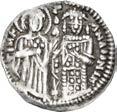

973. John V Palaeologus. 1341-1391. AR Basilikon (18.5mm, 1.23 g, 12h). Constantinople mint. Struck 1341-1347. IωA[...], half-length figure of John V, holding cross potent and globus cruciger, above figure of Christ with hands outstretched; IC [XC], each with macron above, flanking head of Christ / TIMΔ ANΔPONIK, St. Demetrius, holding cross before chest, and Andronicus, orans, standing facing; Γ/O/A between. DOC 944; LBC 846; LPC p. 120, 7 var. (legend; Andronicus III); SB 2474 (Andronicus III). Toned. Good VF. Very rare. ($1500)
From the S & S Collection. Ex Triton V (16 January 2002), lot 2318.
974 975
974. John V Palaeologus, with Anna of Savoy (Regent). 1341-1391. AR Basilikon (19.5mm, 0.95 g, 6h). Constantinople mint. Struck 1341-1347. Christ Pantokrator enthroned facing; IC XC, each with macron above, flanking head of Christ / ANNA [...]NXω, Anna standing facing to left, holding trefoil scepter in right hand, and John, standing facing to right, holding akakia in left hand and cruciform scepter in right; [...]ω between. DOC 1109–13; LBC 847; LPC p. 132, 2; PCPC 277; SB 2503; S. Bendall, “A Hoard of Silver Basilika of Andronicus III and John V” in CH III, 10 (this coin). Toned. Good VF. ($1000)
From the S & S Collection. Ex James Fox Collection (Classical Numismatic Group 40, with Numismatica Ars Classica, 4 December 1996), lot 1961; William Herbert Hunt Collection (Sotheby’s New York, 5 December 1990), lot 959; Chios, Greece, 1975 Hoard (CH III, 254).
975. John V Palaeologus. 1341-1391. AR Stavraton (25mm, 8.32 g, 7h). Constantinople mint. Struck 1379-1391. Facing bust of Christ Pantokrator; IC XC, each with macron above, flanking head of Christ; sigla: lis | lis / [...]AVT OKPATOP ΘV XAPITI BACIΛ, crowned facing bust of John. DOC 1278–85; LBC 895–7; PCPC 327.1-2; SB 2510. Near EF. Well struck and good metal. ($1000)

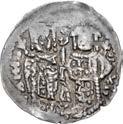
From the Iconodule Collection.

976. John VI Cantacuzene. Second reign, 1353-1354. AR Basilikon (17.5mm, 0.75 g, 6h). Constantinople mint. Christ Pantokrator enthroned facing, IC XC, each with macron above, flanking head of Christ; K to left, И to right / John, raising hands in adoration, and St. Demetrius, holding cross, standing slightly facing one another; KTKZN downward to left, Γ/ Ο/ Δ between, Δ˙[TP] to right. DOC 1205 var. (sigla); LPC p. 148, 1 var. (same); PCPC 301 var. (same); SB 2540. Bright surfaces, double struck on reverse. EF. Rare. ($1000)




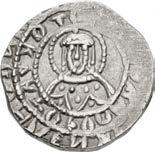
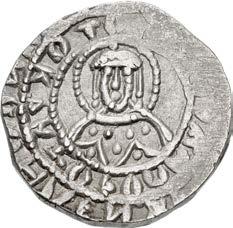






977. John VI Cantacuzene, with Matthew. Second reign, 1353-1354. AR Half Basilikon (13.5mm, 0.48 g, 6h). Uncertain Thracian (Adrianople?) mint. Struck 1355(?). Half-length facing bust of the Archangel Michael, holding palm frond and sword set in scabbard, set above city walls; X˙ above; to right, uncertain holy figure standing left, raising hand in benediction and holding Gospels; (FP) in field between / Matthew, crowned and wearing loros. standing facing, holding crosstipped scepter; ACNC to left. KTKξN to right. Cf. DOC p. 190-191 (for discussion); G&F 4a (same obv. die); S. Bendall, “A New Coin of Matthew Asen Cantacuzenus” in NumCirc XCV.2 (March 1987), p. 40, fig. 1; PCPC 304; LBCA –; SB 2543. Toned, slightly ragged edge, some light scratches. VF. Extremely rare, with six currently known. ($3000)
From the Iconodule Collection.
978. Manuel II Palaeologus. 1391-1425. AR Stavraton (24.5mm, 8.04 g, 7h). Constantinople mint. Struck 13911394/1395. Facing bust of Christ Pantokrator; IC XC, each with macron above, flanking head of Christ; sigla: lis | C / [M]AИOVHΛ ЭNX[...] / [...]TOKPATOP ΘV A[...], crowned facing bust of Manuel. DOC 1305 var. (arrangement of sigla); LBC 903 var. (same); LPC p. 160, 1; SB 2548. Near EF. Well struck. ($1000)
From the Iconodule Collection.
979. Constantine XI Palaeologus (Dragases). 1448-1453. AR Stavraton (21.5mm, 6.54 g, 1h). Constantinople mint. Facing bust of Christ Pantokrator; IC X[C], each with macron above, flanking head of Christ; sigla: – | – / [KωNCTANTINOC ΔЄCΠOTHC O ΠAΛЄOΛOΓ] / [ΘV XAPITH BACIΛЄVC POMЄON], crowned facing bust of Constantine XI. DOC 1787 var. (sigla); Bendall, Coinage 97 (this coin); LBC 1095 var. (sigla); PCPC –; SB –. Toned, traces of find patina, some scratches, areas of weak strike, slightly off center on obverse. EF. Very rare. ($20,000)
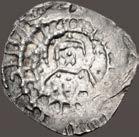
From the S & S Collection. Ex Constantine XI hoard (1991).
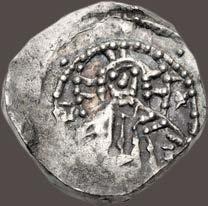
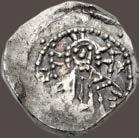
By the time the last Byzantine emperor, Constantine XI, succeeded his brother John VIII on the throne, the Byzantine Empire consisted of a small parcel of land in Morea and the city of Constaninople. When the Ottoman sultan Mehmed II finally decided to eliminate what had become a minor nuisance to the Turks, the final result was inevitable. Constantinople was taken by siege, and Constantine died fighting at the battlements, rejecting the pleas of his courtiers to flee to safety. His heroic and gruesome death (his body was so mutilated that it was only identifiable by his clothing) led to a popular legend that Constantine had never died, and would return at some point in the future to free Greece from her conquerors. These last coins of the Byzantine Empire are especially rich in history. Several contemporary sources specifically tell us that Constantine ordered sacred vessels to be removed from churches and melted down to strike coins as payment to his soldiers (Bendall pp. 140-141).
The Constantine XI hoard, published by Simon Bendall in 1991, consisted of 158 late Palaeologan silver issues. Over half of the hoard was attributable to Constantine XI, the last Byzantine ruler. Before 1974, when the first coin of Constantine XI appeared on the market, the coinage of Constantine XI was only known from historical sources. This hoard significantly improved and developed the numismatic understanding of the last coinage produced by the Byzantine Empire. A rare offering of a critically important former hoard coin essential to any late Palaeologan or Byzantine collection.


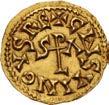

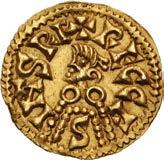


980. VISIGOTHS, Spain. Chindaswinth, with Recceswinth. 642-653. AV Tremissis (18.5mm, 1.52 g, 12h). Ispali (Seville) mint. Struck 649-653. ส ʽe⌐⌐e ⌽ Ʃ ñ ⌽ ʽe , diademed and draped bust left; ⌽ of legend on drapery / ส ⌐n⌽VƩnὸV⌽ ʽe , ƩSP±ǮƩ monogram. CNV 434; Pliego 568a; Miles, Visigoths 348a; Chaves 287 corr. (cross-referenced to Miles 348b); MEC 1, –; ME 374. Lightly toned, deposits in devices. EF. Very rare. ($5000)

981. BURGUNDIANS. Sigismund. 516-524. AV Solidus (21mm, 4.44 g, 6h). Imitating a 10th officina Constantinople mint issue of the Byzantine emperor Justin I. Uncertain (Lugdunum [Lyon]?) mint. ĕ n Ʃѝ⌽ͿƩ nѝ⌽ P P ©ѝ⌐ , pearldiademed, helmeted, and cuirassed bust facing slightly left, head right, holding spear over shoulder with right hand, on left arm a shield decorated with horseman motif / ѝƩ⌐Ϳ⌴ʽ Ʃ © ©ѝ⌐⌐⌐ , Victory standing left, holding staurogram cross in right hand; star to right; Ʃ⌽ // ⌐⌴n⌴B . J. Lafaurie, “Le trésor de Gourdon (Sâone-et Loire),” Bulletin de la Société nationale des antiquaires de France (1958), pp. 61-76; Belfort 5154; MEC 1, 340 (same dies). In NGC encapsulation 5785799-003, graded MS, Strike: 5/5, Surface: 4/5. ($5000)
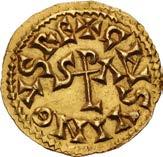
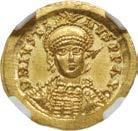


982.
Ex Sincona 70 (19 May 2021), lot 3172.
983. CAROLINGIANS. Pépin ‘le Bref’ (the Short). King of the Franks, 754/5-768. AR Denier (18mm, 1.10 g, 3h). Uncertain mint, possibly St. Denis. Large ⎁ ; ʖ ; above, ! with • at each end; • below ⎁ ; ˘ below ʖ / ( ©V˶ )/ ˶⌴ባ ••/ Ⱦℽ in three lines between two ! with • at each end. Cf. Depeyrot 892/2; cf. M&G 47; cf. Gariel, pl. I, 1-7; cf. Prou 2-4; MEC 1, 720 (all refs. for type). In NGC encapsulation 2883255-001, graded AU 55. ($7500)
Ex Classical Numismatic Group 96 (14 May 2014), lot 1047.
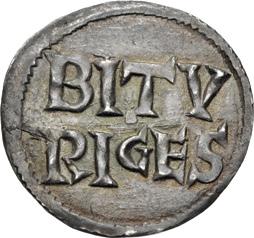
984. CAROLINGIANS. Charlemagne (Charles the Great). As Charles I, King of the Franks, 768-814. AR Denier (17mm, 0.90 g, 12h). Class 2. Lem[ovacium] (Limoges) mint. Struck 771-793/4. ⍛ A ⌴ / Ǯп⌽ in two lines / Ǯĩȵ across field; ! and Ḩ above, • ส • below. Coupland, Charlemagne –; Depeyrot 502; M&G 260 var. (pellet after ⌽ ); Gariel –; cf. MEC 1, 725 (for type). Find patina, minor roughness, struck on a slightly ragged flan. VF. Rare. ($5000)
Ex Künker 205 (12 March 2012), lot 1399.
985. CAROLINGIANS. Charlemagne (Charles the Great). As Charles I, King of the Franks, 768-814. AR Denier (18mm, 1.27 g, 1h). Class 2. Medolus (Melle) mint. Struck 771-793/4. ⍛ A ⌴ /·/ ǮVs in three lines / Mĩ⍷⌴ 8 Vs around central ornament. Coupland, Charlemagne 4; Depeyrot 605; M&G 268; Gariel 91; MEC I, 727. Iridescent toning. Good VF. ($3000)
986 987
CAROLINGIANS. Louis ‘le Pieux’ (the Pious). As Emperor Louis I, 814-840. AR Denier (21mm, 1.81 g, 5h). Class 2. Aquitania (Bourges) mint. Struck 819-822. แ ƊǮVē⌴VVIæVs I⍵ʖ , cross pattée / ±$VI / ˶±nI± in two lines; แ above and below. Coupland, Money, –; Depeyrot 178; M&G 390; MEC 1, 763-764. Iridescent toning. Near EF. ($1000)


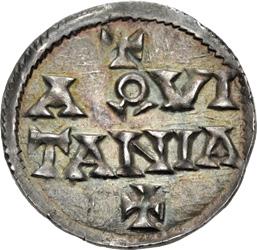




986.
Ex Joseph R. Lasser Collection for the benefit of The Colonial Williamsburg Foundation (Triton XVIII, 6 January 2015), lot 1392; purchased from Wade Hinderling, 5 April 2010.
987. CAROLINGIANS. Louis ‘le Pieux’ (the Pious). As Emperor Louis I, 814-840. AR Denier (21mm, 1.78 g, 8h). Class 2. Bituriges (Bourges) mint. Struck 819-822. แ ƊǮV⍷⌴VVIæVs I⍵⍷ , cross pattée / BI˶ѝ / ⎁IŶ⍟s in two lines; • between. Coupland, Money, –; Depeyrot 177; M&G 410; MEC 1, 766-767. Iridescent toning, slight bend in flan. Near EF. ($1000)


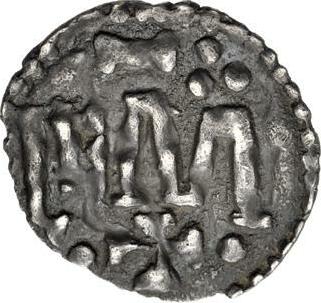
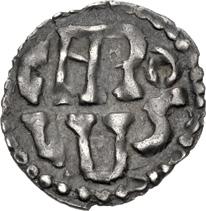
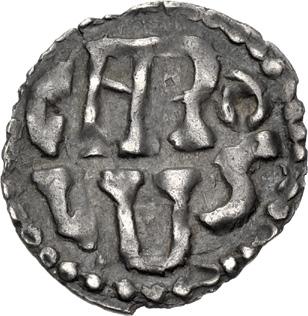


Ex Joseph R. Lasser Collection for the benefit of The Colonial Williamsburg Foundation (Triton XVIII, 6 January 2015), lot 1391; purchased from Wade Hinderling, 10 October 2009.

988. CAROLINGIANS. Louis ‘le Pieux’ (the Pious). As Emperor Louis I, 814-840. AR Denier (20mm, 1.63 g, 9h). Class 2. Venecias (Venice) mint. Struck 819-822. แ ƊǮVē⌴VVI⍛Vs IȤ , cross pattée / แ Ven / e⍛I²s in two lines. Coupland, Money –; Depeyrot 1116D; M&G 456; MEC 1, 789. Iridescent toning, slight ghosting on reverse. EF. ($1000) Ex Classical Numismatic Group XXXIII (15 March 1995), lot 1481.


989. CAROLINGIANS. Carloman. King of West Francia, 882-884. AR Denier (23mm, 1.63 g, 9h). Lemov[acium] (Limoges) mint. แ ⍛©ʽǮ⌴ȵ©n ʽeᛸ , cross pattée / แ ǮƩȵ⌴V ᛸ ⍛ƩVƩs , nj²⎁⌴ǮVs monogram. Depeyrot 509; M&G 1201; MEC 1, –. Light toning in devices, some very light ghosting on reverse otherwise very well struck on a large flan. EF. Very rare especially so fine. ($3000)

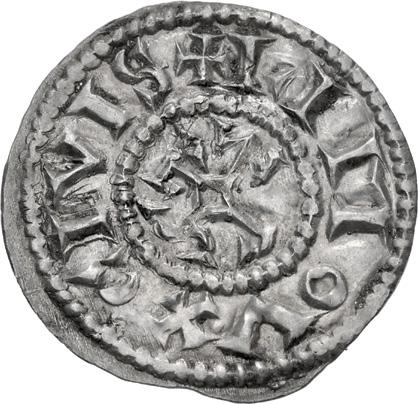



For early papal coins in the name of the Carolingian emperor, see lots 1095–7 in the World Coinage below.


990. CRUSADERS, Latin Kingdom of Jerusalem. Imitation Bezants. 11th-12th centuries. AV Bezant (24.5mm, 3.91 g, 12h). Imitating a dinar of the Fatimid caliph al-Amir. Acre mint. First phase, struck before 1148/59. al-imam/al-mansur in two lines across field; in two lines across field; in inner and outer margins, neatly inscribed illegible inscriptions; three annulets in inner margin; wide band between legends / al/ghaya in two lines across field; in inner and outer margins, neatly inscribed illegible inscriptions; wide band between legends. Balog & Yvon 26a; Metcalf, Crusades –; CCS 1. Lightly toned, traces of deposits in devices, a few hairlines, slight die rust, minor peripheral weakness. EF. ($2000)
Ex Chaponnière & Firmenich 14 (20 November 2021), lot 67.
Session 4 – Wednesday, January 11, 2023 — 2 PM

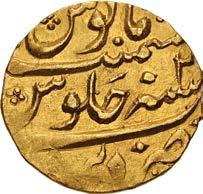






Struck at the recently captured city of Dera (mod. Dera Ismail Khan) in the
Pakhtunkhwa of
the figure on this extremely rare half mohur has been interpreted as a wolf. A more plausible option is that the image is that of a lion, present in the region until 1842. It is possible to associate the lion here with Ahmad Shah, who is depicted in two contemporary miniatures, seated under a canopy on a lion skin. His tomb epitaph also notes that “In his time, from the awe and glory of his greatness / The lioness nourished the stag with her milk.”
993.
994. AUSTRIA, Holy Roman Empire. Ferdinand I. Emperor, 1556-1564. AR Taler (40mm, 28.85 g, 8h). Jáchymov (Joachimstal) mint. Dated 1549. Crowned and armored bust right, holding scepter and hilt of sword / Nimbate eagle facing with wings spread, head left; coat-of-arms on breast. Vogelhuber 49/VII; Davenport 8046. Lustrous, with significant iridescent toning in devices, a few very light hairlines, minor edge marks. EF ($1500)

995. AUSTRIA, Holy Roman Empire. Ferdinand I. Emperor, 1556-1564. AR Taler (42mm, 28.73 g, 2h). Praha (Prague) mint. Dated 1558. Crowned and armored bust right, holding scepter and hilt of sword / Nimbate eagle facing with wings spread, head left; coat-of-arms on breast. Vogelhuber 55/II; Davenport 8035. Richly toned. Good VF. ($2000)





Ex Künker 134 (29 January 2008), lot 16.
996.
KM 264.5;
997. AUSTRIA, Holy
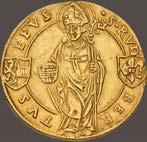
Empress, 1740-1780. AR Taler (41mm, 28.05 g, 12h). Wien (Vienna) mint. Dated 1765. Diademed and draped bust right / Crowned double headed eagle facing, wings spread, with crowned coat-of-arms on breast. Eypeltauer 74; Vogelhuber 281/IV; KM 1817; Davenport 1121. Toned, a few light adjustment marks. AU. ($500)


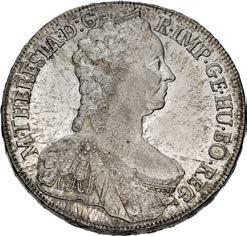
998. AUSTRIA, Austrian
I. 1848-1867.
AR Doppeltaler (41mm, 36.98 g, 12h). Commemorating the opening of the Vienna-Trieste railroad. Wien (Vienna) mint. Dated 1857 A. Laureate head right / Tower; steam engine and paddlewheel steamship flanking; below each, two coats-of-arms within floral sprays. Herinek 821v; KM 2246.2; Davenport 20. Deep cabinet toning with shades of orange and blue. In NGC encapsulation 6489299-004, graded PF 63. ($5000)
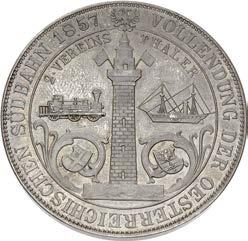
Though discussions of a rail connection from the capital to the Empire’s main seaport of Trieste were begun as early as 1829, the initial work would not begin until 1839. The line would ultimately be completed in 1857 with the construction of the final section through the Karst Plateau.
999. AUSTRIA, Salzburg
Lang von Wellenburg. 1519-1540. AV 3 Dukat (23mm, 10.61 g, 4h). Dated 1521. Bust right, wearing biretta and mozetta / St. Rupert standing facing, holding salt cellar and crozier; two coatsof-arms flanking. Zöttl 133; Probszt 148; Friedberg 583. Wiped, edge marks, nicks and scratches. Good VF. Extremely rare, apparently one of only two known. ($20,000)
Ex Numismatica Genevenensis 14 (15 November 2021), lot 220.
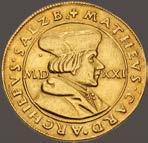



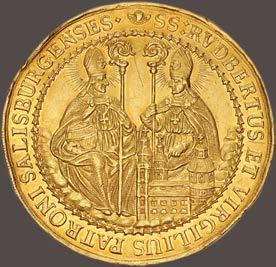


1001. BOLIVIA, Colonial (as Alto Perú). Carlos IV. King of Spain, 1788-1808. AV 8 Escudo (37mm, 12h). Potosí mint. Dated 1802 (PTS) PP. Armored and draped bust right / Crowned and collared coat-of-arms. Calicó 1322; KM 81; Friedberg 14. In NGC encapsulation 2733258-005, graded MS 62. ($2000)

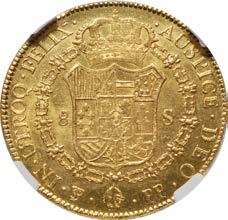
1002. BULGARIA, First Empire. Simeon I Veliki. 893-927. PB Seal (28mm, 32.59 g, 12h). + XЄ ROH[Θ C] VMЄωN APX ROV (sic), facing bust of Christ Pantocrator within pelleted border / [+ ΘKЄ ROHΘ CVMЄωN APXONTA POVΛΓAPIA], facing bust of the Theotokos. Iordanov Type III.2АБ, 35a; Youroukova & Penchev 4. Earthen brown and gray patina, areas of weakness, scrape on reverse. Fine. Very rare. ($1500)

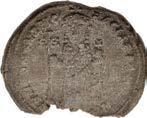

1003. BULGARIA, First Empire. Simeon I Veliki. 893-927. PB Seal (23mm, 9.37 g, 6h). + ЄTΛΛOП ‘OП



1004.

1005. BULGARIA, First Empire. Petar I. 927-969. PB Seal (25mm, 9.24 g, 12h). Facing bust of Christ Pantocrator; IC XC, each with macron above, across field / Crowned facing bust, wearing mantle and holding globus cruciger. Iordanov Type III.3, 111-12 var. (additional reverse legend); Youroukova & Penchev 14 var. (same). Brown and gray patina. VF. Extremely rare. ($3000)



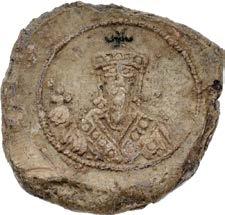
1006. BULGARIA, Tsardom. Ferdinand I. 1908-1918. AR 2 Leva (26mm, 6h). Vienna mint. Dated 1913. Bare head left / Denomination and date in three lines within wreath. CBC p. 27; KM 32. In PCGS encapsulation 42272323, graded MS 65+. ($500)



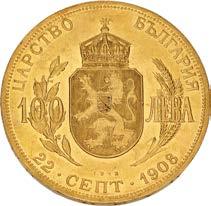
1007. BULGARIA, Tsardom. Ferdinand I. 1908-1918. AV 100 Leva (35mm, 32.24 g, 6h). Commemorating the Fourth Anniversary of Independence. Dated 22 September 1908 and 1912. Bare head left / Crowned coat-of-arms within wreath. KM 34; Friedberg 5. In NGC encapsulation 6489299-012, graded UNC Details, rev scratched. ($3000)
1008. COLOMBIA, Colonial. Carlos IV. King of Spain, 1788-1808. AV 8 Escudo (37mm, 12h). Popayán mint. Dated 1805 P JT. Armored and draped bust right / Crowned and collared coat-of-arms. Calicó 1249; KM 62.2; Friedberg 52. In NGC encapsulation 2804183-010, graded MS 62. ($2000)


1009. DENMARK. Frederik III. 1648-1670. AR Krone (42mm, 21.56 g, 2h). Københaven (Copenhagen) mint. Dated 1659. Crowned monogram set on clouds / Hand holding sword reaching from the clouds, cutting off outstreched hand to right reaching for Danish crown above. Hede 100A; KM 223; Davenport 3576. Toned, edge split. Good VF. ($750)


On 11 February 1659, the Danish repelled an attack on Copenhagen by the Swedes. The reverse imagery on this coin colorfully illustrates the result of the battle, in which the Danish successfully held off the Swedish attempt to take the Danish crown.
1010. EGYPT, Ottomans. Isma’il. As pasha, AH 1280-1284 / AD 1863-1867. AV 500 Qirsh (38mm, 42.78 g, 12h). Misr (Cairo) mint. Dually dated AH 1277 and RY 8 of ‘Abd al-’Aziz (1867). Toughra of A; floral spray to right; 500 sh in Arabic (value) below / zarb/fi/misr in Arabic in three lines; AH date below; RY above be of zarb. Damalı 32-MS-A1-8; Sultan –; Pere –; KM 265; Friedberg 16. Marks, slight edge flaw. Near EF. Very rare. Mintage of 200 pieces. AGW: 1.2018 oz. ($10,000)







1011 1012
1011. EGYPT, Ottomans. Isma’il. As khedive, AH 1284-1296 / AD 1867-1879. AV 100 Qirsh (22mm, 12h). Misr (Cairo) mint. Dually dated AH 1293 and RY 1 of Murad V (1876). AGW: 0.2404 oz. Toughra of Murad V; floral spray to right; 100 sh in Arabic (value) below / zarb/fi/misr in Arabic in three lines; AH date below; RY above be of zarb. Damalı 33-MS-A1-1; Sultan –; Pere –; KM 272; Friedberg 10. In NGC encapsulation 1525063-010, graded AU 50. ($750)
1012. EGYPT, Kingdom. Ahmad Fu’ad I. AH 1340-1355 / AD 1922-1936. Proof AV 5 Egyptian Pounds – 500 Piastres (37mm, 42.52 g, 12h). Dually dated AH 1348 and AD 1929 (in eastern Arabic numerals). AGW: 1.1956 oz. Bust left, wearing military uniform and tarboosh (fez) / Legend in Arabic; denomination above; dates below. KM 355; Friedberg 31. Circulation marks, hairlines. AU. ($2000)
1013. FRANCE, Royal. Philippe VI de Valois (of Valois). 1328-1350. AV Double d’or (34mm, 6.81 g, 10h). First emission, authorized 6 April 1340. ᛆ ʓƌ= ḽ ዝዞƱ ḽ gʼ¥ ᛆ ᛆ fʼ¥Ný ḽ ʼEҞ ᛆ , Philippe seated facing within gothic arch, holding short lis-tipped scepter in left hand and cruciform scepter in right / ๘ Ḻ Ҟʓ=ý ḭ ⎍ƟɃýƟͿ ḭ Ҟʓ=ý ḭ ʼĿgɃ¥Ϳ ḭ Ҟʓ=ý ḭ ƟዦʓĿʼ¥Ϳ , cross fleurée over voided short cross potent, with voided quatrefoil at center and crown in each quarter; all within double polylobe, with trefoil at each spandrel. Duplessy 253; Ciani 273; Friedberg 267. Lustrous, Small central flan crack, slightly wavy flan. EF. Well struck. Rare. ($7500)



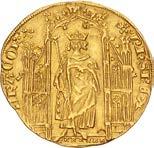





1014. FRANCE, Royal. Philippe VI de Valois (of Valois). 1328-1350. AV Royal d’or (26mm, 4.19 g, 8h). Authorized 2 May 1328. ๘ ი Pƌ=˫ ი ʼĚҞ ი ი fʼ¥= ი ýɱʼ= ი , Philippe standing facing under gothic dais, holding scepter / ๘ ҞP=ý ი ⎍ƱNýƱ˶ ი ҞP=ý ი ʼĚŷɃ¥˶
ƱዦPĚʼ¥˶ , ornate cross fleurée with voided quatrefoil at center and leaves in quarters; all within quadrilobe with arches ending in trefoils. Duplessy 247; Ciani 269; Friedberg 271. Slightly double struck obverse, a few light marks. Good VF. ($2500)
1015.
ҞP=ý
1016. FRANCE, Royal. Charles V le Sage (the Wise). 1364-1380. AV Franc à pied (28mm, 3.75 g, 10h). Authorized 20 April 1365. k¨ˊɨǮ⎍S ᚨ dƩ ᚨ ŷˊ fˊ¨nýɨˊ⎍ ᚨ ˊĚҞ , Charles standing facing within Gothic arch; semé of seven lis to left and right, holding sword, and main de Justice / ๘ Ҟʖý ᚨ ⎍ƩHýƩ˶ ᚨ Ҟʖý ᚨ ˊĚŷH¨˶ ᚨ Ҟʖý ᚨ ƩȵʖĚˊ¨˶ , cross tréflée; in center of cross, pellet within angled quadrilobe; lis in first and fourth quarters, crown in second and third; all within angled quadrilobe; lis in spandrels. Duplessy 360; Ciani 457; Friedberg 284. In NGC encapsulation 6489898-002, graded MS 65. ($2000)
1017. FRANCE, Royal. Charles V le Sage (the Wise). 1364-1380. AV Franc à pied (28mm, 3.68 g, 8h). Authorized 20 April 1365. k¨ˊɨǮ⎍S ᚤ dƩ ᚤ ŷˊ fˊ¨nýɨˊ⎍ ᚤ ˊĚҞ , Charles standing facing within Gothic arch; semé of seven lis to left and right, holding sword, and main de Justice / ๘ Ҟʖý ᚨ ⎍ƩHýƩ˶ ᚨ Ҟʖý ᚨ ˊĚŷH¨˶ ᚨ Ҟʖý ᚨ ƩȵʖĚˊ¨˶ , cross tréflée; in center of cross, pellet within angled quadrilobe; lis in first and fourth quarters, crown in second and third; all within angled quadrilobe; lis in spandrels. Duplessy 360; Ciani 457; Friedberg 284. In NGC encapsulation 6489898-001, graded MS 64. ($1500)
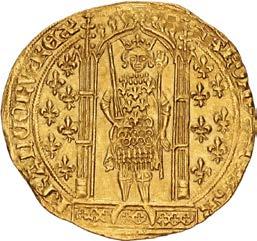


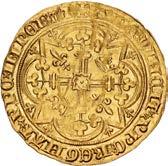

1018. FRANCE, Royal. Charles V le Sage (the Wise). 1364-1380. AV Franc à pied (28mm, 3.78 g, 5h). Limoges mint. Authorized 20 April 1365. k¨ˊɨǮ⎍S ᚤ dƩ ᚤ ŷˊ fˊ¨nýɨˊ⎍ ᚤ ˊĚҞ , Charles standing facing within Gothic arch; semé of seven lis to left and right, holding sword, and main de Justice; small Ǯ to upper left / ๘ Ҟʖý ᚨ ⎍ƩHýƩ˶ ᚨ Ҟʖý ᚨ ˊĚŷH¨˶ ᚨ Ҟʖý ᚨ ƩȵʖĚˊ¨˶ , cross tréflée; in center of cross, pellet within angled quadrilobe; lis in first and fourth quarters, crown in second and third; all within angled quadrilobe; lis in spandrels. Duplessy 360C; Ciani 466; Friedberg 284. In NGC encapsulation 6489898-002, graded MS 64. Rare mint. ($2500)




1019. FRANCE, Royal. Charles VI le Bien-Aimé/le Fol (the Well-Beloved/the Mad). 1380-1422. AV Écu d’or (29mm, 3.92 g, 9h). Tours mint; mm: pellet under 6th letter. Fourth emission, authorized 29 July 1394. ๘ Nj_rɨLVs Ḻ dýƩ Ḻ gr_ ýƩ_ Ḻ ōraNýɨrVM Ḻ rĿҞ , crowned coat-of-arms / ๘ Ҟʁ=ý ᛌ ⎍ƟɃýƟͿ Ḝ Ҟʁ=ý ᛌ ʼĿgɃaͿ ᛌ Ҟʁ=ý ᛌ ƟƊʁĿʼaͿ , cross fleurdelisée and feuillue; star in center; all within quadrilobe; lis at end of each arc, crowns in spandrels. Duplessy 369C; Ciani 488; Friedberg 291. In NGC encapsulation 2127294-001, graded MS 62. ($750)

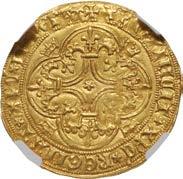
1020. FRANCE, Royal. Louis XIV le Roi Soleil (the Sun King). 1643–1715. AV Louis d’or juvénile lauré (24mm, 6h). Lyons mint; différent: rock pile and star. Dated 1670 D. Laureate head right / Crowned cruciform double-L monogram around mintmark in central annulet; lis quarters. Droulers 316D; Duplessy 1425; Ciani 1789; KM 200.3; Friedberg 421. In NGC encapsulation 2128556-002, graded MS 62+. ($1500)




1019 1020 1021 1022
1021. FRANCE, Royal. Louis XIV le Roi Soleil (the Sun King). 1643–1715. AV Louis d’or aux huit L et aux insignes (27mm, 6.68 g, 6h). Lille mint; différent: duckling. Dated 1701 W. Laureate head right / Crowned cruciform double-L monogram around mintmark in central annulet; scepters in quarters. Droulers 349; Duplessy 1443A; Ciani 1805; KM 334.21; Friedberg 436. Edge splits. Good VF. Overstruck on an earlier issue. ($750)
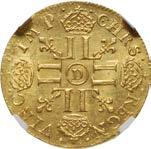

1022. FRANCE, Royal. Louis XVI. 1774–1793. AV Double Louis d’or (29mm, 15.23 g, 6h). Limoges mint; différents: bundle of three arrows/latin cross. Dated 1786 I. Head left / Crowned coats-of-arms. Droulers 802; Duplessy 1706; Ciani 2182; KM 592.7; Friedberg 474. Double struck. Good VF. ($1000)
1023. FRANCE, Royal. Louis XVI. 1774–1793. AR 6 Livres essai (39mm, 31.50 g, 6h). Constitutional issue. By Vasselon. Dated 1791 and L’An 2. Head left / Winged genius of France standing right, inscribing tablet set on column; to left, rooster standing right; to right, fasces surmounted by liberty cap. Mazard 84. Once wiped. EF ($2000)
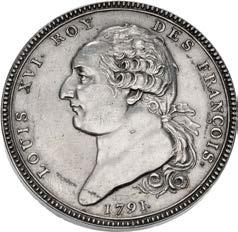

Ex Künker 92 (22 June 2004), lot 714 (hammer €2600).

1024. FRANCE, First Empire. Napoléon I. 1804-1814. AV 20 Francs (22mm, 5h). Paris mint; différents: monogram/ rooster. Dated 1812 A. Laureate head left / Denomination within wreath. VG 1025; KM 695.1; Friedberg 511. In NGC encapsulation 2127294-007, graded MS 63. ($750)

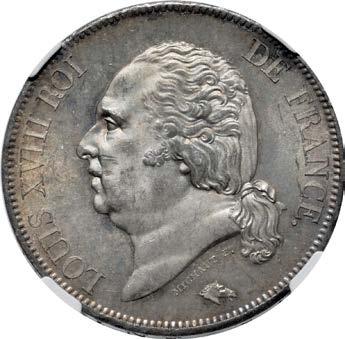
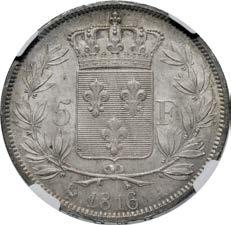
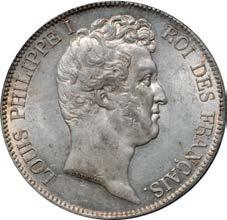
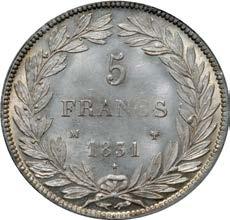
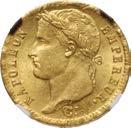

1027. FRANCE, Provincial. Arles (archbishophric). Guillaume de la Garde. 1361-1374. AV Franc à pied (28 mm, 3.63 g, 10h). Struck after 1365. ŷ⎍ƩǮǮS=/ dĚƩ / ŷˊ¨ / ʖˊý / ¨ˊĚǮ¨˶ĚN / , crowned figure standing facing within Gothic arch; semé of seven lis to left and right, holding sword, and fleur-tipped scepter / ๘ ҞʖƩý ო ⎍ƩNýƩ˶ ო ҞʖƩý ო ˊĚŷN¨˶ ო ҞʖƩý ო ƩnʖĚˊ¨˶ , cross tréflée; in center of cross, pellet within angled quadrilobe; lis in first and fourth quarters, crown in second and third; all within angled quadrilobe; lis in spandrels. Duplessy, Féodales 1752; Poey d’Avant 1858; Friedberg 25; “Monnaie inédite des archevêques d’Arles” in Bulletin de la Société Archéologique de Tarn-et-Garrone tome I, no. 1 (July 1869) p. 25-6 = A. Longpérier, “Franc d’or de Guillaume d’Arles” in RN (1869), p. 273-4; Catalogue de monnaies Françaises trouvaille faite le 6 Juin 1882, rue Vieille-du-Temple, 26 et 28, (Paris 1882), p. 21 = E. Caron, Monnaies féodales françaises, (Paris 1882), 405 var. (legends). Lustrous. EF. Of considerable historical interest and among the rarest gold coins in the French medieval series. ($75,000)
Guillaume de la Garde (c. 1325-1374), was a significant figure in the history of Provence in the mid fourteenth century. During this period the Papacy was based in Avignon and Guillaume, who was born into a powerful local family, progressed rapidly through the hierarchy of the Church, rising to become the Archbishop of Arles and Latin Patriarch of Jerusalem. It was as Archbishop that Guillaume crowned the Holy Roman Emperor, Charles IV, as King of Arles in 1365. Shortly afterwards he changed his allegiance and supported Louis I of Anjou, brother of the French king Charles V, who claimed the kingdom by right of his descent from Louis IX (Saint Louis) and Marguerite of Provence.
During this turbulent time, it would appear that Guillaume struck a very small gold coinage in his own name. The type adopted was inspired by the franc à pied, a coin issued in vast numbers by Charles V of France from 1364 onwards in his drive to stabilise the currency after numerous debasements during the Hundred Years War, see lots 1016-1018. Elements of the design were altered from the Royal prototype, for example, the sceptre tip and the crown worn by the Archbishop. Interestingly Guillaume adopts the title Prince of Arles. It is unclear in what capacity he could claim this title. He may simply have been copying his neighbour Raymond IV of Orange who also styled himself Prince on the larger emission of gold franc à pieds he made around this time.

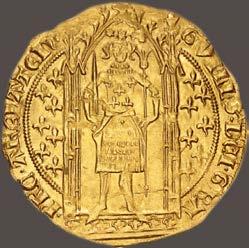

We can trace only three other examples of the Franc à Pied of Guillaume de la Garde: that described by Poey d’Avant, now in the Bibliotheque National, an example published in 1869 and now in the collection of the Cabinet des Monnaies in Marsielle, and an example of a different variety found in the 1882 Rue Vieille-du-Temple Hoard.

1028. FRANCE, Provincial. Besançon (Free imperial city). nomine Ferdinand III. 1619-1637. AV 2 Ducats (32mm, 6.82 g, 6h). Struck 1642-1664. Laureate and armored bust right, wearing ruff / Crowned double-heaed eagle within coat-ofarms on breast; all within border of alternating coats-of-arms and ornate lis. Duplessy, Féodales –; Poey d’Avant –; KM 40; Friedberg –. In NGC encapsulation 5783259-004, graded AU 50. Very rare. Only 27 annually distributed during their period of production. ($7500)
Ex Pesce (17 October 1985), lot 155.
These extremely rare gold issues, particular to Besançon, were specially minted for an annual distribution to the fourteen governors in charge of the mint. Curiously, the city used the portrait and titles of the sitting Holy Roman Emperor, rather than those of the late Charles V, as with all other issues. The special coinage and distribution ceased when Besançon converted to the French monetary system in 1676.


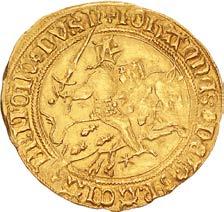


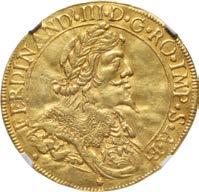
1029. FRANCE, Provincial. Bretagne (duchy). Jean V. 1399-1442. AV Florin d’or au chevalier (25mm, 2.96 g, 4h).

($10,000)
Ex Robert Perret Collection.
1030 1031
1030. FRANCE, Provincial. Bretagne (duchy). François I. 1442-1450. AV Écu d’or au chevalier (28mm, 3.40 g, 4h). Rennes mint. ม & fˆ¨ɀýƩ⌽ýѝ⌽ & ĕĚƩ & ŷˆ¨ & BˆƩ˸ɨɀѝ⍴ & ĕѝҞ & ˆ &, armored figure of François on horseback right, holding sword in raised right hand and shield in left; caparison decorated with ermines / ม & ĕĚѝ⌽ & Ʃɀ & ¨ĕƩѝɨˆƩѝ⍴ & ⍴Ěѝ⍴ & Ʃɀ˸ĚɀĕĚ & ˆ &, cross tréflée with voided quadrilobe at center, ermines in quarters; all within polylobe. De Mey, Bretagne 396; Duplessy, Féodales 318; Poey d’Avant 1194; Friedberg 95. Faint cleaning marks. EF. A high grade example of this crude issue. ($2000)




1031. FRANCE, Provincial. Bretagne (duchy). François I. 1442-1450. AV Écu d’or au chevalier (27mm, 3.40 g, 10h). Rennes mint. ม & fˆ¨ɀýƩ⌽ýѝ⌽ & ĕĚƩ & ŷˆ¨ & BˆƩ˸ɨɀѝ⍴ & ĕѝҞ & ˆ &, armored figure of François on horseback right, holding sword in raised right hand and shield in left; caparison decorated with ermines / ม & ĕĚѝ⌽ & Ʃɀ & ¨ĕƩѝɨˆƩѝ⍴ & ⍴Ěѝ⍴ & Ʃɀ˸ĚɀĕĚ & ˆ &, cross tréflée with voided quadrilobe at center, ermines in quarters; all within polylobe. De Mey, Bretagne 396; Duplessy, Féodales 318; Poey d’Avant 1194; Friedberg 95. Slightly wavy flan, countermarked with large ‘E’. Good VF. ($1500)
1032. GERMANY, Braunschweig-Calenberg (Duchy). Ernst August. 1679-1698. AR Taler (45mm, 1h). Zellerfeld mint. Dated 1682/3 RB. Wildman standing slightly left, holding tree / Helmeted and garnished coat-of-arms. Welter 1950; Davenport 6591; KM-265.1. In PCGS encapsulation 45192634, graded MS 61. ($1500)


Ex Robert C. Knepper Collection.
1033. GERMANY, Braunschweig-Calenberg-Hannover (Duchy & Electorate). Georg Ludwig (as George I of Great Britain). 1714-1724. AR Taler (42mm, 7h). Zellerfeld mint. Dated 1724 EPH. Wildman standing left, tearing pine branch in half on pine tree to right / Coat-of-arms Great Britain. Welter 2236; Davenport 2076; KM 114. In PCGS encapsulation 45194446, graded MS 62. ($1500)

Ex Robert C. Knepper Collection; Ponterio 17 (30 November 1984), lot 1107.

1034. GERMANY, Braunschweig-Calenberg-Hannover (Duchy & Electorate). Georg August (George II of Great Britain). 1727-1760. AR Taler (41mm, 29.24 g, 6h). Yield of the Weisser Schwan Mine. Zellerfeld mint; . Dated 1756 IBH. Swan left on mountain lake; view of mine in background / Crowned royal coat-of-arms; shield with ornate frame. Welter 2568; Davenport 2097; KM 291. Deeply toned with traces of iridescence. Good VF. ($1500)
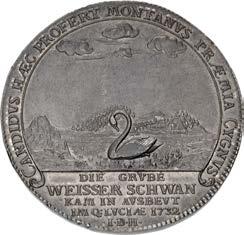



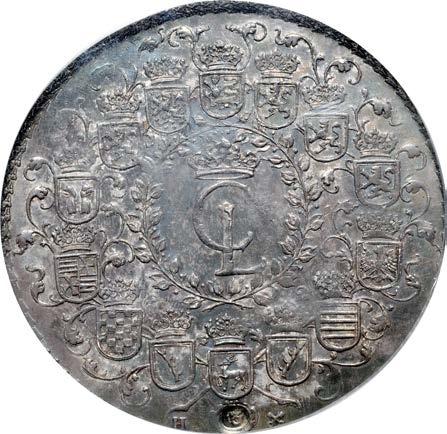
Ex Stack’s Bowers Galleries (11 January 2019), lot 40230.
1035.
1036.
45413386, graded AU 58. ($15,000)
Ex Robert C. Knepper Collection.

1037.
AU 58. ($10,000)
Ex Paramount Collection (Heritage 3096, 25 March 2021), lot 30223.


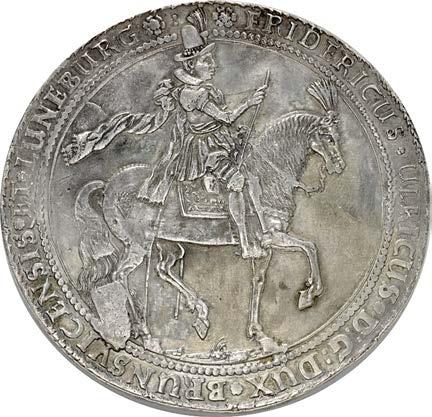

1038.
Ex Künker 359 (26 January 2022), lot 367; Künker 98 (8 March 2005), lot 3178.
1039.
1040.

Ex
1041.

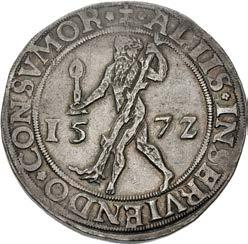
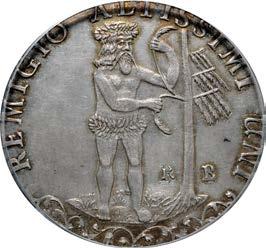

Ex Robert C. Knepper Collection.


1042. GERMANY, Braunschweig-Wolfenbüttel (Duchy). Karl I. 1735-1780. AR Taler (42mm, 6h). Yield of the Regenbogen Mine. Zellerfeld mint. Dated 1748 IBH. View of mine; rainbow (Regenbogen) above / Crowned coat-of-arms with wildman supporters. Welter 2728; Davenport 2165; KM 924. In PCGS encapsulation 45504771, graded MS 61. ($2000)

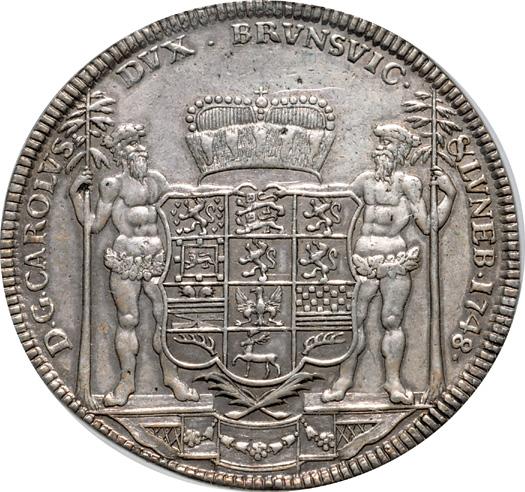



Ex Robert C. Knepper Collection; Peus 314 (February 1985), lot 1196.


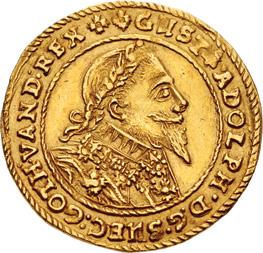
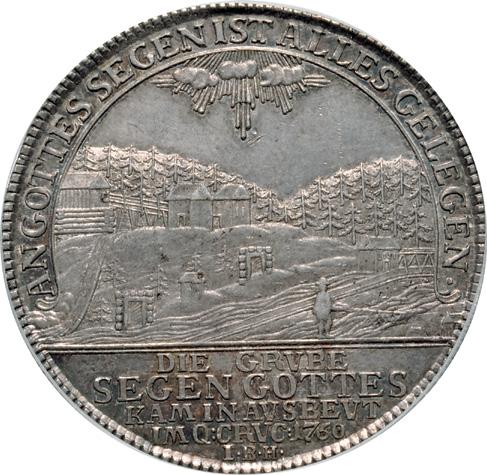
1043.
Ex
1044.
Ex
1045.
The
of the willow tree being
of the Thirty Years’
the
by a
struck by
is
(1618-1648).


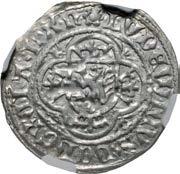


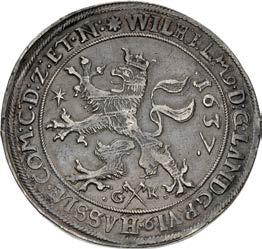

1049. GERMANY, Hildesheim (city). AV 5 Goldgulden (61mm, 35.63 g, 12h). Commemorating the Official Grant of the Civic Coat-of Arms to the City by Charles V, 3 February 1528. Dated 1528. (rosette) CAROLVS · V · ROM · IMP · Q · FELICISS · ET · TRIVMP · AVGV, bust of the Holy Roman Emperor Charles V right / (rosette) IN · SIG · A · CAR · V · ROM · IMP · HILD · AO · 15Z8 COLLATA (rosette) , helmeted and garnished coat-of-arms; nor mintmaster initial flanking young woman. For coin: Buck/Bahrfeldt 577 var. (minmaster initials); Friedberg 1311. Toned, polished, minor deposits and hairlines. Good VF. Set in ornate contemporary enameled bezel with suspension loop, decorated with pearls (two missing) and three pearl pendants. ($10,000)

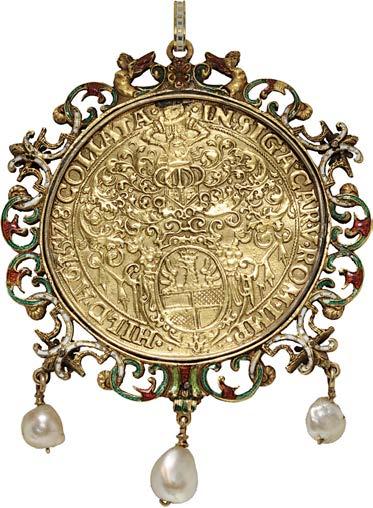
Ex Lugdunum 21 (9 June 2021), lot 142; Collection of Martine, Comtesse de Béhague (1870-1939).
1050. GERMANY, Landau. Besieged by Marshal de Villars, 1713. AR 2 Florin 8 Kreuzer (43mm, 21.50 g, 12h). Siege issue. Dated 1713. Stamped with the coat-of-arms of Karl Alexander, Duke of Württemberg, two rectangular stamps reading PRO/ CÆS : & IMP : and BEL : LANDAU/ 2 · FL : 8X, and four crowned monograms / Blank. Korchnak 314; Maillet pl. LXIX, 7; KM 13. Toned with traces of iridescence. EF. ($2000)
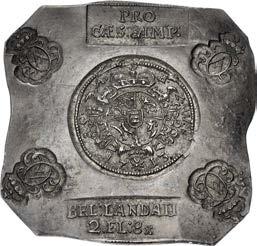
Ex John Whitney Walter Collection (Stacks Bowers, 14 August 2018), lot 20580; Coin Galleries (17 December 2008), lot 638 (ticket now missing).

1051. GERMANY, Lippe-Detmold (County). Hermann Adolf. 1652-1666. AR Taler (47mm, 28.94 g, 9h). Detmold mint. Dated 1658. Bareheaded and armored half-length bust facing slightly right / Crowned coat-of-arms; shield in ornate frame. Grote 144; Davenport 6894; KM 73. Iridescent toning, hint of deposits, flan flaws, some very light graffiti on reverse. EF. A wonderful portrait coin. ($2500)

1052. GERMANY, Nürnberg (City). AV 3 Ducat (35mm, 10.36 g, 12h). Dated 1703 GFN (in chronogram). Three coatsof-arms joined by ribbon / Agnus Dei standing left on globe, head facing, cradling banner inscribed PAX with hoof. Kellner 46; KM 262; Friedberg 1880. Edge marks. EF. ($7500)




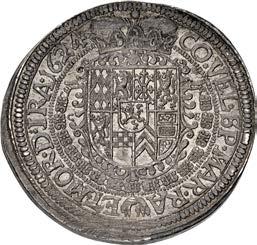
1053.
1614-1625. AR Taler (43mm, 29.01 g, 12h). Kallmünz mint. Dated 1624 CE. Bareheaded, draped, and armored bust right, wearing ornate collar / Crowned coat-of-arms within Order of the Golden Fleece. Noss 332; Davenport 7166; KM 59. Iridescent toning, some light adjustment marks. Near EF. ($1000)

1054. GERMANY, Sachsen-Albertinische Linie (Duchy & Electorate). Moritz. 1547-1553. AR Taler (42mm, 29.03 g, 6h). Annaberg mint. Dated 1550. Armored half-length bust right, holding swor / Coat-of-arms; additional arms around. Keilitz & Kahnt 10; Schnee 689; Davenport 9787. Attractive iridescent toning, areas of slight weakness. EF. Well struck for issue. ($1000)
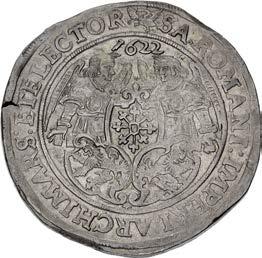


Ex HLT Collection (Triton XIV, 4 January 2011), lot 1333.
1055. GERMANY, Sachsen-Albertinische
(Duchy &
Johann Georg I. 1615-1656. AR 60 Kipper Groschen (44.5mm, 23.21 g, 12h). Dresden mint. Dated 1622. Angel facing, holding coat-of-arms / Pair of angels holding three coats-of-arms. Rahnenführer/Krug 161; KM 364. Iridescent toning, slight edge splits. EF ($750)
1056. GERMANY,
Linie (Duchy & Electorate).
Georg II. 1656-1680. AR Taler Klippe (47x48mm, 29.27 g, 3h). Commemorating


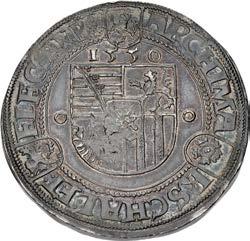
marriage of Erdmuthe
Dresden mint. Dated 1662 Hands emerging from clouds crowning with wreath a monument decorated with two coats-of-arms,
by hanging garlands to two garlanded pillars on either side, one surmounted by a pair of wings, the other a pair of doves; radiate name of God above; ornate coats-of-arms in corners / Legend in nine lines; ornate coats-of-arms in corners. Clauss & Kahnt 511; Schnee 914; Davenport 7631; KM 500. Wonderful old cabinet toning. Near EF. ($3000)
Ex Johns Hopkins University Collection (Part II, Leu/Numismatic Fine Arts, 16 October 1984), lot 1398; Hall Collection, 128.
1057.
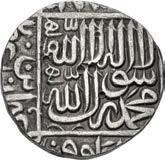
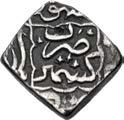
1058.

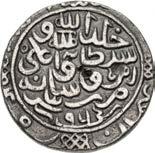



1059.



In 1526, the forces of Babur, the Timurid ruler of Kabulistan, won a decisive victory over Ibrahim Lodi, Sultan of Delhi, at the Battle of Panipat. Ibrahim Lodi was killed on the battlefield, and many of his generals and vassals promptly
position in India was confirmed when he defeated the Rajput ruler of Mewar, Rana Sanga,
The city of Lahore, having previously been governed by the Sultans of Delhi, now came under Babur’s control. However, while the Delhi Sultans had struck gold tankas for decades, Babur himself initially struck no gold coins in his newly-won Indian lands, issuing only silver and copper there (see Aman ur Rahman, Zahir-uddin Muhammad Babur. A numismatic study [Karachi: 2005]). The coin offered here, which appears to be unique may have been part of a special issue, given to members of the city’s elite who assisted him while he held the city. It also has the distinction of being the first Mughal gold coin struck in India.
1061. INDIA, Mughal Empire. Nasir al-Din Muhammad Humayun. AH 937-947 and 962-963 / AD 1530-1540 and 1555-1556. AR Shahrukhi (24mm, 4.51 g, 7h). Assam mint. Dated AH [9]42 (1535/6). Shahada in circular linear border; oaths of Rashidun in outer margins / Name and title of Humayun in ornate cartouche frame; continuation of legend, mint formula, and AH date in outer margin. Album B2464; Album 42, lot 444 (hammered for $4000). Iridescent toning, some find patina, areas of weakness, shroff marks. VF. Extremely rare mint. ($2500)



1062. INDIA, Mughal Empire. Jalal al-Din Muhammad Akbar. AH 963-1014/AD 1556-1605. AV Mohur (27mm, 10.76 g, 12h). Possible contemporary local imitation. Agra mint (blundered). Dated AH [9]7[...] (Struck AD 1564/5). Shahada within quatrefoil; oaths of Orthodox Caliphs in outer margins / Name and titles of Akbar, AH date above. Cf. Liddle Type G-3; cf. BM 24; cf. IMC (Wright) 64-6; cf. Hull 1202; cf. KM 105.1. Earthen deposits, edge marks, numerous shroff marks on edge. VF. ($500)


From the S & S Collection. Ex Malter XXXI (9 June 1985), lot 3293.

1063. INDIA, Mughal Empire. Jalal al-Din Muhammad Akbar. AH 963-1014/AD 1556-1605. AV Mohur (24.5mm, 10.87 g, 6h). Bhakkar mint. Dated AH 984 (AD 1576/7). Shahada within knotted frame decorated with pellets; AH date in lower left corner; oaths of Rashidun in outer margins / Name and titles of Akbar within pelleted mehrib; mint formula below. Liddle Type G-6 (mint unlisted); BM –; IMC (Wright) –; cf. Whitehead , Panjab Museum, Lahore p. lviii; Hull –; KM Type 108 (mint unlisted); Zeno 102283 (this coin). Toned, traces of having been placed in a bezel. Near EF. Extremely rare. ($15,000)

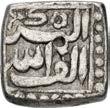
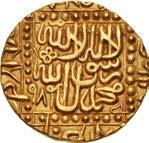




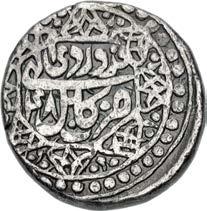



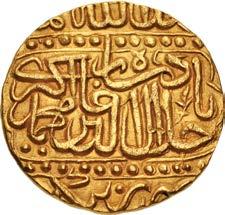
Whitehead records that the fortress of Bhakkar was captured for the Emperor Akbar in AH 981, three years before this unpublished mohur was struck. The modern town of Bhakkar lies on the left bank of the Indus, but Whitehead states that in the Mughal mint was located on an island in the river. While Whitehead records rupees of Bhakkar issued by several Mughal emperors, no gold of this mint was known to him.
1064.
1066. INDIA, Mughal Empire. Nur al-Din Muhammad Jahangir. AH 1014-1037 / AD 1605-1627. AV Quarter Mohur (14mm, 2.72 g, 9h). Shikargah mint. Dually dated AH 1034 and RY 20 (AD 1625). hamesha ain zar kunad/karam dar shikargah (This gold will always do favor in the Shikargah [the King’s hunting grounds]) / shah-i-shikar dost jahangir badshah ([Struck by] Jahangir badshah who enjoys the hunt); AH and RY dates to left . Liddle Type G-69 = Zeno 82954 = J. Lingen, “A Quarter Mohur of Jahangir Struck on the Occasion of a Royal Hunt (Shikar),” ONS Newsletter 172 (Summer 2002), p. 30 and illustration (this coin); BM –; IMC (Wright) –; Hull –; KM –. Lightly toned, traces of deposits. Near EF. Extremely rare, none in CoinArchives. ($150,000)

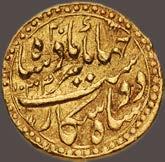

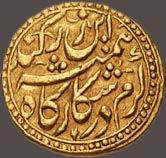
Deriving from their traditions in Central Asia, the Mughals used the shikargah or “hunting ground,” where qamargah, or the controlled encircling of game occured. While this was specifically designed to provide a convienent place for camping and shooting, it also served as an opportunity for settling conflicts and war games. In the translation of the Tuzuk-e Jahangiri by Wheeler M. Thackson (The Janhangirnama, Memoirs of Jahangir, Emperor of India (New York: 1999), the reason for the minting of this coin was the celebration of Jahangir’s 20th year on the throne, itself a great cause for celebration and the opportunity to hold a shikargah; a celebration was described as being held at Jangirhati in the vicinity of Mt. Bhaner. While the exact location of Jangirhati remains unknown, internal evidence of the Tuzuk-e Jahangiri suggests somewhere in Kashmir.
For a more detailed discussion of the locations of this specific shikargah and the purpose for minting this extremely rare coin, see J. Lingen, “A Quarter Mohur of Jahangir Struck on the Occasion of a Royal Hunt (Shikar),” ONS Newsletter 172 (Summer 2002).
1067. INDIA, Mughal Empire. Nur al-Din Muhammad Jahangir. AH 1014-1037 / AD 1605-1627. AV Heavy Mohur –Tanka (23mm, 21.85 g, 9h). Kanbayat mint. Dually dated AH 1027 and RY 12 (December, AD 1618). sikka/Jahangir/shahi (coin of Jahangir Shah); 1027 (date) below / zarb/Kanbayat/sanat/12/jalus (struck Kanbayat year 12 of the accession). Liddle –; BM –; IMC (Wright) –; Hull –; KM –; Zeno 284885 = S. Goron and R. Babar, “Jahangir’s Gold Tanka of Cambay,” ONS Newsletter 175 (Spring 2003), p. 18 and illustration (this coin). Lightly toned, deposits, light marks. EF. Of the highest rarity, apparently the only published specimen. ($500,000)
When S.H. Hodivala published his Historical Studies in Mughal Numismatics in 1923, he included an article entitled “Jahangir’s Cambay Tankas.” Citing a passage of the Mughal emperor’s autobiography, Tuzuk-e Jahangiri, Hodivala stated that, a few months prior to the introduction of his celebrated Zodiac coinage, Jahangir, while encamped at Kanbayat (Cambay), ordered the minting of special silver and gold coins (which were called tankas). In the translation of the Tuzuk-e Jahangiri by Rogers and Beveridge (London, 1909, pp. 417-8), the emperor Jahangir describes in his own words how he came to create these beautiful and impressive tankas:
At this time an order was given that tankas of gold and silver should be coined at twice the weight of ordinary mohurs and rupees. The legend on the gold coin was on one side the words ‘Jahangir-shahi, 1027’ and on the reverse ’Struck in Cambay in the 12th year of the reign.’ The legend for silver coins was on one side ‘Sikka, Jahangir-shahi, 1027’; round it this hemistich, ‘King Jahangir of the conquering ray struck this’; and on the reverse, ‘Coined at Cambay in the 12th year of the reign,’ with this second hemistich round it: ‘When after the conquest of the Deccan he came to Gujarat from Mandu.’ In no reign except mine have tankas been coined except of copper; the gold and silver tankas are my invention. I ordered it to be called the Jahangiri coinage.
It has been suggested that the splendid calligraphy on this coin has strong similarities with the beautiful nasta’liq script of the celebrated calligrapher ‘Abd al-Rahim al-Heravi. Known as ’Anbarin-Qalam, ‘The Pen of Amber,’ a title which may have been bestowed on him by Jahangir himself, dated manuscripts indicate that ‘Abd al-Rahim was active at the Mughal court for at least thirty years, spanning the period between AH 1005-1037. Contemporary sources confirm that calligraphers at the Mughal court were often skilled in other arts, including painting, gilding and engraving.

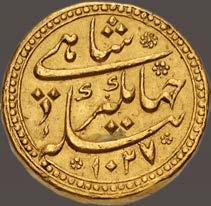

At the time that Hodivala published his findings, no gold tankas had been discovered. This specimen is the first and only recorded example of a gold tanka of this type, published and illustrated by S. Goron and R. Babar, in the ONS Newsletter 175 (Spring 2003). No extant silver tankas of the type described in the Tuzuk-e Jahangiri are known, but Jahangir’s own description of their legends confirms that these double-weight gold and silver coins were struck following his military operations in the Deccan.
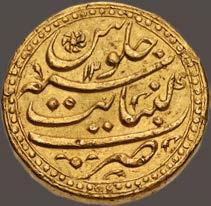
1068. INDIA, Mughal Empire. Nur al-Din Muhammad Jahangir. AH 1014-1037 / AD 1605-1627. AV Mohur (20mm, 10.63 g, 12h). Portrait type. Ajmer mint. Dually dated AH 1023 (11 February AD 1614-30 January AD 1615) and RY 8 (15/24 October 1612 – 14/23 October 1613). ba ruye sikka-e zad dad chanden-e zein wa zewar shabih-e Shah Nur al-Din Jahangir bar Akbar padshah (Upon the gold coin much beauty and ornament the likeness of Shah Nur al-Din Jahangir son of Akbar Padshah) in Persian, radiate Jahangir seated cross-legged left against patterned cushion holding flower; numeral 8 (in eastern Arabic numeral) below sikka-e; legend divided by two roses, each set on arrow / zad ba zar ein dar sikka Ajmer Shah din-e panah Shah Shah Nur al-Din Jahangir bar Akbar Badshah (Struck in gold this coin at Ajmer the Shah shelter of the Faith. Shah Nur al-Din Jahangir son of Akbar Badshah) in Persian, lion recumbent right; radiate sun behind; AH date below; legend divided by two roses, each set on arrow. Liddle Type G-39; BM 318 var. (no RY date); IMC (Wright) –; Hull 1425; KM 179.5; Friedberg 759; Adams III 2397 (same dies, but later strike). Traces of deposits in devices with underlying luster. EF. Very rare and seldom encountered outside museum collections. ($100,000)
Ex Album 18 (16 January 2014), lot 1188.
Between the fifth and seventh years of his reign, the emperor Jahangir issued special gold mohurs which bear his own portrait on the obverse and a lion-and-sun motif on the reverse. According to contemporary historical sources, these special coins were introduced in AH 1020 (AD 1611), and Jahangir ordered that they were to be presented to favoured ministers, servants and eminent visitors to the Mughal court. Jahangir’s own courtiers and attendants were even instructed to wear these coins, prominently displayed on their clothing or on their turban sash, both as a mark of their status and also as a life-preserving amulet. It is therefore unsurprising that surviving examples sometimes exhibit signs of wear and mounting, but being struck to the same weight and fineness as regular mohurs they also fulfilled a monetary function and we can imagine that coins of this type given to visitors to Jahangir’s court might well have ended up in treasuries elsewhere. The piece offered here is a particularly well-preserved example of this beautiful and extremely rare issue.


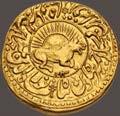

1069. INDIA, Mughal Empire. Nur al-Din Muhammad Jahangir. AH 1014-1037 / AD 1605-1627. AR Rupee (23mm, 11.39 g, 9h). Rohtas mint. Dated Aban RY 19 (25 October 1623 – 13 October 1624). Legend naming Jahangir Shah / Mint formula and Ilahi month. Liddle Type S-23 (RY date unlisted); BM –; IMC (Wright) –; Hull –; KM 145.14 (RY date unlisted); Zeno 134313. Iridescent toning. Good VF. Rare mint. ($750)


1070. INDIA, Mughal Empire. Nur al-Din Muhammad Jahangir. AH 1014-1037 / AD 1605-1627. AV Mohur (22mm, 10.95 g, 4h). Zodiac Type, Class A. Agra mint. Dually dated AH 1028 and RY 14 (21 March-20 April AD 1619). Constellation of Varak/Mesha (Aries the Ram): ram, head right, recumbent left; radiate sun behind; sanat 14 jalus (regnal year 14) in Persian below / zar zewar dar Agra ruye yaft az Jahangir Shah Akbar Shah (Received ornament on gold at Agra from Jahangir Shah [son of] Akbar Shah) in Persian verse; AH date to left. Liddle Type G-74 = Fitzwilliam Inv. (same dies); BM 322; IMC (Wright) 570; Hull 1379; KM 180.1; Friedberg 762; Adams III, lot 2399 (same dies, but earlier die state). Cabinet patina. Good VF. Very rare. ($75,000)



Ex Album 21 (15 January 2015), lot 1161.
Jahangir (1605-1628), Akbar’s son and immediate successor, used the Ilahi Era to great artistic effect by issuing two series of mohurs that incorporated Ilahi Era elements. The earliest series, known as the portrait series, since the coins show the emperor on the obverse, all show the constellation Leo superimposed over the sun – a reference to Jahangir’s birth in August. This series was struck within a three-year span early in Jahangir’s reign and are quite rare. The second series, known as the zodiac series, since each of the twelve constellations of the Zodiac is represented on the reverse, was a much larger series. Struck both in gold and silver, the zodiac series was issued from several mints (with Agra being the primary), and like the previous series, minted over three or four years. Since the Ilahi months were solar months and corresponded with the solar ecliptic (an imaginary line in the sky that marks the annual path of the sun), each month was represented by an appropriate sign of the Zodiac, recording its particular month of issue.
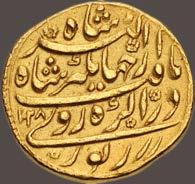
1071 1072
1071. INDIA, Mughal Empire. Shihab al-Din Muhammad Shah Jahan. AH 1037-1068 / AD 1627-1658. AR Quarter Rupee (20mm, 1.44 g, 6h). Nisar type. Akbarabad mint. Dually dated AH 1042 and RY 5 (1633). shah/jahan/badshah/ghazi (the next Lord of the Auspicious Conjunction) in five lines with floral ornament; 5 to right / zarb/Akabarabad/sanat/1042 in four lines with floral ornament. BM –; IMC (Wright) –; Hull –; KM (Indian edition) 240.2 (this coin illustrated). Toned. Good VF. ($750)
1072. INDIA, Mughal Empire. Shihab al-Din Muhammad Shah Jahan. AH 1037-1068 / AD 1627-1658. AR Half Rupee (20mm, 5.67 g, 9h). Nisar type. Dar al-Sultanat Lahore mint. Dually dated AH 1055 and RY 19 (1647). sahib/qiran/ sani (the next Lord of the Auspicious Conjunction) in two lines with floral ornament; 19 above be of sahib / zarb/dar alSultanat/Lahore in three lines with floral ornament; 1055 in exergue. BM –; IMC (Wright) –; Hull –; KM 247.1. Toned, shroff marks. VF. ($750)
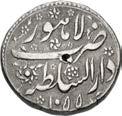


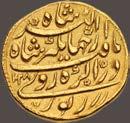
1073. INDIA, Mughal Empire. Mu’azzam Bahadur Shah (Shah Alam I). AH 1119-1124 / AD 1707-1712. AV Mohur (21mm, 11.07 g, 1h). Qandahar (Deccan) mint. Dates off flan. Couplet citing Shah Alam / Mint formula. BM –; IMC (Wright) –; Hull –; KM –; Zeno 290983 (this coin). Lightly toned, traces of deposits, peripheral flat strike, graffiti on obverse. EF. Extremely rare, none in CoinArchives. ($10,000)



1074. INDIA, Mughal Empire. Farrukhsiyar. AH 1124-1131 / AD 1713-1719. AV Mohur (20mm, 10.97 g, 10h). Peshawar mint. Dually dated AH 1130 and RY 7 (11 January-28 February AD 1719). Persian couplet citing name and titles of Farrukhsiyar / Mint and RY formula. BM –; IMC (Wright) –; Hull –; KM 390.26 var. (dates); Zeno –. Lightly toned, shroff marks. EF. Extremely rare, none in CoinArchives. ($5000)

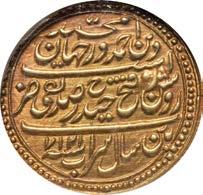


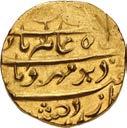
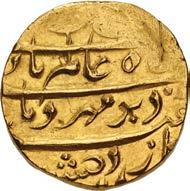




1075. INDIA, Independent States. Mysore. Haidar Ali. AH 1174-1197 / AD 1761-1782. AV Pagoda (12mm, 3.41 g, 3h). Uncertain mint. Siva and Parvati seated facing / Persian he on granulated field. Henderson 1-2; Moin Group 1; KM 15; Friedberg 1346. Toned. EF. ($300)
From the S & S Collection. Lot includes a Joel L. Malter ticket marked lot 427.
1076.
Ex Hesselgesser Collection (Goldberg 62, 2 February 2011), lot 3745.
1077.
11.02
1078.
10.39
($20,000)
1079. INDIA, Independent States. Sikh Empire. temp. Ranjit Singh. VS 1858-1896 / AD 1801-1839. AR Rupee (23mm, 11.05 g, 3h). Mankera mint. Dated VS 1880 (AD 1823). Herrli Gobindshahi couplet Ib / Mint and date formula; pipal leaf. Wiggins & Goron Type VI (Mulkerian); Herrli 33.02.04; KM 72 (Malkarian). Lightly toned, deposits. Good VF. Rare mint. ($1500)

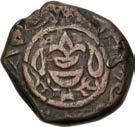


1080 1081
1080. INDIA, Independent States. Sikh Empire. temp. Ranjit Singh. VS 1858-1896 / AD 1801-1839. CU Falus (22mm, 7.70 g, 3h). Peshawar mint. Date off flan, but struck AH 1242 (AD 1826/7). Chalice with sapai in corrupted Gurumukhi below; leaves flanking chalice; flower above / Mint, denomination and [AH date}. Herrli –; Zeno 236825 (this coin) Album 43, lot 906. Brown surfaces. VF. Extremely rare. ($750)




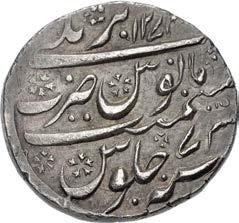
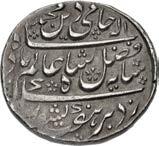

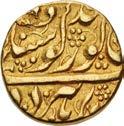
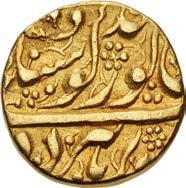
1081. INDIA, Independent States. Sikh Empire. temp. Kharak Singh, Nau Nihal Singh or Mai Chand Kaur. VS 18961898 / AD 1839-1841. AR Rupee (24mm, 11.05 g, 12h). Amritsar mint. Dated 1885/[18]97 (AD 1840). Herrli Nanakshahi couplet V; VS date above; ōm in Devanagari in field / Mint and date formula; pipal leaf. Gurprit Singh 01.60.02; Wiggins & Goron Type VIII; Herrli 01.11.04; KM 22.4. Iridescent toning, slight peripheral weakness, bankers’ marks on edge. EF. Rare. ($1000)

1082. INDIA, Princely States. Bharatpur. Jaswant Singh. VS 1909-1950 / AD 1853-1893. AV Mohur (21mm, 10.76 g, 12h). In the name of Victoria, Queen of the United Kingdom, 1837-1901. Braj Indrapur (Bharatpur) mint. Dually dated 1859 (in eastern Arabic numerals) and VS 1916 (AD 1859). Head of Victoria left, wearing tiara; Persian legend citing her around, Persian legend citing ruler, mint, and date; to left, trace of katar and star. KM.170; Friedberg 1050. Toned, shroff marks on edge. Good VF. Very rare. ($15,000)
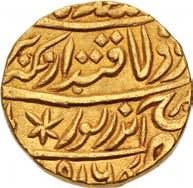







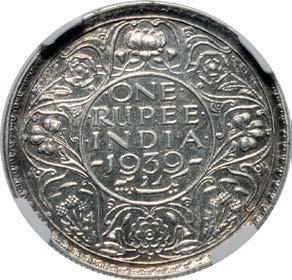
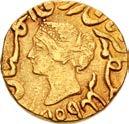
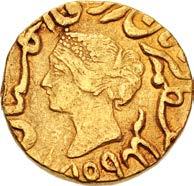

Ex Baldwin’s of St. James’s 14 (14 January 2018), lot 361. Reportedly purchased by the Baldwin’s consignor from Spink & Son, 1973.
1083.
Ex St. James’s 37 (27 June 2016), lot 666 (hammer £9000).
1084.
Ex Heritage 3019 (26 April 2012), lot 24911.
1085. INDIA, Private Tola Coinage. M.S. Manilal Chimanlal & Co., Bombay. AV 5 Tola Round (38mm, 58.34 g, 12h). Diamond set in radiant star; company name around / Value and fineness within ornate frame. KM X#42; Friedberg 1611. Some marks, traces of luster. EF. AGW: 1.865 oz ($3000)
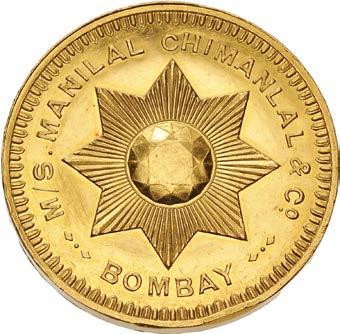


1086. ITALY, Antegnate (signore). Giovanni II Bentivoglio. 1494-1509. Cast Æ Prova del testone (28mm, 14.56 g, 2h). Dated 1494 (in Roman numerals). Bust right, wearing biretta and cape / · MA/XIMILIANI/ IMPERATORIS/ · MVNVS ·/ MCCCCLXXXXIIII ·. Cf. MIR 1 (for AV 4 Ducati) and 5 (for AR 2 Testoni); Levinson VII-7a (this coin illustrated); Frey 423B. Brown surfaces, minor roughness on reverse. VF. A rare pattern and the first dated Italian coin in bronze. ($750)

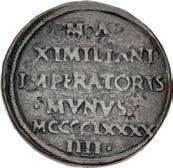
1087. ITALY, Correggio (seignory). Camillo & Fabrizio. 1580-1597. Æ Prova(?) del ducaton (44mm, 30.86 g, 8h). Confronted armored and draped busts of Camillo and Fabrizio / Coat-of-arms over cross fleurée. MIR 135. Double struck, edge splits, roughness on reverse. Near EF. Very rare. ($2000)
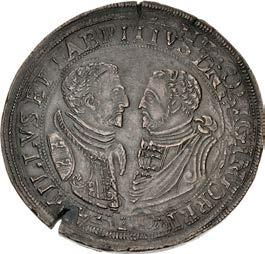
Ex Nomisma S.p.a. 63 (1 July 2021), lot 595.
Though this fascinating large bronze is often described as a pattern, MIR notes that it appears in too great a number for that designation, particularly as rare silver strikings of the type also exist and are known to have been found in Turkey.

1088.
1089 1090
1089.
64 (17 December 2021), lot 563.
1090. ITALY, Milano (duchy). Giovanni Galeazzo Maria Sforza. 1476-1494. AV Doppio ducato (27mm, 6.94 g, 3h). First period. Struck 1476-1478. (mitered head of St. Ambrosius) IO · G3 · M · VICECO · DVX · MLI · SX ·, capped and armored bust right / + P P · ANGLE · · Q3 · COS · 7 · C, coat-of-arms surmounted by two elaborately plumed helmets. MIR 215/1; Crippa 1; MEC 12, 745 (same obv. die). Edge marks, minor deposits, hairlines. Good VF. Very rare. ($7500)



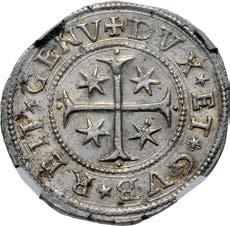
The Sforza (“Strivers”) dynasty began as many Italian noble houses did, with a successful condottiere (mercenary soldier) seeking respectability for his family by procuring a title and an estate. By 1450, Francesco I Sforza seized the Duchy of Milan via a strategic marriage to the daughter of Filippo Maria Visconti. Francesco was succeeded by his son, Galeazzo Maria Sforza, who ruled the duchy with an iron fist, imposing heavy taxes that caused widespread discontent. Despite being remembered today for as a patron of the arts, he was assassinated in 1476. The ducal crown fell to Galeazzo’s young son, Giovanni Galeazzo Maria Sforza, only seven years old at the time. Giovanni would prove to be mostly uninterested in government, allowing most of the work of his office to be conducted by his uncle, regent, and later advisor Lodovico Sforza. Giovanni would die young in 1494, setting up a power struggle between Lodovico and the French king Louis XII for control of Milan.

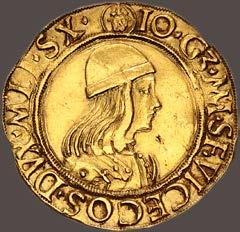
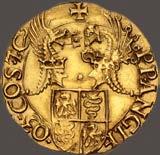
1091. ITALY, Milano (duchy). Lodovico XII di Francia. 1499-1500. AR Grosso regale da 18 soldi (32mm, 7.73 g, 8h). Second period. Struck 1505-1508. + LVDOVIC’· D · G · REX · FRANCORVM ·, crowned and mantled bust right / (mitred facing head of St. Ambrosius) · ET · MEDIOLANI · DVX · ET · C’, crowned coat-of-arms; crowns flanking. MIR 238; Crippa 5; MEC 12, 778; Duplessy 725; Ciani 1002. Toned. In NGC encapsulation 5783258-021, graded XF 40. Very rare. ($4000)
1092. ITALY, Milano (duchy). Filippo II di Spagna. 1554-1598. AV Doppia (27mm, 6.45 g, 10h). Dated 1578. Radiate and draped bust right / Crowned coat-of-arms. MIR 4/A; Crippa 301/1; Friedberg 716. Slightly double struck. Good VF. ($1500)





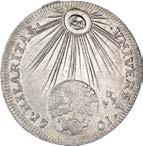
1094 1093
1093. ITALY, Modena (duchy). Cesare d’Este, with Virginia de’ Medici. 1598-1615. AR 6 Bolognini (27mm, 2.78 g, 5h). Crowned coat-of-arms / Crowned coat-of-arms. MIR 711. Toned. In NGC encapsulation 6057185-009, graded MS 63. ($300)

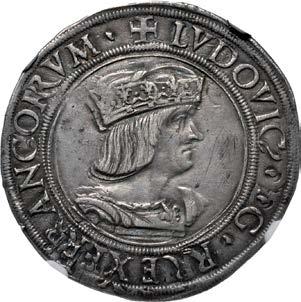
1094. ITALY, Napoli (kingdom). Filippo V di Borbone. 1700-1707. AR Tarì (25mm, 4.29 g, 6h). Napoli (Naples) mint. Dated 1701 IM AG A. Cuirassed and draped bust right / Globe illuminated by radiant sun to right. MIR 311; Pannuti-Riccio 3; KM 126. Lightly cleaned. AU. ($750)

The ninth century was a period of significant change for the papacy and its relations with the Carolingian Empire. While Louis the Pious and his successors continued to include Italy as one of their constituent kingdoms, the empire, under the Treaty of Verdun (843) was divided into three parts. Further partitions in 855, 870, and 880, weakened Carolingian control of the Kingdom of Italy (Regnum Italiae), so that in 887, following the deposition of Charles III, a period of instability and rivalry followed. The cooperation between the papacy and the Carolingians shifted back-and-forth, with the popes of this period experiencing some independence. Much of the reason for this shifting relationship was due to Muslim presence in the area, with the conquest of Sicily and attacks along the Italian coast. As a result of a lack of aid from the Carolingians, the popes themselves began to take action, which was reflected on their coinage. While their issues still nominally recognized their Carolingian overlords, the popes now replaced the imperial monogram with their own monogram, or with their name (sometimes with a depiction of St. Peter).
1095. ITALY, Papal (Papal state). Leo IV. 847-855. AR Denaro (23mm, 1.45 g, 1h). nomine Lothaire I, Holy Roman emperor. Rome mint. ๘ H⌦⌴ͿH²ʽƩV˞ , ƩȵP² monogram; pellet above, two pellets below / ๘ • ˞æ˞ • PዞͿʽV˞ , ⌦ዞ⌴ P²P² monogram. Depeyrot 867R; CNI XV 1; Muntoni 2 var. (obv. legend); Berman 26; MEC 1, 1042-3. Iridescent toning. EF. ($3000)
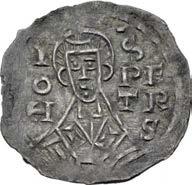

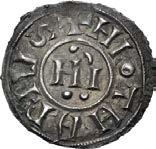
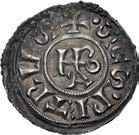

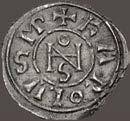


Ex Joseph R. Lasser Collection for the benefit of The Colonial Williamsburg Foundation (Triton XVIII, 6 January 2015), lot 1587; Künker 163 (28 January 2010), lot 238.
Leo IV (847-855), who assumed the papacy without waiting for imperial consent, repaired the churches damaged during the Arab raid of Rome in 846. He then set about building a wall around Vatican Hill. Finally, he organized a league of Italian maritime republics (Naples, Gaeta, and Amalfi) which. together with the papacy, defeated the Saracens at the Battle of Ostia (849).
1096. ITALY, Papal (Papal state). John VIII. 872-882. AR Denaro (22mm, 2.12 g, 11h). nomine Charles II or Charles III, Holy Roman emperor. Rome mint. แ nj²ʼ⌴Ǯ⎍˞ ⍵P , H monogram / ⌽ / ⌐ / ⌽ to left, P / e / ˶ʽ / V⌽ to right, half-length bust of St. Peter, wearing mantum and stole, facing slightly left, holding cross-tipped scepter. Depeyrot 867AO; CNI XV 5; MIR 47; Muntoni 2; Berman 36; MEC 1, 1053. Iridescent toning, deposits in devices, slightly clipped. Good VF. Good metal for issue. Very rare. ($7500)
John VIII (872-882) strengthened Rome’s walls, including fortifying the Basilica of Saint Paul Outside the Walls and the surrounding area. He continued to defend against Muslim encroachment in southern Italy establishing an alliance at Traietto in 877. Finally, he was instrumental in creating a papal fleet.
1097. ITALY, Papal (Papal state). John X. 914-928. AR Denaro (22mm, 0.98 g, 6h). nomine Berengar I, Holy Roman emperor. Rome mint. Struck 915-924. แ BeʽneŶ²ʽƩዮ ⍵P , D monogram / Ʃ / ⌴ / Ɗ to left, ! / ⌽ / P / e / ˶ʽ / V⌽ to right, halflength bust of St. Peter, wearing mantum and stole, facing slightly left, holding cross-tipped scepter. Depeyrot 867AU; CNI XV 1; MIR 76; Muntoni 5; Berman 65; MEC 1, 1072. Toned, deposits, some roughness, peripheral weakness. EF. Extremely rare. ($7500)
Ex Nomisma 53 (20 October 2015), lot 1463; Leu 74 (19 October 1998), lot 571; Edoardo Martinori Collection (Santamaria, 24 November 1913), lot 2856.
A candidate of the Counts of Tusculum, John X (914-928) attempted to unify Italy under Berengar of Friuli (crowned Holy Roman Emperor in December 915). John was instrumental in defeating the Saracens in June that same year at the Battle of Gargliano, where he personally led a coalition of Christian troops in battle, presaging the Crusades of the following century.
1098. ITALY, Papal (Papal state). Clement VI. 1342-1352. AR Grosso tornese (27mm, 3.90 g, 10h). Ponte della Sorga (Pont-de-Sorgues) mint. ḣ ýǭģ⍵ģɃS

, half-length figure of Clement facing, wearing Papal tiara; outer border of lis
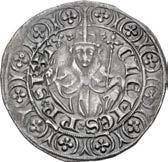
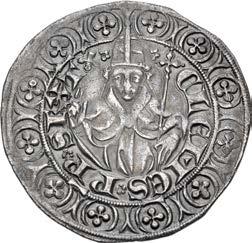
/ , short cross pattée. MIR 198; Muntoni 2; Berman 183. Some light marks under rich toning. Good VF. ($1500)



1099. ITALY, Papal (Papal state). Clement XI. 1700-1721. AV Mezzo scudo d’oro (16mm, 12h). Dated RY 17 (AD 1716). Bust right, wearing camauro, mozzetta, and pallium / Nimbate and draped bust of St. Peter left, head facing. Muntoni 29; Berman 2367; KM 768; Friedberg 189 (Vatican). In NGC encapsulation 3898442-004, graded MS 62. ($500)





Ex Peter Napoli Collection (Classical Numismatic Group 118, 13 September 2021), lot 1290 (hammer $950).
1100. ITALY, Papal (Papal state). Benedict XIV. 1740-1758. AV Zecchino (21mm, 3.40 g, 12h). Bologna mint. Dated RY 2 (AD 1742/3). Bust left, wearing camauro, mozzetta, and pallium / Felsina standing right, head left, holding banner and shield. Muntoni 222; Berman 2798; KM 228; Friedberg 378. Toned, underlying luster. Good VF. Very rare. ($7500)
Ex Eric P. Newman Collection (Heritage 3029, 14 January 2014), lot 30184 (there in NGC XF 45).
1101. ITALY, Sardegna (kingdom). Carlo Felice. 1821-1831. AV 80 Lire (33mm, 25.88 g, 6h). Torino (Turin) mint; segni: L in lozenge and eagle’s head. Dated 1826. Bare head left / Crowned and collared coat-of-arms within wreath. MIR 1032f; KM 123.1; Friedberg 1132. In NGC encapsulation 6489889-002, graded AU 55. ($1500)
1102.
1103.


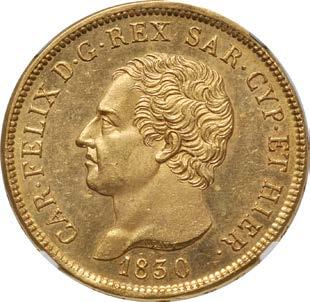




1104.
From
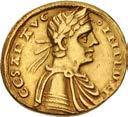

1105 1106
1105. ITALY, Sicilia (kingdom). Federico I (Federico II, Sacro Romano Impero). 1198-1250. AV Augustale (21mm, 5.24 g, 5h). Messina mint. Struck circa 1231-1250. / æģ˨⌈ʼ ⌈⎍Ż / ი Ʊ⍵ዩ ʼɭ⍵ / , laureate, draped, and cuirassed bust right / ๘ ŖʼƱዝዞ ʼƱæ⎍˨ , eagle standing left, head right, with wings spread. Kowalski dies X1/A52; MIR 59; Travaini; Spahr 98 (same dies); MEC 14, 514; Friedberg 134 (Brindisi). Pinhole marks on edge from swivel mount. Near EF. ($10,000)
Ex Numismatica Genevensis SA 14 (15 November 2021), lot 346; Künker 328 (10 October 2019), lot 5146.
1106. ITALY, Sicilia (kingdom). Federico I (Federico II, Sacro Romano Impero). 1198-1250. AV Half Augustalis (15mm, 2.63 g, 6h). Brindisi mint. Struck circa 1231-1250. æģ˨⌈ʼ ⌈⎍Ż / Ʊ⍵ዩ ʼɭ⍵ , laureate, draped, and cuirassed bust right / ๘ ŖʼƱዝዞ / / ʼƱæ⎍˨ , eagle standing left, head right, with wings spread. Kowalski dies M91/B84; MIR 267; Spahr 104; MEC 14, 517 var. (no pellets; mint); Friedberg 135. Toned. In NGC encapsulation 2119442-010, graded MS 63. Rare. ($15,000)
Ex Numismatica Genevenensis 14 (15 November 2021), lot 350 (hammer 26000 CHF).




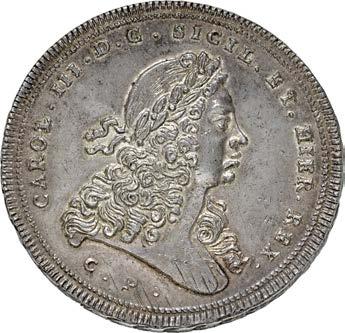
Frederick II Hohenstaufen, “Stupor Mundi” (Wonder of the World), was the most enlightened ruler of the medieval Europe. Besides encouraging the study of both the ancient and natural worlds, Frederick was instrumental in improving relations with the Muslims, negotiating free access to Christian holy sites in Palestine, where all Crusader armies had been unsuccessful. One of his innovations was a gold coinage comparable in style and quality to the gold of the ancient Caesars. The classical motifs proclaimed his inheritance of the legacy of Rome, and the augustale and its fractions were issued concurrently with the publication of the Constitution of Melfi, his codification of Norman law meant to follow the famous Roman law codes. These coins were struck until Frederick’s death in 1250, and may have been continued by his successors for about another fifteen years.
1107. ITALY, Sicilia (kingdom). Carlo III di Spagna. 1720-1735. AR Oncia (55mm, 73.80 g, 6h). Palermo mint. Dated 1733 C P S M. Laureate head right / Phoenix rising from flames; head left, wings spread; radiant sun above. MIR 516; Spahr 54; KM 134. Attractive cabinet toning with hints of golden luster around devices. EF. Beautifully struck for issue. ($7500)


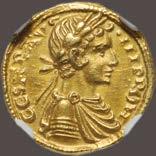


1108.
1109.
1110.
Ex Numismatica
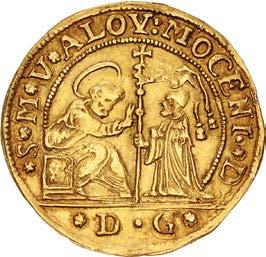
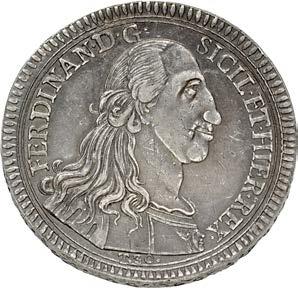
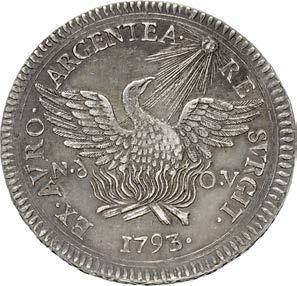
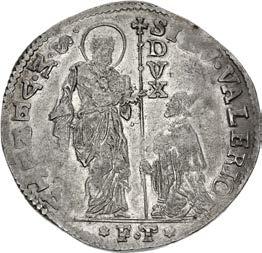
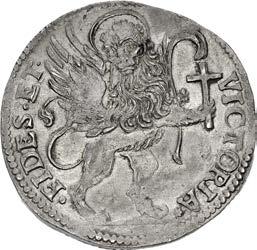
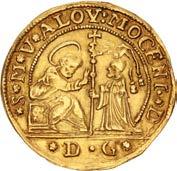

1111. ITALY, Venezia (Venice). Ludovico Manin. 1789-1797. AV 10 Zecchini (50mm, 34.90 g, 12h). St. Mark standing right, presenting long cross to Doge kneeling left on pillow / Christ standing facing, raising hand in benediction and holding Gospels, surrounded by mandorla containing sixteen stars. CNI VIII 62; Papadopoli 2; Paolucci 8; KM 791; Friedberg 1439. Evidence of having been placed in a bezel, scattered light scratches. EF. Very rare. An impressive large-format multiple of the iconic Venetian zecchino. ($15,000)
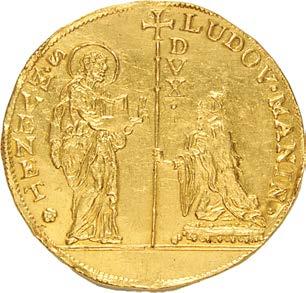
Ex Gorny & Mosch 277 (20 April 2021), lot 1796 (hammer €17000).
Ludovico Manin was the 120th and last Doge of Venice. Although born in Venice to a noble family (his father was Doge Ludovico III Alvise), he spent his early life and public career in other Italian cities. Elected Doge in 1789, his term was troubled by the decline of Venice’s finances and navy. Large gold multiples such as this were intended to be sold to wealthy citizens at above gold “face value” in order to raise money for the government. However much was raised, it was not enough to face the threat of Napoleon Bonaparte, whose war against Austria spilled into Italy in 1796. Doge Manin tried to remain neutral, but Napoleon sent troops and ships into Venice and demanded its surrender in April, 1787. Manin abdicated on May 12, ending the line of Doges that stretched back over a thousand years to AD 726.
1112. ITALY, Kingdom of Lombardo-Veneto. Francis I. 1815-1835. AV Zecchino (20mm, 3.49 g, 12h). Venice mint. Struck 1815. St. Mark standing right, presenting long cross to Doge kneeling left / Christ standing facing, raising hand in benediction and holding Gospels, surrounded by mandorla containing sixteen stars. Paolucci, Zecca 972; KM (C) 9; Friedberg 1517. In NGC encapsulation 6054937-008, graded MS 62. Very rare with less than ten sold in last 20 years at auction. ($5000)


Ex Gadoury (22 October 2021), lot 1549 (hammer €7000).


A very rare, final issue of the venerable Venetian zecchino, struck in the name of Austrian Emperor Francis I as King of Lombardo-Veneto on the occasion of his visit to the Venice mint.


1113.
of
Umberto I. 1878-1900. AR 5 Lire (37mm, 24.99 g, 6h). Rome mint. Dated 1879 R. Bare head right / Crowned and collared coat-of-arms within wreath. MIR 1100a; KM 20. Dark rose-tinted gray toning with blue peripheral iridescence. EF, or better. ($1000)
Ex Montenapoleone 5 (29 May 1984), lot 709.
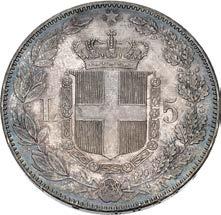
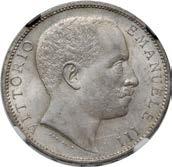

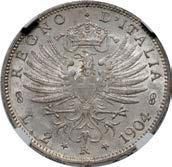

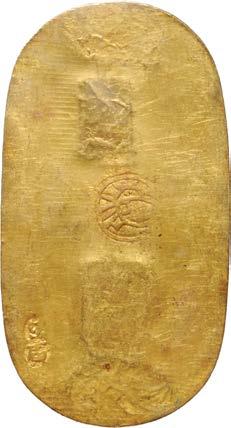
1114.
1115.
Ex
1116. JAPAN, Edo Period. Shotoku-Kyoho Eras. 1714-1736. AV Koban (38x69mm, 17.78 g, 12h). Edo (Tokyo) mint. Kyoho Koban Kin in Hanji within rectangular panel over Mitsutsugu in Hanji within rectangular panel; paulownia flowers above and below / Three official stamps. Hartill, Japanese 8.20; JNDA 09-17; Friedberg 12. In PCGS encapsulation 41059928, graded AU 58. Rare. A finely made and high grade example. ($3000)
Ex Pinnacle Collection (Stack’s Bowers Galleries, 5 April 2021), lot 50037 (hammer $5500).
1117. LIECHTENSTEIN, Principality. Johann II. 1858-1929. AR Vereinstaler (33mm, 18.61 g, 12h). Wien (Vienna) mint. Dated 1862 A. Bare head right / Crowned, collared, and mantled coat-of-arms. KM (Y) 1; Davenport 215. Light golden cabinet toning with significant underlying luster. In NGC encapsulation 6489889-009, graded MS 61. Rare. ($1500)

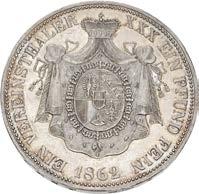
1118. LOW COUNTRIES, Brabant (duchy). Johanna van Brabant. 1355-1406. AV Gouden lam – Mouton d’or (29mm, 4.64 g, 9h). Vilvoorde mint. ๘ _ŷN



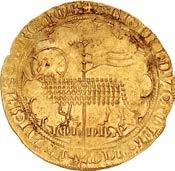

within
quadrilobe; lis in quarters; all within angled quadrilobe; lis in spandrels. Delmonte, Or 43; Delmonte, Brabant 196; De Mey, Louvian & Brabant 224; Friedberg 8. In NGC encapsulation 6489299-014, graded MS 62 (there incorrectly attributed to Jean II of France). ($1500)
1119. LOW COUNTRIES, Oudenaarde (Audenarde). Blockaded by the Spanish under Alessandro Farnese, Duca di Parma, 1582. Restrike AR 40 Stuiver Klippe (38x38mm, 21.16 g). Siege issue. Dated 1582 (but made in the 18th-19th century). · SPES · NOSTRA · DEVS ·, civic coat-of-arms; 15 82 below; all within linear and pearl border; above, crowned spectacles with ⍒ / Blank. van Loon –; Ophthalmologia XI.5 (this coin illustrated); Vanhoudt –, but cf. I 263; cf. Gelder, Noodmunten, 174 (for issue in tin); Maillet 1; Lasser –; CNM –; cf. Korchnak 474 (for issue in tin). Toned, marks. Near EF. ($400)


From the Dr. Jay M. Galst Collection. Ex John Work Garrett Collection (Part, III Numismatic Fine Arts & Bank Leu, 29 March 1985), lot 1040; Scott & Co. 39 (19 December 1881), lot 29.
The wealthy town of Oudenaarde became Protestant following the Reformation and allied itself with the city of Ghent against Charles V. The prolonged siege of 1582 resulted in the subsequent flight of merchants and nobles, resulting in the town failing to recover its former glory.
1120. LOW COUNTRIES, Oudenaarde (Audenarde). Blockaded by the Spanish under Alessandro Farnese, Duca di Parma, 1582. Tin 20 Stuiver Klippe (32x32mm, 15.44 g). Siege issue. Dated 1582. DEVS Ⴛ Ⴛ SPES Ⴛ NRA Ⴛ , civic coat-ofarms; 20 · S · (mark of value) above 15 82 below; all within linear and pearl border; above, crowned spectacles with ⍒ / Blank. van Loon (new edition) 1582.20 and pl. I.XXXI, 555 = Ophthalmologia XI.1 (this coin illustrated); Vanhoudt I 264; Gelder, Noodmunten, 175; Maillet 2; Lasser –; CNM –; Korchnak 475. Toned. EF. ($3000)

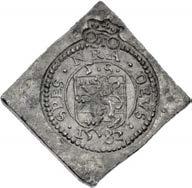


From the Dr. Jay M. Galst Collection. Ex Jonathan K. Kern Collection of Siege Coinage (Classical Numismatic Group 108, lot 1072 (hammer $10,000); Archer M. Huntington Collection, ANS 1001.1.9331 (Numismatica Genevensis SA VII, 27 November 2012), lot 583 (hammer 10,000 CHF on an estimate of 500 CHF).
5 · S ·
Loon
Ophthalmologia
⍒
From the Dr. Jay M. Galst Collection. Ex Archer M. Huntington Collection, ANS 1001.57.5898 (Numismatica Genevensis SA VII, 27 November 2012), lot 588 (part of).
1122. LOW COUNTRIES, Oudenaarde (Audenarde). Blockaded by the Spanish under Alessandro Farnese, Duca di Parma, 1582. Tin 5 Stuiver Klippe (23x24mm, 4.29 g). Siege issue. Dated 1582. · SPES · NRA · DEVS ·, civic coat-of-arms; 5 · S · (mark of value) above, 15 82 below; all within linear and pearl border; above, crowned spectacles with ⍒ / Blank. van Loon –; Vanhoudt I 267; Gelder, Noodmunten, 178; Maillet 4; Lasser 1166; CNM –; Korchnak 477. Toned, slight roughness. VF. ($500)
From the Dr. Jay M. Galst Collection, purchased from Herb Kreindler, 2013. Ex Archer M. Huntington Collection, ANS 1001.1.18681 (Numismatica Genevensis SA VII, 27 November 2012), lot 588 (part of).
1123. LOW COUNTRIES, Oudenaarde (Audenarde). Blockaded by the Spanish under Alessandro Farnese, Duca di Parma, 1582. Tin 5 Stuiver Klippe (25x24mm, 5.90 g). Siege issue. Dated 1582. · SPES · NRA · DEVS ·, civic coat-of-arms; 5 · S · (mark of value) above, 15 82 below; all within linear and pearl border; above, crowned spectacles with ⍒ / Blank. van Loon –; Vanhoudt I 267; Gelder, Noodmunten, 178; Maillet 4; Lasser 1166; CNM –; Korchnak 477. Toned, cleaning scratches. Good VF. ($500)
From the Dr. Jay M. Galst Collection, purchased from Herb Kreindler, 2013. Ex Archer M. Huntington Collection, ANS 1001.57.SP1 (Numismatica Genevensis SA VII, 27 November 2012), lot 588 (part of).
1122 1123 1124 1125
1124. LOW COUNTRIES, Oudenaarde (Audenarde). Blockaded by the Spanish under Alessandro Farnese, Duca di Parma, 1582. Tin 2½ Stuiver – 5 Escalins Klippe (22x22mm, 5.31 g). Siege issue. Dated 1582. · SPES · NRA · DEVS ·, crowned spectacles with ⍒ ; 5 and denominational symbol across field; 15 82 below; all within linear and pearl border; ⍒ above / Blank. van Loon –; Ophthalmologia XI.3 (this coin illustrated); Vanhoudt I 267; Gelder, Noodmunten, 178; Maillet 5; Lasser 1167; CNM –; Korchnak 478. Toned, deposit, slightly rough surfaces. Good VF. ($500)
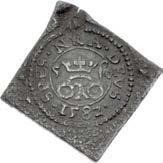







From the Dr. Jay M. Galst Collection. Ex Archer M. Huntington Collection, ANS 1001.1.18683 (Numismatica Genevensis SA VII, 27 November 2012), lot 587 (part of).
1125. LOW COUNTRIES, Oudenaarde (Audenarde). Blockaded by the Spanish under Alessandro Farnese, Duca di Parma, 1582. Tin 2½ Stuiver – 5 Escalins Klippe (22x22mm, 3.60 g). Siege issue. Dated 1582. · SPES · NRA · DEVS ·, crowned spectacles with ⍒ ; 5 and denominational symbol across field; 15 82 below; all within linear and pearl border; ⍒ above / Blank. van Loon –; Vanhoudt I 267; Gelder, Noodmunten, 178; Maillet 5; Lasser 1167; CNM –; Korchnak 478. Toned, slight roughness. VF. ($500)
From the Dr. Jay M. Galst Collection. Ex Archer M. Huntington Collection, ANS 1001.1.18682 (Numismatica Genevensis SA VII, 27 November 2012), lot 587 (part of).
1127 1126
1126. LOW COUNTRIES, Oudenaarde (Audenarde). Blockaded by the Spanish under Alessandro Farnese, Duca di Parma, 1582. Tin 2½ Stuiver – 5 Escalins Klippe (22x22.5mm, 4.27 g). Siege issue. Dated 1582. · SPES · NRA · DEVS ·, crowned spectacles with ⍒ ; 5 and denominational symbol across field; 15 82 below; all within linear and pearl border; ⍒ to left / Blank. van Loon –;Vanhoudt I 267; Gelder, Noodmunten, 178; Maillet 5; Lasser 1167; CNM –; Korchnak 478. Toned, deposits, scratch. VF. ($500)
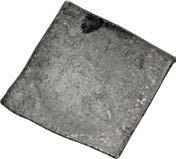
From the Dr. Jay M. Galst Collection. Ex Archer M. Huntington Collection, ANS 1001.1.18682 (Numismatica Genevensis SA VII, 27 November 2012), lot 587 (part of).
1127. LOW COUNTRIES, Oudenaarde (Audenarde). Blockaded by the Spanish under Alessandro Farnese, Duca di Parma, 1582. Tin 1 Stuiver Klippe (14x15mm, 3.03 g). Siege issue. Undated, but struck 1582. Civic coat-of-arms; ⍒ above / Blank. van Loon –; Vanhoudt I 269; Gelder, Noodmunten, 180; Maillet 7; Lasser –; CNM –; Korchnak 479a. Toned. VF. ($300)

From the Dr. Jay M. Galst Collection. Ex Hess-Divo 268 (23 October 1996), lot 597. 1128. LOW
, voided composite cross fleurée with ĕ at center; f ǭ ¨ N in quarters. Elsen 28; Delmonte, Or 460; De Mey, Flanders 196; Friedberg 157. In NGC encapsulation 6489299-011, graded MS 61. ($4000)
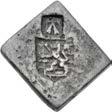
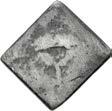
1129. LOW COUNTRIES, Vlaanderen (Flanders [duchy]). Lodewijk II van Male. 1346-1384. AV Gouden schild –Chaise d’or (30mm, 4.48 g, 7h). Gand (Ghent) mint or Mechelen (Malines) mint. Struck 1370/2-1384. ๘ LVdɠVƩýVS Ḻ ēĿƪ ᚤ ᚤ ŷra ᚤ ᚤ ýɠM= ᚤ ⎛ Ḻ ēNS Ḻ FLaNd= , Lodewijk enthroned facing, holding sword and resting hand on coat-of-arms; all within tressure of eight arcs, with trefoils in spandrels / ๘ XPý Ḽ VƩɃýI˶ Ḽ XPý Ḽ rĿŷɃa˶ Ḽ XPý Ḽ IɃPĿra˶ , ornate cross fleurée in ornate quadrilobe; rosettes in spandrels. Elsen 38; Delmonte, Or 466; De Mey, Flanders 205; Friedberg 163. In NGC encapsulation 4824346-007, graded MS 63+. ($1500)




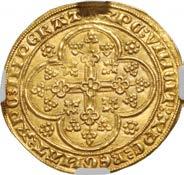
1130. LOW COUNTRIES, Vlaanderen (Flanders [duchy]). Lodewijk II van Male. 1346-1384. AV Gouden schild –Chaise d’or (30mm, 4.38 g, 2h). Gand (Ghent) mint or Mechelen (Malines) mint. Struck 1370/2-1384. ๘ LVdɠVƩýVS Ḻ ēĿƪ ᚤ ᚤ ŷra ᚤ ᚤ ýɠM= ᚤ ⎛ Ḻ ēNS Ḻ FLaNd= , Lodewijk enthroned facing, holding sword and resting hand on coat-of-arms; all within tressure of eight arcs, with trefoils in spandrels / ๘ XPý Ḽ VƩɃýI˶ Ḽ XPý Ḽ rĿŷɃa˶ Ḽ XPý Ḽ IɃPĿra˶ , ornate cross fleurée in ornate quadrilobe; rosettes in spandrels. Elsen 38; Delmonte, Or 466; De Mey, Flanders 205; Friedberg 163. A few hairlines. EF. ($1000)



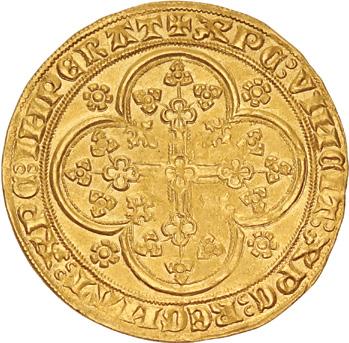
1131. LOW COUNTRIES, Vlaanderen (Flanders [duchy]). Lodewijk II van Male. 1346-1384. AV Gouden schild –Chaise d’or (30mm, 4.50 g, 8h). Gand (Ghent) mint or Mechelen (Malines) mint. Struck 1370/2-1384. ๘ LVdɠVƩýVS Ḻ ēĿƪ ᚤ ᚤ ŷra ᚤ ᚤ ýɠM= ᚤ ⎛ Ḻ ēNS Ḻ FLaNd= , Lodewijk enthroned facing, holding sword and resting hand on coat-of-arms; all within tressure of eight arcs, with trefoils in spandrels / ๘ XPý Ḽ VƩɃýI˶ Ḽ XPý Ḽ rĿŷɃa˶ Ḽ XPý Ḽ IɃPĿra˶ , ornate cross fleurée in ornate quadrilobe; rosettes in spandrels. Elsen 38; Delmonte, Or 466; De Mey, Flanders 205; Friedberg 163. Edge bent. Good VF. ($1000)
1132. LOW COUNTRIES, Vlaanderen (Flanders [duchy]). Filips de Stoute (the Bold). 1384-1404. AV Gouden Engel – Ange d’or (30mm, 4.57 g, 10h). Gand (Ghent) mint. Fourth emission, 1387. ʁƌƱǣƱʁʁѝS Ḻ DEi Ḻ ŷR⍒ Ḻ Dѝҡ Ḻ ÙѝRŷ⎡ ⎜ ýɨȶ⎡ fǣ⍒ND= , angel standing facing, holding two coats-of-arms / แ ÝENEDiýͿѝS ນ ʠѝi ນ ѝENiͿ ນ iN ນ NɨMiNE ນ DɨMiNi , cross annulée and fleurée; lion rampant in quarters; all within angled quadrilobe; trilobes flanking angles. Delmonte, Or 472; De Mey, Flanders 252; Friedberg 167. Lightly clipped. EF. Rare. ($5000)


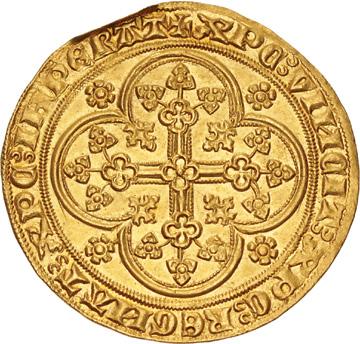
1133. LOW COUNTRIES, Spanish Netherlands. Filips IV. 1621-1665. AV Dubbele gouden souverein – Double souverain d’or (35mm, 11.07 g, 10h). Type I. Antwerpen (Antwerp) mint; mm: hand. Dated 1636. Crowned and armored bust right, wearing ruff / Crowned and collared coat-of-arms. G&H 324-1a; Vanhoudt I 435; Delmonte, Or 167; KM 64.2; Friedberg 103. In NGC encapsulation 6489889-014, graded AU 55. ($2500)

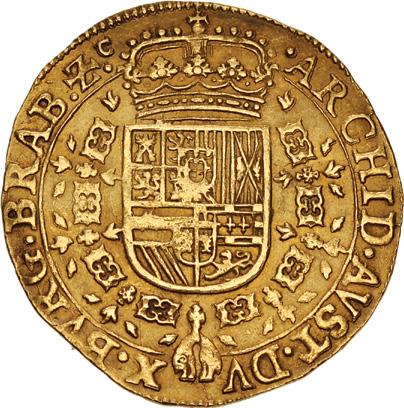
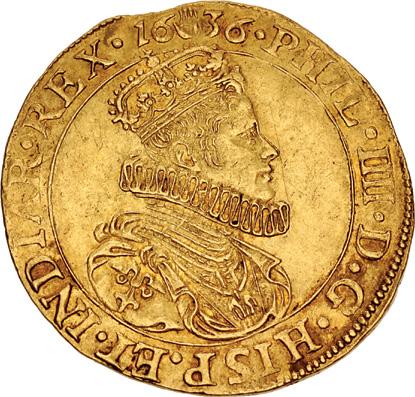
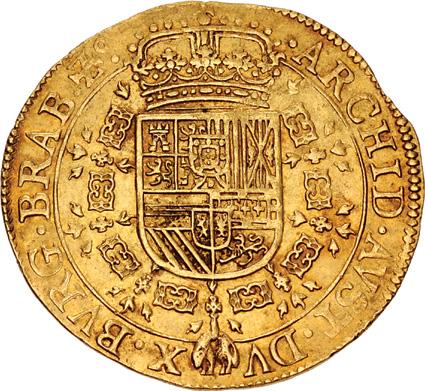

1130 1131 1132 1133 1134 1135
1134. LOW COUNTRIES, Spanish Netherlands. Filips IV. 1621-1665. AV Dubbele gouden souverein – Double souverain d’or (33mm, 11.02 g, 2h). Type II. Bruxelles (Brussels) mint; mm: angel’s head. Dated 1641. Crowned and armored bust right / Crowned and collared coat-of-arms. G&H 324-3b; Vanhoudt I 436; Delmonte, Or 177; KM 74.2; Friedberg 106. In NGC encapsulation 6489889-015, graded MS 61. ($2000)
1135. LOW COUNTRIES, Spanish Netherlands. Filips IV. 1621-1665. AV Soeveren – Souverain (28mm, 5.56 g, 5h). Antwerpen (Antwerp) mint; mm: hand. Dated 1662. Crowned lion standing left, resting left paw on glove and holding raised sword / Crowned and collared coat-of-arms. G&H 325-1; Vanhoudt I 437; Delmonte, Or 170; KM 77.1; Friedberg 107. In NGC encapsulation 4824363-001, graded MS 61. ($1000)
1136 1137
1136. LOW COUNTRIES, Republic of the Seven Netherlands (Dutch Republic). Utrecht. 1581-1795. AV Ducat (22mm, 3.52 g, 12h). Utrecht mint; mm: coat-of-arms and rose. Dated 1729. Knight standing facing, holding sword and bundle of arrows; rosette between legs / Legend in five lines within ornate tablet. P&W Ze Ut 25; CNM 2.43.45; KM 7.1; Friedberg 284. Lustrous. EF. ($750)

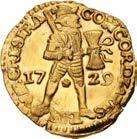
From the S & S Collection. Ex 1735 Vliegenthart Wreck.
1137. LOW COUNTRIES, Republic of the Seven Netherlands (Dutch Republic). Utrecht. 1581-1795. AV Ducat (22mm, 3.49 g, 5h). Utrecht mint; mm: coat-of-arms and rose. Dated 1729. Knight standing facing, holding sword and bundle of arrows; rosette between legs / Legend in five lines within ornate tablet. P&W Ze Ut 25; CNM 2.43.45; KM 7.1; Friedberg 284. Lustrous. EF. ($750)
From the S & S Collection. Ex 1735 Vliegenthart Wreck.
1138. LOW COUNTRIES, Republic of the Seven Netherlands (Dutch Republic). Zeeland. 1581-1795. AR Leicesterreal (43mm, 34.25 g, 5h). Middleburg mint; mm: tower. Dated 1586. Laureate, armored, and draped bust of Robert Dudley, 1st Earl of Leicester, wearing ruff / Coats-of-arms of the seven provinces around central bundle of arrows. P&W Ze 32; CNM 2.49.30; Delmonte 892; Davenport 8871. Attractively toned, flan flaw on obverse, a few scratches. Good VF. Rare. ($2500)
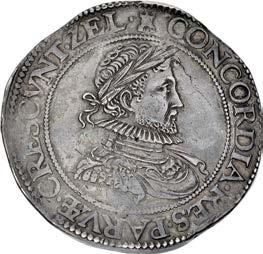
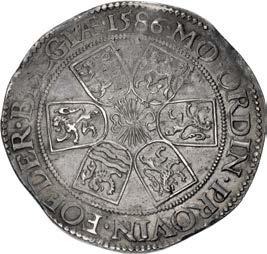
Ex Künker 154 (23 June 2009), lot 1952.
1139. MALAY ARCHIPELAGO, Colonial. Penang Presidency. 1805-1826. Pattern CU Pice – Cent (27mm, 6h). London mint. Dies by Lewis Pingo. Dated 1810. Coat-of-arms surmounted by lion rampant left, with leonine supporters / Pulua Panang (Island of Panang) in Malagasy within counterclockwise wreath of lilies. Pridmore 26; KM Pn1. In NGC encapsulation 2103171-002, graded PF 64. A rare and superb example of the Royal Mint’s early 19th century work for the colonial territories. ($5000)

Ex Gadoury (30 October 2020), lot 1520 (hammer €11000).


The island of Penang was initially added to the British colonial holdings in southeast Asia in 1786 and was administered as part of the Bengal Presidency until 1805. With the change in authority, colonial officials finally began to tackle the endemic shortage of small change experienced in the marketplaces of Penang by authorizing a series of locally made cast tin pice. These crude coins proved to be so extensively counterfeited that authorities petitioned for a modern copper coinage, to be produced at the London mint. Two patterns are known, one each by Lewis Pingo and Thomas Wyon, each distinct from the design ultimately adopted for circulation, also by Pingo.

1140. MEXICO, Colonial. Felipe V. King of Spain, second reign, 1724-1746. AV 8 Escudos (37mm, 27.00 g, 12h). Milled coinage. Mexico City mint. Dated 1744/3 Mo MF. Armored and draped bust right / Crowned and collared coat-ofarms. BW 33.1; Calicó 573; KM 148; Friedberg 8. In NGC encapsulation 6489889-001, graded AU 55. ($2000)
1141. PERU, Colonial. Felipe V. King of Spain, first reign, 1700-1724. AV 8 Escudo (29mm, 26.81 g, 9h). Lima mint. Dated 1712 L M. Coat-of-arms / Crowned pillars of Hercules set on ocean waves. Calicó 438; KM 38.2; Friedberg 7. Deposits, water worn. VF. ($5000)
From the S & S Collection. Likely ex 1715 ‘Plate Fleet’ Wreck.
The earliest reference to the eight escudo coin is from 14 June 1587, when Spanish king Philip II visited the new Segovia mint, and the piece certainly saw major production by 1611. This should not be surprising – with the vast amounts of precious metals pouring out of the Spanish colonies in the New World, larger denominations were then in vogue, leading to the creation of not only a vast, crown-sized coinage in silver (eight reales), but in gold as well. In fact, though it was first created in Spain, the eight escudos was actually struck in much greater numbers in the Americas.
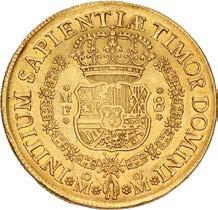


Though formally termed an eight escudo piece, the colloquial names of this coin developed in a confusing manner. As the weight of the piece was set at 27.069 grams, just a few tenths of a gram shy of an eighth of the Castilian mark, the coin became known as an onza in Europe. Sharing the name with both the coin and the weight led to some misunderstandings in the official records.


A second colloquial name, more popular in the Americas, took an even more convoluted route. When the first excelente, a coin bearing the confronted portraits of the two monarchs, was produced under Ferdinand and Isabella, any Spanish gold coin could be broadly referred to as a dobla, from the old Arabic double dinar. As the new excelente weighed twice that, it was termed a doblón, or double dobla. This coin was equivalent to a two-escudo piece, and when the four escudo was struck, it took the name doblón de a cuatro. The eight escudo thus became the doblón de a ocho – “double double of eight.” In English-speaking America, this was abbreviated to simply “doubloon.”

1142. PERU, Colonial. Felipe V. King of Spain, first reign, 1700-1724. AV 8 Escudo (30mm, 27.05 g, 5h). Lima mint. Dated 1718 L M. Coat-of-arms / Crowned pillars of Hercules set on ocean waves. Calicó 454; KM 38.2; Friedberg 7. Good VF. ($6000)
From the DMS Collection, purchased from J. Kern, 2010. Likely ex 1715 ‘Plate Fleet’ Wreck.
1143. PERU, Colonial. Felipe V. King of Spain, second reign, 1724-1746. AV 8 Escudo (34mm, 26.95 g, 12h). Lima mint. Dated (1)727 L M. Coat-of-arms / Crowned pillars of Hercules set on ocean waves. Calicó 580; KM 38.2. In NGC encapsulation 6458806-002, graded MS 61. Struck on a broad flan. ($10,000)



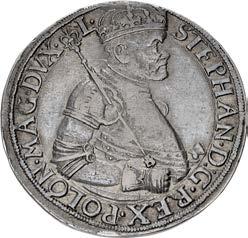

1144. PERU,
State of South Peru. 1836-1839. AV 8 Escudos (37mm, 26.96 g, 12h). Cuzco mint. Dated 1837 B A. Radiant sun with five stars above; four crossed flags behind / Smoldering volcano with crowned tower to left; cornucopia below; in background, ship under sail left on sea; all within wreath. Calicó 2249; KM 167; Friedberg 91. In NGC encapsulation 6489289-002, graded MS 61. ($5000)


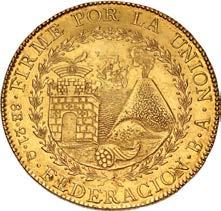
1145.
Ex Helbing (22 March 1926), lot 916. Includes an old collector’s ticket in English.
($4000)
1146. POLAND, Kingdom. Zygmunt III Wasa. 1587-1632. AR Taler (42mm, 28.70 g, 6h). Bydgoszcz (Bromburg) mint; mm: bull’s head coat-of-arms. Dated 1628 I I. Crowned and armored half-length bust right, wearing ruff and holding sword and globus cruciger / Crowned and collared coat-of-arms. Kopicki 1375; KM 48.1; Davenport 4316. Rich iridescent cabinet toning. Good VF. An attractive high grade example. ($2000)


1147. ROMANIA, Kingdom. Carol I. 1881-1914. AV 100 Lei (34mm, 32.21 g, 12h). Commemorating the 40th Year of His Reign. Brussels mint. Dated 1866 and 1906. Bare head left of Carol I as King of Romania / Bare head left of Carol I as Domnitor of Romania. MBR 83; KM 40; Friedberg 4. Hairlines, once cleaned. UNC. ($3000)
1148. ROMANIA, Kingdom. Carol I. 1881-1914. AV 50 Lei (40mm, 16.17 g, 1h). Commemorating the 40th Year of His Reign. Brussels mint. Dated 1866 and 1906. Uniformed bust left / Carol on horseback right. MBR 82; KM 39; Friedberg 6. Light hairlines. AU. ($1500)
1149. RUSSIA, Tsardom of Rus. Petr I Alexeyevich
(Peter the Great). 1682-1725. Novodel AV 2.5 Ducats (22mm, 12h). After an original struck 1682-1696. Crowned double-headed eagle with wings spread, coat-of-arms on breast, holding scepter and globus cruciger / Legend in eight lines. Cf. Diakov N2 (for Ducat); cf. Kaim 1846 (4 Chervonetz); KM –; Friedberg 66a. In PCGS encapsulation 39805178, graded SP 63. Top pop. ($7500)


Diakov notes that originals of this gold piece were given to participants of the Crimean campaigns against the Ottomans in 1687 and 1689. Coins of varying weights were distributed based on rank, with higher ranking officials receiving larger pieces.

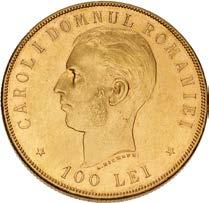



1150. RUSSIA, Empire. Ekaterina II Velikaya (the Great). 1762-1796. AV 5 Roubles (24mm, 6.54 g, 12h). SanktPeterburg (St. Petersburg) mint. Dated 1781 СПБ. Crowned bust right / Crowned cruciform coats-of-arms with crowned double-headed eagle at center. Diakov 413; Bitkin 79; Uzdenikov 0148; Severin 326; KM (C) 78b; Friedberg 130b. Warm orange-peel toning. In NGC encapsulation 6489889-003, graded AU 53. ($4000)
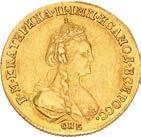

1151. SPAIN, Castile & León. Fernando V & Isabel (The Catholic royals). 1474-1504. AV Doble excelente (28mm, 6.98 g, 12h). Sevilla (Seville) mint. Struck after 1497. ภ Ḧ ŖĚˊNªNdѝ˫ Ḧ ĚͿ Ḧ ĚǭƩ˫ªBĚͿ Ḧ d Ḧ Ż Ḧ ˊĚҟ Ḧ ĚͿ Ḧ ˊ Ʃ Ḧ , crowned and draped bust of Ferdinand right and crowned and draped bust of Isabel left, vis-à-vis; pellets above and at center, below, three pellets around ˫ over eight-pointed star / Ḧ ˫ѝB Ḧ ѝNBˊª Ḧ ªǭªˊѝ⍴ Ḧ Ϳѝªˊѝ⍴ Ḧ ʖˊɱ Ḧ , nimbate eagle facing, head left, with wings displayed, bearing crowned royal coat-of-arms. Cf. MEC 6, 772; ME 2933; Calicó y Trigo 72; Friedberg 129. Small scratch. Good VF. Well struck. ($3000)
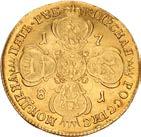

From the DMS Collection, purchased from J. Kern, 2010.
1152. SPAIN, Provisional Government. 1868-1870. AR 20 Céntimos (15mm, 1.03 g, 6h). Madrid mint. Dated 1870 SN M (7 0 en estrellas). Hispania seated left, holding olive branch / Crowned coat-of-arms flanked by Pillars of Hercules. ME 17419; Calicó y Trigo 22; KM 20. Attractive toning. UNC. Key date, with a mintage of only 5000. ($1500)


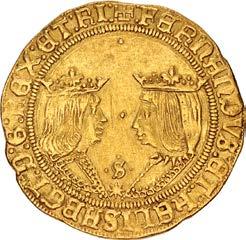



1153.
1154. SPAIN, Kingdom. Alfonso XIII. 1886-1931. CU Prueba de Peseta (22mm, 5.12 g, 6h). Madrid mint. Dated 1905 SM V (19 12 en estrellas). Uniformed bust left / Crowned coat-of-arms flanked by Pillars of Hercules. ME 17621; Calicó y Trigo 52 note; KM –. Brown surfaces with hints of red, minor spots, edge bump. AU. A rare off-metal or pattern strike. ($1000) Ex Áureo & Calicó 380 (16 December 2021), lot 186 (hammer €900).



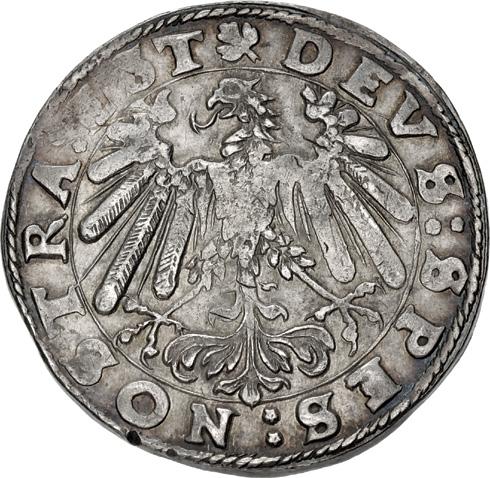



1158. AUSTRIA, Wien (Vienna). AV Medal of 10 Ducats (46mm, 34.51 g, 1h). Struck circa 1648. SALVATOR MVNDI, nimbate and draped bust of Christ left; all within wreath / Two coats-of-arms within ornate cartouch; + MVN R P + above, + VIENN + below; all within wreath. Edge marks, once polished, slightly double struck. EF. Rare. ($7500)
Ex Emporium Hamburg 93 (4 May 2021), lot 1704 (hammer €13,500).
The “Salvator medals” of Vienna were instituted by the City Council in 1575 and were created as New Year’s gifts to high ranking and important officials. These high-value gifts were a significant supplement to the recipient’s income, and as such straddle the border between medallic issues and circulating coinage. The practice continued well into the 19th century.
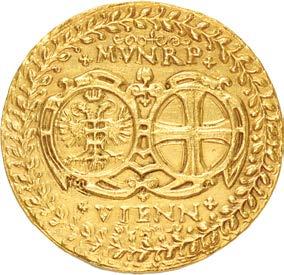





1159.
Rudolf
1160. FRANCE, First Republic. Consulat. Napoléon Bonaparte. Premier Consul, 1799-1804. AR “Essai de 5 Francs” (37mm, 26.06 g, 6h). By Tiolier. Dated L’An 10 (AD 1802). BONAPARTE PREMIER CONSUL, bare head right / Engraved CONCOURS MONÉTAIRE • AN X •, 5/ FRANCS. Edge engraved: (star) DIEU PROTEGE LA FRANCE. Once polished, now retoning, a few light scratches. Good VF. An extremely rare satirical piece related to the complexities of mint politics in the Consulate. ($1000)
On 20 Ventose, year 11 (11 March 1803), the administration informed the Hotel de Monnaies that Napoléon, his wife, and the Minister of Finance would visit the premises on the following day, 21 Ventose (12 March). They also requested that sufficient silver and materials be provided to the engraver Tiolier, so that he could prepare and strike a medal in the presence of the First Consul. The medal was a simple design bearing a plain bust of Napoléon on the obverse and a commemorative legend on the reverse. On the present example, however, the reverse was re-engraved to refer to a concours monétaire in year 10. However, such a function was not held until the following year.
This enigmatic reverse must be related to the removal of the famous Augustin Dupré, the former chief engraver of France. Dupré was not present at Napoléon’s 21 Ventose visit, as he was evidently ill with an eye infection, though he had intended to use that opportunity to impress and ingratiate himself to the First Consul. The chief engraver’s former association with the Jacobins had called his loyalty to the new regime into question. In fact, rumors even circulated that Dupré was such a staunch republican that he had refused to engrave a coin with a bust of Napoléon, a theory dispelled in letters by Dupré himself.
Tiolier, however, was a clear favorite of the First Consul, and had been awarded the contract for engraving new coinage dies. On 12 Germinal (2 April), Dupré was requested to provide any outstanding dies or equipment to Tiolier, though he dragged his feet, claiming that while some did belong to the mint, others were his personal property. Finally, on 29 Germinal (19 April), Dupré was provided with an itemized list of dies, punches, and material to be sent, and in the same letter was officially dismissed from his post as chief engraver

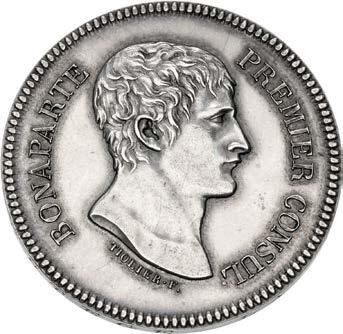
This unique piece began its life as a commemorative of Napoléon’s tour of the Hotel des Monnaies on 21 Ventose, year 11. It was then reengraved, either by Dupré himself or by one of his allies, to refer to a concours monétaire in year 10. This imaginary concours would refer to the machinations of Napoléon and Tiolier, making the new appointment a done deal before artistic or technical skill was even considered.
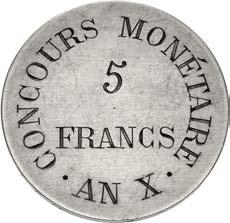

1161. FRANCE, First Empire. Napoléon I. 1804-1814. AV Medallet (14mm, 1.78 g, 6h). Coronation of Napoléon. Unsigned dies. Dated L’An 13 (AD 1804). NAPOLEON EMPEREUR, laureate head righ / LE SENAT ET LE PEUPLE, mantled figure of Napoléon standing facing, holding eagle-tipped scepter, being carried by a senator to left and a soldier to right; book to left, plowshare to right; AN XIII in exergue. Bramsen 329. Lightly toned, underlying luster. EF. ($750)



b

1162. FRANCE, Premier Empire. Napoléon I. 1804-1814. Lot of two (2) Medals. The Annexation of Simplon. By Andrieu and Brenet. Dated 1807. Both medals: NAPOLEON EMP. ET. ROI., laureate head rightl ANDRIEU F · on truncation of neck / Simplon (as old man of colossal size), seated, legs crossed, in mountain pass, through which winds a baggage train; 1807 on side of cliff; BR to lower right; SIMPLON in exergue. Includes the following: 1) AR issue (41mm, 36.04 g, 12h) // 2) Æ issue (41mm, 36.73 g, 12h). Bramsen 688 (for both metals). Iridescent toning (for AR) and brown surfaces (for Æ). EF. ($300)



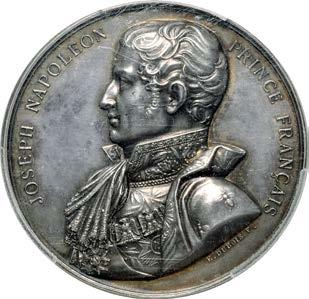
1163.

1164. INDIA, Colonial. British India. temp. Victoria. Queen of the United Kingdom, 1837-1901. AR Presentation Medal (56mm, 106.20 g, 12h). In Honor of Sir Jamsetjee Jeejebhoy. By William Wyon. Dated 1842. VICTORIA REGINA, young head left, wearing the Diamond Diadem; W. WYON. R · A · on truncation of neck / ★ FROM THE BRITISH GOVERNMENT IN HONOR OF HIS MUNIFICENCE & HIS PATRIOTISM A: D: 1842., SIR/JAMSETJEE/JEEJEBHOY/KNIGHT in four lines within oak wreath; crown above. Puddester 842.1. Tiny areas of iridescence, slight repair to mounting rim. As made. Frosted and glazed and luminetted (encased in glass covers, joined by a silver rim) with original suspension loop. Rim inscribed BY COMMAND OF HM QUEEN VICTORIA TO SIR JAMSETJEE JEEJEBHOY KT. Extremely rare. ($3000)

Sir Jamsetjee Jeejebhoy, 1st Baronet Jejeebhoy of Bombay (1783-1859), was an Indian Parsi merchant and philanthropist. Making his fortune in cotton and in the opium trade with China, he was notable for his charitable works, including supporting the poor, public charities for education, and numerous public works. In 1842, he was knighted at a special Durbar by the British government for his good deeds with a gold version of our medal.
While silver versions of this medal are known, this type, with frosted surfaces and encased in glass covers joined by a silver rim are extremely rare. At the time of publication, Puddester noted only two examples: one in the family of Sir Jamsetjee Jeejebhoy with a different edge inscription; the other sold in Glendining’s (22 November 1989), lot 415.

1165. INDIA, Colonial. British India. temp. Victoria. Queen of the United Kingdom, 1837-1901. AV Presentation Medal (84x55mm, 100.25 g, 12h). Visit of the Prince of Wales, 1875-1876. By Phillips Brothers, London. Bare head of Prince of Wales left; laurel wreath around / H R H ALBERT EDWARD PRINCE OF WALES INDIA 1875-6, Prince of Wales plumes within Order of the Garter and Collar of Order of India; floral border around; PHILLIPS FECIT/o1875o in two lines on Garter. Edge: engraved H. H. RAJA[H ... R]AO; stamped NO 42. Puddester 875.1.3. Lightly toned, hairlines, tooling and chasing, numerous edge marks, with original suspension clasp and loop attached. EF. Extremely rare, only this specimen in CoinArchives. ($7500)

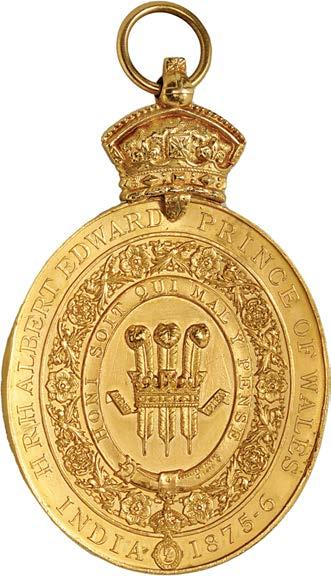
1166. IRAN, Pahlavis. Muhammad Reza Shah. AH 1360-1398 / AD 1941-1979. Proof AV Medal (39mm, 24.80 g, 12h). Mother’s Day issue. Issued by the University’s Credit Foundation. Dated SH 1354 (AD 1975). AGW: 2.8953 oz. Bust of Shahbanu left, wearing tiara; date below / Mother and children standing around Shahbanu seated right, holding open book; University’s Credit Foundation and fineness (.900). EDGE: |||||. See Heritage 3067, lot 31856 (for a larger example). A few light hairlines. Proof. ($1500)




1167. ITALY, Firenze (Duchy). Cosimo I de Medici. As Duca di Firenze, 1537-1569. AR Medal (30mm, 9.41 g, 10h). By Domenico di Polo de’ Vetri. Struck 1537. * COSMVS * MEDICES * REIPV * FLOREN * DVX II, armored bust right / Crossed anchors within ribbon reading D VABV S. Attwood 778. Even cabinet toning with iridescent highlights. Good VF. An attractive example of this very rare, testone-sized medal. ($5000)

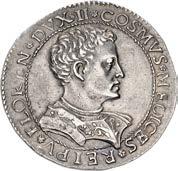
Ex Nomisma S.p.a. 64 (17 December 2021), lot 467; Michael Hall Collection (Part III, Baldwin’s 67, 28 September 2010), lot 2263.
1168. ITALY, Papal (Prisoner of the Vatican). Pius X. 1903-1914. AV Medal (32mm, 22.24 g, 12h). Fifty Years in the Priesthood. By S. Johnson. Dated 1908 (in Roman numerals). PIVS · X · PONT · MAX ·, bust right, wearing zucchetto, mozzetta, and mantum / Scene of the Last Supper: nimbate figure of Christ facing at table, holding bread over chalice, disciples around; in exergue, · IN · SOLEMNIE ·/ · OB · ANNVM · SACERDOTTI · L ·/ · MCMVIII ·. Matte finish, a few edge marks and light hairlines. EF. ($1000)


1169. ITALY, Kingdom of Lombardo-Veneto. Francis I. 1815-1835. AV Medal (22mm, 4.99 g, 6h). Oath of Allegiance. Dated 15 May 1815 (in Roman numerals). FRANCISCVS AVSTR IMP HVN BOH LONGOB VENET GAL ET LOD REX A A, two crowned coats-of-arms; crossed plow and anchor below / FIDES NOVI REGNI/ SACRAMENTO FIRMATA/ MEDIOLANI XV MAII/ MDCCCXV; crown above. MIR 512/1; Crippa 21/A. In NGC encapsulation 2119072-048, graded MS 64. ($2000)




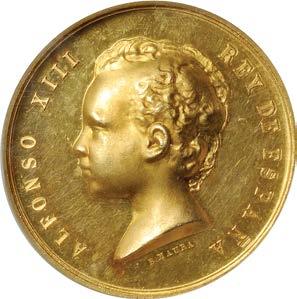

Ex Numismatica Genevensis 14 (15 November 2021), lot 333; Hess-Divo 333 (30 November 2017), lot 594; Guia Collection (Bowers & Merana, 23 March 1988), lot 669.

1170.
1171.
Miguel
1172. THAILAND (SIAM), Rattanakosin Kingdom. Rama V. 1868-1910. Æ Medal (71mm, 115.79 g, 12h). Centennial of the founding of the Rattanakosin Kingdom and the Capital at Bangkok. Struck 1882. Bust left / View of Wat Phra Kaew (Temple of the Emerald Buddha). Brown surfaces, a few spots, scattered marks. EF. Rare. ($2000)


Ex Hess-Divo 332 (31 May 2017), lot 906; Numismatica Genevenensis 5 (3 December 2008), lot 1344 (hammer 8000 CHF).

Rama V, the regnal name of Chulalongkorn of the House of Chakri, was the son of Mongkut (Rama IV), who reigned 1851-1868 and became well known as the subject of Anna and the King of Siam, the fictionalized memoir of the English governess Anna Leonowens. Chulalongkorn was taught the English language and about western culture by Leonowens, and he is said to have based many of his reforms, including a ban on the practice of prostration before the king, on her influence.
1173. UNCERTAIN
Circa 12th-13th
Appliqué for Icon Frame (36mm, 3.60 g, 12h). Facing bust of Christ Pantocrator; HC XC (sic), each with macron above, across field; field silvered with details inlaid with gold leaf / Blank. Deposits, numerous cleaning marks. Intact. ($3000)
Ex Leu Numismatik AG Web Auction 15 (27 February 2021), lot 2775.

1174. Lot of one hundred thirty-nine (139) medals depicting ophthalmologists. Some plated in Ophthalmologia. Includes: medals and plaquettes in various metals depicting ophthalmologists. Some plated in Ophthalmologia. AU to UNC. One hundred thirty-nine (139) pieces in lot. LOT SOLD AS IS, NO RETURNS. ($600)
From the Dr. Jay M. Galst Collection.
1175. Lot of sixty-five (65) medals depicting ophthalmologists. Some plated in Ophthalmologia. Includes: medals and plaquettes in various metals depicting ophthalmologists famous in other fields. AU to UNC. Sixty-five (65) pieces in lot. LOT SOLD AS IS, NO RETURNS. ($300)
From the Dr. Jay M. Galst Collection.
1176. Lot of fifty-seven (57) medals depicting ophthalmologists. Some plated in Ophthalmologia. Includes: medals and plaquettes in various metals depicting early practitioners of ophthalmology. AU to UNC. Fifty-seven (57) pieces in lot. LOT SOLD AS IS, NO RETURNS. ($250)
From the Dr. Jay M. Galst Collection.
1177. Lot of two hundred seventy-eight (278) medals depicting scientists. Some plated in Ophthalmologia. Includes: medals and plaquettes in various metals depicting scientists and other physicians who contributed to ophthalmology. AU to UNC. Two hundred seventy-eight (278) pieces in lot. LOT SOLD AS IS, NO RETURNS. ($1500)
From the Dr. Jay M. Galst Collection.
1178. Lot of eighty-one (81) medals depicting eyes. Some plated in Ophthalmologia. Includes: medals, coins, tokens, and jetons in various metals depicting eyes as symbols. AU to UNC. Eighty-one (81) pieces in lot. LOT SOLD AS IS, NO RETURNS. ($400)
From the Dr. Jay M. Galst Collection.
1179. Lot of forty-seven (47) medals depicting one-eyed individuals. Some plated in Ophthalmologia. Includes: medals and tokens in various metals depicting one-eyed individuals. AU to UNC. Forty-seven (47) pieces in lot. LOT SOLD AS IS, NO RETURNS. ($200)
From the Dr. Jay M. Galst Collection.
1180. Lot of one hundred thirty (130) medals depicting the vision-impaired. Some plated in Ophthalmologia. Includes: medals, plaquettes, and coins in various metals depicting famous vision-impaired people. AU to UNC. One hundred thirty (130) pieces in lot. LOT SOLD AS IS, NO RETURNS. ($600)
From the Dr. Jay M. Galst Collection.
1181. Lot of seventy-four (74) medals depicting mythology and religion. Some plated in Ophthalmologia. Includes: medals, coins, and tokens in various metals dealing with mythology and religion involving the eye. AU to UNC. Seventy-four (74) pieces in lot. LOT SOLD AS IS, NO RETURNS. ($300)
From the Dr. Jay M. Galst Collection.
1182. Lot of one hundred twenty-one (121) medals depicting spectacles. Some plated in Ophthalmologia. Includes: medals and tokens in various metals with spectacles depicted as an optical instrument or depicted as a symbol. AU to UNC. One hundred twenty-one (121) pieces in lot. LOT SOLD AS IS, NO RETURNS. ($600)
From the Dr. Jay M. Galst Collection.
1183. Lot of two hundred sixty-three (263) medals depicting opticians. Some plated in Ophthalmologia. Includes: medals, tokens, and coins in various metals depicting opticians, optometrists, the optical industry and other optical scientists, including countermarked coins and encased coins of opticians and spectacle merchants. AU to UNC. Two hundred sixty-three (263) pieces in lot. LOT SOLD AS IS, NO RETURNS. ($1000)
From the Dr. Jay M. Galst Collection.
A limited number of copies of Ophthalmologia: Optica et Visio in Nummis are available at www.cngcoins.com.










1184. CELTIC, Imported coinage. Ambiani. Circa 100-50 BC. AV Stater (17mm, 6.23 g). Gallo-Belgic E. Gallic Wars Issue. Plain bulge / Large disjointed horse right; ornaments around; solid exergue line above pellets-in-crescents. Depeyrot, NC VI, 161; D&T 238; Van Arsdell 54-1; ABC 16; SCBC 11. Good VF. With an old collection ticket in an uncertain hand. ($750)


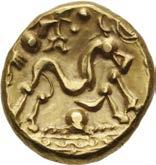

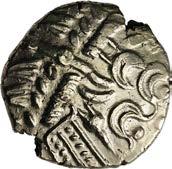



From the Pythagoras Collection, purchased from Wolfshead Gallery. Ex Capt. E. Shepherd (Glendining, 19 September 1918), lot 2.
1185. CELTIC, Imported coinage. Ambiani. Circa 100-50 BC. AV Stater (16mm, 6.15 g). Gallo-Belgic E. Gallic Wars Issue. Plain bulge with traces of type near edge / Large disjointed horse right; ornaments around; solid exergue line above pellets-in-crescents. Depeyrot, NC VI, 161; D&T 238; Van Arsdell 56-1; ABC 16; SCBC 11. A few light marks on obverse. Near EF. The ornament above the horse is rendered slightly differently on this example than on the vast majority of these uniface staters. ($750)
From the Trehearne Collection.
1186. CELTIC, Imported coinage. Ambiani. Circa 100-50 BC. AV Stater (17mm, 5.86 g). Gallo-Belgic E. Gallic Wars Issue. Plain bulge / Large disjointed horse right; ornaments around; solid exergue line above pellets-in-crescents, S S below horse. Depeyrot, NC VI, 161; D&T 242; Van Arsdell –; ABC 16 var. (no

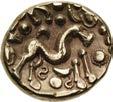



From
From
1188. CELTIC, Atrebates & Regni. Uninscribed. Circa 60-20 BC. AV Stater (20mm, 5.86 g). Selsey Uniface type (Atrebatic B). Plain surface / Disjointed horse right; ‘arm’ above, wheel below. Bean Q1-6; ABC 488; Van Arsdell 216-1; Hobbs 461-75; SCBC 39. Underlying luster, some light hairlines on obverse as usual. EF. A well struck example. ($1000)


From the Trehearne Collection.
1189. CELTIC, Atrebates & Regni. Uninscribed. Circa 60-20 BC. AV Quarter Stater (13mm, 1.31 g, 5h). Selsey Dahlia, no mane type (Atrebatic B). Devolved head of Apollo right with ‘hidden face’ motif / Horse running right; floral sun above, wheel below, pellets-in-annulets around. Bean QcT1-3; ABC 503; Van Arsdell 220-1; Hobbs 481-3; SCBC 48. Lustrous. EF. ($750)
From the Trehearne Collection.
1190. CELTIC, Atrebates & Regni. Uninscribed. Circa 60-20 BC. AV Quarter Stater (15mm, 1.39 g, 5h). Bognor Cogwheel, mane type (Atrebatic B). Devolved head of Apollo right with ‘hidden face’ motif / Horse running right; floral sun above, ‘cogwheel’ below, pellets-in-annulets around. Bean QcTM1-1h; ABC 509; Van Arsdell 226-1; Hobbs 519-35; SCBC 48 var. (horse with mane). Minor marks on obverse. Hairline flan crack. Unusually broad flan. Near EF. ($1000)

From the Trehearne Collection.
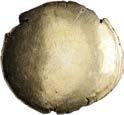
1191. CELTIC, Atrebates & Regni. Uninscribed. Circa 60-20 BC. AV Quarter Stater (10mm, 1.12 g). Mossop Cruciform type. Cruciform design resembling the head of a dandelion with central sunburst motif / Horse right with body composed of two annulets; floral sun above, wheel below. Bean –; ABC 797 (Belgae, this coin illustrated); Van Arsdell –; SCBC –. Toned. Good VF. Extremely rare. ($1000)








From the Pythagoras Collection, purchased from Wolfshead Gallery.

1192. CELTIC, Atrebates & Regni. Tincommius. Circa 30 BC-AD 10. AV Stater (18mm, 5.38 g, 6h). Tincomarus Warrior type (Atrebatic F). Southern mint. Table inscribed COÂ F / Warrior, preparing to hurl spear, on horse leaping right; star to upper left, annulet to lower left, TiN to lower right. CCI 95.4028 (this coin); Bean TIN4-7c; ABC 1067; Van Arsdell 385-1; Hobbs 770-4 var. (annulet on rev.); SCBC 76. Edge splits, well centered. Good VF. ($1500)






Ex Morton & Eden 80 (13 June 2016), lot 139; Sotheby’s (22 March 1990), lot 295.
1193. CELTIC, Atrebates & Regni. Eppillus. Circa 10 BC-AD 10. AV Quarter Stater (9mm, 1.17 g, 11h). Epillus Calleva Daisy type (Atrebatic G). Cavella mint. CALLeu; stars above and below / Dog (or lion?) running right; eRRi above, pelleted daisy below. Bean EPP1-2; ABC 1148; Van Arsdell 407-1; Hobbs 986-1001; SCBC 96. Obverse slightly off center. Near EF. ($500)


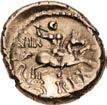

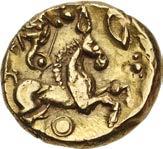
From the Pythagoras Collection.
1194. CELTIC, Atrebates & Regni. Verica. Circa AD 10-40. AV Stater (17mm, 5.30 g, 12h). Warrior Rex type (Atrebatic J). Cavella mint. Tablet inscribed COÂ • F / Warrior, preparing to hurl spear, on horse leaping right; lituus to lower left; uir above, rex below. Allen & Haselgrove Series Series C, 14 (Dies E/d); Bean VERC2-1; ABC 1190; Van Arsdell 500–1; Hobbs 1152 (same obv. die); SCBC 120. Some light marks and faint scratches. Good VF. ($1500)
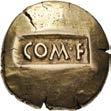
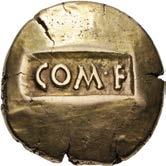
1195. CELTIC, Trinovantes & Catuvellauni. Uninscribed. Circa 55-50 BC. AV Stater (16mm, 5.85 g, 8h). Early Whaddon Chase type (Trinovantian D). Wreath, cloak and crescents; rounded wing motif above wreath / Celticized horse right; wing motif and three pellets above, [lozenge before], pellet and annulet below. ABC 2433; Van Arsdell 1476-1; Hobbs 310 (same dies); SCBC 32. Minor die breaks. Richly toned. Near EF. With an old collection ticket in an uncertain hand. ($1000)
From the Pythagoras Collection, purchased from Wolfshead Gallery. Ex English Coins Formed by a member of the Royal Numismatic Society deceased ‘Sir Augustus Prevost’ (Glendining, 22 January 1919), lot 6.
Sir Augustus Prevost (1837 - 1913), was a partner of his family banking firm Morris, Prevost & Co, later to become Barings Bank. He was made a director of the Bank of England in 1881 and served as governor from 1901 to 1903.
1196. CELTIC, Trinovantes & Catuvellauni. Uninscribed. Circa 55-50 BC. AV Stater (15mm, 5.55 g, 11h). Middle Whaddon Chase, big wheel type (Trinovantian E). Wreath in cross shape with two confronted crescents at center; wing motifs in forward quarters / Horse leaping right; wheel below, wing motif and pellets above. ABC 2442; Van Arsdell 1487-1; Hobbs 331-5; SCBC 32. Minor die rust on obverse. Toned. Near EF. ($1500)
From the Pythagoras Collection, purchased from Wolfshead Gallery.
1197. CELTIC, Trinovantes & Catuvellauni. Addedomaros. Circa 40-30 BC. AV Stater (19mm, 5.52 g). Spiral type (Trinovantian J). Six-armed spiral of wreaths / Horse right; pellets-in-annulets around, ‘cornucopia’ below; [ADDiiDO] Â above. ABC 2517; Van Arsdell 1620-1; Hobbs 2404-2; SCBC 201. Toned, a few edge splits, struck on a broad flan. Near EF. ($2000)
Ex Nomos FPL 8 (Winter-Spring 2014), no. 116.
1198. CELTIC, Trinovantes & Catuvellauni. Addedomaros. Circa 40-30 BC. AV Stater (18mm, 5.46 g). Spiral type (Trinovantian J). Six-armed spiral of wreaths; pellets between limbs / Horse right; pellets-in-annulets around, ‘cornucopia’ below; [ADDiiDOÂ above]. ABC 2517; Van Arsdell 1620-1; Hobbs 2396-401; SCBC 201. Struck from a slightly worn obverse die. Near EF. ($1500)
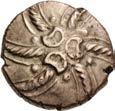


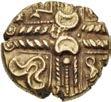
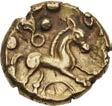
From the Trehearne Collection. Note the additional pellets between the arms of the spiral on this coin compared to previous lot.
1199. CELTIC, Trinovantes &
Circa 40-30 BC. AV Quarter Stater (14mm, 1.45 g). Addedomaros X Box type (Trinovantian K).

and small crescents at each tip / Horse right; three-branch motif above, saltire-in-square below; ADD[eDOÂArOÍ]. CCI 03.1460 (this coin); ABC 2520; Van Arsdell 1638-1; Hobbs 2422-3; SCBC 205. Toned, obverse slightly off center. Good VF. Very rare. ($750)
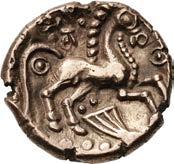
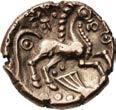




From the Pythagoras Collection, purchased from Wolfshead Gallery. Ex Spink Numismatic Circular CXI.5 (October 2003), no. CC0050. Found near Brandon, Suffolk, 2003.

1200. CELTIC, Trinovantes & Catuvellauni. Dubnovellaunus. Circa 30-10 BC. AV Stater (18mm, 5.39 g). Dubnovellaunus Branch type (Trinovantian L). Open wreath; two outline crescents back to back at center, pellet-in-annulets above and below / Horse leaping left; pellet to left, pellet-in-annulet above, branch below; [DuBN]Ouii[LA] above. Kretz, Trinovantian group D, dies D3-4; ABC 2392; Van Arsdell 1655-9; Hobbs 2436 (same obv. die); SCBC 207. Light scuff and minor die break on obverse. EF. Well centered. Rare in this condition. ($2500)


From the Trehearne Collection.
1201. CELTIC, Trinovantes & Catuvellauni. Tasciovanus. Circa 20 BC-AD 10. AV Stater (17mm, 5.45 g). Tasciovanus Hidden Faces type (Trinovantian M). First coinage. Crossed vertical and horizontal wreaths with opposed crescents at center; annulets and sprays forming hidden faces in quarters / Horse leaping right; bucranium and annulet within ring of pellets above; hook-like object below; [TAÍ]CiAu AN O above. Kretz, Early obv. type D, rev. type III; ABC 2553; Van Arsdell 1680-1; Hobbs 1601-3; SCBC 214. Light scuff on obverse. VF. Rare. ($1500)
From the Trehearne Collection.
1202. CELTIC, Trinovantes & Catuvellauni. Tasciovanus. Circa 20 BC-AD 10. AV Stater (18mm, 5.47 g). Tasciovanus Warrior type (Trinovantian N). Second coinage. Crossed vertical and curved wreaths with opposed crescents at center; annulets and sprays forming hidden faces in quarters / Warrior, holding carnyx, on horse right; five-spoked over triple pellets and crescent to right; five-spoked wheel to lower left; T A Í C counterclockwise around. Kretz, Second obv. type A/B1, rev. type II, var. A; ABC 2562; Van Arsdell 1732-9; Hobbs 1609-11; SCBC 217. An attractive, toned specimen. Near EF. Rare. ($2500)
From the Trehearne Collection.
1203. CELTIC,
Circa 20 BC-AD
AV Quarter Stater (14mm, 1.36 g). Tasciovanus Acorn type (Trinovantian M). First coinage. Crossed wreaths, one curved, with opposed crescents at center; teardrop motifs in quarters / Horse stepping left; acorn-like object below; [TAÍCi]Au[A] above. Kretz, Quarter type B; ABC 2586; Van Arsdell 1688-1; Hobbs 1651-3; SCBC 221. Lustrous. EF. Rare. ($1000)




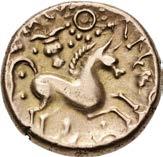




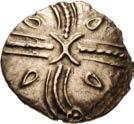

From the Trehearne Collection.

1204. CELTIC, Trinovantes & Catuvellauni. Tasciovanus. Circa 20 BC-AD 10. AV Quarter Stater (12mm, 1.38 g, 4h). Tasciovanus Tasci type (Trinovantian M). Second coinage. Crossed linear wreaths with two oppposed crescents at center; pellets-in-annulets at ends; T A Í C in quarters / Horse leaping right; bucranium above, pellets around; T AÍ C counterclockwise around. Kretz, Quarter type B var. 3; ABC 2595; Van Arsdell 1692-1; Hobbs 1643; SCBC 223. Lustrous. EF. ($1000)



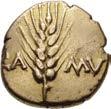

From the Trehearne Collection.
1205. CELTIC, Trinovantes & Catuvellauni. Tasciovanus. Circa 20 BC-AD 10. AV Quarter Stater (11mm, 1.38 g, 11h). Tasiovanus Pegasus type (Trinovantian O). Third coinage. TAÍC on central panel; vertical wreath behind; pellets-in-annulets flanking / Pegasos leaping left; pellet-in-annulet to left, multi-pointed star below. Kretz, Quarter var. 1; ABC 2601; Van Arsdell 1786-1; Hobbs 1649 (same dies); SCBC 223. Some die wear. EF. ($1000)




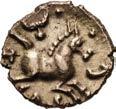
From the Trehearne Collection.
1206. CELTIC, Trinovantes & Catuvellauni. Cunobelin. Circa AD 10-43. AV Stater (16mm, 5.52 g, 4h). Cunobelin Linear type (Trinovantian U). Camulodunum mint. Grain ear with central linear stalk; CA Âu flanking, pellet above Â, privy mark + to lower left / Horse leaping right; branch and two pellets above, CuN below. Allen, Cunobelin 24-6 (dies G/g); ABC 2774; Van Arsdell 1925-5; Hobbs 1779 (same dies); SCBC 281. With clear privy marks on obverse. Near EF. ($1500)
From the Pythagoras Collection.
1207. CELTIC, Trinovantes & Catuvellauni. Cunobelin. Circa AD 10-43. AV Stater (18mm, 5.32 g, 5h). Cunobelinus Plastic type (Trinovantian W). Camulodunum mint. Grain ear; CA Âu / Horse prancing right; branch above, pellet-in-annulet and CuNO below. Allen, Cunobelin 90-2 (dies A/a); ABC 2786; Van Arsdell 2010-1; Hobbs 1809 (same dies); SCBC 286. Some light marks. Well centered. Good VF. ($1500)
From the Trehearne Collection.
1208. CELTIC,
Stater (17mm, 5.46 g, 9h). Cunobelin Classic, no stalk type (Trinovantian U). Camulodunum mint.







ear
stalk; CA Â flanking / Horse leaping right; branch above, CuNO below. Allen, Cunobelin 135 (dies H/j); ABC 2795; Van Arsdell 2025-1; Hobbs 1827-8 var. (obv. legend); SCBC 288. Somewhat softly struck, a few light marks. Good VF. Extremely rare obverse legend variety known from a single die. ($1500)
Purchased by the consignor from Silbury Coins, 2017. Reportedly found near Downham Market, Norfolk, 2016.
1209. CELTIC, Trinovantes & Catuvellauni. Cunobelin. Circa AD 10-43. AV Stater (17mm, 5.43 g, 5h). Cunobelinus Classic, stalk type (Trinovantian X). Camulodunum mint. Grain ear with central stalk; CA Âu / Horse prancing right; branch above, CuNO below. Allen, Cunobelin – (dies I/m; unlisted combination); ABC 2798; Van Arsdell 2027-1; Hobbs 1830 (same obv. die in earlier state); SCBC 288. A few light marks. Near EF. Fine style. Important unpublished die combination. ($2500)
From the Trehearne Collection.
Allen notes that, after die combination I/l, “a marked change in style” is detectable. The present coin is important for understanding the transition between these earlier, finer issues, and the relatively cruder later ones. The fine-style obverse die I, heavily worn with significant rust and breaks, last appears paired with reverse l. On the present coin, however, the obverse has been recut to clean out the rust that had all but obliterated the stalk and seeds of the grain ear, though it appears now paired with the stylistically more bland reverse m. The fact that Cunobelin’s mint workers preferred to rework an older, damaged die rather than simply creating a new one could indicate that they had lost the skilled engraver and attempted to preserve that quality as long as possible.
1210. CELTIC, Trinovantes & Catuvellauni. Caratacus. Circa AD 43-51. AR Unit (12mm, 1.32 g, 2h). Caratacus Eagle type (Atrabatic M). Head of Herakles right, wearing lion skin; ornament to left, CArA to right / Eagle standing facing, head left, with wings displayed, on serpent right; pellet-in-annulet to upper right. ABC 1376 (Atrebates & Regni); Van Arsdell 593-1; Hobbs 2376-84; SCBC 364. Usual area of die rust on reverse.

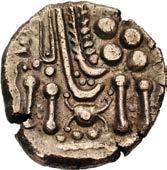





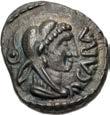


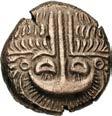
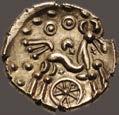
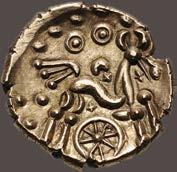


1213. CELTIC, Dobunni. Bodvoc. Circa 15-10 BC. AR Unit (14mm, 1.16 g, 10h). Boduoc Young Head type (Dobunnic C). Youthful male head left; [BO]DuOC downwards to left / Horse leaping right; pellet-in-annulet and crescents above, pelletin-annulet within pellet ring below, ornaments in fields. ABC 2042; Van Arsdell 1057-1; Hobbs 3143-5; SCBC 389. Some very light porosity. Toned. Near EF. Very rare. ($1000)




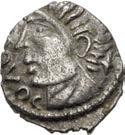


From the Trehearne Collection.
1214. CELTIC, North-Eastern series (‘Corieltauvi’). Uninscribed. Circa 60-20 BC. AV Stater (18mm, 6.16 g, 1h). North East Coast, right type (Corieltauvian A). Devolved head of Apollo right / Disjointed horse right; below, pelleted sun over zig-zag line; pellets around. ABC 1719; Van Arsdell 800-9; Hobbs 184-5; SCBC 28. Near EF. ($1000)




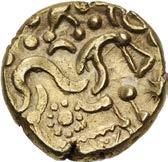
From the Pythagoras Collection, purchased from Wolfshead Gallery.
1215. CELTIC, North-Eastern series (‘Corieltauvi’). Uninscribed. Circa 60-20 BC. AV Stater (21mm, 6.20 g, 9h). North East Coast, left type (Corieltauvian A). Devolved head of Apollo right / Disjointed horse left; below, pelleted sun over zig-zag line; pellets around. ABC 1722; Van Arsdell 804-1; Hobbs 193-9; SCBC 29. Obverse slightly off center. Toned. Near EF. ($1000)
From the Pythagoras Collection, purchased from Wolfshead Gallery.
1216. CELTIC, North-Eastern series (‘Corieltauvi’). Uninscribed. Circa 60-20 BC. AV Stater (18mm, 6.09 g, 12h). North East Coast, left type (Corieltauvian A). Devolved head of Apollo right / Disjointed horse left; below, pelleted sun over zig-zag line; pellets around. ABC 1722; Van Arsdell 804-1; Hobbs 193-9; SCBC 29. Near EF. ($1000)
From the Trehearne Collection.
1214 1215
1217. CELTIC, North-Eastern series (‘Corieltauvi’). Uninscribed. Circa 50-20 BC. AV Stater (17mm, 5.51 g, 8h). South Ferriby type (Corieltauvian D). Devolved head of Apollo right / Disjointed horse left; six-pointed star below, ‘anchor’ face above. ABC 1743; Van Arsdell 811-1; Hobbs 3177; SCBC 390. Near EF. ($750)




From the Pythagoras Collection, purchased from Wolfshead Gallery.
1218. CELTIC, North-Eastern series (‘Corieltauvi’). Uninscribed. Circa 50-20 BC. AV Stater (17mm, 5.95 g, 7h). South Ferriby Legs type (Corieltauvian D). Devolved head of Apollo right / Disjointed horse left; eight-pointed star below, ‘anchor’ face above. ABC 1743; Van Arsdell 811-1; Hobbs 3154; SCBC 390. Some die rust. Near EF. ($750)
Purchased by the consignor from Baldwin’s.
1219. CELTIC, North-Eastern series (‘Corieltauvi’). Volisios Dumnocoveros. Circa AD 30-60. AV Stater (19mm, 5.10 g, 1h). Volisios Dumnocoveros type (Corieltauvian P). Vertical wreath; uOLi/ÍiOÍ in two lines across field; pelleted annulet and sprial in alternating quarters / Disjointed horse left; triple pellets to left; Du NOCO uerOÍ around. ABC 1980; Van Arsdell 978-1; Hobbs 3330-6; SCBC 416. Toned, scratch, worn obverse die. Good VF. ($1500)
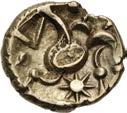





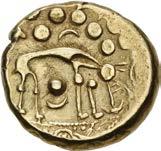


From the Pythagoras Collection, purchased from Wolfshead Gallery. Ex Leu 86 (5 May 2003), lot 30.
1220. CELTIC, Iceni. Uninscribed. Circa 60-50 BC. AV Stater (17mm, 6.18 g). Norfolk Wolf, right type (Icenian A). Devolved head of Apollo right / Disjointed wolf right; pellet over crescent above, crescent and pellets above, bird to upper left. MfT Norfolk Wolf A, die group 1, dies E1(?)/4; ABC 1393; Van Arsdell 610-1; Hobbs 212-6; SCBC 30. Toned. VF. ($1000)
From the Pythagoras Collection.
1221. CELTIC, Iceni. Uninscribed. Circa 60-50 BC. AV Stater (20mm, 5.57 g, 12h). Norfolk Wolf, left type (Icenian A). Devolved head of Apollo right / Disjointed wolf left; pellet over crescent above, crescent and pellets above, bird to upper right. MfT Norfolk Wolf B, sub type Ci, die group 11, dies M/29; ABC 1399; Van Arsdell 610-3; Hobbs 218-78; SCBC 31. Struck on an elongated flan showing near complete wolf. Good VF. Finer and with significantly more detail showing than the sole example for this reverse die in MfT. ($1000)
From the Trehearne Collection.
1222. CELTIC, Iceni. Uninscribed. Circa 50 BC - AD 10. AV Stater (18mm, 5.65 g). Snettisham type (Trinovantian F). Traces of crossed wreaths type / Horse prancing right; pellets-in-annulets above, beaded pellet-in-annulet below. MfT Snettisham, die group 1, dies A/1; ABC 1408; Van Arsdell –; Hobbs 3360-4; SCBC 425. Toned, faint scratch. Good VF. Extremely rare – only eight in IACB, with most of those in the British Museum. ($1500)
From the Pythagoras Collection, purchased from Wolfshead Galleries.
1223. CELTIC, Iceni. Uninscribed. Circa 50 BC - AD 10. AV Stater (18mm, 5.50 g). Snettisham, rings type (Trinovantian F). Traces of crossed wreaths type / Horse prancing right; pellets-in-annulets above and below. CCI 00.0987 (this coin); MfT Snettisham, die group 2, dies G/11; ABC 1411; Van Arsdell 1505-1; Hobbs 3365-83; SCBC 425. Good VF. ($750)
From the Pythagoras Collection. Ex Jon Kardatzke (Part III, Goldberg, 7 June 2000), lot 3022.
1224. CELTIC, Iceni. Uninscribed. Circa 20 BC-AD 10. AV Stater (20mm, 5.45 g).
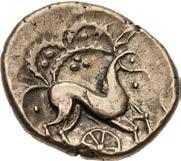




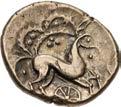

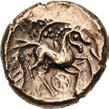

Cross, triad type (Icenian B). Pelleted cross / Horse prancing right; triple pellets and crown-like motif above, eight-spoked wheel below. MfT Plouviez, die group 2, dies D/8; ABC 1420; Van Arsdell 624-7; Hobbs 3392-5; SCBC 427. Toned. Good VF. Rare – only five in IACB, mostly in the British Museum. ($1500)



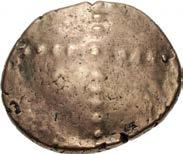
From the Pythagoras Collection. Ex Jon Kardatzke (Part III, Goldberg, 7 June 2000), lot 3019.
1225. CELTIC, Iceni. Uninscribed. Circa 20 BC-AD 10. AV Stater (17mm, 5.60 g). Freckenham Flower, crescent type (Icenian B). Three-petalled flower in central ring set on pelleted spokes / Horse prancing right; triple pellets and crown-like motif above, six-spoked wheel below. MfT Irstead, die group 3, dies G/7; ABC 1423; Van Arsdell 626-1; Hobbs 3396-3404; SCBC 428. Toned. Good VF. ($1500)
From the Pythagoras Collection, purchased from Wolfshead Gallery.
1226.
ANGLO-SAXON, Secondary Sceattas. Circa 710/5-720/5. AR Sceatt (12mm, 1.10 g, 10h). Series N, type 41b var. Mint in east Kent or lower Thames region(?). Two figures standing facing, each holding curved staves in outer hand; array of pellets between / Monster in flight right, head left; pellets in fields. Abramson 52-35 (same dies as illustration); MEC 8 Series N, 477; cf. SCBI 63 (BM), 609 (for similar series QIA sceat with beast left); SCBI 67 (Abramson) 571 (same dies); North 98; SCBC 806. Glossy find patina with hints of luster, minor areas of weak strike. EF. Rare Series N variety. ($1000)
1227. ANGLO-SAXON, Secondary Sceattas. Circa 720-735. AR Sceatt (12mm, 0.98 g, 12h). Series K, type 32a. Mint in Essex or Kent. Diademed and draped bust right, holding cross, knot behind head / Serpent-headed wolf, with forelimbs, coiled clockwise. Metcalf & Walker Group A-B, 10; Abramson 39-10; MEC 8 Series Kb, 369-376; cf. SCBI 63 (BM), 490 (for type); SCBI 67 (Abramson) 412; North 89; SCBC 803D. Toned, light porosity, some hard red deposits. Good VF ($750)



1228. ANGLO-SAXON, Secondary Sceattas. Circa 725-735. AR Sceatt (13mm, 1.15 g, 12h). Series O, type 40. Mint in the Thames region. Figure with curved shoulders standing facing, feet right, holding cross pommée in each hand / Fantastic creature in flight left, head reverted; pellets around. Abramson 55-15; MEC 8 Series Od, 491 (same obv. die; there considered an imitation); cf. SCBI 63 (BM), 600-5 (for type); SCBI 67 (Abramson) 601 (same obv. die); North 114; SCBC 807B. Lightly toned, small spot of roughness on reverse margin. Good VF. Unusually fine for type. Rare. ($1000)









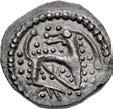


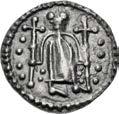
1229. ANGLO-SAXON, Secondary Sceattas. Circa 730/5-745. AR Sceatt (11mm, 0.93 g). Series S, type 47. Mint in Essex. Female centaur standing left, torso facing, holding palm frond in each hand / Four wolves’ heads in clockwise circle, tongues forming whorl. Abramson 68-50; MEC 8 Series Sa, 589-601; SCBI 63 (BM), 729-32; SCBI 67 (Abramson), 774; North 121; SCBC 81. Toned, some hard green deposits, small delamination on reverse. Near EF. ($750)


1230.
63 (BM), 619 (same obv. die); SCBI 67 (Abramson), 641; North –; SCBC 810.
Well struck. Rare. ($1500)

1231.
ANGLO-SAXON, Kings of Northumbria. Aldfrith. 685-705. AR Sceatt (12mm, 1.21 g, 5h). York mint. ม aዢčŊ l ዢčк˝ around central pellet-in-annulet / Quadruped with forked tail standing left. Booth, Sceattas 1-7 (unlisted); Chapman 1-8; Pirie, Guide 1.2; North 176; SCBC 846. Toned, die break on obverse. Good VF. ($1500)




1232. ANGLO-SAXON, Kings of Northumbria. Eadberht, with Archbishop Ecgberht. 737-758. AR Sceatt (13mm, 1.16 g, 2h). York mint. h around central cross pattée / Ҁh , mitred figure standing facing, head right, holding long cross and crozier. Booth, Sceattas, variety v, 17-24 var. (unlisted dies); Chapman 97-9; Pirie, Guide 2.2d; North 192; SCBC 852. Find patina. Good VF. An exceptionally well detailed specimen. Rare thus. ($1500)
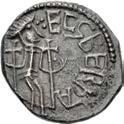

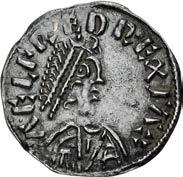

Found Driffield, E. Yorkshire.
1233. ANGLO-SAXON,

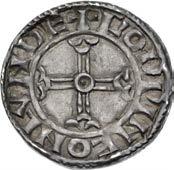


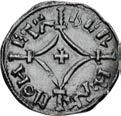

(19mm, 1.30 g, 12h). Cross-and-

¨ዞ⌦ዟያዞዝ ያዞᛸ Ӳ¨ᛸ
Ex Classical Numismatic Group 87 (18 May 2011), lot 2074. Our understanding of the cross and lozenge coinage of Alfred the Great and his contemporary Ceolwulf II of Mercia has been transformed by the discovery of the Wattlington Hoard in 2015. This extremely important hoard of some 200 coins, jewellery and hack silver was acquired by the Ashmolean Museum after a major fund raising campaign. The cross and lozenge coinage is now firmly recognized as a joint issue of the kings of Wessex and Mercia acting in unison under extraordinary circumstances as their territories were ravaged by marauding Viking armies. Though Mercia was unable to withstand the onslaught, Alfred held firm and turned the tide against the foreign invaders, laying the foundations for a new, united kingdom of England in the struggle.
Ex Spink 219 (24 September 2013), lot 170; R.J. Eaglen (Baldwin’s 18, 16 October 1998), lot 1477; F. Elmore Jones (Glendining, 12 May 1971), lot 533.
1235. NORMAN. William I ‘the Conqueror’. 1066-1087. AR Penny (19mm, 1.38 g, 12h). Two Stars type (BMC v). Winchester mint; Anderboda, moneyer. Struck circa 1074-1077. ม ዩዢ⌦⌦ዞዦ ʼዞҟ ዢnዢዢ , crowned facing bust; stars flanking / ม anዝʼዛɭዝ ɭn ዩnዢü , cross botonnée with central annulet over quadrilateral with incurved sides. Harvey 1944 (dies A/a) corr. (rev. legend); SCBI –; BMC 388-9 var. (legends); North 845; SCBC 1254. Richly toned, minor die break. Good VF. ($2000)
Ex Classical Numismatic Group 82 (16 September 2009), lot 1375.
1236. NORMAN. William I ‘the Conqueror’. 1066-1087. AR Penny (20mm, 1.40 g, 1h). Paxs type (BMC viii). Sandwich mint; Godwine, moneyer. Struck circa 1083-1086. ม ዩዢ⌦⌦ዞ⌦ዦ ʼዞม , crowned facing bust, holding scepter; annulet on right shoulder / ม Żɭዝዩዢnዞ ɭn ˫ዢዢn , cross pattée; letters of P A X S in annulets within quarters. P.W.P. CarlyonBritton, “A Numismatic History of the Reigns of William I and II,” in BNJ VIII (1910), pl. XXI, 4 (this coin illustrated); SCBI 17 (Midland), 590 (same dies); BMC 915 (same dies); North 850; SCBC 1257. Toned. EF. A superb portrait coin struck on a broad flan. Rare. ($2000)
Ex Dr. E. Miller (Spink (27 March 2019), lot 102; P. W. P. Carlyon-Britton (Part I, Sotheby, 20 November 1916), lot 1271 (part of).
1237. PLANTAGENET. Edward III. 1327-1377. AV Noble (34mm, 7.59 g, 12h). Third coinage, third period. Tower (London) mint. Struck 1346-1351.
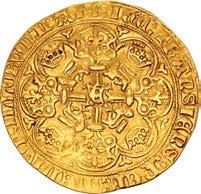

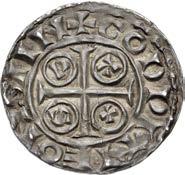

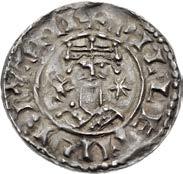
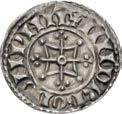


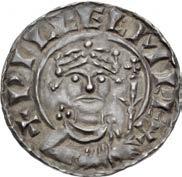

, half-length figure of Edward standing facing within ship, holding sword and shield; bowsprit passes through bow /

,
fleurdelisée and
in center of cross, Ě within rosette within angled quadrilobe; in each quarter, crown above lion passant left; all within tressure of arches; trefoils in spandrels. Potter, Gold IIa (unlisted dies); Schneider –; Lockett 1225; North 1180; SCBC 1481; St. James’s 14 (30 September 2010), lot 3 (same dies, weight 8.59 g). In NGC encapsulation 6468631-001, graded AU 53 (incorrectly labeled S-1490). Very rare. ($5000)
Ex Baldwin’s FPL (Winter 2013-2014), no. BH001; T. Law (Stack’s Bowers & Ponterio 176, 13 August 2013), lot 20001; Seaby Coin & Medal Bulletin 799 (April 1985), no. EG33.
1238. PLANTAGENET. Edward III. 1327-1377. AV Half Noble (27mm, 3.81 g, 12h). Fourth coinage, Pre-Treaty period, series C/A mule. Tower (London) mint; im: cross 3. Struck 1351-1352. Ě dѾ¥ʼd ი dĚƱ ი gʼ¥ ი ʼĚҢ ი ¥Ƀg⌦=ი Ԥ ი Ŗʼ¥Ƀæ ი d ი , Edward standing facing in ship with bowsprit, holding sword and shield; ornaments 1-1-1, ropes 3/3, quatrefoils 3/35, lis 4; annulet stops in legend / ๘ dɨ⍴ƱNĚ NĚ Ḻ ƱN Ḻ ŖѝʼɨʼĚ Ḻ Ϳѝɨ Ḻ ¨ʼŷѝ¨˫ Ḻ , voided short cross potent over cross fleurée et lisée; in each quarter, crown over lion passant; at center, Є within angled quadrilobe, each angle ending in trilobe; all within polylobe; trefoils in spandrels; lis above tail on lion in first quarter; double saltire stops in legend. Cf. Lawrence 4; Schneider 14 var. (rev. legend and placement of lis with additional lis in spandrel); North 1145; SCBC 1492. Attractively toned. In NGC encapsulation 2119526-002, graded AU 58. A very rare mule. ($2000)

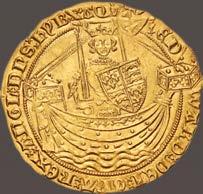


Ex Dr Baumhauer Collection; Clarendon (Part I, Bonhams, 28 March 2006), lot 336; G. V. Doubleday (Glendining, 7 June 1972), lot 29.
1239. PLANTAGENET. Edward III. 1327-1377. AV Noble (34mm, 7.81 g, 7h). Fourth coinage, Treaty period. Tower (London) mint. Struck 1361-1369. # ED Ѿ¨rD Ḻ DEi Ḻ ŷr¨ Ḻ rEҞ Ḻ ¨Nŷǹ Ḻ DNS Ḻ ƌӅÝ # ⎜ # ¨ʠ Ϳ= , half-length figure of Edward standing facing in ship, holding sword and shield; ornaments -11-11, ropes 3/2, quatrefoils 4/4, lis 4/4 / ຂ iƌý Ḻ ¨ѝͿEM


Ϳr¨NSiENS
ʖER
MEDiѝ
iǣǣɨrѝ
iÝ¥Ϳ , ornate cross with lis at ends and large E in center; crowned lions in quarters. Lawrence 1; Schneider 75; North 1231; SCBC 1502. In PCGS encapsulation 45214622, graded MS 64. A magnificent specimen, fully struck up and with significant luster. The finest Treaty period Noble we have seen and, in our opinion, conservatively graded by PCGS. Very rare in this choice condition. ($20,000)
Ex S. English Collection, purchased from Spink, January 1965.
1240. PLANTAGENET. Edward III. 1327-1377. AV Noble (35mm, 7.73 g, 2h). Fourth coinage, Treaty period. Calais mint. Struck 1361-1369. ED ѾaRD Ḻ DEi Ḻ ŷRa Ḻ REҞ Ḻ aNǹ Ḻ DNS Ḻ ƌҼÝ $ ⎜ $ aʠ Ϳ= , Edward standing facing in ship, holding sword and shield; ornaments -11-11, ropes 3/2, quatrefoils 4/4, lis 4; flag at stern / ๘ iƌ=ý Ḻ aѝͿEM Ḻ ͿRaNSiENS Ḻ ʖER Ḻ MEDiѝ Ḻ iǣǣɨRѝM Ḻ iÝ¥Ϳ , voided short cross potent over cross fleurée; in each angle, crown over lion passant over voided trefoil; at center, ý within quadrilobe; all within polylobe, with trefoils in spandrels. Lawrence 4; Schneider 97; North 1235; SCBC 1504. Creased. EF. Well struck on a broad flan. Rare. ($7500)
1241. YORK. Edward IV. First reign, 1461-1470. AV Half Ryal (27mm, 3.79 g, 2h). Light coinage. Tower (London) mint; im: –/crown (over sun). Struck 1467-1468. ED Ѿ¨RD $ Di= ŷR¨ REҞ $ ¨NŷȄ $ Ԥ $ fR¨Ný , Edward standing facing in ship with bowsprit, holding sword and shield; large rose on hull and banner with large E in stern / ՟ DɨMiNE $ NE $ iN fѝRɨRE $ Tѝɨ $ ¨Rŷѝ¨S ME , radiant sun, with rose in center, over cross with lis at ends; crowned lion passant in each quarter; all within polylobe with trefoil on cusps and in each spandrel. Cf. Blunt & Whitton type VII; cf. Schneider 383 (for type); North 1554; SCBC 1959. Minor mark on reverse. VF. Very rare and apparently unrecorded with this mintmark. ($2000)




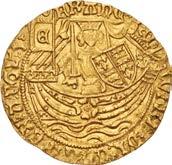

Ex Dr. Baumhauer Collection; Spink 164 (23 July 2003), lot 392. Blunt & Whitton record an example with the sun initial mark on the obverse and the crown on the reverse, as well as the sun over the crown on the reverse, for type VIII, but do not note any with crown over sun.




1242. TUDOR. Henry VIII. 1509-1547. AV Sovereign (42mm, 15.31 g, 2h). Second coinage. Tower mint; im: lis (over sunburst)/arrow. Struck circa 1541. ᛄ ჭ ƌENRiýѝs Ḻ Dei Ḻ ŷr¨ýi¨ Ḻ rEҞ ᛄ ¨NŷȄiE Ḻ ET Ḻ fr¨Ný⎡ DNs= Ḻ ƌƱÙ⎡ , Henry enthroned facing, holding scepter in left hand, globus cruciger in right; portcullis below / ሌ iƌEsѝs Ḻ ¨ѝTEዦ Ḻ Ϳr¨NSiENS Ḻ ʖEr Ḻ ዦEDiѝዦ Ḻ iǣǣɨrѝዦ Ḻ iݨͿ Ḻ , coat-of-arms within Tudor rose. Whitton 4 (dies O1d/R7); Schneider 570; North 1782; SCBC 2267. Some light scratches and marks on robe of King. Otherwise an imposing specimen. Richly toned. Good VF. Very rare. ($50,000)
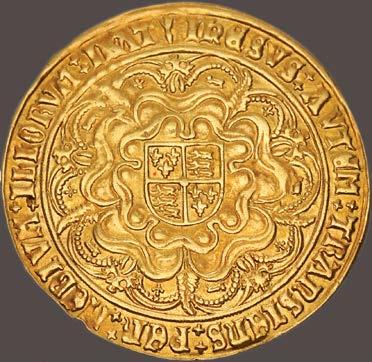
Ex S. English Collection, purchased from Spink, June 1963; Dr. E.C. Carter Collection (purchased en bloc by Baldwin’s, 1950).
Over a period of more than 60 years Dr. Ernest Christison Carter (1865-1950) formed a collection of gold and silver coins from the reign of Edward III through the British milled series that was regarded as “one the most complete of its kind.” An obituary in the June 1950 issue of Spink’s Numismatic Circular describes Carter as “a particularly fine judge of condition, and on this point he was very meticulous.” Later that year, in the Presidential Address to the British Numismatic Society, Christopher Blunt said of Carter that “quality was the keynote of his collection…everything in it was of the best.”


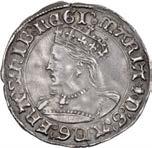
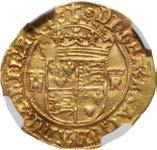

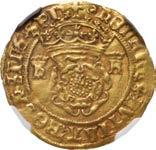
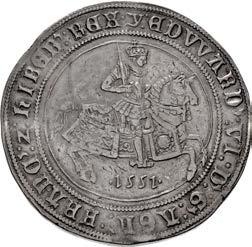
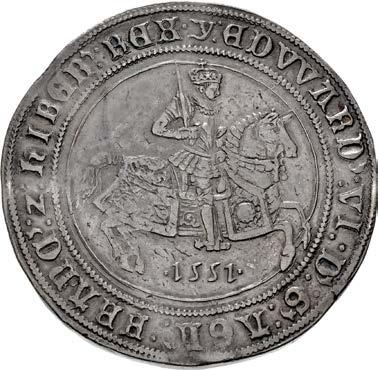

1246. TUDOR. Elizabeth I. 1558-1603. Pattern AR Shilling (31mm, 6.11 g, 11h). Sixth issue. Tower (London) mint; im: key. Dies by Charles Anthony. Struck 1595. (key) ELIZAB’· D’· G’· ANG’· FR’· ET HIB’· REGI, crowned bust left / (key) POSVI DEV’· AD IVOTRE M · MEV’·, crowned coat-of-arms over long cross fourchée. BCW KY-3C/KY-c1; B&C P4; North 2044. A few light marks, Toned. Good VF. A wonderful and very rare portrait piece. ($10,000)

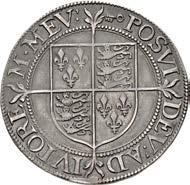






Ex C. Comber Collection; Dr. E. Burstall Collection (with his ticket, Eaglen C15); Dr. E.C. Carter Collection (purchased en bloc by Baldwin, 1950).
After the death of the mint’s chief engraver Derek Anthony, his son Charles assumed the position. Charles engraved a new set of portrait punches for the reintroduction of a crown gold coinage in 1593. Elizabeth was portrayed in profile in a richly decorated dress and with long, flowing hair. After this success, he prepared a redesign of the silver shilling. A small number of beautiful patterns were struck with the key mint mark. For unknown reasons, the ‘flowing hair’ design was not adopted, and the youthful portrait of the queen continued in use on the currency issues until the end of the reign.


1247. TUDOR. Elizabeth I. 1558-1603. AV Quarter Angel (17mm, 1.30 g, 4h). Fifth issue. Tower (London) mint; im: Latin cross (over Greek cross)/Latin Cross. Struck 1580-1581. † (over +) ELIZABETH : D G ANG : FRANCIE, Archangel Michael slaying dragon to lower right, spear topped by cross fleurée / † ET · HIBERNIE · REGINA · FIDEI ·, ship bearing shield and cross; E and rose flanking cross. Brown & Comber E7; Schneider 776; North 1993; SCBC 2528. A few light marks. Good VF. Rare over-mintmark on obverse. ($3000)
Ex C. Comber Collection; C. Herriot (Dix, Noonan, & Webb 62, 30 June 2004), lot 78.
1248.
1249 1250 1251 1252
1249. TUDOR. Elizabeth I. 1558-1603. AR 8 Testerns (40mm, 26.71 g, 10h). ‘Portcullis’ money. Tower (London) mint; im: O. Struck 1600. O : ELIZABETH · D’· G’· ANG’· FR’· ET · HIB’· REGINA, crowned coat-of-arms; crowned E R flanking / O : POSVI · DEVM · ADIVTOREM · MEVM ·, crowned portcullis. BCW 0-1B/0-a; North –; SCBC 2607A; Pridmore 1. Edge slightly smoothed in places. Broad flan. Toned. Good VF. Rare. ($15,000) From the Arthur M. Fitts III Collection. Ex F. R. Cooper (Glendining’s, 8 November 1978), lot 138.

In 1600, the recently organized East India Company found themselves in need of coin. They initially planned to import the commonly used Spanish dollars, but Elizabeth refused to grant such a license, and insisted that the company use coins bearing her name and image. In the end, a compromise was reached allowing the royal mint to strike new coins with the name of the queen, but with the royal symbol of the portcullis in lieu of a portrait of a woman, which would likely have not been acceptable in the Indies. (BCW p. 11)






Ultimately, £6000 worth of silver was struck in denominations of 1, 2, 4, and 8 testerns. But even without a feminine visage, the coins proved to be unsuccessful in trade, and quickly disappeared. Only a very small number of specimens for each denomination have survived to this day.
1250. TUDOR. Elizabeth I. 1558-1603. AR 4 Testerns (34mm, 13.70 g, 9h). ‘Portcullis’ money. Tower (London) mint; im: O. Struck 1600. O : ELIZABETH · D’· G’· ANG’· FR’· ET · HIBER’· REGINA, crowned coat-of-arms; crowned E R flanking / O : POSVI · DEVM · ADIVTOREM · MEVM ·, crowned portcullis. BCW 0-1E/0-a; North –; SCBC 2607B; Pridmore 2. Small flan split. Crisply struck and richly toned. EF. Rare, especially this fine.. ($10,000) From the Arthur M. Fitts III Collection. Ex Seaby Coin & Medal Bulletin 786 (February 1984), no. E80 ‘a superb piece’.
1251. TUDOR. Elizabeth I. 1558-1603. AR 2 Testerns (29mm, 6.74 g, 12h). ‘Portcullis’ money. Tower (London) mint; im: O. Struck 1600. O : ELIZABETH · D’· G’· AN’· FR’· ET HIBER’· REGINA ·, crowned coat-of-arms; crowned E R flanking / O : POSVI · DEVM · ADIVTOREM · MEVM ·, crowned portcullis. BCW 0-1B/0-a; North –; SCBC 2607C; Pridmore 3. Toned, lightly chased on obverse. VF. ($5000)
From the Arthur M. Fitts III Collection. Ex Classical Numismatic Group 60 (22 May 2002), lot 2389.
1252. TUDOR. Elizabeth I. 1558-1603. AR Testern (23mm, 3.51 g, 5h). ‘Portcullis’ money. Tower (London) mint; im: O. Struck 1600. O : ELIZABETH · D’· G’· AN’· FR’· ET · HI’· REGINA ·, crowned coat-of-arms; crowned E R flanking / O : POSVI · DEVM · ADIVTOREM · MEVM ·, crowned portcullis. BCW 0-1/0-a; North –; SCBC 2607D; Pridmore 4. Toned, small edge split. Near EF. Very rare. ($5000)
From the Arthur M. Fitts III Collection. Ex St. James 1 (13 October 2004), lot 299.


1253. TUDOR. Elizabeth I. 1558-1603. AV Ship Ryal (34mm, 7.49 g, 1h). Dutch imitation struck in Amsterdam(?), circa 1585-1587. EǭƩZ¨B=/ ĕ=/ Ŷ=/ ¨ɀŶ=/ ōr=/ E˸ / ƌƩ B rEŶƩɀ¨ $, half-length figure, wearing ruff, facing, holding scetpter in right hand and globus cruciger in left, on ship left with E on banner at prow / (escallop) / Ʃƌ˫=/ ¨⎍˸=/ ˸r¨ɀ˫ƩEɀ˫=/ ʖEr=/ ⍴EĕƩ⎍=/ Ʃǭǭɨr⎍⍴ / ƩB¨˸ / , radiant sun, with rose in center, over floreate cross with lis at ends; in each quarter, crown above lion passant left; all within tressure of eight arches with trefoils in spandrels. Thompson, Elizabethan – (dies O7/R– [unlisted rev. die]); Schneider 890 (same obv. die); Delmonte –; North 2004 note; SCBC 2530 note. In NGC encapsulation 6485724001, graded MS 61. Sharply struck with residual luster. A choice example of this very rare issue. ($50,000)



Ex Baldwin’s of St. James’s 14 (14 January 2018), lot 68; Roderick Richardson FPL Summer 2002, no. 9; Spink 81 (19 November 1990), lot 34 ‘Extremely fine and very rare.’
In late 1585 Elizabeth I, recognising the growing threat to the Protestant cause in Europe, sent an English force of 5000 foot and 1000 horse to the Low Countries in support of the United Provinces in their revolt against the rule of Philip II of Spain. The queen’s favourite and one time suitor Robert Dudley, Earl of Leicester was given command of the army. Studies by H. Allen and subsequently J. D. A. Thompson have shown that much of the large treasure taken by Leicester to fund the expedition was, in large part, was comprised of gold Sovereigns and Ryals. The Ryal, a denomination first issued for Elizabeth in 1584, may indeed have been specifically struck with the Dutch campaign in mind. Since it was introduced by Edward IV of England in 1464 the gold Ryal, or Rose Noble, of 120 grains had been a very popular denomination in the Low Countries. The Elizabethan Ryal elaborated on the design of its late medieval predecessor by depicting the queen wearing a ruff and ornately jewelled dress aboard an accurately rendered late sixteenth century frigate.
The introduction of the Elizabethan Ryals to the circulating medium of the Low Countries apparently resulted in a much smaller contemporaneous local issue of the type. Thompson ventured they may have been struck in Amsterdam. The Dutch Ryals are very close copies of the English prototype and bear the same mint marks - A and escallop - which were in use for the duration of the English army’s presence in the Low Countries. While these Dutch Ship Ryals may have been the product of a local mint seeking to profit from the confused state of the currency at this time, numismatists have also speculated that they could, in Thompson’s words, be ‘an official copy of the English coinage for Leicester’s government’. We know that Leicester was in constant need of coin, was involved in re-organising and re-tariffing the existing coinage of the United Provinces and even proposed a special coinage of Ryals to pay his army and bring profit to the English Crown.

1254. STUART. James I. 1603-1625. AV Sovereign (38mm, 11.13 g, 5h). First issue, crown gold coinage. Tower (London) mint; im: thistle. Struck 1603-1604. (thistle) IACOBVS · D’· G’· ANG’· SCOT’· FRAN’· ET · HIB’· REX ·, crowned and armored first bust right, holding lis-tipped scepter over right shoulder and globus cruciger in left hand / (thistle) · EXVRGAT · DEVS · DISSIPENTVR · INIMICI ·, crowned coat-of-arms; I R flanking. Schneider 2 var. (initial mark); North 2066; SCBC 2609. Toned, hairline scratch above orb. Near EF. Struck on a broad flan with excellent detail. ($30,000)



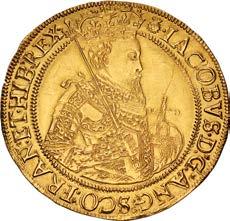

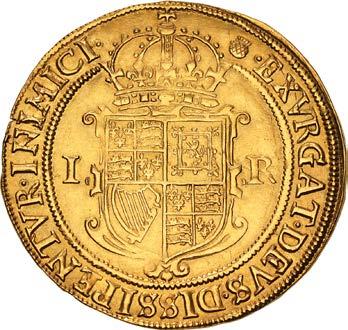
Ex Sharps Pixley (Spink 72, 9 November 1989), lot 26; J.A.M. Patrick Collection (purchased en bloc by Spink, 1954); H. Lingford (Glendining, 20 June 1951), lot 874.
In 1950, Albert Baldwin described Lingford’s assemblage of coins of this monarch as, “the best collection of James I of England in gold, silver and copper ever brought together in one cabinet.”
1255. STUART. James I. 1603-1625. AV Quarter Laurel (19mm, 2.22 g, 5h). Third issue, crown gold coinage. Tower (London) mint; im: thistle. Struck 1621-1623. (thistle) IACOBVS D : G : MAG:BRI : FRA : ET HIB : REX, laureate, armored, and draped bust left; V (mark of value) to right / HENRIC VS ROSAS REGNA (thistle) IACOBVS, crowned coat-of-arms set on long cross fourchée. Schneider 96 (same rev. die); North 2118; SCBC 2642. In NGC encapsulation 2124442-041, graded MS 63. ($1500)
Ex Dr. Baumhauer Collection.
1256. STUART. Charles I. 1625-1649. AV Angel (26mm, 3.95 g, 7h). Fine gold coinage. Tower (London) mint; im: Moor’s head and castle/castle (over Moor’s head). Struck 1627-1628. CAROLVS · D · G · MAG · BRI · FRA · ET · HIB · REX უ ჼ , Archangel Michael slaying the Dragon; X to right / AMOR · POPVLI · PRESIDIVM · REGIS ჼ (over უ ), three-masted ship sailing left; royal coat-of-arms on mainsail; hull ornamented with lis and lions passant. Schneider, Tower dies 0-2a/R-4a; Brooker 2 (same dies); Schneider 102 (same dies); North 2145; SCBC 2683A. Toned. In NGC encapsulation 2119532-038, graded AU Details, holed. Rare. ($3000)
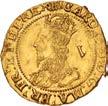

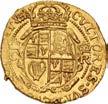
Ex Dr. Baumhauer Collection; Spink 67 (16 November 1988), lot 70; W.L. Raynes (Glendining, 15 February 1950), lot 220.
The association of disease with evil and the employment of the laying-on of hands to cure that disease/evil has been a part of human belief since at least the time of Jesus and the miracles associated with him. Among the numerous diseases that existed in medieval and modern Europe, one of the most heinous and virulent was the so-called morbium regis, or, as it was known in French, mal de roi – the King’s Evil. A form of scrofula, a tubercular infection of the lymph nodes that left untreated turned into suppurating sores. While various home remedies were known, the one perceived certain cure was the laying-on of hands by the king in his role as the anointed representative of Christ. Beginning in France under Robert II (996-1017) and in England under Edward the Confessor (1042-1066), this ritual became an important part of kingship and also a crucial test of royal legitimacy.
As a part of the ritual, the afflicted would receive a coin as alms. Because of its association with this ritual, the coin would be kept to act as a talisman for the sufferer. By the time of Edward IV, the coin used was a gold denomination, the angel, that was perfectly suited for the ceremony as it bore a depiction of the Archangel Michael slaying the Dragon on the obverse and the royal ship-of-state – an allusion to the monarch – on the reverse. Under Henry VII (1485-1509), the practice was ritualized into a Divine Service and the coins themselves were a central part of the ceremony, retaining their relative intrinsic purity. Having first been threaded with a ribbon for suspension, the coin would be passed over the affected areas by the monarch, who would sometimes make the sign of the cross with the coin as well. Even after England had become a Protestant country, Queen Elizabeth I (1558-1603) continued to do the latter.
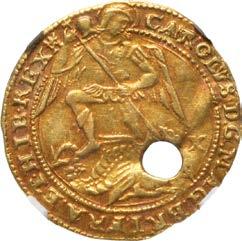


Under the Stuarts, the ceremony took on special significance since they viewed it as an important component of their increasingly absolutist view of the divine right of kingship. While James I (1603-1625), owing to his Protestant background and the lack of such a ritual in Scotland, initially balked at performing the ritual, he soon acquiesced, although he removed everything in the ritual that remotely smacked of papism and invoked God in the actual healing. Under James I and Charles I (1625-1649), the coin itself underwent significant design changes to the reverse, including under Charles the replacement of the traditional legend with a more ironic one – AMOR POPVLI PRAESIDIVM REGIS (The People’s Love is the King’s Safeguard). Like his father, Charles I performed the ceremony only on Easter and Michaelmas, as well as on Progresses. In 1633, a few days after his Scottish Coronation, Charles touched about 100 people. To commemorate this event, special angels designed and struck by Nicholas Briot were used. During his captivity following the end of the Civil War, Charles continued to perform touchings; the coins and ribbons were supplied by those wanting to be touched.
Under the Commonwealth, both the denomination and the ceremony ceased. When the ritual was reintroduced during the Restoration of Charles II (1660-1685) and his successors, a gold medalet, now specifically a touch-piece, was created to replace the angel. Designed solely for the touching ceremony and not meant to be used as currency, this medalet continued to employ the designs of the former angel (although now the ship was now modernized by depicting the Sovereign of the Seas accompanied by the legend SOLI DEO GLORIA (Alone to God the glory). The last reigning monarch to touch on British soil was Anne (1702-1714), who did so three months before her death. The Hanoverians refused to participate at all and the ritual died out in England, although in France it did so until the execution of Louis XVI (1774-1793), and was continued by the Stuart Pretenders until the death of Cardinal Henry Benedict Stuart, Henry IX to the Jacobites, in 1807.
1257. STUART. Charles I. 1625-1649. AV Crown (18mm, 2.27 g, 1h). Group D, class I. Tower (London) mint; im: portcullis. Struck 1633-1634. (portcullis) CAROLVS · D’· G’· MA’· BR’· FR’· ET · HI’· REX, crowned and mantled bust 4 left; V (mark of value) to right / CVLTORES · SVI · [DEVS · PROTEG]IT, crowned coat-of-arms. Brooker 207 (same dies); Schneider 244 (same dies); North 2185; SCBC 2715. Underlying luster, minor rim scuff and small scratch on reverse. Near EF. Sharp portrait. ($2000)
1258. STUART. Charles I. 1625-1649. AV Triple Unite (45mm, 26.70 g, 8h). Declaration type. Oxford mint; im: plumes. Dated 1642. (plume) CAROLVS : D : G : MAG : BRIT : FRAN : ET : HI : REX, crowned and armored half length bust left, holding sword with both hands; plume to right / · EXVRGAT : DEVS : DISSIPENTVR : INIMICI, (continuing into inner field) RELIG : PROT/ LEGI : ANG/ LIBER : PAR on continuous scroll; above, three plumes above · III ·; I642 below. Beresford-Jones dies III/L1; Brooker 834 (this coin); Schneider 286–9/297 (same obv./rev. dies); North 2382; SCBC 2724. In PCGS encapsulation 40526314, graded AU 53. ($50,000)

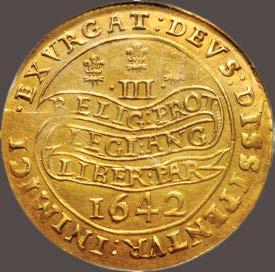

Ex Magnus (Spink 212, 28 March 2012), lot 946 (hammer £70,000), purchased from Spink, April 1980; J.G Brooker Collection; Glendining (6 November 1953), lot 22; C.A. Watters (Glendining, 21 May 1917), lot 377; J.G. Murdoch (Sotheby, Wilkinson, & Hodge, 8 June 1903), lot 2.

1259. STUART. Charles I. 1625-1649. AV Unite (34mm, 8.75 g, 11h). Declaration type. Oxford mint; im: plume (with bands). Dated 1643. (plume) CAROLVS : D : G · MAG : BR : FR : ET HIBER : REX, crowned and mantled bust left, holding sword in left hand and laurel branch in right; XX (mark of value) to right / EXVRGAT · DEVS · DISSIPENTVR · INIMICI : (continuing into inner field) RELIG : PROT/: LEG : ANG :/ LIBER : PAR; three plumes above, 1643 below. Beresford-Jones dies VIII/13; Brooker 849-52 (same obv. die); Schneider 318 (same dies); North 2389; SCBC 2734. Richly toned. In NGC encapsulation NGC encapsulation 6466656-001, graded AU 55. An attractive example. ($15,000)
Ex Dr. Baumhauer Collection (there graded AU58); P. Finn FPL 14 (1998), no. 28.
Finn noted that this coin was better than both the Beresford-Jones and Morrieson plate coins.
1260. STUART. Charles I. 1625-1649. AR Crown (44mm, 28.31 g, 9h).
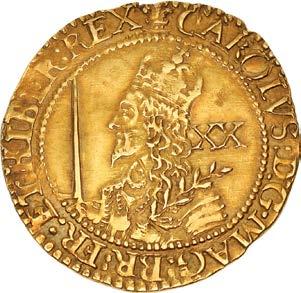






mint; im: castle. Dated 1645. ჼ
1261.
Ex ‘Silver Coins of Charles I from a Private Collection’ (Part II, Dix, Noonan, & Webb 79, 24 September 2008), lot 3738.
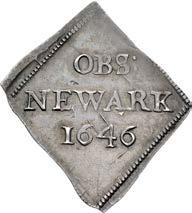
1262. STUART, Siege money. Newark. 1645-1646. AR Sixpence (22x23mm, 2.50 g, 12h). In the name of Charles I. Dated 1646. Large crown; C R flanking, VI (mark of value) below / OBS :/ NEWARK/ 1646. Brooker 1228 (same dies); North 2642; SCBC 3146. Toned, with considerable luster on obverse. Good VF/VF. Struck on a flan cut form engraved plate, with some armorial engraving still visible. Very rare. ($2500)
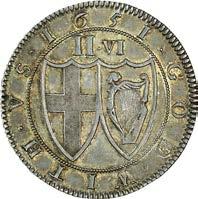

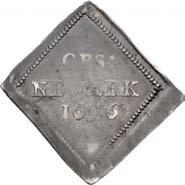
Ex Samuel Birchall of Leeds Collection (1761-1814).
1263. COMMONWEALTH. 1649-1660. Pattern Milled AR Halfcrown (33mm, 15.11 g, 6h). Dies by Simon. Blondeau’s mint, Drury House, London. Dated 1651 and year 3 of the Commonwealth. · · THE COMMONWEALTH · OF · ENGLAND ·, coat-of-arms within wreath of palm frond and olive branch / · GOD · WITH · VS · 1651, two coats-of-arms; II · VI above. Edge: IN · THE · THIRD · YEAR · OF · FREEDOME · BY · GODS · BLESSING · RESTORED · 1651. Bull 62; ESC 443; North 2731. Richly toned with considerable underlying golden-orange brilliance. In NGC encapsulation 2822098-001, graded MS 63 ‘Top Pop’. ($15,000)

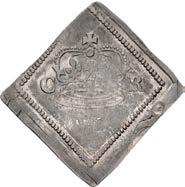

Ex Tisbury (Part I, Spink 248, 25 September 2017), lot 810, purchased from Baldwin’s, June 1986.
Commissioned by the Commonwealth to improve upon English coinage, Pierre Blondeau arrived from France in 1649 and, with the help of engraver Thomas Simon, immediately began to produce patterns that would focus upon his primary concern: the marking of the edges of coins with either lettering or reeding –an important deterrent to the practice of clipping. This series of patterns was struck for 1651, and presents the first encounter of a lettered edge within English coinage. Opposition to Blondeau increased at the mint, however, and he returned to France in 1656. The Frenchman would ultimately be called back to England in 1662 to oversee the modernization of English coinage and the full implementation of edge marking in 1663.

1264. COMMONWEALTH. 1649-1660. AR Shilling (30mm, 5.92 g, 2h). Tower (London) mint; im: sun. Dated 1651. Coat-of-arms of England within wreath of palm and laurel / Coat-of-arms of the Commonwealth; · XII [·] (mark of value) above. ESC 984; North 2724; SCBC 3217. In NGC encapsulation 6062177-003, graded MS 61. ($2000)


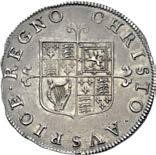
1265. STUART. Charles II. 1660-1685. AR Sixpence (28mm, 3.06 g, 2h). Hammered coinage, first issue. Tower (London) mint; im: crown. Struck 1660-1662. ՟ CAROLVS II D G MAG BRIT FRAN ET HIB REX, crowned and mantled bust left / · CHRISTO · AVSPICE · REGNO, coat-of-arms over short cross fourchée. ESC 1507; North 2765; SCBC 3309. A few light marks under rich old cabinet toning. Some luster. Near EF. ($2000)



Ex Baldwin’s FPL (February 2016), no. 92; Baldwin’s 96 (24 September 2015), lot 3395; Classical Numismatic Review XXV (Summer/Fall 2000), no. 119; Davissons 13 (2 May 2000), lot 227.
1266. STUART. Charles II. 1660-1685. AV Two Guineas. Royal Africa Company issue. Dated 1664. Elephant below bust. MCE 32; SCBC 3334. A most pleasing specimen. Toned with traces of luster. In NGC encapsulation 6466648-001, graded AU 53. ($10,000)
In 1660, the Royal Africa Company was given a monopoly of English trade in West Africa with the particular aim of exploiting the gold fields of the upper Gambia River. Coins were struck at the Royal Mint with gold from these endeavors, bearing the Company’s badge of an elephant and castle (sometimes an elephant only) under the effigy of the monarch. Initially these issues were so plentiful that the new milled gold issues were given the popular name the Guinea. After 1689, the Company lost its monopoly and in the 18th century elephant and castle coins were issued more infrequently. The Royal Africa Company was dissolved in 1752.
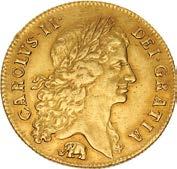



1267. STUART. Charles II. 1660-1685. AV Half Guinea. Dated 1676/4. 2nd bust. MCE 100 (overdate not noted); SCBC 3348. Toned with underlying luster. In NGC encapsulation 2119539-045, graded AU 58. ($4000)


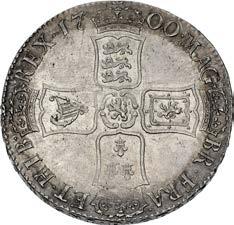




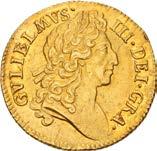
Ex Dr. Baumhauer Collection.
1268. STUART (ORANGE). William III. 1694-1702. AV Guinea. Dated 1698. 2nd bust. MCE 179; SCBC 3460. Light orange toning and considerable underlying luster. EF. Well struck. ($5000)



1269. STUART (ORANGE). William III. 1694-1702. AR Crown (41mm, 6h). Dated 1700 and DUVODECIMO. 3rd bust variety. Bull 1010; ESC 97; SCBC 3474. Toned. In NGC encapsulation 6487634-003, graded MS 63. ($2500)
1270. HANOVER. George II. 1727-1760. AR Crown. Dated 1736 and NONO. Roses and plumes in angles. ESC 121; SCBC 3686. Colorful cabinet tone. In NGC encapsulation 6455612-001, graded MS61. Conservatively graded in our opinion. ($4000)
Ex Taisei/Spink (26 November 2017), lot 139; Heritage 3035 (3 September 2014), lot 30795 (where graded PCGS MS 62).
1271. HANOVER. George II. 1727-1760. AR Halfcrown. Dated 1750 and VICESIMO QUARTO. Bull 1692; ESC 609; SCBC 3696. Richly toned with underlying luster. In NGC encapsulation 2118473-019, graded MS 62. ($1500) Ex Mildenhall Collection.
1272.
HANOVER. George III. 1760-1820. AR Dollar. Struck 1797. Oval countermark on a Spanish, Seville 8 Reales dated 1795 S CN. Bull 1851; ESC 135; SCBC 3765A. Richly toned, minor marks. VF. Rare. ($1000)
Due to a lack of regal silver in England during the Napoleonic Wars Spanish 8 Reales or ‘pieces of eight’ readily passed for currency. In 1797 the government legalised their position ‘by having them countermarked with the head of George III in a small oval. The puncheon used was that employed by the Assay Master of Goldsmith’s Hall for stamping the duty mark on silver plate assayed after 1785. The dollars were then made current at 4/9d and gave rise to the saying ‘two Kings’ heads not worth a crown’. These oval-countermarked dollars circulated at 4/9d from 9 March to 21 October 1797.’ (Alan Rayner, English Silver Coinage p. XXV.)

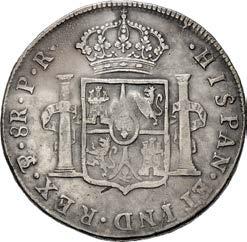








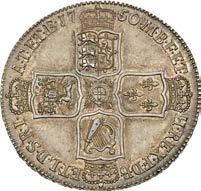
1273. HANOVER. George III. 1760-1820. AR Dollar. Struck 1797. Oval countermark on a Chilean, Santiago Portraittype 8 Reales dated 1794 So DA. Bull 1853; ESC 134; SCBC 3765A. Some die wear. VF. Very rare. ($1500)
1272 1273 1274 1275
1274. HANOVER. George III. 1760-1820. AR Dollar. Struck 1797. Oval countermark on a Guatemalan, Nuevo Granda Portrait-type 8 Reales dated 1790 NG M. Bull 1854; ESC 132; SCBC 3765A. Richly toned, minor marks. VF. The rarest Spanish American Portrait-type found with the oval countermark. ($2000)
1275. HANOVER. George III. 1760-1820. AR Dollar. Struck 1797. Oval countermark on a Bolivian, Potosi Portrait-type 8 Reales dated 1790 PTS PR. Bull 1855; ESC 131; SCBC 3765A. Uneven toning. Near VF. Rare. ($500)
1276. HANOVER. George III. 1760-1820. AR Dollar. Struck 1797. Oval countermark on a Peruvian, Lima Portrait-type 8 Reales dated 1792 (LIMÆ) IJ. Bull –; ESC 133; SCBC 3765A. Most attractively toned. Good VF. ($1000)



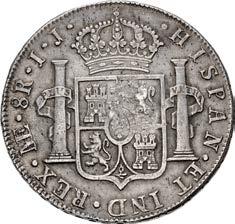
1277. HANOVER. George III. 1760-1820. AR Dollar. Struck 1797. Oval
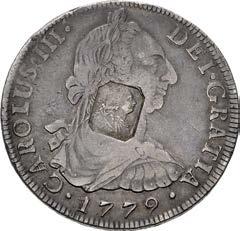

on a Mexican, Mexico City Pillartype 8 Reales dated 1771 Mo FM. Bull 1856 (R5); ESC 131; SCBC 3765. Once lightly cleaned, otherwise a very high grade example of this desirable countermarked type. Near EF. Very rare. ($4000)
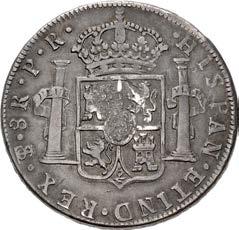

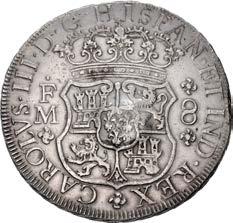
1278 1279
1278.
1279. HANOVER. George III. 1760-1820. AR Dollar. Struck 1804. Octagonal countermark on a Mexican, Mexico City Portrait-type 8 Reales dated 1793 Mo FM. Bull 1868; ESC 138; SCBC 3766. Toned. VF. ($750)

Ex Dix Noonan Webb 113 (17 March 2010), lot 113; Glendining (10 May 1989), lot 94.
1280. HANOVER. George III. 1760-1820. AR Dollar. Struck 1804. Octagonal countermark on a Peruvian, Lima Portraittype 8 Reales dated 1798 (LIMÆ) IJ . Bull 1872; ESC 140A; SCBC 3766. Lightly toned with some luster, small rim scuff. Near EF. Rare, especially in this high grade. ($1500)


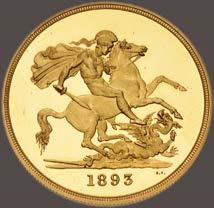

1281. HANOVER. William IV. 1830-1837. Proof Pattern AR Crown. Dated 1831. WW in incuse on truncation of bust. Linecar & Stone 1; ESC 271; Bull 2462; SCBC 3833. Most attractively toned with underlying luster. In NGC encapsulation 6489286-001, graded PF 64 Cameo. Very rare – only 120 struck for inclusion in proof sets of that year. ($25,000)

1282. HANOVER. Victoria. 1837-1901. Proof AV Five Pounds. Dated 1893. Old Head type / St. George and the dragon reverse. W&R 287; SCBC 3872. In NGC encapsulation 6477961-002, graded PF 66 Ultra Cameo. Rich original yellow tone with extraordinary contrast between the frosted devices and brilliant cameo fields. Very rare in this magnificent state of preservation. ($60,000) A truly exceptional example of this highly desirable proof Five Pound Victorian issue. Only one specimen graded higher by NGC.
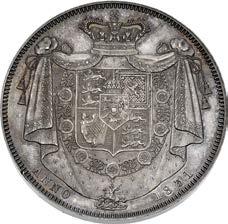

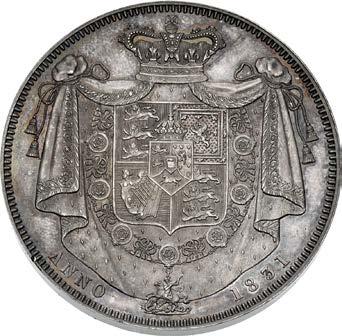
1283. HANOVER. Victoria. 1837-1901. Proof AV Two Pounds. Dated 1893. Old Head type / St. George and the dragon reverse. W&R 294; SCBC 3873. In NGC encapsulation 6478143-001, graded PF 65 Cameo. ($6000)
1284. HANOVER. Victoria. 1837-1901. Proof AV Sovereign. Dated 1893. Old Head type / St. George and the dragon reverse. W&R 341; Bentley 336; Marsh 145A; SCBC 3874. In NGC encapsulation 6478143-002, graded PF 66 Ultra Cameo. ($6000)
1285. HANOVER. Victoria. 1837-1901. Proof AV Half Sovereign. Dated 1893. Old Head type / St. George and the dragon reverse. W&R 363; Marsh 488A; SCBC 3878. In NGC encapsulation 6478143-003, graded PF 64 Ultra Cameo. ($2000)


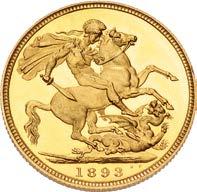
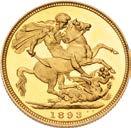
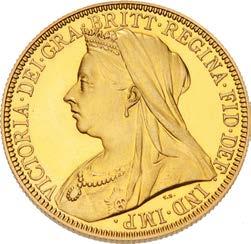

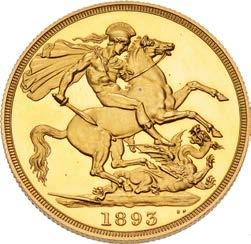


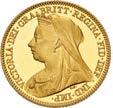


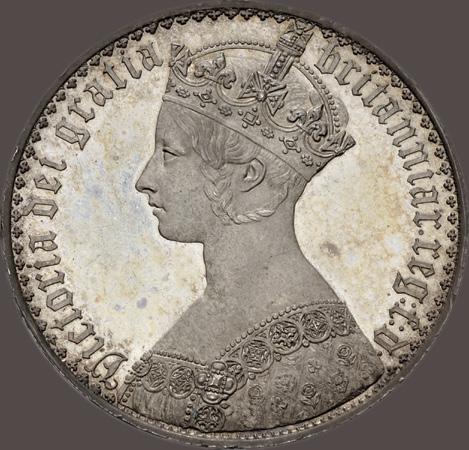
1286. HANOVER. Victoria. 1837-1901. Proof AR Crown (39mm, 28.36 g, 6h). Dated 1847 and UNDECIMO. ‘Gothic’ type, struck in Britannia .9584 silver. cf. L&S 57; cf. Bull 2573; cf. ESC 289; SCBC 3883. In NGC encapsulation 6490323002, graded PF 64. A superb coin with heavily frosted design. Light dappled tone with considerable underlying brilliance. Of the highest rarity: apparently the only known Gothic Crown struck in this alloy. ($25,000)
XRF analysis by NGC of this beautiful Crown has revealed that it is struck in Britannia silver: 96% (.9584) silver and 4% copper. The Britannia silver standard was introduced by Act of Parliament in 1697 during the Great Recoinage of William III. Henceforth all wrought silver plate was to be issued at the Britannia standard whereas silver coins continued to be struck in the traditional Sterling standard of .925 silver. The aim was to reduce the depletion of the circulating silver currency which previously was being melted down and easily converted into plate. Britannia silver was considerably softer than Sterling and provoked complaints from silversmiths leading to the reauthorisation of Sterling silver for the production of plate in 1720.
Prior to the analysis of the coin offered here, no Gothic Crown has been recorded in Britannia silver. The type is commonly encountered in Sterling silver with much rarer presentation strikings in fine, .999, silver also known (see lot 1287). An exceptional striking in an unusual alloy, such as the coin offered here, was likely a special commission for the Chief Engraver, William Wyon. The production of special strikings for VIP collectors was a well-established perquisite of the Chief Engraver in the nineteenth century, allowing him to augment his Royal Mint salary.

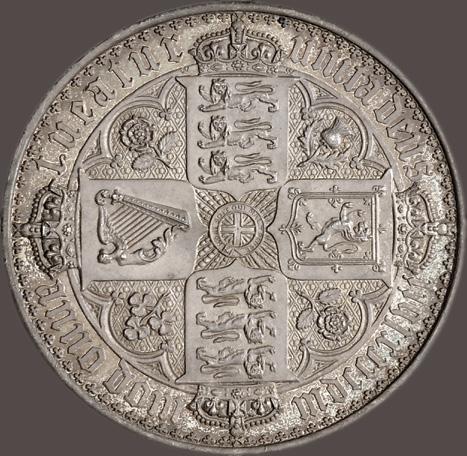
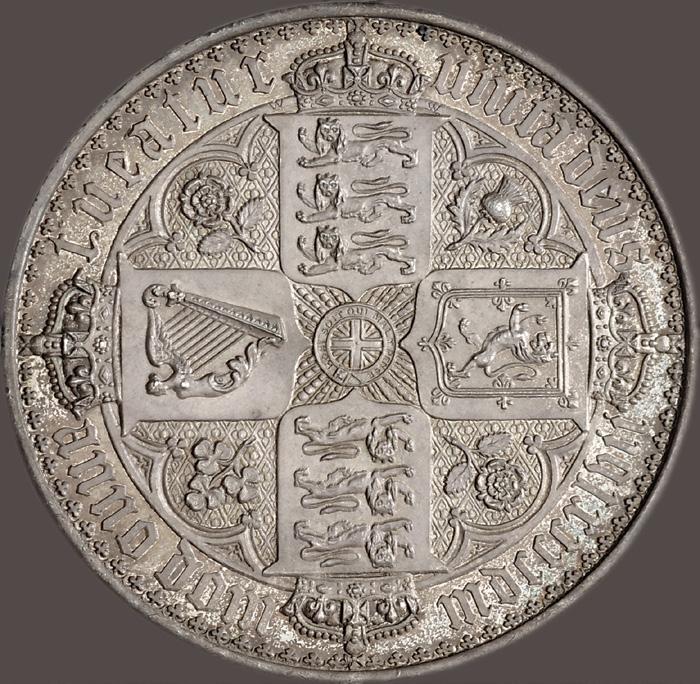



1287. HANOVER. Victoria. 1837-1901. Proof AR Crown (39mm, 28.00 g, 12h). Dated 1847. ‘Gothic’ type, struck in fine .999 silver. n in “unita” over inverted n. Plain edge. L&S 58 var. (no over-letter); Bull 2578; ESC 291B; SCBC 3883. Pleasing light mauve toning on obverse with hints of blue green on reverse. Perfectly struck with frosted details and an arresting cameo effect. In NGC encapsulation 6490323-001, graded PF 63 Cameo. Very rare fine silver presentation issue. ($25,000)
1288.
1289.
6489299-010, graded PF 63. ($4000)

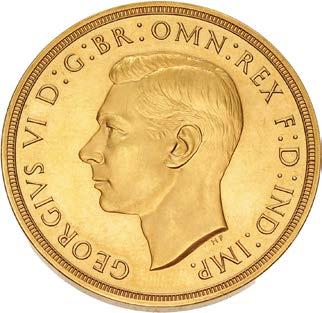


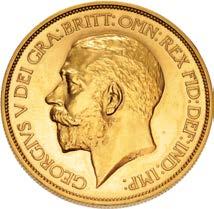
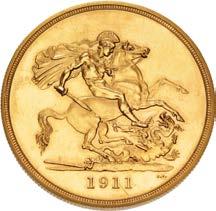
1290. SCOTLAND. James II. 1437-1460. AV Lion (25mm, 3.42 g, 2h). Second coinage, second issue, type II. Edinburgh mint; im: crown. Struck 1451-1460. ՟ Ʃ⌃æɨÙѝS ĕĚƩ Żˊ⌃


Sæɨ˶˶ɨˊѝ⍴ , crowned coat-of-arms; lis flanking /
P , St. Andrew crucified on short cross saltire; crowned lis flanking. Burns 3 (fig. 525); SCBI 35 (Ashmolean & Hunterian) 688 (same dies); SCBC 5222. In NGC encapsulation 6491200-002, graded AU 58 (misattributed as SCBC 5221). A well struck coin with pleasing orange tone. Rare. ($10,000)
1291. SCOTLAND. Mary 1542-1567. AV Three Pounds – Ryal (26.5mm, 7.51 g, 8h). First period. Portrait type. Edinburgh mint. Dated 1555. · MARIA · DEI · G · SCOTOR · REGINA $, bust left / · IVSTVS · FIDE VIVIT · 1555 ·, crowned coat-of-arms with rounded shield. Murray, 1555-8 13 (obv. die E); Burns 1-7 var. (legend stops); SCBI 35 (Ashmolean & Hunterian) 993 (same dies); SCBC 5397. Lightly polished, a few scratches, edge made round. VF. A very rare gold portrait coin of this renowned historical figure. ($15,000)
Ex Dr. Lawrence A. Adams (Classical Numismatic Group 100, 7 October 2015), lot 1091; Rev. Arnold Mallinson Collection (Spink 39, 6 December 1984), lot 126.
The Three Pound piece or Ryal of Mary represents the only sole portrait type of this ill-fated queen in gold. At the time these handsome coins were produced Mary was in France at the court of Henry II, betrothed to the Dauphin Francis. Their issue would therefore have served as a rare opportunity for Scots to see a likeness of their teenage queen. The die cutter was probably working from a drawing by Francis Clouet. We believe there to be less than forty gold coins with a portrait of Mary in private hands.
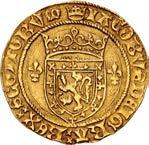



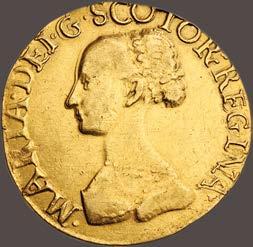
1292. SCOTLAND. James VI. 1567-1625. AV Sword & Scepter Piece (29mm, 4.93 g, 8h). Eighth coinage. Edinburgh mint. Dated 1601. ม · IACOBVS · 6 · D · G · R · SCOTORVM ·, crowned coat-of-arms / ม · SALVS · POPVLI · SVPREMA · LEX ·, sword and scepter crossed in saltire; crown above, thistle to left and right; · 1601 · below. Burns 1 (fig. 956); SCBI 58 (Edinburgh), 1304-6; SCBC 5460. Toned, slightly creased. Good VF. ($2000)

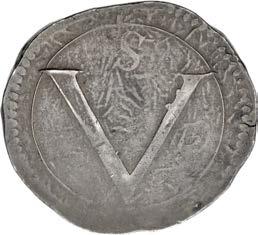


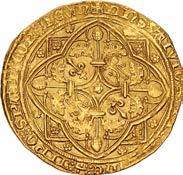
1293. SCOTLAND. James VI. 1567-1625. AV Sword & Scepter Piece (30mm, 4.99 g, 12h). Eighth coinage. Edinburgh mint. Dated 1602. ม · IACOBVS · 6 · D · G · R · SCOTORVM ·, crowned coat-of-arms / ม · SALVS · POPVLI · SVPREMA · LEX ·, sword and scepter crossed in saltire; crown above, thistle to left and right; · 1602 · below. Burns 3; SCBI 58 (Edinburgh), 1309/1311 (same obv./rev. dies); SCBC 5460. Faint hairlines. Good VF. ($2000)


1294. IRELAND, The Great Rebellion. Issues of the Lords Justices. 1642-1649. AR Crown (42mm, 29.74 g, 4h). ‘Ormonde Money’ issue. Issued 1643-1644. Large C R; crown above; all within linear and beaded border / Large V; S above; all within linear and beaded border. D&F 288; SCBC 6544. Toned, die break on obverse. VF. ($2000)

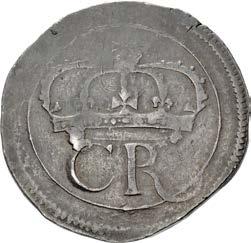
Ex P. Finn FPL 14 (1998), no. 510.
1295.
5.39
SEP : 14/·1646 · in two lines in exergue. Platt II Type C and pp. 88-92; MI 327/167 (this medal cited); Eimer –. Attractive red toning, trace of original suspension loop. Good VF. Extremely rare. ($10,000)

Ex North Yorkshire Moors [M. Lessen] (Part IV, Dix Noonan Webb 186, 21 January 2021) lot 1165; An Important Collection of Stuart Badges and British Commemorative Medals, the Property of a Gentleman (Spink 120, 9 July 1997), lot 343; A Fine Collection of British Historical and Commemorative Medals (Sotheby’s, 9 March 1989), lot 39; Greta Heckett (Sotheby’s, 25 May 1977), lot 213; J.G. Murdoch (Part IV, Sotheby, Wilkinson & Hodge, 2 June 1904), lot 64; T.M. Whitehead (Part IV, Sotheby, Wilkinson & Hodge, 5 May 1898), lot 42.
1297. STUART. temp. Anne. 1702-1714. AR Medal (42mm, 37.47 g, 12h). Success of the Allies in Spain and Brabant.


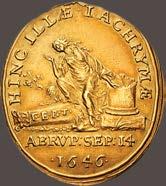


By Smeltzing. Dated 1706 (in Roman numerals). SIC OBSCURATUR GLORIA MAGNI REGIS, sun emerging from behind clouds over glove inscribed EUROPÆ; MDCCVI in exergue / DOMINUMQUE IN REGNA TULERE, medallion depicting head of Charles III of Spain right, with inscription CAROL III HISP REX, at center of three wreathed and turreted medallions depicting the bombardment of Barcelona, with inscription BARCINO LIBER XII MAY, the battle of Ramillies, with inscription PRŒL RAMIL XIIII MAY, and the entry into Madrid, with inscription INTRA MADRI XXVI IVNY; all set on crossed flags. Van Loon (new ed.) 1706.12; MI 291/101; Eimer –. Richly toned with underlying luster, a few light marks, die breaks on obverse. EF. Very rare. ($2000)
Ex B. Pearl Collection; Spink Numismatic Circular LXXIII.11 (November 1965), no. 6560.

1298. temp. HANOVER. Anthony Fothergill, physician. Circa 1732-1813. AV Medal (46mm, 94.32 g, 12h). Medical Society of London – Prize Medal. By J. Vining & W. Wilson. Dated 1773 (in Roman numerals, though struck from circa 1825). ANTONIUS FOTHERGILL · MD. L.L. D. & c, bust right; floral ornament below / SALUTI AUGUSTÆ, Salus standing left, holding long scepter in right and patera in left; to left, serpent entwined around a lit altar; in exergue, SOC · MED · LOND/ INSTITUTA/ MDCCLXXIII. Brettauer 362; BHM 185; Eimer 752. Patches of iridescent toning, scattered marks, light scratches, and hairlines. EF. Rare. ($5000)
1299. WINDSOR. George VI, with Elizabeth. 1936-1952. AV Medal (56mm, 121.0 g, 12h). Coronation. By P. Metcalf. Dated 12 May 1936. GEORGE VI CROWNED 12 MAY 1937, crowned bust of George VI left / QVEEN ELIZABETH 12 MAY 1937, crowned bust of Elizabeth left. BHM 4314; Eimer 2046. Lustrous, edge ding, hairlines, scratches. EF. ($7500)



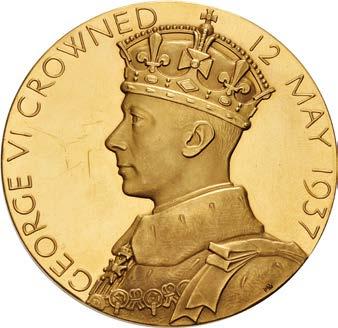
1300. GREEK. Northern Greece. Lot of ten (10) Thraco-Macedonian AR fractions. Includes: ISLANDS off THRACE, Thasos. AR Trihemiobol. Traité 11 // ISLANDS off THRACE, Thasos. AR Sixteenth Stater. SNG Copenhagen 1020 // ISLANDS off THRACE, Thasos. Twenty-fourth Stater. Traite 23 // ISLANDS off THRACE, Thasos. AR Hemiobol. Traite 13 // THRACO-MACEDONIAN TRIBES. Uncertain Tribe. AR Hemiobol. ANG ANS 1007 // MACEDON, Argilos. AR Hemiobol. Cf. Liampi 55 // MACEDON, Chalkidian League. AR Trihemiobol. Psoma, Monnaies, p. 103 // MACEDON, Mende. AR Tritartemorion. SNG ANS 320 // MACEDON, Mende. AR Tritartemorion. Cf. SNG ANS 354 // MACEDON, Tragilos. AR Hemiobol. BMC 4. Fine to good VF. LOT SOLD AS IS, NO RETURNS. Ten (10) coins in lot. ($1000)
1301. GREEK. Northern Greece. Lot of ten (10) Thraco-Macedonian and other AR fractions. Includes: ISLANDS off THRACE, Thasos. AR Sixteenth Stater. SNG Copenhagen 1020 // ISLANDS off THRACE, Thasos. AR Trihemiobol. SNG Copenhagen 1033 // MACEDON, Akanthos. AR Obol. SNG ANS 21 // MACEDON, Akanthos. AR Hemiobol. Weber 1886 // MACEDON, Argilos. AR Obol. Cf. Liampi 55 // MACEDON, Mende. AR Tritartemorion. Unpublished. (2) // ATTICA, Athens. AR Obol. Kroll 13 // BOEOTIA, Thebes. AR Hemiobol. BMC 73 // BOEOTIA, Thebes. 3/8 Obol. Cf. BMC 63. Fine to good VF. LOT SOLD AS IS, NO RETURNS. Ten (10) coins in lot. ($1000)
1302. GREEK. Northern Greece. Lot of ten (10) Thraco-Macedonian AR fractions. Includes: ISLANDS off THRACE, Thasos. AR Sixteenth Stater. BMC 18ff // ISLANDS off THRACE, Thasos. AR Hemiobol. BMC 23 // ISLANDS off THRACE, Thasos. AR Trihemiobol. BMC 60 // ISLANDS off THRACE, Thasos. AR Hemiobol. BMC 63 // MACEDON, Akanthos. AR Obol. SNG ANS 27 // MACEDON, Akanthos. AR Hemiobol. Traité 18 // MACEDON, Argilos. AR Hemiobol. Liami 85 // MACEDON, Mende. AR Tritartemorion. SNG ANS 361ff // MACEDON, Skione. AR Hemiobol. SNG ANS 710 // MACEDON, Skione. AR Hemiobol. SNG ANS 714. Fine to good VF. LOT SOLD AS IS, NO RETURNS. Ten (10) coins in lot. ($1000)
1303. GREEK. Egypt & North Africa. Lot of seventy-five (75) Kyrene Didrachms. All coins: Head of Zeus Karneios / Silphion plant. Near Fine to Near VF. LOT SOLD AS IS, NO RETURNS. Seventy-five (75) coins in lot. ($2500)
1304. GREEK. Miscellaneous. Lot of one hundred fourteen (114) coins from the Righetti Collection. Includes: various emperors and cities, from Celtic to eastern cultures, bronze and silver issues included. An excellent and inexpensive dealer lot. Should be examined closely. Most with collector’s tickets. Near Fine to VF. LOT SOLD AS IS, NO RETURNS. One hundred fourteen (114) coins in lot. ($2000)
From the Jean-Pierre Righetti Collection, the majority with his tickets.
1305. ORIENTAL GREEK. Miscellaneous. Lot of ninety-five (95) coins from the Righetti Collection. Includes: a variety of Bactrian, Elymaian, Hunnic, and other eastern cultures. A fun research project. Most with collector’s tickets. Fair to VF. LOT SOLD AS IS, NO RETURNS. Ninety-five (95) coins in lot. ($1000)
From the Jean-Pierre Righetti Collection, the majority with his tickets.
1306. ROMAN. Provincial. Lot of one hundred (100) bronze coins from the Righetti Collection. Includes: various emperors and cities. An excellent and inexpensive dealer’s lot, should be closely examined, several rarities in lot. All with collector’s tickets. Fine to near VF. LOT SOLD AS IS, NO RETURNS. One hundred (100) coins in lot. ($2000)
From the Jean-Pierre Righetti Collection, with his tickets.
1307. ROMAN. Provincial. Lot of ninety-one (91) bronze coins. Includes: various cities, rulers, and denominations. Average Fine to VF. LOT SOLD AS IS, NO RETURNS. Ninety-one (91) coins in lot. ($2000)
From the Conti Collection.
1308. ROMAN. Provincial-Imperial. Lot of thirty-two (32) bronze coins. Includes: Roman Imperial (30), from Divus Augustus to Diocletian, primarily sestertii but a few smaller denominations included // Roman Provincial (2), Elagabalus, Marcianopolis; Philip II, Antioch. Fine to VF. LOT SOLD AS IS, NO RETURNS. Thirty-two (32) coins in lot. ($1500)
1309. ROMAN. Imperial. Lot of sixty (60) silver and bronze coins. Includes: various rulers, denominations, and types. Fair to VF or better. LOT SOLD AS IS, NO RETURNS. Sixty (60) coins in lot. ($2000)
From the Conti Collection.
1310. ROMAN. Imperial. Lot of sixty (60) silver and bronze coins. Includes: various rulers, denominations, and types. Fine to EF. LOT SOLD AS IS, NO RETURNS. Sixty (60) coins in lot. ($2000)
From the Conti Collection.
1311. ROMAN. Imperial. Lot of ninety (90) silver and bronze coins. Includes: various rulers, denominations, and types. Fair to EF. LOT SOLD AS IS, NO RETURNS. Ninety (90) coins in lot. ($2500)
From the Conti Collection.
1312. ISLAMIC. Tabaristan. Lot of one-hundred (100) AR Hemidrachms. All coins: Crowned bust right / Fire altar flanked by attendants. Average EF. LOT SOLD AS IS, NO RETURNS. One-hundred (100) coins in lot. ($1000)
1313. ISLAMIC. Tabaristan. Lot of fifty (50) AR Hemidrachms. All coins: Crowned bust right / Fire altar flanked by attendants. Average EF. LOT SOLD AS IS, NO RETURNS. Fifty (50) coins in lot. ($500)
1314. WORLD. France. Lot of ten (10) AV 100 Francs of Napoléon III. Includes: 1862 // 1864 (3) // 1865 (3) // 1868 (3). AU/UNC. LOT SOLD AS IS, NO RETURNS. Ten (10) coins in lot. ($15,000)
1315. WORLD. Israel. Lot of one-hundred-seventeen (117) silver issues. Includes: different Israeli commemorative sets from the 1960s, 1970s, and 1980s. 4 sets placed within boards and one within a book. UNC and Proof. LOT SOLD AS IS, NO RETURNS. One-hundred-seventeen (117) coins in lot. ($1000)
Banti
Please refer to our online bibliography at www.cngcoins.com for a complete listing of specialized and general references used, and abbreviations.
A. Banti. I grandi bronzi imperiali 9 Vols. Florence. 1983-1986.
BMC Various authors. Catalogue of Greek Coins in the British Museum. 29 Vols. London. 1873-1927.
BMCRE H. Mattingly et al. Coins of the Roman Empire in the British Museum. 6 Vols. London. 1932-1962.
BN J. Giard. Bibliothèque Nationale, catalogue des monnaies de l’empire romain 3 Vols. Paris. 1976-present.
Bodenstedt
F. Bodenstedt. Die Elektronmünzen von Phokaia und Mytilene. Tübingen. 1981.
Boehringer E. Boehringer Die Münzen von Syrakus. Berlin and Leipzig. 1929.
Bopearachchi O. Bopearachchi. Monnaies Gréco-Bactriennes et Indo-Grecques Paris. 1991.
Depeyrot G. Depeyrot. Les monnaies d’or (Diocletian à Constantin I, Constantin II à Zenon). Wetteren. 1995-1996.
Calicó X. Calicó. The Roman avrei catalogue. 2 Vols. Barcelona. 2002.
CNS R. Calciati. Corpus Nummorum Siculorum: la monetazione di bronzo. 3 Vols. Italy. 1983-87.
Crawford M. Crawford. Roman Republican Coinage. 2 Vols. Cambridge. 1974.
CRI D. Sear The History and Coinage of the Roman Imperators 49-27 BC. London. 1998.
Fischer-Bossert W. Fischer-Bossert. Chronologie der Didrachmenprägung von Tarent 510-280 v.Chr. Berlin 1999.
Flament C. Flament. Le monnayage en argent d’Athènes. De l’époque archaïque à l’époque hellénistique (c. 550-c. 40 av. J.-C.). Lovainla-Neuve. 2007.
Hendin D. Hendin. Guide to Biblical Coins. 6th Edition. New York. 2021.
HN Italy N.K. Rutter, ed. Historia Numorum. Italy. London. 2001.
Kumar S. Kumar Treasures of the Gupta Empire. A Catalogue of Coins of the Gupta Dynasty. San Francisco. 2017.
Meshorer Y. Meshorer. A Treasury of Jewish Coins from the Persian Period to Bar Kokhba. Jerusalem. 2001.
MK R. Göbl. Münzprägung des Kušanreiches. Vienna. 1984.
MIR R. Göbl, et al. Moneta Imperii Romani. 5 Vols. Vienna. 1984-present.
Price M.J. Price. The Coinage in the Name of Alexander the Great and Philip Arrhidaeus. London. 1991.
Prieur M. Prieur A type corpus of the Syro-Phoenician tetradrachms and their fractions from 57 BC to AD 253. Lancaster. 2000.
RIC H. Mattingly, et al. The Roman Imperial Coinage. 10 Vols. London. 1923-1994.
RPC A. Burnett, et al. Roman Provincial Coinage. 3 Vols and 2 Suppls. London and Paris. 1992-present.
RSC D. Sear, et al. Roman Silver Coins 5 Vols. London. 1978-1987.
SC A. Houghton & C. Lorber Seleucid Coins: A Comprehensive Catalog. 2 Parts. Lancaster. 2002 and 2008.
Sellwood D. Sellwood. An Introduction to the Coinage of Parthia. 2nd edition. London. 1980.
SNG ANS Sylloge Nummorum Graecorum, American Numismatic Society New York. 1969-present.
SNG BM Black Sea Sylloge Nummorum Graecorum, British Museum, 1: The Black Sea. London. 1993.
SNG Copenhagen Sylloge Nummorum Graecorum, Danish National Museum. Copenhagen. 1942-1979.
SNG BN Sylloge Nummorum Graecorum, Cabinet des Médailles, Bibliothèque Nationale. Paris. 1993-2001.
SNG Kayhan Sylloge Nummorum Graecorum, Turkey 1: The Muharrem Kayhan Collection. Istanbul. 2002.
SNG Levante Sylloge Nummorum Graecorum, Switzerland; E Levante - Cilicia Bern. 1986.
SNG Lloyd Sylloge Nummorum Graecorum, Lloyd Collection. London. 1933-1937.
SNG Lockett Sylloge Nummorum Greacorum, Lockett Collection. London. 1938-1949.
SNG München Sylloge Nummorum Graecorum, München Staatlische Münzsammlung Berlin. 1968-present.
SNG von Aulock Sylloge Nummorum Graecorum, Sammlung Hans Von Aulock. Berlin. 1957-1968.
Starr C. Starr Athenian coinage 480-449 BC. London. 1970.
Svoronos
J. Svoronos. Τὰ νομίσματα τοῦ κράτους τῶν Πτολεμαίων Athens. 1904-08.
Traité E. Babelon. Traité des monnaies grecques et romaines. 9 Vols. Paris. 1901-1932.
Weidauer L. Weidauer. Probleme der frühen Elektronprägung. Fribourg. 1975.
Album S. Album. A Checklist of Popular Islamic Coins 3rd ed. Santa Rosa. 2011.
Biaggi E. Biaggi. Monete e zecche medievali italiane dal seculo VIII al seculo XV. Torino. 1992.
Bitkin V. Bitkin. Composite Catalogue of Russian Coins. 2 vols. Kiev. 2003.
BMC Vandals W. Wroth. Catalogue of the Coins of the Vandals, Ostrogoths and Lombards and of the Empires of Thessalonica, Nicaea and Trebizond in the British Museum. London. 1911. (Reprinted as Western and Provincial Byzantine Coins in the British Museum.)
CIS S. Goron and J.P. Goenka. The Coins of the Indian Sultanates. New Delhi. 2001.
CNI Corpus Nummorum Italicorum 20 Vols. Rome. 1910-1943.
Davenport J.S. Davenport. Various works on European crowns.
ESC H.A. Seaby & P.A. Rayner. The English Silver Coinage from 1649. London. 1992.
Friedberg R. Friedberg. Gold Coins of the World. 8th ed. Clifton. 2009.
KM C.L. Krause & C. Mishler Standard Catalogue of World Coins. Krause Publications. Iola.
Levinson R.A. Levinson. The Early Dated Coins of Europe. Clifton, NJ. 2007.
Lunardi G. Lunardi. Le monete delle repubblica di genova. Genoa. 1975.
MEC P. Grierson & M. Blackburn. Medieval European Coinage. Cambridge. 1986.
MIB W. Hahn. Moneta Imperii Byzantini 3 Vols. Vienna. 1973-81.
MIBE W. Hahn and M.A. Metlich. Money of the Incipient Byzantine Empire. Vienna. 2000.
MIR Various. Monete Italiane Regionali. 5 Vols. Pavia. ND.
NM G. Depeyrot. Le numéraire mérovingien. 5 vols. Wetteren. 1998-2001.
North J.J. North. English Hammered Coinage. 2 Vols. London. 1963, 1975.
SB D. Sear, et al. Byzantine Coins and Their Values. 2nd edition. London. 1987.
SCBC Standard Catalogue of British Coins. London. Annually.
SCBI Various authors. Sylloge of the Coins of the British Isles.
America’s Most Prestigious Ancient & Foreign Coin Show
The 33rd Annual
(Early Birds - Thursday, January 13, 2pm - 7pm - $100)
Waldorf Astoria Hotel 301 Park Avenue
(Early Birds – Thursday, January
Hotel Reservations: (212) 355-3000, Ask for rate code “NYN” for our special rates of $215 or $235.
Airfare Discounts: Call Northwest Airlines at (800) 328-1111 and mention Worldfile “RBAMT” for discounts of 3% - 15%. Overseas attendees should call thier local Northwest or KLM office.
Public Hours: Friday/Saturday: 9am - 7pm • Sunday: 9am - 3pm $10 Admission - Good all three days
•Auctions
Heritage (1/10) Gemini (1/11-12) CNG (1/11-12) Baldwin’s / M & M / Dmitry Markov (1/13) Ponterio & Assoc. (1/14-15)
• General Information: Kevin Foley-Bourse Chairman P.O. Box 370650 Milwaukee, WI 53237 USA (414) 421-3498 • Fax (414) 423-0343 E-mail: kfoley2@wi.rr.com
Visit our website: www.nyinc.info
